Panasonic Mobile Communications 208012A UMTS/ GSM Cellular Mobile with Bluetooth® and RFID User Manual Part 1
Panasonic Mobile Communications Development of Europe Ltd UMTS/ GSM Cellular Mobile with Bluetooth® and RFID Part 1
Contents
- 1. User Manual Part 1
- 2. User Manual Part 2
- 3. User Manual Part 3
User Manual Part 1

docomo STYLE series
P-02A
INSTRUCTION MANUAL
ISSUE DATE: ‘09.1
NAME:
PHONE NUMBER:
MAIL ADDRESS:
Easy Search/Contents/Precautions
Before Using the Handset
Voice/Videophone Calls/PushTalk
Phonebook
Sound/Screen/Light Settings
Security Settings
Camera
i-mode/i-motion/i-Channel/i-concier
i-αppli/i-Widget
Map/GPS Function
Full Browser/PC Movie
Mail
Osaifu-Keitai/ToruCa
1Seg
Data Management
Music
Convenient Functions
Character Entry
Network Services
PC Connection
Overseas Use
Appendix/Troubleshooting
Index/Quick Manual
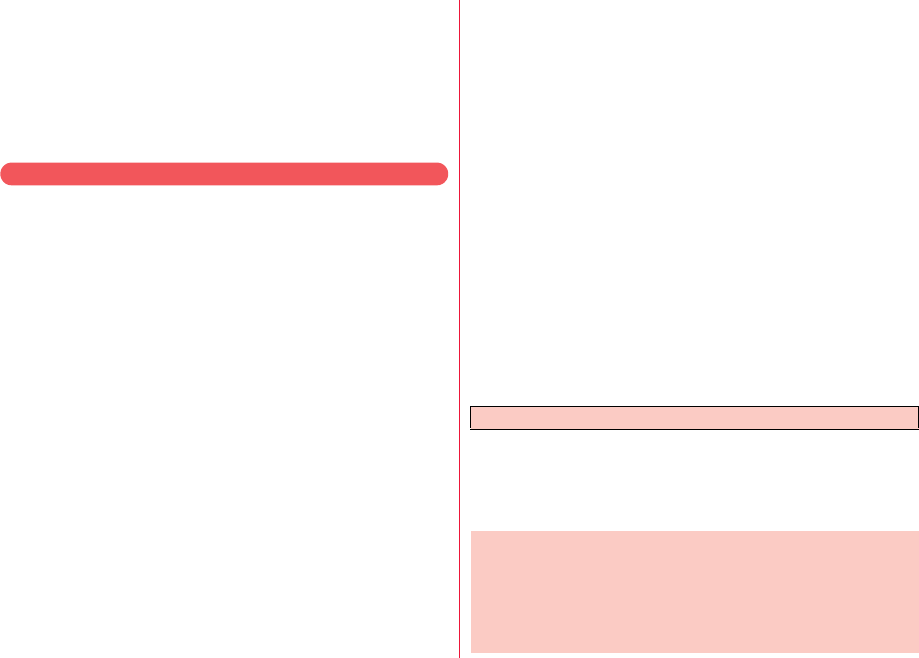
DOCOMO W-CDMA・GSM/GPRS System
Thank you for selecting the “docomo STYLE series P-02A”.
Before or during use of the P-02A, make sure that you read this manual and the
separate manuals for other optional devices thoroughly so that you can use the
P-02A correctly.
If you feel any inconvenience in reading the manual, contact the docomo
Information Center listed on the back page of this manual.
The P-02A is designed to be your close partner. Treat it carefully at all times to
ensure long-term performance.
●Because the FOMA terminals use radio waves, they cannot be used in places
where radio waves do not reach, such as inside tunnels, underground, or in
buildings; or the outside where radio waves are weak or out of the FOMA
service area. They may not be used in the high-rise buildings even when the
antennas are unobstructed. You may also experience interruption of calls
even when using without moving while the radio waves are strong enough for
the three antennas to appear on the display.
●Use the FOMA terminal carefully to avoid disturbing other people when in
public, or in crowded or quiet places.
●Since the FOMA terminals use radio waves as the medium of
telecommunication, calls may be tapped by the third party.
However, the W-CDMA・GSM/GPRS system automatically supports tapping
prevention, so your conversation will be incomprehensible to the third party,
because it is recognized as mere noise.
●The FOMA terminals change your voice into digital signals and send them to
the other party. In places where the radio waves are weak, the digital signals
may not be converted correctly, and in such a case, the voice may sound
different from the actual original voice.
●
The user hereby agrees that the user shall be solely responsible for the result
of the use of SSL. Neither DOCOMO nor the certifiers as listed herein make
any representation and warranty as for the security in the use of SSL. In the
event that the user shall sustain damage or loss due to the use of SSL, neither
DOCOMO nor the certifiers shall be responsible for any such damage or loss.
Certifiers: VeriSign Japan K.K., Cybertrust Japan Co., Ltd., GlobalSign K.K.,
RSA Security Japan Ltd., SECOM Trust Systems Co., Ltd., and
Comodo CA Ltd.
●This FOMA terminal supports FOMA Plus-Area and FOMA High-Speed Area.
●The FOMA terminal can be used only via the FOMA network provided by
DOCOMO and in DOCOMO’s roaming area.
●It is recommended that you make separate notes of the information (such as
Phonebook entries, schedule events, text memos, record messages, voice
memos, movie memos) stored in the FOMA terminal and keep them in a safe
place. Note that we cannot be held responsible for the unlikely event of loss of
the stored contents due to a malfunction, repair, change of your model, or
other mishandling of the FOMA terminal.
●You are advised to save your important data files to the microSD card. If you
have a personal computer, you can transfer and save the information such as
Phonebook entries, mail messages, schedule events, and others to the
personal computer by using DOCOMO keitai datalink.
Before using your FOMA terminal
For Using This Manual
This FOMA terminal supports Kisekae Tool (page 116).
If you use Kisekae Tool to change the design of the Menu display,
some menu configurations change according to the usage
frequency depending on the type of the menu. Further, some menu
numbers that are assigned to the menu items do not apply.
You can download the latest information about this manual
from the following DOCOMO website:
・User’s Manual (PDF file) Download
(http://www.nttdocomo.co.jp/english/support/manual/index.html)
※The URL and the content of the website might be modified
without notice.
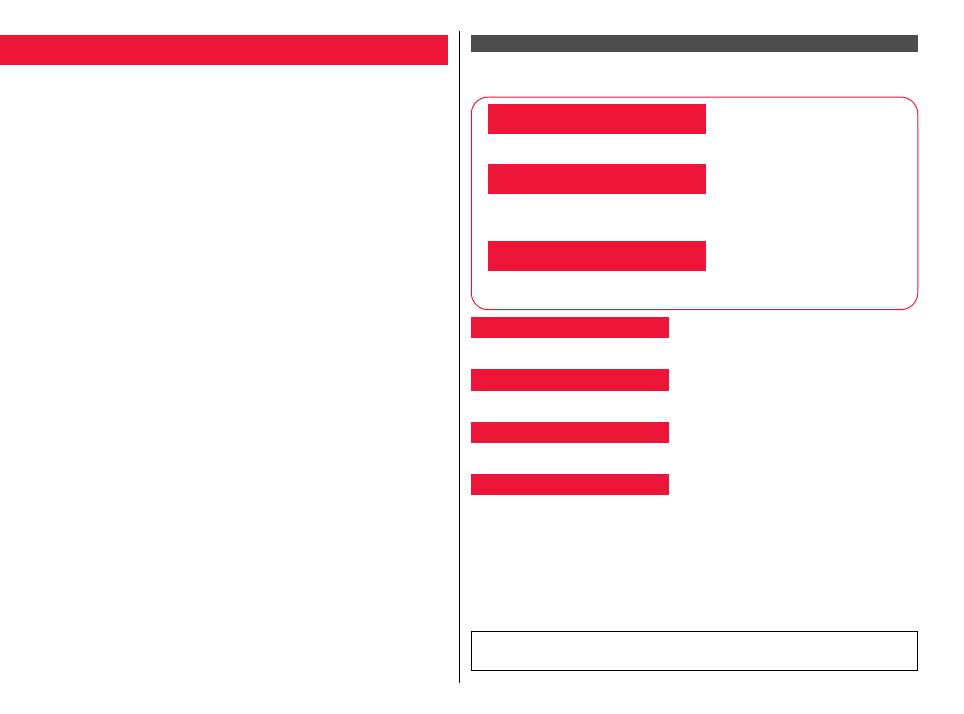
1
Easy Search/Contents/Precautions
Easy Search/Contents/Precautions
In this manual, illustrations and symbols are used in the explanations so
that you can correctly and easily use the FOMA terminal.
≥The most operating procedures and displays in this manual are described with the
default settings of the “Diamond Black” handset (see page 476). However, the
following settings are changed.
・“Display setting” → “Stand-by display”: OFF
・“Display setting” → “Clock” → “Stand-by clock” → “Position”: Pattern 1
・“Color theme setting”: White
・“Disp. call/receive No.” → “Font color”: Black
≥Displays and illustrations described in this manual are for reference. The actual ones
might differ.
≥In this manual, “Osaifu-Keitai compatible i-αppli which supports the IC card function” is
described as “Osaifu-Keitai compatible i-αppli”.
≥Note that “P-02A” is referred to as “FOMA terminal” in this manual.
≥In the operating procedures of this manual, key operations are described with
simplified key icons.
≥The functions which use a microSD card are described in this manual; however, you
need to obtain a microSD card separately to make these functions available. See
page 368 for the microSD card.
Viewing/Searching This Manual By the following search methods, you can find pages where your desired
functions and services are described:
How to Refer to This Manual
Search from the index when you know the names of functions or services.
Search from keywords for the functions you frequently use or the functions that are
convenient if you can know any.
Search from the tabs printed on the cover.
See the next page for details.
Search from the contents that categorize functions.
Search from here to use the main functions.
Search from the function list.
Quick Manual gives you a clear, brief description about basic functions. You can take it
when you go out. Further, Quick Manual “For Overseas Use” is attached, so refer to it
when you use the FOMA terminal overseas.
From the Index
From Easy Search
From the Tabs on the Cover
From the Contents 11P.6
From the Main Functions 11P.8
From the Function List 11P.476
From Quick Manual 11P.550
It is prohibited to copy all or part of this manual without permission.
The instructions contained in this manual may be changed without notice.
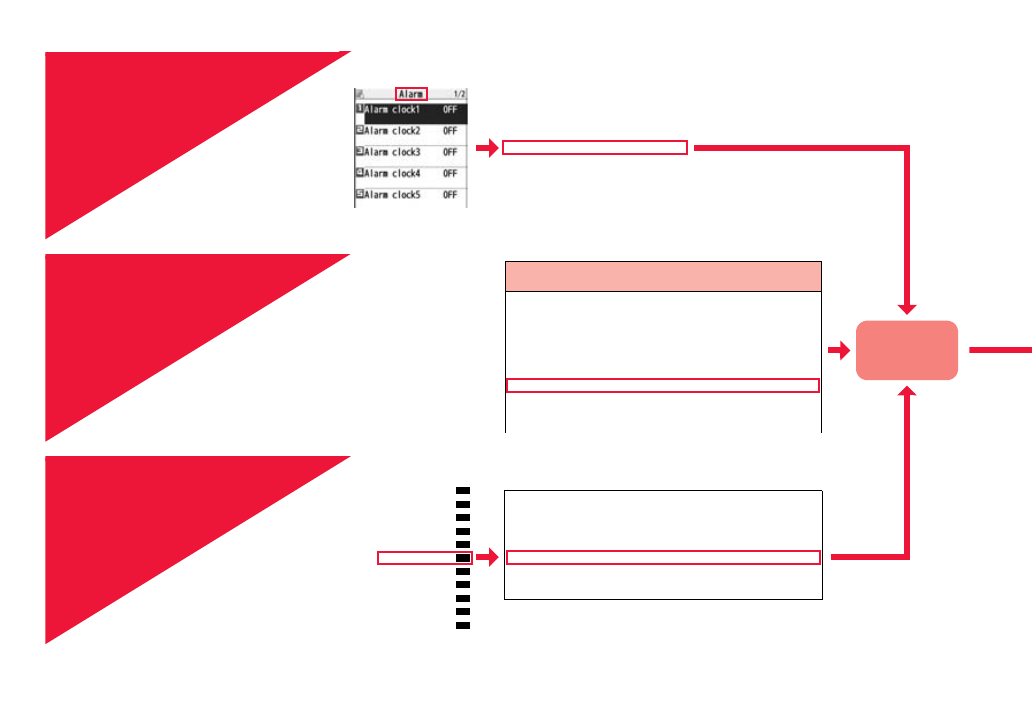
2
Easy Search/Contents/Precautions
How to search for “Alarm” is explained here as an example of search method.
Additional guidance . . . . . . . . . . 455
Address link function . . . . . . . . . . . 203
After-sales services . . . . . . . . . . . . 516
Alarm . . . . . . . . . . . . . . . . . . . . . . . 402
Alarm setting . . . . . . . . . . . . . . . . . 411
Answer setting . . . . . . . . . . . . . . . . . 64
Antenna . . . . . . . . . . . . . . . . . . . . . . 23
From the Index
11P.542
Search for a function or a service
name as shown on the right.
Search for the function you
frequently use or that is
convenient if you know any as
shown on the right.
Other things you can do
To reduce the battery consumption .............................. <Power Saver Mode> 113
To scan QR codes or bar codes...................................... <Bar Code Reader> 243
To listen to music.................................................................. <MUSIC Player> 276
To check your location and area information.................<Map/GPS Function> 324
To use the microSD card ...................................................... <microSD Card> 366
To exchange information using infrared rays.........<Infrared Communication> 380
To use the FOMA terminal as an alarm clock.....................................<Alarm> 402
To use the FOMA terminal as a calculator .................................. <Calculator> 415
To use the FOMA terminal overseas ........................<International Roaming> 458
To update software programs........................................... <Software Update> 518
Go to page 404
where “Alarm”
is explained.
From Easy Search
11P.4
i-αppli/i-Widget
Map/GPS Function
Osaifu-Keitai/ToruCa
Data Management
Music
Convenient Functions
Character Entry
Network Services
PC Connection
Overseas Use
Appendix/Troubleshooting
Multitask . . . . . . . . . . . . . . . . . . . . . . . . . . . . . . . . . . <Multitask> 399
Informing You of an Incoming Call/Mail Message by Voice
. . . . . . . . . . . . . . . . . . . . . . . . . . . . . . . . . . . . . <Reading Aloud> 400
Turning Power On/Off Automatically at a Specified Time
. . . . . . . . . . . . . . . . . . . . . . . . . . . . . . . . <Auto Power ON/OFF> 402
Using Alarm. . . . . . . . . . . . . . . . . . . . . . . . . . . . . . . . . . <Alarm> 402
Using Calendar to Manage Schedule . . . . . . . . . . .<Schedule> 405
Using ToDo to Manage Schedule . . . . . . . . . . . . . . . . . <ToDo> 409
Setting Operating Conditions of Alarm . . . . . <Alarm Setting>411
From the Tabs on the
Cover
11Cover page
Search for the function you want
to set in the order of “Cover”
→ “First page of Chapter”
→ “Description page” as shown
on the right.
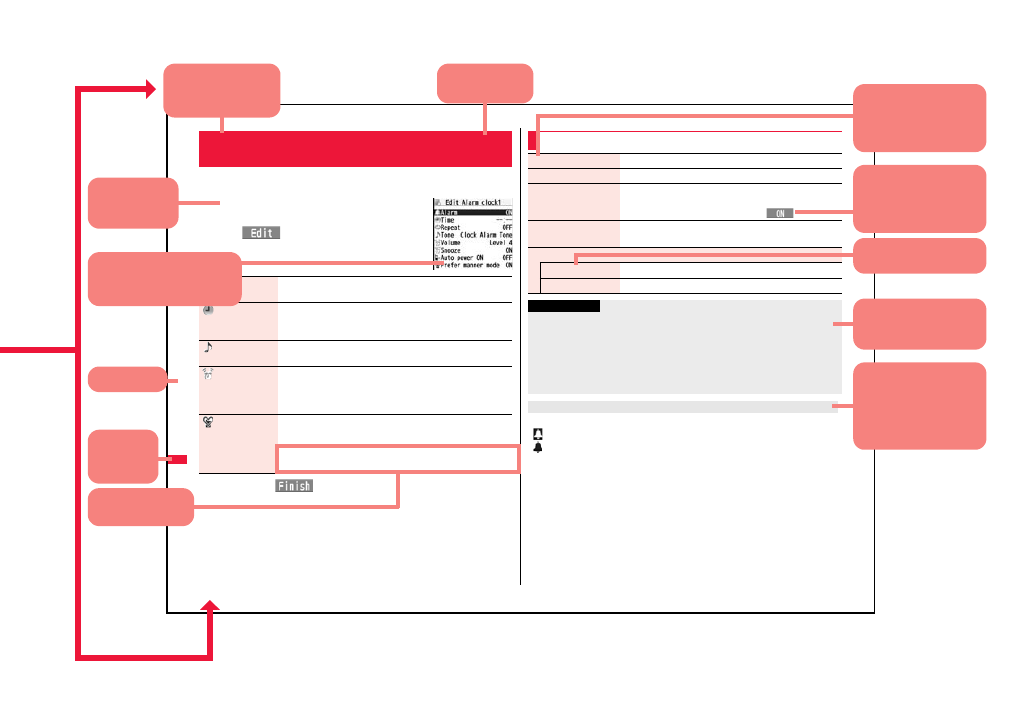
3
Easy Search/Contents/Precautions
402
Convenient Functions
You can set Alarm to alert you at the specified time with an alarm tone,
animation and illumination. You can store up to twelve alarms.
1mStationeryAlarm
Highlight an alarm and press
l()
Do the following operations.
2Press l().
+m-4-4
<Alarm>
Using Alarm
Alarm You can set whether to validate or invalidate the alarm.
ON or OFF
Time Enter the time for sounding the alarm.
pYou cannot set the same time as the time set for the stored
alarm.
Tone Select a type of alarm toneSelect a folder
Select an alarm tone.
Volume Use Bo to adjust the volume.
pIf you set “Step”, the alarm tone is silent for about three
seconds, and then the volume steps up every about three
seconds, from Level 1 through Level 6.
Prefer manner
mode
You can set the alarm tone which sounds at the specified time
during Manner Mode.
ON or OFF
ON. . . . . Sounds at the same volume as set for “Alarm volume”.
OFF. . . . Sounds at the volume set for this function.
The icon appears on the desktop.
“” . . . Displayed when an alarm is set for today (except the setting for past time).
“” . . . Displayed when an alarm is set for tomorrow or onward only.
pIf you set “Alarm” of the stored schedule event/ToDo item to “OFF”, the icons are not
displayed.
Function Menu while Alarm is Displayed
Edit Go to step 1 of “Using Alarm” on page 402.
Detail You can display the stored alarm contents.
Set thisYou can validate the stored alarm.
YES
pYou can validate also by pressing Oo().
Set all You can validate all the stored alarm.
YES
Delete
Delete thisYES
Delete all Enter you Terminal Security CodeYES
Information
pIf the alarm tone sounds during a call, press any key to stop it. Once again press any
key to end the alarm including Snooze. If the other party on the phone hangs up, an
alarm including Snooze ends.
pDuring a call, the alarm tone sounds at the level set for “Volume” (earpiece volume).
pTurn off the FOMA terminal after setting “Auto power ON” to “OFF” when you are near
electronic devices using high-precision control or weak signals, or where the use is
prohibited such as in airplanes and hospitals.
When you set an alarm for “Alarm”, “Schedule”, and “ToDo”
Note: The page above is a sample.
Menu number
(See page 34)
Function name
You can find this in
Index.
Operating
procedure
(See page 32)
Reference display
(Characters and settings
are for reference.)
Options and their
explanations
Items shown on the
display
(Some items cannot
be executed.)
Operation and
supplementary
explanation for each
item
Operations related to
the function and
explanations for
supplementary
operations
Chapter title
You can
search by
chapter.
Cautions or
references for using
each function
Lower sub-menu item
of the Function menu
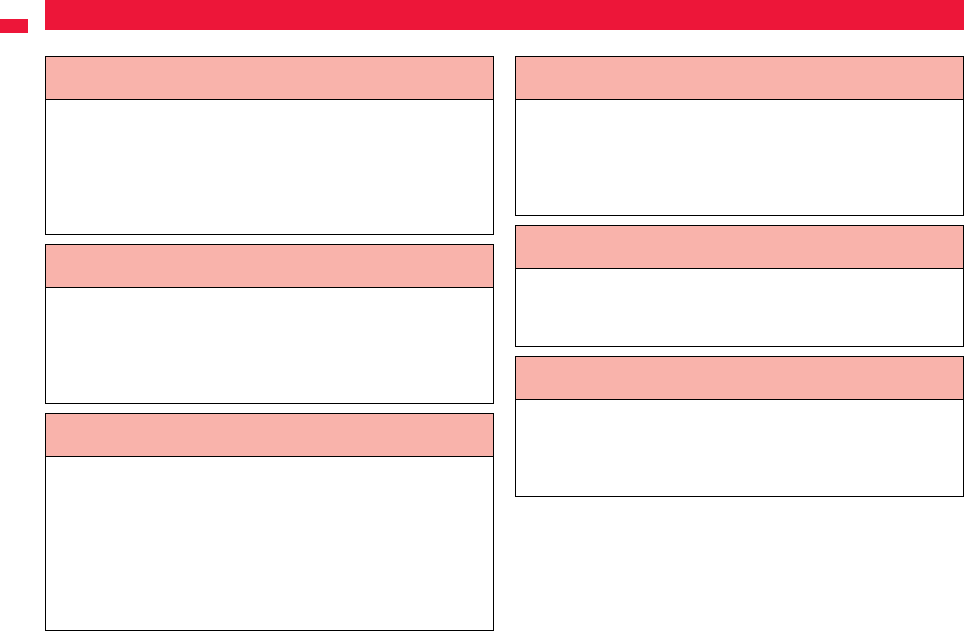
4
Easy Search/Contents/Precautions
To retrieve a desired function with simple words, refer to the following:
Easy Search
To know convenient functions for making calls
To/Not to notify your phone number to the other party
....................................................................................<Caller ID Notification> 46
To switch to a videophone call during a voice call
...........................................................................<Switch to Videophone Call> 51
To change a volume level of the other party’s voice ....................... <Volume> 65
To put a call on hold during a call.................................................... <Holding> 66
To do the following when you cannot answer calls
To put an incoming call on hold before answering ......................... <On Hold> 66
To convey the message that you need to refrain from talking on the phone
..................................................................... Using Public Mode (Drive Mode) 67
....................................................................... Using Public Mode (Power Off) 68
To record voice/video messages.......................... <Record Message Setting> 69
To change melody or illumination
To adjust the ring volume........................................................<Ring Volume> 66
To change ring tones according to callers......................<Add to Phonebook> 88
To change ring tones........................................................<Select Ring Tone> 104
To know incoming calls by vibrator .................................................<Vibrator> 106
To mute the keypad sound...................................................<Keypad Sound> 107
To activate Manner Mode...................................................... <Manner Mode> 108
To change colors/lighting patterns of Call indicator for incoming calls
.................................................................................................. <Illumination> 117
To change/know display settings
To know the meaning of marks (icons) on the display .....................<Display> 27
To change the Stand-by display (Wallpaper) ...................... <Display Setting> 111
To display a calendar on the Stand-by display..............................<Calendar> 111
To change the menu display .......................................... <Menu Icon Setting> 115
To change the font size ................................................................ <Font Size> 119
To make full use of mail
To send Deco-mail ...................................................................... <Deco-mail> 146
To send images ....................................................................... <Attachments> 153
To sort and save mail automatically ..............................................<Auto-sort> 172
To make full use of camera
To shoot with the photo light...................................................... <Photo Light> 239
To change the shooting size...................................................... <Image Size> 240
To save to the microSD card ...........................................................<Store In> 241
To display shot images......................................................... <Picture Viewer> 344
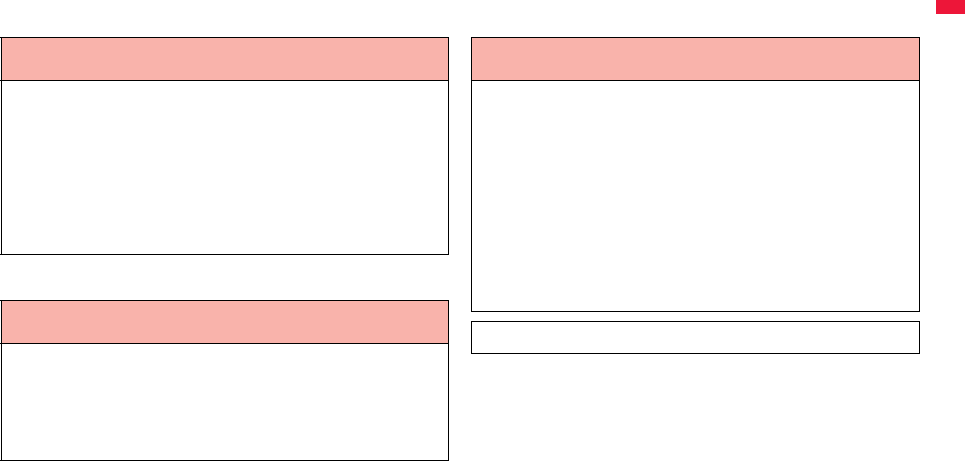
5
Easy Search/Contents/Precautions
※1 This is a pay service.
※2 This is a pay service which is available on a subscription basis.
To use the FOMA terminal with a sense of security
To lock the FOMA terminal from away when it gets lost
.........................................................................................<Omakase Lock>※1125
To keep Phonebook entries from prying eyes.........................<Secret Mode> 132
To reject calls without a caller ID..............................<Call Setting without ID> 135
To reject calls from the phone numbers that are not
in the Phonebook ............................................................ <Reject Unknown> 136
To separately store Phonebook and other data
files in preparation for their erasure.................... <Data Security Service>※2136
To make full use of 1Seg
To watch 1Seg programs ...................................................... <Activate 1Seg> 253
To record 1Seg programs.................. <Record Video> <Record Still Images> 260
To set TV Timer/Timer Recording for 1Seg programs
.......................................................................<TV Timer> <Timer Recording> 261
To change settings of video and audio...................................<User Settings> 266
Other things you can do
To reduce the battery consumption .............................. <Power Saver Mode> 113
To scan QR codes or bar codes ...................................... <Bar Code Reader> 244
To listen to music.................................................................. <MUSIC Player> 278
To check your location and area information.................<Map/GPS Function> 326
To use the microSD card ...................................................... <microSD Card> 368
To exchange information using infrared rays.........<Infrared Communication> 382
To use the FOMA terminal as an alarm clock.....................................<Alarm> 404
To use the FOMA terminal as a calculator .................................. <Calculator> 417
To use the FOMA terminal overseas ........................<International Roaming> 460
To update software programs........................................... <Software Update> 523
To update security ......................................................... <Scanning Function> 529
≥The operating procedures for frequently used functions are summarized in Quick
Manual. (See page 550)
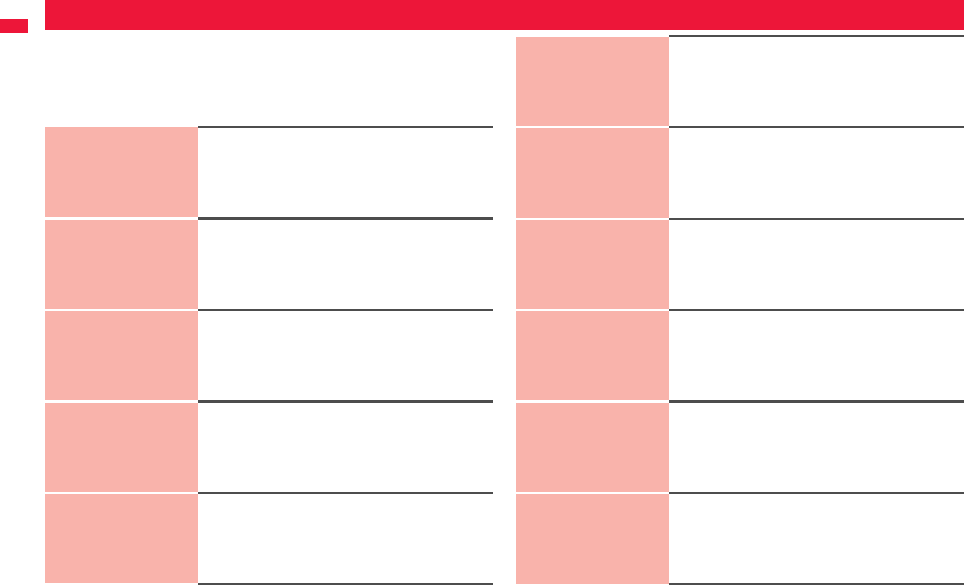
6
Easy Search/Contents/Precautions
Contents
Viewing/Searching This Manual . . . . .1
Easy Search . . . . . . . . . . . . . . . . . . . . . .4
Contents . . . . . . . . . . . . . . . . . . . . . . . . .6
Main Functions of P-02A. . . . . . . . . . . .8
Precautions. . . . . . . . . . . . . . . . . . . . . 10
Handling Precautions . . . . . . . . . . . . 16
Accessories and Main Options . . . . 20
Before Using the
Handset
21
Part Names and Functions, Display, Desktop Icon,
Selecting Menu, Guide, UIM (FOMA Card), Battery,
Charging, Power ON/OFF, Select Language,
Set Time, World Time Watch, Caller ID Notification,
Own Number, etc.
Voice/
Videophone Calls/
PushTalk
47
Making a Call/Videophone Call, Call Records,
Chaku-moji, Receiving a Call/Videophone Call, Volume,
Ring Volume, Public Mode, Record Message Setting,
Chara-den, Making a PushTalk Call,
Receiving a PushTalk Call, PushTalk Phonebook, etc.
Phonebook
87
Available Phonebooks,
Add to Phonebook (FOMA terminal/UIM),
Group Setting, Search Phonebook, Edit Phonebook,
Delete Data, No. of Phonebook, 2-touch Dial,
Voice Dial
Sound/Screen/
Light Settings
103
Select Ring Tone, Vibrator, Manner Mode,
Speed Selector Sound, Display Setting, Backlight,
Menu Icon Setting, Kisekae Tool, Set to Machi-chara,
Illumination, Font, etc.
Security Settings
121
Security Codes, Change Security Code,
Releasing PIN Lock, Lock All, Omakase Lock,
Self Mode, Personal Data Lock, Keypad Dial Lock,
Secret Mode, Call Setting without ID, Reject Unknown,
Reset Settings, Initialize, etc.
Mail
141
i-mode Mail, Deco-mail, Decome-Anime, Template,
Attachments, Mail Auto-receive, Receive Option,
Check New Messages, Message R/F,
Early Warning “Area Mail”, Chat Mail, SMS, Web Mail,
etc.
i-mode/i-motion/
i-Channel/i-concier
189
i-mode, iMenu, My Menu,
Change i-mode Password, Enter URL, Bookmark,
Screen Memo, Download, Upload, Certificate, i-motion,
i-Channel, i-concier, etc.
Full Browser/
PC Movie
215
Full Browser, Full Browser Settings, PC Movie,
Downloading PC Movies, PC Movie Player
Camera
229
Before Using Camera, Still Image Shoot, Movie Shoot,
Settings for Shooting, Setting Image Size/Image Quality,
Bar Code Reader
1Seg
249
1Seg, Before Using 1Seg, Channel Setting,
Activate 1Seg, i-αppli Program Guide,
Data Broadcasting, TVlink, Recording 1Seg,
TV Timer/Timer Recording, User Settings
Music
269
Music&Video Channel, Set Program,
Playing/Operating Programs, Playing Music,
Saving Music Files, MUSIC Player, Playlist
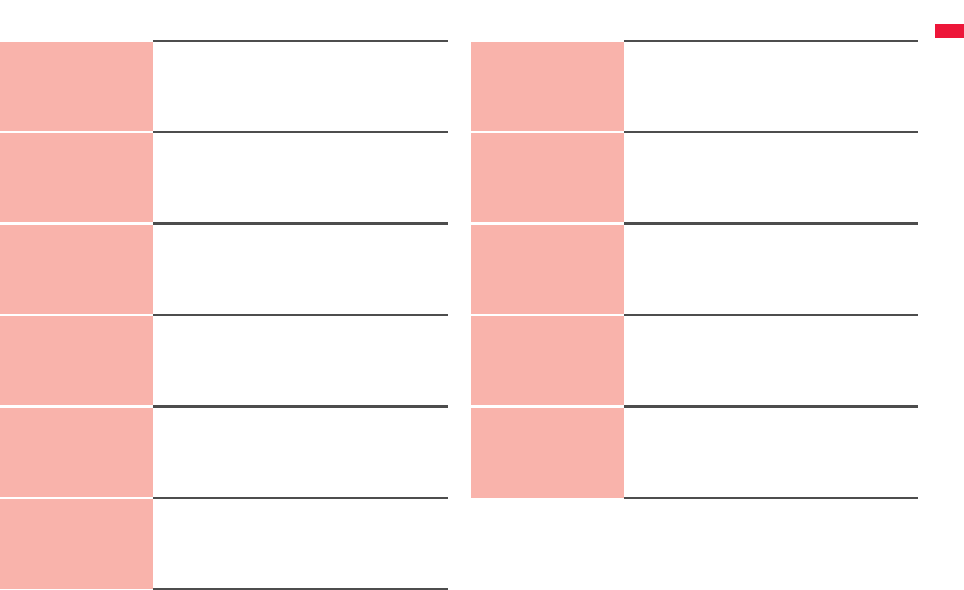
7
Easy Search/Contents/Precautions
i-αppli/i-Widget
289
i-αppli, i-αppli Download, i-αppli Run, iαppli Settings,
Starting i-αppli Automatically, iαppli Call,
i-αppli Stand-by Display, iαppli Data, i-Widget,
Start Widget αppli
Osaifu-Keitai/
ToruCa
313
Osaifu-Keitai, iC Transfer Service, IC Card Content,
IC Card Lock, Check IC Owner, ToruCa,
Receive ToruCa Files, ToruCa Viewer,
ToruCa File List/Detailed ToruCa File Display,
ToruCa Settings
Map/GPS Function
325
Using GPS Function, Position Location,
Map/GPS Compatible i-αppli, Provide Location,
Notify of Location, Location History, GPS Settings
Data Management
341
Picture Viewer, i-motion Player, Video Player,
Chara-den, Machi-chara, Melody Player, Kisekae Tool,
microSD Card, Voice Recorder, PDF Viewer,
Document Viewer, etc.
Convenient
Functions
399
Multiaccess, Multitask, Reading Aloud,
Auto Power ON/OFF, Alarm, Schedule, ToDo,
Own Number, Voice Memo, Movie Memo, Call Data,
Calculator, Text Memo, UIM Operation,
Bluetooth Function, etc.
Character Entry
429
Character Entry, Mode 1 (5-touch), Common Phrases,
Cut/Copy/Paste, Own Dictionary, Learned Words,
Download Dictionary, Mode 2 (2-touch),
Mode 3 (NIKO-touch)
Network Services
439
Check New Messages, Voice Mail, Call Waiting,
Call Forwarding, Nuisance Call Blocking,
Caller ID Request, Dual Network, Service Numbers,
Remote Control, Multi Number, 2in1, OFFICEED, etc.
Overseas Use
459
Outline of International Roaming (WORLD WING),
Available Services, Confirmation for Using,
Making a Call at the Country You Stay,
Receiving a Call, 3G/GSM Setting,
Set Roaming Guidance, Network Services, etc.
PC Connection
469
Available Data Communication,
Before Using Data Communication, Preparation Flow for
Data Transfer (OBEX™ Communication),
Preparation Flow for Data Communication, AT Command,
CD-ROM, DOCOMO Keitai Datalink
Appendix/
Troubleshooting
475
Function List, Options and Related Devices,
Troubleshooting, Error Messages, Warranty and
After-sales Services, i-mode Fault Diagnosis Site,
Software Update, Scanning Function, Main Specifications,
SAR, Export Administration Regulations, etc.
Index/
Quick Manual
541
Index, Quick Manual,
Quick Manual “For Overseas Use”
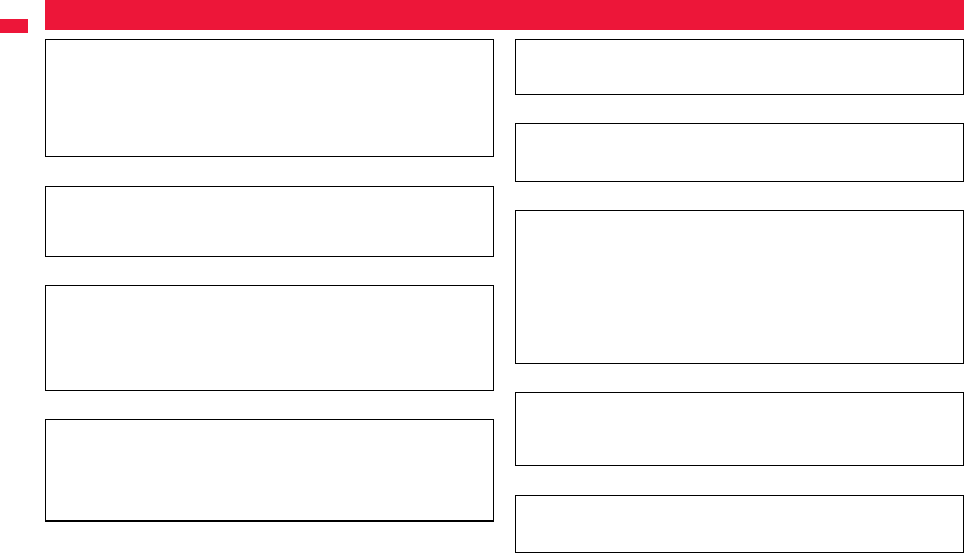
8
Easy Search/Contents/Precautions
Main Functions of P-02A
◆i-concier 11P.211
i-concier is a service that enables you to receive useful information from a character
(Machi-chara image) on the Stand-by display and download schedule event
(i-schedule) files for your convenience.
Downloaded i-schedule events or ToruCa files are automatically updated to the latest
information, and the address information of shops/companies, etc. is automatically
added to the Phonebook.
◆i-αppli Call 11P.306
i-αppli call is a useful function for online games that enables your content provider or
third party to give notice to your opponent to start the specified corresponding
application.
◆
International Roaming
11P.296, P.460
Your FOMA terminal, phone number, and mail address are available overseas (3G/
GSM areas are supported).
Further, “日英版/日中版 しゃべって翻訳 for P (J-E/J-C Speech Translation for
P)”, which translates words into English or Chinese if you talk in Japanese, and into
Japanese if in English or Chinese, is pre-installed.
◆i-Widget 11P.309
i-Widget is a useful function that enables you to easily access the tools and
commonly-used contents (Widget αppli) such as a calculator, clock, TV program list,
and stock prices information.
By launching the i-Widget display, you can check your desired latest information at a
glance.
◆1Seg 11P.250
You can watch 1Seg programs of the terrestrial digital broadcasting for mobile objects.
Also, you can record a still image or video while watching a 1Seg program.
◆Bluetooth Function 11P.421
The wirelessly-connected FOMA terminal and a Bluetooth device enable you to talk or
listen to music while you are carrying the FOMA terminal in your bag.
◆Full Wide VGA Display
You can display still images or movies in the Full Wide VGA (480 dots x 854 dots)
display of approx. 3.1 inches and can enjoy watching 1Seg programs on the
impressive display.
Moreover, you can use the side key to shoot still images and movies with horizontal
wide display just like using a digital camera.
Also, the light sensor automatically adjusts the backlight in accordance with the
ambient brightness, and the LCD AI compensates the image quality in accordance
with the brightness.
◆Feel*Mail 11P.177
Animation of 45 characters and illumination reproduce the atmosphere of mail
messages. Pleasant animation appears and illumination lights according to the
contents of mail message.
◆Recv. Mail/Call at Open 11P.113
When a missed call or new mail message is found, just open the FOMA terminal to
display the detailed Missed Call display or the Inbox list.
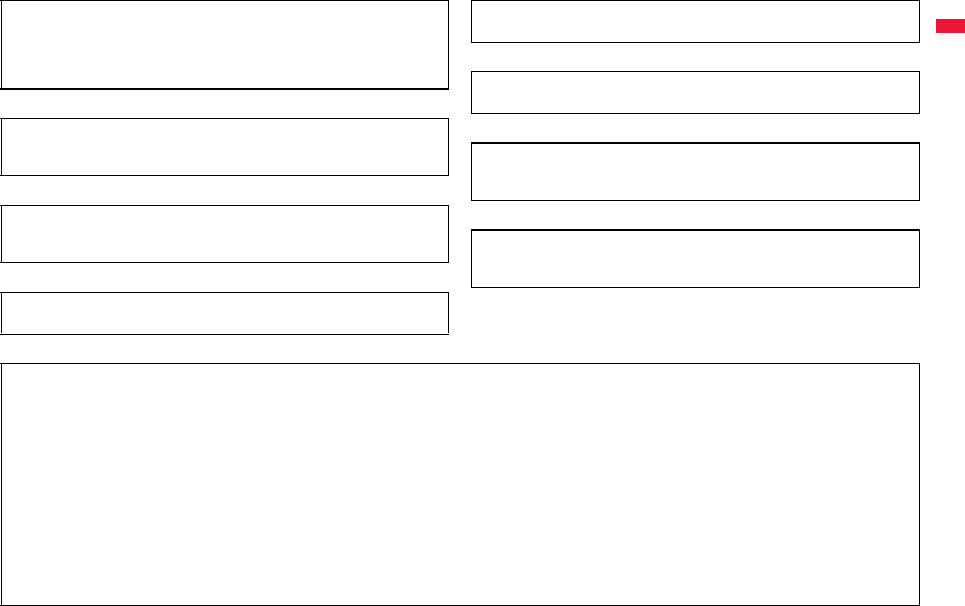
9
Easy Search/Contents/Precautions
◆Speed Selector 11P.25
By the rotating operation, you can scroll displays and select items quickly. Further, in
various situation, you can comfortably operate functions such as volume adjustment
during music playback or during a call, and zoom adjustment for when shooting with
the camera.
◆Swing Slide 11P.24
When you slide to open, the display slightly comes up to your side, so it is easy to see
and you feel the naturally-angled touch when putting it on your face during a call.
◆View Blind 11P.115
You can make the display hard to see from an angle. You can use the FOMA terminal
without concern for others’ eyes.
◆Shikkari Talk 11P.61
You can make the other party’s voice clear according to surrounding noise.
◆Yuttari Talk 11P.61
You can slow down the other party’s speaking speed during a call.
◆Face Detection 11P.239
You can shoot still images adjusting the camera focus on person’s face automatically.
◆Document Viewer 11P.393
On your FOMA terminal, you can display Microsoft Word files, Microsoft Excel files,
and Microsoft PowerPoint files created by personal computers.
◆Voice Recorder 11P.388
You can record your voice as a substitute for taking notes. You can repeatedly
play it back, so it is convenient to record the proceedings at a meeting, etc.
◆Chaku-moji 11P.54
◆Videophone 11P.48
◆
i-mode mail/Deco-mail/Deco-mail pictogram
11P.142, P.146, P.342
◆i-αppli/Mega i-αppli/Intuitive Games 11P.290
◆High-Speed Communication Supported 11P.470
◆Chaku-uta Full®/Uta-hodai/Music&Video Channel/Video Clips 11P.208, P.270, P.276, P.278
≥“Chaku-uta Full” is a registered trademark of Sony Music Entertainment Inc.
◆MUSIC Player 11P.278
◆GPS 11P.326
◆Osaifu-Keitai/ToruCa 11P.314, P.316
◆Kisekae Tool 11P.116, P.367
◆Respective Network Services 11P.439
◆Security Settings 11P.121
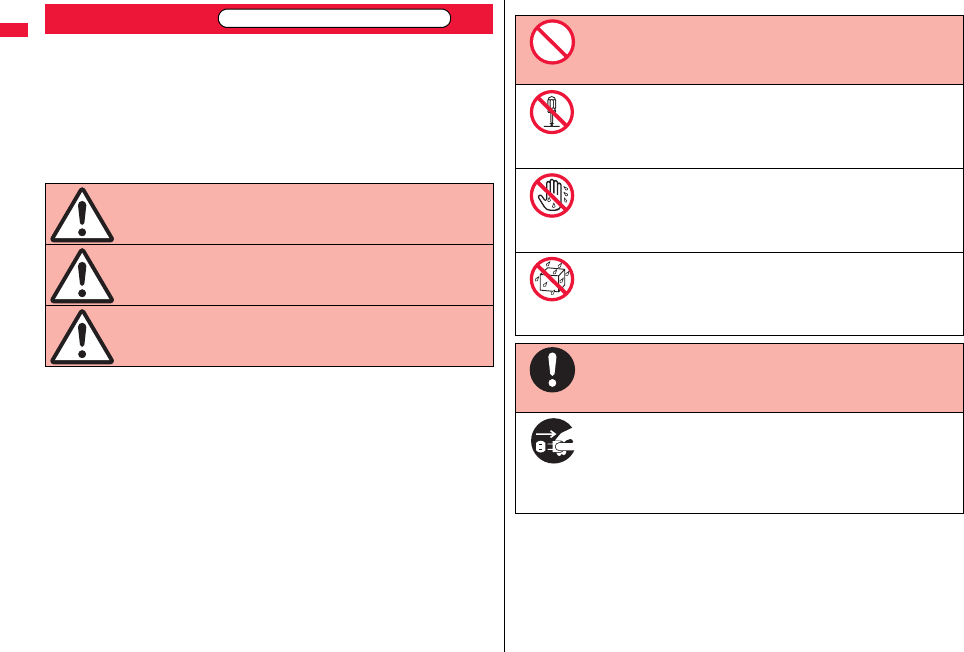
10
Easy Search/Contents/Precautions
■Before using the FOMA terminal, read these safety precautions carefully so that
you can use it correctly.
After reading the precautions, keep them in a safe place.
■Be sure to observe these safety precautions because they are designed to
protect you or those around you from causing injury and to avoid unnecessary
damage to the property.
■The symbols below indicate the levels of danger or damage that can be caused
if the particular precautions are not observed.
Precautions
Danger This symbol indicates that incorrect handling
will almost certainly cause death or serious
injury.
Warning This symbol indicates that incorrect handling
poses a risk of causing death or serious
injury.
Caution This symbol indicates that incorrect handling
poses a risk of causing injury or damage to
the product or property.
ALWAYS FOLLOW THESE DIRECTIONS
■The following symbols show specific directions:
■“Safety Precautions” are divided into the following six sections:
General precautions for FOMA terminal, batteries, adapters/chargers, and
UIM ............................................................................................................. P.11
Precautions for FOMA terminal ................................................................. P.12
Precautions for batteries ............................................................................ P.14
Precautions for adapters/chargers............................................................. P.15
Precautions for UIM.................................................................................... P.16
Notes on using near electronic medical equipment .................................. P.16
Denotes things not to do. (Prohibition)
Denotes not to disassemble.
Denotes not to touch with wet hands.
Denotes not to use where it could get wet or not to wet it.
Denotes mandatory instructions (matters that must be complied
with).
Denotes to pull the power plug out of the outlet.
Don’t
Do not
disassemble
Not wet
hands
Avoid
Water
Do
Pull the
power plug
out
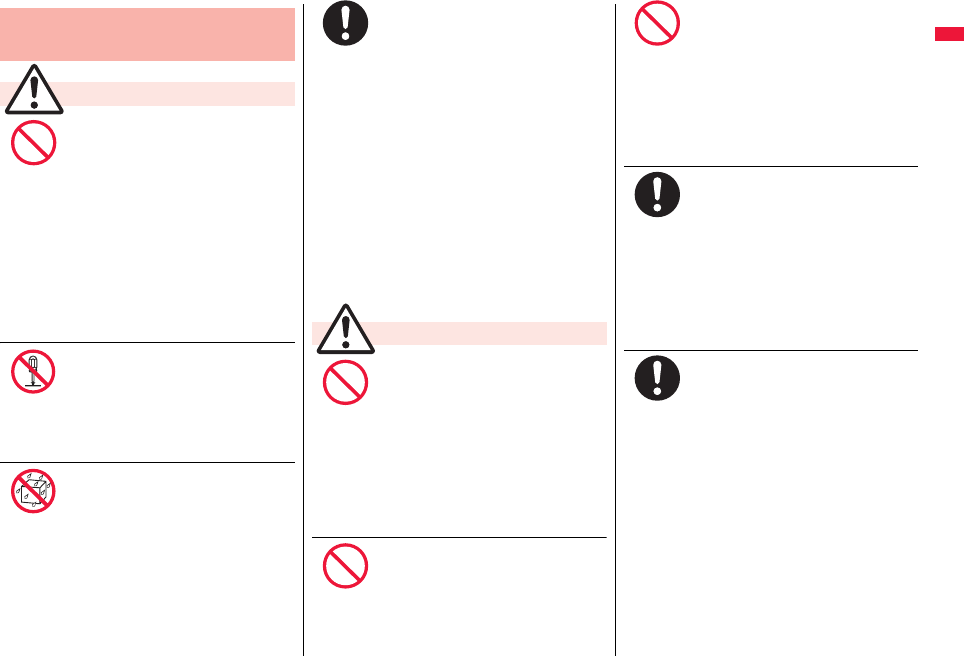
11
Easy Search/Contents/Precautions
Do not use, store or leave the
FOMA terminal and its
accessories in places with a high
temperature such as near fire or
places exposed to direct sunlight,
or in cars under the blazing sun.
The devices could be deformed or
malfunction, or the battery may leak,
overheat, burst, or catch fire, thus
resulting in the deterioration of
performance and shortening of the life of
devices.
Also, part of the case could get heated,
causing bare skin burns.
Do not disassemble, modify or
solder the FOMA terminal or
accessories.
Accidents such as fire, injury, or electric
shock, or malfunction may result. The
battery may leak, overheat, burst or
catch fire.
Do not wet the FOMA terminal or
accessories.
If liquids such as water or pet urine get
onto them, overheating, electric shock,
fire, malfunction, injury or others may
result. Pay attention to the place of use
and the way of handling.
General precautions for FOMA
terminal, batteries, adapters/
chargers, and UIM
Danger
Don’t
Do not
disassemble
Avoid
Water
With your FOMA terminal, use the
batteries and adapters/chargers
specified by NTT DOCOMO, INC.
If you use any type of battery, adapter or
charger other than the specified one,
your FOMA terminal, battery or other
accessories may leak, overheat, burst,
catch fire or malfunction.
Battery Pack P19
FOMA AC Adapter 01/02
FOMA AC Adapter 01 for Global use
FOMA DC Adapter 01/02
Desktop Holder P29
FOMA Dry Battery Adapter 01
FOMA Portable Charging Adapter 01
FOMA USB Cable with Charge Function
01/02
※For other compatible products,
contact a handling counter such as a
docomo shop.
Do not place the batteries, the
FOMA terminal, adapters/
chargers, or UIM in cooking
appliances such as microwave
ovens or high-pressure
containers.
The battery may leak, overheat, burst, or
catch fire. The FOMA terminal or the
adapter/charger may overheat, smoke,
or catch fire, or its circuit parts may
become damaged.
Do not throw the FOMA terminal
or accessories, or subject them
to severe shocks.
The battery may leak, overheat, burst, or
catch fire. Also, malfunction or fire may
result.
Warning
Do
Don’t
Don’t
Be careful not to let
electroconductive materials
(metal pieces, pencil leads etc.)
contact with the charging
terminal or connector terminal.
Also, make sure that those are
not entered into the inside of the
FOMA terminal.
Short-circuit could cause fire or
malfunction of the FOMA terminal.
When you are in a place such as a
gas station where flammable gas
is generated, turn off the FOMA
terminal, and never do charging.
Otherwise, catching fire may
result.
Ensure that you use Osaifu-Keitai with
the FOMA terminal turned off when you
are in the vicinity of the gas station.
(When IC Card Lock is set, turn off the
power with the lock released.)
If odor, overheat, discoloration,
or deformation is detected during
use, battery charge, or storage,
immediately observe the
following:
1. Pull the power plug out of the
outlet or cigarette lighter
socket.
2. Turn off the power to the FOMA
terminal.
3. Remove the battery pack from
the FOMA terminal.
If you use the FOMA terminal and its
accessories as they are, overheat, burst,
or catching fire could result or the
battery could leak.
Don’t
Do
Do
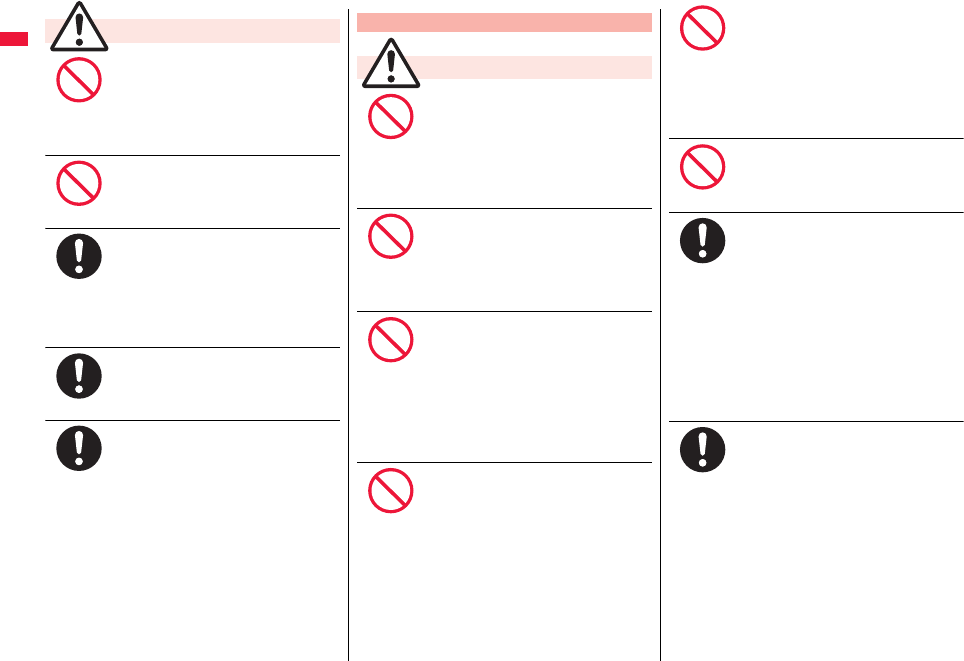
12
Easy Search/Contents/Precautions
Do not place the FOMA terminal
or accessories on unstable
locations such as wobbly tables
or slanted locations.
The FOMA terminal or accessories may
fall, resulting in injury or malfunction.
Do not store in humid or dusty
places, or in high temperature
environments.
Malfunction may result.
If children use the FOMA terminal or
accessories, a guardian should
explain the safety precautions and
correct operations. The guardian
should also make sure that the
instructions are followed during use.
Otherwise, injury may result.
Keep out of the reach of babies
and infants.
Accidental swallowing or injury may
result.
Be especially careful when you use
the FOMA terminal for a long time
with the adapter/charger
connected.
If you use i-
α
ppli programs, talk on the
videophone, watch 1Seg programs and
so on for a long time during charging,
the temperature of the FOMA terminal,
battery pack, or adapter/charger might
rise.
If you directly touch the part of high
temperature continuously, redness,
itching, rash, or low-temperature bare
skin burns may result depending on your
physical conditions or predisposition.
Caution
Don’t
Don’t
Do
Do
Do
Do not directly point the infrared
data port at someone’s eyes
during transmission.
His/her eyes may possibly be affected.
Other infrared devices may operate
erroneously if the infrared data port is
pointed at them during transmission.
Do not shine the photo light close
to eyes.
Doing so can damage eyesight. Also,
accidents such as injury might occur if
someone is startled or dazzled by the
light.
Do not put the FOMA terminal in
the place where it could be
affected by an expanded airbag,
e.g., on the dashboard.
If the airbag expands, the FOMA
terminal could hit you and others,
causing accidents such as injury and the
FOMA terminal could malfunction and
become damaged.
If you have any implanted
electronic medical equipment, do
not place your FOMA terminal in
a chest pocket or inner pocket.
If the FOMA terminal is positioned close
to electronic medical equipment, it may
cause that equipment to malfunction.
Precautions for FOMA terminal
Warning
Don’t
Don’t
Don’t
Don’t
Do not allow liquids such as
water, or foreign materials such
as metal pieces or flammable
materials to get into the UIM or
microSD card slot of the FOMA
terminal.
Fire, electric shock or malfunction may
result.
Do not turn on the photo light to
drivers of cars, and others.
It disturbs driving, and accidents may
result.
Turn off the FOMA terminal in
places where use is prohibited
such as in airplanes and hospitals.
Otherwise, electronic devices and
electronic medical appliances may be
adversely affected. If the Auto Power
ON function is set, deactivate the
setting, then turn the power off.
For use inside medical facilities, make
sure that you comply with their
regulations. You may be punished for
using the FOMA terminal in airplanes,
which is prohibited by law.
When talking with the FOMA
terminal set to Hands-free, be
sure to keep the FOMA terminal
away from your ear.
Further, when you play games or
play back music with the
earphone/microphone
connected, adjust the sound
volume to moderate volume.
The excessive sound volume impairs
your hearing.
Further, accidents may result due to the
hardness of hearing of surrounding
sound.
Don’t
Don’t
Do
Do
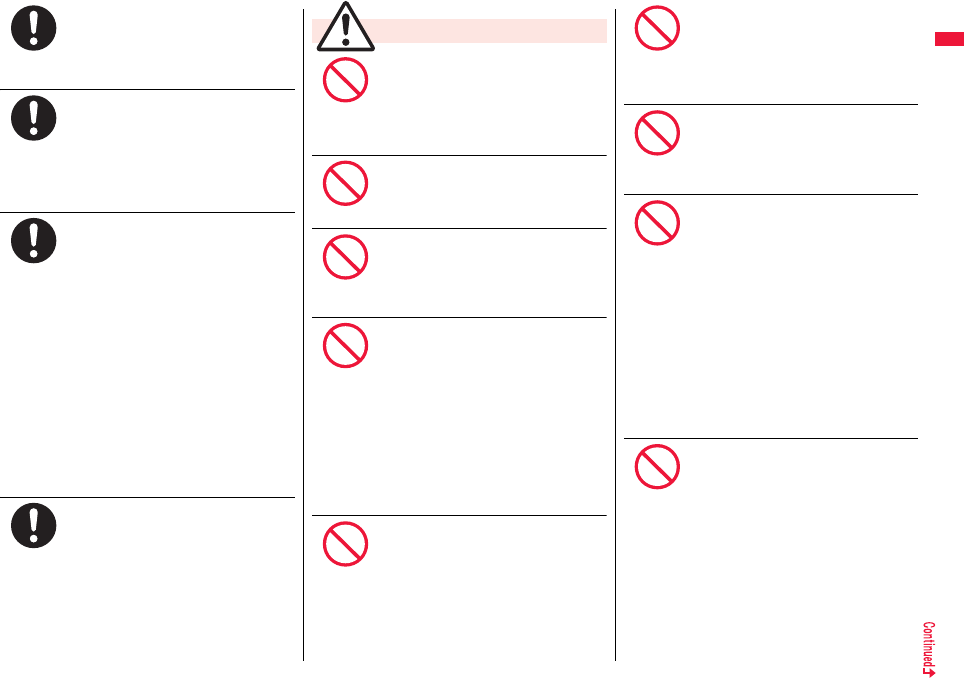
13
Easy Search/Contents/Precautions
For those with weak heart
conditions, the vibrator and ring
volume must be adjusted carefully.
Those functions may cause an effect on
the heart.
If thunder starts to rumble while
you are using the FOMA terminal
outdoors, house the antenna,
turn off the power and move to a
safe place.
Otherwise, you could be struck by
lightning or suffer an electric shock.
Turn off the FOMA terminal when
near electronic devices using
high-precision control or weak
signals.
The FOMA terminal may possibly cause
these devices to malfunction.
※
Electronic devices that may be affected:
Hearing aids, implanted cardiac
pacemakers, implanted defibrillators,
other medical electronic devices, fire
alarms, automatic doors and other
automatically controlled devices. If you
use an implanted cardiac pacemaker,
implanted defibrillator or any other
electronic medical device, consult the
manufacturer or retailer of the device for
advice regarding possible effects from
the radio waves.
If the display part or camera lens
is broken, be careful about
broken glasses or the exposed
interior of the FOMA terminal.
Plastic panels are used for the surfaces
of the display part and camera lens so
that glasses do not easily get scattered,
however, pay attention not to
erroneously touch the broken part or
interior. Otherwise, injury may result.
Do
Do
Do
Do
Do not swing the FOMA terminal
by its antenna or strap.
The FOMA terminal may hit you or
persons around you, and accidents such
as injury or malfunction and damage
may result.
Do not use in places crowded
with people.
The antenna may hit against others,
causing an accident such as injury.
Do not use the FOMA terminal
with the damaged antenna.
If the damaged antenna comes in
contact with your skin, an accident such
as a burn or injury could be caused.
When using the motion tracking,
ensure that you check around
you for safety, securely take hold
of your FOMA terminal, and do
not swing to an extent more than
necessitated.
The motion tracking is the function to
incline or swing the FOMA terminal for
operation. If you excessively swing your
FOMA terminal, it might happen that it
hits against persons or objects, resulting
in critical accidents or damage.
When a metallic strap is attached
to your FOMA terminal, be careful
that it does not hit against
persons or objects when using
the motion tracking.
Accidents such as injury or malfunction
and damage may result.
Caution
Don’t
Don’t
Don’t
Don’t
Don’t
Do not place magnetic cards or
similar objects near the FOMA
terminal.
Magnetic data on cash cards, credit
cards, telephone cards and floppy disks,
etc. may be deleted.
Do not bring magnetic
substances close to your FOMA
terminal.
Strong magnetic items might cause in
erroneous operation.
If you erroneously break the
display part and then crystal
liquid gets leaked, never take or
suck the liquid to or into your
mouth, or apply to skin.
If the crystal liquid gets into the
eyes or mouth, immediately rinse
it out with clean water and then
seek medical attention.
When it adheres to your skin or
clothes, immediately wipe it away
with alcohol etc., and then rinse it
out with water and soap.
Otherwise, the loss of eyesight or injury
to your skin may result.
Do not bring your ears close to
the speakers while a ring tone
sounds or a melody is played
back from the FOMA terminal.
Otherwise, your hearing could be
impaired.
Don’t
Don’t
Don’t
Don’t
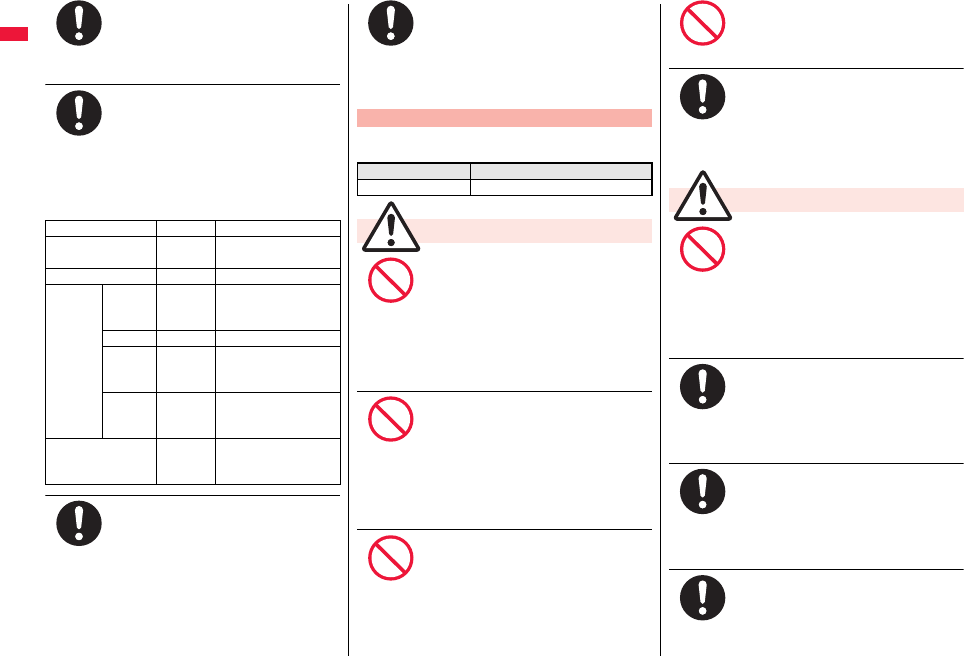
14
Easy Search/Contents/Precautions
Electronic devices in some types
of cars can be affected by use of
the FOMA terminal.
For safety’s sake, make sure not to use
the FOMA terminal inside such cars.
Itching, rash or eczema may be
caused depending on your
physical conditions or
predisposition. If an abnormality
occurs, stop using the FOMA
terminal immediately, and then
seek medical attention.
Metals are used for the following parts:
Be careful not to get your finger
or a strap caught in the parts
when you close or open the
FOMA terminal.
Accidents such as injury or damage may
result.
Where it is used Material Finishing
Charging terminal Phosphor
bronze
Gold-plated finish with
nickel-plated ground
Slide rail SUS304 Fluorine coating
Metal
part of
the 1Seg
antenna
Top Brass Tin-and-cobalt-plated
finish with
nickel-plated ground
Middle SUS304 —
Hinge at
bottom
part
SUS304 Tin-and-cobalt-plated
finish with
nickel-plated ground
Screw at
bottom
part
Brass Nickel-plated
Recording/
PushTalk key
ABS Chrome-plated finish
with copper-and-
nickel-plated ground
Do
Do
Do
When you watch a 1Seg program,
watch in a place bright enough
taking a certain distance from the
display.
Otherwise, your visual acuity could be
reduced.
■Check the description on the label of the
battery pack for the type of battery.
Do not let any metal object such
as a wire come in contact the
battery terminals. Also do not
carry or store the battery together
with any metal objects like a
necklace.
The battery may leak, overheat, burst or
catch fire.
Do not use excessive force to
attach the battery to the FOMA
terminal even when you cannot
attach it successfully. Also,
check that the battery is the right
way round when you attach it.
The battery may leak, overheat, burst or
catch fire.
Do not throw the battery into fire.
The battery may leak, overheat, burst or
catch fire.
Precautions for batteries
Description Type
Li-ion Lithium-ion battery
Danger
Do
Don’t
Don’t
Don’t
Do not pierce it with nails, hit it
with a hammer, or step on it.
The battery may leak, overheat, burst or
catch fire.
If the battery fluid gets into your
eyes, do not rub them. Flush your
eyes with clean water and seek
medical attention immediately.
Otherwise, the loss of eyesight may
result.
When any abnormality due to
external shock such as the
deformation or scratches by
dropping is found on the battery
pack, immediately stop using it.
The battery may leak, overheat, burst, or
catch fire. Also, malfunction or fire may
result.
If charging is not completed at
the end of the specified charging
time, stop charging.
Otherwise, the battery may leak,
overheat, become damaged or catch
fire.
Immediately stop using the FOMA
terminal and keep it away from
fire if the battery leaks or emits
an odor
.
The leaked battery fluid may ignite,
causing fire or burst.
Be careful that your pets do not
bite into the battery pack.
The battery may leak, overheat, burst, or
catch fire. Also, malfunction or fire may
result.
Warning
Don’t
Do
Don’t
Do
Do
Do
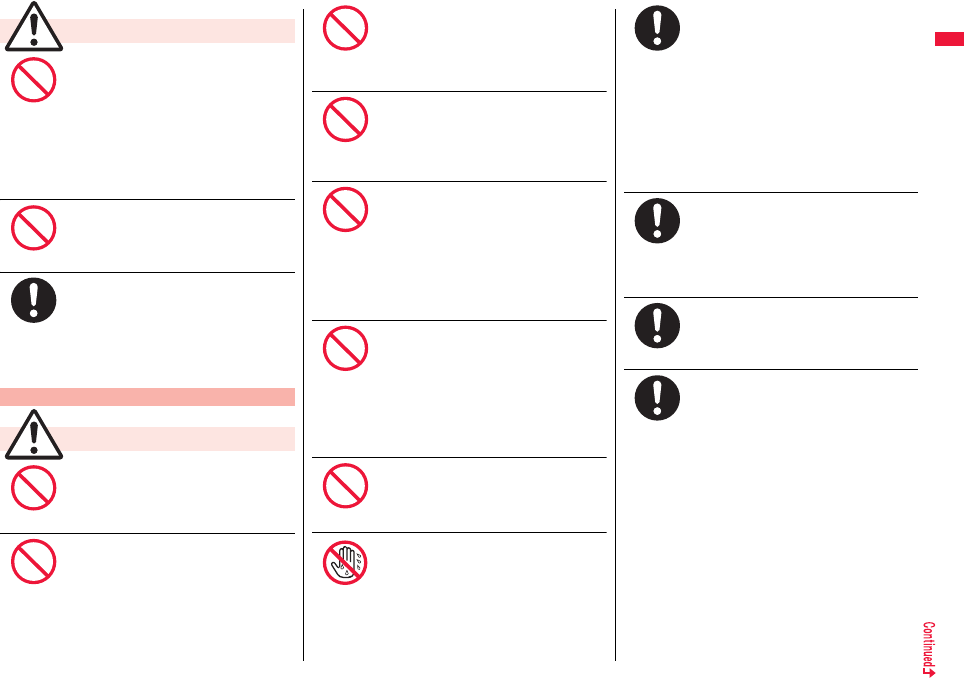
15
Easy Search/Contents/Precautions
An exhausted battery should not
be disposed of with other waste.
The battery may catch fire or damage
the environment. After insulating the
battery terminals with tape, take the
unneeded battery to a handling counter
such as a docomo shop or dispose of it
in accordance with local waste disposal
regulations.
Do not charge the wet battery.
The battery pack may overheat, catch
fire, or burst.
If the battery fluid comes in
contact with skin or clothes,
immediately stop using, then
rinse it out thoroughly with clean
water.
Skin injury may result.
Do not use a damaged adapter/
charger cord or power cord.
Electric shock, overheating or fire may
result.
Do not use the AC adapter and
desktop holder in steamy places
such as a bathroom.
Electric shock may occur.
Caution
Precautions for adapters/chargers
Warning
Don’t
Don’t
Do
Don’t
Don’t
The DC adapter is for use only in
a negative (-) grounded vehicle.
Do not use it in a positive (+)
grounded vehicle.
Fire may result.
If it starts to thunder, do not
touch the FOMA terminal and
adapter/charger.
You might be struck by lighting or suffer
an electric shock.
Never short-circuit the charging
terminal when the adapter is
plugged into the power outlet or
cigarette lighter socket. Also,
never touch the charging terminal
with fingers or other bare skin.
Fire, malfunction, electric shock or injury
may result.
Place the charger and desktop
holder on a stable location during
charging. Do not cover or wrap
the charger and desktop holder in
cloth or bedding.
The FOMA terminal may drop off, or the
charger and desktop holder may
overheat, causing fire or malfunction.
Do not place something heavy on
the adapter/charger cord and
power cord.
Electric shock or fire may result.
Do not touch the power cord of
the adapter/charger, or power
outlet with wet hands.
Electric shock may result.
Don’t
Don’t
Don’t
Don’t
Don’t
Not wet
hands
Use the adapter/charger at the
specified V AC.
If you use it at a wrong voltage, fire or
malfunction may result. When using the
FOMA terminal overseas, use FOMA
AC adapter available overseas.
AC adapter: 100 V AC
DC adapter: 12/24 V DC
[For negative (-) grounded vehicles only]
AC adapter available overseas: 100 V to
240 V AC
[Connect only to household AC outlet]
If a fuse of the DC adapter has
blown, replace it with a specified
fuse.
If you use an unspecified fuse, fire or
malfunction may result. For the specified
fuse, refer to each instruction manual.
Keep the power plugs dust-free.
Otherwise, fire may result.
When pulling the AC adapter into
the power outlet, firmly plug it in,
taking care not to contact with
metal straps or the like.
Otherwise, electric shock, short-circuit or
fire may result.
Do
Do
Do
Do
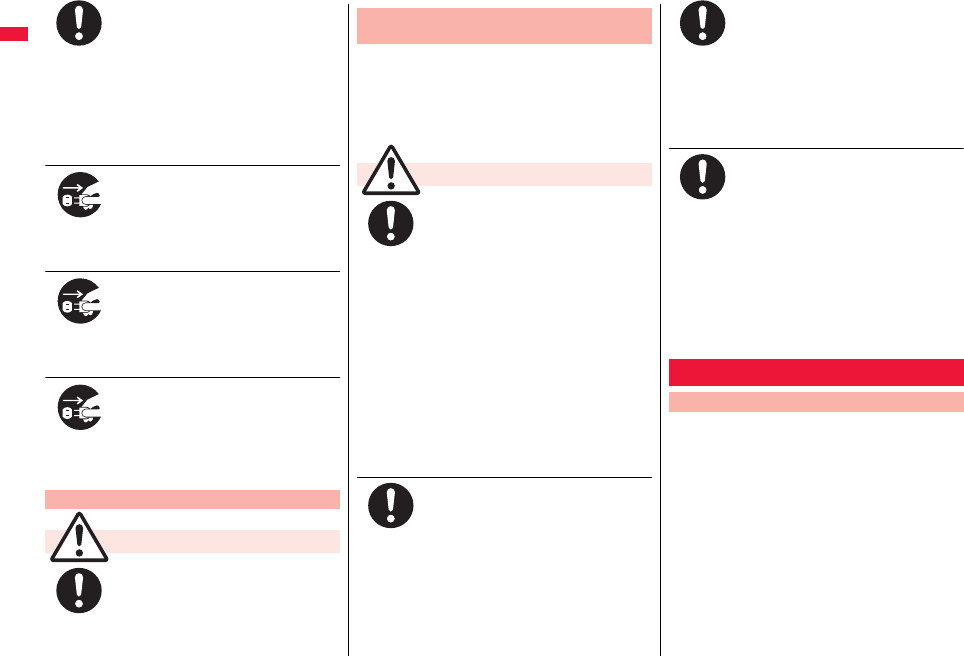
16
Easy Search/Contents/Precautions
When removing the adapter/
charger out of the outlet or
cigarette lighter socket, do not
forcibly pull the adapter/charger
cord or power cord, instead take
hold of the power plug and then
pull.
If you pull the plug out by the cord, the
cord may be damaged, which could
result in electric shock or fire.
When the adapter/charger is not
to be used for a long period of
time, unplug the power cord from
the outlet.
Otherwise, electric shock, fire, or
malfunction may result.
If liquids such as water get in the
charger, unplug the power cord
immediately from the outlet or
cigarette lighter socket.
Otherwise, electric shock, smoke or fire
may result.
Before cleaning, pull the power
plug out of the outlet or cigarette
lighter socket.
Otherwise, electric shock may result.
Be careful not to touch the cut
surface of the UIM (IC portion)
when removing it.
You may hurt your hand or fingers.
Precautions for UIM
Caution
Do
Pull the
power plug
out
Pull the
power plug
out
Pull the
power plug
out
Do
■The description below meets “Guidelines on
the Use of Radio-communication Equipment
such as Cellular Telephones – Safeguards for
Electronic Medical Equipment” by the
Electromagnetic Compatibility Conference
Japan.
Comply with the following in
hospitals or health care facilities:
≥Do not carry the FOMA terminal into
operating rooms, intensive care units
(ICU) or coronary care units (CCU).
≥Turn off the FOMA terminal in hospital
wards.
≥If there is any electronic medical
equipment near you, turn off the
FOMA terminal even when in a
location such as a lobby.
≥Comply with any regulations of
hospital and health care facilities
instructing you not to use or carry in a
mobile phone.
≥If the Auto Power ON function is set,
deactivate the setting, then turn the
power off.
Turn off the FOMA terminal in
crowded areas such as inside
trains during rush hour, as
someone with an implanted
cardiac pacemaker or implanted
defibrillator may be near you.
Operation of an implanted cardiac
pacemaker or implanted defibrillator can
be affected by radio waves.
Notes on using near electronic
medical equipment
Warning
Do
Do
If you use an implanted cardiac
pacemaker or implanted
defibrillator, use the mobile
phone 22 cm or more away from
an implanted cardiac pacemaker
or implanted defibrillator.
Operation of an implanted cardiac
pacemaker or implanted defibrillator can
be affected by radio waves.
Patients using electronic medical
equipment other than implanted
cardiac pacemakers or implanted
defibrillators (outside medical
establishments for treatment at
home, etc.) should check the
influence of radio waves upon the
equipment by consulting its
manufacturer.
Operation of electronic medical
equipment can be affected by radio
waves.
■Do not wet the equipment.
The FOMA terminal, battery, adapter/charger, and UIM
are not waterproofed. Do not use them in
environments, which are high in humidity such as in
bathrooms, and do not allow them to get wet from rain.
Furthermore, if carrying them against your body, they
become moist due to perspiration and the internal parts
may become corroded, causing malfunction. If the parts
are found to have been damaged due to exposure to
the liquids, any repairs will not be covered by warranty,
or repairs may not be possible. This may be repaired at
a cost if repairs are possible.
Handling Precautions
General notes
Do
Do
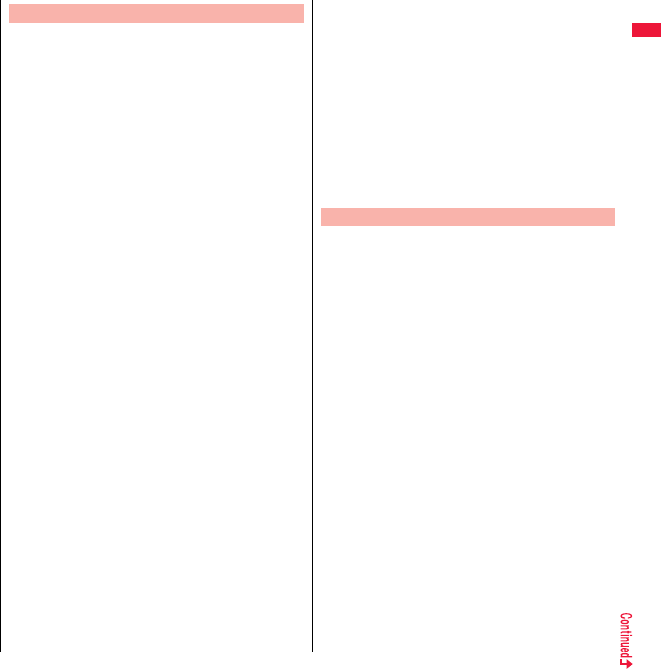
17
Easy Search/Contents/Precautions
■Use a dry soft cloth such as the one for
cleaning glasses to clean the equipment.
≥The screen of the FOMA terminal sometimes has a
special coating so that they are easier to see. If you
rub it roughly with a dry cloth, it might be scratched.
Take care of the way of handling, and use only a dry,
soft cloth such as the one for cleaning glasses. If the
screen is left with water drop or stain adhered, smear
may be generated or the coating might peel off.
≥Do not use alcohol, thinner, benzene, detergent or
other solvents for cleaning, otherwise the printing
may be removed or discoloration may result.
■Occasionally clean the terminals of the
equipment using a dry cotton swab.
If the terminals become soiled, the connection might
deteriorate so that the power turns off or the battery
does not charge fully. Wipe the terminals with a dry
cloth or cotton swab.
■Do not place the FOMA terminal near an air
conditioner outlets.
Condensation may form due to rapid changes in
temperature, and this may corrode internal parts and
cause malfunction.
■Do not apply excessive force onto the FOMA
terminal and battery pack.
If you put the FOMA terminal in a bag along with many
other articles or sit with the FOMA terminal in a clothes
pocket, the display, internal circuitry and the battery
pack could be damaged or malfunction. Also, if an
external device is left connected to the connector
terminal, the connector could be damaged, or
malfunction.
■Carefully read each instruction manual
attached to the FOMA terminal, adapter/
charger, or desktop holder.
■Do not rub or scratch the display part with
metals.
Doing so might cause damage to the part, resulting in
trouble or malfunction.
■Avoid using in extremely high or low
temperatures.
The FOMA terminal should be used within a temperature
range of 5°C to 35°C and a humidity range of 45% to 85%.
■The FOMA terminal, if operated near land-line
phones, television sets, radios or other
devices that are in use, may affect them. You
should operate your FOMA terminal as far
away from such equipment as possible.
■It is recommended that you make separate
notes of the information stored in the FOMA
terminal and keep such notes in a safe place.
We take no responsibility for any loss of the stored data
items.
■Do not drop the FOMA terminal or subject it to
strong impacts.
Malfunction or damage may result.
■Do not insert an external device to the
connector terminal (earphone/microphone
terminal) at a slant when connecting, and do
not pull it out when it is inserted.
Malfunction or damage may result.
■Make sure that nothing, such as a strap, gets
caught between the parts of the FOMA
terminal when you close it.
Otherwise, malfunction or damage may result.
■The FOMA terminal becomes warm during
use or charging but this is not an abnormality.
Use the FOMA terminal as it is.
■Do not leave the camera in places exposed to
direct sunlight.
Pixels may be discolored or burns may result.
■Usually, put the cover of the connector
terminal and microSD card slot to use the
FOMA terminal.
Dust or water might enter into the FOMA terminal,
causing malfunction.
Notes on handling the FOMA terminal
■Do not use the FOMA terminal with the back
cover left removed.
The battery pack might come out, or malfunction or
damage may result.
■Do not put a label or sticker on the back of the
display part of the FOMA terminal.
They may be caught in when you open/close the FOMA
terminal, and malfunction or damage may result.
■While you are using the microSD card, never
take it off or turn off the power to the FOMA
terminal.
Data may be erased or malfunction may result.
■Batteries have a limited life.
Though it varies depending on the usage state, you are
advised to replace the battery if its usable time is
extremely short even when you fully charge it. Make
sure that you buy the specified battery.
■Charge the battery in a place with an
appropriate ambient temperature of 5°C to
35°C.
■Make sure that the battery is charged when
you use the FOMA terminal for the first time
or have not used it for a long period of time.
■The usable time of the battery differs
depending on the usage environment or its
remaining life.
■Depending on how the battery pack is used, it
might swell as its operating life becomes
short, but this is not a problem.
Notes on handling batteries

18
Easy Search/Contents/Precautions
■Note the following points when you store a
battery pack over a long period:
≥Storage in a fully charged state (the state immediately
after charging is completed)
≥
Storage with no battery power left (the state you cannot
turn on the power of the handset due to battery drain)
These may lower the battery pack’s performance and
shorten its operating life.
You are advised to store the battery pack in the state of
two bars of battery icon indication as a guide when you
store it for a long period.
■Charge the battery in a place with an
appropriate ambient temperature of 5°C to
35°C.
■Charge the battery where:
≥There is very little humidity, vibration, and dust.
≥There are no land-line phones, television sets or
radios nearby.
■During charging, the adapter/charger may
become warm. This is not an abnormality, so
continue charging.
■Do not use the DC adapter for charging the
battery when the car engine is not running.
The car battery could go flat.
■When using the power outlet having the
disengaging prevention mechanism, observe
the instructions given in that instruction
manual.
■Do not give a strong shock. Also, do not
deform the charging terminal.
Malfunction may result.
■Be careful not to get your finger or the
adapter/charger cord caught in the parts
when you house the stand of the desktop
holder.
Accidents such as injury or damage may result.
Notes on handling chargers/adapters
■Never use more force than necessary when
inserting/removing the UIM.
■The UIM may become warm during use, but
this is not a sign of a malfunction. Continue
using it as it is.
■The warranty does not cover damage caused
by inserting the UIM into some other types of
IC card reader/writer.
■Always keep the IC portion clean.
■Use a dry soft cloth such as the one for
cleaning glasses to clean the equipment.
■It is recommended that you make separate
notes of the information stored on the UIM
and keep such notes in a safe place.
We take no responsibility for any loss of the stored data
items.
■For the environmental protection, bring any
unneeded UIMs to a handling counter such as
a docomo shop.
■Avoid using in extremely high or low
temperatures.
■Do not damage, carelessly touch, or
short-circuit the IC.
Data might be lost or malfunction may result.
■Do not drop the UIM or subject it to strong
impacts.
Malfunction may result.
■Do not bend the UIM or place something
heavy on it.
Malfunction may result.
Notes on handling the UIM ■Into the FOMA terminal, do not insert the UIM
with a label or sticker pasted.
Malfunction may result.
■As the security for communication using the
Bluetooth function, the FOMA terminal
supports the security function that meets the
Bluetooth Specification. However, the
security may not be sufficient depending on
the configuration. Take care of the security
for communication using the Bluetooth
function.
■Note that even if any leak of data or
information occurs while making connection
using the Bluetooth function, we take no
responsibility.
■With the FOMA terminal, you can use the
following: Headset, Hands-Free, Audio,
Dial-up Communication, Object Push, and
Serial Port. With Audio, you might be able to
use Audio Video Remote Control. (Only with
the compatible Bluetooth devices)
Notes on using Bluetooth function
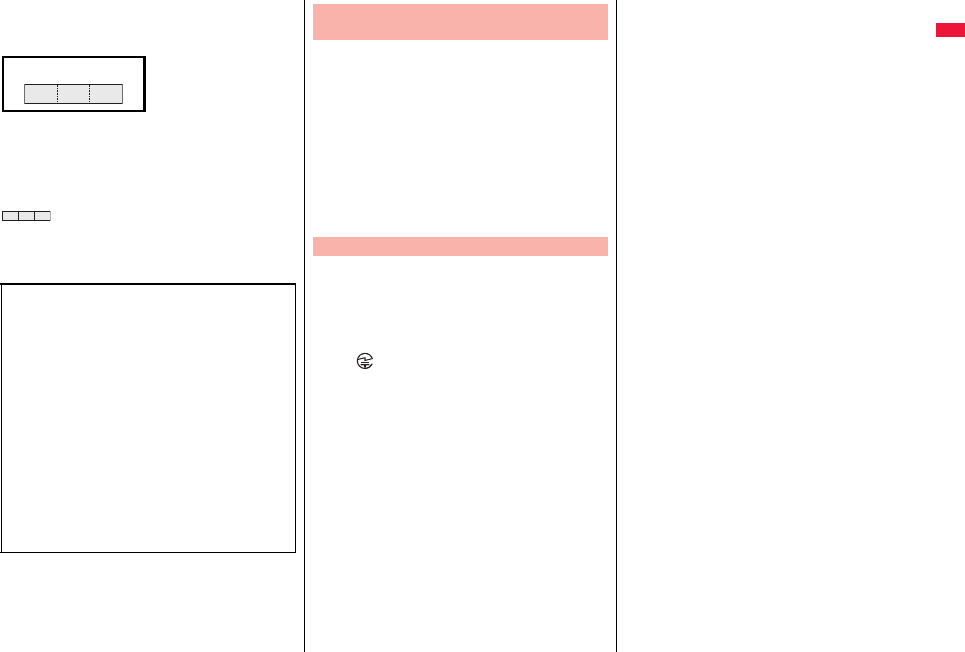
19
Easy Search/Contents/Precautions
■Radio frequencies
The radio frequencies the Bluetooth function
of the FOMA terminal uses are as follows:
■Cautions on Using Bluetooth Devices
Bluetooth operates at radio frequencies assigned to
the in-house radio stations for mobile object
identifiers that have to be licensed and are used in
production lines of a factory, specific unlicensed low
power radio stations, and amateur radio stations
(hereafter, referred to “another radio station”) in
addition to scientific, medical, industrial devices, or
home electric appliances such as microwave ovens.
1. Before using this product, make sure that
“another radio station” is not operating nearby.
2. If radio interference between this product and
“another radio station” occurs, move immediately
to another place or turn off power to avoid
interference.
3. For further details, contact “docomo Information
Center” on the back page of this manual.
2.4 FH 1
2.4 : Indicates radio facilities that use 2400 MHz
frequencies.
FH : Indicates the modulation system is the FH-SS
system.
1 : Indicates that a supposed coverage distance is
10 meters or less.
: Indicates that all radio frequencies 2400 MHz
through 2483.5 MHz are used, and that the
frequencies for mobile object identifiers shall
not be avoided.
■The FeliCa reader/writer function on the
FOMA terminal uses very weak radio waves
which do not require to be licensed as radio
stations.
■The FeliCa reader/writer is operated on the
13.56 MHz frequencies. When you use
another reader/writer nearby, take enough
distance between your FOMA terminal and
the reader/writer. Further, ensure that there
are no radio stations that use the same
frequencies.
■Do not use the modified FOMA terminal.
Using a modified FOMA terminal infringes the
Radio Law.
The FOMA terminals are granted technical regulations
conformity certification as the specified radio equipment
under the Radio Law and bear a “technical conformity
mark ” on the nameplate as evidence of conformity.
Unscrewing the FOMA terminal and modifying internal
components void the technical regulations conformity
certification. Do not use the FOMA terminal in this state,
which infringes the Radio Law.
■Be especially careful not to operate the FOMA
terminal while driving.
You will be imposed punishment if you use the mobile
phone in your hand while driving. If you answer a call
out of necessity, tell the caller with Hands-free that you
will call him/her back, park your car to somewhere safe,
and then dial.
■Use the Bluetooth functions in Japan only.
The Bluetooth functions on the FOMA terminal have
been authorized in compliance with the radio
transmission standards in Japan.
You might be imposed punishment if you use them
overseas.
Notes on handling the FeliCa reader/
writer
Caution
■Use the FeliCa reader/writer functions in
Japan only.
The FeliCa reader/writer functions on the FOMA
terminal have been authorized in compliance with the
radio transmission standards in Japan.
You might be imposed punishment if you use them
overseas.
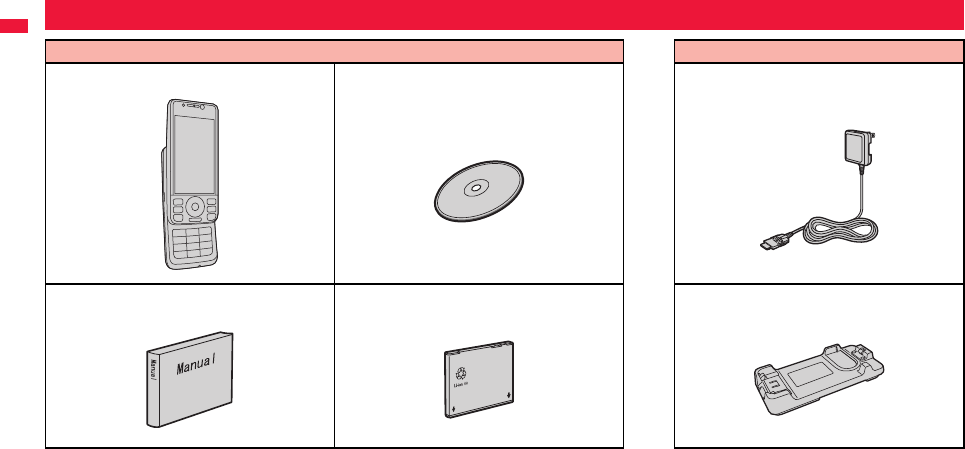
20
Easy Search/Contents/Precautions
Other Options → See page 507
Accessories and Main Options
<Accessories> <Main Options>
≥P-02A Handset
(With Warranty and Back Cover P30)
≥P-02A CD-ROM
The PDF versions of “Manual for PC Connection”
and “Kuten Code List” are included.
≥FOMA AC Adapter 01/02
(With Warranty and Instruction Manual)
≥Instruction Manual
Quick Manual included (See page 550)
≥Battery Pack P19 ≥Desktop Holder P29
(With Instruction Manual)
NTT ドコモ

21
Before Using the Handset
Part Names and Functions . . . . . . . . . . . . . . . . . . . . . . . . . . . . . 22
Opening/Closing FOMA Terminal. . . . . . . . . . . . . . . . . . . . . . . . 24
Navigation Displays and Key Operations . . . . . . . . . . . . . . . . . 24
Main Key Operations from the Stand-by Display . . . . . . . . . . . 26
Viewing Display . . . . . . . . . . . . . . . . . . . . . . . . . . . . . . . . . . . . . . 27
Using Icons on Desktop . . . . . . . . . . . . . . . . . .<Desktop Icon> 29
i-Widget Display and Operations . . . . . . . . . . . . . . . . . . . . . . . . 32
Displaying Description of Icons . . . . . . . . . . . . . . . . . . <Icons> 32
Selecting Menu. . . . . . . . . . . . . . . . . . . . . . . . . . . . . . . . . . . . . . . 32
When You Forget Key Operation . . . . . . . . . . . . . . . . . <Guide> 36
Using UIM (FOMA Card) . . . . . . . . . . . . . . . . . . . . . . . . . . . . . . . 37
Attaching/Removing Battery Pack . . . . . . . . . . . . . . . . . . . . . . . 39
Charging . . . . . . . . . . . . . . . . . . . . . . . . . . . . . . . . . . . . . . . . . . . . 40
Checking Battery Level . . . . . . . . . . . . . . . . . . .<Battery Level> 42
Turning Power ON/OFF . . . . . . . . . . . . . . . . . <Power ON/OFF> 43
Switching to English Display . . . . . . . . . . .<Select Language> 43
Configuring Initial Setting . . . . . . . . . . . . . . . . .<Initial Setting> 44
Setting Date and Time . . . . . . . . . . . . . . . . . . . . . . . <Set Time> 44
Displaying World Time . . . . . . . . . . . . . . <World Time Watch> 45
Notifying the Other Party of Your Phone Number
. . . . . . . . . . . . . . . . . . . . . . . . . . . . . . . . <Caller ID Notification> 46
Checking Your Own Phone Number . . . . . . . . <Own Number> 46
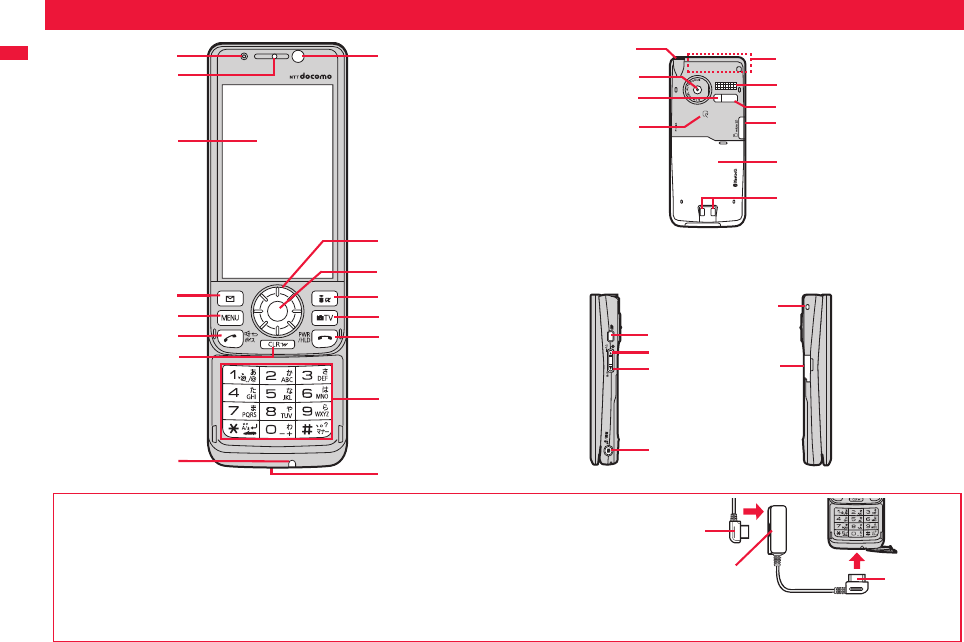
Before Using the Handset
22
Part Names and Functions
2
;
<
>
:
=
6
?
3
8
4
9A
I
J
L
5
7
E
D
F
K
M
N
G
@
1
H
B
C
H
O
■For using earphone
Connect an optional connector-terminal-compatible earphone. When using a
connector-terminal-non-compatible earphone, use an optional plug adapter for connection.
≥When inserting or pulling the plug adapter, take hold of the plug for the handset side and insert or
pull it straight. Be careful not to take hold of the cover of the connector terminal and plug for the
handset side together when you pull it out.
≥The Earphone Plug Adapter for External connector terminal 01 (option) can be connected with a
triple pole mini plug only. For details, refer to the instruction manual for the Earphone Plug Adapter
for External connector terminal 01.
Flat plug of the
Flat-plug Earphone/
Microphone with Switch
Earphone terminal (Flat-plug)
Example for connecting the Flat-plug
Earphone/Microphone with Switch (option)
Plug for the
handset side

23
Before Using the Handset
1Light sensor
・For sensing brightness (See page 114)
≥Do not cover the light sensor with your hands or do
not put a sticker on it. Doing so might disable you to
detect the brightness.
2Earpiece
・For listening to the other party’s voice
3Display
(See page 27)
4l Mail key
5m Menu key
6d Start key/Hands-free key
・For making/receiving calls (See page 48 and page 62)
・For talking with Hands-free (See page 61)
7r Clear key/i-Widget key
・For returning to the previous operation
・For clearing entered text or a phone number
8Microphone
・For speaking to the other party
9Inside camera
・For shooting photos of yourself (See page 230)
・For displaying your face during a videophone call
:o Speed selector
;Call/Charging indicator
・Flickers for incoming calls/mail and during a call.
(See page 117)
・Lights in red during charging.
≥The flickering pattern and color tone of the illumination
might look different depending on the type of the
FOMA terminal you use.
<i i-mode key/i-αppli key
=c Camera key/1Seg key
>h Power/End key
・For ending calls
・For ending respective functions
・For turning on the power (for at least one second)/
For turning off the power (for at least two seconds)
(See page 43)
?Numeric keys
・For entering phone numbers and text
@Connector terminal
・For connecting the AC adapter (option), DC adapter
(option), FOMA USB Cable with Charge Function 01/
02 (option), or Stereo Earphone Set 01 (option), etc.
≥Integrated terminal for connecting earphone or for
charging, etc.
A1Seg antenna
・For receiving 1Seg broadcasting (See page 251)
BOutside camera
・For shooting portraits and/or landscapes
(See page 230)
・For catching sight of persons and/or landscapes
during a videophone call
CPhoto light
・Lights/Flickers when you shoot with the camera.
・Used for shooting in a dark place. (See page 239)
Df mark
・The IC card is mounted.
≥Use the IC card function placing this mark over the
scanning device. You cannot dismount the IC card.
(See page 315)
EFOMA antenna
≥The FOMA antenna is embedded in the handset. Do
not cover the antenna with your hand for better
communication.
FSpeaker
・For sounding ring tones
・For listening to the other party’s voice when
Hands-free is activated (See page 61)
GInfrared data port
・Used for infrared communication and the infrared
remote control. (See page 382 and page 386)
HmicroSD card slot
・For inserting microSD card (See page 368)
IBack cover
・Remove this when attaching/removing the battery
pack and UIM. (See page 37 and page 39)
≥Do not peel off the sticker on the back of the back
cover. If you peel it off, you might not be able to read
and write the IC card.
JCharging terminal
Kx Multi key
L< Side ▲ key
・For scrolling up page by page
M> Side ▼ key
・For scrolling down page by page
Np Recording key/PushTalk key
・For making/receiving PushTalk calls
(See page 78 and page 81)
OStrap hole
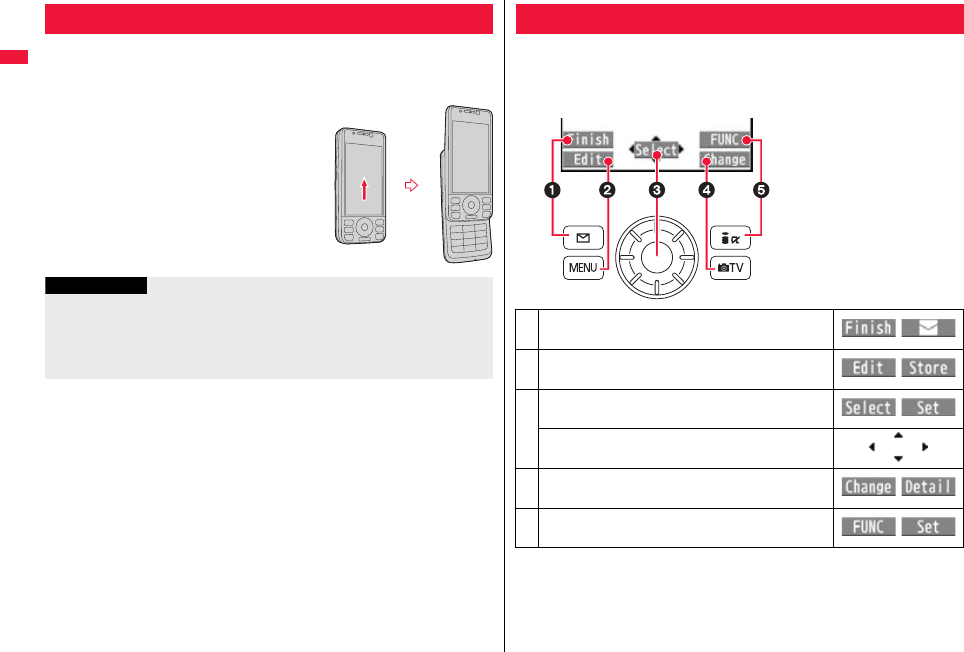
24
Before Using the Handset
Hold the FOMA terminal with both hands to slide the display upward/
downward.
Take care not to touch the keys when you open or close the FOMA
terminal. Key operation errors may result.
≥When a call comes in, you can answer it just by
opening the FOMA terminal. (See page 65)
≥When a missed call or new mail message is found,
you can display the detailed Missed Call display or the
Inbox list just by opening the FOMA terminal. (See
page 113)
Opening/Closing FOMA Terminal
Information
≥You can use the horizontal display for Full Browser, PC Movie player, Camera, 1Seg,
Music&Video Channel, i-αppli, i-motion player, and Video player. You cannot use it for
other functions.
≥When you open/close the FOMA terminal while a confirmation display for selecting
“YES/NO” is shown, the confirmation display may be cleared.
When you want to execute the operation shown on the vertical display,
press the corresponding key as below.
≥While the horizontal display is shown, you can operate in the same way as on the
vertical display depending on the function.
■Basic display examples and key assignments
Navigation Displays and Key Operations
1Indicates the operation you can perform with
the l key.
2Indicates the operation you can perform with
the m key.
3
Indicates the operation you can perform with
the Oo key.
Indicates the direction in which you can scroll
and select items with the Mo key.
4Indicates the operation you can perform with
the c key.
5Indicates the operation you can perform with
the i key.
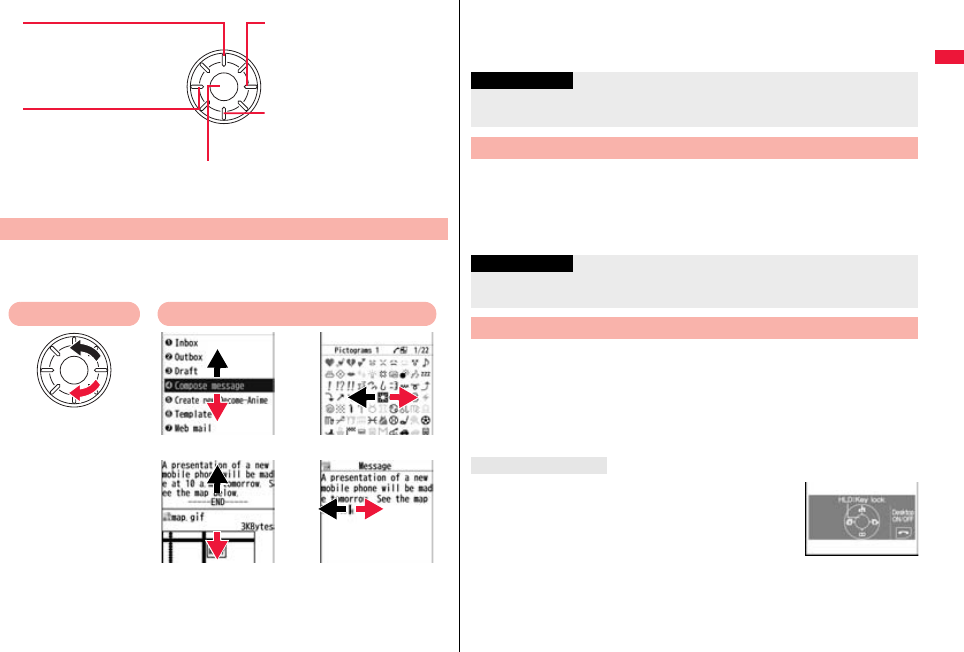
25
Before Using the Handset
■Operating speed selector
Depending on the display being shown, you can select items and move
the cursor by rotating the speed selector in the same way as you press
Mo.
≥The following operations are also available:
・Adjusting earpiece volume, ring volume, etc. (See page 65, page 66)
Operating by Rotating Speed Selector
Zo
・Moves the cursor or highlighted
display up. (Press and hold to scroll
continuously.)
・Scrolls the page up.
Vo
・Moves the cursor to the right.
・Scrolls forward page by page.
(Press and hold to scroll
continuously.)
Oo
・Fixes the operation.
Co
・Moves the cursor to the left.
・Scrolls back page by page. (Press
and hold to scroll continuously.)
Xo
・Moves the cursor or highlighted
display down. (Press and hold to
scroll continuously.)
・Scrolls the page down.
Scrolling pages
Selecting items Selecting pictograms, etc.
Moving a cursor
Rotating direction Operation example
・Adjusting zoom magnification when shooting with the camera (See page 238)
・Adjusting volume during music playback, etc. (See page 281)
・Switching the displayed still images (See page 345)
・Adjusting volume during playback of movies, i-motion movies, etc. (See page 352)
You can set whether to validate the rotating operation of the speed
selector.
1m1Set./Service1Other settings
1Speed selector setting1ON or OFF
You can set whether to show the operation for such as pressing Zo, Xo,
Co, and Vo, when you rotate the speed selector from the Stand-by
display.
1m1Set./Service1Display1Key guidance
1ON or OFF
When you rotate the speed selector from the Stand-by display,
the operation for such as pressing Zo, Xo, Co, and Vo
are shown. (See page 26)
≥The key guidance is shown regardless of “Speed selector
setting”.
Information
≥The rotating operation is not valid in Power Saver Mode.
≥The rotating operation may not be valid depending on the function.
Speed Selector Setting
Information
≥Depending on the i-αppli program, the speed selector might not be operable even
when “ON” is set.
Key Guidance
When “ON” is set
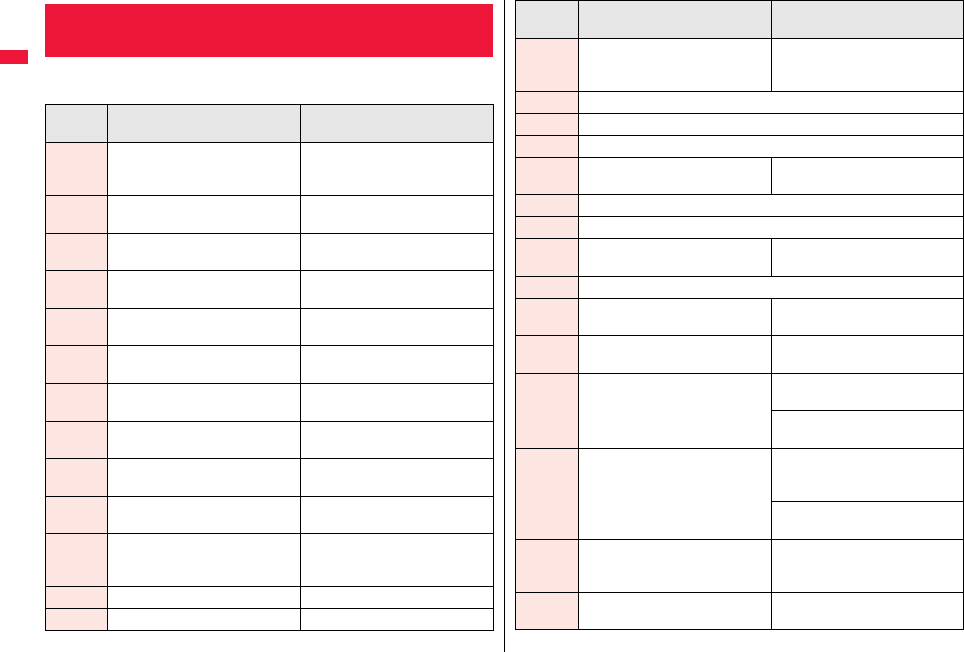
26
Before Using the Handset
From the Stand-by display, you can execute the following actions by
operating each key:
Main Key Operations from the Stand-by
Display
Key
operation Press the key for a short time Press and hold the key for at least
one second
*Oo
Shows the display for selecting an
icon, etc. on the Stand-by display.
(See page 31, page 68, page 111)
Switches Key Lock on/off.
(See page 131)
*ZoShows the Channel list.
(See page 210) —
*XoShows the Search Phonebook
display. (See page 94)
Shows the registration display for the
Phonebook entries. (See page 88)
*CoShows the Received Call list.
(See page 53)
Shows the Received Address list.
(See page 171)
*VoShows the Redial list. (See page 52) Shows the Sent Address list.
(See page 171)
+lShows the Mail menu.
(See page 162)
Executes Check New Messages.
(See page 157)
+iShows the i-mode menu.
(See page 190)
Shows the Software list.
(See page 291)
+mShows Main Menu. (See page 32) Sets/Releases IC Card Lock.
(See page 316)
+cActivates the camera in Photo Mode.
(See page 233) Starts 1Seg. (See page 253)
-dMakes a call. (See page 48) Accesses a voice dial entry.
(See page 100)
-hShows/Clears the icons, etc. on the
Stand-by display. (See page 112)
Turns off the power. (Press and hold
the key for at least two seconds)
(See page 43)
+rExecutes i-Widget. (See page 310) Resets Main Menu. (See page 116)
-0Enters “0”. Enters “+”.
-1Enters “1”.
Measures your current location and
executes the GPS function.
(See page 326)
-2Enters “2”.
-3Enters “3”.
-4Enters “4”.
-5Enters “5”. Switches the backlight on/off.
(See page 114)
-6Enters “6”.
-7Enters “7”.
-8Enters “8”. Switches View Blind on/off.
(See page 115)
-9Enters “9”.
-aEnters “:”. Activates/Deactivates Public Mode
(Drive Mode). (See page 67)
-sEnters “#”. Activates/Deactivates Manner Mode.
(See page 108)
.xShows the Multitask Menu.
(See page 402)
Shows the display for setting 3G/
GSM Setting. (See page 465)
Switches menu functions.
(See page 402)
.<
Switches between the i-αppli
Stand-by display and normal i-αppli
program. (See page 308)
Activates/Deactivates Manner Mode
with the FOMA terminal closed.
(See page 108)
Activates 2in1 with the FOMA
terminal opened. (See page 450)
.>Plays back a record message/voice
memo. (See page 70)
Plays back a videophone record
message/movie memo.
(See page 71)
.pShows the PushTalk Phonebook list.
(See page 82)
Activates MUSIC Player.
(See page 279)
Key
operation Press the key for a short time Press and hold the key for at least
one second
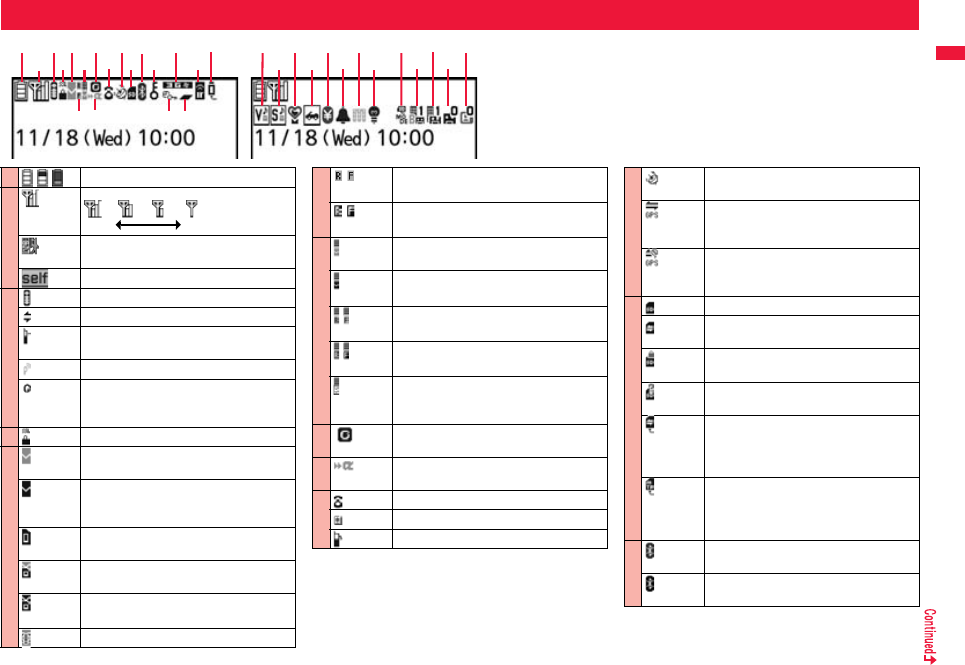
27
Before Using the Handset
Viewing Display
1
2
35 8 ;
:
=
>
?
<
CD
E
H
I
J
K
F
G
4
@A
9
B
6
7
P
O
N
M
L
1Battery level (estimate) (See page 42)
2
Radio waves reception level (estimate)
Strong Weak
You are out of the FOMA service area or
radio waves do not reach.
During Self Mode (See page 126)
3
During i-mode (See page 190)
During i-mode communication (See page 190)
During packet communication (The icon differs
depending on the communication status.)
During PushTalk communication (See page 78)
You get out of the service area while
Network Search Mode is set to “Manual”.
(See page 465)
4During SSL communication (See page 191)
5
(pink) Unread i-mode mail or an SMS message
exists. (See page 155 and page 187)
(dark blue)
The area for i-mode mail and SMS
messages in the FOMA terminal is full.
(See page 155 and page 187)
The area for SMS messages on the UIM
(FOMA card) is full.
(pink) Unread mail exists, and the area for SMS
messages on the UIM (FOMA card) is full.
(dark blue)
Both the FOMA terminal and UIM (FOMA
card) are full.
Area Mail exists. (See page 180)
6
(yellow)
Unread Messages R/F exist.
(See page 177)
(dark blue)
The area for Messages R/F in the FOMA
terminal is full. (See page 178)
7
(pink) i-mode mail is held at the i-mode Center.
(See page 157)
(dark blue)
The box for i-mode mail at the i-mode
Center is full. (See page 155)
(yellow)
Messages R/F are held at the i-mode
Center. (See page 178)
(dark blue)
The box for Messages R/F at the i-mode
Center is full. (See page 178)
i-mode mail is held at the i-mode Center
while Receive Option Setting is set to “ON”.
(See page 156)
8New i-concier information exists.
(See page 212)
9An i-αppli call you did not reply to exists.
(See page 306)
:
During a voice call
During a videophone call
During 64K data communication
;
During measuring the current location
(See page 326)
Location Request Set. is set to “ON” or
“Reject numbers unset”, and it is within the
validity period. (See page 338)
Location Request Set. is set to “ON” or
“Reject numbers unset”, and it is out of the
validity period. (See page 338)
<
A microSD card is inserted.(See page 369)
Data is being read to/written from the
microSD card.
A write-protected microSD card is inserted.
(See page 369)
The inserted microSD card cannot be used.
(See page 369)
A microSD card is inserted, and the FOMA
USB Cable with Charge Function 01/02
(option) is connected in microSD Mode.
(See page 377)
A microSD card is inserted, and the FOMA
USB Cable with Charge Function 01/02
(option) is connected in MTP Mode.
(See page 377)
=
(blue) A Bluetooth device is connected.
(See page 424 and page 426)
(black) A Bluetooth device is connected and power
consumption is low. (See page 424)
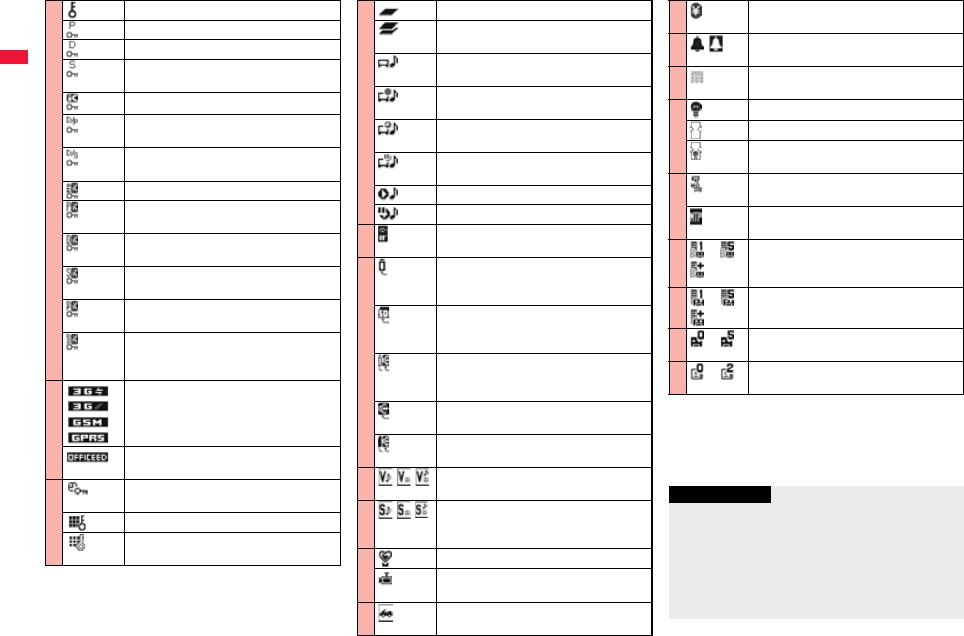
Before Using the Handset
28
≥For the horizontal display, icons appear at the lower right
of the display.
≥The clock at the upper right of the display (at the lower
right of the horizontal display) does not appear when the
icon B or C is displayed.
>
During Lock All (See page 124)
During Personal Data Lock (See page 127)
During Keypad Dial Lock (See page 131)
During Secret Mode or Secret Data Only
(See page 132)
During IC Card Lock (See page 316)
Both Keypad Dial Lock and Personal Data
Lock are set.
Both Keypad Dial Lock and Secret Mode/
Secret Data Only are set.
Both IC Card Lock and Lock All are set.
Both IC Card Lock and Personal Data Lock
are set.
Both IC Card Lock and Keypad Dial Lock
are set.
Both IC Card Lock and Secret Mode/Secret
Data Only are set.
IC Card Lock, Keypad Dial Lock, and
Personal Data Lock are simultaneously set.
IC Card Lock, Keypad Dial Lock, and Secret
Mode/Secret Data Only are simultaneously
set.
?
Type of in-use network (See page 461)
You are in the OFFICEED area.
(See page 456)
@
Timer Lock ON At Close is set.
(See page 127)
During Key Lock (See page 131)
While Key Lock is temporarily released
(See page 132)
A
During Multitask (See page 401)
Multiple functions are activated.
(See page 401)
While watching a 1Seg program
(See page 253)
During recording of a 1Seg program
(See page 260)
During recording of a 1Seg program by
Timer Recording (See page 264)
During pause of 1Seg program recording
(See page 261)
During music playback (See page 279)
During music pause (See page 279)
BDuring infrared communication
(See page 382 and page 386)
C
The FOMA USB Cable with Charge
Function 01/02 (option) is connected in
Communication Mode.
The FOMA USB Cable with Charge
Function 01/02 (option) is connected in
microSD Mode. (See page 377)
During talk or communication through a
USB Hands-free compatible device
(See page 61)
A USB Hands-free compatible device is
connected. (See page 61)
A USB Hands-free compatible device is
connected in microSD Mode. (See page 61)
DVibrator is set to other than “OFF”.
(See page 106)
E
Ring Volume is set to “Silent” or
Mail/Msg. Ring Time is set to “OFF”.
(See page 66 and page 108)
F
During Manner Mode (See page 108)
Remote Monitoring is set to “ON”.
(See page 77)
GDuring Public Mode (Drive Mode)
(See page 67)
HThe call cost has exceeded the specified
limit. (See page 417)
IAn alarm is set.
(See page 264 and page 405)
JA Music&Video Channel program is booked.
(See page 270)
K
Backlight is set to “OFF”. (See page 114)
View Blind is set to “ON”. (See page 115)
Backlight is set to “OFF” and View Blind is
set to “ON”.
L
USB Mode Setting is set to “microSD
mode”. (See page 377)
USB Mode Setting is set to “MTP mode”.
(See page 377)
M
∼・
Voice mail messages for Number B are held
at the Voice Mail Center in Dual Mode of
2in1. (See page 455)
N∼・
Voice mail messages are held at the Voice
Mail Center. (See page 440)
O∼The number of record messages
(See page 69)
P∼The number of videophone record
messages (See page 69)
Information
≥Some characters and symbols on the display might be
modified or abbreviated.
≥The color liquid crystal display uses high-precision
production technology. The slightest change in the
environment or other factors may result in unlit or
permanently lit pixels, but this is not a manufacturing
defect.
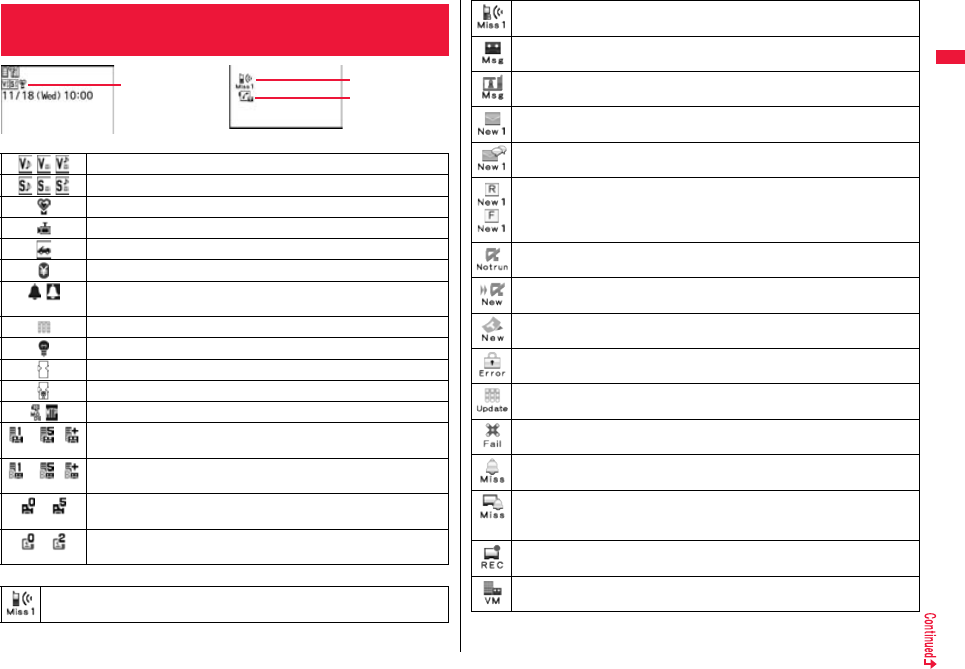
29
Before Using the Handset
■Operation when a status icon is selected
■Operation when a notification icon is selected
<Desktop Icon>
Using Icons on Desktop
Status icon Notification icon
Desktop icon
Shows the display for Vibrator. (See page 106)
Shows the display for Ring Volume. (See page 66)
Shows the display for Manner Mode Set. (See page 110)
Shows the display for Remote Monitoring. (See
page 77
)
Shows the display for releasing Public Mode (Drive Mode). (See page 67)
Shows the display for Notice Call Cost. (See page 417)
Shows the list of Alarm, Schedule, ToDo, TV Timer, or Timer Recording.
(See page 261, page 262, page 404, page 407 or page 411)
Shows the Music&Video Channel display. (See page 270)
Shows the display for Backlight. (See page 114)
Shows the display for View Blind. (See page 115)
Shows the display for “Set./Service” → “Display”.
Shows the display for USB Mode Setting. (See page 377)
∼・ Shows the display for playing back Voice Mail messages.
(See page 441)
∼・ Shows the display for playing back Voice Mail messages.
(See page 441)
∼Shows the display for Rec. Msg/Voice Memo.
(See page 69, page 70, page 106 and page 415)
∼Shows the display for Rec. Msg/Voice Memo.
(See page 69, page 70, page 106 and page 415)
Missed call
Shows the Missed Call list. (See page 53)
Missed call to Number B of 2in1
Shows the Missed Call list. (See page 53)
Record message
Shows the Record Message list. (See page 70)
Videophone record message
Shows the Videophone Record Message list. (See page 71)
New i-mode mail or SMS
Shows the Inbox list. (See page 160)
New chat mail
Starts Chat Mail. (See page 184)
New Message R/F
Shows the Message R/F list. (See page 178)
i-αppli did not start automatically
Shows the i-αppli Auto Start Info. (See page 305)
i-αppli call you did not reply to
Shows the i-αppli call logs. (See page 307)
A ToruCa file is received from a scanning device
Shows the ToruCa File list. (See page 320)
A security error occurred on the i-αppli Stand-by display
Shows the Security Error History. (See page 293)
Success in downloading a Music&Video Channel program
Activates Music&Video Channel. (See page 270)
Failure in downloading a Music&Video Channel program
Activates Music&Video Channel. (See page 271)
Missed alarm
Shows the contents of the alarm that could not be notified. (See page 406)
Missed TV timer
Shows the contents of the TV timer that could not be notified.
(See page 265)
Timer recording was completed
Shows the contents and results of the timer recording. (See page 265)
Messages are held at the Voice Mail Center
Shows the display for playing back Voice Mail messages. (See page 441)
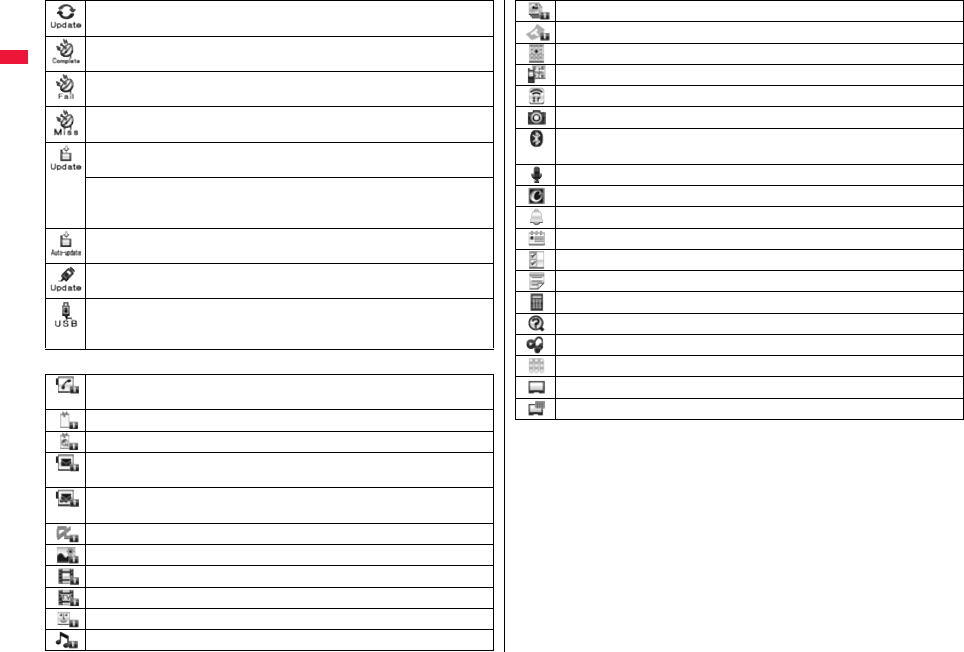
30
Before Using the Handset
■Operation when a desktop icon is selected
The Phonebook could not be updated by Data Security Service
Shows the update display for Data Security Service. (See page 137)
Provide Location was executed automatically
Shows Location History. (See page 335)
Provide Location could not be executed automatically
Shows Location History. (See page 335)
You did not respond to a location provision request
Shows Location History. (See page 335)
Software Update is needed
Starts Software Update. (See page 526)
Software Update was executed
Shows the Update Completion display or the reason for not completing.
(See page 525)
Software rewriting is possible
Shows the rewriting confirmation display. (See page 524)
Pattern data was updated automatically
Shows the updated result. (See page 530)
The FOMA terminal and a personal computer are connected by the FOMA
USB Cable with Charge Function 01/02 (option)
Shows the display for USB Mode Setting. (See page 377)
Shows the dialing display with the phone number entered.
(See page 48 and page 78)
Shows the site of that URL. (See page 190)
Shows the site of that URL by Full Browser. (See page 216)
Shows the Message Composition display with the mail address entered.
(See page 142)
Shows the SMS Composition display with the mail address entered.
(See page 186)
Starts the i-αppli program.※ (See page 291)
Shows it on the Picture viewer.※ (See page 344)
Plays it back by the i-motion player.※ (See page 351)
Plays it back by the Video player.※ (See page 358)
Plays it back by the Chara-den player.※ (See page 361)
Plays it back by the Melody player.※ (See page 364)
※ When the original data is deleted or overwritten, the desktop icon is disabled.
Shows it on the PDF viewer.※ (See page 389)
Shows it on the ToruCa viewer.※ (See page 318)
Shows the Private menu. (See page 413)
Shows the Bar Code Reader menu. (See page 245)
Shows the Ir Data Receiving display. (See page 384 and page 385)
Shows the Camera menu. (See page 233 and page 236)
Shows the Bluetooth Function Selection display.
(See page 424, page 426, and page 428)
Starts Voice Recorder. (See page 388)
Shows the i-concier display. (See page 212)
Shows the list of Alarm. (See page 404)
Shows the Calendar display. (See page 408)
Shows the ToDo list. (See page 411)
Shows the list of Text Memo. (See page 417)
Shows the calculator. (See page 417)
Shows the display for 使いかたナビ (Guide). (See page 36)
Starts MUSIC Player. (See page 278)
Shows the Music&Video Channel display. (See page 272)
Shows the Viewer display. (See page 253)
Starts i-αppli Program Guide. (See page 258)
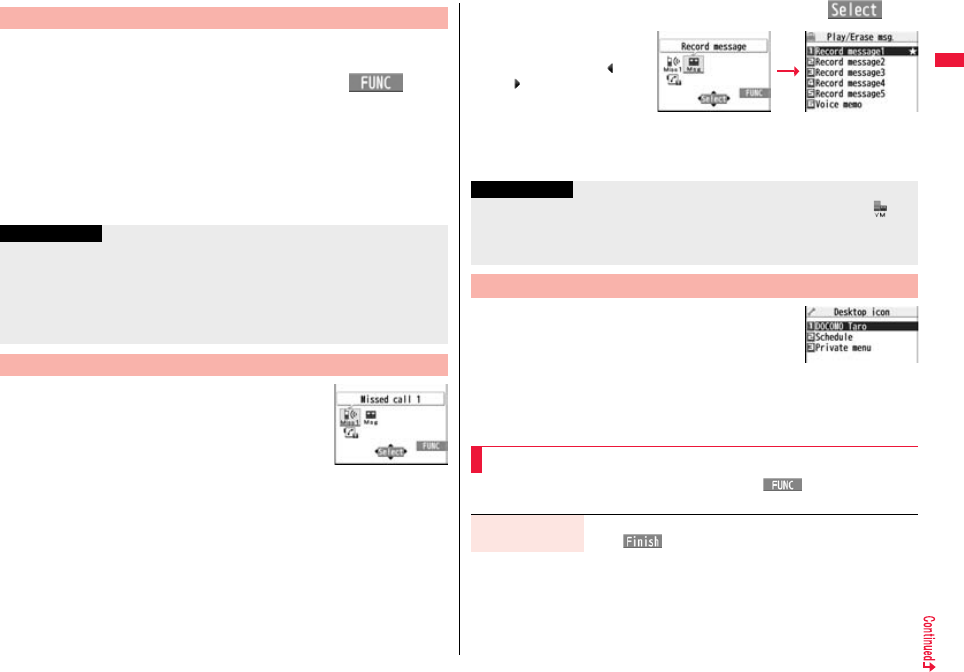
31
Before Using the Handset
You can paste up to 15 desktop icons of such as phone numbers, mail
addresses, etc.
1The display for an item to be pasted 1i()
1Add desktop icon1YES
≥When you operate from the detailed mail display, select “Store” from the Function
menu and then select “Add desktop icon”. If the addresses of the sender and
another recipient of simultaneous mail are found or the multiple destination
addresses are found, select a mail address or phone number to be pasted.
≥When you operate from the Full Browser display, select “Others” from the
Function menu and then select “Add desktop icon”.
1Press Oo.
Paste Icons to Desktop
Information
≥You may not be able to paste the URL to the desktop depending on the site.
≥You can store the title for URL of up to 16 full-pitch/32 half-pitch characters. When the
number of characters for the title exceeds that much, the characters in excess are
deleted. If no title exists for a site, up to 22 half-pitch characters of the URL excluding
“http://” or “https://” is displayed.
≥Some files and data might not be pasted to the desktop.
Proceed to Respective Functions from Icons on Desktop
2Use Mo to highlight an icon, and press Oo().
≥Up to five “Desktop icons”
are displayed. If there are
six or more icons, “ ” and
“ ” are displayed.
≥A “Notification icon” is
deleted when each function
is executed. To delete all
“Notification icons”, press
and hold r for at least one second from the display in step 1.
1m1Set./Service1Display
1Desktop icon
The list of desktop icons pasted to the desktop is
displayed.
2Select the icon whose details are to be displayed.
≥You can show the Function menu also by pressing i( ), while highlighting an
icon from the Stand-by display.
When a record message
icon is selected
Information
≥When the notification icon of “Messages are held at the Voice Mail Center” ( )
appears while you are overseas, you cannot operate the Voice Mail function from the
notification icon. Follow the steps of “Operate Voice Mail Service at the Country You
Stay” on page 468.
+m-6-3
Check Details of Desktop Icon
Desktop Icon list
Function Menu of the Desktop Icon List
Add to desktop 1Put a check mark for the function to be added
1l()
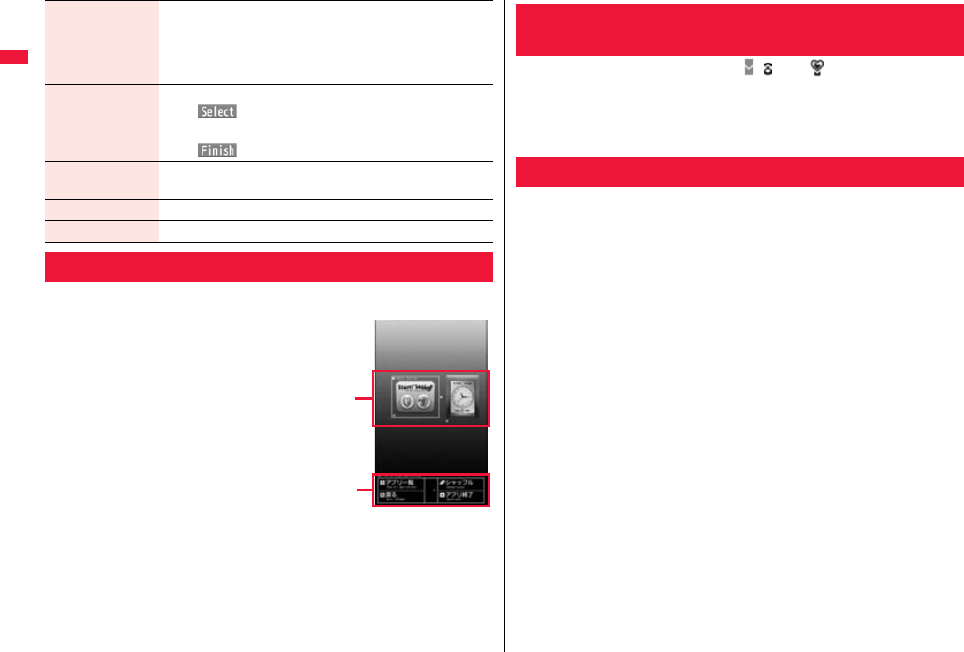
32
Before Using the Handset
From the i-Widget display, you can simultaneously start multiple Widget
αppli programs and show them on a list.
1Widget αppli
You can show a Widget αppli program.
You can show the Widget αppli operation display by
selecting it.
2Navigation displays
Navigations corresponding to the key operations are
indicated.
≥You can randomly change the display order of Widget
αppli programs by pressing i[シャッフル (Shuffle)]
from the i-Widget display.
≥See page 310 for detailed operations of i-Widget.
Edit title 1Enter a title.
≥You can enter up to 16 full-pitch/32 half-pitch characters.
However, the number of characters for the title displayed when
you highlight the icon is up to 11 full-pitch/ 22 half-pitch
characters from the beginning of the title.
Sort 1Select a desktop icon1Use Bo to change the order
1Oo()
≥To change the order in succession, repeat the above steps.
1l()1YES
Reset desktop The desktop icons are reset to the default.
1YES
Delete this 1YES
Delete all 1YES
i-Widget Display and Operations
i-Widget display
1
2
The symbols on the display (such as , , and ) are called icons. You
can check the meanings of them on the display.
1m1Set./Service1Display1Icons
1Use Mo to highlight an icon.
Press m of the FOMA terminal to show Main Menu and then execute,
set, or check respective functions.
≥Some functions can be selected also by the operation other than pressing m. In this
manual, the operation by the easier way is described.
≥You can also switch to Simple Menu focusing on only basic functions for easy
operation. (See page 115)
≥This FOMA terminal supports Kisekae Tool (see page 116). If you use Kisekae Tool to
change the design of the Menu display, some menu configurations change according
to the usage frequency depending on the type of the menu.
Further, some menu numbers that are assigned to the menu items do not apply.
■Scroll Selection
Main Menu is composed of 12 main menu icons indicating each function.
≥If you select a main menu icon, the Sub-menu Item Selection display appears. If you
further select a sub-menu item, the Lower Sub-menu Item Selection display appears.
≥By repeating selecting, you can set and check the function.
■Menu Number Selection
You can display some functions by pressing m + menu number (see page 476).
■Multitask is Supported
≥You can simultaneously use some functions in Main Menu. (See page 401)
+m-3-6
<Icons>
Displaying Description of Icons
Selecting Menu
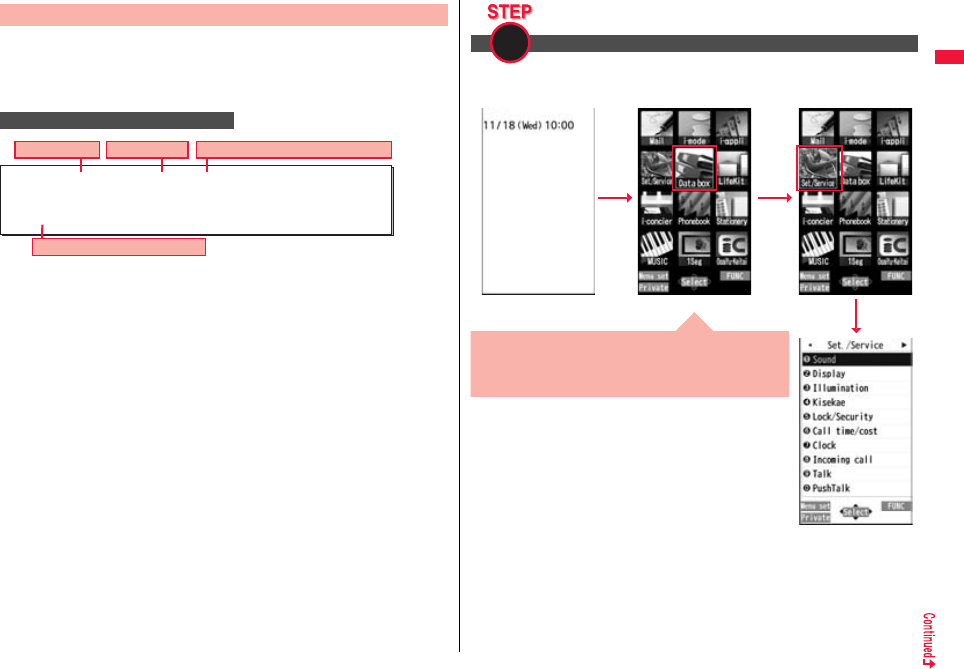
33
Before Using the Handset
In this manual, the description of the speed selector operation (selection
of top/bottom/left/right, and press of Oo after selecting/entering a
function item) is omitted. Scroll selection is explained below using the
example of selecting the function “Quality alarm”:
Scroll Selection
Description Example of Steps
1
Main menu icon Sub-menu item Function name of lower sub-menu item
Items which appear on the display
No tone. . . . . . . . . Does not sound.
High tone. . . . . . . . High alarm sounds.
Low tone. . . . . . . . Low alarm sounds.
mSet./ServiceTalkQuality alarmSelect an alarm.
Select “Set./Service” from Main Menu. Main Menu at purchase differs depending on the
body color. (See page 480)
Select a main menu icon from the menu function
1
≥Press *Mo to highlight the icon. Press and hold *Mo to scroll
the icons continuously.
≥If you have not touched any key for 15 seconds, the
Stand-by display returns.
+m*Mo
*Oo
Main Menu

34
Before Using the Handset
Select “Talk” from “Set./Service”.
Select “Quality alarm” from “Talk”.
Select a sub-menu item from the menu function
2
Select a desired lower sub-menu item (function)
*Oo
≥The highlighted item is the currently
selected one.
≥Press *Xo to highlight the item
below, and *Zo to highlight the item
above.
≥Press and hold *Bo to scroll the
items continuously.
≥Press *No to scroll page by page.
3
*Oo
≥
Press
*Xo
to highlight the item below,
and
*Zo
to highlight the item above.
≥
Press and hold
*Bo
to scroll the items
continuously.
≥
When the items are listed over
multiple pages, the total number of
pages and the current page number
are shown at the upper right of the
display.
Some menu items have even more detailed menus.
The example below shows how to set “Low tone” for “Quality alarm”.
Menu Number Selection is explained below using the following example:
Set or check the function
4
Menu Number Selection
Description Example of Menu Number
*Oo
≥The highlighted item is the currently
selected one.
≥Press *Xo to highlight the item
below, and *Zo to highlight the item
above.
≥Press and hold *Bo to scroll the
items continuously.
Menu number
<Quality Alarm>
Sounding Alarm when a Line is Nearly Disconnecting
+m-7-5
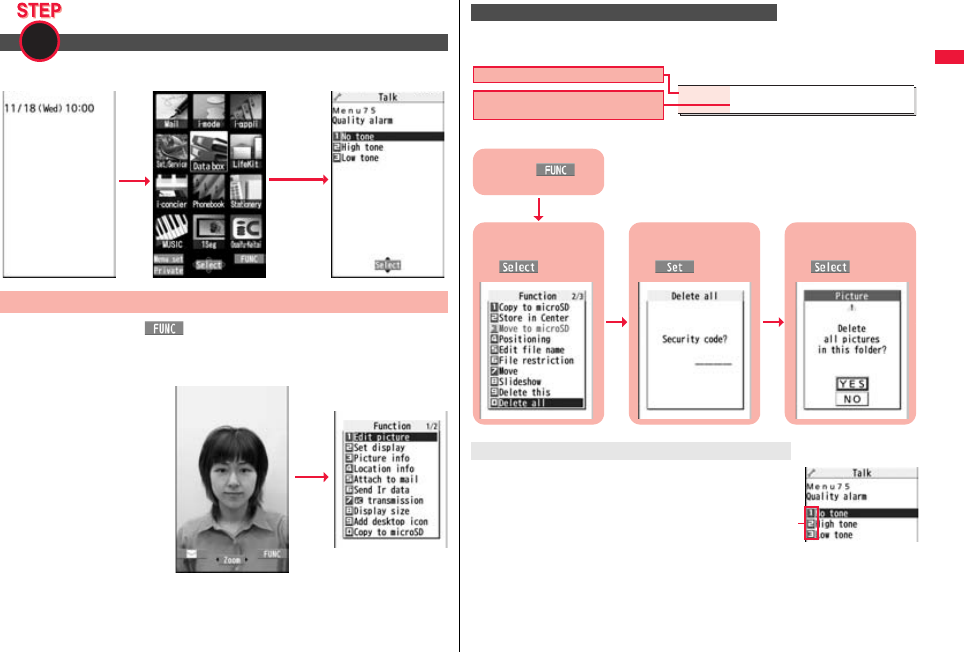
35
Before Using the Handset
From the Stand-by display, press m75.
If you press i when “ ” is shown at the lower right of the display,
the Function menu including selectable items such as “Save”, “Edit”,
and “Delete” appears in each operation. The contents of the Function
menu depend on the display from which you show the Function menu.
≥When the items are listed
over multiple pages, the total
number of pages and the
current page number are
shown at the upper right of
the Function Menu display.
Call up the function using the menu number
1
Function Menu
+m-7-5
+i
In this manual, the operation of the Function menu is described as
follows:
An actual operation is done as follows:
Press the numeric key corresponding to the
displayed item number.
Description Example for Function Menu
To select an item quickly <Direct selection>
Delete all You can delete all files.
Enter your Terminal Security CodeYES
Item displayed in the Function menu
Operating procedures after selecting
an item in the Function menu
Press +i().
Use *Mo to highlight
“Delete all” and press
*Oo().
Enter your Terminal
Security Code and press
*Oo().
Use *Bo to highlight
“YES” and press
*Oo().
Item number
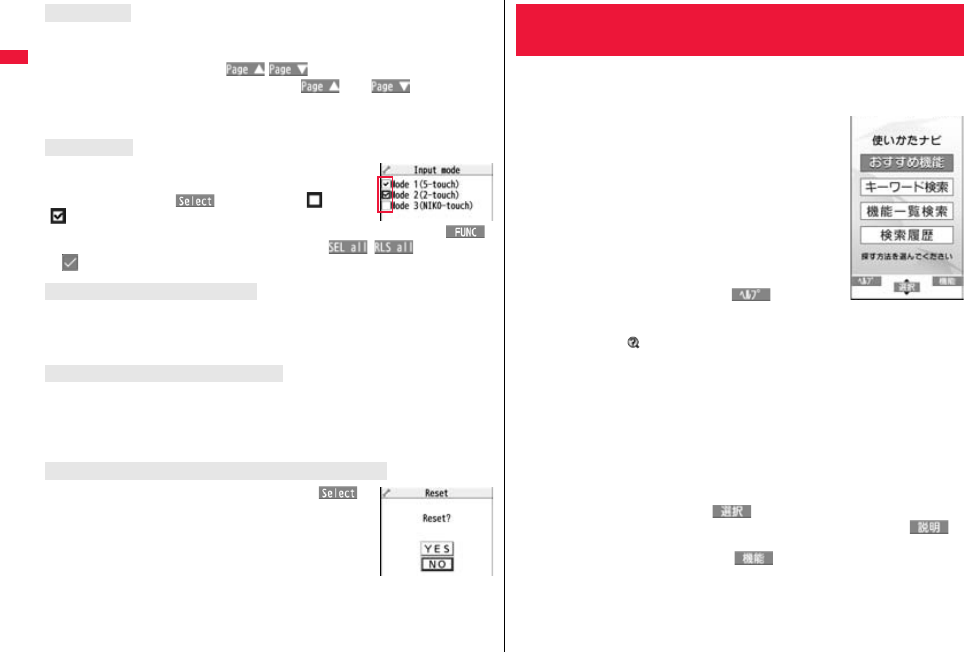
36
Before Using the Handset
When menu items are listed over multiple pages, you can show the previous/next page
by pressing Bo with the uppermost/lowermost item highlighted. You can press No to
scroll through page by page. When / is displayed on the display, you can
scroll through page by page also by pressing m()/c().
≥Depending on the display being shown, such as lower sub-menu items, you might be
able to scroll through page by page also by pressing </> instead of No.
With the functions you can select multiple items, put a check
mark for check boxes to select them.
Each time you press
Oo
( ), you can switch
“”
and
“”
.
With some functions, you can put or clear check marks at a time by pressing
i()
and selecting “Select all/Release all”
or by pressing
m(/)
.
≥
“”
is placed to the selected item depending on the function.
The Lower Sub-menu Item Selection display is shown. When you press h, the
Stand-by display returns (except during Multitask). The Stand-by display or the former
display automatically returns depending on the function.
Press h. The contents of the setting are abandoned and the Stand-by display or the
former display returns. The confirmation display appears asking whether to abandon the
setting contents depending on the function. You can press r to return to the previous
operation.
Press Bo to highlight “YES” or “NO”, then press Oo().
Item scroll
Check box
After finishing the operation
To cancel the operation midway
When the “YES/NO” selection display appears
For Reset Settings
You can search for the functions you want to know and use, and then
check the operating methods. You can execute some functions from
“
使いかたナビ
(Guide)”. This function is available in Japanese Mode only.
1m1ステーショナリー
(Stationery)
1
使いかたナビ
(Guide)
1
Select an item.
おすすめ機能 (Recommendable functions)
. . . Displays the recommendable functions. Go to step 3.
キーワード検索 (From keywords)
. . . Enter keywords and retrieve. Go to step 2
機能一覧検索 (From Function list)
. . . Retrieves from the function list. Go to step 3.
検索履歴 (Search history)
. . . Displays up to 30 search histories. Go to step 3.
≥Highlight each item and press l( ); then the
detailed operating methods are displayed.
≥The 使いかたナビ
(Guide) display appears also by selecting the 使いかたナビ
(Guide) icon “ ” pasted on the desktop at purchase.
2Enter a keyword.
Up to 50 search results are displayed.
≥You can enter up to 24 full-pitch/48 half-pitch characters.
3Select a function1Select an item.
機能の説明 (Description) . . . . . . . . Displays explanations for the function.
操作のしかた (How to operate) . . . Displays the operating method.
この機能を使う (Operate function)
. . . . . . . . . . . . . . . . . . . . . . . . . . . . . . Executes the function. Operate each function.
≥For some functions, press Oo( ) several times for selection.
≥You can display explanations about the function also by pressing l()
while highlighting the function.
≥To delete search history, press i( ) and select “1件削除 (Delete this)” or
“全削除 (Delete all)”, then select “YES”.
<Guide>
When You Forget Key Operation
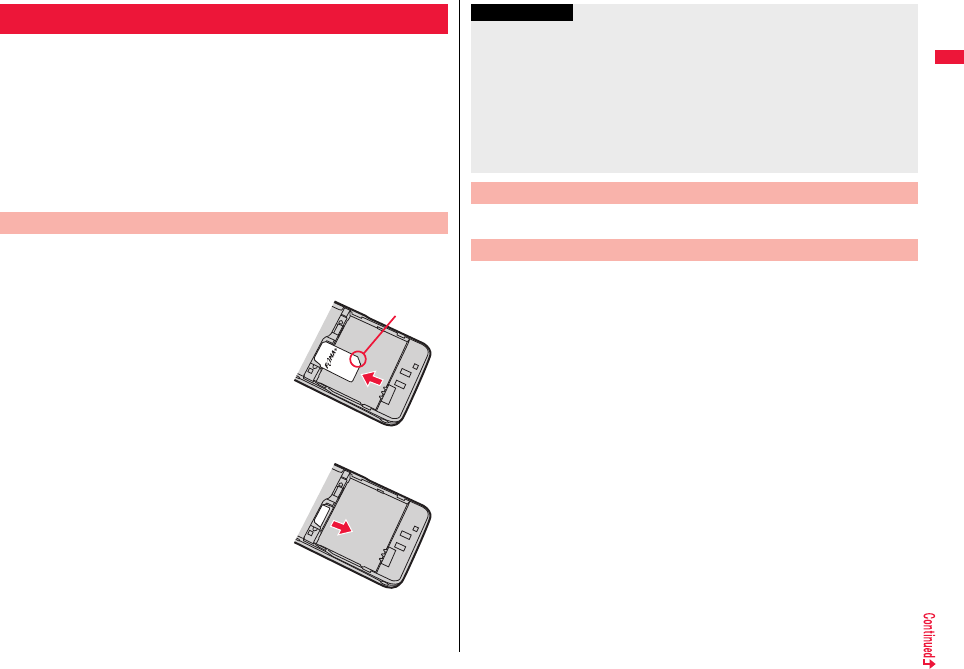
37
Before Using the Handset
The UIM is an IC card that holds your information such as phone
numbers. It can hold data such as Phonebook entries and SMS
messages as well. By sharing a UIM, you can operate multiple FOMA
terminals for multiple purposes.
You cannot use the FOMA terminal for communication such as voice and
videophone calls, i-mode, sending/receiving mail, or packet
communication unless the UIM is inserted.
For details on how to use the UIM, refer to the UIM instruction manual.
When inserting or removing the UIM, take care not to accidentally touch
or scratch the IC.
You need to turn off the power and then remove the battery before you
insert the UIM. (See page 39)
■Inserting
1With the golden IC surface
downward, push the UIM slowly
to the end while pressing the
surface of it.
■Removing
1While sliding the UIM, pull it out
slowly.
Using UIM (FOMA Card)
Insert/Remove
Cut
You can set two security codes, PIN1 and PIN2, for a UIM. (See page 122)
The FOMA terminal has the UIM security function (UIM restriction
function) as a security function to protect your data files.
If you obtain data files by the method below with the UIM inserted, UIM
security function is automatically set to them.
・When downloading images or melodies and so on, from sites or
Internet web pages
・When receiving i-mode mail with file attachments
The data files with the UIM security can be browsed, played back, started,
edited, attached to mail, or transferred via infrared rays only when the
UIM used for obtaining is inserted. When the UIM used for obtaining the
data or files is not inserted, or when another UIM is inserted, these
functions are not operable.
≥In the explanation hereafter, the UIM used to obtain data and files is referred to
as “your UIM” and other UIMs as “another person’s UIM”.
Information
≥Make sure that you insert/remove the UIM with the FOMA terminal closed and held in
your hand.
≥Take care not to force the UIM into place because this can break it.
≥Take care not to lose the UIM once you remove it.
≥When you replace your UIM (except during Omakase Lock), you need to enter the
four- to eight-digit Terminal Security Code after turning on the power. When you enter
the correct Terminal Security Code, the Stand-by display appears. If you enter the
incorrect Terminal Security Code five times in succession, the power turns off.
(However, you can turn on the power again.)
Security Code
Security Function of UIM
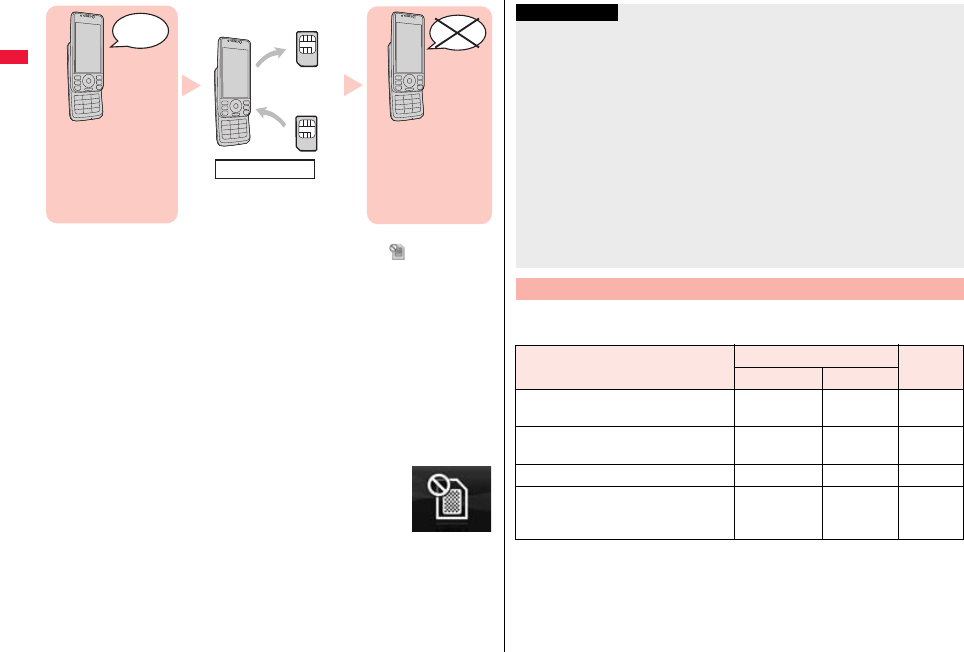
38
Before Using the Handset
≥When the UIM is not inserted or when another person’s UIM is inserted, the following
types of data and files are displayed with the restrictions symbol, “ ”:
・Videophone record messages ・Movie memos ・Screen memos
・Templates ・i-αppli programs ・Images
・i-motion movies ・Chara-den images ・Melodies
・Machi-chara images ・Kisekae Tool files ・PDF files
・Chaku-uta®/Chaku-uta Full® music files ・Downloaded dictionaries
・Files attached or pasted to i-mode mail in the Inbox
・Files attached to i-mode mail in the Outbox/Draft (except the data shot or edited
with the FOMA terminal)
・Messages R/F with files (melodies or images) attached or pasted
・Images inserted into Deco-mail text
※This function applies to the pre-installed i-αppli programs, Chara-den images,
Deco-mail pictograms, etc. if they are reinstalled (upgraded) from a site.
※“Chaku-uta” is a registered trademark of Sony Music Entertainment Inc.
≥The preview image for the data file with the UIM security appears as
shown on the right.
♪
♪
♪
♪
♪
If the UIM used for
obtaining data files
or mail messages is
inserted, you can
browse/play back the
data files with the UIM
security.
♪
♪
♪
♪
♪
Unless the UIM used
for obtaining data files
or mail messages is
inserted, you cannot
browse/play back the
data files with the UIM
security.
Your UIM
Another
person’s UIM
Replacing UIMs
If you use the blue UIM with your FOMA terminal, note that following
specifications differ from those of the green/white UIM:
Information
≥When the UIM security is set for data files, you cannot set them for the functions such
as “Display setting” and “Select ring tone” when another person’s UIM is inserted.
≥When the data files with the UIM security is set for “Display setting” or “Select ring
tone”, the FOMA terminal works with their default settings if you remove your UIM or
replace it with another person’s UIM. Also, a Machi-chara image is cleared. If you
insert your UIM again, your settings are enabled again.
≥The UIM security function is not set for the data files received using the infrared
communication function or data transmission (OBEX™ communication) function and
the still images/movies shot or edited with the FOMA terminal.
≥Even when another person’s UIM is inserted, you can move/delete data files with the
UIM security.
≥The settings of the following functions are stored on the UIM:
・SMS validity period ・SMS center selection ・Select language
・PLMN setting ・PIN1 code, PIN2 code ・PIN1 code entry set
・Validating/Invalidating DOCOMO Certificate 1 and user certificate
Types of UIM (FOMA Card)
Functions UIM Reference
(blue)
(green/white)
Number of digits of the phone number
that can be stored in the UIM Phonebook 20 max. 26 max. 89
Operation of user certificate to use
FirstPass Not available Available 206
Use of WORLD WING Not available Available 460
Use of Service Numbers for “DOCOMO
repair counter” and “General inquiries
<docomo Information Center>”
Not available Available 447
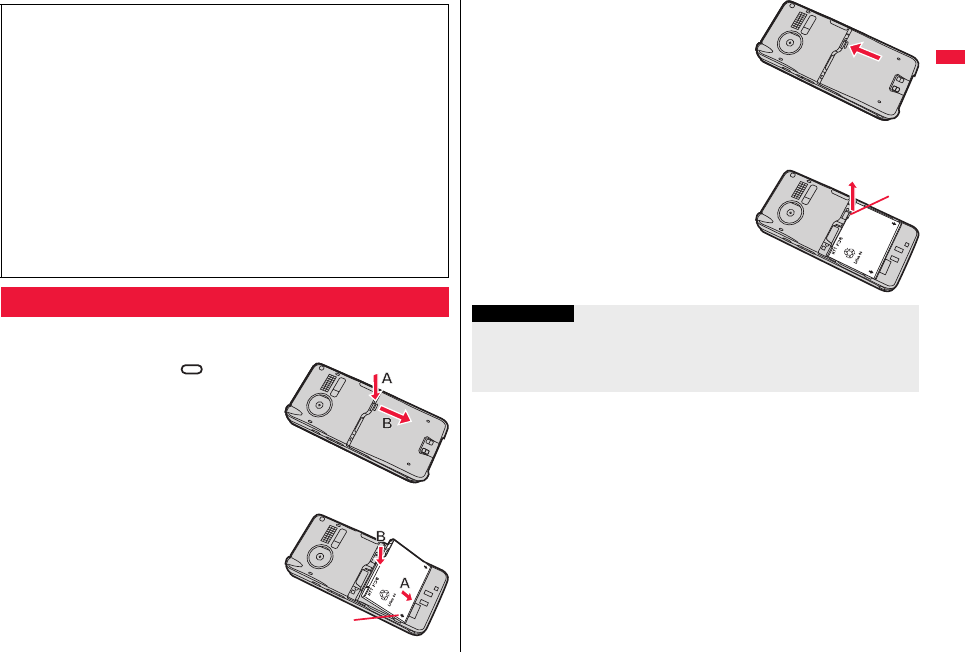
39
Before Using the Handset
Use the FOMA terminal’s dedicated Battery Pack P19.
■Attaching
1While pressing the “ ” part of
the back cover in the direction A,
slide the back cover (2 mm or
more) in the direction B to
unlock and remove it.
≥Securely hold the FOMA terminal not to let it
open and then remove the back cover.
2
With the arrow mark facing up, fit
the tab side of the battery pack to
the FOMA terminal securely, and
then push the battery pack into
the direction B while pressing it
against the direction A.
■WORLD WING
WORLD WING is the DOCOMO FOMA international roaming service that enables
you to use the current phone number overseas for making and receiving calls using
the UIM (green/white) and service compatible mobile phone.
≥You do not need to subscribe to WORLD WING if you have subscribed to the FOMA
service after September 1, 2005. If you offered that you did not need WORLD WING
at the time you signed up for the FOMA service, or when you have midway canceled
WORLD WING, you are required to take the procedures to newly subscribe to
WORLD WING.
≥If you have signed up for the FOMA service before August 31, 2005, and have not
yet subscribed to WORLD WING, you are required to subscribe to it.
≥This service is not available with some billing plans.
≥If you lose your UIM (green/white) or have it stolen overseas, immediately contact
DOCOMO to take the steps necessary for suspending the use of the UIM. For
inquiries, see “docomo Information Center” on the back page of this manual. Note
that you are still charged the call and communication fees incurred after you lose it or
have it stolen.
Attaching/Removing Battery Pack
Arrow mark
3Put the back cover to the FOMA
terminal as illustrated, and while
pressing the whole part of back
cover downward, slide it in the
direction of arrow to remove it.
≥Confirm there is no gap between the back
cover and the FOMA terminal.
■Removing
1Remove the back cover
following the step 1 of
“■Attaching”, and take hold of
the projection of the battery pack
to lift it up.
Projection
Information
≥Make sure that you attach/remove the battery with the FOMA terminal closed and
held in your hand after you turn off the power.
≥If you try to force the battery into place, you could damage the UIM or the terminal part
of the FOMA terminal.
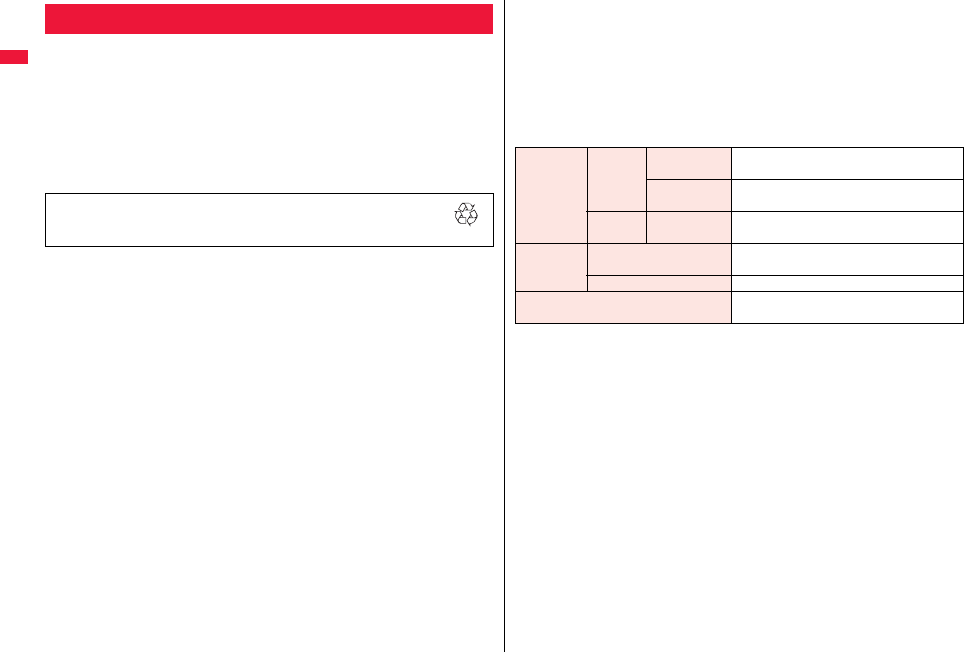
40
Before Using the Handset
Use the FOMA terminal’s dedicated Battery Pack P19.
Life of battery pack
≥Battery packs are consumables. The usable time shortens slightly each time they are
charged.
≥When the usable time of the battery pack becomes half the time it was purchased,
replacing is recommended because the battery pack is nearing the end of its life.
Depending on the use conditions, the battery pack may swell as it nears the end of its
life, but this is not a problem.
≥The life of the battery pack may shorten if you use i-αppli programs, talk on the
videophone, watch 1Seg programs and so on for a long time during charging.
Charging
≥For details, refer to the instruction manuals for the FOMA AC Adapter 01/02 (option),
FOMA AC Adapter 01 for Global use (option), and FOMA DC Adapter 01/02 (option).
≥The FOMA AC Adapter 01 supports 100 V AC only. The FOMA AC Adapter 02 and
FOMA AC Adapter 01 for Global use support from 100 V AC through 240 V AC.
≥The shape of the plug for the AC adapter is for 100 V AC (for domestic use). To use the
AC adapter that supports from 100 V AC through 240 V AC overseas, you need to
have a conversion plug adapter that is compatible with the voltage of the country you
stay. Do not use a transformer for overseas travel to charge the battery pack.
≥Even during charging, you can still answer calls if the FOMA terminal is turned on. This
will consume the charged amount so that charging will take longer. Also, the standby
time or talk time might be shorter if you charge the battery pack with your FOMA
terminal open.
≥If you have a long time videophone call during charging, the temperature in the FOMA
terminal may rise and charging may be suspended. In such a case, wait for a while and
try charging again.
≥Remove and insert the connector slowly and carefully, without using unnecessary
force.
≥Do not remove the battery pack during charging.
Charging
To prevent damage to the environment, bring used battery
packs to a docomo service counter, a docomo agent or a
recycle center.
Li-ion 00
Do not charge for long periods of time (several days) with the FOMA
terminal turned on.
≥If you leave the FOMA terminal powered on for long periods of time during charging,
you may not be able to use the FOMA terminal for long duration as expected and the
low battery alarm may sound soon, because the FOMA terminal receives the power
from the battery pack after charging is completed. If this happens, charge the battery
pack correctly. When charging the battery pack again, first remove the FOMA terminal
from the AC adapter (or desktop holder) or DC adapter and then set it again.
Estimated usable time for battery pack (The usable time for the battery pack
varies with the charging time and the remaining life of the battery pack.)
※The continuous talk time is the estimated time that the FOMA terminal can be used for
calls when radio waves can be sent and received normally.
※The 1Seg watching time is the estimated time for when radio waves can be received
normally with the Stereo Earphone Set 01 (option) connected.
※The continuous standby time is the estimated time when radio waves can be received
normally. The standby time and talk/communication time could be about half of the
estimate and 1Seg watching time could be shorter depending on the charge level of
the battery pack, function settings, other ambient conditions such as temperature, and
the status of radio waves in the area (weak or no radio waves, for instance). When you
use i-mode communication, the talk/communication time and standby time will be
shorter. Further, even if you do not make calls or not execute i-mode communication,
the talk/communication time and standby time will be shorter if you watch 1Seg
programs, compose i-mode mail, start up a downloaded i-αppli program or the i-αppli
Stand-by display, execute data communication or Multiaccess, use the camera, play
back music, or use Bluetooth connections.
※The continuous talk time and the continuous standby time may be shortened
depending on the network environment in the country you stay.
※
The continuous standby time for standstill is the average number of hours you can use the
FOMA terminal in standstill status when it is closed and can receive radio waves normally.
※The continuous standby time for in motion is the average number of hours you can
use the FOMA terminal in the combined status of “standstill” “moving” and “out of the
service area” when it is closed, in an area where it can receive radio waves normally.
Continuous
standby time
FOMA/3G
3G/GSM setting
[3G]
In motion: Approx. 370 hours
3G/GSM setting
[Auto]
Standstill: Approx. 600 hours
In motion: Approx. 360 hours
GSM
3G/GSM setting
[Auto]
Standstill: Approx. 250 hours
Continuous
talk time
FOMA/3G Voice call: Approx. 200 minutes
Videophone call: Approx. 110 minutes
GSM Voice call: Approx. 250 minutes
1Seg watching time Approx. 260 minutes
(In ECO Mode: Approx. 410 minutes)
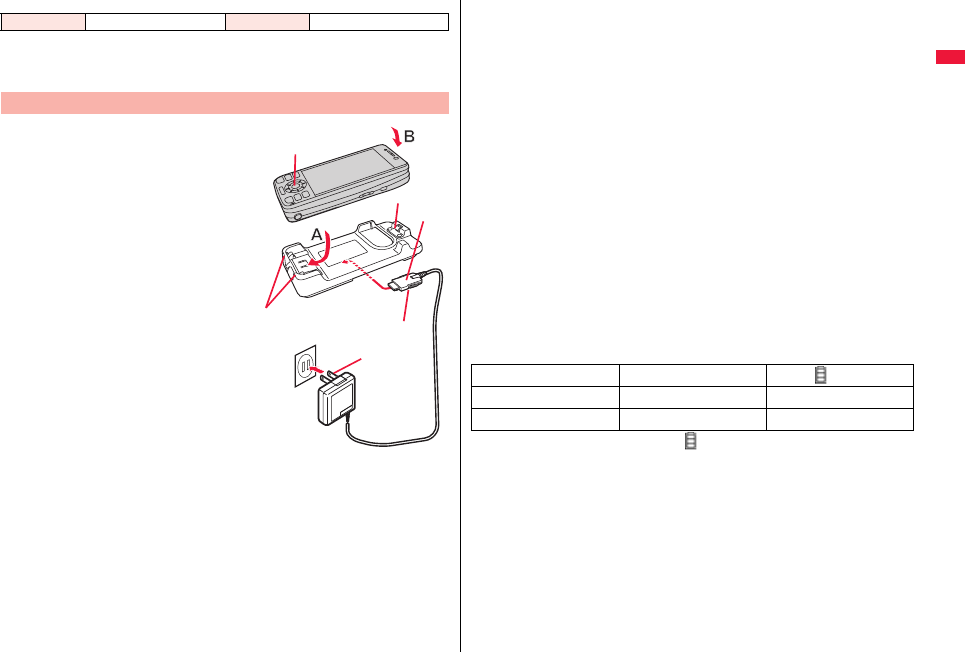
41
Before Using the Handset
Estimated time for charging battery pack
※The charging time is an estimate of time for when empty battery pack is charged with
the FOMA terminal turned off. The charging time will be longer if you charge the
battery pack with the power of the FOMA terminal turned on.
AC adapter Approx. 120 minutes DC adapter Approx. 120 minutes
Charge with AC Adapter and Desktop Holder
1Plug the connector of AC
Adapter horizontally with its
engraved side facing down
into the connector terminal of
the Desktop Holder.
2Pull out the AC Adapter's plug,
and plug it into a household
power socket of 100 V AC.
Call/Charging
indicator
Desktop Holder
Engraved surface
(down side)
AC Adapter
Stopper
Power
socket
Lock claw
AC Adapter’s
plug
Connector
3Put the bottom of the FOMA terminal into the stopper of
the desktop holder (A) to fit the head to the lock claw,
and then depress the FOMA terminal until it clicks (B).
Check that the Call/Charging indicator lights in red.
When the Call/Charging indicator flickers, dismount the AC adapter and battery
pack from the FOMA terminal and then re-mount them for charging.
If the symptom persists, troubles with the AC adapter, desktop holder or battery
pack may be involved, so consult a handling counter such as a docomo shop.
≥The charging confirmation tone (see page 107) sounds when charging starts and
ends. However, it does not sound when the power is off or during Manner Mode
or Public Mode (Drive Mode).
≥Be sure to set the FOMA terminal firmly onto the desktop holder. Also, be careful
that the connector cover or a commercial strap is not caught between the FOMA
terminal and desktop holder.
4When charging is completed, hold the desktop holder
with fingers and lift up the head of FOMA terminal to
remove.
≥Unplug the AC adapter from the power socket when you are not going to use it for
a long time.
■Indicator and display during charging and when charging is completed
≥When the FOMA terminal is turned off, “ ” does not appear.
If you start charging with the battery flat, the Call/Charging indicator might not light
immediately; however, charging itself has started.
■Stand
≥Standing up the desktop holder to put the FOMA terminal with a slope makes easier to
watch 1Seg programs, etc. For details, refer to the instruction manual for the desktop
holder.
Call/Charging indicator “ ” display
Charging Lights in red Blinks
Charging completed Off Lights
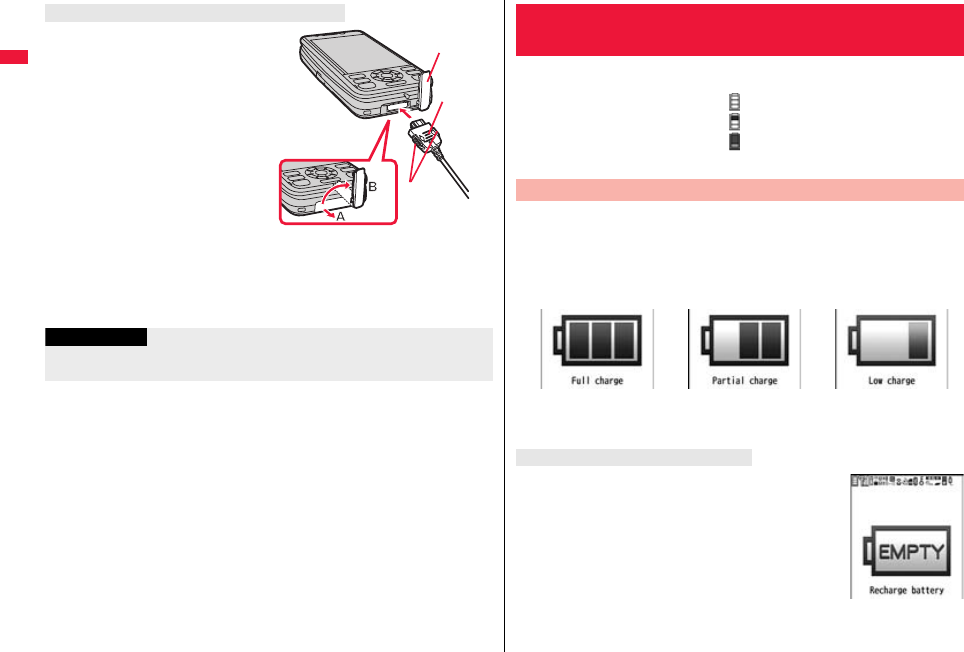
42
Before Using the Handset
Insert the connector with the engraved
surface facing up until it clicks. Pull straight
the connector out while pressing the
release buttons.
≥To charge the battery, place the cover of
the connector terminal as illustrated. Pull
out the cover of the connector terminal to
direction A, and turn it as direction B.
※Check the facing direction (front or rear)
of the AC adapter plug and then insert
or pull it horizontally into or out of the
FOMA terminal.
Malfunction could result if you try to pull
it forcibly.
■DC adapter (option)
With the DC adapter, you can use a cigarette lighter socket (12 V/24 V) of cars to
charge the FOMA terminal with the battery pack attached.
For details, refer to the instruction manual for the FOMA DC Adapter 01/02.
When charging only with the AC adapter
Cover
Release
buttons
Engraved
surface
Information
≥If the fuse blows off when charging with the DC adapter, be sure to use a 2A fuse. The
2A fuse is consumables, so purchase at auto parts stores in your neighborhood.
When the FOMA terminal is turned on, an estimate of the battery level is
indicated by the icon.
・Almost full . . . . . . . . . . . . . . . . . . .
・Getting low. . . . . . . . . . . . . . . . . . .
・Almost empty . . . . . . . . . . . . . . . .
≥Charge the battery when it is almost empty.
You can check an estimate of the battery level by the display and sound.
1m1Set./Service1Other settings1Battery
1Battery level
≥The pictogram disappears in about three seconds.
The display on the right appears and the low battery alarm
sounds for about 10 seconds. To stop this alarm, press any
key other than < and >. About one minute later, the FOMA
terminal will be turned off.
≥During a call, a beeping tone from the earpiece notifies you of
the low battery. About 20 seconds later your call will be cut
and then one minute later the FOMA terminal will be turned
off.
<Battery Level>
Checking Battery Level
Check by Display and Tone
Almost full Getting low Almost empty
※Almost empty.
Charge the battery.
Three beeps Two beeps One beep
When the battery is running out
Recharge Battery
display
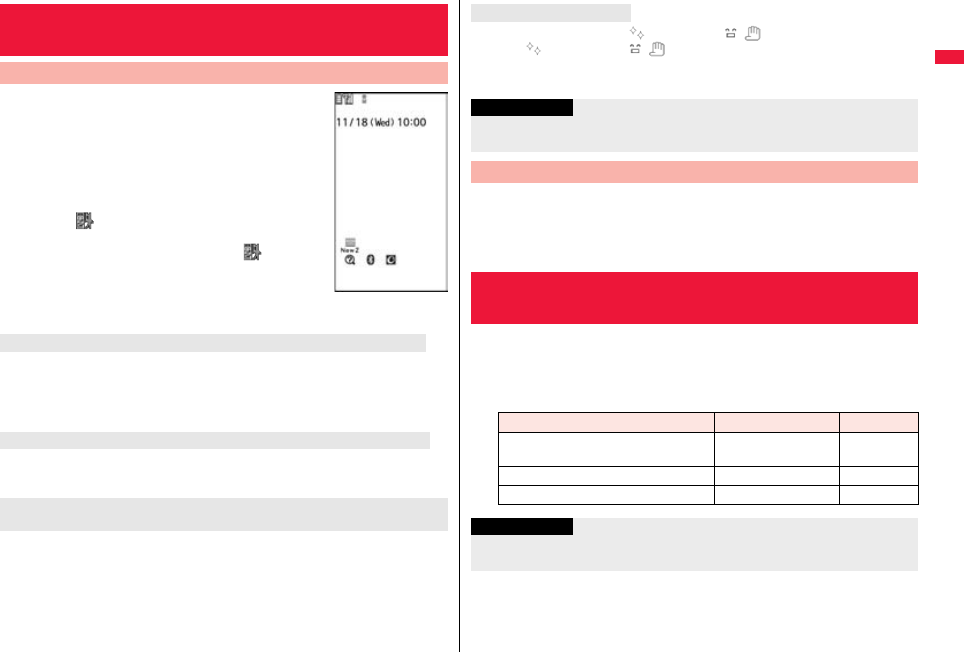
43
Before Using the Handset
1Press and hold h for at least one
second.
After the Wake-up display (see page 112) is displayed,
the Stand-by display appears.
≥If you have stored many Phonebook entries or mail
messages, it may take a while for the display to appear.
≥If Set Time is set, the current date and time are shown.
≥When “ ” is displayed, the FOMA terminal is out of
the service area or in the place where the radio waves
do not reach. Move to a location where “ ”
disappears.
≥If “Starting System Wait a minute” is displayed when
you turn on the power, wait for a while and then
proceed.
Enter the four- to eight-digit Terminal Security Code after turning on the power. When
you enter the correct Terminal Security Code, the Stand-by display appears. If you enter
the incorrect Terminal Security Code five times in succession, the power turns off.
(However, you can turn on the power again.)
Enter the four- to eight-digit PIN1 code after you turn on the power. When you enter the
correct PIN1 code, the Stand-by display appears. See page 122 for PIN1 code.
Enter the four- to eight-digit PIN2 code after you turn on the power. When you enter the
correct PIN2 code, the Stand-by display appears. If you press r or h without
entering the correct PIN2 code, “Auto reset setting” is set to “OFF” and the Stand-by
display appears. See page 122 for PIN2 code.
<Power ON/OFF>
Turning Power ON/OFF
Turn Power On
Stand-by display
When your UIM is replaced (except during Omakase Lock)
When “PIN1 code entry set” of “UIM setting” is set to “ON”
When “Auto reset setting” of “Notice call cost” is set to “ON”
(except during Omakase Lock)
The mail messages “Welcome デコメアニメ
(Welcome Decome-Anime )” and “緊急速報「エリアメール」のご案内
(Introduction of Early Warning “Area Mail”)” have been saved by default. Press Oo twice
or perform step 1 on page 160 to show the Inbox list.
1Press and hold h for at least two seconds.
The exit display appears and the power turns off.
≥You cannot turn on the power immediately after turning off the power. Wait a few
seconds.
1m1
設定/サービス
(Set./Service)
1
ディスプレイ
(Display)
1
バイリンガル
(Select language)
1
Japanese (
日本語
) or English (
英語
)
≥
The following functions are different between Japanese display and English display:
Check Welcome Mail
Information
≥Each entry display appears in the order of “PIN1 code” → “Terminal Security Code”
→ “PIN2 code”.
Turn Power Off
+m-1-5
<Select Language>
Switching to English Display
Functions Japanese English
“Clock” of Display Setting
→ “Stand-by clock” → “Day of week”
Available Not available
使いかたナビ (Guide) Available Not available
Voice Guidance Available Not available
Information
≥When you insert the UIM, the “バイリンガル (Select language)” setting is stored on
the UIM.
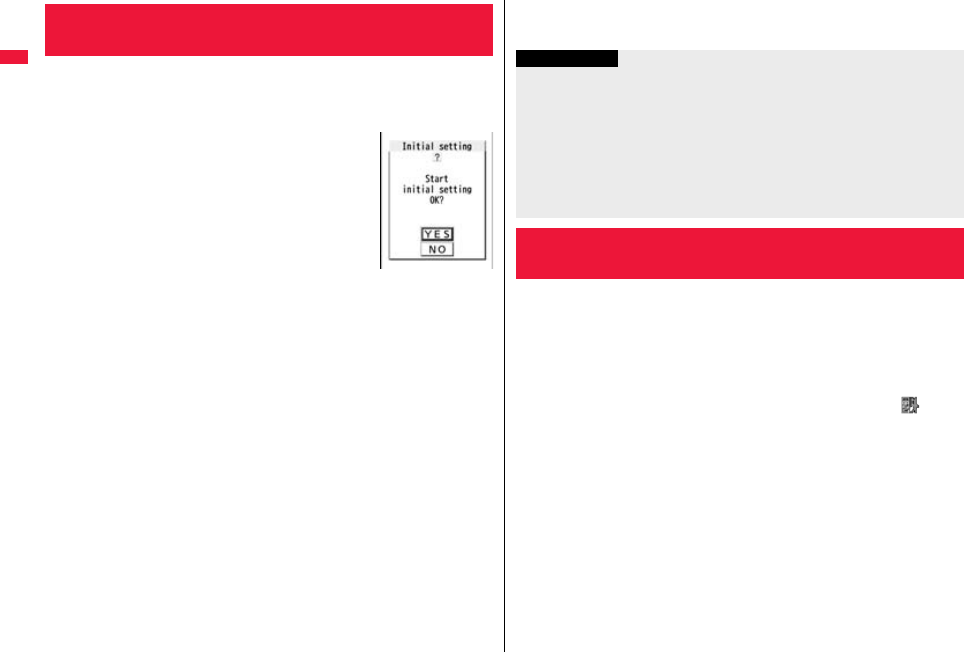
44
Before Using the Handset
If the date and time, Terminal Security Code, Keypad Sound, Speed
Selector Sound, Location Request Set., or Font Size is not set, the Initial
Setting display appears when you turn on the power. You can set the
initial settings also from each menu function separately.
1Turn on the power1YES
≥When the display for entering your Terminal Security
Code, PIN1 code, or PIN2 code appears, follow the
operation on page 43.
2Set the date and time.
You can select “Auto time adjust ON” or “Auto time adjust OFF” for setting the time.
(See page 44)
3Set your Terminal Security Code.
You can set your Terminal Security Code required for setting functions.
(See page 122)
1. Enter “0000”1Enter your new Terminal Security Code (four to eight digits)
1YES
4Set Keypad Sound.
You can set whether to make a keypad sound. (See page 107)
5Set Speed Selector Sound.
You can set the sound for when you rotate the speed selector. (See page 107)
6Set Location Request Set..
You can set whether to notify your current location for when a GPS location
provision request arrives. (See page 338)
<Initial Setting>
Configuring Initial Setting
7Set the size of characters.
You can set the size of characters on the display at a time. (See page 119)
You can select whether to correct the time automatically or set it
manually. The time is set/displayed on the 24-hour basis.
1m1Set./Service1Clock1Set time
1Auto time adjust ON or Auto time adjust OFF
Auto time adjust ON
. . . . Corrects the date/time automatically. The setting is completed.
When the time cannot be corrected automatically such as when “ ” is
displayed and the date/time has not been set, the Manual Time Setting
display appears. Follow step 2 to set the date/time.
Auto time adjust OFF
. . . . Sets the date/time manually.
≥When “Notice call cost” is set to “ON”, you need to enter your Terminal Security
Code.
Information
≥When an unset function is found, the Initial Setting display for the unset function
appears each time you turn on the power.
≥The completed settings are valid even when total setting is interrupted by an incoming
call or canceled by pressing -h or -r midway.
≥When the power is automatically turned on by alarm notification, the Initial Setting
display does not appear even if there is any unset function.
≥When you finish the initial settings, the confirmation display appears telling that
updating software is executed automatically. This display appears only at the first
time, and after that, does not appear until you execute Reset Settings or Initialize.
+m-3-1
<Set Time>
Setting Date and Time
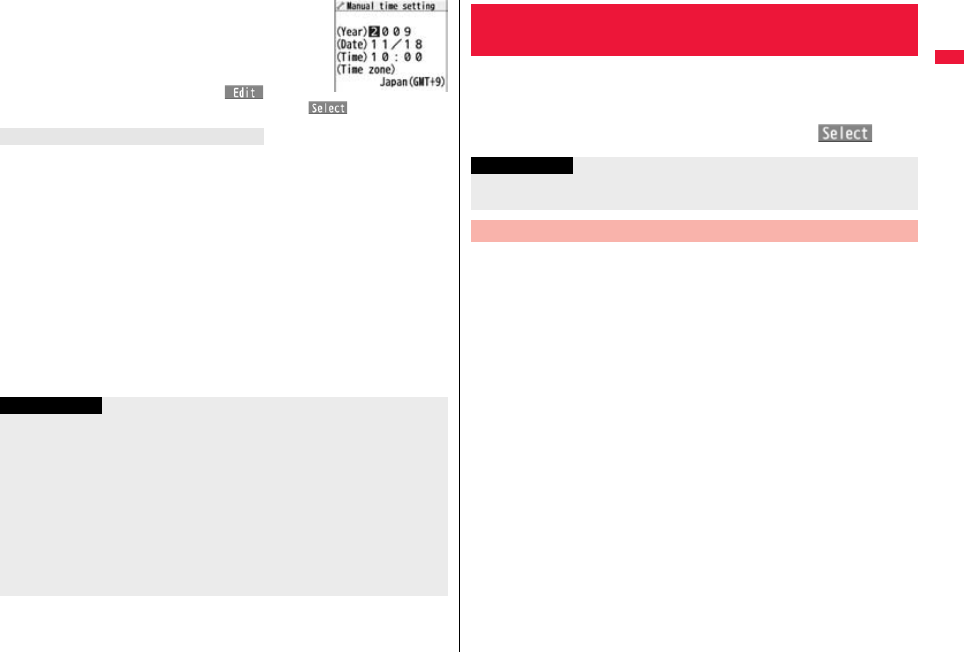
45
Before Using the Handset
2Enter year, month, date and time.
Use Mo to move the cursor and enter numbers by the
numeric keys.
≥To enter one-digit numeral for the date and time, enter
two digits beginning with “0” as in “01” through “09”.
≥Highlight “Time zone” and press l( ) to set the
time zone. Use Mo to select a region and press Oo().
This function corrects the time of the FOMA terminal according to the clock information
obtained from the network when you turn on the power.
The time is corrected when you show the Stand-by display with “Auto time adjust ON”
set.
If the time is not corrected for a while after you turn on the power, turn it off and then on
again.
≥
Some few second errors might occur. You might not be able to correct the time depending
on the radio wave conditions, or the i-
α
ppli program set for the i-
α
ppli Stand-by display.
≥When you receive the clock information overseas and the time difference correction
information differs from the previously received one, “Time is adjusted” is displayed and
the time difference is corrected automatically. Press “OK” to update the time and show
Redial, Dialed Calls, Received Calls, sent/received mail messages and others in local
time.
≥Depending on the network overseas, the time difference might not be correctly
adjusted. In such a case, set a time zone manually.
About date/time correction function
Information
≥Unless Set Time is set, the functions which use the clock such as Schedule do not
work correctly. Further, the date/time for redial items and received call records are not
stored.
≥The set time is retained even when the battery pack is replaced, however, it might be
reset if the battery pack is left removed for a long time. In that case, charge the FOMA
terminal and then perform the clock setting.
≥When “Time zone” is set to other than “GMT +9” or the time difference is corrected
overseas, the sub clock (Japanese date/time, etc.) is displayed on the Stand-by
display.
≥This function supports clock settings from 00:00 on January 1, 2008 through 23:59 on
December 31, 2037.
You can display the time of the specified area on the Stand-by display.
1m1Set./Service1Clock1World time watch
1ON or OFF
1Use Mo to select an area and press Oo().
You can advance the time displayed for the overseas country you stay
and for a region of World Time Watch by one hour.
1m1Set./Service1Clock1Summer time1ON or OFF
<World Time Watch>
Displaying World Time
Information
≥World Time Watch does not appear when “Display setting” → “Clock” → “Stand-by
clock” → “Position” is set to “OFF”, or when you use the FOMA terminal overseas.
Summer Time
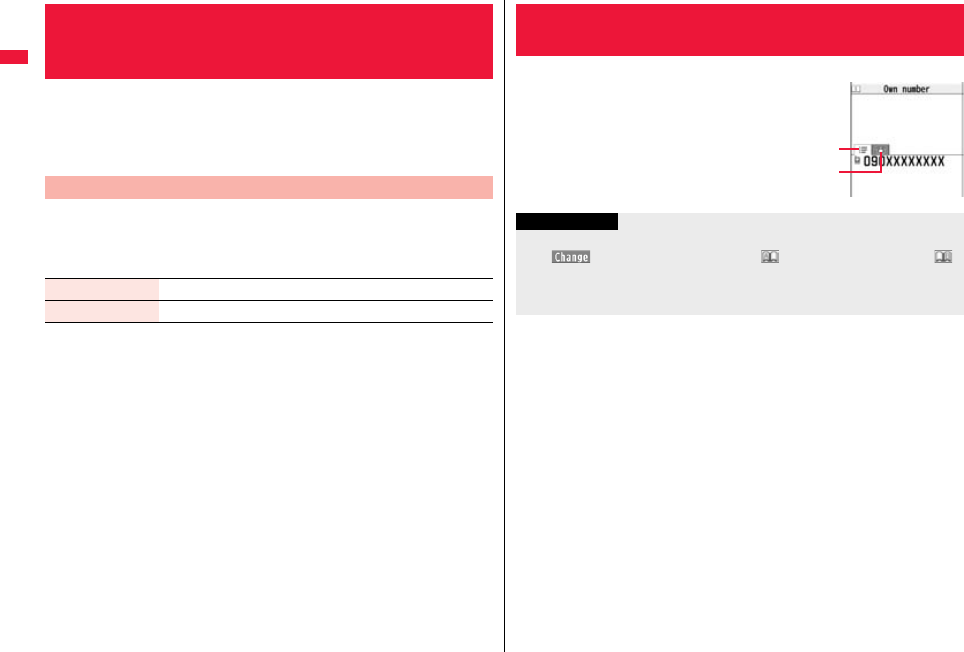
46
Before Using the Handset
You can set the FOMA terminal to send your phone number to the called
party’s phone when dialing. Your phone number is important
information, so take utmost care when notifying your phone number.
This function is available only when the other party’s phone supports
Caller ID.
You can set whether to notify your caller ID on the network.
1m1Set./Service1NW services1Caller ID notification
1Do the following operations.
<Caller ID Notification>
Notifying the Other Party of Your Phone
Number
+m-1-7
Set Caller ID Notification to Network
Activate 1ON or OFF
Check setting You can check the setting contents of “Activate”.
≥Your phone number (own number) is stored on the UIM.
1m1Phonebook1Own number
You can press No to switch the tabs.
≥See page 414 for storing/displaying personal data.
+m-0
<Own Number>
Checking Your Own Phone Number
Own Number display
Phone number tab
List tab
Information
≥In Dual Mode of 2in1, you can switch between Number A and Number B by pressing
*Oo( ) from the Own Number display. “ ” appears for Number A, and “ ”
appears for Number B.
≥When you replace a UIM with another one while using 2in1, 2in1 Setting is
deactivated. For using 2in1, activate 2in1 Setting.

47
Voice/Videophone Calls/PushTalk
Making Calls/Videophone Calls
Videophone Calls . . . . . . . . . . . . . . . . . . . . . . . . . . . . . . . . . . . . . . . . . . . . . . 48
Making a Call/Videophone Call . . . . . . . . . . . . . . . . . . . . . . . . . . . . . . . . . . . 48
Switching a Voice/Videophone Call . . . . . . . . . . . . . . . . . . . . . . . . . . . . . . . 51
Using Call Records. . . . . . . . . <Redial> <Dialed Calls> <Received Calls> 52
Using Chaku-moji . . . . . . . . . . . . . . . . . . . . . . . . . . . . . . . . . . <Chaku-moji> 54
Setting Caller ID to Send/Not to Send for Each Call . . . . . . . . . <186/184> 56
Sending Touch-tone Signals . . . . . . . . . . . . . . . . . . . . . . . . . . <Pause Dial> 57
Making International Calls . . . . . . . . . . . . . . . . . . . . . . . . . <WORLD CALL> 58
Setting for International Calls . . . . . . . . . . . . . <International Dial Assist> 59
Storing Numbers to be Added to the Beginning of a Phone Number
. . . . . . . . . . . . . . . . . . . . . . . . . . . . . . . . . . . . . . . . . . . . . . . <Prefix Setting> 60
Making a Call Specifying a Sub-address . . . . . . . <Sub-address Setting> 60
Setting Alarm for Reconnecting . . . . . . . . . . . . . . . . . <Reconnect Signal> 60
Making Voice Clear According to Surrounding Noise . . . <Shikkari Talk> 61
Reducing Surrounding Noise to Make Voice Clear . . . <Noise Reduction> 61
Slowing Down the Other Party’s Speaking Speed . . . . . . . <Yuttari Talk> 61
Switching to Hands-free. . . . . . . . . . . . . . . . . . . . . . . . . . . . . .<Hands-free> 61
Using Hands-free Compatible Devices. . . . . . . . . . . . <In-Car Hands-free> 61
Receiving Calls/Videophone Calls
Receiving a Call/Videophone Call . . . . . . . . . . . . . . . . . . . . . . . . . . . . . . . . . 62
Switched between a Call and a Videophone Call by the Other Party. . . 63
Setting Response of Key Operation for Answering Incoming Calls
. . . . . . . . . . . . . . . . . . . . . . . . . . . . . . . . . . . . . . . . . . . . . . <Answer Setting> 64
Setting Response for when Opening FOMA Terminal during Ringing
. . . . . . . . . . . . . . . . . . . . . . . . . . . . . . . . . . . . . . . . .<Setting when Opened> 65
Setting Response for when Closing FOMA Terminal during a Call
. . . . . . . . . . . . . . . . . . . . . . . . . . . . . . . . . . . . . . . . . <Setting when Closed> 65
Adjusting Earpiece Volume . . . . . . . . . . . . . . . . . . . . . . . . . . . . . <Volume> 65
Adjusting Ring Volume . . . . . . . . . . . . . . . . . . . . . . . . . . . . <Ring Volume> 66
When You cannot/could not Answer a Voice/Videophone Call
Putting a Call on Hold when You cannot Answer Immediately
. . . . . . . . . . . . . . . . . . . . . . . . . . . . . . . . . . . . . . . . . . . . . . . . . . . . <On Hold> 66
Putting a Call on Hold during a Call . . . . . . . . . . . . . . . . . . . . . . <Holding> 66
Setting Hold Tone . . . . . . . . . . . . . . . . . . . . . . . . . . . . . . . . <Set Hold Tone> 67
Using Public Mode. . . . . . . . . . . . . . . . . . . . . . . . . . . . . . . . . . . . . . . . . . . . . 67
If You could not Answer an Incoming Call . . . . . . . . . . . . <Missed Calls> 68
Recording Voice/Video Messages when You cannot Answer a Call
. . . . . . . . . . . . . . . . . . . . . . . . . . . . . . . . . . . . . . <Record Message Setting> 69
Recording a Message when You cannot Answer an Incoming Call
. . . . . . . . . . . . . . . . . . . . . . . . . . . . . . . . . . . . . . . .<Quick Record Message> 70
Playing/Erasing Record Messages/a Voice Memo/Videophone Record
Messages/Movie Memos
. . . . . . . . . .<Play/Erase Messages> <Play/Erase Videophone Messages> 70
Making Full Use of Videophone Calls
Using Chara-den . . . . . . . . . . . . . . . . . . . . . . . . . . . . . . . . . . . . . . . . . . . . . . 71
Useful Functions for Videophone Calls. . . . . . . . . . . . . . . . . . . . . . . . . . . . 72
Setting Hands-free Videophone . . . . . . . . <Hands-free with Videophone> 74
Setting Image Quality for Videophone Calls . . . . . . . <Visual Preference> 74
Changing Image Displays for Videophone Calls . . . . . . . <Select Image> 75
Redialing as a Voice Call when a Videophone Call cannot be Connected
. . . . . . . . . . . . . . . . . . . . . . . . . . . . . . . . . . . . . . . . <Voice Call Auto Redial> 75
Setting for Switching a Voice/Videophone Call during a Call
. . . . . . . . . . . . . . . . . . . . . . . . . . . . . . . . . . . . . . . <Notify Switchable Mode> 76
Selecting Response to Incoming Videophone Calls during i-mode
. . . . . . . . . . . . . . . . . . . . . . . . . . . . . . . . . . . . . .<Videophone while Packet> 76
Using Videophone Calls by Interfacing to External Devices . . . . . . . . . . . 76
Checking inside of a Room when You are Out
. . . . . . . . . . . . . . . . . . . . . . . . . . . . . . . . . . . . . . . . . . . <Remote Monitoring> 77
PushTalk
PushTalk . . . . . . . . . . . . . . . . . . . . . . . . . . . . . . . . . . . . . . . . . . . . . . . . . . . . . 78
Making a PushTalk Call . . . . . . . . . . . . . . . . . . . . . . . . . . . . . . . . . . . . . . . . . 78
Adding a Member during a PushTalk Call . . . . . . . . . . . . . . . . . . . . . . . . . . 81
Receiving a PushTalk Call . . . . . . . . . . . . . . . . . . . . . . . . . . . . . . . . . . . . . . 81
Adding Entries to PushTalk Phonebook
. . . . . . . . . . . . . . . . . . . . . . . . . . . . . . . . . . <Store in PushTalk Phonebook> 82
Making a Call from PushTalk Phonebook . . . . . . . . . . . . . . . . . . . . . . . . . . 83
Deleting PushTalk Phonebook Entries
. . . . . . . . . . . . . . . . . . . . . . . . . . . . . . .<Delete from PushTalk Phonebook> 85
Setting for Making/Receiving a PushTalk Call . . . . . . . . . . . . . . . . . . . . . . 85
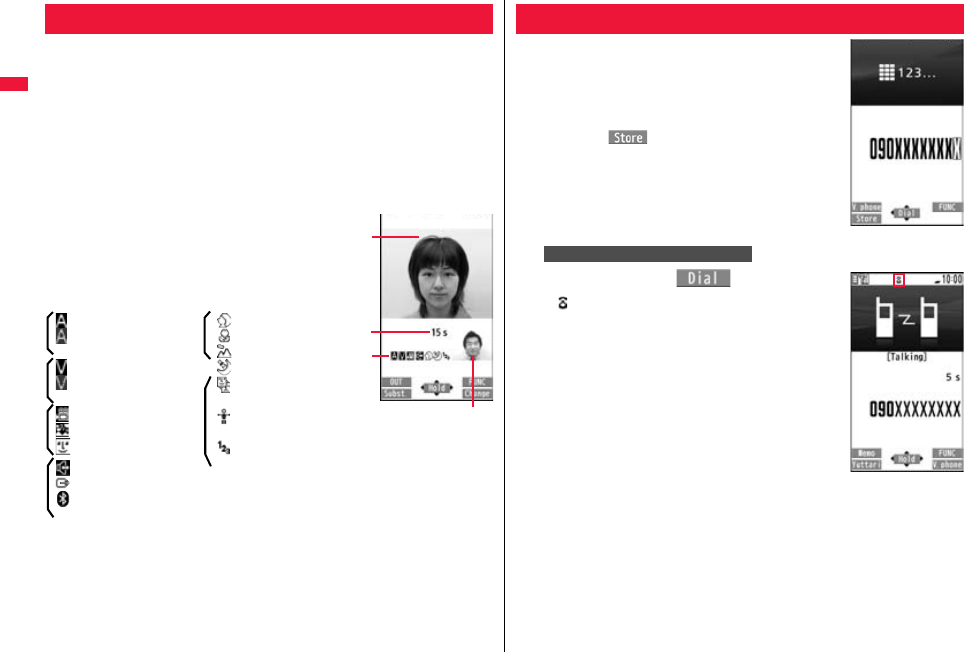
48
Voice/Videophone Calls/PushTalk
You and the other party can talk viewing each other’s images.
DOCOMO videophones conform to 3G-324M, standardized by the international
standard 3GPP. You cannot connect to the videophone that uses a different format.
≥3GPP (3rd Generation Partnership Project):
This is the regional standards organization for developing common technical
specifications for third-generation mobile telecommunication systems (IMT-2000).
≥3G-324M:
This is the international standard for the third generation of mobile videophones.
≥P-02A supports only 64 kbps communication speed of the videophone.
You cannot talk on the videophone at 32 kbps communication speed.
■Display during videophone calls
1…Received image (The other party’s image through the
camera or substitute image)
2…Sent image (Image through your camera or substitute
image)
3…Call duration
※1 When voice sending fails, the other party cannot hear your voice.
When voice receiving fails, you cannot hear the other party’s voice.
※2 When image sending fails, the sent image is not displayed at the other end.
When image receiving fails, the received image is not displayed.
When voice or image sending/receiving fails, it does not recover automatically. You need
to make a videophone call again.
Videophone Calls
1
3
4
2
4…Status
: Voice sending/receiving
(gray): Voice sending/
receiving failed※1
: Image sending/receiving
(gray): Image sending/
receiving failed※2
: Camera image sending
: Still image sending
: Chara-den talking
: Hands-free activated
: AV output
: Bluetooth
communicating
: Portrait
: Close-up
: Landscape
: Night Mode
: Chara-den Whole
Action Mode
: Chara-den Parts Action
Mode
: DTMF Transmission
Mode
1Enter the other party’s phone number,
starting with the city code.
≥When 27 or more digits are entered, the lower 26 digits
only are displayed.
≥To store an entered phone number in the Phonebook,
press m( ). Go to step 2 of “Storing Displayed
Phone Number/Mail Address in Phonebook” on
page 93.
≥Even when you are dialing within the same area, you
need to enter the city code before the phone number.
2
Press d or Oo().
≥“ ” blinks during dialing, and lights during a call.
Making a Call/Videophone Call
When Making a Voice Call
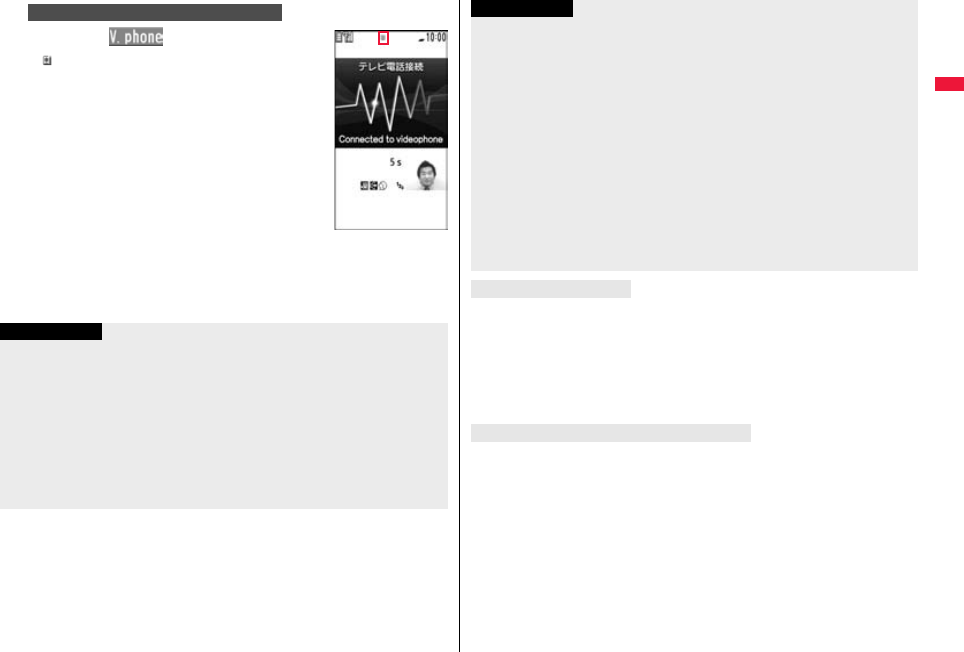
49
Voice/Videophone Calls/PushTalk
Press l().
≥“ ” blinks during dialing and lights during the call.
≥Press m during a videophone call to switch between
the image through your camera and substitute image
for sending to the other party.
3Press h to end the call after talking.
When Making a Videophone Call
The digital communication
charging starts from this
display.
Information
≥If you hear the guidance requesting your caller ID (see page 446), follow the steps of
“To notify your caller ID” on page 57 to enter “186” and redial.
≥When an earphone/microphone (option) is connected, you can hear the other party’s
voice from the earphone. (See page 419)
≥If you close the FOMA terminal during a call, the FOMA terminal works in accordance
with the setting of “Setting when closed”. (See page 65)
≥You can press numeric keys to send touch-tone signals during a call. During a
Chara-den call, you need to switch to DTMF Transmission Mode. (See page 73)
≥In Dual Mode of 2in1, you can make a call after selecting Number A or Number B.
(See page 452)
The other party’s name and icon are displayed if the party’s phone number and name
are stored in the Phonebook. However, the image is not displayed even if it is stored in
the Phonebook.
≥If the same phone number is stored with multiple names in the Phonebook, the name
that comes first in the search order (see page 94) is displayed.
≥The phone number instead of the name is displayed when you make a call during
Personal Data Lock or to the party stored as secret data in the Phonebook.
Each time you press r, the digit on the far right is cleared. If you press and hold r
for at least one second, all the digits are cleared and the Stand-by display returns.
≥Press No to move the cursor to the digit you want to clear, and then press r to clear
it. To clear all the digits on and to the right of the cursor, press and hold r for at least
one second.
<For Voice Calls>
≥You can make a voice call also by pressing -d and then entering the party’s phone
number. If you enter a wrong number, press -h to clear the display and then redial.
<For Videophone Calls>
≥Just after purchase, Hands-free is automatically activated by “Hands-free
w/ V. phone”. (See page 74) However, Hands-free is deactivated during Manner
Mode regardless of “Hands-free w/ V. phone”.
≥When you make a videophone call with substitute image, note that you will still be
charged for the digital communication, not the voice calls.
≥If you make a videophone call at 110/119/118 from the FOMA terminal, it is
automatically dialed out as a voice call.
≥During a videophone call, you can send a Chara-den image to the other party instead
of the image through your camera. (See page 71)
≥The international videophone call is available using the DOCOMO international call
service “WORLD CALL”. (See page 58)
Display when dialing
If you entered a wrong phone number
Information
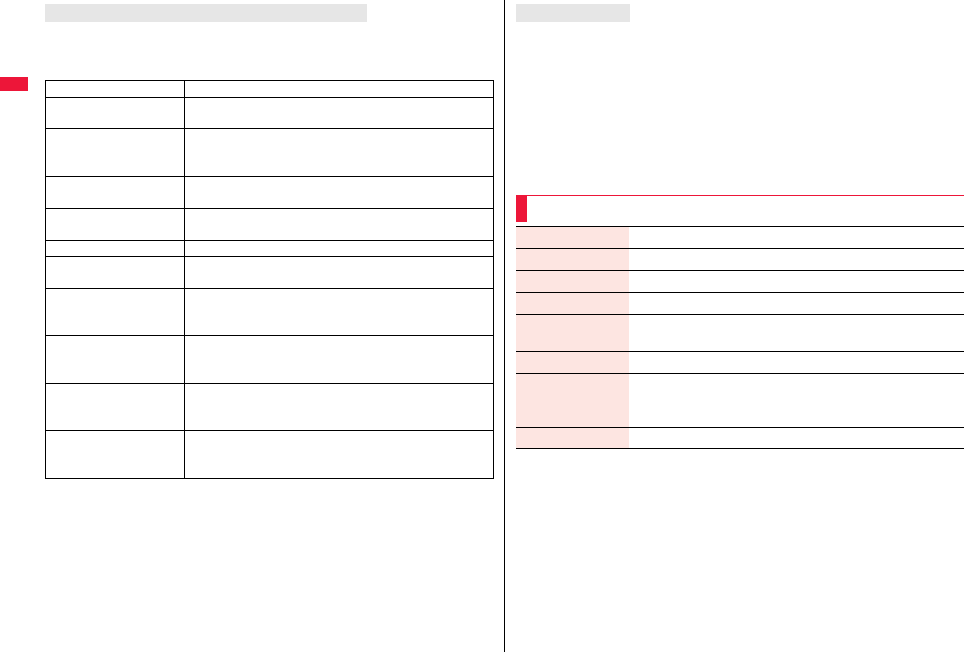
50
Voice/Videophone Calls/PushTalk
The reason why it could not be connected is displayed. (The displayed reason might not
be the same as the actual reason depending on the type of the other party’s phone and
contract for network services.)
If a videophone call could not be connected
Messages Reasons
Check number, then
redial
You have dialed a non-existent phone number.
Busy The other party is busy. (Depending on the receiver’s
phone, this message might be displayed during packet
communication as well.)
Busy with packet
transmission
The packet communication is progress at the other end.
Out of service area/power
off
The other party’s phone is out of the service area or turned
off.
Set caller ID to ON Your caller ID is not notified. (when dialing “visualnet”, etc.)
Your call is being
forwarded
During forwarding
Redial using voice call The other party activates Call Forwarding Service but the
forwarding destination phone does not support videophone
calls.
Upper limit has been
exceeded
Connection failed
The upper limit for the plan with the limit function (Type
Limit, Family Wide Limit) is exceeded.
Please make your call
from the i-mode web page
You did not make a videophone call from the IP (Information
Provider) site among i-mode official sites (at dialing to
V-live).
Connection failed Redial after setting “Activate” of “Caller ID notification” to
“ON”.
≥This may appear in the case other than above.
If “Voice call auto redial” is set to “ON”, and a videophone call is not connected, a voice
call is automatically made.
≥Videophone calls cannot be connected to the phones that do not support the
videophone function, or to the phones that are out of the service area or turned off even
if they are videophones. If you have set “Voice call auto redial” to “ON” and attempt to
dial a phone that does not have the videophone function, the number will be redialed
as a voice call. However, this operation might not work if you call the phone connected
with ISDN-synchronous 64K or the ISDN videophone that does not support 3G-324M
(as of December 2008), or if you dial the wrong number. Note that you could be
charged for the communication.
Auto-redialing
Function Menu while Entering Phone Number
Notify caller ID See page 56.
Prefix numbers See page 60.
Int’l dial assist See page 59.
Select image See page 75.
Multi number You can select a phone number to be notified to the other party.
(See page 449.)
Add to phonebook See page 92.
Compose message You can compose a mail message to send to the phone number
set as the destination address.
Go to step 3 on page 142.
Chaku-moji See page 55.
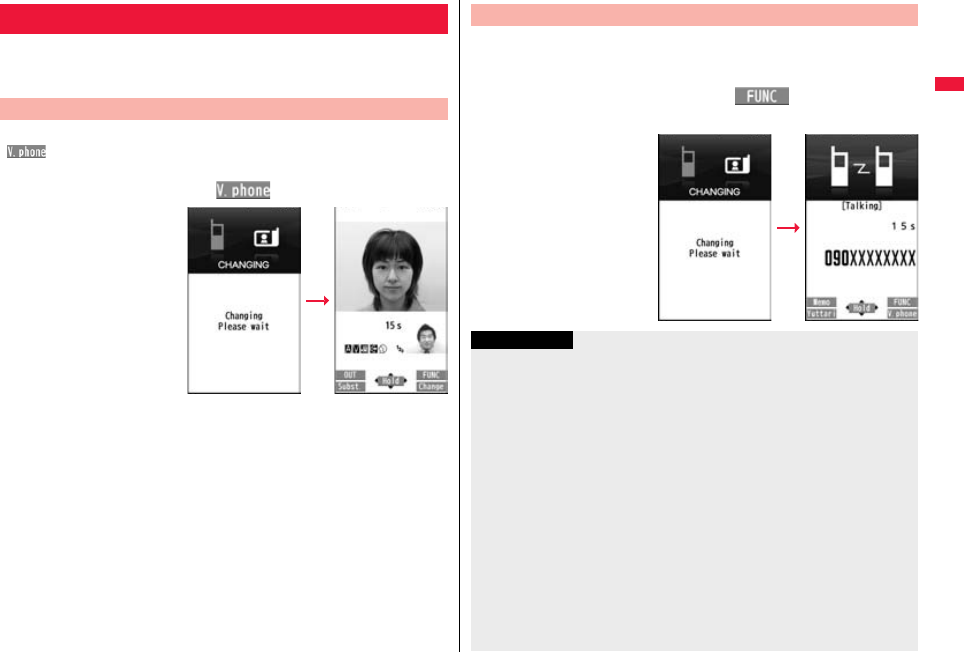
51
Voice/Videophone Calls/PushTalk
You (caller) can switch between a voice call and a videophone call. This
function is available for the mobile phones that can switch between a
voice call and a videophone call.
When the other party’s phone has a function to switch between the calls,
“ ” is displayed on your phone and you can switch from the voice
call to videophone call.
1During a voice call1c()1Change
≥When you select an image
to be sent to the other
party, select “Select
image”. Go to step 2 of “Set
by Call” on page 75.
≥When “Cancel” is selected,
the FOMA terminal cancels
switching and returns to the
voice call.
≥While switching, the voice
guidance is played back.
Switching a Voice/Videophone Call
Switch from a Voice Call to a Videophone Call
When the other party’s phone has a function to switch between calls, you
can switch from a videophone call to a voice call by selecting “CHG to
voice call” from the Function menu.
1During a videophone call1i()
1CHG to voice call1YES
≥Select “NO” on the
confirmation display to stop
switching and to resume
the videophone call.
≥While switching, the voice
guidance is played back.
Switch from a Videophone Call to a Voice Call
Information
≥You can switch between a voice call and a videophone call repeatedly.
≥When i-mode or packet communication is in progress, the communication is
disconnected and then the voice call is switched to the videophone call.
≥When packet communication is in progress at the other end, the message to the
effect that the communication cannot be switched is displayed and the voice call
continues without switching to the videophone call.
≥You cannot switch from a voice call to a videophone call while “Multi calling” is
displayed during a call if you have signed up for Call Waiting Service.
≥It takes about five seconds to switch. Switching may take a longer time depending on
the radio wave conditions.
≥
Depending on how the caller’s phone is working or on the radio wave conditions, switching
between a voice call and a videophone call may fail and the connection may be cut off.
≥If you switch between a voice call and a videophone call during a call, the call duration
and call cost are counted respectively for each call. You are not charged while
“Changing” is displayed.
≥You cannot switch between a videophone call and a voice call unless “Notify
switchable mode” on page 76 is set to “Indication ON” at the other end.
≥When you switch from a videophone call to a voice call, Hands-free is deactivated.
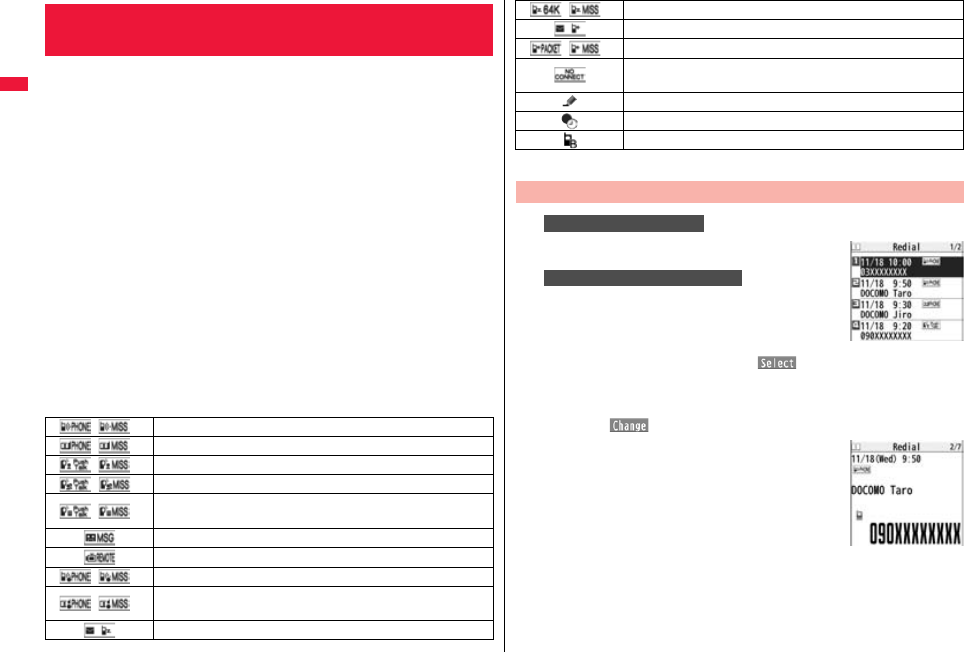
52
Voice/Videophone Calls/PushTalk
The FOMA terminal can store the other party’s phone number and date/
time you have dialed or received. You can call back to the other party.
■Redial
Up to 30 records of dialed voice calls, videophone calls and PushTalk calls are stored in
total, and the older record of dialing to the same phone number is deleted. However, the
dialing by PushTalk is retained in Redial separately from that of the voice call or
videophone call even if you dial to the same phone number.
■Dialed Calls
Up to 30 records of dialed voice calls, videophone calls and PushTalk calls are stored in
total, and up to 30 records of 64K data and packet communications are stored in total as
well. The older records of dialing to the same phone number are also retained.
■Received Calls
Up to 30 records of incoming voice calls, videophone calls and PushTalk calls are stored
in total, and up to 30 records of 64K data and packet communications are stored in total
as well. The older records coming from the same phone number are also retained.
≥When a call is switched between a voice call and a videophone call, the call that is
dialed/received first is stored.
≥When more than 30 calls are dialed, the older records are automatically deleted. Even
if you turn off the FOMA terminal, call records are not deleted.
≥In Dual Mode of 2in1, up to 60 redial items, 120 dialed call records, and 120 received
call records for Number A and Number B are stored in total.
■Icons for Redial, Dialed Calls, and Received Calls
<Redial> <Dialed Calls> <Received Calls>
Using Call Records
/※Dialed and received calls/missed calls of voice call
/※Dialed and received calls/missed calls of videophone call
/※Dialed and received calls/missed calls of PushTalk
/※Dialed and received group calls/missed group calls of PushTalk
/※Dialed and received calls/missed calls of PushTalk via server’s
phonebook
Voice/Video messages are recorded on Record Message
Incoming calls of Remote Monitoring
/※Dialed and received calls/missed calls of international call
/※Dialed and received calls/missed calls of international videophone
call
Dialed calls of 64K data communication
※ The unchecked missed call icons are highlighted.
1
Press Vo.
m1Phonebook1Dialed/recv. calls
1Dialed calls
The list for call records is displayed.
≥For redial items of PushTalk, press Oo() to
show the Redial list of the group. Highlight a party and press p to make a
PushTalk call. If you do not highlight any party and press p, you can make a
group call.
≥Press m( ) to display the Sent Address list.
2Select a call record.
The detailed display for the call record is displayed.
≥When the other party is stored in the Phonebook, the
phone number, name, and icon are displayed. If the
same phone number is stored with multiple names in
the Phonebook, the name and icon that come first in the
search order (see page 94) are displayed.
/※Received calls/missed calls of 64K data communication
Dialed calls of packet communication
/※Received calls/missed calls of packet communication
Received calls of 64K data communication and packet
communication when no external device is connected
Received Chaku-moji message
Records with time difference corrected
Records for Number B (only in Dual Mode of 2in1)
Use Redial/Dialed Calls
When Using Redial
When Using Dialed Calls
For Redial
For Redial
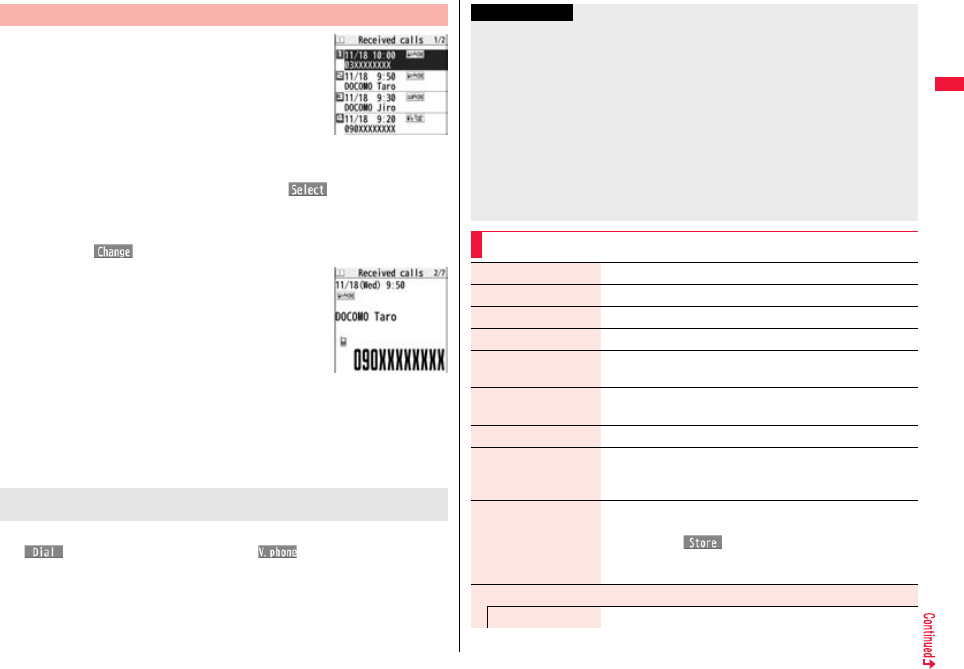
53
Voice/Videophone Calls/PushTalk
1Press Co.
≥You can display the Received Call list also by
m1Phonebook1Dialed/recv. calls1Received calls
1All calls or Missed calls.
All calls . . . . . . All the records including missed calls
Missed calls. . . The records of missed calls only
In Dual Mode of 2in1, the number of missed calls for
Number A and Number B is displayed respectively.
(If unchecked missed calls are found, the number of them is displayed.)
≥For received call records of PushTalk, press Oo( ) to show the Received
Call list of the group with “★” mark added to the caller. Highlight a party and
press p to make a PushTalk call. If you do not highlight any party and press p,
you can make a group call.
≥Press m( ) to display the Received Address list.
2Select a received call record.
≥The other party’s phone number is displayed if it is
provided. If this caller is stored in the Phonebook, the
phone number, name, and icon are displayed.
If the same phone number is stored with multiple names
in the Phonebook, the name and icon that come first in
search order (see page 94) are displayed. If there is a
call for packet communication, the sender’s access
point name (APN) is displayed.
When the other party’s phone number is not notified, the reason for no caller ID is
displayed.
≥For missed calls, the ring time is displayed on the right of the received date/time.
≥When a Chaku-moji message is received, it is displayed.
Press d to make a voice call. You can make a voice call also by pressing
Oo( ) from the detailed display. Press l( ) to make a videophone call
and press p to make a PushTalk call.
Use Received Calls
Received Call list
Detailed Received
Call display
To make a call to a displayed redial item, dialed call record, or
received call record
Information
≥You can make a voice call to the most recently dialed or received number by pressing
-d from the Stand-by display and then *No.
≥When you make/receive a call with an additional number of Multi Number, the stored
name for the additional number is displayed below the phone number on the detailed
display. If you store a phone number for “Number setting” of “Multi number”, the
phone number is displayed as well.
≥Dialed call records of 64K data communication are not stored when you use a
Bluetooth device.
≥Even if you make a voice call (or videophone call) to the phone number in a received
call record with a Chaku-moji message displayed, the received message is not sent.
≥When a call comes in from a party who uses a dial-in phone number, a different
phone number might be displayed.
Function Menu while Redial/Dialed Calls/Received Calls is Displayed
Notify caller ID See page 56.
Prefix numbers See page 60.
Int’l dial assist See page 59.
Select image See page 75.
2in1 dial You can select a phone number to be notified to the other
party in Dual Mode of 2in1. (See page 452)
Multi number You can select a phone number to notify the other party. (See
page 449)
Chaku-moji See page 55.
Search location You can access the site of “イマドコかんたんサーチ
(imadoco kantan search)”.
1YES
Add to phonebook See page 92.
≥You can store the phone number in the Phonebook also by
pressing m( ) from the detailed display. Go to
step 2 of “Storing Displayed Phone Number/Mail Address in
Phonebook” on page 93.
Add to PushTalk
Store in P-Talk PB 1YES
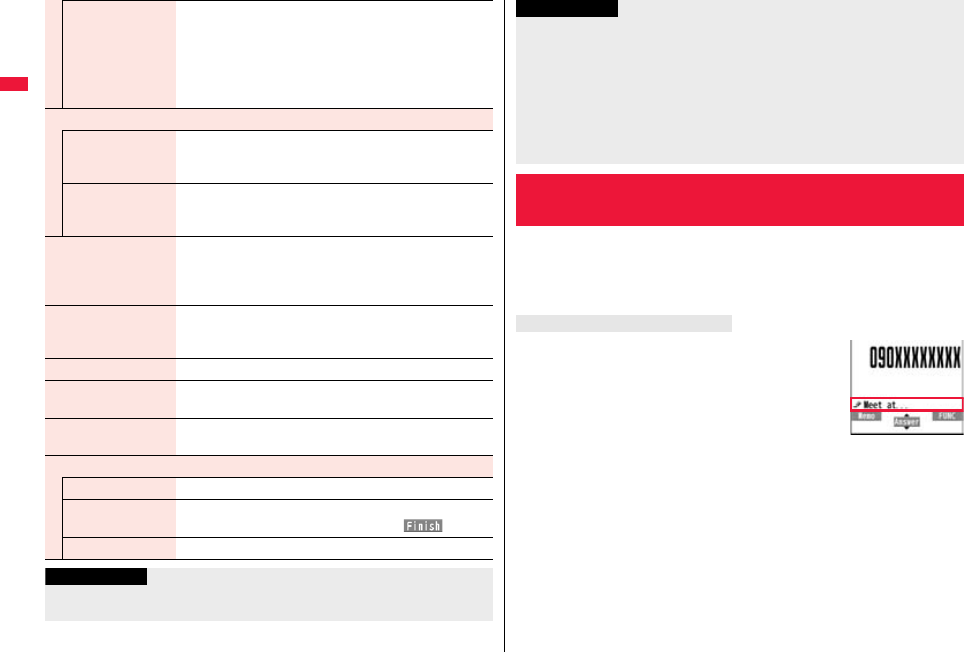
54
Voice/Videophone Calls/PushTalk
Store P-Talk group 1Select a group.
≥When members who are not stored in the PushTalk
Phonebook are found, the confirmation display appears
asking whether to store them.
1Enter a group name.
≥You can enter up to 16 full-pitch/32 half-pitch characters.
Mail
Compose message You can compose a mail message to send to the phone
number set as the destination address.
Go to step 3 on page 142.
Compose SMS You can compose an SMS message to send to the phone
number set as the destination address.
Go to step 3 on page 186.
Ring time
[Received Call list only]
You can display the ring time for missed calls. Even if you
have set “Missed calls display” of “Ring time” to “Not display”,
the missed calls which stopped ringing within the ring start
time and their ring times are displayed.
Font size You can switch font sizes for Redial, Dialed Calls, Received
Calls, Sent Address, and Received Address. (See “Dialed/
recv. calls” on page 120)
Add desktop icon See page 31.
Sent address
[Redial/Dialed Calls only]
See page 171.
Received address
[Received Calls only]
See page 171.
Delete
Delete this 1YES
Delete selected 1Put a check mark for redial items, dialed call records, or
received call records to be deleted1l()1YES
Delete all 1Enter your Terminal Security Code1YES
Information
<Store in P-Talk PB>
≥You cannot store from the call record for the party who is not stored in the Phonebook.
When making a voice call or videophone call, you can send your text
message to tell the subject during calling.
≥For details on Chaku-moji or compatible models, refer to DOCOMO website or “Mobile
Phone User’s Guide [Network Services]”.
≥The sending end is charged, but the receiving end is not charged.
A Chaku-moji message is displayed below a caller. The
Chaku-moji message is stored in Received Calls as well.
≥The Chaku-moji message is displayed only during ringing. It
is not displayed during a call.
≥Even when a Chaku-moji message comes in within the ring
start time set by “Ring time”, it is received and recorded in
Received Calls.
≥The Chaku-moji message is not displayed during Lock All, Omakase Lock, or Personal
Data Lock. However, you can check the Chaku-moji message from Received Calls
after the lock is released.
<Store P-Talk group>
≥You cannot store in a PushTalk group unless all the members are stored in the FOMA
terminal’s Phonebook.
<Delete>
≥If you execute “Delete all” from the Function menu of Redial/Dialed Calls, all records
in both Redial and Dialed Calls are deleted. Even if you execute “Delete this” or
“Delete selected” of Redial, the records are not deleted from Dialed Calls and they are
retained. To delete the dialed call records, delete them from the Function menu while
“Dialed calls” is displayed.
<Chaku-moji>
Using Chaku-moji
When a message is received
Information
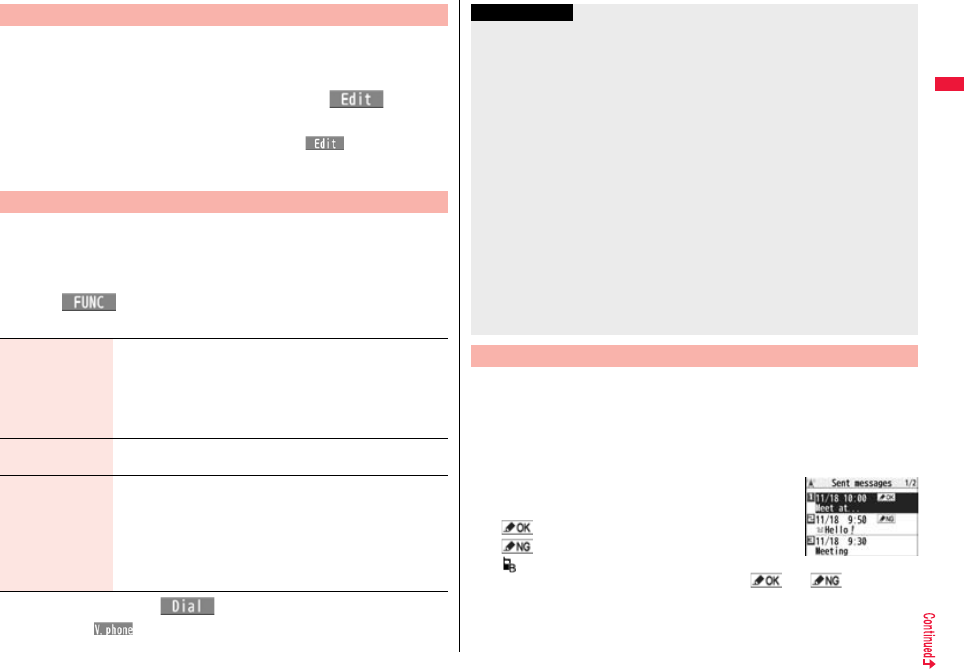
55
Voice/Videophone Calls/PushTalk
You can store up to 10 Chaku-moji messages in the Message list.
1m1Set./Service1NW services1Chaku-moji
1Create message
1Highlight <Not stored> and press l()
1Enter a message.
≥To edit a stored message, highlight it and press l().
≥You can enter up to 10 characters regardless of whether they are pictograms,
symbols, or full-pitch/half-pitch characters.
1Enter a phone number
or
call up the detailed display of a Phonebook entry, redial
item, dialed call record, or received call record.
2i
()
1
Chaku-moji
1
Do the following operations.
3Press d or Oo().
≥Press l( ) to make a videophone call.
≥The Chaku-moji message being sent is displayed while you are dialing.
Store Messages
Make a Call with a Message
Create message You can create a Chaku-moji message just before dialing.
1Enter a message.
≥You can enter up to 10 characters regardless of whether they
are pictograms, symbols, or full-pitch/half-pitch characters.
≥The Chaku-moji message created using this function is not
stored in the Message list.
Select message From the Message list, you can select a stored message.
1Select a message.
Sent messages From the Sent Message list, you can select a Chaku-moji
message to be sent. Up to 10 sent Chaku-moji messages only
are stored in the Sent Message list. If you send the same
Chaku-moji message, the older one also remains. When the
number of sent Chaku-moji messages exceeds 10, the
messages are deleted from the oldest one.
1Select a sent message.
Up to 10 sent Chaku-moji messages are stored in Sent Messages, and
you can check for the other party’s phone number and the date/time the
Chaku-moji messages were sent. Older messages sent to the same
phone number are also retained.
≥In Dual Mode of 2in1, up to 10 records for Number A and Number B can be displayed
in total.
1m1Set./Service1NW services
1Chaku-moji1Sent messages
. . . . Chaku-moji message successfully sent
. . . . Chaku-moji message unsuccessfully sent
. . . . . . . Chaku-moji message for Number B (only in Dual Mode of 2in1)
≥When the transmission result is not displayed, “ ” or “ ” is not
displayed.
≥Depending on the radio wave conditions, the transmission result might not be
displayed correctly.
Information
≥When a Chaku-moji message has arrived at the other party’s phone, “Transmission
completed” is displayed, and you are charged a transmission fee.
≥When a Chaku-moji message does not arrive at the other party’s phone such as when
the other party’s phone is not a Chaku-moji compatible mobile phone or the call is not
allowed by “Message disp. settings” at the receiving end, “Transmission failed” is
displayed. In this case, you are not charged a transmission fee.
≥Depending on the radio wave conditions, the transmission result may not be
displayed at the sending end even if a Chaku-moji message has arrived at the other
party’s phone. In this case, you are charged a transmission fee.
≥Even if you make a call sending a Chaku-moji message, the Chaku-moji message is
not displayed and you are not charged a transmission fee (the call is not recorded in
Received Calls at the receiving end) when the other party’s phone is out of the service
area, turned off, during Public Mode (Drive Mode), or the ring time for Record
Message Setting is set to 0 seconds. Also, the transmission result is not displayed at
the sending end.
≥When a videophone call is not connected and automatically dialed as a voice call, the
Chaku-moji message is resent as well.
≥Chaku-moji does not support PushTalk.
≥You cannot send/receive Chaku-moji messages overseas.
Detailed Sent Message
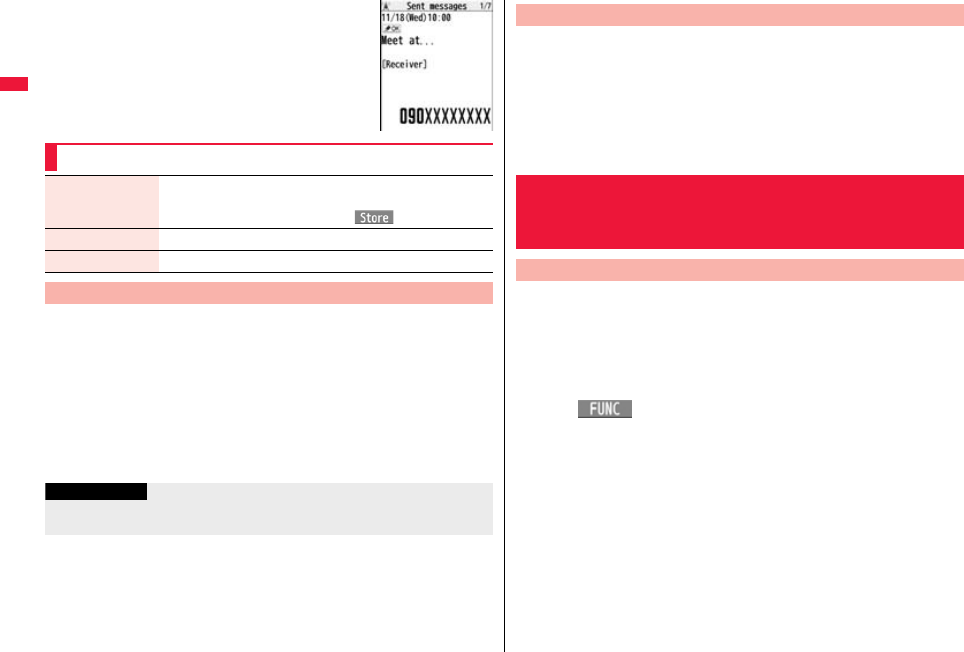
56
Voice/Videophone Calls/PushTalk
2Select a sent message.
≥When the other party’s phone number is stored in the
Phonebook, the phone number, name, and icon are
displayed.
You can set how incoming Chaku-moji messages are displayed.
1m1Set./Service1NW services1Chaku-moji
1Message disp. settings1Select an item.
Display all messages . . . . Displays Chaku-moji messages from all callers.
Numbers stored in PB . . .Displays Chaku-moji messages only from the callers
stored in the Phonebook.
Calls with callerID. . . . . . .Displays Chaku-moji messages only from the caller
notifying his/her phone number.
Hide all messages. . . . . . .Does not display Chaku-moji messages.
Function Menu while Detailed Sent Message is Displayed
Store You can store a sent Chaku-moji message in the Message list.
1<Not stored>
≥You can store also by pressing l().
Delete this 1YES
Delete all 1Enter your Terminal Security Code1YES
Message Display Settings
Information
≥When you set to “Numbers stored in PB”, you cannot receive Chaku-moji messages
from the callers stored in the Phonebook B in A Mode of 2in1 (and vice versa).
You can set how your FOMA terminal works for incoming Chaku-moji
messages for when “Setting when opened” is set to “Answer”.
1m1Set./Service1NW services1Chaku-moji
1Prefer Chaku-moji1ON or OFF
ON . . . . Does not answer by opening the FOMA terminal during ringing, so you
can check a Chaku-moji message.
OFF . . . Answers by opening the FOMA terminal while it is ringing.
Each time you dial out, you can set whether to notify your caller ID.
1Enter a phone number
or
call up the detailed display of a Phonebook entry, redial
item, dialed call record, or received call record.
2i()1Notify caller ID
1Don’t notify or Notify caller
≥To release “Notify caller ID”, select “Cancel prefix”. Whether to notify or not
follows the setting for “Activate” of “Caller ID notification”.
Prefer Chaku-moji
<186/184>
Setting Caller ID to Send/Not to Send for
Each Call
Set Caller ID Notification when Making a Call
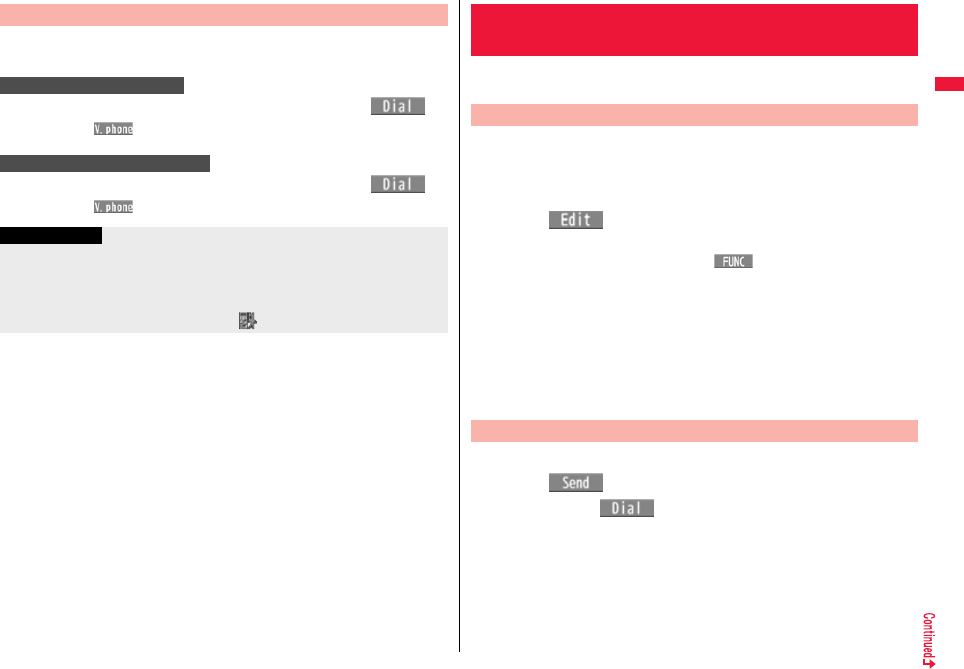
57
Voice/Videophone Calls/PushTalk
You can select whether to notify the other party of your phone number
also by entering “186”/“184” before the other party’s phone number.
1186→Destination phone number1d or Oo()
≥Press l( ) to make a videophone call.
1184→Destination phone number1d or Oo()
≥Press l( ) to make a videophone call.
Set “Notify/Not Notify” by Entering “186/184”
To notify your caller ID
Not to notify your caller ID
Information
≥When you make a call and hear the guidance requesting your caller ID (see
page 446), follow the steps of “To notify your caller ID” to enter “186” and redial.
≥When you make a PushTalk call, “Activate” of “Caller ID notification” or “Notify caller
ID” is valid, but “notify/not notify” by adding “186”/ “184” is invalid.
≥You cannot set “Caller ID notification” while “ ” is displayed.
You can send touch-tone signals from your FOMA terminal to use
services such as reserving tickets, checking bank balance, etc.
You need to store a number string to be sent as a touch-tone signal in the
Pause Dial list. If you have inserted a pause (p), you can send a number
string breaking at the point where the pause is inserted.
1m1Set./Service1
Other settings
1
Pause dial
1l
()
≥When a number string is already stored, it is displayed.
≥To delete a stored pause dial, press i( ) and select “Delete”, then select
“YES”.
2Enter a number string.
≥Enter the pause (p) by pressing and holding a for at least one second.
≥You can use only 0 through 9, s, a to enter a number string and the
pause (p).
≥You can enter up to 128 digits.
≥You cannot enter a pause (p) at the beginning and end of a number string, or
enter it consecutively.
1m1Set./Service1
Other settings
1
Pause dial
1Oo
()
1
Enter a phone number
1d
or
Oo
()
A voice call is made. Once the line is connected, a number string stored in Pause
Dial is displayed up to the first pause (p).
≥When the other party’s phone number is stored in the Phonebook, you can
retrieve it selecting from the Search Phonebook display by pressing Bo.
≥You can search for the phone number also from Received Calls by pressing Co
or from Redial by pressing Vo.
+m-8-4
<Pause Dial>
Sending Touch-tone Signals
Store Pause Dial
Send Pause Dial
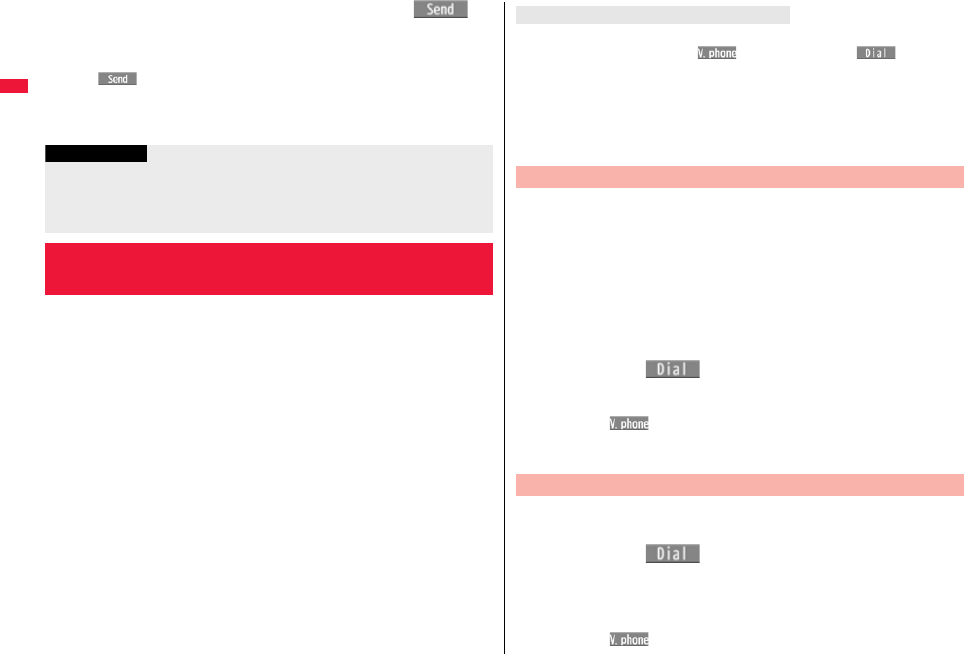
58
Voice/Videophone Calls/PushTalk
2Check that the line is connected1d or Oo()
A number string up to the first pause (p) is sent, and a number string up to the next
pause (p) is displayed.
A number string up to the pause (p) is sent each time you press d or
Oo().
When you have finished sending the last number, the “Talking” display appears.
≥To send multiple pieces of a number string at a time, press and hold Vo for at
least one second, and select “Send at one time”.
WORLD CALL is the international call service available from DOCOMO
mobile phones.
When you have signed up for FOMA service, you have contracted to use
“WORLD CALL” (except those who have applied not to use it).
≥You can call about 240 countries and regions.
≥The WORLD CALL charges are added to your monthly FOMA bill.
≥The application/monthly fee is free of charge.
≥The service is not available with some billing plans.
≥Contact “docomo Information Center” on the back page of this manual for inquiries
about WORLD CALL.
≥When using international carriers other than DOCOMO, contact them.
≥The caller ID might not be notified, or might not be displayed correctly depending on
the carrier. In this case, you cannot make a call by using Received Calls.
Information
≥During a call, you can send a number string also by displaying the Function menu of
the Pause Dial display.
≥Some devices on the receiving end cannot receive signals.
≥You cannot send a number string with pauses during a videophone call.
<WORLD CALL>
Making International Calls
You can make international videophone calls to the other party who uses a specific 3G
mobile phone overseas. Press l( ) instead of d or Oo( ) in the steps
of “Enter a Phone Number to Make an International Call”. (See page 58)
≥For the information about connectable countries and telecommunications carriers, refer
to the DOCOMO Global Service web page.
≥Images sent from the other party may blur on your FOMA terminal or you may not be
able to connect, depending on the other party’s phone used for the international
videophone call.
When you enter a phone number for dialing or storing it in the
Phonebook, press and hold 0 for at least one second to enter “+”. You
can use “+” to make international calls without entering an international
call access code.
≥If you set “Auto assist setting” of “Int’l dial assist” to “ON”, an international call access
code of “IDD prefix setting” is automatically entered.
10(for at least one second)
1Enter numbers in order of country/area code
→area code (city code)→destination phone number
1d or Oo()1Dial
≥
When the area code (city code) begins with “0”, enter it except for the “0”. However,
include “0” when making a call to some countries or regions such as Italy.
≥Press l( ) to make an international videophone call.
≥When you select “Dial with orig. No.”, you can make a call without adding an
international call access code.
1Enter numbers in order of 010→country/area code
→area code (city code)→destination phone number
1d or Oo()
≥You can make an international call also by entering 009130→010
→country code/area code→area code (city code)→destination phone number.
≥
When the area code (city code) begins with “0”, enter it except for the “0”. However,
include “0” when making a call to some countries or regions such as Italy.
≥Press l( ) to make an international videophone call.
About international videophone calls
Use “+” to Make an International Call
Enter a Phone Number to Make an International Call
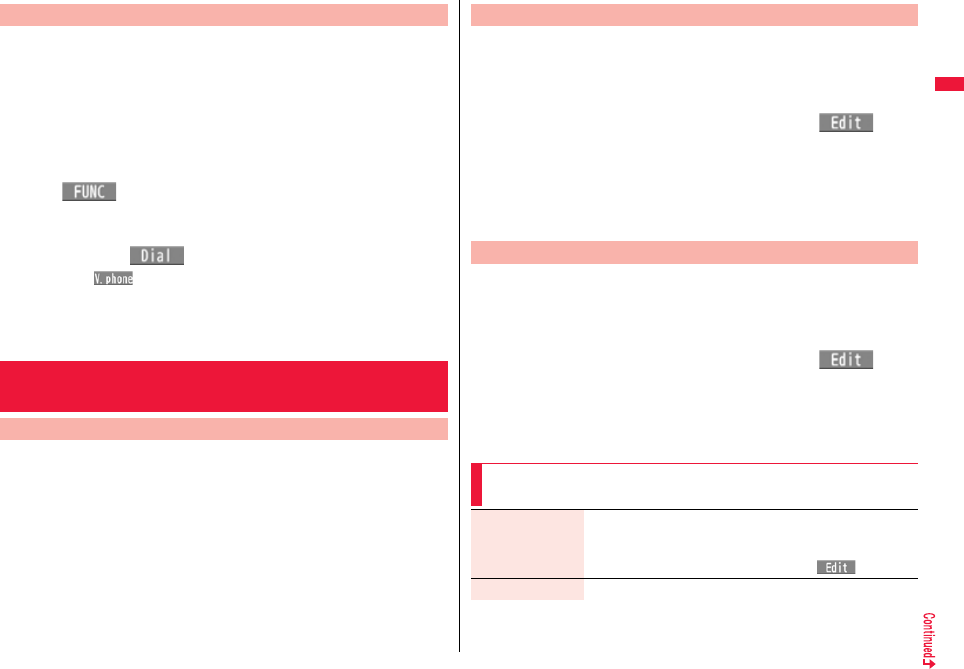
59
Voice/Videophone Calls/PushTalk
You can make a call adding a country/area code or international call
access code to a phone number. (Except for some countries and regions,
if the phone number starts with “0”, the “0” at the beginning is
automatically deleted.)
1Enter a phone number
or
call up the detailed display of a Phonebook entry, redial
item, dialed call record, or received call record.
2i()1Int’l dial assist
1Select a country/area name
1Select a name of International call access code
1d or Oo()
≥Press l( ) to make an international videophone call.
≥When the beginning of the phone number is “+”, the display for selecting a
country/area name is not displayed.
≥When “Japan” is selected as a country/area name, the display for selecting a
name of International call access code is not displayed.
You can set whether to replace “+” at the beginning of a phone number
with an international call access code for when you make an international
call from Japan.
1m1Set./Service1Network setting1Int’l dial assist
1Auto assist setting1ON or OFF
1Select a country/area name
1Select a name of International call access code.
≥When no country/area code or international call access code is stored, the
confirmation display appears asking whether to store it. Select “YES” and go to
step 2 of “Country/Area Code” on page 59 for a country/area code, and go to
step 2 of “IDD Prefix Setting” on page 59 for an international call access code.
International Dial Assist
<International Dial Assist>
Setting for International Calls
Auto Assist Setting
You can store up to 27 country/area codes to be added for making
international calls from overseas.
1m1Set./Service1Network setting1Int’l dial assist
1Country/Area Code
1Highlight <Not recorded> and press l().
≥If you select a stored country/area name, you can check the stored contents.
2Enter a country/area name 1Enter a country/area code.
≥You can enter a country/area name of up to 8 full-pitch/16 half-pitch characters.
≥You can enter a country/area code of up to 5 digits. But you cannot use #, :, and
+.
You can store up to three international call access codes to be added to
the beginning of a phone number for making an international call.
1m1Set./Service1Network setting1Int’l dial assist
1IDD prefix setting
1Highlight <Not recorded> and press l().
≥If you select the stored item, you can check the stored contents.
2Enter a name1Enter an international call access code.
≥You can enter a name of up to 8 full-pitch/16 half-pitch characters.
≥You can enter an international call access code of up to 16 digits.
Country/Area Code
IDD Prefix Setting
Function Menu while Country/Area Code /IDD Prefix
Setting is Displayed
Edit Go to step 2 of “Country/Area Code” on page 59 for Country/Area
Code, and go to step 2 of “IDD Prefix Setting” on page 59 for IDD
Prefix Setting.
≥You can edit the item also by pressing l().
Delete this 1YES
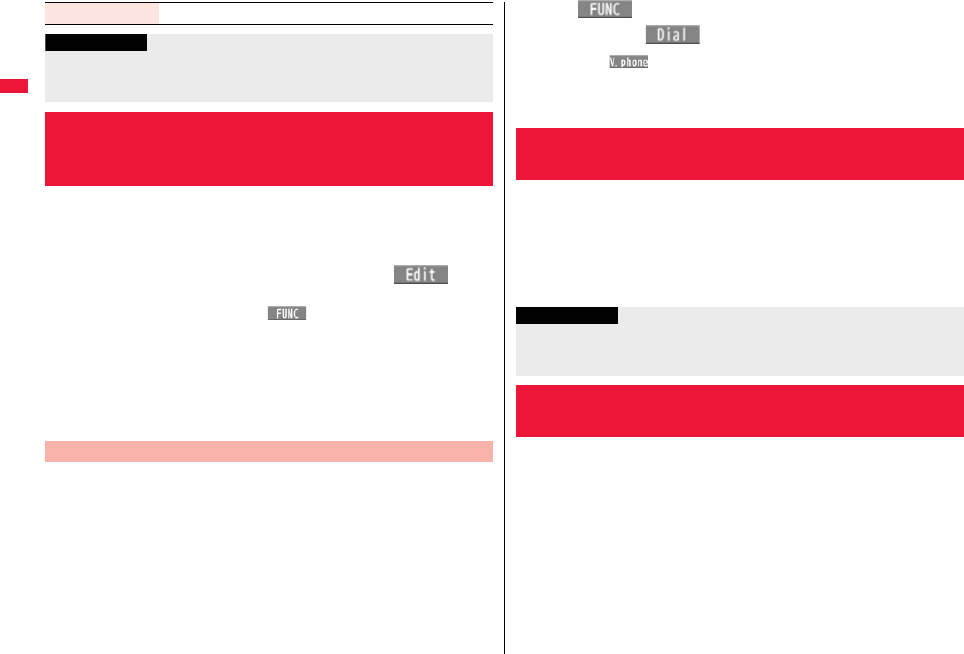
60
Voice/Videophone Calls/PushTalk
You can store prefix numbers such as international call access codes or
“186”/“184” and add them to the phone number for dialing. You can store
up to seven prefix numbers.
1m1Set./Service1Network setting1Prefix setting
1Highlight <Not recorded> and press l().
≥If you select a stored prefix, you can check the stored contents.
≥To delete a stored prefix, press i( ) and select “Delete this” or “Delete
all” then select “YES”. If you select “Delete all”, you need to enter your Terminal
Security Code.
2Enter a name1Enter a prefix number.
≥You can enter a name of up to 8 full-pitch/16 half-pitch characters.
≥You can enter a prefix number of up to 16 digits. The keys for entry are limited to
0 through 9, s and a.
You can add a prefix number to the beginning of phone number when
you make a call.
1Enter a phone number
or
call up the detailed display of a Phonebook entry, redial
item, dialed call record, or received call record.
Delete all 1Enter your Terminal Security Code1YES
Information
<Delete this> <Delete all>
≥You cannot delete the country/area code or international call access code set by
“Auto assist setting”.
<Prefix Setting>
Storing Numbers to be Added to the
Beginning of a Phone Number
Prefix Numbers
2i()1Prefix numbers1Select a name
1d or Oo()
≥Press l( ) to make a videophone call and press p to make a PushTalk
call.
≥For making a PushTalk call, adding a prefix number such as “186” or “184” to the
beginning of the phone number is disabled.
You can set whether to regard the numbers after “:” of a phone number
as a sub-address to access the specified phones or data terminals.
≥The sub-address is a number assigned to identify each ISDN terminal connected to an
ISDN line. It is also used for selecting contents on “V-live”.
1m1Set./Service1Other settings
1Sub-address setting1ON or OFF
You can set an alarm that sounds until a voice call, videophone call, or
PushTalk communication is reconnected after disconnected owing to
bad radio wave conditions.
1m1Set./Service1Talk1Reconnect signal
1Select an alarm.
<Sub-address Setting>
Making a Call Specifying a Sub-address
Information
≥Even if you set “Sub-address setting” to “ON”, “:” at the top of phone numbers and
“:” immediately after the prefix number or “186”/“184” are not regarded as
sub-address mark-off symbols.
+m-7-7
<Reconnect Signal>
Setting Alarm for Reconnecting
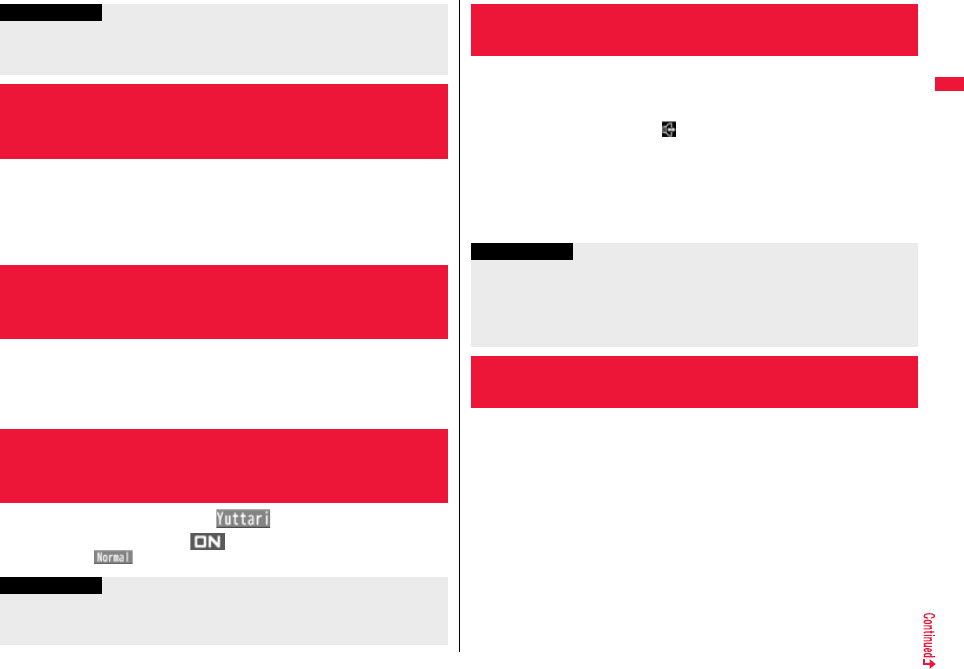
61
Voice/Videophone Calls/PushTalk
The volume of the other party’s voice is turned up according to the
surrounding noise during a call. This setting is effective only when the
other party’s voice is output from the earpiece.
1m1Set./Service1Talk1Shikkari Talk1ON or OFF
The noise sent to the other party is reduced according to the surrounding
noise during a call.
1m1Set./Service1Talk1Noise reduction1ON or OFF
1During a voice call1m()
While Yuttari Talk is activated, “ ” is displayed.
≥Press m( ) again to return to the normal speed.
Information
≥
The reconnectable time differs depending on the usage status and radio wave conditions.
An estimate is about 10 seconds and the call charge is applied also for that duration.
≥While you are disconnected, no sound is transmitted to the other party.
<Shikkari Talk>
Making Voice Clear According to
Surrounding Noise
+m-7-6
<Noise Reduction>
Reducing Surrounding Noise to Make
Voice Clear
<Yuttari Talk>
Slowing Down the Other Party’s Speaking
Speed
Information
≥Yuttari Talk is effective only during a current voice call. The speaking speed returns to
normal one when you end the call, switch calling parties during Multi calling, or switch
from the voice call to a videophone call.
When you switch to Hands-free, sound such as the other party’s voice is
audible over the speaker.
1During a call, dialing, or connecting1d
When Hands-free is activated, “ ” is displayed.
≥Press d again to deactivate Hands-free.
≥The sound volume during a Hands-free call follows the setting specified by
“Volume” (earpiece volume).
≥You can switch to Hands-free even during Manner Mode. Also, you will still hear
voice through the speaker even when you activate Manner Mode during a
Hands-free call.
You can make or receive voice calls from a Hands-free compatible device
such as In-Car Hands-Free Kit 01 (option) or a car navigation system by
connecting with your FOMA terminal.
You can connect your FOMA terminal to a Hands-free compatible device
using two ways of connections as follows:
≥Connect using a cable (USB connection):
To use/charge via the In-Car Hands-Free Kit 01 (option), you need to have the FOMA
In-Car Hands-Free Cable 01 (option).
≥Connect using Bluetooth (wireless):
To connect to a Bluetooth communication compatible Hands-free device, you need to
register and connect it to the FOMA terminal.
※For how to operate Hands-free compatible devices, refer to the respective instruction
manuals.
<Hands-free>
Switching to Hands-free
Information
≥While an earphone/microphone (option) is connected, you cannot hear voice through
the speaker even if you switch to Hands-free.
≥Keep the FOMA terminal well away from your ear during a Hands-free call. Otherwise
you could affect or damage your hearing.
≥Talk into the FOMA terminal within a distance of about 50 cm.
<In-Car Hands-free>
Using Hands-free Compatible Devices
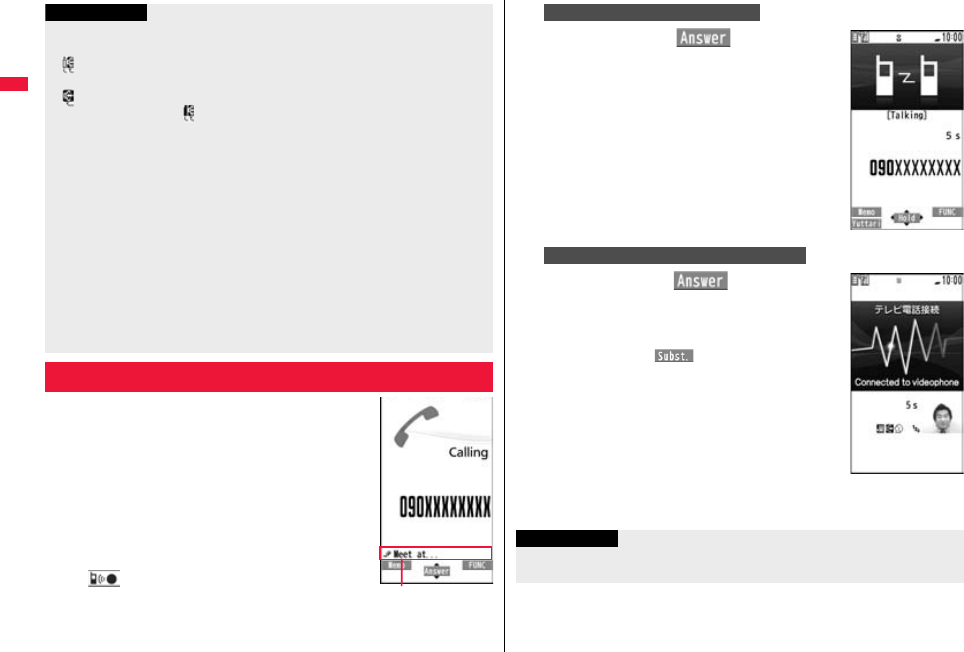
62
Voice/Videophone Calls/PushTalk
1When you receive a call, the ring tone
sounds and the Call/Charging indicator
flickers.
≥To vibrate the FOMA terminal for incoming calls, set
“Phone” or “Videophone” of “Vibrator” to other than
“OFF”.
≥While the phone is ringing for a videophone call,
“Incoming V.phone” is displayed. However, while
ringing for a voice call, this kind of indication is not
displayed.
≥“ ” is displayed at the upper left of the phone
number for incoming international calls.
Information
≥To connect using a cable (USB connection), set “USB mode setting” to
“Communication mode”.
≥“ ” appears while you are talking or communicating using a USB Hands-free
compatible device.
≥“ ” might appear while the FOMA terminal is connected to a USB Hands-free
compatible device, and “ ” while “USB mode setting” is set to “microSD mode”,
depending on the Hands-free device connected.
≥The display or ring tone for incoming calls follows the settings of the FOMA terminal.
≥When the sound is set to output from a Hands-free compatible device, the ring tone
sounds from that device even when Manner Mode is activated or “Ring volume” of the
FOMA terminal is set to “Silent”.
≥The receiving operation in Public Mode (Drive Mode) follows the setting of “Public
(Drive) mode”.
≥The receiving operation while Record Message is activated follows the setting of
“Record message setting”.
≥When the sound is set to output from the FOMA terminal, the operation for when the
FOMA terminal is closed during a call follows the setting of “Setting when closed”.
When the sound is set to output from a Hands-free device, the communication state
does not change regardless of “Setting when closed” even if you close the FOMA
terminal.
Receiving a Call/Videophone Call
Chaku-moji message
(See page 54)
2
Press d or Oo( ) to answer
the call.
Press d
or
Oo
()
to answer
the videophone call.
You can send the image through your camera to the
other party.
When you press m( ) to answer the videophone
call, the substitute image is sent to the other party.
(Substitute image answering)
≥Press m during a videophone call to switch between
the image through your camera and substitute image
for sending to the other party.
3Press h to end the call after talking.
For Answering a Voice Call
For Answering a Videophone Call
Information
≥If you close the FOMA terminal during a call, the FOMA terminal works in accordance
with the setting of “Setting when closed”. (See page 65)
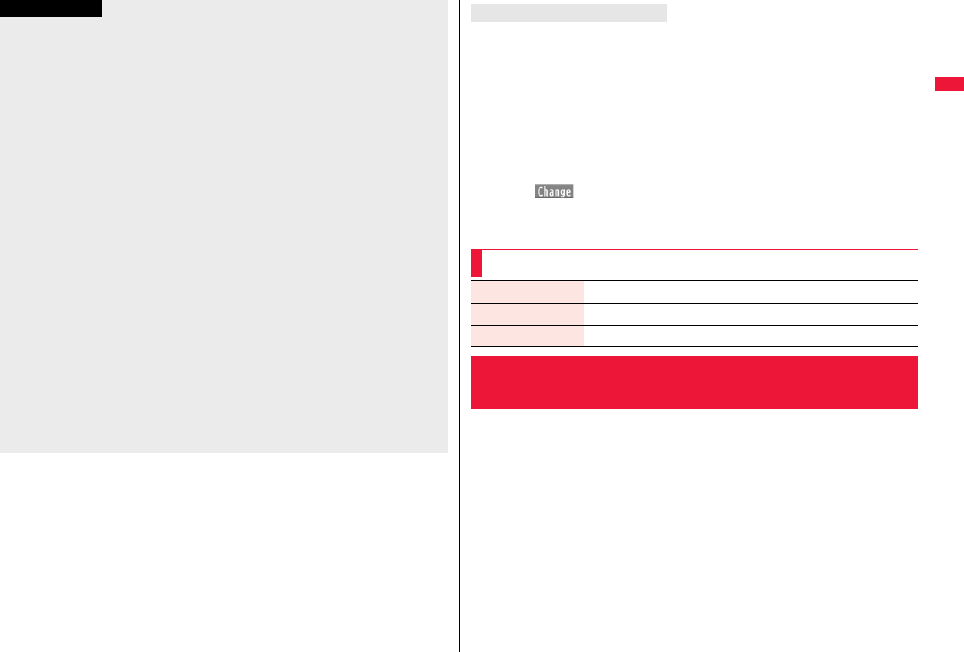
63
Voice/Videophone Calls/PushTalk
≥You might hear beeps (in-call ring tone) during a call.
If you have signed up for any of Voice Mail Service, Call Waiting Service, or Call
Forwarding Service and set “Arrival call act” to “Answer”, the beeps (in-call ring tone)
will sound for another incoming call, enabling you to do the following operations:
Voice Mail Service
. . . . Transfer the call to the Voice Mail Service Center. (See page 442)
Call Waiting Service
. . . . Put your current call on hold and answer the incoming call. (See page 442)
Call Forwarding Service
. . . . Transfer the call to the registered forwarding destination. (See page 445)
≥You can set “Reject unknown” not to accept calls from the phone numbers that are not
stored in the Phonebook.
<For Videophone Calls>
≥Just after purchase, Hands-free is automatically activated during a videophone call as
“Hands-free w/ V. phone” has been set to “ON”. (See page 74) However, Hands-free
is deactivated during Manner Mode regardless of “Hands-free w/ V. phone”.
≥Even if Call Forwarding Service is set to “Activate”, the call is not forwarded unless the
forwarding destination is a phone compatible with the videophone conforming to
3G-324M (see page 48). Check the phone you are forwarding the call to and then
activate the service. The videophone caller does not hear the guidance to the effect
that the call is forwarded. (The message to the effect that the call is to be forwarded
appears, depending on the receiver’s FOMA terminal.)
≥If a videophone call comes in from the phone number to be rejected by Nuisance Call
Blocking Service, the video guidance for Call Rejection is played back and the call is
disconnected.
≥You can send a Chara-den image to the other party instead of the image through your
camera. (See page 71)
Information
When a caller’s phone number is provided
If you store the caller’s name, phone number, and image in the Phonebook, the name,
phone number, and icon (or image) are displayed.
≥If the same phone number is stored with multiple names in the Phonebook, the name
that comes first in the search order (see page 94) is displayed.
≥The phone number but not the name is displayed during Personal Data Lock.
≥For a forwarded call, the forwarder’s phone number is displayed below the caller. (It
might not be displayed in the case of some forwarders.)
≥When you receive a call to an additional number of Multi Number, the stored name for
the additional number is displayed below the caller. (With a forwarded call, you can
press c( ) to switch to display of the forwarder.)
When a caller’s phone number is not provided
The reason for no caller ID is displayed. (See page 135)
When you have set “Notify switchable mode” to “Indication ON”, a caller
(the other party) can switch between a voice call and a videophone call.
≥You (receiving end) cannot switch between a voice call and a videophone call.
Display for incoming calls
Function Menu while a Call is Ringing
Call rejection You can disconnect the call without answering.
Call forwarding See page 445.
Voice mail See page 442.
Switched between a Call and a
Videophone Call by the Other Party
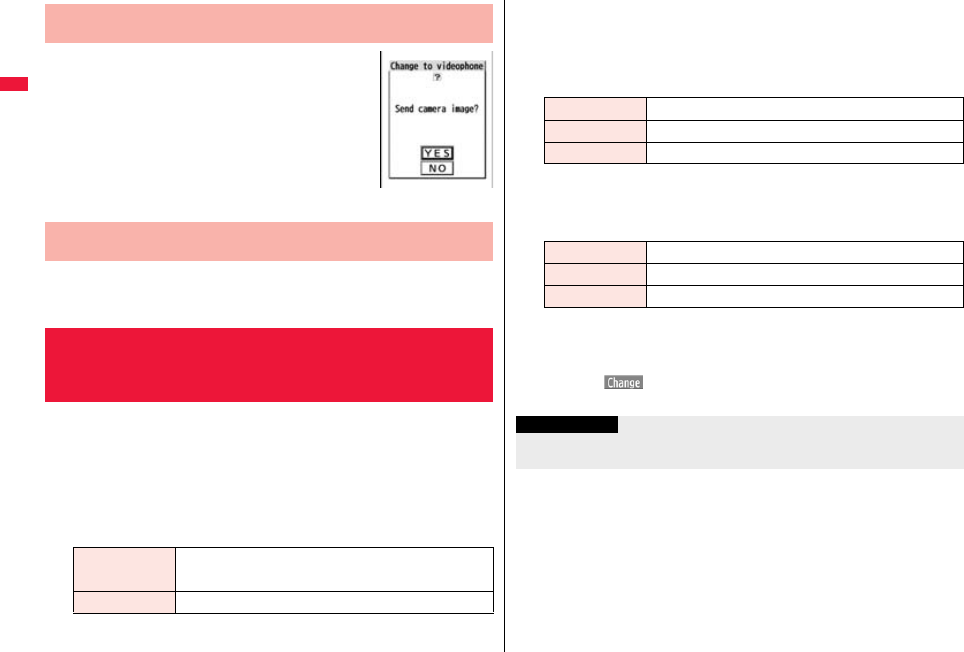
64
Voice/Videophone Calls/PushTalk
1The display for switching to a
videophone call appears during a voice
call.
YES . . . Sends the image through your camera to the
caller.
NO . . . . Sends a pre-installed substitute image to the
caller.
≥While switching, the message to that effect is displayed
and the voice guidance is played back.
When the caller (the other party) switches a videophone call to a voice
call, the message telling that the call is being switched appears, the voice
guidance is played back, and then the call is switched to a voice call.
You can set to start talking (Any key answer) or to stop the ring tone
(Quick silent) by pressing a key besides d, Oo, m (for videophone
call), or p (for PushTalk call) for when a call or PushTalk call comes in.
1m1Set./Service1Incoming call1Answer setting
1Select a key operation.
Any key answer
You can start talking by pressing any key shown below:
≥When receiving a videophone call, you can start talking by pressing d, Oo or
m.
Switched from a Voice Call to Videophone Call by the
Other Party
Switched from a Videophone Call to Voice Call by the
Other Party
+m-5-8
<Answer Setting>
Setting Response of Key Operation for
Answering Incoming Calls
Voice call※1※2d, Oo, 0 through 9, a, s, r, m, c※3, No,
<
PushTalk call d, Oo, p, 0 through 9, a, r, l, c, Bo, <
Quick silent
The following are the keys you can press to stop the ring tone, vibrator or voice
guidance:
When “Setting when opened” is set to “Keep ringing”, you can open the FOMA
terminal to stop the ring tone, vibrator or voice guidance. Even if you stop it, the
other party still hears a ringback tone.
≥After you stop the ring tone, vibrator or voice guidance, you can start talking by
pressing d, Oo, m (for videophone calls), or p (for PushTalk calls).
OFF
You can start talking by pressing a key shown below:
※1 You can activate Any Key Answer or Quick Silent also by pressing l when
five record messages have already been recorded.
※2 During Key Lock, you can activate Any Key Answer and Quick Silent by
pressing and holding < for at least one second.
※3 While “ ” is displayed, you cannot activate Any Key Answer or Quick
Silent by pressing c.
Voice call※1※20 through 9, a, s, r, m, c※3, No, <
Videophone call※20 through 9, a, s, r, c※3, No, <
PushTalk call 0 through 9, a, r, l, c, Bo, <
Voice call d, Oo
Videophone call d, Oo, m
PushTalk call d, Oo, p
Information
≥While an earphone/microphone (option) is connected, you can press the switch to
start talking, regardless of “Answer setting”. (See page 420)
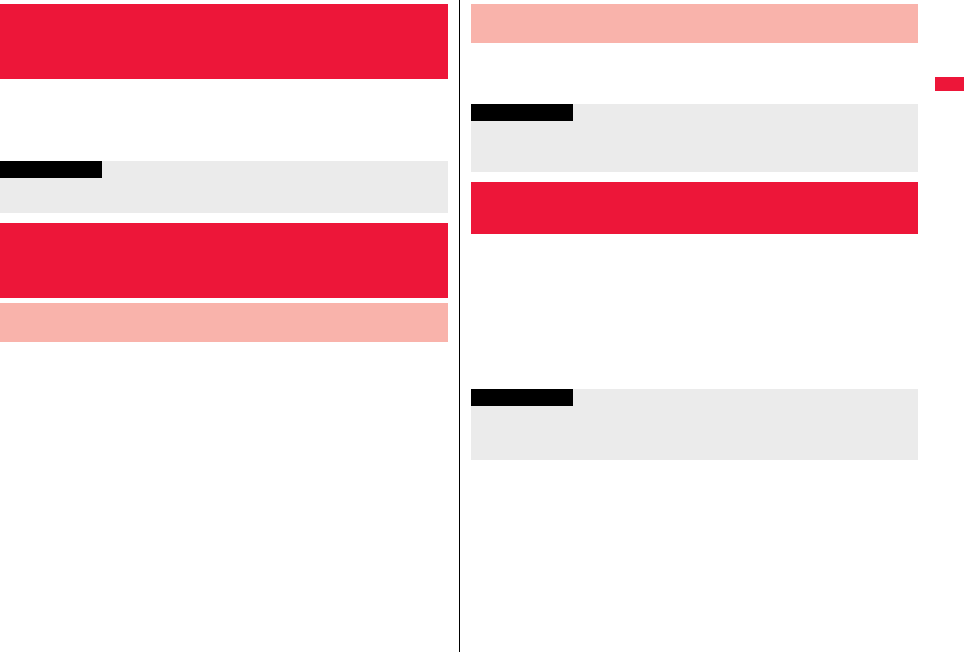
65
Voice/Videophone Calls/PushTalk
1m1Set./Service1Incoming call
1Setting when opened1Select an incoming type
1Keep ringing or Answer
1m1Set./Service1Talk1Setting when closed
1Phone/Videophone1Select an item.
Continue . . . . . .The call is continued. The setting is completed.
Hold . . . . . . . . . .The other party hears the hold tone set for “Holding tone” of “Set
hold tone”. For videophone calls, the still image set for “Holding”
of “Select image” is displayed.
End the call. . . . The call is finished. This is the same operation as pressing h
during a call. The setting is completed.
2Speaker ON or Speaker OFF
Speaker ON . . . . The hold tone sounds from the speaker.
Speaker OFF . . . The hold tone does not sound from the speaker.
<Setting when Opened>
Setting Response for when Opening
FOMA Terminal during Ringing
Information
≥If you receive a videophone call with “Answer” set, the still image set for “Substitute
image” of “Select image” is sent to the other party.
+m-1-8
<Setting when Closed>
Setting Response for when Closing FOMA
Terminal during a Call
Set Response for when Closing FOMA Terminal during a
Voice Call/Videophone Call
1m1Set./Service1Talk1Setting when closed
1PushTalk1Speaker call or End the call
1m1Set./Service1Talk1Volume1Use Bo or </> to
adjust the earpiece volume.
Adjust the earpiece volume to Level 1 (minimum) through Level 6 (maximum).
≥You can adjust the volume by pressing Zo or </> during a voice call and
calling, Bo or </> during a videophone call and PushTalk call, and by
pressing and holding Zo (for at least one second) while you are entering a
phone number. Press Bo or </> within two seconds to adjust it.
Set Response for when Closing FOMA Terminal during
PushTalk
Information
≥This function is disabled when an earphone/microphone (option) is connected. The
communication state does not change even if you close the FOMA terminal during a
call.
<Volume>
Adjusting Earpiece Volume
Information
≥The earpiece volume adjusted during a call is retained even after the call ends.
≥When you adjust the earpiece volume, the sound volume during a Hands-free call or
speaker call for PushTalk is also adjusted.
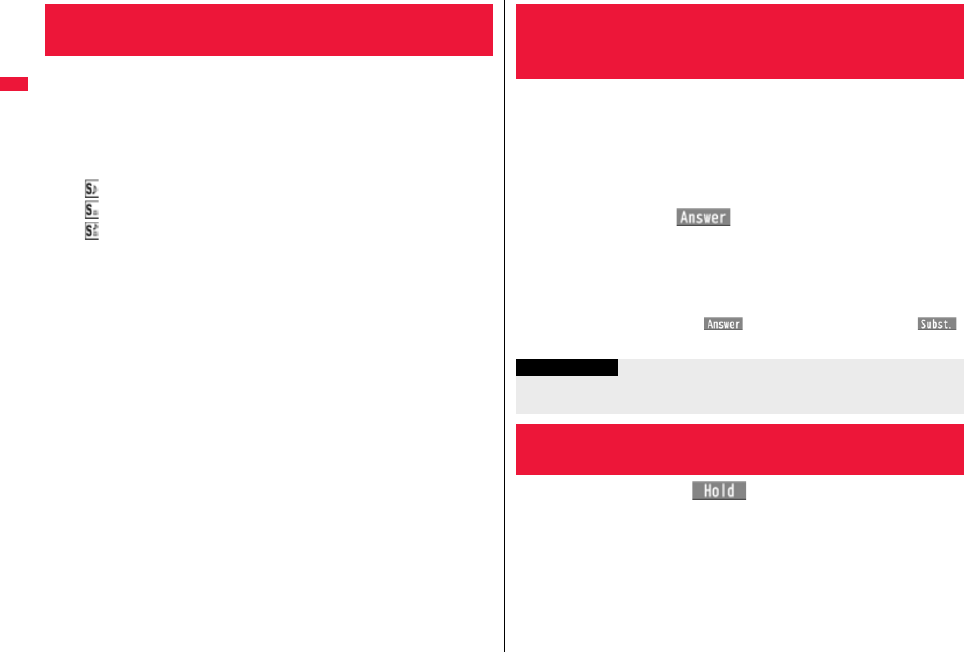
66
Voice/Videophone Calls/PushTalk
You can adjust the ring volume for incoming calls and mail.
1m1Set./Service1Sound1Ring volume
1Select an incoming type
1Use Bo to adjust the volume.
≥The following icons are displayed on the Stand-by display while “Ring volume” is
set to “Silent”:
: Set for “Phone”, “PushTalk”, or “Videophone”.
: Set for “Mail”, “Chat mail”, “MessageR”, “MessageF”, or “i-concier”.
: Set for “Phone”, “PushTalk”, or “Videophone”, and for “Mail”, “Chat mail”,
“MessageR”, “MessageF”, or “i-concier”.
≥If you have set “Step”, the ring tone is silent for about three seconds, and then the
volume steps up every three seconds, from Level 1 through Level 6.
≥While the phone is ringing for a voice call or videophone call, you can adjust the
ring volume by pressing Bo. However, you cannot adjust the ring volume in the
following cases:
・When “Ring volume” is set to “Step”
・When “Answer setting” is set to “Quick silent” and you stop the ring tone or
voice guidance
・During Manner Mode
・When a call is cut off within the ring start time specified by “Ring time”
+m-5-0
<Ring Volume>
Adjusting Ring Volume
1During ringing1h
The FOMA terminal makes three rapid beeps for confirmation and the call is put on
answer-hold (On Hold).
≥The confirmation tone does not sound during Manner Mode or when “Ring
volume” is “Silent”.
≥The other party hears the hold tone set for “On hold tone” of “Set hold tone”. For
videophone calls, the still image set for “On hold” of “Select image” is displayed.
2Press d or Oo( ) to release hold and answer
the call.
≥If “Answer setting” is set to “Any key answer”, you can release hold of voice calls
by pressing any key of 0 through 9, a, s, r, m, c, Mo, <, >,
l, or i.
≥If a videophone call is on hold, the image through your camera is sent to the other
party by pressing d or Oo( ) to release hold. If you press m()
to release hold, the substitute image is sent.
1During a call1Oo ()
≥The other party hears the hold tone set for “Holding tone” of “Set hold tone”. For
videophone calls, the still image set for “Holding” of “Select image” is displayed.
≥You can put the call on hold by closing the FOMA terminal during the call if you
have set “Setting when closed” to “Hold”.
<On Hold>
Putting a Call on Hold when You cannot
Answer Immediately
Information
≥The caller is charged for the call even during answer-hold (On Hold).
≥If you press -h during answer-hold (On Hold), the call will be disconnected.
<Holding>
Putting a Call on Hold during a Call
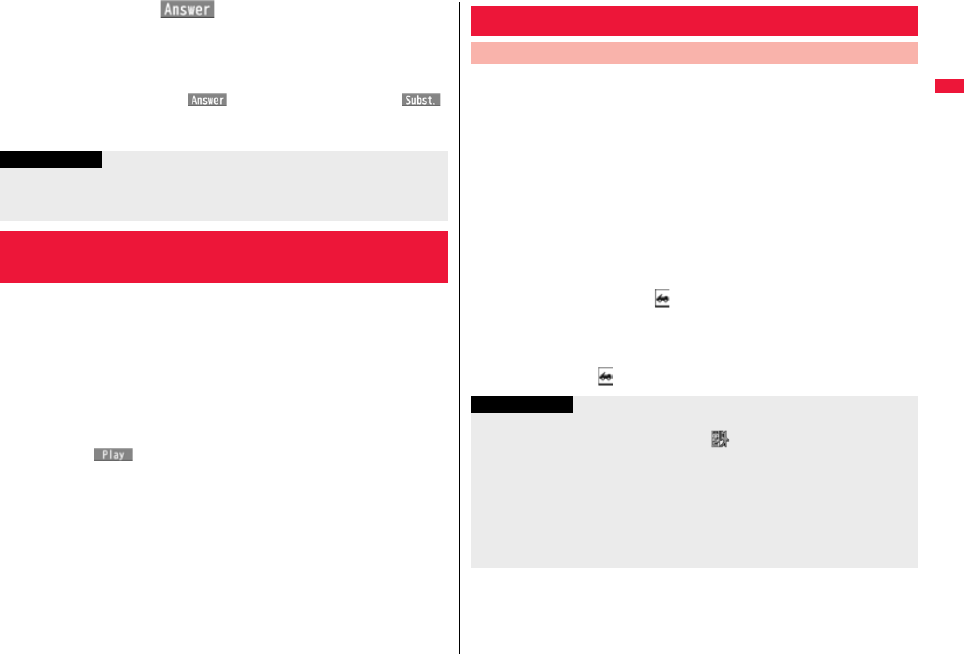
67
Voice/Videophone Calls/PushTalk
2Press d or Oo( ) to release hold and answer
the call.
≥When you have put a voice call on hold, you can release the hold also by
pressing r.
≥If a videophone call is on hold, the image through your camera is sent to the other
party by pressing d or Oo( ) to release hold. If you press m()
to release hold, the substitute image is sent.
≥You can release hold also by opening the FOMA terminal.
You can set the guidance the other party hears during on hold.
1m1Set./Service1Talk1Set hold tone
1On hold tone or Holding tone1Select a hold tone.
Tone 1/2. . .The caller hears the pre-installed guidance in Japanese.
RHAPSODY ON A THEME OF
. . . . . . . . . . .The caller hears the melody. You can set this for “Holding tone” only.
Voice announce
. . . . . . . . . . .The caller hears the sound recorded by “Voice announce”. If it has
not been recorded, this is not displayed.
≥Press l( ) to play back a hold tone. Press r to end the demo
playback.
Information
≥The caller is charged for the call even while the call is on hold.
≥If a new call comes in while the current call is put on hold, the hold (Holding) is
released.
<Set Hold Tone>
Setting Hold Tone
Public Mode is an auto-answer service that puts importance on manners
in public spaces. Once you activate Public Mode, the guidance is played
back telling that you cannot answer the call as you are currently driving
or in a place (a train, bus, movie theater, etc.) where you should refrain
from answering the call. Then the call is disconnected.
≥Voice Mail Service※1, Call Forwarding Service※1, and Caller ID Display Request
Service※2 work taking priority over Public Mode.
※1If a ring time is set to other than 0 seconds for incoming calls, the service works
after the Public Mode guidance.
※2When the other party notifies you of the phone number, Public Mode works.
≥Public Mode does not work to the calls from the party set to be rejected by Nuisance
Call Blocking Service.
1Press and hold a for at least one second.
Public Mode is activated and “ ” is displayed.
When a call comes in, the guidance “The person you are calling is currently driving
or in an area where cell phone should not be used. Please try again later.” is played
back for incoming calls.
≥To deactivate Public Mode, perform the same operation. Then, Public Mode is
deactivated and “ ” disappears.
Using Public Mode
Using Public Mode (Drive Mode)
Information
≥You can activate/deactivate Public Mode only from the Stand-by display. You can
activate/deactivate Public Mode even when “ ” is displayed.
≥You can make calls as usual even during Public Mode.
≥If you make an emergency call at 110/119/118, Public Mode is released.
≥When Public Mode and Manner Mode are activated simultaneously, Public Mode has
priority.
≥If a “User unset” call comes in while “Caller ID request” is set to “Activate”, the Caller
ID Request guidance is played back. (The Public Mode guidance is not played back.)
≥You cannot use this function during data communication.
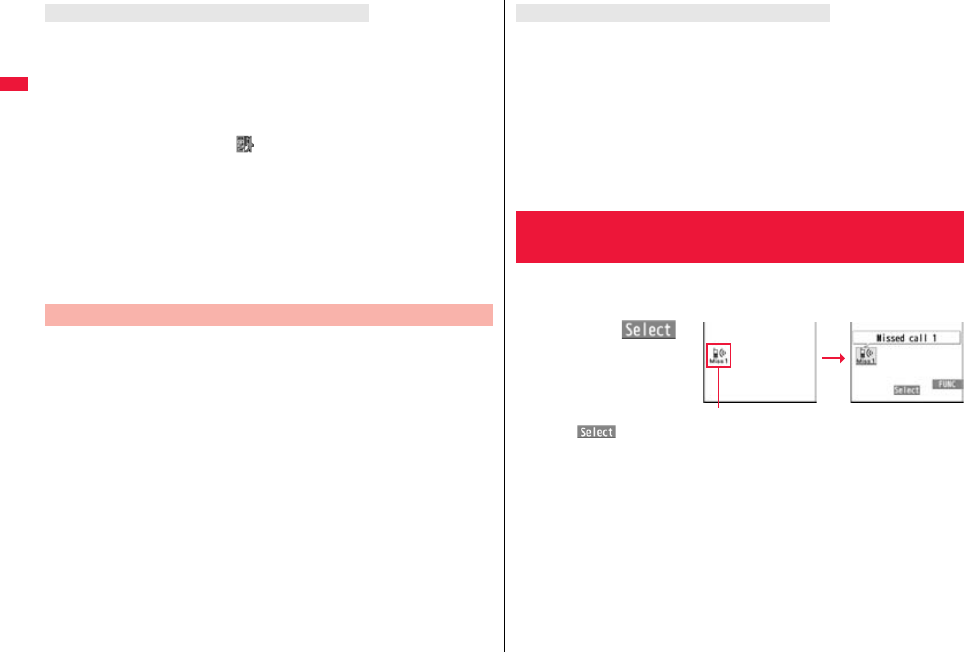
68
Voice/Videophone Calls/PushTalk
・Even when a call comes in, the ring tone does not sound. The “Missed call” icon
appears on the display and the call is stored in “Received calls”. The guidance is
played back to the caller to the effect that you are currently driving or in an area where
mobile phones should not be used. Then the call is disconnected. When a PushTalk
call comes in, no answer is made and the message “Connection failed” appears on the
caller’s display. For the talk among three or more members, the message to the effect
that you are driving is conveyed to them.
However, when the power is off or “ ” is displayed, the caller hears the
out-of-service area guidance instead of the Public Mode guidance.
・The ring tone does not sound and the Call/Charging indicator does not flicker even
when mail or a message comes in. In addition, the set vibrator does not work.
・The ring tone for 64K data communication, alarm tone, charging confirmation tone, the
ring tone for i-αppli call and effect tone at the start of i-Widget do not sound, and a
melody while an i-αppli program is running is not played back.
・The tickers of i-Channel are not displayed.
・See page 67 for how Public Mode (Drive Mode) and each network service work for
incoming calls when they are simultaneously activated.
Public Mode (Power Off) is an auto-answer service that puts importance
on manners in public spaces. Once you activate Public Mode (Power Off),
the guidance is played back telling that you cannot answer the call as
you are currently in a place (hospital, airplane, around priority seat in a
train, etc.) where use is prohibited. Then the call is disconnected.
1Enter “:25251”1d
Public Mode (Power Off) is set. (Nothing is changed on the Stand-by display.)
After setting Public Mode (Power Off) and turning off the power, the guidance “The
person you are calling is currently in an area where use is prohibited. Please try
again later.” is played back for incoming calls.
≥To release Public Mode (Power Off), dial “:25250”.
≥To check the setting for Public Mode (Power Off), dial “:25259”.
When Public Mode (Drive Mode) is activated
Using Public Mode (Power Off)
The setting stays activated until you dial “:25250” to deactivate Public Mode (Power
Off). You cannot deactivate the setting just by turning on the power.
The guidance is played back to the caller telling that you are currently in a place where
you should turn off the power. Then the call is disconnected. When a PushTalk call
comes in, no answer is made and the message “Connection failed” appears on the
caller’s display. For the talk among three or more members, the message to the effect
that you do not participate is conveyed to them.
The Public Mode (Power Off) guidance is played back even when you are out of the
service area or out of reach of radio waves.
・See page 67 for how Public Mode (Power Off) and each network service work for
incoming calls when they are simultaneously activated.
When you could not answer calls (Missed calls), the “Notification icon”
appears on the Stand-by display. You can check Received Calls by
selecting the icon.
1Oo1Oo()
≥Press h or r to return
to the former display.
≥When multiple icons are
found, use Mo to highlight
an icon and press
Oo().
When Public Mode (Power Off) is activated
<Missed Calls>
If You could not Answer an Incoming Call
Notification icon
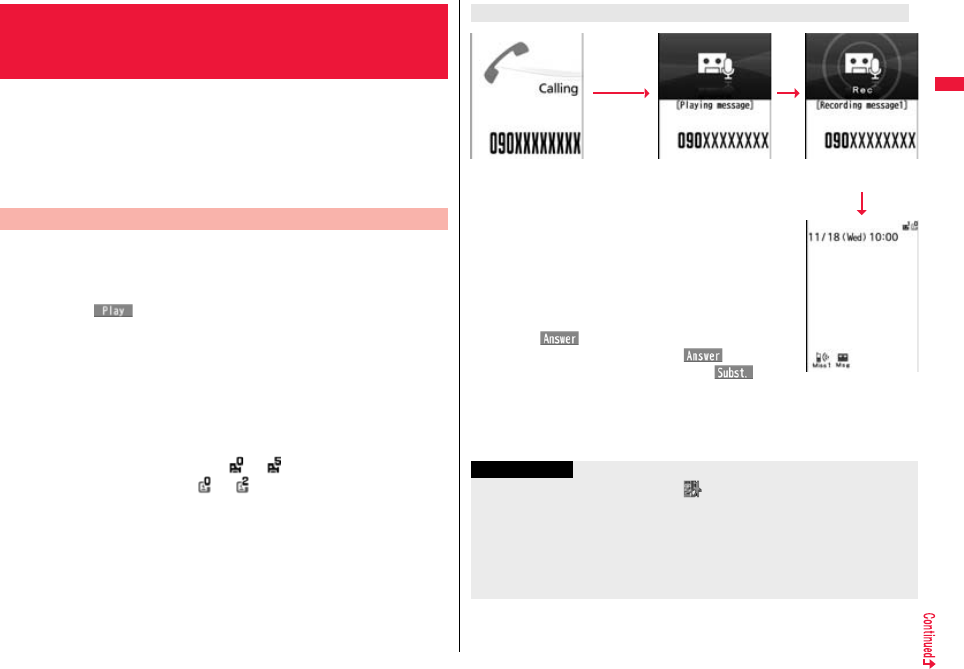
69
Voice/Videophone Calls/PushTalk
By activating Record Message, you can play back an answer message to
incoming calls and record callers’ voice/video messages when you
cannot answer them even if you have not signed up for Voice Mail
Service.
You can record up to five messages for voice calls and up to two
messages for videophone calls. Each message can be recorded for up to
20 seconds.
1m1LifeKit1Rec. msg/voice memo
1Record message setting1ON or OFF
1Select an answer message.
≥Press l( ) to play back the answer message. Press r to end the
demo playback.
≥When “Japanese 1”, “Japanese 2”, or “English” is set, a beep sounds after
playing back the answer message to the other party. If “Voice announce” is set,
the beep does not sound.
2Enter a ring time (seconds).
≥Enter from “000” through “120” in three digits.
≥You cannot set the same ring time for Remote Monitoring, Auto Answer Setting
and Record Message Setting. Set a different time for each.
≥While Record Message is activated, “ ”∼“ ” (the number of recorded
messages for voice calls) and “ ”∼“ ” (the number of recorded messages
for videophone calls) are displayed.
+m-5-5
<Record Message Setting>
Recording Voice/Video Messages when
You cannot Answer a Call
Activate Record Message For videophone calls, the still image set for “Preparing” of
“Select image” is displayed on the other party’s display while
playing back the answer message, and the still image set for
“Record message” of “Select image” is displayed while
recording.
≥To answer a call while the answer message is being played
back or a voice/video message is being recorded, press
d or Oo().
For videophone calls, press d or Oo( ) to send
the image through your camera, or press m( ) to
send a substitute image.
You can answer a call also by pressing the switch on an
earphone/microphone (option). For videophone calls, the image through your camera
is sent to the other party.
Incoming calls when Record Message Setting is set to “ON”
Incoming Call Playing back the
answer message
Recording a voice/
video message
The ring time
elapses
Displaying an icon on the
desktop (See page 29)
Information
≥Record Message does not work when “ ” is displayed.
≥When Public Mode (Drive Mode) and Record Message are simultaneously activated,
the former has priority and the latter does not work.
≥The priority order of answer messages is as follows: “Setting for Phonebook entry” →
“Group setting” → “Record message setting”.
≥If “Voice announce” selected as an answer message is deleted, the answer message
will be set to “Japanese 1”.
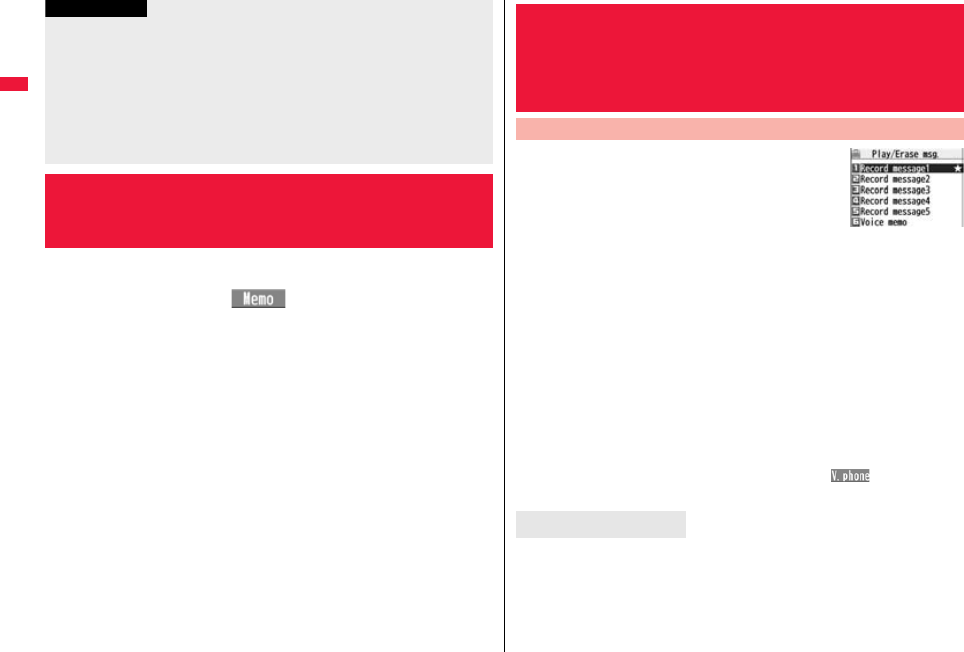
70
Voice/Videophone Calls/PushTalk
Even if a call comes in while Record Message is not activated, you can
record the caller’s voice/video message just for that incoming call.
1During ringing1l() or >
The caller will hear the answer message and then can leave you a voice/video
message.
≥During Key Lock, press and hold > for at least one second.
≥Record Message does not work when five messages for voice calls and two
messages for videophone calls have already been recorded. Also if you press >
while a PushTalk cal is arriving, Record Message does not work and Manner
Mode is set.
≥When Voice Mail Service or Call Forwarding Service is set at the same time as
Record Message, the priority depends on the ring time set for Voice Mail Service or
Call Forwarding Service. To give Record Message priority, set the ring time for
Record Message Setting shorter than that for Voice Mail Service or Call Forwarding
Service. Even when you do this, Voice Mail Service or Call Forwarding Service works
if there are already five record messages for voice calls and two record messages for
videophone calls.
≥You cannot receive a call from a third party while a voice/video message is being
recorded. The third party will hear the busy tone.
<Quick Record Message>
Recording a Message when You cannot
Answer an Incoming Call
Information
1m1LifeKit1Rec. msg/voice memo
1Play/Erase msg.
1Select a record message or voice
memo.
A beep sounds and playback starts.
≥On the Record Message list, recorded items are indicated by “★”.
≥It is played back at the volume set for “Volume” (earpiece volume).
≥When playback ends, a double-beep sounds and the message “Playing” is
cleared from the display.
≥The date and time the message/memo was recorded are displayed during
playback. When a caller’s phone number is provided, it is displayed. If the caller is
stored in the Phonebook, his/her name is also displayed.
However, the name is not displayed and the phone number only is displayed in
the following cases:
・When you play back a record message from the caller stored as secret data in
Normal Mode
・When you play back a record message for Number A in B Mode (or vice versa)
while using 2in1
≥If the caller’s phone number is displayed during playback, you can make a voice
call to that phone number by pressing d. Press l( ) to make a
videophone call and press p to make a PushTalk call.
From the Stand-by display, press > to play back the latest record message. When
record messages are not recorded, a voice memo is played back.
+m-5-5
<Play/Erase Messages>
<Play/Erase Videophone Messages>
Playing/Erasing Record Messages/a Voice
Memo/Videophone Record Messages/
Movie Memos
Play Back/Erase Record Messages/a Voice Memo
Record Message list
To play back using .>
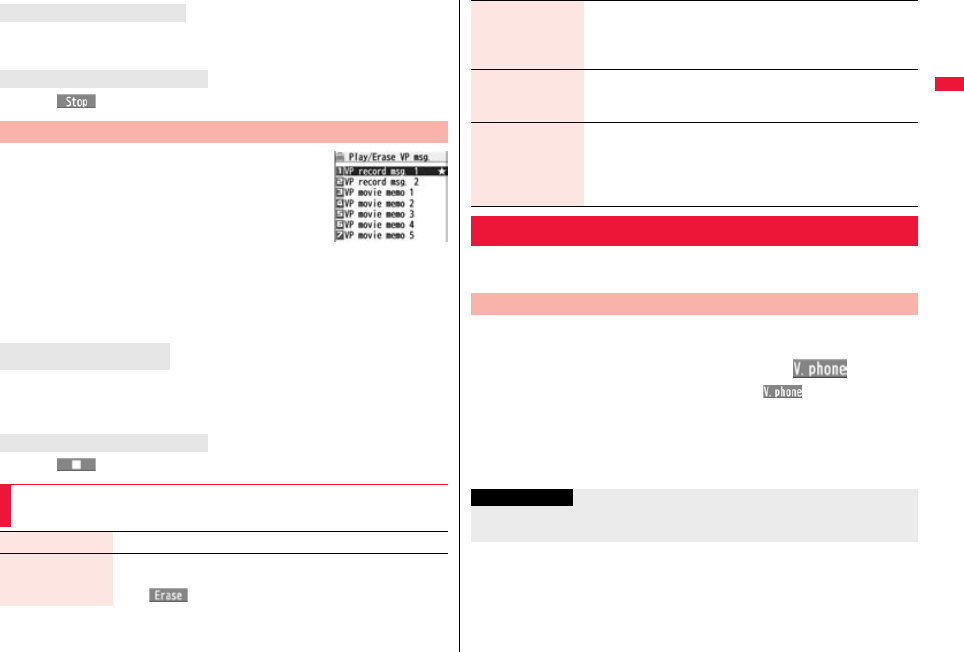
71
Voice/Videophone Calls/PushTalk
Each time you press > during playback, messages are played back in the following
order: the next new record message → the oldest record message → a voice memo.
Press Oo() or r.
1m1LifeKit1Rec. msg/voice memo
1Play/Erase VP msg.
1Select a videophone record message
or movie memo.
≥On the Videophone Record Message list, recorded
items are indicated by “★”.
≥It is played back at the same volume of the playback
sound of i-motion movies.
≥The date and time the message/memo was recorded are displayed during
playback.
From the Stand-by display, press and hold > for at least one second to play back the
latest videophone record message. When videophone record messages are not
recorded, the latest movie memo is played back.
Press Oo() or r.
To skip to next message
To cancel playback midway
Play Back/Erase Videophone Record Messages/Movie Memos
Videophone Record
Message list
To play back using .>
To cancel playback midway
Function Menu of the Record Message List/Videophone
Record Message List
Play You can play back the message.
Erase this 1YES
≥You can erase the message/memo also by pressing
i( ) during playback.
You can set up for sending a Chara-den image to the other party.
≥See page 361 for Chara-den images.
You can set a Chara-den image to be sent to the other party for making a
videophone call.
1Chara-den display/Chara-den list1l()
Enter the destination phone number and press l( ) to make a
videophone call.
≥When the other party’s phone number is stored in the Phonebook, you can
retrieve it selecting from the Search Phonebook display by pressing Bo.
≥You can search for the phone number also from Received Calls by pressing Co
or from Redial by pressing Vo.
Erase rec. msg. You can erase all record messages from the Record Message
list, and can erase all videophone record messages from the
Videophone Record Message list.
1YES
Erase movie memo
[Videophone Record
Message list only]
You can erase all movie memos.
1YES
Erase all You can erase all record messages and a voice memo from the
Record Message list, and can erase all videophone record
messages and movie memos from the Videophone Record
Message list.
1YES
Using Chara-den
Set by Call
Information
≥The priority order of substitute images to be sent to the other party is as follows:
“Setting by call” → “Setting for Phonebook entry” →“Group setting” → “Select image”.
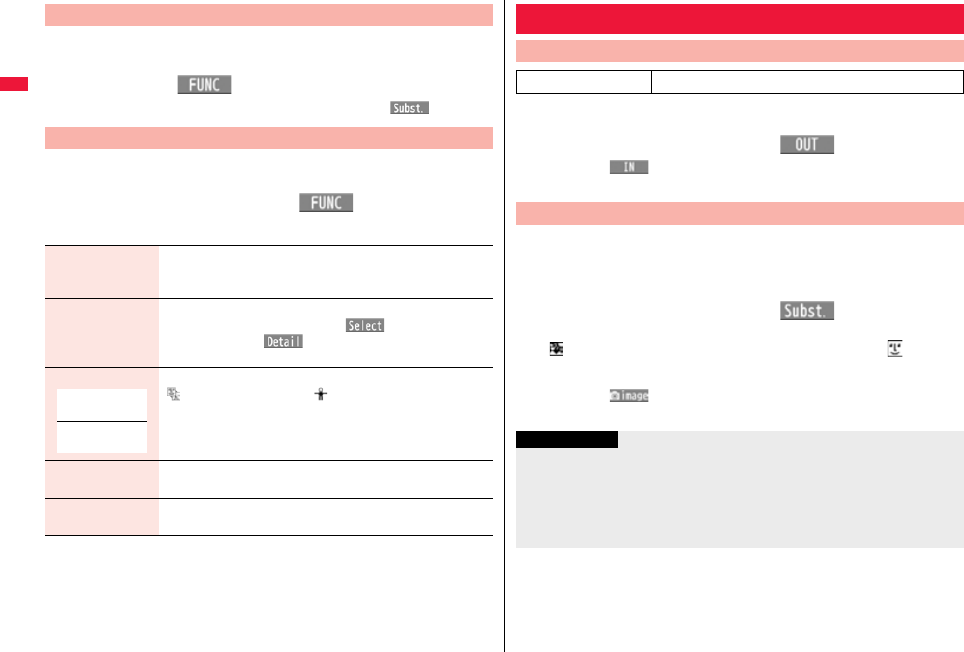
72
Voice/Videophone Calls/PushTalk
You can set a Chara-den image for “Substitute image” of “Select image”.
1Chara-den display/Chara-den list/Chara-den Recording
display1i()1Substitute image
≥From the Chara-den list, you can set it also by pressing m().
You can perform settings for a Chara-den call. These settings are
effective only for during a videophone call.
1During a Chara-den call1i()
1Chara-den setup1Do the following operations.
Substitute Image
Chara-den Setup
Switch Chara-den 1Select a Chara-den image.
≥If you switch Chara-den images, the action mode switches to
Whole Action Mode.
Action list You can display the list for actions that you can operate.
≥Highlight an action and press Oo( ) to execute the
action. Press l( ) to check the details of the action.
≥You can display the Action list also by pressing a.
Change action You can switch the action mode between Whole Action Mode
( ) and Parts Action Mode ( ).
≥You can switch modes also by pressing l.
SW substitute img. You can switch a substitute image to be sent to the other party to
the still image set for “Pre-installed” of “Select image”.
SW org. subst. img. You can switch a substitute image to be sent to the other party to
the still image set for “Original” of “Select image”.
At videophone
start-up
Whole Action
Mode
You can switch images to be sent to the other party from through the
inside camera to through the outside camera.
1During a videophone call1l()
≥Press l( ) again to switch to the image through the inside camera.
≥The setting here is effective only for the current videophone call.
You can switch images to be sent to the other party from the image
through your camera to the still image or Chara-den image set as the
substitute image.
See page 361 for Chara-den.
1During a videophone call1m()
The substitute image is sent to the other party.
“ ” is displayed while the still substitute image is being sent, and “ ” is
displayed if you have set a Chara-den image as a substitute image (during a
Chara-den call).
≥Press m( ) again to switch from the substitute image to the image
through your camera.
Useful Functions for Videophone Calls
Switching Cameras
At videophone start-up Inside camera
Send Substitute Images
Information
≥The priority order of substitute images to be sent to the other party is as follows:
“Setting by call” → “Setting for Phonebook entry” → “Group setting” → “Select image”.
Note that “Setting for Phonebook entry” and “Group setting” are disabled when a
videophone call comes in without notifying the caller ID.
≥Even when you make a videophone call sending a substitute image, you are charged
for the digital communication.
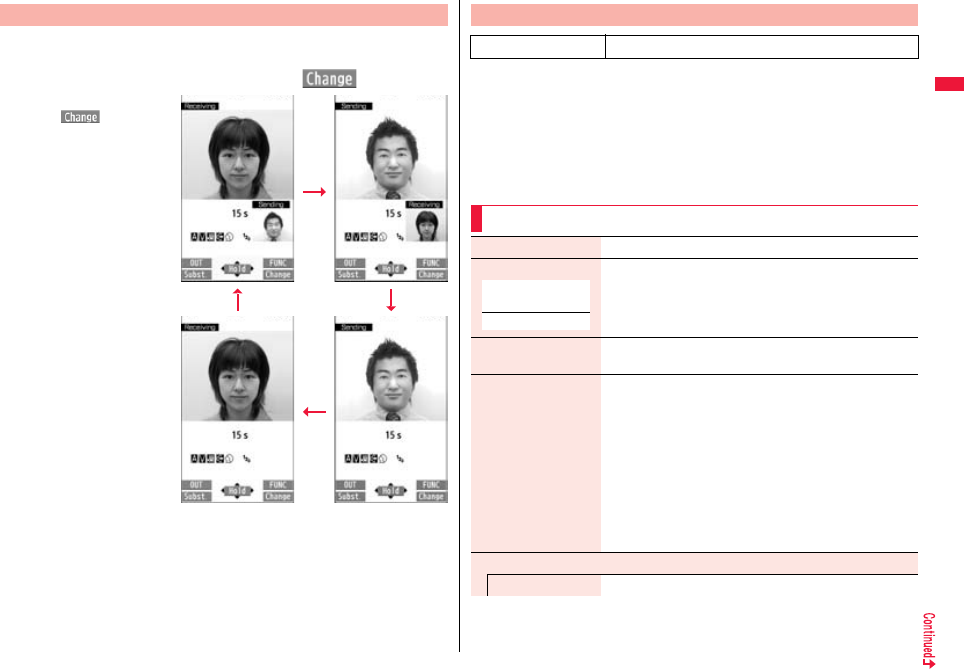
73
Voice/Videophone Calls/PushTalk
You can switch the display locations of the received image and the sent
image.
1During a videophone call, press c().
≥Each time you press
c( ), the displays
switch.
Switch Image Display Positions
+c
c
+cc
You can adjust the magnification for the camera image to be sent to the
other party. During a videophone call, the maximum magnification is
about 1.9 times for the inside camera and about 5.5 times for the outside
camera.
1During a videophone call
1Use No to adjust the magnification.
≥The former zoom setting returns when the videophone call ends.
Zoom
At videophone start-up WIDE
Function Menu during Videophone Call
CHG to voice call See page 51.
Photo light You can turn on the photo light when sending the image
through the outside camera to the other party.
1ON or OFF
Talk on BT/Phone You can set whether to communicate through the FOMA
terminal or a Bluetooth device. (See page 426)
Send DTMF tone/
DTMF tone OFF
During a Chara-den call, you can switch to the DTMF
Transmission Mode that enables you to enter the data from
the numeric keys and to send DTMF (touch-tone signals). You
can operate it only during a Chara-den call.
≥“Send DTMF tone” is displayed when the mode is not DTMF
Transmission Mode and “DTMF tone OFF” is displayed in
DTMF Transmission Mode.
≥In DTMF Transmission Mode, you cannot operate the action
of Chara-den images.
≥The DTMF tone may not be received depending on the
device of a receiving end.
V.phone settings
Visual preference See page 74.
At videophone
start-up
OFF
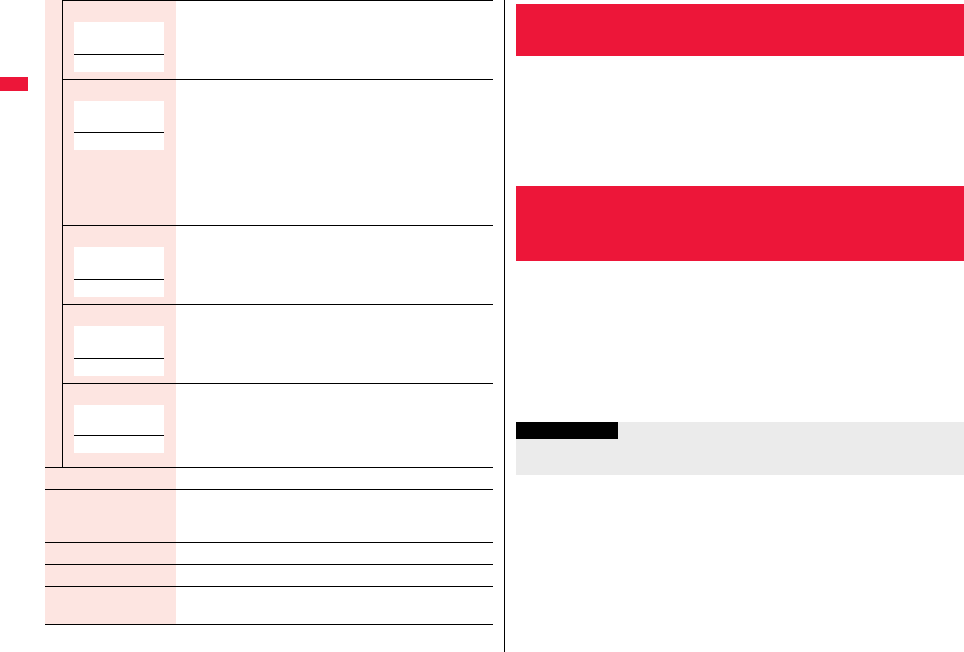
74
Voice/Videophone Calls/PushTalk
Brightness You can adjust the brightness of the camera image to be sent
to other party to -3 (dark) through +3 (bright).
1Select a brightness level.
White balance You can adjust the colors of the camera image to be sent to
the other party, to make the colors look more natural.
1Select an item.
Fine weather . . . . . For talking outdoors in fine weather
Cloudy weather . . . For talking in cloudy weather or in the
shade
Automatic. . . . . . . . For adjusting white balance
automatically
Light bulb . . . . . . . . For talking under incandescent light
Color mode set You can switch the color tone of the camera image to be sent
to the other party.
1Select a color tone.
Night mode You can lengthen the camera’s exposure time to make the
camera image to be sent clear in a dark place.
1ON or OFF
Focus You can set the focus for the outside camera during a
videophone call.
1Close-up or Landscape
≥The focus for the inside camera is fixed to “Portrait” (suitable
mode to shoot portraits), so you cannot change the setting.
Chara-den setup See page 72.
Backlight You can select whether to light the display constantly or light
for about 15 seconds after an operation.
1Constant light or 15 seconds light
LCD AI See page 114.
Own number You can display your phone number.
Key guide You can display the guide of key operation during a
videophone call.
At videophone
start-up
0
At videophone
start-up
Automatic
At videophone
start-up
Normal
At videophone
start-up
OFF
At videophone
start-up
Landscape
You can set whether to switch to Hands-free automatically for when a
videophone call starts.
1m1Set./Service1Videophone
1Hands-free w/ V. phone1ON or OFF
≥See page 61 for the operation while Hands-free is activated and how to switch to
Hands-free.
You can set the quality of both the received image and sent image on the
display.
1m1Set./Service1Videophone1Visual preference
1Select an image quality.
≥“Prefer motion spd” is effective when there is motion in an image. When there is
little motion, the quality becomes better if you set to “Prefer img qual”.
≥If you operate from the Function menu during a videophone call, the setting is
effective only for the current videophone call.
<Hands-free with Videophone>
Setting Hands-free Videophone
<Visual Preference>
Setting Image Quality for Videophone
Calls
Information
≥If the radio wave conditions weaken during a videophone call, the image may appear
like a mosaic.
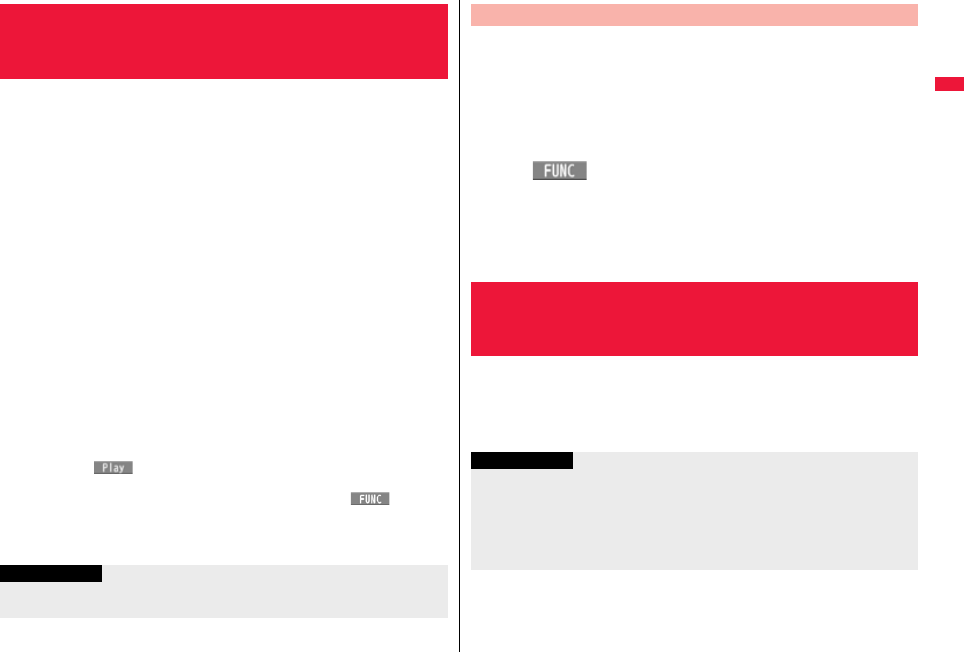
75
Voice/Videophone Calls/PushTalk
You can set an image to be sent to the other party.
1m1Set./Service1Videophone1Select image
1Select an item.
On hold . . . . . Sets an image for during answer-hold (On hold).
Holding . . . . . Sets an image for while a call is on hold (Holding).
Substitute image
. . . . . . . . . . . . Sets a substitute image (still image or Chara-den) for when the
camera is off.
Record message
. . . . . . . . . . . . Sets an image while recording a record message.
Preparing . . . Sets an image for while playing back an answer message.
Movie memo
. . . . . . . . . . . . Sets an image for while recording a movie memo.
2Select an image.
Pre-installed . . . For sending a pre-installed still image to the other party.
Original . . . . . . . For sending an appropriate message with a still image stored
using “Set display”.
Chara-den. . . . . For sending a Chara-den image selected by “Substitute image”
from the Function menu while a Chara-den image is displayed.
(See page 72)
(Displayed only when “Substitute image” has been selected in
step 1.)
≥Press l( ) to play back a demo to check the still image or Chara-den
image.
≥To change the setting of “Original” or “Chara-den”, press i( ), select
“Change setting”, then select a still image or Chara-den image. If you have
selected “Original”, select a still image after selecting a folder. However, you
cannot select a still image larger than Stand-by (480 x 854) size.
<Select Image>
Changing Image Displays for Videophone
Calls
Information
≥Even if you delete the still image selected from “Original”, that still image is displayed
to the other party. To change, set by “Change setting” or “Set display”.
You can set an image to be sent to the other party for making a
videophone call.
1Enter a phone number
or
call up the detailed display of a Phonebook entry, redial
item, dialed call record, or received call record.
2i()1Select image1Me or Chara-den
≥The setting is completed when you select “Me”.
≥To cancel the setting by call, select “Release”. The setting is completed.
3Select a Chara-den image.
If a videophone call cannot be connected, it will be automatically redialed
as a voice call.
1m1Set./Service1Videophone1Voice call auto redial
1ON or OFF
Set by Call
<Voice Call Auto Redial>
Redialing as a Voice Call when a
Videophone Call cannot be Connected
Information
≥The charges for calls once switched to voice calls are billed at the rates for the voice
calls.
≥Voice Call Auto Redial does not work when a videophone call cannot be connected
such as when the line is busy or the other party’s phone is in Public Mode (Drive
Mode). However, Voice Call Auto Redial works when you make a videophone call to a
phone that does not support the videophone function.
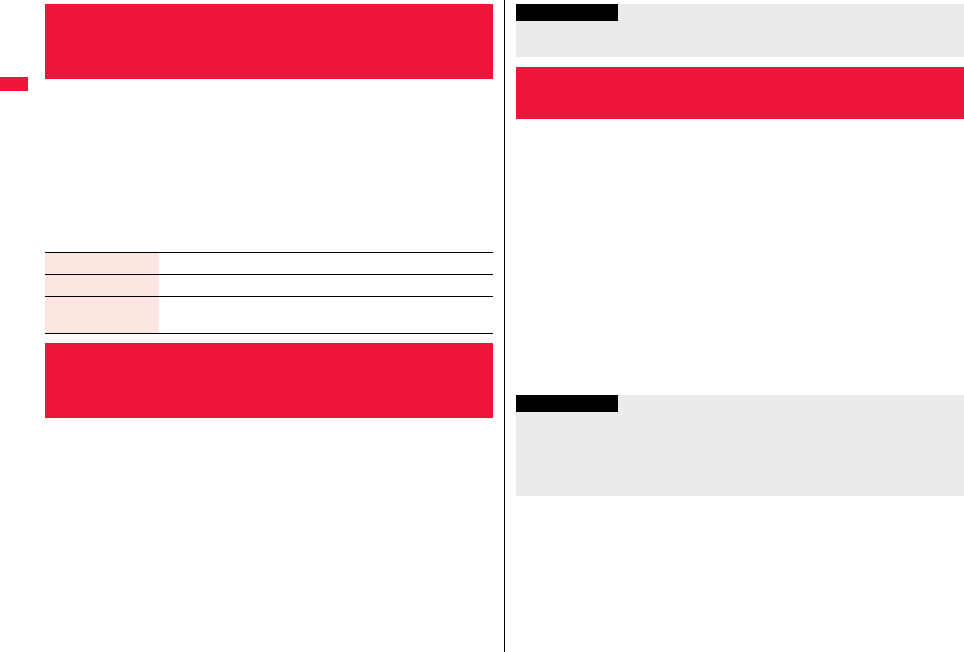
76
Voice/Videophone Calls/PushTalk
You can let the other party know that your FOMA terminal can switch
between a voice call and a videophone call.
This function is set to “Indication ON” at the time of contract. When
“Notify switchable mode” is set to “Indication ON”, the caller can switch
between the videophone call and voice call.
≥You cannot operate “Notify switchable mode” when you are out of the service area or
radio waves do not reach, or during a call.
1m1Set./Service1Videophone
1Notify switchable mode1Do the following operations.
1m1Set./Service1Incoming call
1V.phone while packet1Select an item.
V.phone priority
. . . .Shows the Videophone Call Receiving display. When you answer the
videophone call, packet communication is disconnected.
Packet downld priority
. . . .Rejects the videophone call and continues the communication.
V.phone answerphone
. . . .Connects the incoming videophone call to the Voice Mail Service Center.
Call forwarding
. . . .Forwards the incoming videophone call to the forwarding destination.
<Notify Switchable Mode>
Setting for Switching a Voice/Videophone
Call during a Call
Indication ON 1YES1OK
Indication OFF 1YES1OK
Check indication You can check the setting of the function.
1OK
<Videophone while Packet>
Selecting Response to Incoming
Videophone Calls during i-mode
You can operate your FOMA terminal from an external device such as
your personal computer for making or receiving videophone calls by
connecting them using the FOMA USB Cable with Charge Function 01/02
(option).
To use this function, you need to install a videophone application
program on a dedicated external device or personal computer, and
further, you need to prepare equipment (commercial item) such as an
earphone/microphone or USB compatible web camera.
≥For operating environments for a videophone application program and how to set or
operate it, refer to the instruction manual or other literature for an external device.
≥You can use “ドコモテレビ電話ソフト (DOCOMO Videophone Software)” for the
application program that supports this function.
Download it from the DOCOMO Videophone Software website.
(For details such as operating environment for the personal computers, refer to the
support web page.)
http://videophonesoft.nttdocomo.co.jp/ (In Japanese only)
Information
≥If you have not signed up for Voice Mail Service or Call Forwarding Service, “Packet
downld priority” works even if you set to “V.phone answerphone” or “Call forwarding”.
Using Videophone Calls by Interfacing to
External Devices
Information
≥You cannot make a videophone call from the external device during a voice call.
≥When you have signed up for Call Waiting Service, an incoming videophone call from
an external device during a voice call is recorded as a missed call in Received Calls.
The same applies for an incoming voice call, videophone call, and 64K data
communication during a videophone call from an external device.
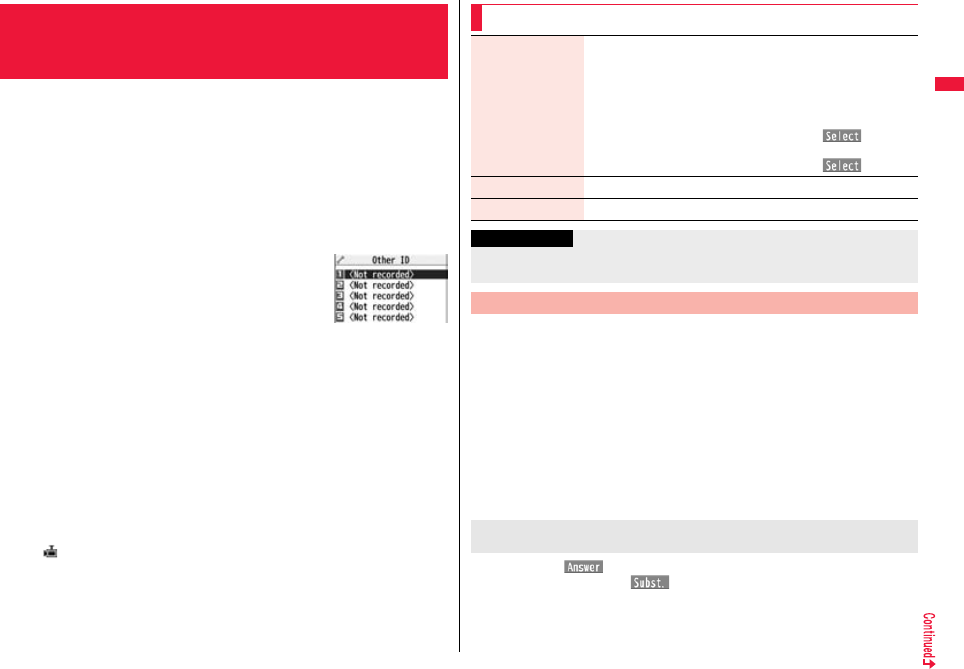
77
Voice/Videophone Calls/PushTalk
You can use the inside camera of the FOMA terminal as a monitoring
camera to observe the remote location from a phone that has the
videophone function based on 3G-324M. While “Remote monitoring” is
set to “ON”, the FOMA terminal automatically starts Remote Monitoring
when it receives a videophone call from a phone number stored as
“Other ID” of “Remote monitoring”.
1m1Set./Service1Videophone1Remote monitoring
1Enter your Terminal Security Code.
≥To release Remote Monitoring, select “Set”, then select “OFF”.
2Other ID1<Not recorded>
1Enter a phone number.
≥To change, select the stored phone number.
≥You can enter up to five phone numbers of up to 26
digits by using numerals, #, :, and +.
≥To return to the setting display for Remote Monitoring, press r from the Other
ID list after storing phone number.
3Ring time1Enter a ring time (seconds).
≥You can enter the time from “003” through “120” in three digits until Remote
Monitoring starts after receiving a videophone call.
≥You cannot set the same ring time for Remote Monitoring, Auto Answer Setting
and Record Message Setting. Set a different time for each.
4Set1ON
≥When receiving videophone calls from the phone numbers stored as “Other ID”,
the FOMA terminal automatically answers to start Remote Monitoring after the
ring time elapses.
≥“ ” is displayed while this function is set to “ON”.
≥You cannot set to “ON” in Manner Mode.
<Remote Monitoring>
Checking inside of a Room when You are
Out
Other ID list
1Make a videophone call from a stored phone number.
After the ring time set for “Remote monitoring” elapses, Remote Monitoring
automatically starts.
≥The image through the receiving end’s camera appears on the display and the
sound comes out of the speaker.
≥You cannot set Voice-only Remote Monitoring.
≥Make a videophone call notifying your caller ID. If the caller ID is not notified,
Remote Monitoring will not start and the call will be handled as an ordinary
incoming videophone call.
2Remote Monitoring ends when the calling end or
receiving end presses h.
Press d or Oo( ) before the FOMA terminal answers a videophone call
automatically. If you press m( ), the videophone call starts sending the
substitute image to the other party.
≥When a remote monitoring call comes in, “Setting when opened” is disabled.
≥If you press h when a remote monitoring call comes in, the call will be cut and
Remote Monitoring will not start.
Function Menu of the Other ID List
Look-up address You can call up a phone number in the Phonebook, Dialed Calls,
or Received Calls to enter it.
1Select an item.
Phonebook
. . . Call up a Phonebook entry and select a phone number.
Dialed calls
. . . Highlight a phone number and press Oo().
Received calls
. . . Highlight a phone number and press Oo().
Delete this 1YES
Delete all 1YES
Information
<Delete this> <Delete all>
≥
If you delete all phone numbers stored as “Other ID”, “Remote monitoring” is set to “OFF”.
Perform Remote Monitoring
For answering a videophone call without starting Remote
Monitoring at the receiving end
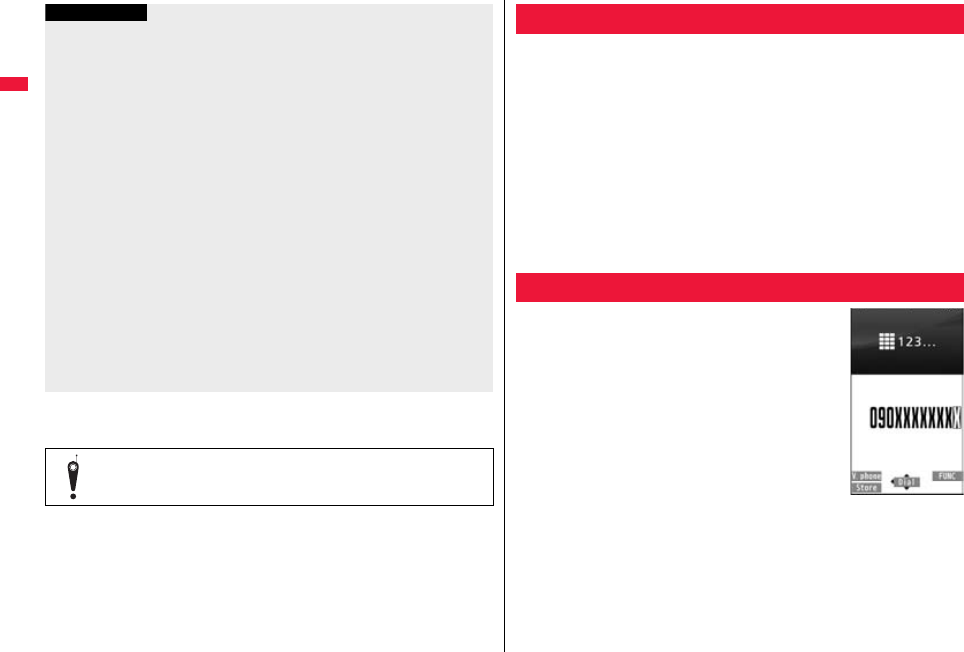
78
Voice/Videophone Calls/PushTalk
≥You may be imposed punishment according to the law and rule (such as the
nuisance prevention ordinance) if you use the FOMA terminal to give a
remarkable nuisance and misdeed to the public.
Information
≥When your FOMA terminal is used for the receiving end, an image through the caller’s
camera appears, and sound comes out. (You cannot switch to a substitute image.)
≥Remote Monitoring does not start during Manner Mode and Public Mode (Drive
Mode). However, it starts even during Lock All.
≥When Remote Monitoring is set to “ON” and a videophone call comes in from the
phone number set as “Other ID”, Remote Monitoring starts after the set ring time,
even when “Ring time”, “Auto answer setting”, or “Record message setting” is set and
regardless of their ring times.
≥When Remote Monitoring is not performed, it is recorded in Received Calls as a
missed videophone call.
≥If an earphone/microphone (option) is connected when a remote monitoring call
comes in, the ring tone sounds from both the earphone and the speaker, even when
“Headset usage setting” is set to “Headset only”.
≥The ring tone for Remote Monitoring sounds. (You cannot change the ring tone for
Remote Monitoring.)
The ring tone sounds at the volume set for “Videophone” of “Ring volume”, but at
“Level 2” if you have set “Step”, “Level 1” or below. The color is “Gradation”, and its
lighting pattern is “Standard”, regardless of the Incoming Illumination setting.
≥You cannot put incoming remote monitoring calls on answer-hold (On Hold).
≥If you set both Call Forwarding Service and Remote Monitoring, and give priority to
Remote Monitoring, set its ring time shorter than that for Call Forwarding Service.
≥
To use Call Forwarding Service for Remote Monitoring, store the phone number of
dialing side as “Other ID” and set a 3G-324M videophone as the forwarding destination.
Please be considerate of the privacy of individuals around you
when shooting and sending photos using camera-equipped
mobile phones.
This service provides you a pleasurable group calls among multiple
parties (two to five persons including yourself). The participants can
speak by turns by pressing the PushTalk key.
※You are charged a PushTalk communication fee each time you press the PushTalk
key (speak).
≥For details on PushTalk or compatible models, refer to DOCOMO website or “Mobile
Phone User’s Guide [Network Services]”.
■PushTalkPlus※
This service enables you to have a PushTalk call with up to 20 persons including you.
You can use the shared Phonebook on the network, and can check the members for
their status, thus PushTalk becomes more useful.
※You need to subscribe separately.
≥For details such as how to operate, refer to the booklet which is supplied at
subscription.
1Enter the other party’s phone number
1p
When you are dialing, a confirmation tone for starting a
PushTalk call sounds for a few seconds, and then the
same ringback tone as the voice (videophone) call
sounds.
≥You can make a group call to multiple persons using
the PushTalk Phonebook. (See page 82 and page 83)
PushTalk
Making a PushTalk Call
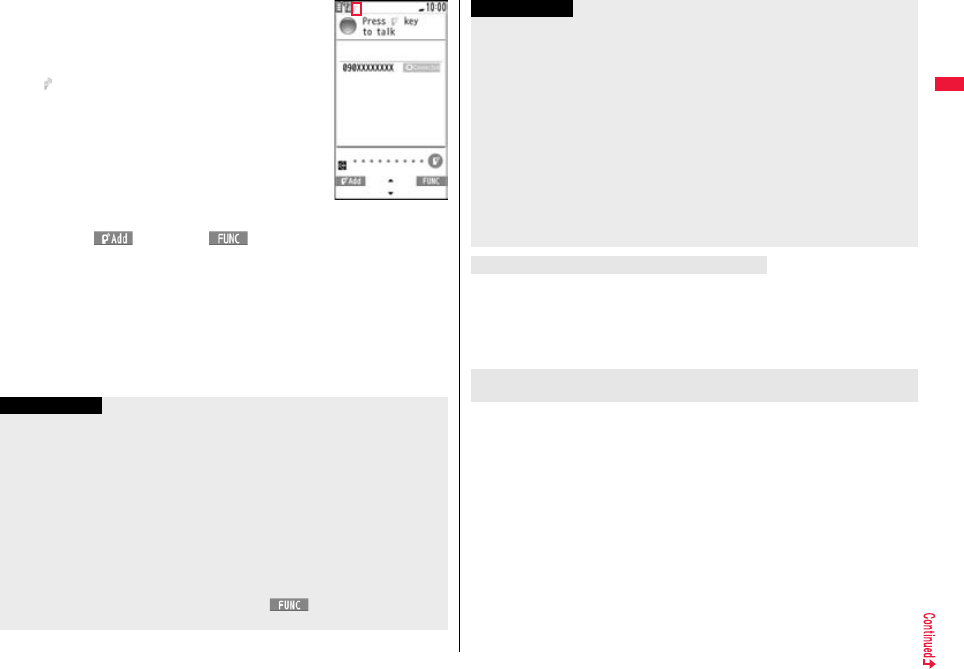
79
Voice/Videophone Calls/PushTalk
2When the other party answers, talk
while pressing p.
When the other party answers, a confirmation tone for
starting communication sounds.
≥“ ” blinks during dialing and lights during
communication.
≥When you get the talker’s right, the talker’s right
obtained tone sounds. The other party hears your voice
only while you are pressing p and having the talker’s
right. When you release p, the talker’s right is
released, and a confirmation tone sounds.
≥You cannot get the talker’s right and an error tone
sounds even if you press p when another member has
it.
≥Press l( ) or press i( ) and select “Add member” to add a
member. Go to step 1 of “Adding a Member during a PushTalk Call” on page 81.
3Press h to end the communication after talking.
A tone to notify the disconnection of communication sounds at the other end.
≥When a call you made is a group call, the PushTalk communication itself
continues even if you press h, and “Disconnected” appears on each member’s
display and a confirmation tone sounds. However, when all the members cannot
communicate due to “Disconnected”, “No PT Func”, etc., the PushTalk
communication itself ends.
Information
≥The talker is charged a communication fee from when he/she presses .p and the
talker’s right obtained tone sounds.
≥You cannot make emergency calls at 110/119/118 from PushTalk.
≥The duration you can talk per talker’s right is limited. The talker’s right release notice
tone sounds before the limited time arrives, and the talker’s right is released. In
addition, the PushTalk communication itself ends when no one gets the talker’s right
in a certain period of time.
≥Just after purchase, Hands-free is automatically activated by “Hands-free w/
PushTalk”. (See page 85) However, Hands-free is deactivated during Manner Mode
regardless of “Hands-free w/ PushTalk”.
≥The FOMA terminal works according to “Setting when closed” if you close it during
communication. You can set also by pressing +i( ) and selecting “Set. when
closed”. (See page 65)
You can use the PushTalk Phonebook or Redial/Dialed Calls/Received Calls to
communicate with multiple members.
While making or receiving a PushTalk group call, the group name and the members in
the group are displayed. Press No to confirm other members. When a call is received
with the other party’s phone number not provided, “User unset” is displayed.
Use Redial/Dialed Calls/Received Calls to make a PushTalk call while the PushTalk
communication continues among other members.
≥If the PushTalk communication has already been finished, your call is dialed as a new
PushTalk call.
≥Whether to notify others of your phone number when you make PushTalk calls follows
the setting for “Activate” of “Caller ID notification” (see page 46). However, when you
set “Notify caller ID” from the Function menu for dialing, or when “Notify”/“Not notify” is
displayed in the detailed Redial/Dialed Call/Received Call display, each of those
settings will work.
≥When you make a PushTalk call with your phone number notified, your phone
number as well as all members’ phone numbers are notified to all members including
added members. When you make a PushTalk call without notifying your phone
number, “User unset” appears in the caller’s and member’s fields on the displays of all
the members including added members. Your phone number is very important
information, so take the utmost care to notify others of it.
≥If you make a PushTalk call during i-mode communication, the i-mode communication
is disconnected.
≥You cannot use PushTalk by Number B of 2in1.
Making/Receiving a PushTalk group call
Re-participating or participating midway in PushTalk
communication
Information
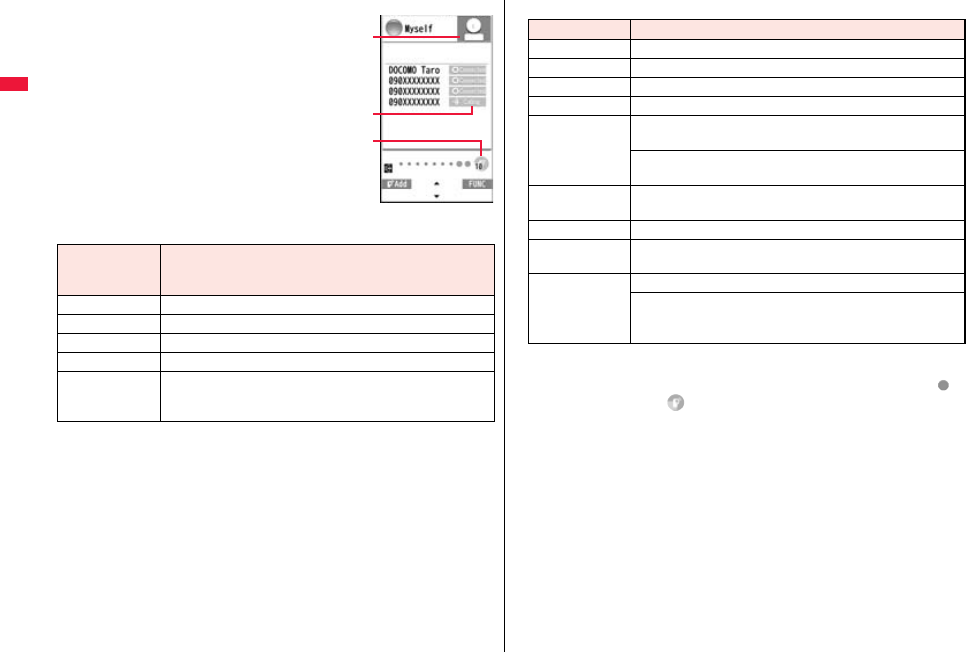
80
Voice/Videophone Calls/PushTalk
■Display while dialing/communicating
1The phone number of the member who has the talker’s
right is displayed, and the state of the talker’s right is
displayed in color of the round icon at the upper left.
When the name of that member, phone number, and
image are stored in the Phonebook, his/her name and
image are displayed. However, when you cannot receive
a member’s information correctly, “?” is displayed.
1
2
3
During group
communication
Color of the
round icon at the
upper left
State of the talker’s rights
Blue Calling
Green You can get the talker’s right.
Blinking in green You have the talker’s right.
Blinking in yellow Another member has the talker’s right.
Blinking in green
and red
The talker’s right will be released automatically in a few seconds
because it has long been retained (A release notice tone
sounds).
2The corresponding state※ of each member is shown.
※
The corresponding states other than “Calling” and “Connected” are displayed only
for the PushTalk communication among three or more members.
3The number of times you have got the talker’s right is the total of the number of “ ”
and the number shown in “ ”. When 999 times are exceeded, the counting is reset
to 0.
Display Corresponding state of members
Calling Calling to the member
Connected Has participated in the PushTalk call.
No PT Func The destination phone does not support PushTalk.
Not avail. The destination phone is out of the service area or turned off.
Busy A voice call, videophone call, or PushTalk communication is in
progress at the member.
i-mode communication is in progress at the member who has
given priority to i-mode by “i-mode arrival act”.
ID Request You made a call without notifying of your caller ID to the member
who has activated “Caller ID request”.
Driving The member has activated Public Mode (Drive Mode).
PublicMode The member has activated Public Mode (Power Off), and is out
of the service area or the power is turned off.
Disconnected You have dialed a non-existent number.
The state is other than above: the member does not answer, has
ended the PushTalk call, or does not use a DOCOMO mobile
phone.
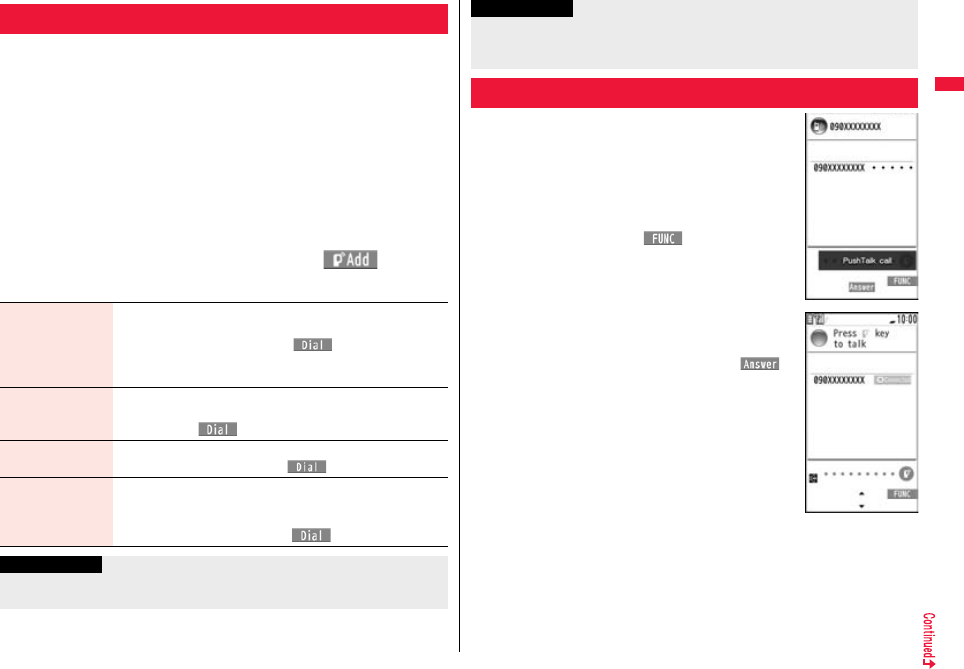
81
Voice/Videophone Calls/PushTalk
You can make a PushTalk call to another member during PushTalk
communication and add that member to the communication.
You can add a person to the members by accessing the PushTalk
Phonebook, Phonebook, or Dialed Calls/Received Calls, or by directly
entering a phone number.
You can add up to five members (including yourself), and can repeat
adding up to that number.
≥Members can be added from the calling end only.
≥You can add even the members who use the PushTalk compatible models which do
not have this function.
≥If you have already made a call to four members, you cannot add a new member
though you can call up a member who has exited the call again.
≥The added members are not stored in Redial/Dialed Calls.
1During PushTalk communication1l()
1Do the following operations.
Adding a Member during a PushTalk Call
View PushTalk PB You can call up a PushTalk Phonebook entry to make a PushTalk
call. (See page 83)
Instead of pressing p, press l( ) to call.
≥Press c to switch between the PushTalk Phonebook list and
PushTalk Group list.
View phonebook You can call up a Phonebook entry to make a PushTalk call.
1Call up a Phonebook entry1Highlight a phone number
and press l().
Direct input You can enter a phone number to make a PushTalk call.
1Enter a phone number1l()
View call records You can call up Dialed Calls/Received Calls to make a PushTalk
call.
1Dialed calls or Received calls1Select a record
1Select a phone number1l()
Information
≥The caller cannot add members if he/she uses a PushTalk compatible model which
does not have this function.
1When a PushTalk call comes in,
“PushTalk call” is displayed, the ring
tone sounds, and the Call/Charging
indicator flickers.
≥“PushTalk group call” is displayed for an incoming
group call.
≥To reject a call, press i( ) during ringing and
select “Call rejection”. You can reject the call also by
pressing h.
2Press p to answer a PushTalk call
1Talk while pressing p.
≥You can answer also by pressing d or Oo()
instead of p.
≥When you get talker’s right, the talker’s right obtained
tone is played back. The other party hears your voice
only while you are pressing p and having the talker’s
right. When you release p, the talker’s right is released
and a confirmation tone sounds.
≥You cannot get the talker’s right and an error tone
sounds, even if you press p when another member
has it.
≥“Setting when opened” and “Record message setting”
become invalid.
≥For a member who uses a PushTalk compatible model which does not have this
function, the members added during PushTalk communication are not shown and a
confirmation tone does not sound.
Receiving a PushTalk Call
Information
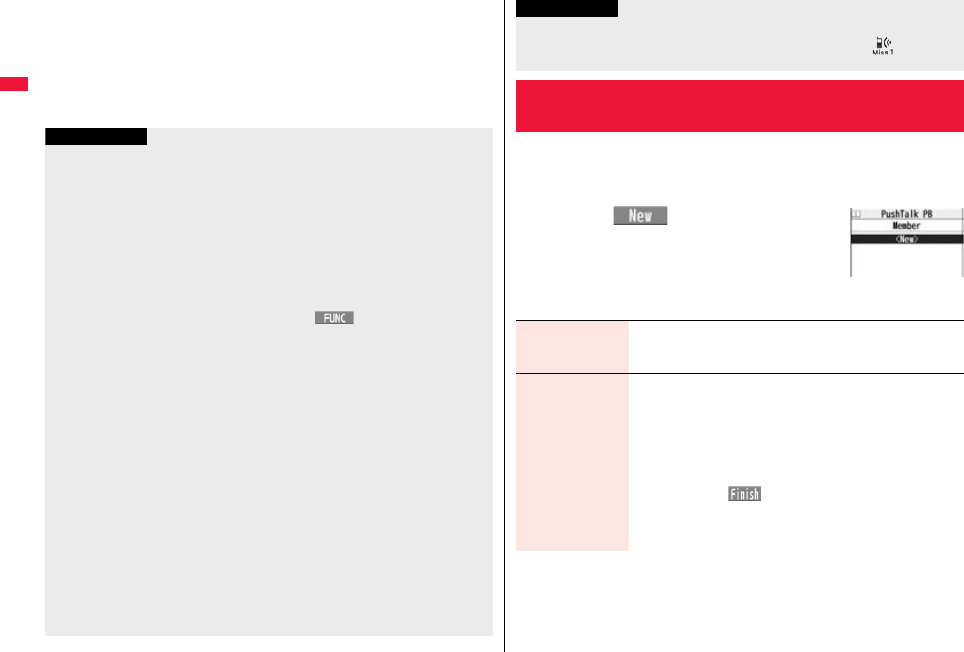
82
Voice/Videophone Calls/PushTalk
3Press h to end the communication after talking.
A tone for confirming the end of communication sounds at the other end.
≥When a call you received is a group call, the PushTalk communication itself
continues even if you press h, and “Disconnected” appears on each member’s
display and a confirmation tone sounds. However, when all the members cannot
communicate due to “Disconnected”, “No PT Func”, etc., the PushTalk
communication itself ends.
Information
≥The talker is charged a communication fee from when he/she presses .p and the
talker’s right obtained tone sounds.
≥The duration you can talk per talker’s right is limited. The talker’s right release notice
tone sounds before the limited time arrives, and the talker’s right is released. In
addition, the PushTalk communication itself ends when no one gets the talker’s right
in a certain period of time.
≥Just after purchase, Hands-free is automatically activated by “Hands-free w/
PushTalk”. (See page 85) However, Hands-free is deactivated during Manner Mode
regardless of “Hands-free w/ PushTalk”.
≥The FOMA terminal works according to “Setting when closed” if you close it during
communication. You can set also by pressing +i( ) and selecting “Set. when
closed”. (See page 65)
≥You cannot use “On hold” or “Holding” for PushTalk.
≥When you received a PushTalk call from the phone number you set for “Call rejection”
or “Reject unknown”, “Disconnected” is replied. When you have activated “Caller ID
request”, “ID Request” is replied.
≥A PushTalk call that comes in during a voice call, a PushTalk call that comes in during
Public Mode (Drive Mode), and a voice call (when “PushTalk arrival act” is set to other
than “Answer”), a videophone call, data communication, or a PushTalk call that
comes in during PushTalk communication are recorded as missed calls in Received
Calls.
≥A PushTalk call that comes in during a videophone call or during data communication
does not work and is not recorded in Received Calls.
≥After you finish PushTalk communication or when you cannot answer to a PushTalk
call, you can use a received call record to make a PushTalk call and to re-participate
or participate midway in the communication so long as the PushTalk communication
continues among other members. If the PushTalk communication among other
members has already been finished, your call is dialed as a new PushTalk call.
≥When a caller adds members during PushTalk communication, the added members
are not stored in Received Calls.
From the items stored in a FOMA terminal’s Phonebook entry, you need
to store a name (reading) and a phone number in the PushTalk
Phonebook. You can store up to 1,000 entries in the PushTalk
Phonebook.
1p1m()
1Do the following operations.
≥You can store also by selecting <New>.
≥If you store multiple phone numbers from a Phonebook
entry, the phone number previously stored in the
PushTalk Phonebook is overwritten.
≥See page 86 for how to respond to the PushTalk call during i-mode communication.
≥When a PushTalk call comes in during Lock All or Omakase Lock, “ ” appears
after the lock is released.
<Store in PushTalk Phonebook>
Adding Entries to PushTalk Phonebook
Information
PushTalk
Phonebook list
View phonebook You can access an entry already stored in the FOMA terminal’s
Phonebook and store it in the PushTalk Phonebook.
1Call up a Phonebook entry1Select a phone number1YES
Direct input You can store the entry in the PushTalk Phonebook after storing it
in the FOMA terminal’s Phonebook.
1Phone1Select a storing method.
New . . . Go to step 2 on page 88.
Add . . . Go to step 3 of “Storing Displayed Phone Number/Mail
Address in Phonebook” on page 93.
≥When multiple phone numbers are stored in a Phonebook
entry, press l( ) and select the phone number you
want to store in the PushTalk Phonebook. The “★” mark is
added to the phone number that has already been stored in the
PushTalk Phonebook.
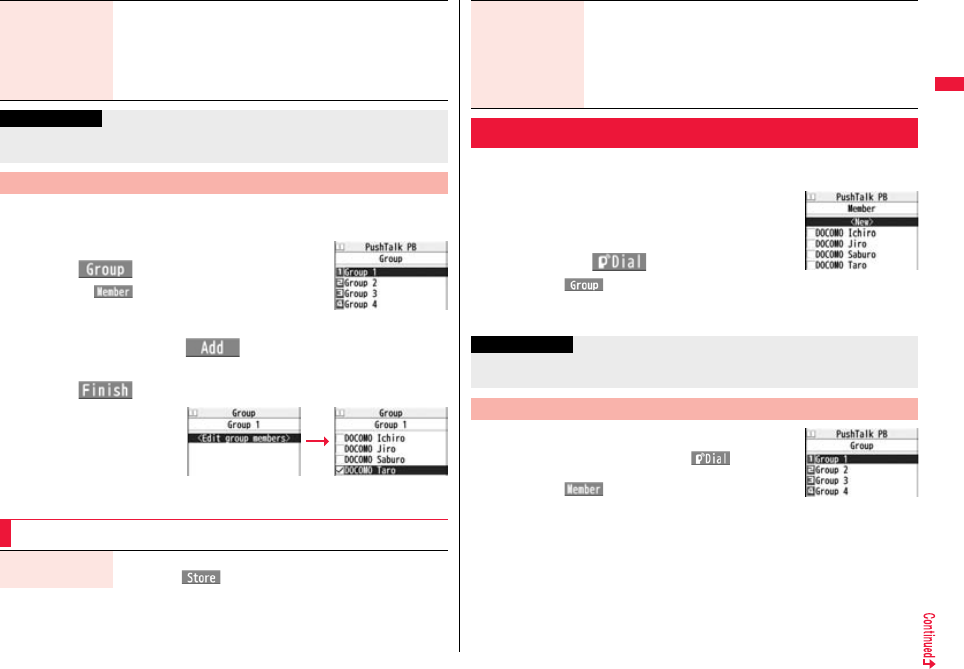
83
Voice/Videophone Calls/PushTalk
You can store PushTalk Phonebook entries in groups. You can store up
to 19 members per group and create up to 10 groups.
1PushTalk Phonebook list
1c()
≥Press c( ) to show the PushTalk Phonebook
list.
2Select a group1m
()
1Put a check mark for members to be stored
1l()
≥You can store also by
selecting <Edit group
members> from the Group
Member list.
View call records You can access a dialed call record or received call record to
store it in the PushTalk Phonebook. You cannot store in the
PushTalk Phonebook from the dialed/received call record of the
party who is not stored in the FOMA terminal’s Phonebook.
1Dialed calls or Received calls1Select a record
1Select a phone number1YES
Information
≥In the PushTalk Phonebook, you cannot store the Phonebook entries set to B by
Phonebook 2in1 Setting.
Store in Group
PushTalk Group list
Group Member list Group Member
Selection display
Function Menu of the Group Member Selection Display
Members to store You can display only members applied with a check mark.
≥Press Oo( ) to store the members to the group.
You can make a group call to up to four members using the PushTalk
Phonebook or PushTalk group.
1PushTalk Phonebook list
1Put a check mark for members you
want to make a call to
1p or l()
≥Press c( ) to show the PushTalk Group list.
≥When you do not check any members, the call is made
to the highlighted member.
1PushTalk Group list1Select a group.
≥Select a group and press p or l() to make a
call to all the members in the group.
≥Press c( ) to show the PushTalk Phonebook
list.
Search 1Select a search method.
Reading? . . See page 94.
Group? . . . . See page 94.
1Select a member.
You can display the Group Member Selection display with the
searched members selected.
Making a Call from PushTalk Phonebook
PushTalk
Phonebook list
Information
≥When all the members cannot communicate due to “Disconnected”, “No PT Func”,
etc., the PushTalk communication ends.
Make a Call from PushTalk Group
PushTalk Group list
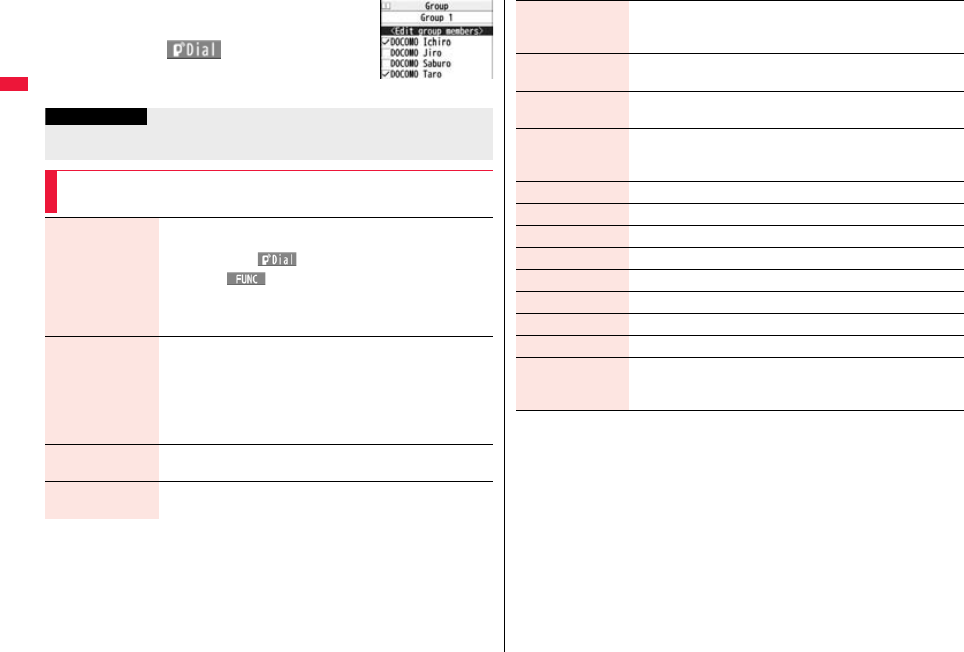
84
Voice/Videophone Calls/PushTalk
2Put a check mark for members you
want to make a call to
1p or l()
≥When you do not check any members, the call is made
to the highlighted member.
Group Member list
Information
≥When five or more members are stored in a group, you cannot make a call to all the
members by selecting the group.
Function Menu of the PushTalk Phonebook List/PushTalk
Group List/Group Member List
Members to call When the PushTalk Phonebook list or Group Member list is
displayed, you can display the checked members only.
≥Press p or Oo( ) to make a PushTalk call.
≥Press i( ) to select “Notify caller ID” and then you can
select whether to notify your phone number. When “Cancel
prefix” is selected, the FOMA terminal works according to the
setting by “Caller ID notification”.
Search PushTalk
PB
[Phonebook list only]
1Select a search method.
Reading? . . . See page 94.
Group?. . . . . See page 94.
1Select a member.
You can display the PushTalk Phonebook list with the searched
members selected.
Store in P-Talk PB
[Phonebook list only]
See page 82.
DEL from P-Talk PB
[Phonebook list only]
See page 85.
Edit group members
[Group list/Member
list]
You can edit the members in the group.
Go to step 2 on page 83.
Edit group name
[Group list only]
1Enter a group name.
≥You can enter up to 16 full-pitch/32 half-pitch characters.
DEL from PT group
[Group list only]
See page 85.
DEL group
members
[Member list only]
See page 85.
Sound setting See page 85.
Vibration setting See page 85.
Auto answer set. See page 85.
Ring time setting See page 85.
Hands-Free See page 85.
Set. when closed See page 65.
i-mode arrival act See page 86.
P-Talk arrival act See page 85.
Network connection You can connect to the network to use PushTalkPlus. This is
available only when you have singed up for PushTalkPlus.
(See page 78)
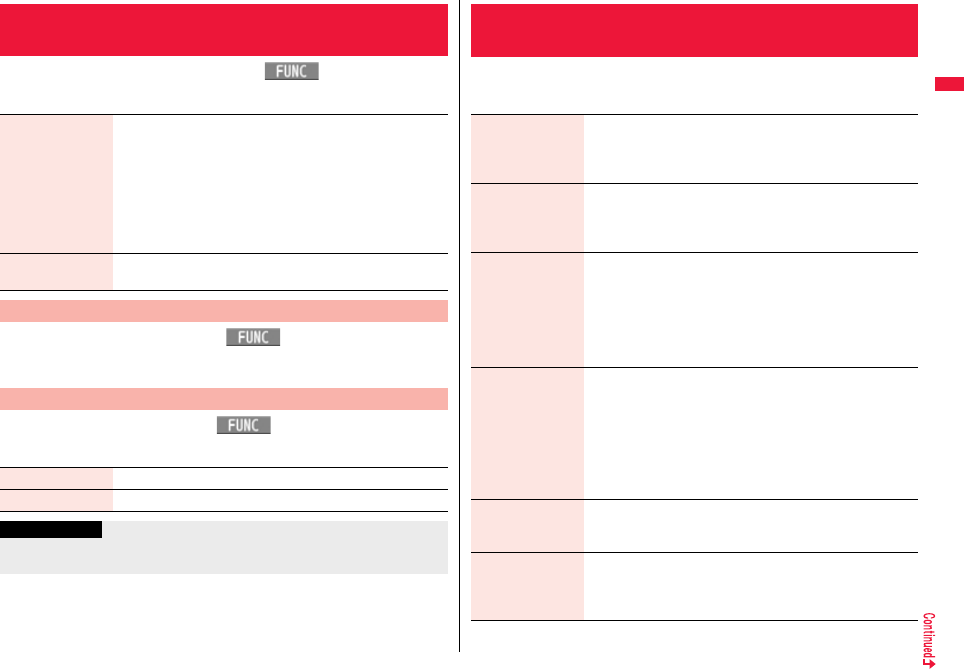
85
Voice/Videophone Calls/PushTalk
1PushTalk Phonebook list1i()
1DEL from P-Talk PB1Do the following operations.
1PushTalk Group list1i()1DEL from PT group
1YES
1Group Member list1i()1DEL group members
1Do the following operations.
<Delete from PushTalk Phonebook>
Deleting PushTalk Phonebook Entries
Delete this 1Select a deleting method.
DEL from P-Talk PB
. . . Deletes an entry in the PushTalk Phonebook only. Does not
delete the entry in the FOMA terminal’s Phonebook.
DEL from all PBs
. . . Deletes an entry in both the PushTalk Phonebook and
FOMA terminal’s Phonebook.
1YES
Delete all 1Enter your Terminal Security Code1YES
≥The FOMA terminal’s Phonebook entries are not deleted.
Delete from PushTalk Group
Delete Group Members
Delete this 1YES
Delete all 1Enter your Terminal Security Code1YES
Information
≥Even when you delete PushTalk groups or group members, the PushTalk Phonebook
entries and FOMA terminal’s Phonebook entries are not deleted.
1m1Set./Service1PushTalk
1Do the following operations.
Setting for Making/Receiving a PushTalk
Call
Auto answer setting
1Select an item.
ON . . . . . Automatically answers immediately after receiving
regardless of “Ring time setting”.
OFF . . . . Does not answer automatically.
Ring time setting 1Enter a ring time (seconds).
≥Enter two digits from “01” through “60”.
≥“Disconnected” is displayed at the other end after the ring time
has elapsed.
Hands-free w/
PushTalk
You can set whether to hear the other party’s voice from the
speaker or from the earpiece for when PushTalk communication
starts.
1ON or OFF
≥See page 61 for how the FOMA terminal works while
Hands-free is activated and how to switch to Hands-free during
communication.
PushTalk arrival act 1Select an item.
Voice mail . . . . . . . . Connects an incoming voice call to the
Voice Mail Service Center.
Call forwarding . . . Forwards an incoming voice call to the
forwarding destination.
Call rejection . . . . . Rejects an incoming voice call and does not
answer.
Answer . . . . . . . . . . Shows the Voice Call Receiving display.
Sound setting You can set a pattern for the confirmation tones which sound
during PushTalk communication.
1Select a pattern.
Vibration setting You can set whether to be notified by vibration for when you try to
get the talker’s right or when a member’s state changes to
“Connected”.
1ON or OFF
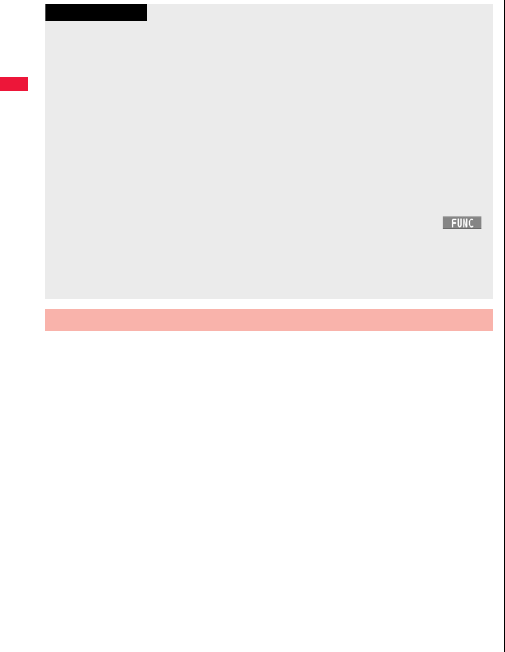
86
Voice/Videophone Calls/PushTalk
You can set whether to show the PushTalk Call Receiving display for
when a PushTalk call comes in during i-mode communication.
1i1
i-mode settings
1
i-mode arrival act
1
Select an item.
PushTalk preferred. . . . Ends i-mode communication and brings up the PushTalk
Call Receiving display.
i-mode preferred . . . . . . Rejects receiving a PushTalk call and continues i-mode
communication. The call is not recorded in Received
Calls.
Information
<Auto answer setting>
≥When you set to “ON”, calls are automatically answered even when the FOMA
terminal is closed regardless of “Setting when closed”.
≥When you set to “ON”, calls are automatically answered after switching to Hands-free
regardless of “Hands-free w/ PushTalk”. However, the FOMA terminal works following
the setting of “Hands-free w/ PushTalk” if you open the FOMA terminal after you
answer a call with the FOMA terminal closed.
≥When you set to “ON”, the ring tone, vibrator, Call/Charging indicator, and backlight
do not work. Calls are not automatically answered during Manner Mode.
<PushTalk arrival act>
≥If you press -h for an incoming voice call while “Answer” is set, the Call Receiving
display appears after you finish the PushTalk communication, and then you can
answer the voice call. To continue the PushTalk communication, press +i()
and select “Call rejection”, “Call forwarding”, or “Voice mail”.
<Sound setting>
≥In the “Simple” mode, some confirmation tones (talking right obtained tone, etc.)
during PushTalk communication become silent.
i-mode Arrival Act

87
Phonebook
Phonebooks Available for FOMA Terminal . . . . . . . . . . . . . . . . . 88
Storing Phonebook Entries . . . . . . . . . . . .<Add to Phonebook> 88
Storing Displayed Phone Number/Mail Address in Phonebook
. . . . . . . . . . . . . . . . . . . . . . . . . . . . . . . . . . . . . . . . . . . . . . . . . . . . . 92
Setting Groups . . . . . . . . . . . . . . . . . . . . . . . . . .<Group Setting> 93
Dialing from Phonebooks . . . . . . . . . . . . <Search Phonebook> 94
Editing Phonebook Entries . . . . . . . . . . . . . . <Edit Phonebook> 98
Deleting Phonebook Entries . . . . . . . . . . . . . . . . .<Delete Data> 99
Checking Phonebook Storage Status . . . . <No. of Phonebook> 99
Making a Call with a Few Keys Operation . . . . . <2-touch Dial> 99
Accessing Phonebook Entries by Voice . . . . . . . . <Voice Dial> 100
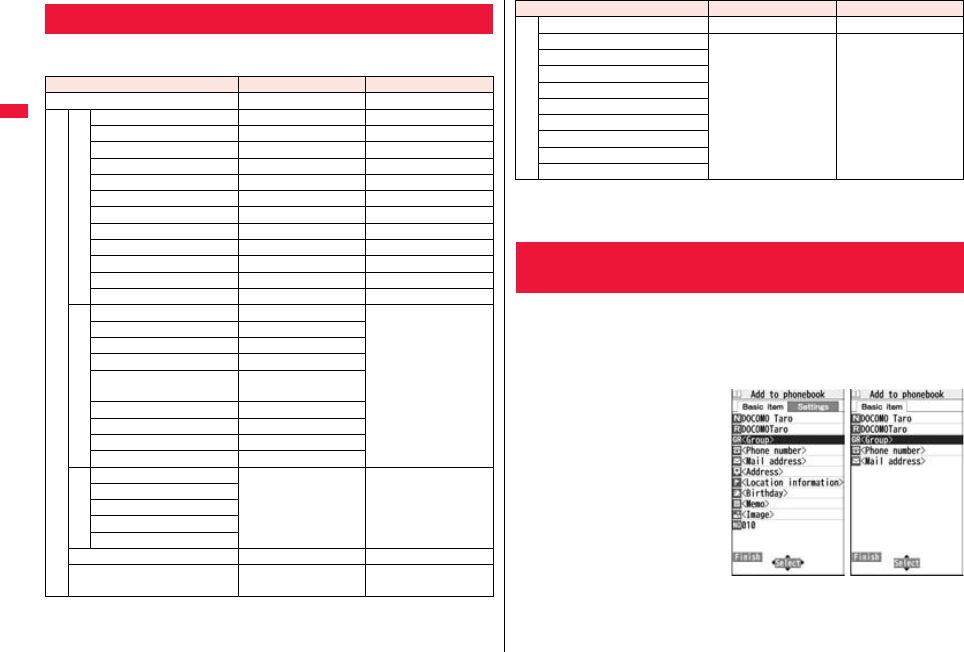
88
Phonebook
You can use two types of Phonebook, namely the Phonebook in the
FOMA terminal itself, and the Phonebook on the UIM.
Phonebooks Available for FOMA Terminal
FOMA terminal UIM
Number of entries 1,000 entries 50 entries
Contents of Phonebook
Basic item
Name (Reading) ○○
Group 19 groups 10 groups
Phone number 4 phone numbers 1 phone number
Phone number icon ○—
Mail address 3 mail addresses 1 mail address
Mail address icon ○—
Address ○—
Location information ○—
Birthday ○—
Memo ○—
Image 100 images —
Memory No. From 000 to 999 —
Setting item
Ring tone ○
—
Vibrator ○
Illumination ○
Picture ○
Chara-den 100 Chara-den
images
Mail ring tone ○
Mail vibrator ○
Mail illumination ○
Answer message ○
Restrictions
Restrict dialing
○—
Call rejection
Call acceptance
Call forwarding
Voice mail
Secret code ○—
Storage in Secret Mode or
Secret Data Only ○—
○: Can be stored. —: Cannot be stored.
≥You can set your UIM into another FOMA terminal and use the UIM Phonebook
entries.
You can store Phonebook entries in the FOMA terminal (Phone) or on the
UIM.
1Xo(for at least one second)1Phone or UIM
The Edit Name display appears. Go to step 2 and enter a name.
2Do the following
operations.
≥You can press No to switch
between the “Basic item” tab and
“Settings” tab for the FOMA
terminal’s Phonebook.
Contents of Group
Name ○○
Ring tone
○—
Vibrator
Illumination
Picture
Chara-den
Mail ring tone
Mail vibrator
Mail illumination
Answer message
<Add to Phonebook>
Storing Phonebook Entries
FOMA terminal UIM
For the FOMA
terminal
For the UIM
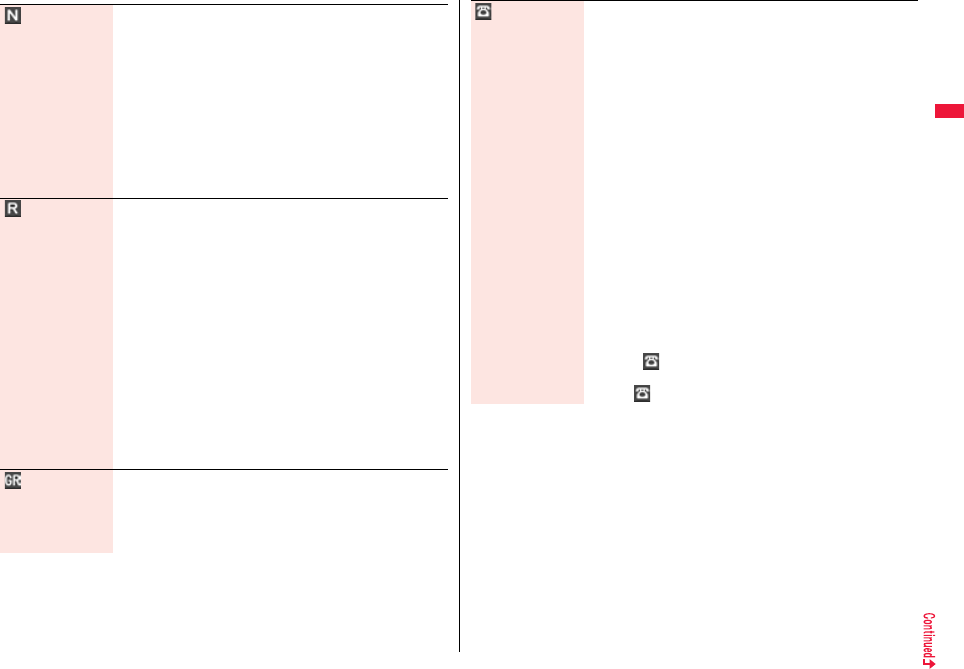
89
Phonebook
Name You can enter the name of the person or company in kanji,
hiragana, katakana, alphabetic characters, or numerals.
1Enter a name.
≥For the FOMA terminal, you can enter up to 16 full-pitch/32
half-pitch characters. You can enter pictograms and symbols as
well.
≥For the UIM, you can enter up to 10 full-pitch characters/21
half-pitch alphanumeric characters. (Half-pitch katakana
characters cannot be entered.) When the entry contains both
full-pitch and half-pitch characters, you can store up to 10
characters from the beginning regardless of full-pitch or
half-pitch characters.
Reading You can enter the reading in half-pitch katakana, alphabetic
characters, or numerals.
1Enter a reading.
≥For the FOMA terminal, you can enter up to 32 half-pitch
characters. You can enter half-pitch symbols as well.
≥For the UIM, you can enter up to 12 full-pitch characters/25
half-pitch alphanumeric characters. (Half-pitch katakana
characters cannot be entered.) When the entry contains both
full-pitch and half-pitch characters, you can store up to 12
characters from the beginning regardless of full-pitch or
half-pitch characters.
≥If the displayed reading is acceptable, you do not need to edit it.
However, depending on the characters entered for names or
entering method, they are not reflected in the reading.
≥
If you enter “
ゎ
(reduced size)” or “
ヮ
(reduced size)” for a name,
“
ワ
(half-pitch, regular size)” (for the FOMA terminal) and “
ワ
(regular size)” (for the UIM) are displayed in the reading field.
Group In the FOMA terminal, 19 groups are available. On the UIM, 10
groups are available.
1Select a group.
≥When the storage is completed with no group selected, the
Phonebook entry is stored in “No setting”.
Phone number You can store up to four phone numbers per Phonebook entry in
the FOMA terminal. You can set an icon for each phone number
to categorize mobile phone numbers, office phone numbers, and
so on.
You can store only one phone number per Phonebook entry on
the UIM.
1Enter a phone number.
≥Enter from the city code for the phone numbers.
≥You can enter up to 26 digits. However, you can enter up to 20
digits for blue UIMs.
≥Press and hold a for at least one second to insert a pause (p)
into the phone number you store. However, you cannot insert
the pause (p) to the beginning of phone number or insert it
consecutively. The pause (p) inserted to the end of phone
number is not stored.
≥If you insert “:” in the middle of a phone number, you cannot
make a call. However, the phone number is recorded in Redial
or Dialed Calls.
≥You can store the phone number which includes “#” such as
that for information service as well.
1Select an icon.
≥If you have stored a phone number in the FOMA terminal,
another “ <Phone number>” will appear in the
Add-to-Phonebook display. To store another phone number,
select “ <Phone number>”.
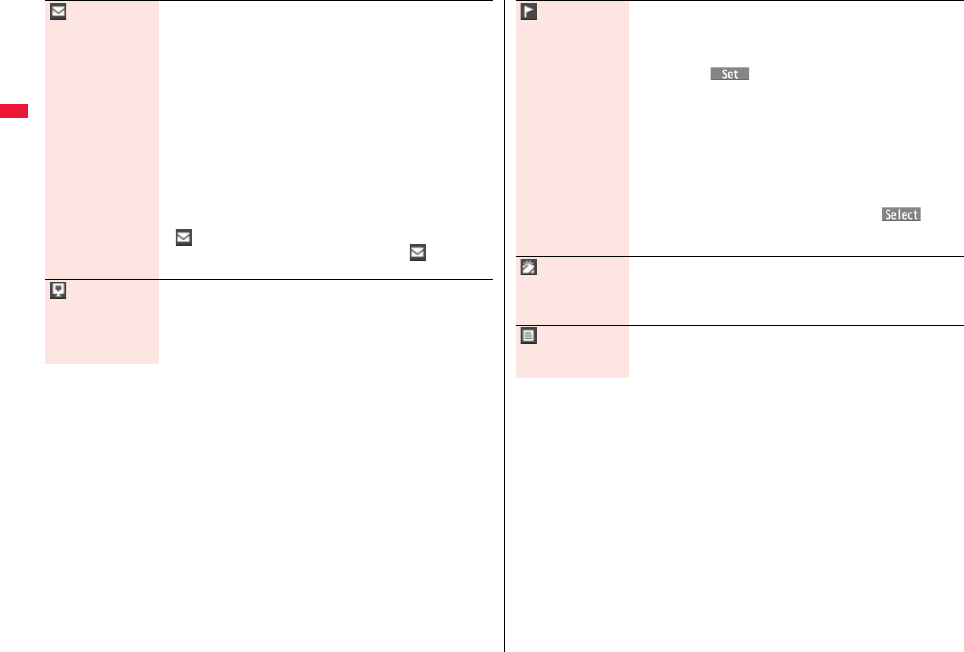
90
Phonebook
Mail address You can store up to three mail addresses per Phonebook entry in
the FOMA terminal. You can set an icon for each mail address to
categorize mobile phone addresses, home addresses, and so on.
You can store only one mail address per Phonebook entry on the
UIM.
1Enter a mail address.
≥The mail address can consist of up to 50 half-pitch alphabets,
numerals or symbol characters.
≥When the mail address is “phone number@docomo.ne.jp”,
store the phone number only.
≥For the FOMA terminal, you can set a secret code as well. (See
page 98)
1Select an icon.
≥If you have stored a mail address in the FOMA terminal, another
“ <Mail address>” will appear in the Add-to-Phonebook
display. To store another mail address, select “ <Mail
address>”.
Address 1Enter a ZIP code1Enter a postal address.
≥You can enter up to 7 digits for the zip code.
≥You can enter up to 50 full-pitch/100 half-pitch characters for the
postal address. Further, you can enter pictograms as well.
≥You cannot enter “〒” or “-” (hyphen) in the zip code.
Location
information
1Select an item.
By position loc.
. . . .Measures the current location (see page 326) and store the
location information. After checking the location information,
press Oo().
From loc. history
. . . .Select a piece of location information from Location History
(see page 335) and store it.
Attach from image
. . . .Stores the location information from an image. Select a
folder, then the image.
From own number
. . . .Stores the location information from “Own number”. Enter
your Terminal Security Code and press Oo().
≥To delete the stored location information, select “Delete location
info”.
Birthday 1Enter a birthday.
≥You can enter the birthday from January 1, 1800 through
December 31, 2099.
≥You can check the birthday from Schedule. (See page 408)
Memo 1Enter a memo.
≥You can enter up to 100 full-pitch/200 half-pitch characters.
Further, you can enter pictograms as well.
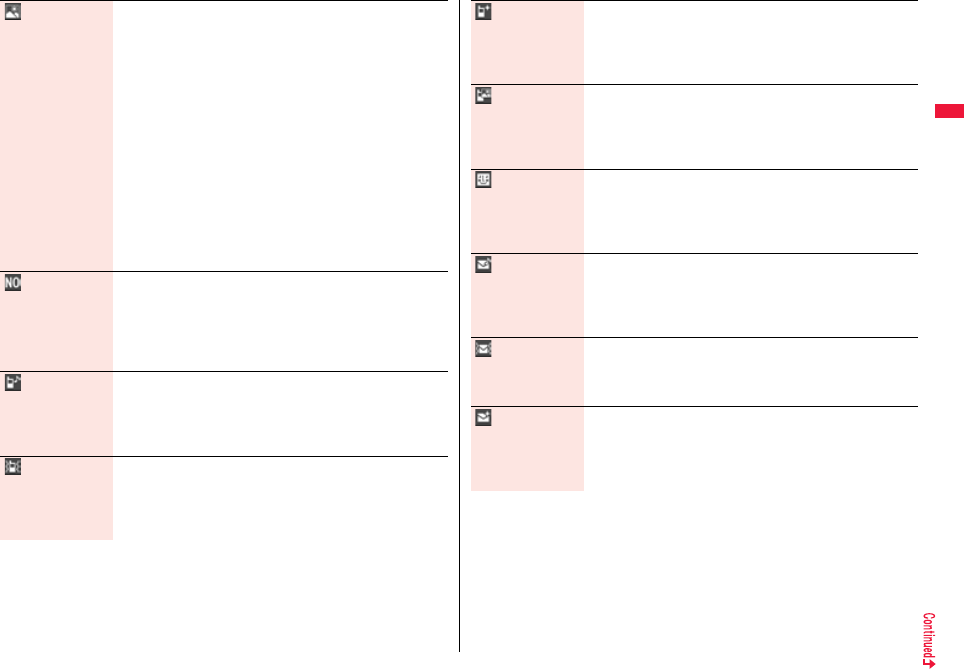
91
Phonebook
Image The stored still image is displayed when you call up the
Phonebook entry.
1Select an item.
Select image . . . You can store a still image in Data Box.
Shoot image. . . . You can store the shot still image.
Perform step 2 through step 3 on page 234.
≥To release the stored still image, select “Release image”.
≥The size of a still image you can store is Stand-by (480 x 854) or
smaller and up to 300 Kbytes in JPEG format or GIF format.
≥If you store a still image larger than 72 x 54 dots, it is displayed
shrunk on the detailed Phonebook display.
≥If you store a still image larger than 240 x 180 dots, it is
displayed shrunk on the Call Receiving display.
≥When “Disp. PH-book image” is set to “ON”, the stored still
image is displayed for an incoming call. However, when another
image is stored for “Picture”, that image is preferentially
displayed for the incoming call.
Memory No. 1Enter a memory number.
≥Enter a three-digit number of “000” through “999”.
≥The lowest empty memory number “010” through “999” is
entered in advance.
If “010” through “999” are all occupied, the lowest empty
memory number from “000” through “009” is entered.
Ring tone You can set a ring tone for when a voice call or videophone call
comes in from the person stored in the Phonebook.
1Select ring tone
Go to step 2 on page 104.
≥To release the stored ring tone, select “Release ring tone”.
Vibrator You can set a vibration pattern for when a voice call or
videophone call comes in from the person stored in the
Phonebook.
1Select vibrator1Select a vibration pattern.
≥To release the stored vibrator, select “Release vibrator”.
Illumination You can set an illumination pattern for when a voice call or
videophone call comes in from the person stored in the
Phonebook.
1Select illumination1Select an item.
≥To release the stored illumination, select “Release illumination”.
Picture You can set an image to be displayed for when a call comes in
from the person stored in the Phonebook.
1Select picture1Select a type of image1Select a folder
1Select an image.
≥To release the stored image, select “Release picture”.
Chara-den The stored Chara-den image is displayed as a substitute image
for videophone calls with the person stored in the Phonebook.
1Select Chara-den1Select a Chara-den image.
≥To release the stored Chara-den image, select “Release
Chara-den”.
Mail ring tone You can set a ring tone for when a mail message comes in from
the person stored in the Phonebook.
1Select ring tone
Go to step 2 on page 104.
≥To release the stored mail ring tone, select “Release ring tone”.
Mail vibrator You can set a vibration pattern for when a mail message comes
in from the person stored in the Phonebook.
1Select vibrator1Select a vibration pattern.
≥To release the stored mail vibrator, select “Release vibrator”.
Mail illumination You can set an illumination pattern for when a mail message
comes in from the person stored in the Phonebook.
1Select illumination1Select an item.
≥To release the stored mail illumination, select “Release
illumination”.
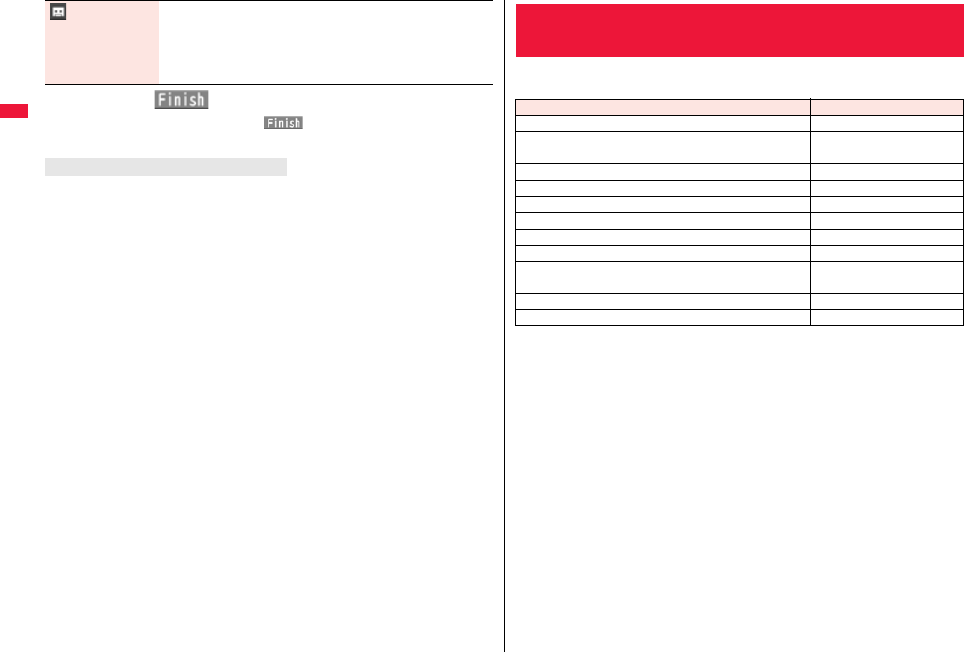
92
Phonebook
3Press l().
≥If you have not entered any name, “ ” is not displayed and you cannot
store the entry.
When the low battery alarm sounds
The Phonebook entry you are editing is saved automatically. The confirmation display
appears asking whether to resume editing when you continue editing after charging the
battery or when you operate step 1 on page 88 and select the storage location for the
interrupted Phonebook entry after changing to a charged battery.
Recall . . . You can resume editing the Phonebook entry.
New . . . . You can edit a new Phonebook entry. In this case, the interrupted data is
retained. If you execute “Add to phonebook” after storing the new Phonebook
entry, the confirmation display appears again.
≥Only the most recently interrupted entry is retained.
≥If you resume editing the data but then cancel editing without storing it, that data will be
abandoned. Once you recall the data, be sure to store it.
If you receive a call or mail
You can respond it leaving the edited data as it is, thanks to the Multitask function.
To return to the Phonebook Edit display, press and hold x for at least one second to
switch the menu. You can return to the Phonebook Edit display also by ending the call or
mail function.
Answer
message
You can set an answer message for Record Message by
Phonebook entry.
1Select answer message1Select an answer message.
≥To release the stored answer message, select “Release answer
message”.
Phonebook entries while editing
You can store the displayed or selected phone number, mail address,
and still image in the FOMA terminal’s or UIM’s Phonebook.
Storing Displayed Phone Number/Mail
Address in Phonebook
Operation Storable items
While a phone number is entered Phone number
While a redial item, dialed call record, or received call
record is displayed Phone number
While Sent Address or Received Address is displayed Phone number/Mail address
While a site or screen memo is displayed Phone number/Mail address
While the text of Message R/F or mail is displayed Phone number/Mail address
While the data scanned by Bar Code Reader is displayed Phone number/Mail address
While a ToruCa file is displayed Phone number/Mail address
While your current location is displayed Location information
While the location history is displayed Location information/
Phone number/Mail address
While a registered LCS client is displayed Name/Phone number
While the Still Image list or a still image is displayed Still image
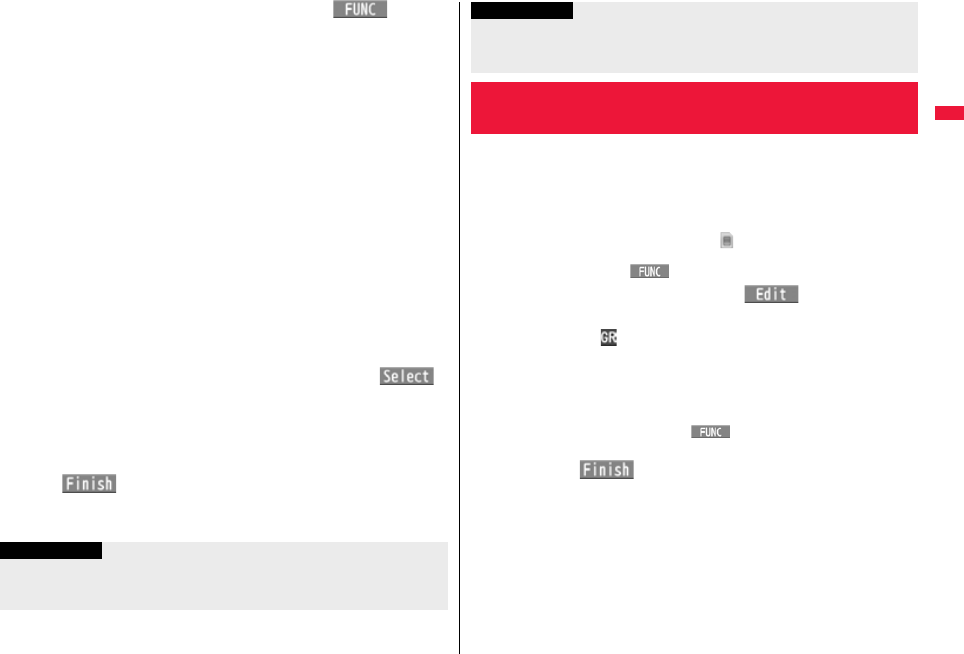
93
Phonebook
1Call up/Select an item to be stored1i()
1Add to phonebook
≥When you operate from the detailed mail display, select “Store” from the Function
menu and then select “Add to phonebook”.
≥To store the address of the sender (or of another recipient of simultaneous mail)
of the received mail or the destination address of the sent mail into the
Phonebook, select “Store” from the Function menu and then select “Store
address”. If the addresses of the sender and another recipient of simultaneous
mail are found or the multiple destination addresses are found, select a mail
address or phone number to be stored.
≥To store a still image in the Phonebook, select “Set display” from the Function
menu and then select “Phonebook”.
≥When “Add to phonebook” is displayed on the Scanned Code Result display for
Bar Code Reader, select “Add to phonebook”; then other information in the
scanned code besides the phone number or mail address is entered into each
field.
2Phone or UIM1Select a storing method.
New . . . Go to step 2 on page 88.
Add . . . Adds data to the existing Phonebook entry. When storing data on the
UIM, “Overwrite” is displayed.
3Select a search method1Search the Phonebook
1Select a Phonebook entry to be stored1Oo()
The phone number or mail address is entered automatically.
≥See step 2 on page 88 to edit other items in the Phonebook entry.
≥When you store into the FOMA terminal’s Phonebook, you can remain the
original entry and store a new entry into a different location by changing the
memory number.
4l()1YES
≥If you store the entry in the UIM Phonebook, select “Overwrite” to overwrite the
original entry, or select “Add” to store it as a new entry.
Information
≥The Phonebook entry does not store the information of “Notify caller ID” included in
Redial/Dialed Calls. To set Caller ID Notification, add “186”/“184” to the phone
number and store it.
You can utilize the Phonebook by sorting the entries by group such as
“Company” or “Friend”, or by your interest such as “Baseball” or
“Ceramic art”. You can set a ring tone, vibration pattern, or illumination
by group.
1m1Phonebook1Group setting
≥The groups on the UIM are indicated by “ ”.
≥To reset the group names and respective settings by group, which have already
been stored, press i( ), select “Reset group”, and then select “YES”.
2Highlight a group and press l()
1Select an item to be set1Set the contents.
≥When you select “ Group name”, enter a group name. You can store up to 10
full-pitch/21 half-pitch characters. However, you can store only up to 10
characters (regardless of full-pitch or half-pitch characters) when you enter both
full-pitch and half-pitch characters for a UIM group name.
≥See step 2 on page 88 for the operations of the other items. However, you cannot
set for groups on the UIM.
≥Select a stored group, or press i( ) and select “Check setting” to check
its settings. However, you cannot check the settings of the groups on the UIM.
3Press l().
≥Characters that cannot be stored may be replaced by spaces or deleted, and then
stored.
≥You may not be able to store the information from some sites into the Phonebook.
<Group Setting>
Setting Groups
Information
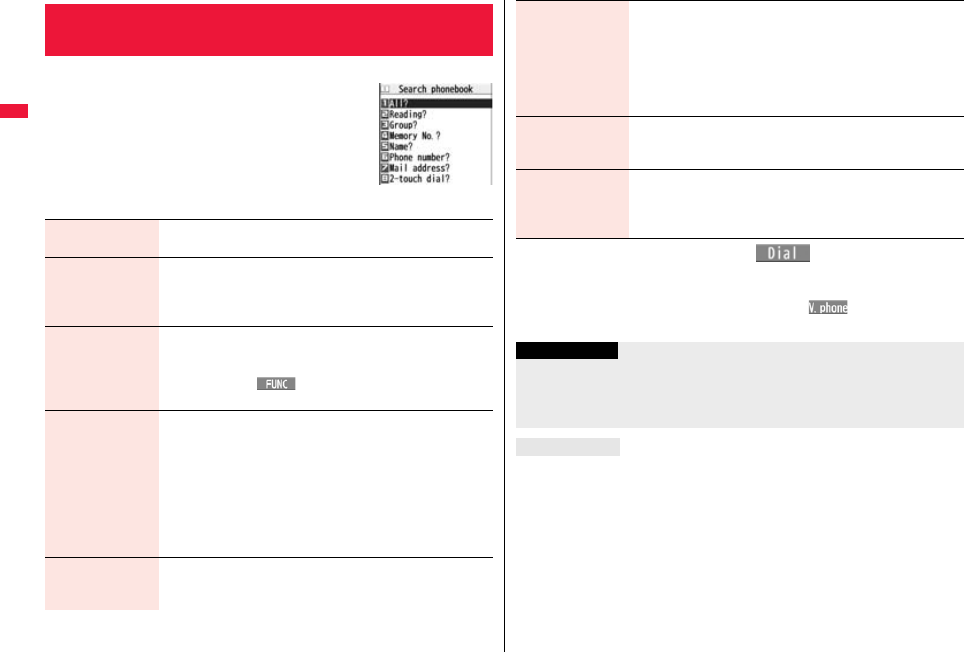
94
Phonebook
You can retrieve stored Phonebook entries by eight search methods.
1Xo1Do the following operations.
≥The display for the same search method as the
previous one appears once you have carried out a
search. Press r to show the Search Phonebook
display.
<Search Phonebook>
Dialing from Phonebooks
Search Phonebook
display
All? You can show all Phonebook entries.
≥
The tabs appear on the top of the Phonebook list. (See page 95)
Reading? You can enter the reading of the other party’s name from the first
character and search. You do not need to enter the full reading.
1Enter a part of the reading1Bo
≥
The tabs appear on the top of the Phonebook list. (See page 95)
Group? You can show Phonebook entries stored in a specified group.
1Select a group.
≥
The tabs appear on the top of the Phonebook list. (See page 95)
≥If you press i( ) on the Group list, the Function menu
for “Group setting” is displayed.
Memory No.?
[FOMA terminal only]
You can search for the entry by the memory number assigned
when it was stored in the Phonebook.
1Enter the memory number.
≥Enter from “000” through “999” in three digits.
≥
The tabs appear on the top of the Phonebook list. (See page 95)
≥From the Stand-by display, you can press d and then press
Bo to display the Memory No. Dial display. From there you can
make a voice call by entering the memory number of the phone
number.
Name? You can enter the other party’s name from the first character and
search. You do not need to enter the full name.
1Enter a part of the name1Bo
2Select an entry1d or Oo()
≥When the entry contains multiple phone numbers, or when you searched by “Mail
address?”, press Mo from the detailed display to select a phone number.
≥You can make a videophone call by pressing l( ) or PushTalk call by
pressing p.
The Phonebook entries are searched in the order of readings you entered for storing, as
follows:
“Space at the beginning of the reading”
→
“Japanese syllabary (
ア、イ、ウ、エ、オ、... ン
)”
→
“Alphabet (A, a, B, b, ...Z, z)”
→
“Numerals (0 through 9)”
→
“Symbols”
→
“No reading”.
For “All?” and “Reading?”, searching is done in the following order:
“Japanese syllabary (
ア、イ、ウ、エ、オ、... ン
)”
→
“Alphabet (A, a, B, b, ...Z, z)”
→
“Space
at the beginning of the reading”
→
“Numerals (0 through 9)”
→
“Symbols”
→
“No reading”.
※The Memory No. Search searches in the order of the memory numbers.
Phone number? You can enter a part of the other party’s phone number and
search. You can search for the entry even from the middle of
phone number.
1Enter a part of the phone number1Bo
≥You can display the Phonebook list also by entering a part of
the phone number from the Stand-by display or the “Talking”
display, and pressing Bo.
Mail address?
You can enter a part of the other party’s mail address and search.
You can search for the entry even from the middle of mail address.
1Enter a part of the mail address1Bo
2-touch dial?
[FOMA terminal only]
You can show the list of Phonebook entries in memory number
000 through 009.
≥Phonebook entries not yet stored or being set with secret are
displayed as <−−−>.
Information
≥In a search method other than “Group?” and “2-touch dial?”, enter nothing and press
*Bo; then you can search all through the Phonebook.
≥
When no Phonebook entry is found that matches the condition you entered by
“Reading?” or “Memory No.?”, the entry that is the closest to the condition is displayed.
Search order
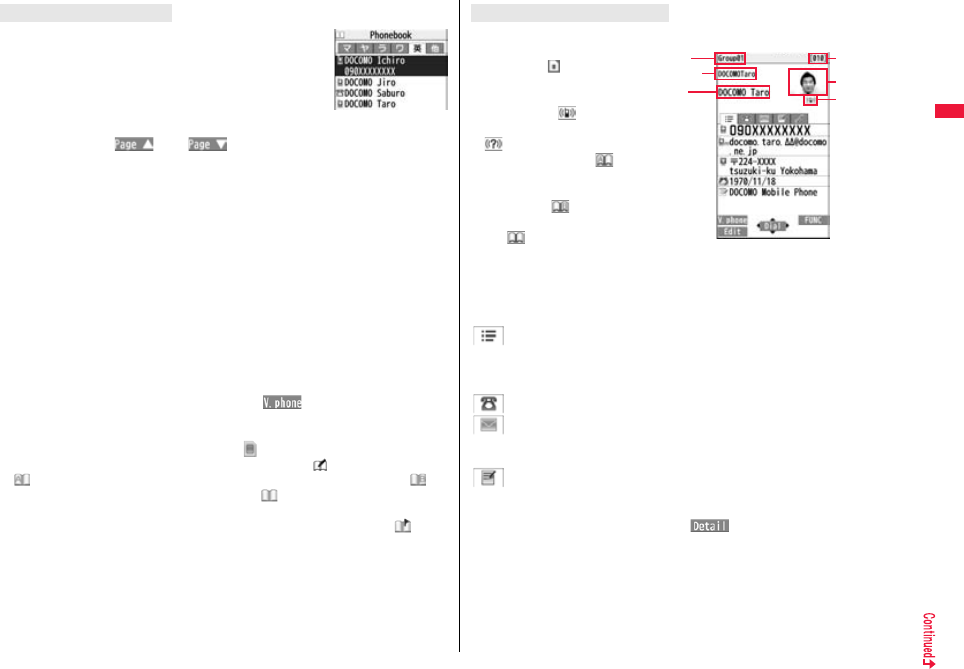
95
Phonebook
When you search from “All?”, “Reading?”, “Group?”, or
“Memory No.?”, the tabs appear on the top of the Phonebook
list. With “All?” and “Reading?”, the entries are sorted by every
column of reading, with “Memory No.?” by every 100 of the
memory number, and with “Group?” by every group.
Press No to display the Phonebook entries in the tab at left or
right. However, when there are 12 or more Phonebook entries
in a tab, pressing m(), c(), or </> brings up the previous or next
page.
≥After you search by “Reading?”, you can move the cursor to the “ア” through “ワ”, “英”,
and “他” tab by pressing each numeric key from the list. When you successively press
the same numeric key, you can move the cursor within the same column.
<Example>Press 5 to display the “ナ” tab. Each time you press 5, the cursor
moves to the top of “ニ” “ヌ” and so on.
≥After you search by “Group?”, you can move the cursor to the top of each column in the
tab by pressing each numeric key from the list. When you successively press the same
numeric key, you can move the cursor within the same column.
<Example>Press 5 to move the cursor to the top of the “ナ” column. Each time you
press 5, the cursor moves to the top of “ニ” “ヌ” and so on.
≥After you search by “Memory No.?”, you can move the cursor to the “000~” to “900~”
tab by pressing each numeric key from the list.
<Example>Press 5 to move the cursor to the “500~” tab.
≥You can make a voice call to the phone number stored for the name highlighted on the
Phonebook list, by pressing d. Also, press l( ) to make a videophone call
and press p to make a PushTalk call. When multiple phone numbers are stored for
the name, the one stored first will be dialed.
≥For the Phonebook entry stored on the UIM, “ ” is displayed.
≥For the Phonebook entry stored with i-concier information, “ ” is displayed.
≥“ ” appears for the Phonebook entries set to A by Phonebook 2in1 Setting, “ ”
appears for the Phonebook entries set to B, and “ ” appears for the Phonebook
entries set to common data. (Only in Dual Mode)
≥When you refer to the Phonebook from a GPS compatible i-αppli program, “ ”
appears for the Phonebook entries which contain the location information.
About Phonebook List
Phonebook list
Use No to highlight a tab, then the detailed contents are displayed.
≥For the Phonebook entry stored
on the UIM, “ ” is displayed on
the memory number field.
≥When Notify Caller ID is set to
“Notify caller”, “ ” appears,
and when set to “Don’t notify”,
“ ” appears.
≥Under the still image, “ ”
appears for the Phonebook
entries set to A by Phonebook
2in1 Setting, “ ” appears for
the Phonebook entries set to B,
and “ ” appears for the
Phonebook entries set to
common data. (Only in Dual
Mode)
≥When a Phonebook entry contains the setting for Multi Number or Chaku-moji, the set
contents are displayed in the Item list/Phone Number display.
Item list
The first stored phone number, mail address, postal address, birthday, and memo are
displayed. When i-concier information is stored, a postal address, URL, and memo
obtained from i-concier are displayed instead of a postal address, birthday, and memo.
Phone number
Mail address
≥When you select the item, you can compose an i-mode mail message with that mail
address entered into the address field.
Personal information
≥When you select a postal address and select “YES”, the GPS compatible i-αppli
program set by “Select map” of “GPS settings” starts to show the map. When you
highlight a postal address and press l( ), the full display appears.
≥When you select the location information, the Function menu of the location information
appears. (See page 327)
≥When you select a memo or still image, the full display appears.
About the detailed display
Detailed Phonebook
display (Item list)
Group
Reading
Name
Memory No.
Still image
Notify caller ID
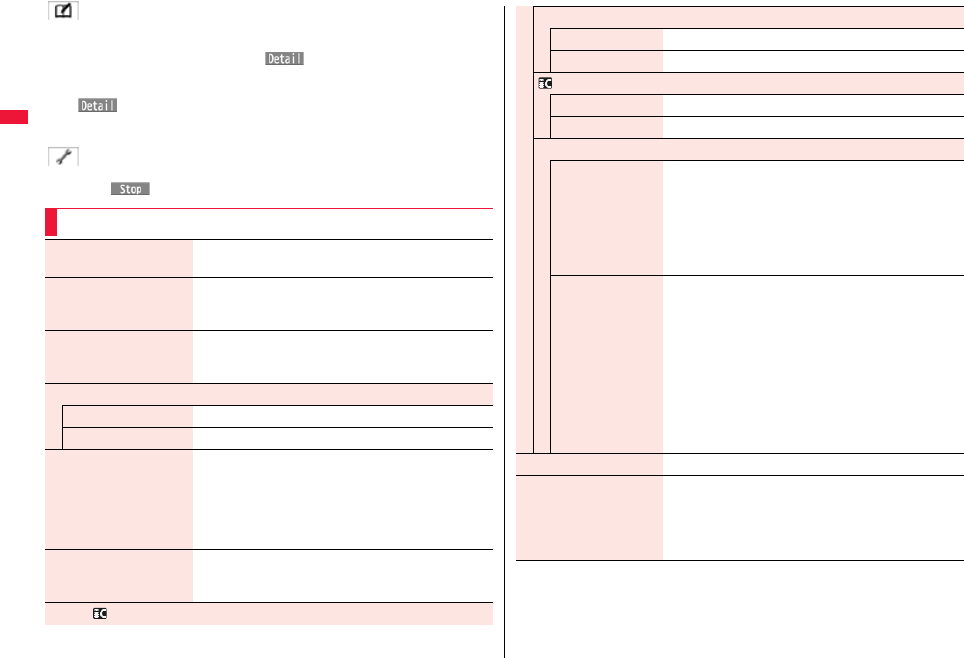
96
Phonebook
i-concier information
≥When you select a postal address and select “YES”, the GPS compatible i-αppli
program set by “Select map” of “GPS settings” starts to show the map. When you
highlight a postal address and press l( ), the full display appears.
≥You can display a site or Internet web page when you select a URL, select “i-mode” or
“Full Browser”, and then select “YES”. When you highlight a URL and press
l( ), the full display appears.
≥When you select a memo, the full display appears.
≥If you have not subscribed to i-concier, the i-concier information tab does not appear.
Settings
≥When you select each item, a demo is played back.
Press Oo() or r to end the demo.
Function Menu of the Phonebook List
New You can store a new Phonebook entry.
Go to step 1 on page 88.
Attach to mail You can send an i-mode mail message with the
Phonebook entry attached.
Go to step 2 on page 142.
Search location You can access the site of “イマドコかんたんサーチ
(imadoco kantan search)”.
1YES
Move/copy
Copy to microSD See page 370.
Connect to Center See page 136.
Sort You can change the display order.
1Select a type of order.
≥You can sort Phonebook entries in reverse order by
selecting “Ascending” or “Descending”.
≥You cannot sort on the Phonebook list with tabs
displayed.
Font size You can switch font sizes for the Phonebook and on the
displays within “Phonebook settings”, etc.
(See “Phonebook” on page 119)
Send Ir/ trans/BT
Send Ir data
Send phonebook See page 384.
Send all phonebook See page 385.
transmission
Send phonebook See page 387.
Send all phonebook See page 387.
Send to Bluetooth
Send phonebook You can send the Phonebook entry using Bluetooth
communication.
1Select a Bluetooth device to be sent1YES
≥When no Bluetooth devices are registered, the
confirmation display appears asking whether to search.
≥See page 424 for registering and connecting Bluetooth
devices.
Send all phonebook You can send all Phonebook entries using Bluetooth
communication.
1Select a Bluetooth device to be sent
1Enter your Terminal Security Code1YES
≥When “Session number setting” of “Bluetooth settings” is
set to “ON”, enter your Terminal Security Code and then
a session number.
≥When no Bluetooth devices are registered, the
confirmation display appears asking whether to search.
≥See page 424 for registering and connecting Bluetooth
devices.
Delete data See page 99.
Set secret/Release secret You can activate/deactivate Secret for the Phonebook
entry.
≥If you select “Set secret” in ordinary mode (not in “Secret
mode” or “Secret data only”), enter your Terminal
Security Code.
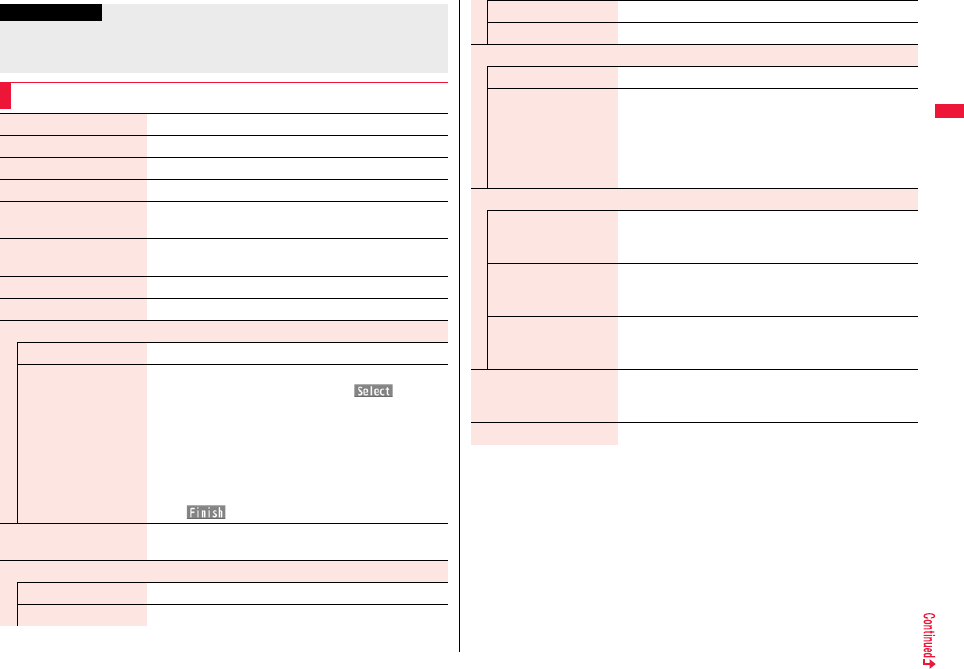
97
Phonebook
Information
<Send to Bluetooth>
≥You cannot send Phonebook entries from the UIM.
≥See page 421 for the Bluetooth function.
Function Menu of the Detailed Phonebook Display
Notify caller ID See page 56.
Prefix numbers See page 60.
Int’l dial assist See page 59.
Select image See page 75.
2in1 dial You can select a phone number to notify the other party in
Dual Mode of 2in1. (See page 452)
Multi number You can select a phone number to be notified to the other
party. (See page 449)
Chaku-moji See page 55.
Search location See page 96.
Edit data
Edit phonebook Go to step 1 on page 98.
Sort phone number/
Sort mail address
1Select a phone number or mail address
1Use Bo to change the order1Oo()
≥From the detailed display, press No to highlight an
item to be sorted. The items you can select from the
Function menu differ depending on the highlighted
item.
≥To change the order in succession, repeat the above
steps.
1l()
Store in P-Talk PB You can store the phone number in the PushTalk
Phonebook.
Move/copy
Copy to UIM See page 419.
Copy to microSD See page 370.
Copy to phone See page 419.
Connect to Center See page 136.
Copy item
Copy name You can copy the name of Phonebook entry.
Copy phone number/
Copy mail add./
Copy address/
Copy location info/
Copy birthday/
Copy memo/Copy URL
You can copy each item of Phonebook entry.
≥From the detailed display, press Mo to highlight an item
to be copied. The items can be selected in the Function
menu differ depending on the highlighted item.
Mail
Compose message You can compose an i-mode mail message to send to the
mail address.
Go to step 3 on page 142.
Attach to mail You can send an i-mode mail message with the
Phonebook entry attached.
Go to step 2 on page 142.
Compose SMS You can compose an SMS message to send to the phone
number set as the destination address.
Go to step 3 on page 186.
Font size You can switch the font size for the Phonebook and on the
displays within “Phonebook settings”, etc.
(See “Phonebook” on page 119)
Restrictions See page 133.
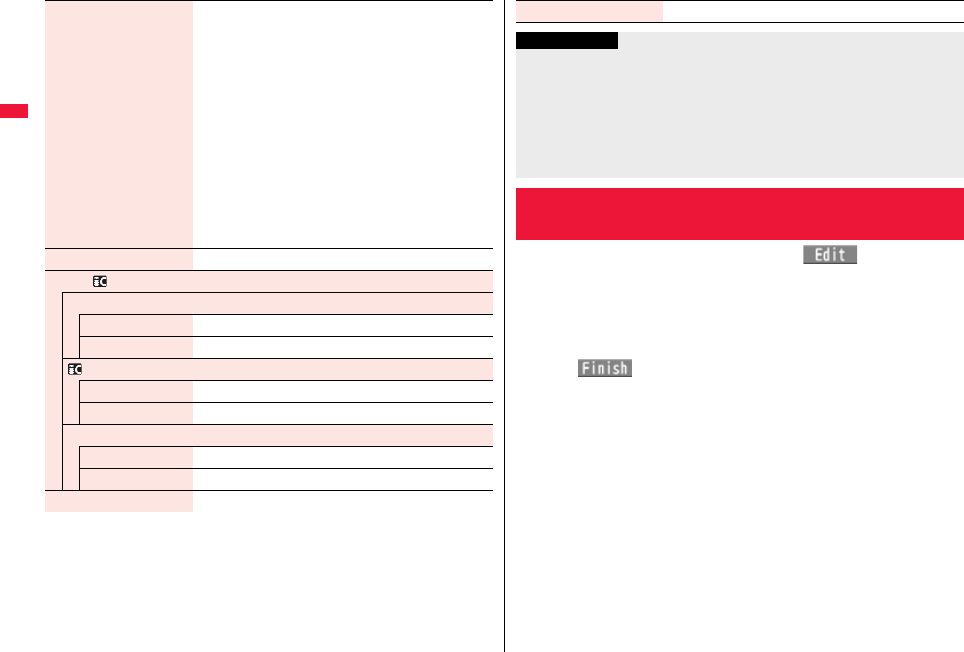
98
Phonebook
Secret code You need to add the recipient’s secret code when sending
i-mode mail to anyone who has registered a secret code.
Once you set the secret code for the mail address in the
Phonebook entry, it will be added automatically whenever
you send mail to that address.
1Enter your Terminal Security Code1Set code
≥From the detailed display, press Mo to highlight a phone
number or mail address to be set with a secret code.
≥To check the secret code, select “Check code”.
≥To release the secret code, select “Release code”.
1Enter a four-digit secret code1YES
≥In the Function menu, “Secret code” is indicated by “★”,
after it is set.
≥Enter a four-digit number for secret code. You cannot set
“0000”.
Add desktop icon See page 31.
Send Ir/ trans/BT
Send Ir data
Send phonebook See page 384.
Send all phonebook See page 385.
transmission
Send phonebook See page 387.
Send all phonebook See page 387.
Send to Bluetooth
Send phonebook See page 96.
Send all phonebook See page 96.
Delete data See page 99.
1Detailed Phonebook display1m()
1Select an item to be edited1Edit the contents.
≥See step 2 on page 88 for how to edit the Phonebook entry.
≥Even if you edit the Phonebook entry in the FOMA terminal (Phone), you can
remain the original contents in the original location and store the edited contents
in the different location by changing the memory number.
2l()1YES
≥If you edited the UIM Phonebook entry, select “Overwrite” to overwrite the original
contents, or “Add” to save the contents as a new entry.
Set secret/Release secret See page 96.
Information
<Secret code>
≥You cannot set secret codes for UIM Phonebook entries.
≥The secret code can be added only when the recipient’s mail address is in the form of
“phone number” or “phone number@docomo.ne.jp”. It cannot be added to any other
form of mail address.
≥If you have stored the mail address as “phone number+secret code@docomo.ne.jp”,
you cannot reply to mail messages from the party of that mail address. After changing
the mail address to “phone number@docomo.ne.jp”, set the secret code.
<Edit Phonebook>
Editing Phonebook Entries
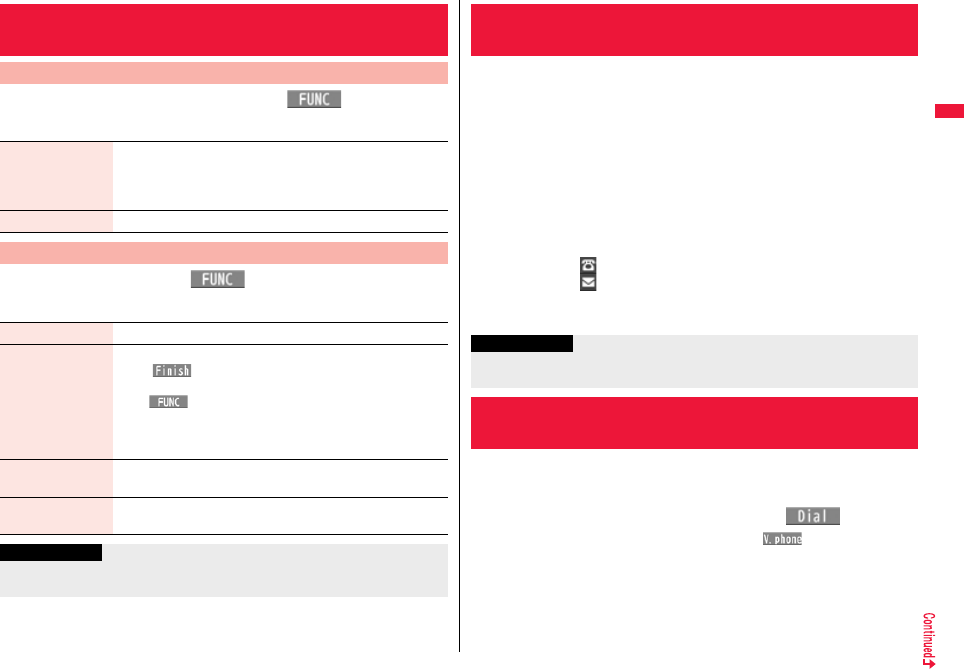
99
Phonebook
1Detailed Phonebook display1i()1Delete data
1Do the following operations.
1Phonebook list1i()1Delete data
1Do the following operations.
<Delete Data>
Deleting Phonebook Entries
Delete from the Detailed Phonebook Display
Phone number/
This item
1YES
≥Highlight an item to be deleted by pressing Mo from the
detailed display.
≥You cannot delete information obtained by i-concier.
This phonebook 1YES
Delete from the Phonebook List
Delete this 1YES
Delete selected 1Put a check mark for Phonebook entries to be deleted
1l()1YES
≥You can check or uncheck entries all at once by pressing
i( ) and selecting “Select all in tab/Select all/Release
all in tab/Release all”.
≥Perform the same operation as that of “Delete all” when you
have selected all Phonebook entries including secret ones.
Delete all in tab You can delete all the Phonebook entries for the displayed tab.
1YES
Delete all You can delete all Phonebook entries including secret entries.
1Enter your Terminal Security Code1YES1YES
Information
≥When you delete a Phonebook entry that is stored in the PushTalk Phonebook, the
PushTalk Phonebook entry is also deleted.
1m1Phonebook1No. of phonebook
Phone
Phonebook. . . The number of Phonebook entries stored in the FOMA terminal
(Phone)
Secret. . . . . . . The number of Phonebook entries stored as secret data
(Displayed in Secret Mode or Secret Data Only)
Image . . . . . . . The number of Phonebook entries in which still images are stored
Chara-den . . . The number of Phonebook entries in which Chara-den images are
stored
PushTalk . . . . The number of Phonebook entries stored in the PushTalk
Phonebook
Voice dial . . . . The number of Phonebook entries set as voice dial entries
Rest . . . . . . . . : The number of phone numbers that can still be stored
: The number of mail addresses that can still be stored
UIM
Phonebook. . . The number of Phonebook entries stored on the UIM
When the entry is stored in memory number “000” through “009” in the
FOMA terminal’s Phonebook, you can dial the phone number just by
pressing the lowest one digit of memory number and d.
1Numeric key (0 to 9)1d or Oo()
≥You can make a videophone call by pressing l( ) or a PushTalk call by
pressing p.
<No. of Phonebook>
Checking Phonebook Storage Status
Information
≥When you use 2in1, the number of Phonebook entries for the mode in use is
displayed. (See page 453)
<2-touch Dial>
Making a Call with a Few Keys Operation
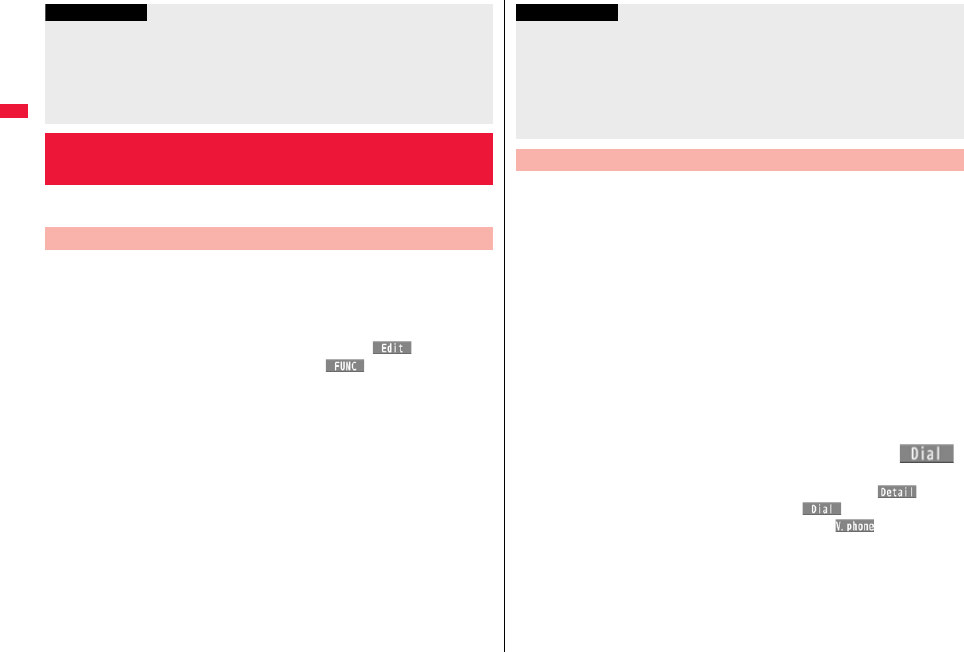
100
Phonebook
Just vocalize the other party’s voice dial name and then the Phonebook
entry is accessed for making a call.
You can store up to 100 voice dial entries selecting from among the
Phonebook entries stored in the FOMA terminal (Phone).
1m1Phonebook1Phonebook settings
1Voice dial setting1<New>
≥You can edit the stored voice dial name by pressing l( ). Go to step 3.
≥To delete the stored voice dial entry, press i( ) and select “Delete” or
“Delete all” and then select “YES”.
2Search the Phonebook1Select a Phonebook entry.
The display for search method you used last time appears.
≥The “★” mark is added to the Phonebook entry stored in the Voice Dial list.
3Enter a voice dial name.
≥You can enter up to 22 half-pitch katakana characters.
≥The reading (katakana only) of the Phonebook entry is displayed as the voice dial
name. Correct the name to the easy-to-identify words.
Information
≥When the Phonebook entry contains multiple phone numbers, the first phone number
will be dialed.
≥When you set “Restrict dialing” to a Phonebook entry of memory number 000 through
009, set it to the first phone number in the Phonebook entry.
≥When you store a Phonebook entry of memory number from 000 through 009 as
secret data, make a call to that entry in Secret Mode or Secret Data Only.
<Voice Dial>
Accessing Phonebook Entries by Voice
+m-2-6
Voice Dial Setting
By your voice, you can access the Phonebook entry you set in the Voice
Dial list. When “Read aloud settings” is set to “ON” and “Voice dial” is
checked, the operation is guided by the voice guidance.
1d(for at least one second)
1As soon as the voice recognition start tone sounds,
vocalize the voice dial name.
Start vocalizing within four seconds after the voice recognition start tone sounds.
Once the voice is recognized as a voice dial entry, the detected result is displayed.
≥You cannot change the volume of the voice recognition start tone. The voice
recognition start tone does not sound during Manner Mode.
≥If you say the word “ボイス設定 (Boisusettei)”, the display of “Voice settings”
appears. (See page 101)
≥When “Auto voice dial” is set to “ON”, the display for Auto Voice Dial appears
after the voice is recognized as a voice dial entry. Then about two seconds later,
the FOMA terminal automatically dials out.
2
Highlight a detected result and press
d
or
Oo
().
The first phone number in the selected Phonebook entry is dialed.
≥You can show the detailed Phonebook display by pressing l().
Highlight a phone number and press d or Oo( ) to make a voice call.
Also, you can make a videophone call by pressing l( ) or a PushTalk
call by pressing p.
Information
≥The voice dial name set by this function is effective only for calling up a voice dial
entry. For the voice guidance function, the reading (name) stored in the Phonebook is
read aloud.
≥When multiple similar voice dial names are stored or when the voice dial name is
short, the recognition rate lowers and a wrong voice dial entry (Phonebook entry)
might be accessed. In this case, rename the existing voice dial name and store it.
≥You cannot store “ボイスセッテイ (Boisusettei)” as a voice dial name.
Dial from Phonebook by Voice
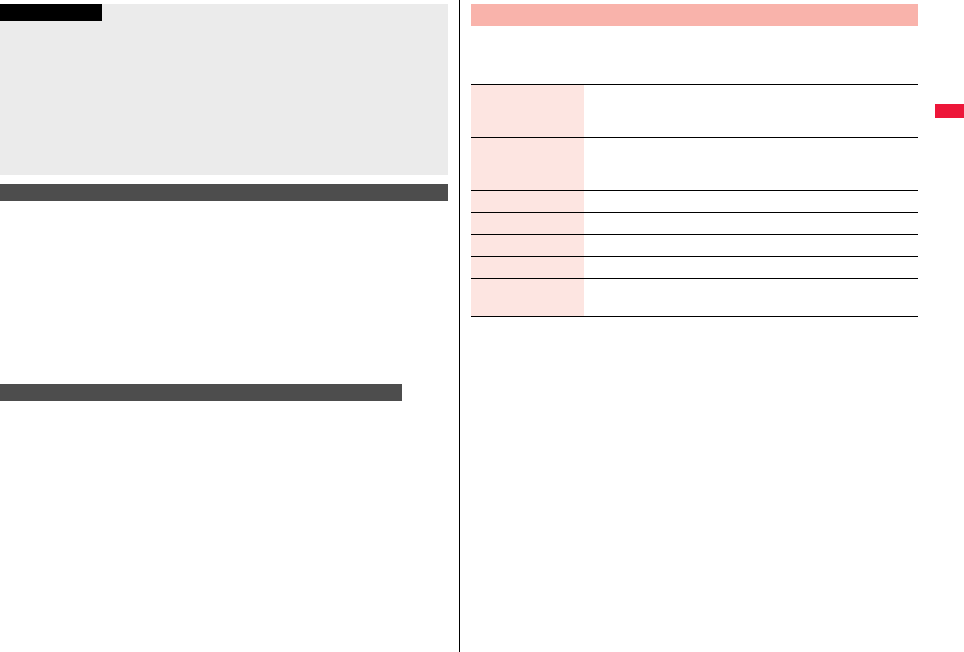
101
Phonebook
You need to set “Voice headset dial” to “ON” and open the FOMA
terminal in advance.
1Press and hold the switch of the earphone/microphone
(option) for at least one second.
2Perform the operations of “Dial from Phonebook by
Voice” on page 100.
≥You can make a call also by pressing the switch of the earphone/microphone
instead of pressing d or Oo.
You need to set “Voice headset dial” to “ON” in advance, and connect
with the Bluetooth device using the Headset service or Hands-free
service.
≥For using the Hands-free service, the Bluetooth device needs to support a voice
recognition function.
1Press the switch of the Bluetooth device.
2Access a voice dial entry following the voice guidance.
Once the voice is recognized as a voice dial entry, the detected result is displayed.
≥The FOMA terminal automatically dials out about two seconds after the voice
guidance informing of dialing finishes.
Information
≥When you vocalize, keep your mouth away from the microphone about 10 cm. If your
voice is too distant, it may be difficult to recognize your voice.
≥Pronounce the voice dial name as clearly as possible.
≥Before and after voice production, avoid making the sounds unrelated to the voice dial
name such as clearing your throat, clicking your tongue, noisy breathing or other
noise.
≥Vocalize in quiet, noise-free locations.
≥While vocalizing, do not put your fingers over the microphone, or press or brush the
keys.
To access a voice dial entry using an earphone/microphone
To access a voice dial entry using a Bluetooth device
1m1Set./Service1Other settings1Voice settings
1Do the following operations.
Voice Settings
Auto voice dial You can automatically make a call to the phone number
accessed by voice.
1ON or OFF
Voice headset dial You can access the voice dial entries by using an earphone/
microphone (option) or Wireless Earphone Set 02 (option).
1ON or OFF
Read aloud settings See page 402.
Read aloud volume See page 403.
Read aloud speed See page 403.
Read aloud output See page 403.
Read aloud valid
set.
See page 403.

102

103
Sound/Screen/Light Settings
Sound Settings
Changing Ring Tone. . . . . . . . . . . . . . . . . . <Select Ring Tone> 104
Setting Sound Effects of Ring Tone or Melody
. . . . . . . . . . . . . . . . . . . . . . . . . . . . . . . . . . . . . . <Melody Effect> 105
Informing You of an Incoming Call by Vibration . . .<Vibrator> 106
Using Recorded Sound as Ring Tone . . . <Voice Announce> 106
Changing Ringback Tone . . . . . . . . . . . <Melody Call Setting> 106
Setting Keypad Sound . . . . . . . . . . . . . . . . . . <Keypad Sound> 107
Setting Speed Selector Sound . . . . <Speed Selector Sound> 107
Setting Charging-start/end Tones. . . . . . . . . <Charge Sound> 107
Sounding Alarm when a Line is Nearly Disconnecting
. . . . . . . . . . . . . . . . . . . . . . . . . . . . . . . . . . . . . . <Quality Alarm> 107
Setting Ring Time for Mail and Messages R/F
. . . . . . . . . . . . . . . . . . . . . . . . . . . . . <Mail/Message Ring Time> 108
Sounding Ring Tone from Earphone Only
. . . . . . . . . . . . . . . . . . . . . . . . . . . . . . <Headset Usage Setting> 108
Muting Tones from FOMA Terminal . . . . . . . . <Manner Mode> 108
Selecting Manner Mode Type . . . . . . . . . .<Manner Mode Set> 109
Screen/Light Settings
Changing Displays . . . . . . . . . . . . . . . . . . . . . .<Display Setting> 111
Displaying an Image Stored in Phonebook during Ringing
. . . . . . . . . . . . . . . . . . . . . . . . . . . . <Display Phonebook Image> 113
Displaying Arrival Information by Opening FOMA Terminal
. . . . . . . . . . . . . . . . . . . . . . . . . . . .<Received Mail/Call at Open> 113
Setting Lights for Display and Keypad . . . . . . . . . . <Backlight> 113
Adjusting Quality of Display Automatically . . . . . . . . .<LCD AI> 114
Making Display Hard to See from People Around
. . . . . . . . . . . . . . . . . . . . . . . . . . . . . . . . . . . . . . . . . <View Blind> 115
Setting Quality of Display . . . . . . . . . . . . . . . . .<Image Quality> 115
Setting Color Combination for Display
. . . . . . . . . . . . . . . . . . . . . . . . . . . . . . . . . <Color Theme Setting> 115
Setting Display of Main Menu . . . . . . . . . . <Menu Icon Setting> 115
Using Kisekae Tool. . . . . . . . . . . . . . . . . . . . . . . <Kisekae Tool> 116
Setting Machi-chara Image . . . . . . . . . . . .<Set to Machi-chara> 117
Setting Color of Call/Charging Indicator and Others
. . . . . . . . . . . . . . . . . . . . . . . . . . . . . . . . . . . . . . . . <Illumination> 117
Changing Character Font. . . . . . . . . . . . . . . . . . . . . . . . . .<Font> 119
Changing Font Size . . . . . . . . . . . . . . . . . . . . . . . . . .<Font Size> 119
Setting Clock Display . . . . . . . . . . . . . . . . . . . . . . . . . . . . . . . . . . . 120
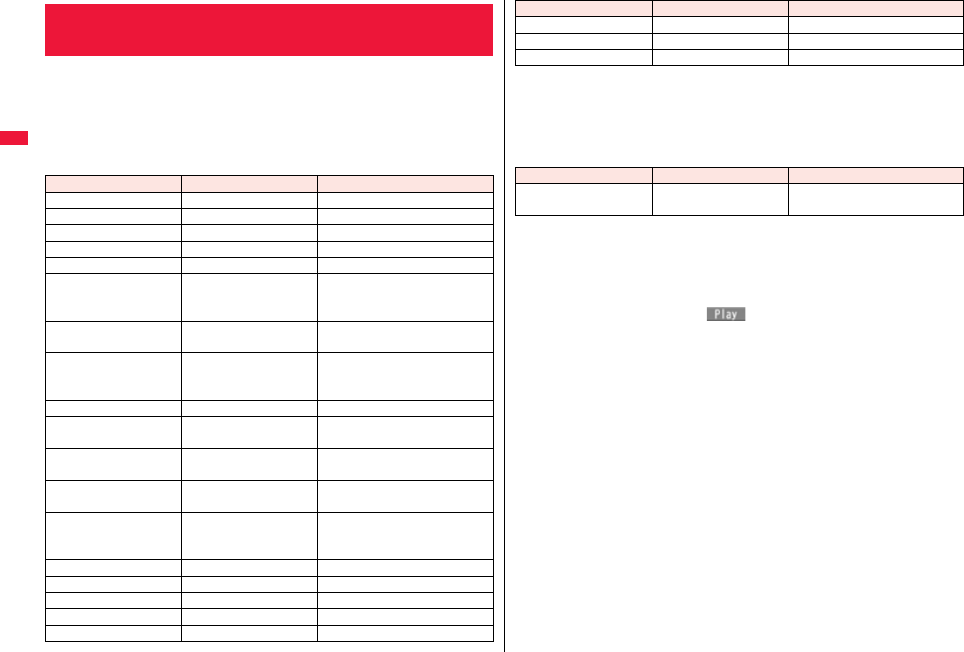
104
Sound/Screen/Light Settings
You can set a ring tone for each incoming type.
If you select an i-motion movie, the i-motion movie and sound are played
back for incoming calls/messages. (Chaku-motion)
≥The ring tone is the PCM sound source, chord of 128 tones, and ADPCM compliant.
≥See “Add to Phonebook” on page 88 for setting a ring tone by Phonebook entry, and
see “Group Setting” on page 93 for setting it by group.
■Ring Tone List (pre-installed)
+m-1-3
<Select Ring Tone>
Changing Ring Tone
Display Title Name of Lyricist/Composer
Pattern 1 ーー
Pattern 2 ーー
Pattern 3 ーー
Pattern 4 ーー
Pattern 5 ーー
HEIGH HO // SNOW
WHI
HEIGH HO // SNOW
WHITE AND THE
SEVEN DWARFS /INST
Composer:
CHURCHILL FRANK E
SYMFONIE NR 9 Z
NOVE
SYMFONIE NR 9 Z
NOVEHO SVETA OP 95
Composer:
DVORAK ANTONIN
SONATINE※SONATINE
Composer:
WOLFGANG AMADEUS
MOZART
Techno Techno ー
PARADE OF THE
WOODEN※
PARADE OF THE
WOODEN SOLDIERS
Composer:
JESSEL LEON
SUMMERTIME※SUMMERTIME Composer:
GERSHWIN GEORGE
SOMEDAY MY PRINCE
WI
SOMEDAY MY PRINCE
WILL COME
Composer:
CHURCHILL FRANK E
PEER GYNT SUITE NR
1※
PEER GYNT SUITE NR
1 OP 46/
MORGENSTEMNING
Composer:
GRIEG EDVARD HAGERUP
KIRAKIRA ー
Electrical ーー
Acoustic Guitar ーー
Minimal ーー
Magical Stick ーー
※3D sound is supported. See page 105 for 3D sound.
(Note) The names of lyricists and composers are described conforming to the JASRAC
web page.
Whole part of long titles may not be displayed due to restriction of the display
size.
■i-motion (pre-installed)
≥You cannot set the pre-installed i-motion “「マンマ・ミーア!」予告編 (Preview of
[MAMMA MIA!])” for a ring tone.
1m1Set./Service1Sound1Select ring tone
1Select an incoming type.
≥Select an item and press l( ) to check the contents actually played
back or displayed.
2Select ring tone1Select a type of ring tone.
Melody . . . . . . . . . . . Sets a melody as a ring tone.
MUSIC. . . . . . . . . . . . Sets a Chaku-uta Full® music file as a ring tone.
imotion . . . . . . . . . Sets an i-motion movie as a ring tone. (Chaku-motion/
Chaku-uta®)
Voice announce . . . Sets the sound recorded by “Voice announce” as a ring
tone. The setting is completed.
OFF . . . . . . . . . . . . . . Sets a ring tone off. The setting is completed.
3Select a folder1Select a ring tone.
≥If you select “MUSIC” in step 2, select “Fullsong ring tone” or “Point ring tone”.
(See page 284)
≥See page 201 when you select “Search by i-mode”.
Smart Beep ーー
Ukulele ーー
Waterdrop ーー
Display Title Name of Lyricist/Composer
Display Title Name of Lyricist/Composer
「マンマ・ミーア!」
予告編 ーー
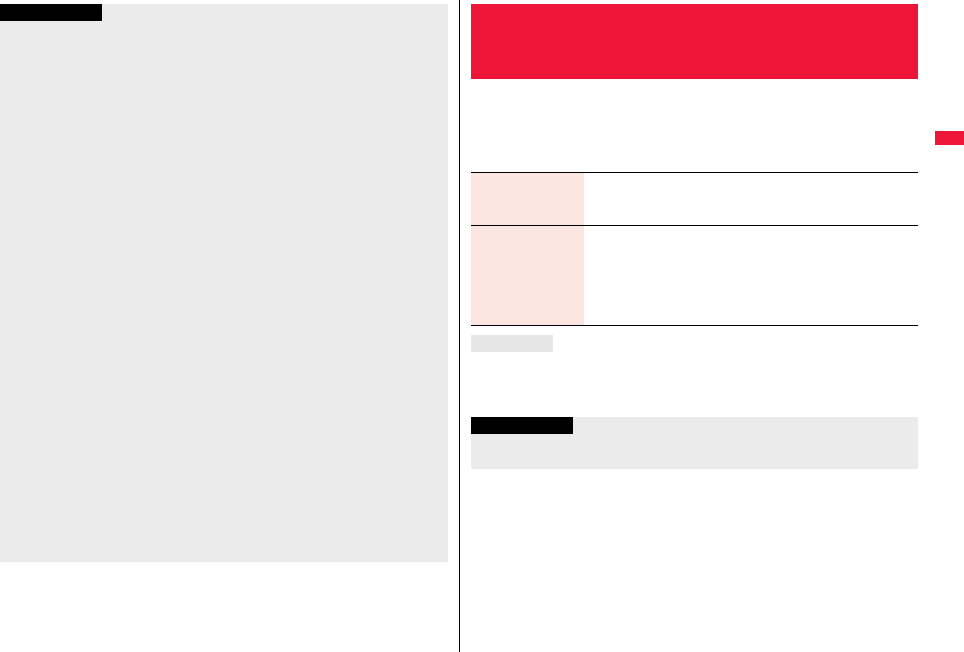
105
Sound/Screen/Light Settings
Information
≥You can set the Call Receiving display by selecting “Phone” or “Videophone”, and
then by selecting “Select calling disp.”. Go to step 2 on page 112.
≥You can set the Mail Receiving display by selecting “Mail”, “Chat mail”, “MessageR” or
“MessageF”, and then by selecting “Select receiving disp.”. Go to step 2 of “Set
Stand-by Display” on page 111.
≥The priority order of ring tones is as follows: “Read aloud settings” → “Setting for
Phonebook entry” → “Group setting” → “Select ring tone” (“Set as ring tone” of “Multi
number” when a call comes in to the additional number, and “Ring tone set. for No. B”
of “2in1 setting” when a call comes in to Number B while using 2in1).
≥The ring tone or images set at purchase might be played back or displayed for
incoming calls or messages, depending on the combination of this function and
“Display setting”.
≥See “imotion info” to check whether the i-motion movie can be set for a ring tone.
≥When you set an i-motion movie containing video and sound for a mail ring tone, you
can press -r or others to stop the ring tone.
≥When you set an i-motion movie containing video and sound for a ring tone
(Chaku-motion), it is played back taking priority over “Display setting”. However, if you
set a voice-only i-motion movie for the ring tone, the image set by “Display setting” is
displayed.
≥When you set an i-motion movie containing video and sound for “Select calling disp.”,
the i-motion movie is played back taking priority over this function for incoming calls.
However, if you set an i-motion movie containing only video for “Select calling disp.”,
the ring tone selected for this function is played back for incoming calls.
≥You cannot set an i-motion movie which contains video for “PushTalk” or “i-concier”.
≥When different types of mail — i-mode mail, SMS messages, chat mail, or Messages
R/F — are received at the same time, the priority order of ring tone as follows: “Chat
mail” → “i-mode mail/SMS” → “MessageR” → “MessageF”. If you receive the same
type of mail simultaneously, the ring tone corresponding to the mail you have received
last works.
≥For melodies downloaded, attached to mail, or prohibited from being attached to mail
or being output from the FOMA terminal, a playing part may be specified in advance.
When a play-part-specified melody is set for a ring tone, only the specified part is
played back.
You can set whether to add stereophonic sound effects to the playback
tone of melodies and i-motion movies, ring tones, and effect tones.
1m1Set./Service1Sound1Melody effect
1Do the following operations.
3D Sound is a function that creates stereophonic sound and spatially-moving sound
through the use of a stereo earphone. 3D Sound compatible i-αppli games, ring tones,
and i-motion movies enable you to enjoy live-like feeling of sounds.
+m-6-4
<Melody Effect>
Setting Sound Effects of Ring Tone or
Melody
Stereo&3DSound You can play back 3-dimensional sound from a stereo earphone
(option). This is effective for the i-αppli effect tones or ring tones.
1ON or OFF
Position to play You can set the play start position of the melody that has been set
for the ring tone or alarm tone.
1Select an item.
Play all. . . . . . . . Plays back from the beginning of the melody.
Play portion . . . Plays back from the start position set for the
melody.
3D Sound
Information
≥Stereognostic sense might differ depending on the person. If you feel strange, switch
“Stereo&3DSound” to “OFF”.
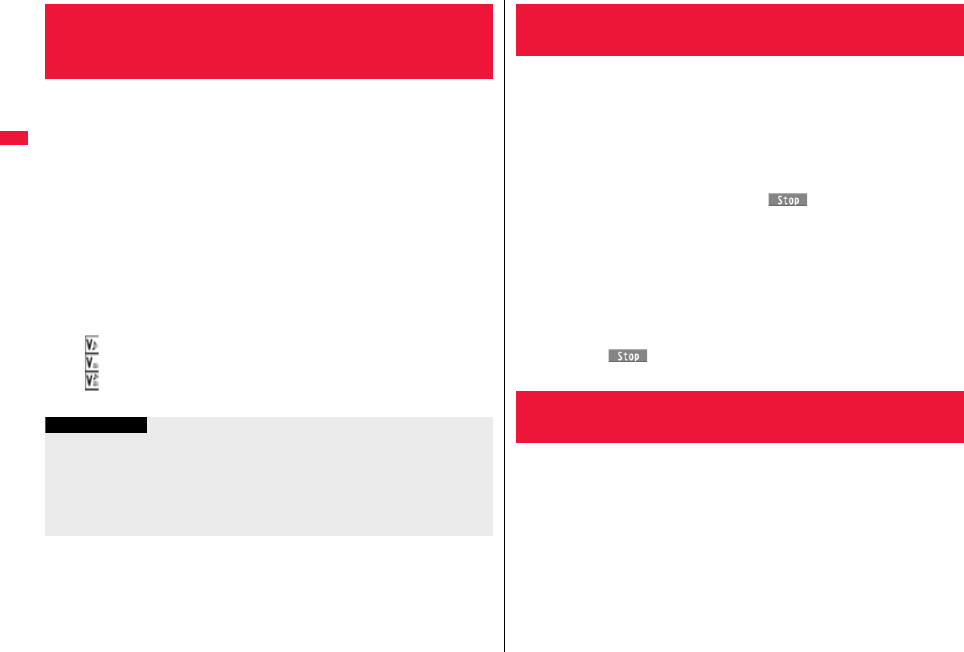
106
Sound/Screen/Light Settings
You can set the vibrator to notify you of incoming calls and mail.
1m1Set./Service1Incoming call1Vibrator
1Select an incoming type1Select a vibration pattern.
Pattern 1. . . . . . . . . Alternates between vibration on (about 0.5 second) and off
(about 0.5 second).
Pattern 2. . . . . . . . . Alternates between vibration on (about 1 second) and off
(about 1 second).
Pattern 3. . . . . . . . . Alternates between vibration on (about 3 seconds) and off
(about 1 second).
Melody linkage . . . Vibrates in time with the vibration pattern stored in the melody.
OFF . . . . . . . . . . . . .Does not vibrate.
≥While selecting a vibration pattern, you can check the selected vibration.
However, you cannot check the vibration when you select “Melody linkage”.
≥The following icons are displayed on the Stand-by display while “Vibrator” is set to
other than “OFF”:
: You set “Phone”, “PushTalk”, or “Videophone”.
: You set “Mail”, “Chat mail”, “MessageR”, “MessageF”, or “i-concier”.
: You set “Phone”, “PushTalk”, or “Videophone”, and set “Mail”, “Chat mail”,
“MessageR”, “MessageF”, or “i-concier”.
+m-5-4
<Vibrator>
Informing You of an Incoming Call by
Vibration
Information
≥The priority order of vibrators is as follows: “Setting for Phonebook entry” → “Group
setting” → “Vibrator”.
≥Even when “Melody linkage” is set, the FOMA terminal vibrates with “Pattern 2” if an
i-motion movie or melody with no vibration pattern is set for the ring tone.
≥Be careful not to leave the FOMA terminal on a desk or similar places with the vibrator
activated; when a call comes in, the FOMA terminal might move and fall by vibration.
You can set the sound recorded with the FOMA terminal for a ring tone
(including a ring tone for Number B of 2in1), On-hold tone/Holding tone,
alarm for “Alarm”, “Schedule”, “ToDo”, and “TV timer”, and answer
message for Record Message.
You can record only one item for about 15 seconds.
1m1LifeKit1Rec.msg/voice memo1Voice announce
1Record
≥To suspend recording midway, press Oo(), h, or r. The contents
recorded to that point are saved.
≥The tone beeps about 5 seconds before the recording time (for about 15
seconds) ends. When recording ends, the tone beeps twice, and the former
display returns.
≥The recording is suspended when a call comes in, when an alarm for “Alarm”,
“Schedule”, “ToDo”, “TV timer”, or “Timer recording” sounds, or when you switch
displays using Multitask while recording. (The contents recorded to that point are
saved.)
≥To play back the recorded sound, select “Play”. To suspend playback midway,
press Oo(), h, or r.
≥To erase the recorded sound, select “Erase”, then select “YES”.
Melody Call is a service that enables you to change the ringback tone
phone the callers hear to a melody you like.
For details, refer to “Mobile Phone User’s Guide [Network Services]”.
≥Melody Call is a pay service which is available on a subscription basis.
1m1
Set./Service
1
Incoming call
1
Melody Call setting
1
YES
1
Operate following the instructions on the display.
+m-5-5
<Voice Announce>
Using Recorded Sound as Ring Tone
<Melody Call Setting>
Changing Ringback Tone
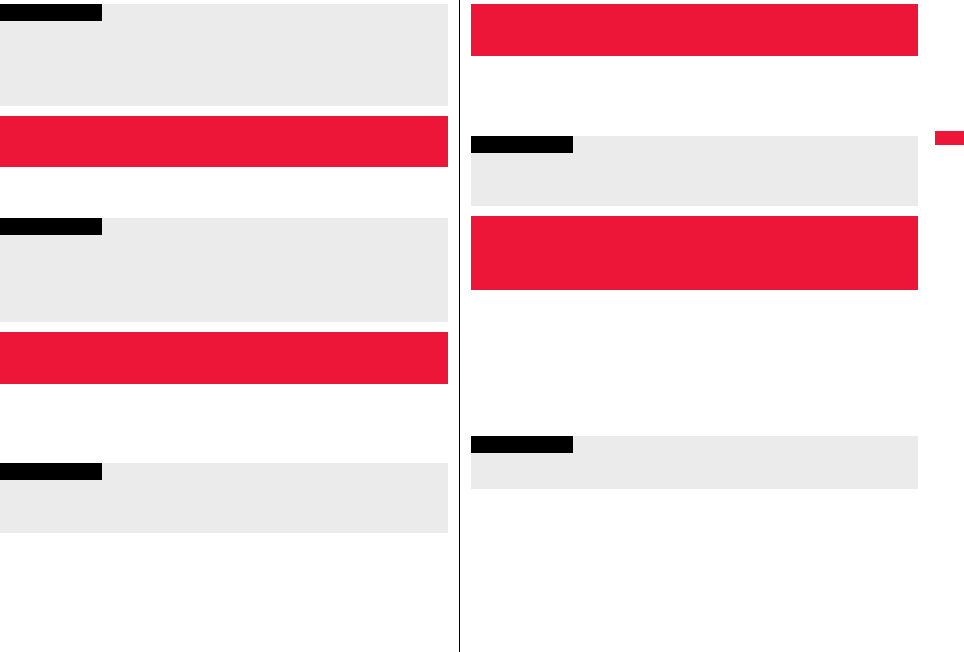
107
Sound/Screen/Light Settings
1m1Set./Service1Sound1Keypad sound1ON or OFF
1m1Set./Service1Sound1Speed selector sound
1Select a pattern.
≥While selecting a pattern, you can check the selected sound.
Information
≥Melody Call is not available for incoming videophone calls and PushTalk calls.
≥When you select “YES” from the confirmation display asking whether to connect to the
site, the line is connected to the i-mode site. You are not charged a packet
communication fee for connecting to the site for settings, however, you are charged
for connecting to the IP site, i-mode menu site, and free melody corner.
+m-3-0
<Keypad Sound>
Setting Keypad Sound
Information
≥You cannot change the volume for keypad sound.
≥If you set this function to “OFF”, the battery level tone (see page 42) and respective
warning tones do not sound.
≥The keypad does not make a sound when you press .</.>, while the phone is
ringing, or during playback of a movie or i-motion movie.
<Speed Selector Sound>
Setting Speed Selector Sound
Information
≥You cannot change the volume for speed selector sound.
≥The speed selector does not make a sound while the phone is ringing, during a call, or
during playback of a movie or i-motion movie.
The confirmation tone sounds twice when charging starts/ends.
1m1Set./Service1Other settings1Battery
1Charge sound1ON or OFF
When a call is nearly disconnecting midway due to bad radio wave
conditions, an alarm sounds to inform you right before disconnection.
1m1Set./Service1Talk1Quality alarm
1Select an alarm.
No tone . . . . . Does not sound.
High tone. . . . High alarm sounds.
Low tone . . . . Low alarm sounds.
<Charge Sound>
Setting Charging-start/end Tones
Information
≥You cannot change the volume for charge sound.
≥The charging confirmation tone does not sound when a display other than the
Stand-by display is shown or during Manner Mode or Public Mode (Drive Mode).
+m-7-5
<Quality Alarm>
Sounding Alarm when a Line is Nearly
Disconnecting
Information
≥You might be disconnected without hearing an alarm if radio wave conditions
deteriorate suddenly.
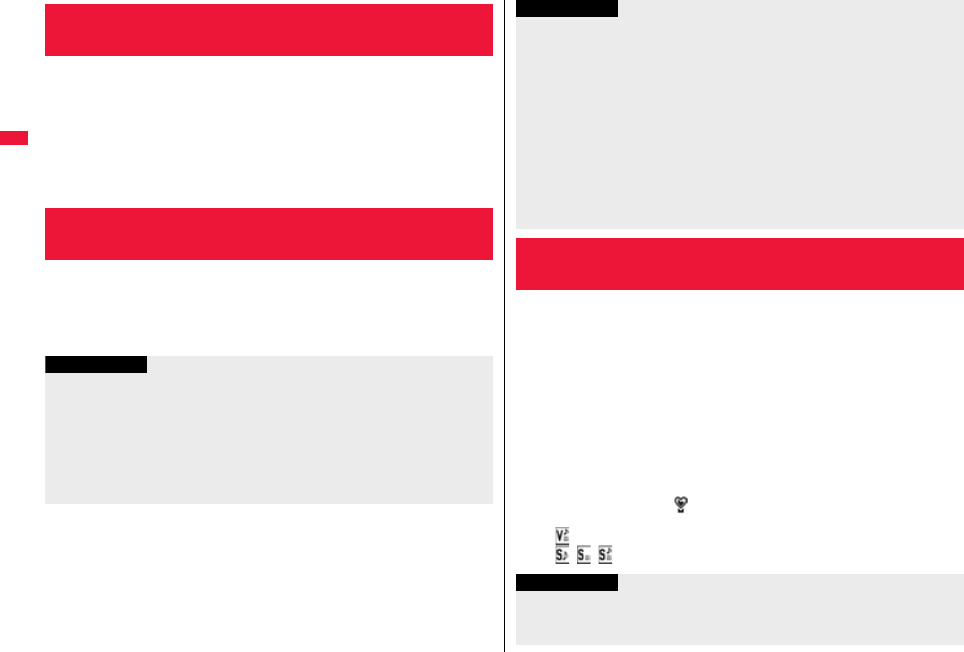
108
Sound/Screen/Light Settings
You can set the duration of the ring tone which sounds for incoming
i-mode mail, SMS messages, Chat mail, Messages R/F, and i-concier
information.
1m1Set./Service1Sound1Mail/Msg. ring time
1Select a type of mail or message1ON or OFF
1Enter a ring time (seconds).
≥Enter in two digits from “01” through “30”.
You can set from where you sound the ring tone and alarm for when you
connect an earphone/microphone (option).
1m1Set./Service1Sound1Headset usage setting
1Headset and speaker or Headset only
+m-6-8
<Mail/Message Ring Time>
Setting Ring Time for Mail and Messages R/F
+m-5-1
<Headset Usage Setting>
Sounding Ring Tone from Earphone Only
Information
≥Even when you set to “Headset only”, the ring tone sounds from both the earphone
and speaker about 20 seconds after ringing starts. However, the tone does not sound
from the speaker but sounds from the earphone only even after 20 seconds have
elapsed if the tone sounds for the operations other than incoming calls, incoming mail,
and alarm notification.
≥Even when you set to “Headset only”, the tone sounds from the speaker when any
earphone/microphone is not connected or at the start of shooting still images or
movies.
Just by pressing a key, you can set to mute tones such as a ring tone and
keypad sound from the FOMA terminal.
You can use “Manner mode set” to select Manner Mode functions from
three types; “Manner mode”, “Super silent”, or “Original”.
While “Manner mode” or “Super silent” is activated, or while “Mic
sensitiv.” is set to “Up” in “Original”, you can talk softly on the phone but
your voice can still be heard clearly at the other end.
1
During standby/During a call
1s
(for at least one second)
Manner mode selected in “Manner mode set” is set.
≥When the FOMA terminal is closed, press and hold < for at least one second to
activate Manner Mode. While a PushTalk call is arriving, press s or > to
activate Manner Mode.
≥During Manner Mode, “ ” is displayed. The settings you selected for “Manner
mode set” are also displayed.
: Indicates that “Vibrator” will work to notify events.
/ / : Indicate that “Ring volume” has been set to “Silent”.
≥
In the following cases, the tone sounds from the earphone when an earphone/microphone
is connected, and from the speaker when it is not connected, regardless of this setting:
・
While watching a 1Seg program
・
During playback of a video file
・
During playback of an i-motion movie
・
During playback of a PC movie
・
During playback of a melody
・
While an i-
α
ppli program is running
・
During playback of a music file by MUSIC Player
・
During playback of a Music&Video Channel program
≥Do not wind the cord of the earphone/microphone around the FOMA terminal.
≥The FOMA terminal may pick up noise if you take the cord of the earphone/
microphone close to the FOMA terminal during a call.
<Manner Mode>
Muting Tones from FOMA Terminal
Information
Information
≥
If you activate Manner Mode during a call or calling, the message to that effect appears.
≥The recording start tone sounds even in Manner Mode when you shoot still images or
movies.
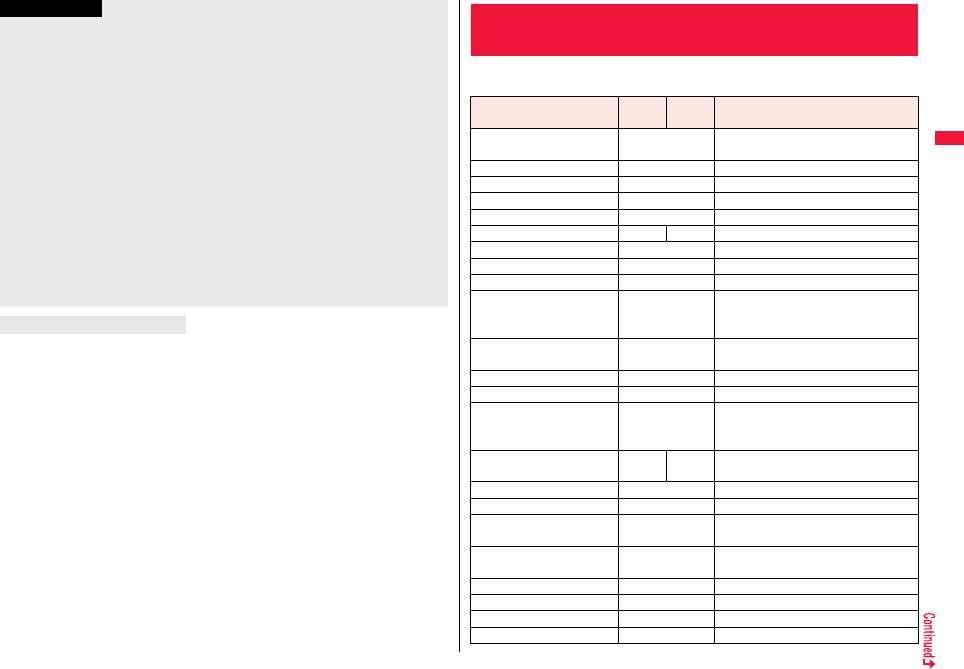
109
Sound/Screen/Light Settings
Press and hold s for at least one second. During a call or calling, two beeps sound
and the message that is released appears.
≥When the FOMA terminal is closed, you can release Manner Mode also by pressing
and holding < for at least one second.
≥In Manner Mode, if you try to play back a melody, the confirmation display appears
asking whether to play it back. Select “YES” to play back the melody at the volume set
for “Phone” of “Ring volume”. If the setting is “Silent” or “Step”, the volume is Level 2.
≥In Manner Mode, if you do the following operations, the confirmation display appears
asking whether to play back voice or music.
・Watching a 1Seg program
・Playing back an i-motion movie
・Playing back a video file
・Playing back a PC movie
・Playing back a music file by MUSIC Player
・Playing back a Music&Video Channel program
Select “YES” to play it back at the volume set for each player. When you change the
volume level, it is played back at the set volume for the next time.
≥When an earphone/microphone (option) is connected, the sound comes out of the
earphone. The confirmation display asking whether to play back sound or music files
during Manner Mode does not appear. Further, the playback tone does not sound
from the speaker even if you unplug the earphone/microphone while playing back
sound or music files by each player.
To release Manner Mode
Information
You can select one of three types of operations for Manner Mode.
■Operations during Manner Mode
+m-2-0
<Manner Mode Set>
Selecting Manner Mode Type
Manner
Mode
Super
Silent Original
Record message Set value of
Record message ON or OFF
Vibrator※1ON ON or OFF
Phone volume Silent Silent through Level 6 and step①
Mail volume Silent Silent through Level 6 and step②
Alarm volume※2Silent Silent through Level 6 and step
Memo tone ON OFF ON or OFF③
Keypad sound OFF ON or OFF④
Speed selector sound OFF Pattern 1 through Pattern 3 and OFF
Microphone sensitivity Up Normal or Up
Low voltage alarm tone
(Low battery alarm) OFF
ON or OFF
When “LV alarm tone” is set to “ON”, it
works with the same set value as
①
.
※3
Confirmation tone for
selecting ring tone Silent
Works with the same set value as
①・②
.
On hold tone Silent
Works with the same set value as
①
.
※4
Holding tone Silent
Works with the same set value as
①
.
※5
ToruCa-received tone and
ToruCa failed-to-receive
tone
Silent Works with the same set value as ①.
Confirmation tone for
recording voice announce ON OFF Works with the same set value as ③.
Battery level tone Silent Silent
Voice recognition start tone Silent Silent
Playback tones of attached
melody Silent Silent
Effect tones of
Decome-Anime Silent Silent
Warning tones Silent Works with the same set value as ④.
Schedule alarm Silent Works with the same set value as ①.
ToDo alarm Silent Works with the same set value as ①.
TV timer alarm Silent
Works with the same set value as
①
.
※6
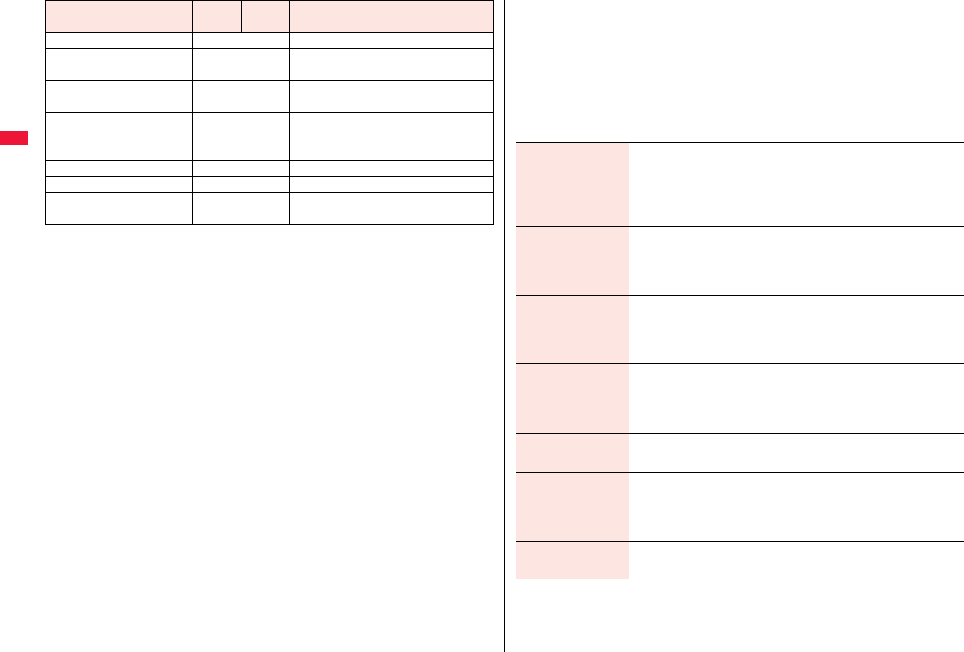
110
Sound/Screen/Light Settings
※1 Ring tones and alarm tones for “Alarm”, “Schedule”, “ToDo”, “TV timer” and “Timer
recording” are notified by the vibration.
The vibration pattern is the same as the setting you set on page 106. However, if
the setting you set on page 106 is “OFF”, “Pattern 2” applies.
※2 When “Prefer manner mode” on page 405 is set to “OFF”, the tone sounds at the
volume set for Alarm.
※3 The tone sounds at Level 1 when ① is “Silent”.
※4 The tone sounds at Level 2 when ① is “Step”.
※5 The tone sounds at Level 1 when ① is not “Silent”.
※6 When “Prefer manner mode” on page 262 is set to “OFF”, the tone sounds at the
volume set for TV Timer.
※7 The tone does not sound when ① is “Step”.
Timer recording alarm Silent
Works with the same set value as
①
.
※7
Start tones for shooting still
images and movies Level 4 Level 4
Confirmation tone for
selecting shutter sound OFF
Works with the same set value as
①
.
※4
Switching to Hands-free by
“Hands-free w/ V. phone” or
“Hands-free w/ PushTalk”
OFF OFF
Read aloud volume Silent Silent
Effect tones of Flash movies
Silent Silent
Effect tones at the start of
i-Widget
Silent
Works with the same set value as
①
.
※4
Manner
Mode
Super
Silent Original You can select from among standard “Manner mode” to inform you of
incoming calls or mail by the vibrator, “Super silent” to erase sounds
including confirmation tones from the earpiece, or “Original” to
customize operations.
1m1Set./Service1Incoming call1Manner mode set
1Manner mode, Super silent or Original
1Do the following operations.
Record msg. 1ON or OFF
≥Even if you select “ON”, the ring time is fixed to about 13
seconds and cannot be changed when “Record message
setting” on page 69 is set to “OFF”.
≥See page 69 for Record Message Setting.
Vibrator You can set the FOMA terminal to vibrate for incoming calls and
mail.
1ON or OFF
≥See page 106 for Vibrator.
Phone vol. You can adjust the ring volume for incoming voice calls,
videophone calls and PushTalk calls.
1Use Bo to adjust the volume.
≥See page 66 for Ring Volume.
Mail vol. You can adjust the ring volume for i-mode mail, SMS messages,
Messages R/F, and i-concier information.
1Use Bo to adjust the volume.
≥See page 66 for Ring Volume.
Alarm vol. 1Use Bo to adjust the volume.
≥See page 404 for Alarm.
Memo tone You can set the FOMA terminal to sound a confirmation tone
when a record message is played back, a voice memo is
recorded or played back, and a movie memo is recorded.
1ON or OFF
Keypad sound 1ON or OFF
≥See page 107 for Keypad Sound.
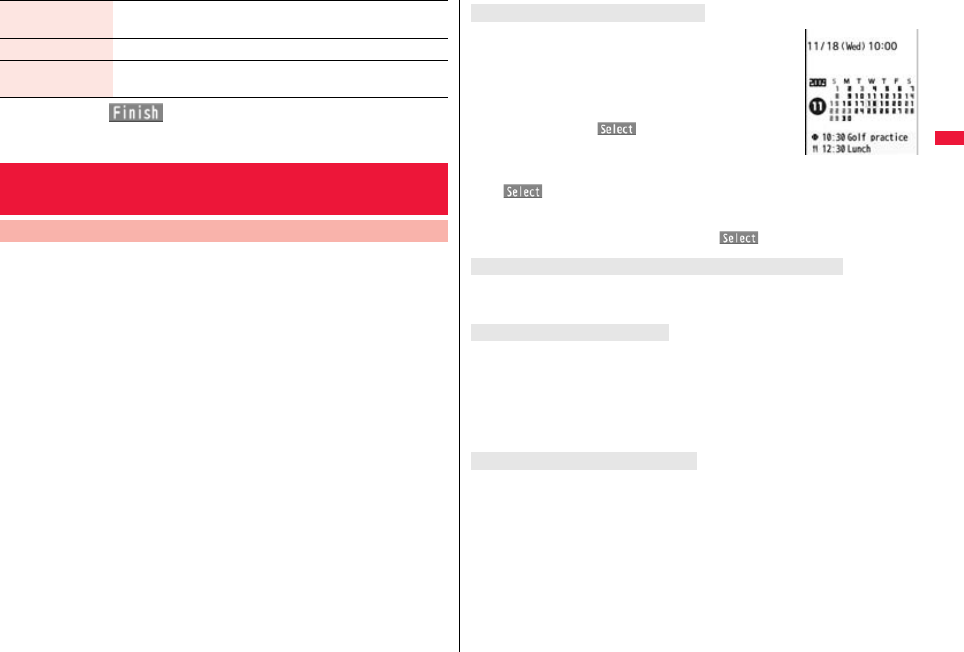
111
Sound/Screen/Light Settings
2Press l().
You can set an image for the Stand-by display. You can set also i-motion
movies shot by the FOMA terminal or downloaded from sites for the
Stand-by display.
1m1Set./Service1Display1Display setting
1Stand-by display1Select a type of image.
≥If you select “Calendar/schedule”, select a display format, and then select “BG
image ON” or “BG image OFF”. If you select “BG image OFF”, the setting is
completed.
≥If you select “iαppli display”, select an i-αppli program. The setting is completed.
2Select a folder1Select an image.
≥On the Stand-by display, the image smaller than the display is shown in
equivalent dimensions or enlarged to fit to the display size, depending on the
image size.
≥See page 201 when you select “Search by i-mode”.
Selector sound 1Select a pattern.
≥See page 107 for Speed Selector Sound.
Mic sensitiv. 1Normal or Up
LV alarm tone 1ON or OFF
≥See page 42 for LV Alarm Tone (low battery alarm).
+m-5-6
<Display Setting>
Changing Displays
Set Stand-by Display
You can display schedule events of the day (up to 10) or
calendar in the set format on the Stand-by display. You can
check the schedule events or calendar and can set schedule
events (see page 407) with ease.
You can access the schedule events or calendar by pressing
Oo from the Stand-by display. Highlight an item to be
operated and press Oo().
≥When you select a schedule event, you can confirm the
previous or next schedule events by pressing Bo.
You can display the detailed schedule display by pressing
Oo().
≥When you select the calendar, you can display the previous or next calendar by
pressing Mo.
You can set a schedule event by pressing Oo().
It is played back when you display the Stand-by display, press h from the Stand-by
display, or open the FOMA terminal. The first frame is displayed as the Stand-by display.
It is played back when you display the Stand-by display, press h from the Stand-by
display, or open the FOMA terminal. The image stopped such as by pressing h during
playback of a Flash movie is displayed as the Stand-by display.
≥When a Flash movie which shows a clock or the like is set, the date/time is not updated
during pause. When you play back the Flash movie by pressing h, the date/time is
corrected.
It is played back when you display the Stand-by display, press h from the Stand-by
display, or open the FOMA terminal. The first frame is displayed as the Stand-by display.
≥Press Bo or </> during playback to adjust the volume.
Press Oo, l, i, m, c, No, r, d, p or h to end the playback.
≥If you play back an i-motion movie during Manner Mode, the sound is not played back.
When Calendar/Schedule is set
When an original animation or animation GIF is set
When a Flash movie is set
When an i-motion movie is set
For
“Calendar+schedule”
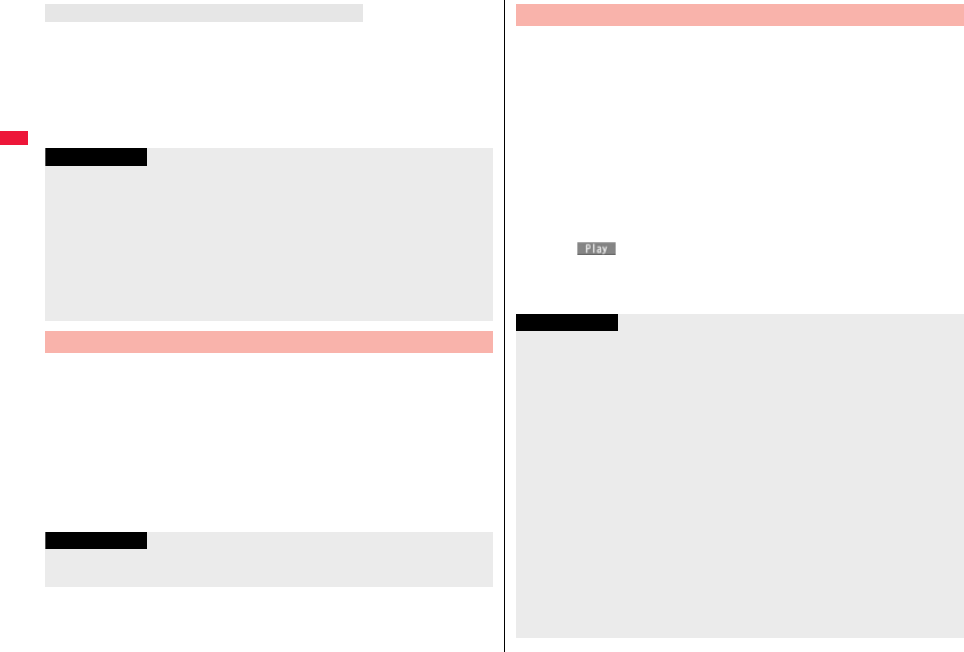
112
Sound/Screen/Light Settings
Press h from the Stand-by display.
Calendar, schedule events, status icons, notification icons, and desktop icons are
cleared. Press h again to show the icons and others.
When a Flash movie is set for the Stand-by display, however, the following operations
are performed:
・When you press h during playback of a Flash movie, the playback pauses.
Press h again to clear the icons and others.
You can set an image or message to be displayed for when the power is
turned on.
1m1Set./Service1Display1Display setting
1Wake-up display1Select a type of image.
≥If you select “Message”, enter a message. You can enter up to 50 full-pitch/100
half-pitch characters.
≥If you select “My picture” or “imotion”, go to step 2 of “Set Stand-by Display” on
page 111.
≥See page 201 when you select “Search by i-mode”.
Not to display icons on the Stand-by display
Information
≥The schedule list shows the today’s schedule events whose start time has not come,
and the today’s schedule events set as “All day”. Holidays are not displayed.
≥Some i-motion movies might not be correctly displayed.
≥You cannot set a still image larger than the Stand-by (480 x 854) size or in excess of
300 Kbytes for the Stand-by display.
≥You cannot set some images or i-motion movies for the Stand-by display.
≥The sound of Flash movies cannot be played back.
≥When you show the Stand-by display, the Flash movies such as a clock and the
animation GIF files stop moving after a certain period of playback.
Set the Wake-up Display
Information
≥You cannot set some images or i-motion movies for the Wake-up display.
≥The sound of Flash movies cannot be played back.
You can set an image for the Dialing/Call Receiving display, Mail
Sending/Mail Receiving display, and Checking display.
1m1Set./Service1Display1Display setting
1Select a type of display.
≥When “Incoming call” or “Videophone incoming” is selected, select “Select calling
disp.”.
≥When “Mail receiving” is selected, select “Select receiving disp.” and go to step 2
of “Set Stand-by Display” on page 111.
≥If you select “Dialing”, “Videophone dialing”, “Mail sending”, “Check new
messages”, or “Mail/msg. rcpt result”, go to step 2 of “Set Stand-by Display” on
page 111.
≥Select “Incoming call”, “Videophone incoming” or “Mail receiving” and press
l( ) to check the contents actually displayed or played back.
2Select a type of image.
Go to step 2 of “Set Stand-by Display” on page 111.
Set Displays for Dialing/Calling and Others
Information
≥When you select “Incoming call”, “Videophone incoming”, or “Mail receiving”, select
“Select ring tone” to set the ring tone. Go to step 2 on page 104.
≥The priority order of displays for call receiving is as follows: “Setting for Phonebook
entry” → “Group setting” → “Disp. PH-book image” → “Display setting”. However,
when “Incoming call” or “Videophone incoming” of “Read aloud settings” is set to
“ON”, the default image is displayed.
The same order applies if a call comes in to Number B while using 2in1. However,
when you set an i-motion movie containing video and sound for a ring tone
(Chaku-motion) by “Ringtone set. for No. B”, it is played back as Chaku-motion, taking
priority over this function.
≥When you set an i-motion movie containing video and sound for a ring tone
(Chaku-motion), it is played back for incoming calls, taking priority over this function.
However, if you set a voice-only i-motion movie, the image set by this function is
displayed.
≥When you set an i-motion movie containing video and sound for “Select calling disp.”,
the i-motion movie is played back taking priority over “Select ring tone” of “Incoming
call” for incoming calls. However, if you set an i-motion movie containing only video for
“Select calling disp.”, the ring tone selected for “Select ring tone” of “Incoming call” is
played back.
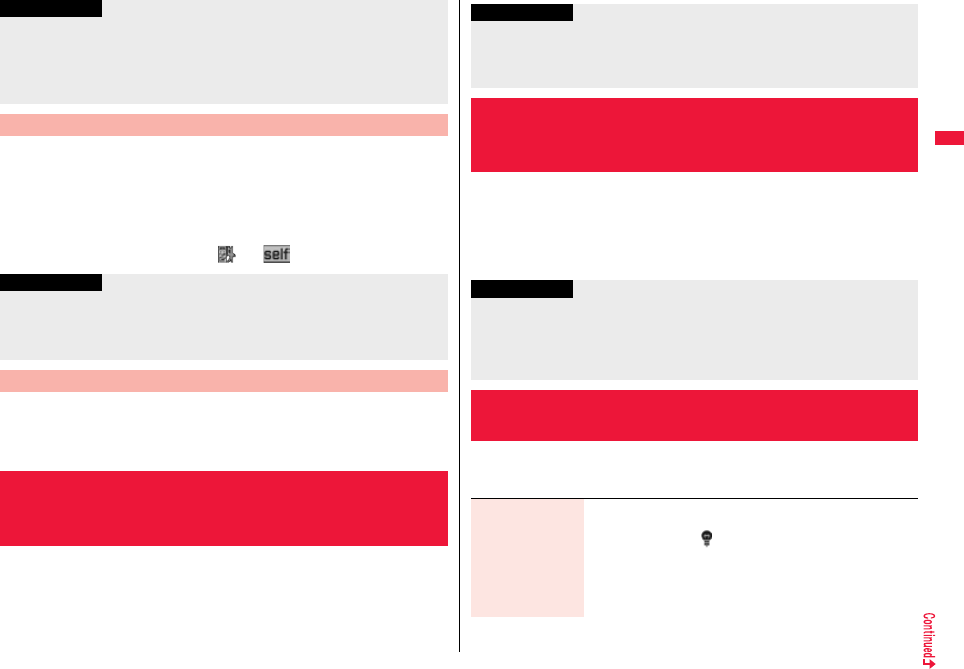
113
Sound/Screen/Light Settings
You can set the icons for battery level and radio wave reception level that
appear on the display.
1m1Set./Service1Display1Display setting
1Battery icon or Antenna icon1Select a folder
1Select an image.
≥You cannot change icons such as “ ” or “ ”.
1m1Set./Service1Display1Display setting
1Icon color1Color or Monochrome
≥You cannot change the battery icon and antenna icon.
If the caller ID notified by the caller matches the phone number stored in
the Phonebook, the still image stored in the Phonebook is displayed.
1m1Set./Service1Incoming call
1Disp. PH-book image1ON or OFF
≥The images or ring tone set at purchase might be displayed or played back for
incoming calls or messages, depending on the combination of this function and
“Select ring tone”.
≥You cannot set some images for “Display setting”.
≥The sound of Flash movies is not played back.
Set Battery Icon and Antenna Icon
Information
Information
≥The image you can set for battery icons is a GIF image of 42 x 25 dots.
(A battery icon is composed of an image of 14 x 25 dots.)
≥The image you can set for antenna icons is a GIF image of 44 x 50 dots.
(An antenna icon is composed of an image of 22 x 25 dots.)
Show Icons in Color/Monochrome
<Display Phonebook Image>
Displaying an Image Stored in Phonebook
during Ringing
When you have a missed call, new mail message, new chat mail message,
or new Message R/F, the detailed Missed Call display/Inbox list/Chat Mail
display/Message R/F list is displayed at opening the FOMA terminal.
1m1Set./Service1Display1Recv. mail/call at open
1ON or OFF
1m1Set./Service1Display1Backlight
1Do the following operations.
Information
≥The priority order of displays for call receiving is as follows: “Picture for Phonebook
entry” → “Picture for group” → “Image for Phonebook entry” → “Display setting”.
However, when “Incoming call” or “Videophone incoming” of “Read aloud settings” is
set to “ON”, the default image is displayed.
<Received Mail/Call at Open>
Displaying Arrival Information by Opening
FOMA Terminal
Information
≥When newly received messages and missed calls are found, the detailed Missed Call
display appears.
≥When a new mail message, chat mail, Message R/F are simultaneously received, the
messages are displayed in the order of the chat mail message, i-mode message,
Message R, and Message F.
+m-7-0
<Backlight>
Setting Lights for Display and Keypad
Lighting You can set whether to light the backlight in ordinary time.
1ON or OFF
≥If you set to “OFF”, “ ” appears on the Stand-by display.
Also, you can set whether to activate Power Saver Mode for the
display.
1ON or OFF 1Enter a light time (seconds).
≥Enter from “060” through “999” in three digits.
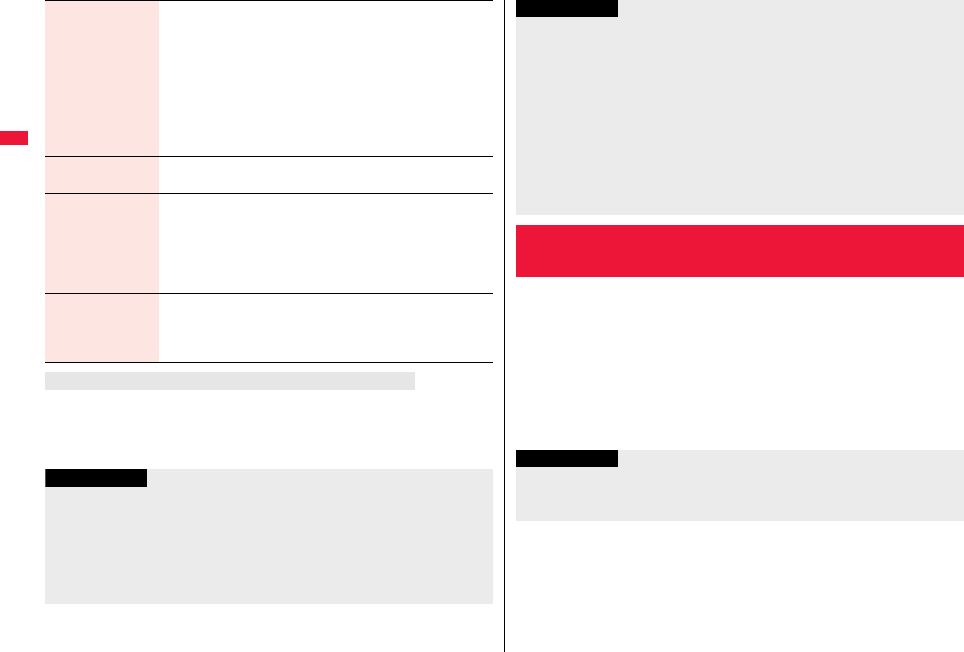
114
Sound/Screen/Light Settings
Press and hold 5 for at least one second.
≥While a Decome-Anime message is displayed, an i-αppli program is running, a Flash
movie is displayed, or you are entering characters, you cannot switch the backlight on/
off by pressing and holding 5 for at least one second.
Charging 1Standard or Long time light
Standard
. . . . . . . . . Lights during charging in the same setting as
it lights in ordinary time.
Long time
light
. . . When 15 seconds elapse without any
operation during changing, the backlight
switches to Level 1, and when 3 hours
elapse, it switches to Power Saver Mode.
≥When an AC adapter (option) or another device is connected,
the backlight lights following the setting of this function even
after charging is completed.
Area You can set the range the backlight lights in.
1LCD+Keys or LCD
Brightness You can adjust the brightness of the backlight for the display to
Level 1 (dark) through Level 5 (bright).
1Select a brightness level.
≥When “Auto setting” is set, the backlight set by “Area” is
automatically adjusted according to the ambient brightness that
has been detected by the light sensor.
Soft light You can set whether to light the backlight softly for the display.
1ON or OFF
≥Even if you set to “OFF”, the backlight might light softly for some
functions.
To switch the backlight on/off by pressing one key
Information
≥
When “Lighting” is set to “ON”, the backlight stays lit while a call is coming in and the
area specified by “Area” lights for about 15 seconds when you turn on the power, touch
the keys, or open the FOMA terminal. The backlight stays lit while the camera is
activated or a movie/i-motion movie is played back. When “OFF” is set, it does not light.
However, it stays lit during recording of a movie regardless of the “Lighting” setting.
≥See page 74 for Backlight during a videophone call.
≥See page 266 for Backlight for while watching a 1Seg program.
You can set whether to automatically adjust the brightness of the display
backlight and to compensate the image quality according to that
brightness during playback of i-motion movies, PC movies, Music&Video
Channel programs, or video files, during a videophone call, or while
watching a 1Seg program.
1m1Set./Service1Display1LCD AI1ON or OFF
≥If you operate the setting from the Function menu during a videophone call or
watching a 1Seg program, the setting is effective only for the current videophone
call or 1Seg program.
≥When you display the text of i-mode mail or Messages R/F, the lighting time varies
according to the length of the text.
≥If “Power saver mode” is set to “ON” and the specified time elapses without doing any
operations, the FOMA terminal switches to Power Saver Mode and the display goes
off. However, the FOMA terminal might not switch to Power Saver Mode depending
on the function in use.
≥When a Flash movie or an i-motion movie is set for the Stand-by display, the Stand-by
display changes to Power Saver Mode after ending the playback and a standby time
elapses.
≥The display appears when you operate the FOMA terminal, receive a call, or receive
i-Channel tickers. However, the receiving display does not appear when you receive a
call in Public Mode (Drive Mode).
<LCD AI>
Adjusting Quality of Display Automatically
Information
Information
≥If you set to “ON”, the brightness is adjusted within the level specified for “Brightness”
of “Backlight”. The brightness is adjusted also while you are selecting a menu item.
≥This function is disabled during Play Background.
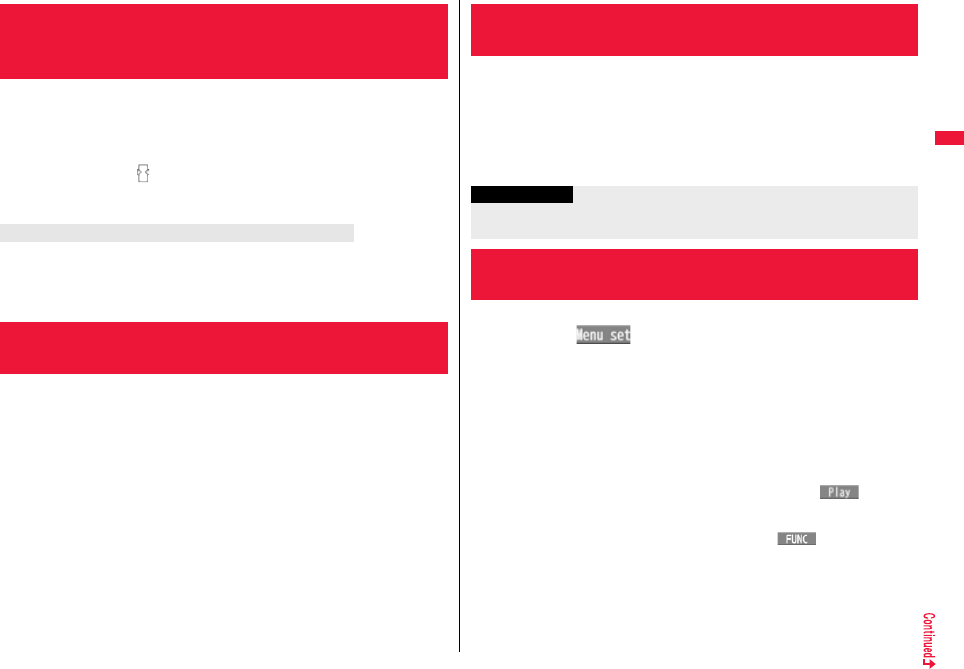
115
Sound/Screen/Light Settings
You can adjust the contrast of the display so that it is hardly viewed from
a slanted angle.
1m1Set./Service1Display1View blind1ON or OFF
1Select a contrast.
≥When “ON” is set, “ ” appears on the Stand-by display.
≥While selecting a contrast level, you can check the selected contrast on the
display.
Press and hold 8 for at least one second.
≥While a Decome-Anime message is displayed, an i-αppli program is running, a Flash
movie is displayed, a PDF file is displayed, or you are entering characters, you cannot
switch View Blind on/off by pressing and holding 8 for at least one second.
1m1Set./Service1Display1Image quality
1Select an item.
Normal. . . . . Normal image quality
Vivid. . . . . . . Vivid image quality
Dynamic . . . Dynamic image quality in which motion is emphasized
<View Blind>
Making Display Hard to See from People
Around
To switch View Blind on/off by pressing one key
<Image Quality>
Setting Quality of Display
You can set the display color pattern of characters, backgrounds, and so
on.
1m1Set./Service1Display1Color theme setting
1Select a color theme.
≥While selecting a color theme, you can check the selected color theme on the
display.
You can change the icons and the background images of Main Menu.
1m1l()1Select a pattern.
≥If you set “Simple menu”, Main Menu switches to a menu focusing on only basic
functions for easy operation. Some operating procedures or items which appear
on the display in Simple Menu differ from the ones described in this manual.
2When you select “Customize” in step 1, select a menu
icon or background image to be changed
1Select a folder1Select an image.
Repeat step 2 and set menu icons and a background image.
≥While selecting a menu icon or background image, press l( ) to confirm
the currently set image.
≥To reset the menu icon and background image set to “Customize” to “スタンダー
ド (Standard)” in the “Pre-installed” folder, press i( ) and select “Reset”
or “All reset”, then select “YES”.
≥See page 201 when you select “Search by i-mode”.
+m-8-6
<Color Theme Setting>
Setting Color Combination for Display
Information
≥You cannot change the color for icons and images displayed in multiple colors, the
DOCOMO pictograms, and the Internet web pages (sites) supporting i-mode.
+m-5-7
<Menu Icon Setting>
Setting Display of Main Menu
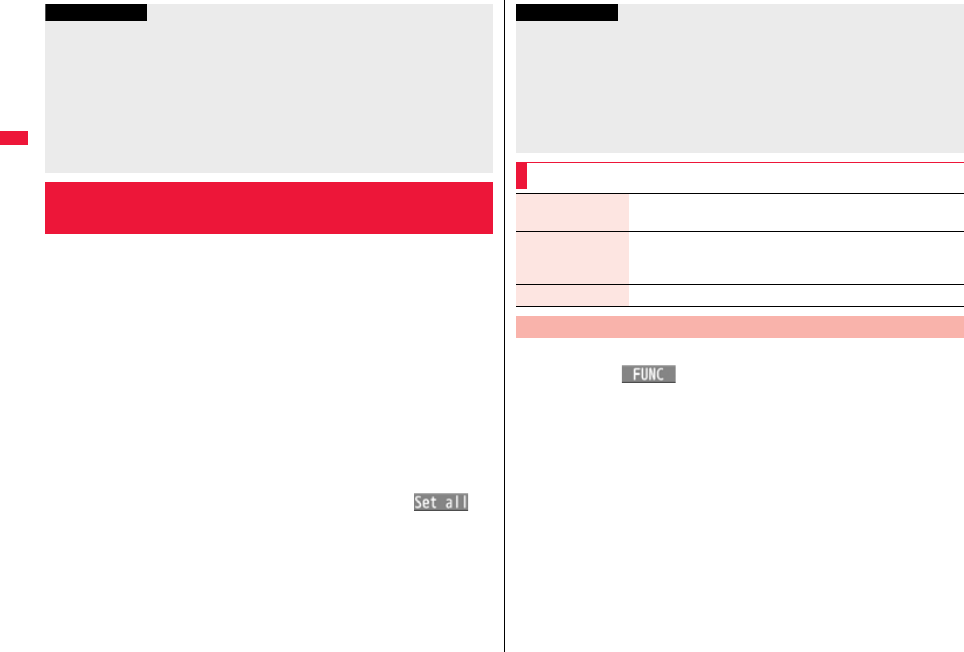
116
Sound/Screen/Light Settings
You can use Kisekae Tool to change the ring tone, Stand-by display,
menu icons and others at a time.
≥See page 200 for details on how to download Kisekae Tool files.
≥See page 367 for the operation from Data Box.
■Items that can be set with Kisekae Tool
≥Items that can be set differ depending on the Kisekae Tool file.
≥The setting change of phone/videophone ring tones, mail ring tone, Stand-by display,
and clock is applied only to the A Mode of 2in1. The other changes are applied to the
all modes of 2in1.
1m1Set./Service1Kisekae
1Highlight a Kisekae Tool file and press l()
1YES
≥“★” is added to the Kisekae Tool file collectively set at the moment.
≥Depending on the selected Kisekae Tool file, the confirmation display might
appear asking whether to change the font size. When you select “NO”, you might
not be able to set the Kisekae Tool file correctly.
Information
≥The image you can set for “Customize” is a JPEG or GIF image whose size is
Stand-by (480 x 854) or smaller and up to 300 Kbytes. Perform “Change size” or “Trim
away” for other images.
≥When the image you set “Customize” is deleted, “スタンダード (Standard)” in the
“Pre-installed” folder returns.
≥When Personal Data Lock is activated while “Customize” is set, the default image is
displayed.
≥When you set “Customize”, the main menu icons do not switch even if you switch
“Select language”.
<Kisekae Tool>
Using Kisekae Tool
・Select ring tone
・Display setting
・Color theme setting
・Menu icon setting
・Font
・Ticker font size set.
・Ticker color set.
・Ticker scroll speed
・Positioning ring tone
・Tone
You can reset the items changed by Kisekae Tool.
1m1i()1Reset
1Enter your Terminal Security Code1Select an item.
Reset disp. /sound . . . . Resets all of “■Items that can be set with Kisekae Tool”
to the default.
Reset menu screen. . . . Resets Main Menu to the default. You can reset also by
pressing and holding r for at least one second from
the Stand-by display and selecting “YES”.
Reset menu log . . . . . . .Resets the operation records of Main Menu to the
default.
Information
≥For the functions set by Kisekae Tool, each setting display is shown with “Follow
Kisekae Tool” highlighted. You can separately change each setting, however, if you
want to reset to the setting by Kisekae Tool, you need to perform collective settings
again. You cannot select “Follow Kisekae Tool”.
≥If you use Kisekae Tool to change the design of the Menu display, some menu
configurations change according to the usage frequency depending on the type of the
menu. Further, some menu numbers that are assigned to the menu items do not
apply.
Function Menu of Main Menu
Change launcher You can manually replace the items on Main Menu.
1Select a destination to save to1YES
Disp. default MENU You can temporarily show Main Menu of “Normal”.
≥Once you close Main Menu of “Normal”, the currently set Main
Menu returns.
Reset See page 116.
Reset Changed Design
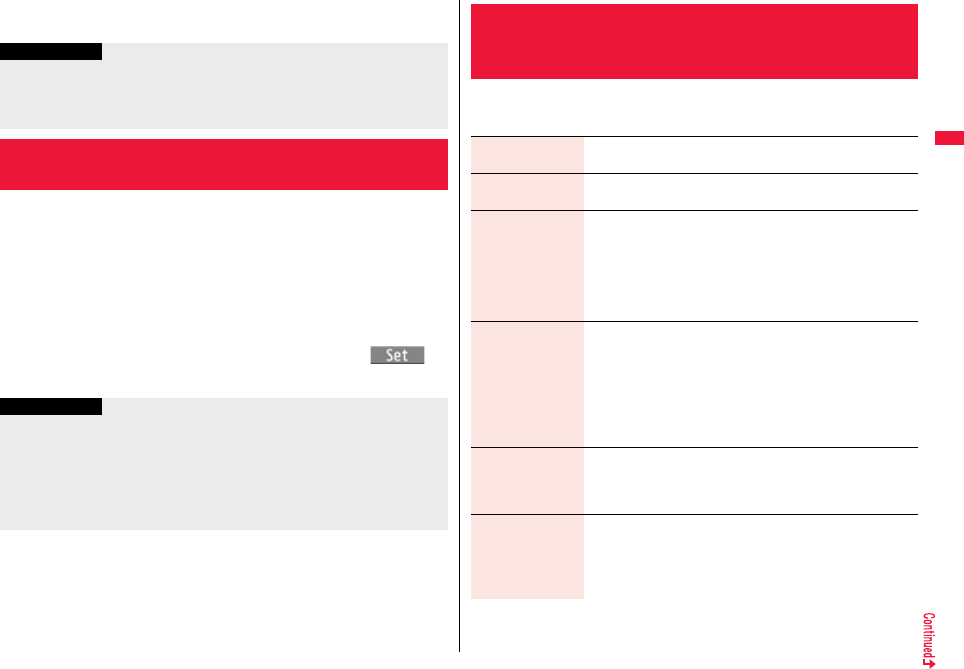
117
Sound/Screen/Light Settings
2YES
When Machi-chara is set, a Machi-chara image appears on the Stand-by
display to tell you missed calls, new mail messages, new i-concier
information and others.
≥See page 200 for downloading Machi-chara images.
≥See page 363 for the operations from Data Box.
1m1Set./Service1Display1Machi-chara
1Set to Machi-chara
≥To release Machi-chara, select “Release Machi-chara”.
2Highlight a Machi-chara image and press l().
≥“★” is added to the currently set Machi-chara image.
Information
≥Even if you perform “Reset disp. /sound” or “Reset menu screen”, you cannot reset
“Font size”.
≥Even if you execute “Reset menu screen”, the Main Menu items you have manually
replaced by “Change launcher” are not reset.
<Set to Machi-chara>
Setting Machi-chara Image
Information
≥The Machi-chara image is not displayed in the following cases:
・During Lock All ・During Personal Data Lock ・During Omakase Lock
・While an icon or another is selected on the Stand-by display
≥Some Machi-chara images change their appearance according to the elapsed time,
total calls duration, and number of mail messages sent/received after setting. If you
move these Machi-chara images to the microSD card or execute “Reset all info”, they
return to the default state.
1m1Set./Service1Illumination
1Do the following operations.
<Illumination>
Setting Color of Call/Charging Indicator
and Others
All illum. setting You can set all illumination items at one time.
1Select a pattern.
Incoming
illumination
See page 118.
Illumination in talk You can set the illumination for during a call.
1Select an item.
≥While selecting an item, you can check the flickering of the Call/
Charging indicator.
≥It flickers in the same color while Record Message is working,
during answer-hold (On Hold), or while a call is on hold
(Holding).
Missed/unread
illum.
The Call/Charging indicator flickers at about 5-second interval for
about 3 hours for missed calls, new mail messages, new chat
mail messages, new Messages R/F, i-αppli calls you did not reply
to, or new i-concier information.
1ON or OFF
≥It does not flicker in Public Mode (Drive Mode), during Lock All,
and during Omakase Lock. Flickering does not resume even
after Public Mode (Drive Mode) or each lock is released.
Music&Video Ch
illum.
The Call/Charging indicator flickers at about 5-second interval for
about 30 minutes when obtaining Music&Video Channel
programs is completed.
1ON or OFF
Slide illumination You can set the illumination for when you open (Slide open) and
close (Slide close) the FOMA terminal.
1Slide open or Slide close1Select an item.
≥While selecting an item, you can check the flickering of the Call/
Charging indicator.
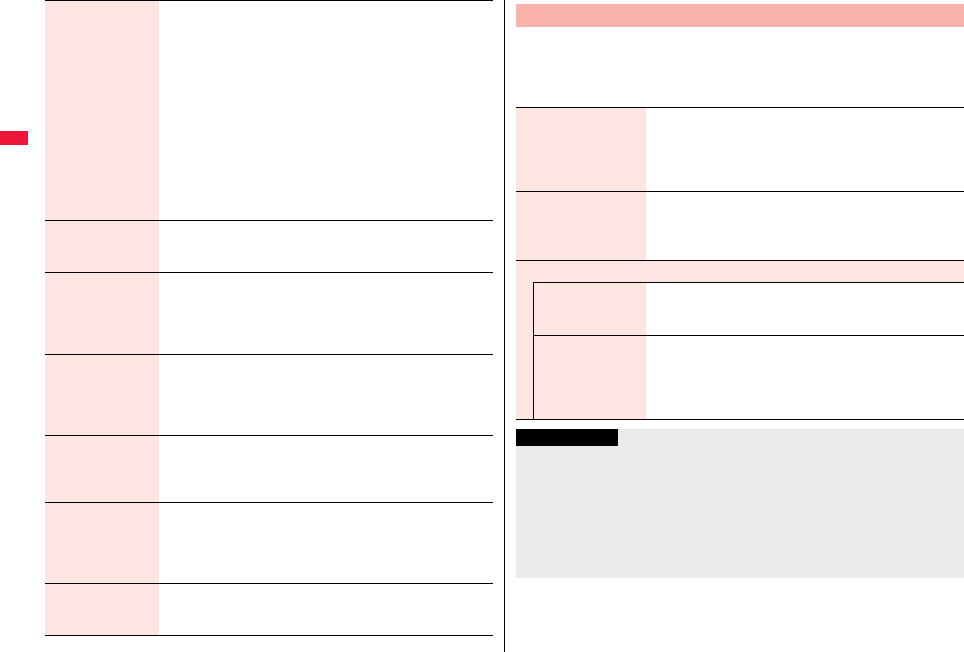
118
Sound/Screen/Light Settings
Hourly illumination You can be notified of the specified time (every hour at 0 minutes)
by the tone and light of the Call/Charging indicator.
1Select a pattern.
OFF. . . . . . . The Call/Charging indicator does not light.
Pattern 1. . . A fixed tone sounds and the Call/Charging indicator
lights in the fixed color.
Pattern 2. . . The tone and light of the Call/Charging indicator
change by time.
≥While selecting a pattern, you can check the lighting of the Call/
Charging indicator and the time tone.
≥“Hourly illumination” does not work while a display other than
the Stand-by display is shown, or Lock All or Omakase Lock is
activated.
≥Time tone sounds at the volume set for “Phone” of “Ring
volume”. It sounds at Level 2 when “Step” is set.
MUSIC illumination The Call/Charging indicator flickers when you start playback by
MUSIC Player.
1ON or OFF
Bluetooth
illumination
The Call/Charging indicator flickers during connecting to
Bluetooth devices.
1ON or OFF
≥It flickers at about 5-second interval for about 5 minutes when
the connection is completed.
IC card illumination The Call/Charging indicator lights/flickers when you place the
FOMA terminal over an IC card scanning device or during iC
communication.
1ON or OFF
≥It does not light/flicker during IC Card Lock.
PushTalk
illumination
The Call/Charging indicator lights/flickers when you try to get the
PushTalk talker’s right, or when a member’s state changes to
“Connected”.
1ON or OFF
Speed selector
illum.
You can set the illumination for when you rotate the speed
selector.
1Select an item.
≥While selecting an item, you can check the flickering of the Call/
Charging indicator.
Check settings You can check the setting contents for “Incoming illumination”,
“Illumination in talk”, “Slide illumination”, “Hourly illumination” and
“Speed selector illum.”.
You can set an illumination for each incoming type.
1m1Set./Service1Illumination1Incoming illumination
1Do the following operations.
+m-8-9
Incoming Illumination
Select color 1Select an incoming type1Select an item.
≥To make the indicator light in colors “Color 1” to “Color 12” in
order, select “Gradation”.
≥While selecting an item, you can check the lighting/flickering
of the Call/Charging indicator.
Set pattern You can set the lighting pattern of the Incoming Illumination.
1Select a pattern.
Standard . . . . . . . . . Lights in the same pattern repeatedly.
Melody linkage. . . . Lights with the ring tone.
Color setting
Edit color name 1Select a color1Enter a name.
≥You can edit “Color 1” through “Color 12” only.
≥You can enter up to 10 full-pitch/20 half-pitch characters.
Adjust color tone 1Select a color1Adjust the color tone.
≥You can adjust the color tone of “Color 1” through “Color 12”
only.
≥Use Bo to select a color and use No to change the color
tone.
Information
<Select color>
≥The priority order of incoming illumination is; “Setting for Phonebook entry” → “Group
setting” → “Select color”.
<Set pattern>
≥The Call/Charging indicator lights in specified pattern for each illumination when
“Select color” is set to other than “Color 1” through “Color 12” and “Gradation”.
≥The Call/Charging indicator lights by “Standard” when an i-motion movie or melody
with no flickering pattern is set for the ring tone.
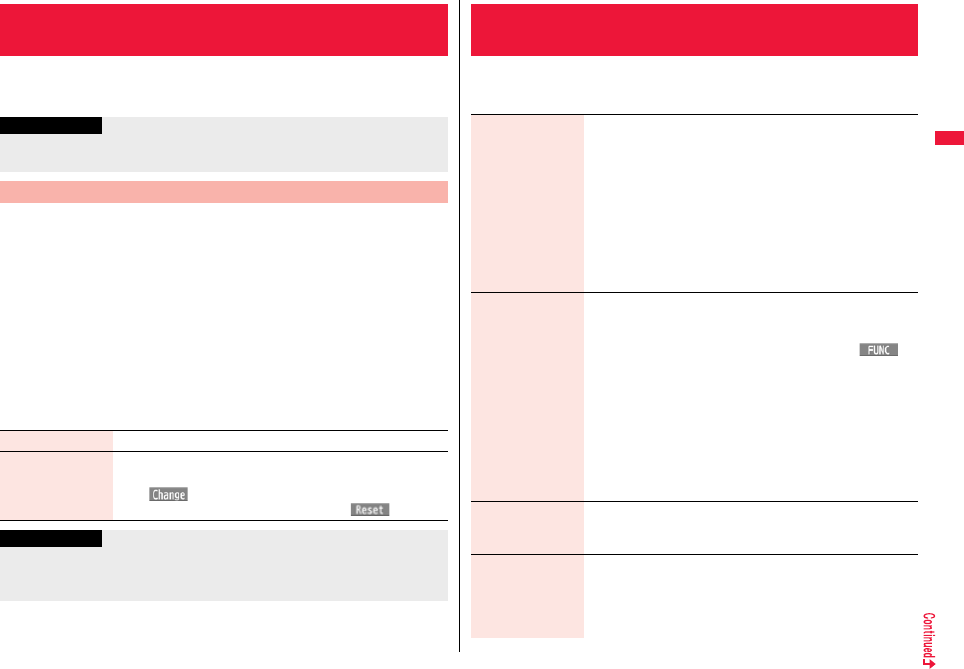
119
Sound/Screen/Light Settings
1m1Set./Service1Display1Font
1Font 1, Font 2, or Font 3
You can set the font and color of names stored in the Phonebook and
phone numbers displayed on the following displays:
■Font of dial number
・Dialing/Call Receiving display ・Dialed Calls/Received Calls/Detailed Redial display
・Detailed Sent Chaku-moji message
■Font color
・Dialing/Call Receiving/Talking display ・Dialed Calls/Received Calls/Redial
・Detailed Sent Chaku-moji message ・Sent/Received Address list
≥When you use 2in1, the setting here applies to Number A. To specify for Number B,
operate “Disp. call/receive No.” of “2in1 setting”.
1m1Set./Service1Incoming call1Disp. call/receive No.
1Do the following operations.
+m-6-6
<Font>
Changing Character Font
Information
≥Some characters are displayed in “Font 1” regardless of the setting of this function.
≥You cannot change the font of a phone number entry or clock display.
Set Character Font and Color of Phone Numbers
Font of dial number 1Select a pattern.
Font color 1Select a color.
≥You can switch between 16 color and 256 color by pressing
c().
≥You can reset the set color by pressing i().
Information
≥If you change the background color by “Color theme setting” or “Kisekae Tool”, the
font color automatically changes as well.
≥You cannot change the color of pictograms.
1m1Set./Service1Display1Font size
1Do the following operations.
<Font Size>
Changing Font Size
Set at one time You can set all the changeable items such as font size at a time.
1Extra large, Large, Standard, or Small
≥The confirmation display might appear asking whether to
change the font size of the menu as well. When you select
“YES”, the menu icons are changed to “Pearl White (Enlarge)”
while “Extra large” or “Large” is set, and they are changed to
“Normal” while “Standard” or “Small” is set.
≥When “Extra large” is set, “Phonebook” and “Dialed/recv. calls”
are set to “Large”.
≥When “Small” is set, “Phonebook” and “Dialed/recv. calls” are
set to “Standard”.
Mail You can set the font size for the detailed mail display, detailed
Message R/F display and for “Mail settings”.
1Extra large, Large, Standard, or Small
≥While the detailed mail display is shown, press i() to
select “Display” and then select “Font size”. You can change the
font size also by pressing 3, or pressing and holding No for
at least one second.
However, another mail message is displayed when you press
and hold Vo for at least one second while “Extra large” is set,
or you press and hold Co for at least one second while “Small”
is set.
≥You cannot change the font size of the Decome-Anime text or
Deco-mail pictograms.
i-mode You can set the font size for sites, “i-mode settings” and “Full
Browser settings”.
1Extra large, Large, Standard, or Small
Phonebook You can set the font size for the Phonebook and “Phonebook
settings”.
1Large or Standard
≥You can set also by m1Phonebook1Phonebook settings
1Font size1Phonebook.
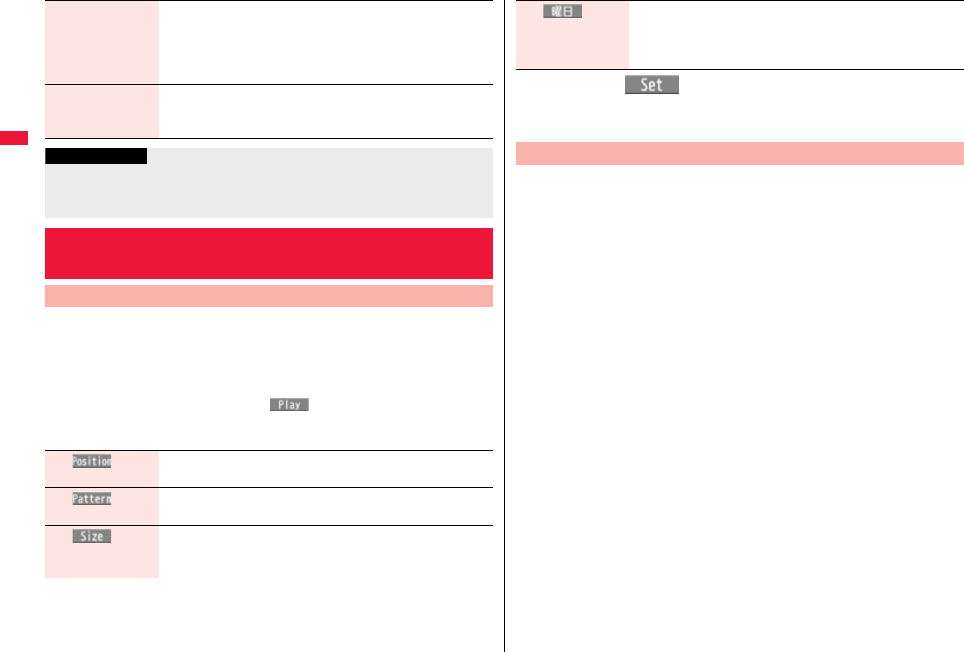
120
Sound/Screen/Light Settings
You can set whether to display the clock on the Stand-by display and can
set its display pattern.
1m1Set./Service1Display1Display setting1Clock
1Stand-by clock1Do the following operations.
≥During operation or by pressing l( ) while “Stand-by clock” is
highlighted, you can check the clock actually displayed. However, it might differ
from the actual one depending on the setting of each function.
Dialed/recv. calls You can set the font size for the Redial, Dialed Calls, Received
Calls, Sent Address and Received Address.
1Large or Standard
≥You can set also by m1Phonebook1Phonebook settings
1Font size1Dialed/recv. calls.
Character input You can set the font size for the character entry display, Message
Composition display, or SMS Composition display.
1Extra large, Large, Standard, or Small
Information
≥Depending on the function, characters might not be displayed in the set size.
≥When “Extra large” or “Large” is set, some items displayed for each operating
procedure differ from the ones displayed for when “Standard” or “Small” is set.
+m-5-6
Setting Clock Display
Set Stand-by Clock Display
+l()
Position
You can set the clock position.
1Select a pattern.
+i()
Pattern
You can set the display pattern of the clock.
1Select a pattern.
+m()
Display size
1Largest, Large, or Small
≥You cannot change the clock size of World Time Watch and the
sub clock.
2Press Oo().
≥The setting of this function might not be reflected depending on the settings of
other functions or the condition of the FOMA terminal.
You can set a display pattern of Icon Clock at the upper right of the
display (lower right of the horizontal display).
1m1Set./Service1Display1Display setting1Clock
1Icon clock1Select a pattern.
+c()
Day of week
When “Select language” is set to “日本語 (Japanese)”, you can
select “日本語 (Japanese)” or “英語 (English)”.
≥If you set to “英語 (English)”, the region names of World Time
Watch are displayed in English as well.
Set Icon Clock Display

121
Security Settings
Security Code
Security Codes Used for FOMA Terminal . . . . . . . . . . . . . . . . . 122
Changing Terminal Security Code
. . . . . . . . . . . . . . . . . . . . . . . . . . . . . . <Change Security Code> 123
Setting PIN Code. . . . . . . . . . . . . . . . . . . . . . . . . .<UIM Setting> 123
Releasing PIN Lock . . . . . . . . . . . . . . . . . . . . . . . . . . . . . . . . . . . 124
Restricting Operations and Functions on Mobile Phone
Restricting Others from Using . . . . . . . . . . . . . . . . .<Lock All> 124
Using Omakase Lock . . . . . . . . . . . . . . . . . . . <Omakase Lock> 125
Using Self Mode . . . . . . . . . . . . . . . . . . . . . . . . . . . <Self Mode> 126
Hiding Phonebook Entries and Schedule Events
. . . . . . . . . . . . . . . . . . . . . . . . . . . . . . . . . <Personal Data Lock> 126
Setting a Variety of Locks . . . . . . . . . . . . . . . . . <Lock Setting> 127
Using Face Reader . . . . . . . . . . . . . . . . <Face Reader Setting> 128
Locking Keypad Dial . . . . . . . . . . . . . . . . .<Keypad Dial Lock> 131
Restricting Key Operation . . . . . . . . . . . . . . . . . . . .<Key Lock> 131
Restricting Outgoing/Incoming Calls or Messages
Setting not to Display Redial/Received Calls
. . . . . . . . . . . . . . . . . . . . . . . . . . . . . . . . . .<Record Display Set> 132
Protecting Phonebook Entries and Schedule Events from
Prying Eyes . . . . . . . . . . . <Secret Mode> <Secret Data Only> 132
Applying Secret for Mail in Mailbox . . . .<Secret Mail Display> 133
Setting not to Display Mail in Mailbox without Permission
. . . . . . . . . . . . . . . . . . . . . . . . . . . . . . . . . . . . . . . <Mail Security> 133
Setting Restrictions on Phonebook Entries . . .<Restrictions> 133
Setting Response to Incoming Calls without Caller ID
. . . . . . . . . . . . . . . . . . . . . . . . . . . . . . . <Call Setting without ID> 135
Delaying Start of Ringing Operation . . . . . . . . . . <Ring Time> 135
Rejecting Incoming Calls from Phone Numbers which are not
Stored in Phonebooks . . . . . . . . . . . . . . . . <Reject Unknown> 136
Using Data Security Service . . . . . . . .<Data Security Service> 136
Resetting Function Settings . . . . . . . . . . . . . <Reset Settings> 138
Deleting Saved Data All at Once. . . . . . . . . . . . . . . . <Initialize> 138
Resetting Data by Remote Control. . . . . . . . . <Remote Reset> 139
Other Security Settings
Other Security Settings . . . . . . . . . . . . . . . . . . . . . . . . . . . . . . . . 140
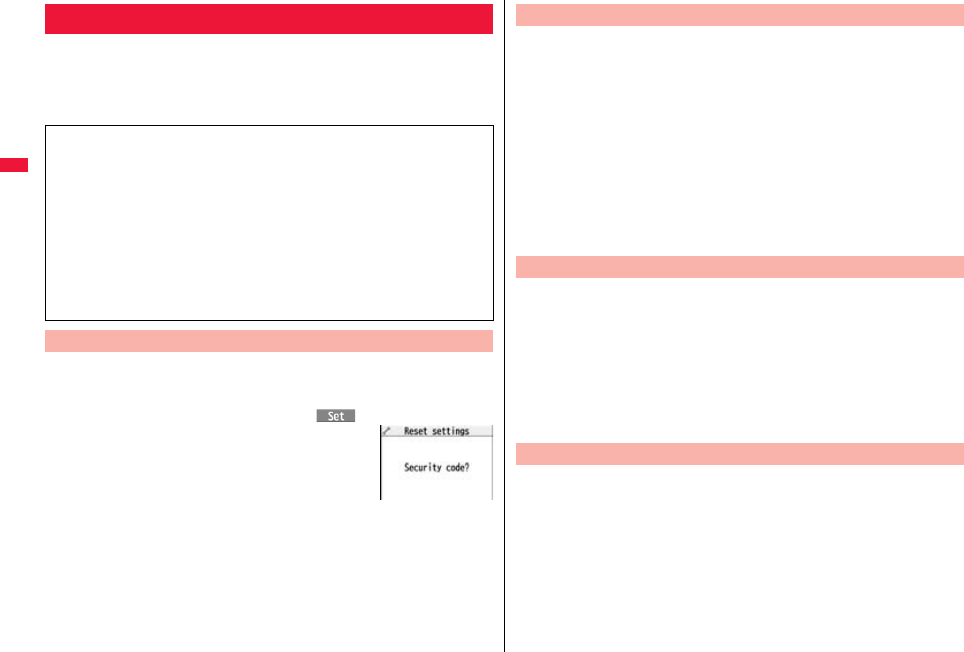
122
Security Settings
For some functions of the FOMA terminal, you need to enter your
security code. In addition to the Terminal Security Code for operating
respective mobile phone functions, the Network Security Code to use
network services, and i-mode password are available. These security
codes help you utilize your FOMA terminal.
The Terminal Security Code is set to “0000” at purchase but you can
change it by yourself. (See page 123)
When the display for entering the Terminal Security Code appears, enter
your four- to eight-digit code and press Oo().
≥When you enter your Terminal Security Code, the entered
numbers are indicated by “_” and not displayed.
≥If you have entered wrong numbers or nothing for about 15
seconds, a warning tone sounds and a warning message is
displayed; then the display prior to entering the Terminal
Security Code returns. Check the correct code and retry entering numbers.
Security Codes Used for FOMA Terminal
■Cautions on security codes
≥You should avoid using the numbers for security codes such as denoting your birth
date, part of your phone number, local address number, room number, “1111” or
“1234” that is easily decoded by a third party. Also make sure that you take a note of
the security codes you have selected just in case you forget them.
≥Take care not to let others know your security codes. Even if your security codes are
known and used by a third party, we at DOCOMO take no responsibility in any event
for the resultant loss.
≥If you do not remember your respective security codes, you need to bring an
identification card such as your driver’s license, the FOMA terminal and UIM to the
handling counter of a docomo shop.
For details contact “docomo Information Center” on the back page of this manual.
Terminal Security Code
This is a four-digit number required for your identification to give orders
at a docomo shop, docomo Information Center, or “各種お申込・お手続
き (Respective applications/ procedures)” site, or when you use
respective network services. This is determined at the time of contract
but can be changed by yourself.
If you have “docomo ID/Password” for “My docomo”, the overall support
site for personal computers, you can use a personal computer to take
proceedings of changing your Network Security Code to new one.
Further, you can change it by yourself from “各種お申込・お手続き
(Respective applications/procedures)” of “お客様サポート (User
support)” from i-mode.
※
For “My docomo” and “
各種お申込・お手続き
(
Respective
applications/
procedures)”, see the inside of the back page of this manual.
You need to enter the four-digit “i-mode password” for registering or
deleting My Menu, applying for or canceling Message Services, i-mode
pay service, and so on. (Some information providers may provide you
with their specific password.)
The i-mode password is “0000” at the time of your contract, but you can
change it by yourself. (See page 195)
From i-mode, you can change the i-mode password by following
operation:
“iMenu” → “English” → “Options” → “Change i-mode Password”
For the UIM, you can set two security codes, namely the PIN1 code and
PIN2 code. These security codes are “0000” at the time of your contract,
but you can change them by yourself. (See page 124)
The PIN1 code is a four- to eight-digit number for checking the user each
time the UIM is inserted into the FOMA terminal or each time the FOMA
terminal is turned on, so that you can prevent the third party from using
your UIM. By entering your PIN1 code, you can make or answer calls, or
use functions in the FOMA terminal.
The PIN2 code is a four- to eight-digit number for executing Reset Total
Cost, using the user certificate or applying for the issue of it, etc.
Network Security Code
i-mode Password
PIN1 Code/PIN2 Code
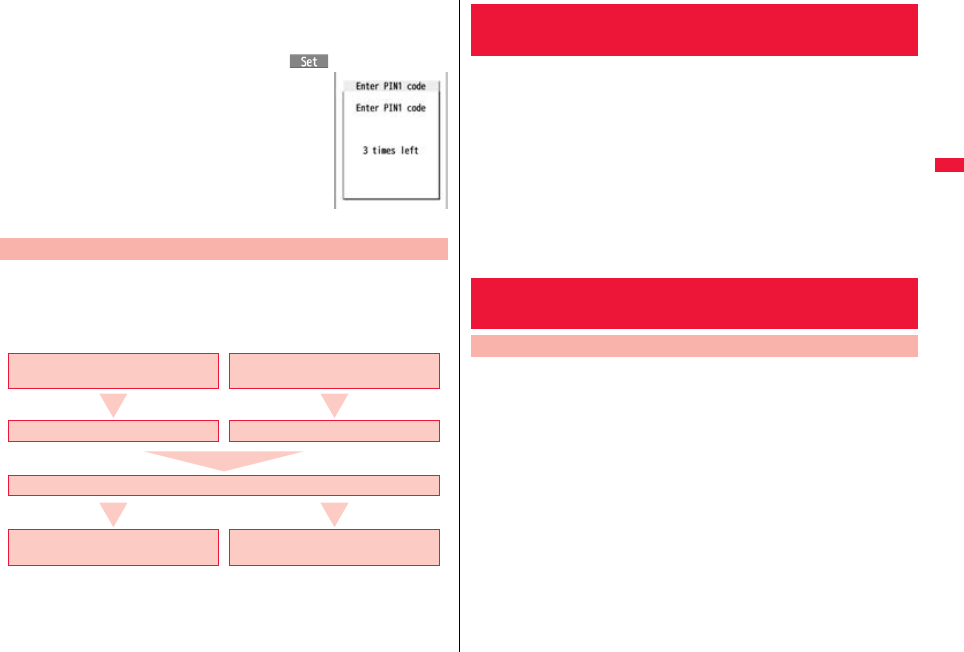
123
Security Settings
≥If you purchase a new FOMA terminal and use the existing UIM with the new FOMA
terminal, use the PIN1 code and PIN2 code you have set previously.
When the PIN1 Code/PIN2 Code Entry display appears, enter your four- to
eight-digit PIN1 code/PIN2 code and press Oo().
≥The entered PIN1 code/PIN2 code is displayed as “_”.
≥If you enter a wrong PIN1 code/PIN2 code three times in
succession, it is locked and the FOMA terminal cannot be
used. (The remaining number of times you can enter appears
on the display.)
When you enter the correct PIN1 code/PIN2 code, the
remaining number of times you can enter will return to three
times.
≥You can make emergency calls at 110/119/118 even from
the PIN1/PIN2 Code Entry display.
The PUK (PIN unblock code) is the eight-digit number for releasing the
PIN1 code and PIN2 code lock state. You cannot change this code by
yourself.
≥If you enter a wrong PUK (PIN unblock code) 10 times in succession, the UIM is
locked.
PUK (PIN Unblock Code)
For PIN1 code
Wrong entry 3 times in succession
Entry OK
Wrong entry 10 times
in succession
Security when the power turns on
Set new PIN code Consult the handling
counter of a docomo shop
Enter PUK (PIN unblock code)
Enter PIN1 code Enter PIN2 code
Operation of user certificate
Connecting to FirstPass sites
Change the default for the Terminal Security Code required for operating
functions to your own four- to eight-digit code so that you can make full
use of the FOMA terminal. Make sure you take a note of the security code
you have changed just in case you forget it.
1m1Set./Service1Lock/Security
1Change security code
1Enter the current Terminal Security Code.
≥If you enter the code for the first time, enter “0000”.
2Enter a new Terminal Security Code (four to eight digits)
1YES
You can set the FOMA terminal not to work unless you enter your PIN1
code when turning on the power.
1m1Set./Service1Lock/Security1UIM setting
1Enter your Terminal Security Code
1PIN1 code entry set1ON or OFF
1Enter the PIN1 code.
≥See page 122 for the PIN1 code.
+m-2-9
<Change Security Code>
Changing Terminal Security Code
<UIM Setting>
Setting PIN Code
PIN1 Code Entry Set
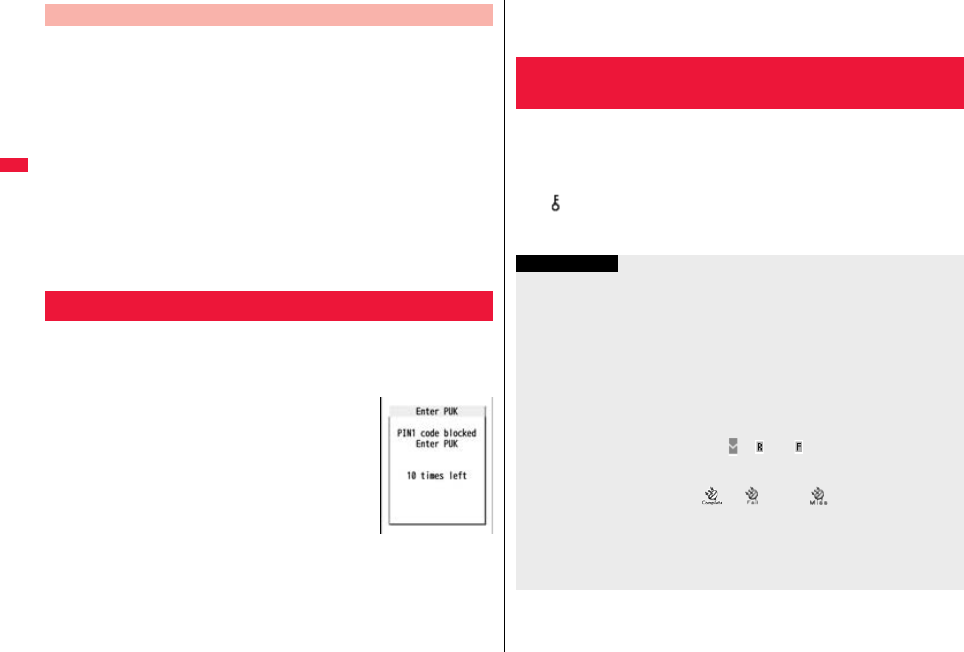
124
Security Settings
You need to have set “PIN1 code entry set” to “ON” to change the PIN1
code.
1m1Set./Service1Lock/Security1UIM setting
1Enter your Terminal Security Code
1Change PIN1 code or Change PIN2 code
1Enter the current PIN1 code/PIN2 code.
≥See page 122 for the PIN1 code/PIN2 code.
2Enter a new PIN1 code/PIN2 code (four to eight digits).
≥The entered PIN1 code/PIN2 code is displayed as “_”.
3Enter the new PIN1 code/PIN2 code again.
If you enter a wrong PIN1 code/PIN2 code three times in succession on
the display requiring its entry, it is locked and the FOMA terminal cannot
be used. In this case, release the PIN1 code/PIN2 code lock and set a new
PIN1 code/PIN2 code.
1Enter the PUK (PIN unblock code)
(eight digits).
≥The entered unblock code is displayed as “_”.
≥You can make emergency calls at 110/119/118 even
from the PUK Entry display.
2Enter a new PIN1 code/PIN2 code (four to eight digits).
≥The entered PIN1 code/PIN2 code is displayed as “_”.
Change PIN1 Code/Change PIN2 Code
Releasing PIN Lock
3Enter the new PIN1 code/PIN2 code again.
If you set Lock All, you can do no operations other than answering calls
and turning on/off the power.
1m1Set./Service1Lock/Security1Lock all
1Enter your Terminal Security Code.
“ ” and “Lock all” appear and Lock All is set.
≥To release Lock All, enter your Terminal Security Code from the Stand-by
display. Even if you turn off the power, Lock All will not be released.
<Lock All>
Restricting Others from Using
Information
≥You cannot make calls during Lock All. However, you can make emergency calls at
110/119/118. Select “YES” from the confirmation display for dialing.
≥You can receive calls, but the callers’ data such as their names and images stored in
the Phonebook are not displayed except for their phone numbers. Further, the default
ring tone sounds.
≥GPS Location Provision is available even during Lock All.
≥If you fail to release Lock All five times in succession, the power to the FOMA terminal
turns off. However, you can turn it on again.
≥You can receive mail messages or Messages R/F during Lock All; however, the
Receiving or Reception Result display for incoming mail messages and Messages R/
F does not appear. The icons such as “ ”, “ ”, or “ ” appear after Lock All is
released.
≥During Lock All, the notification icons, desktop icons, and schedule events are not
displayed on the desktop except “ ”, “ ”, and “ ”. When Lock All is
released, they are displayed.
≥The tickers of i-Channel are not displayed during Lock All.
≥The default Wake-up display appears during Lock All even when an i-motion movie
has been set for the Wake-up display.
≥Even if you set Lock All, IC Card Lock is not activated.
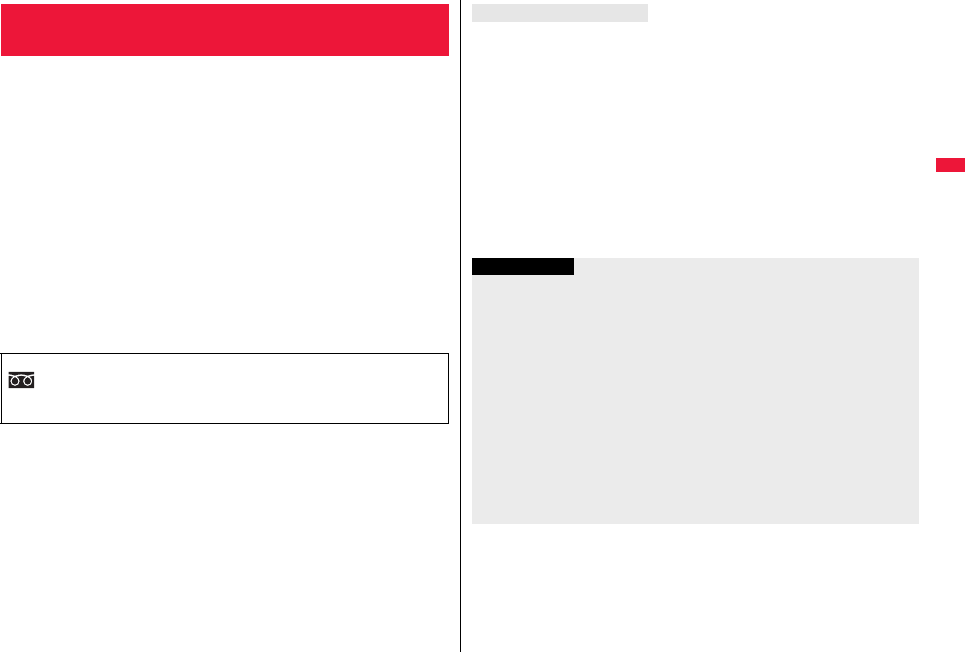
125
Security Settings
When you have lost your FOMA terminal or in other cases, you can lock
your personal data (such as Phonebook entries) and the IC Card function
of Osaifu-Keitai by contacting DOCOMO. Omakase Lock protects your
important privacy and Osaifu-Keitai. Also, if Omakase Lock cannot be set
at subscription but the communication to your FOMA terminal becomes
available within one year, the lock will be automatically set. However, if
you cancel the contract, halt getting the service, change your phone
number, or change your contract to mova, the lock will not be
automatically set even within one year.
To release the lock, contact DOCOMO by phone, etc.
※Omakase Lock is a pay service. However, you are not charged if you apply for this
service at the same time as applying for the suspension of the line or during
suspension, or if you are a member of DOCOMO Premier Club. Further, if you have
signed up for Keitai Anshin Pack (Mobile Phone Security Package), you can use
Omakase Lock within the flat-rate fee of Keitai Anshin Pack (Mobile Phone Security
Package).
※Even during Omakase Lock, your FOMA terminal corresponds to the location
provision request of GPS function if “Location request set.” is set for permission.
≥For details on Omakase Lock, refer to “Mobile Phone User’s Guide [i-mode] FOMA
version”.
<Omakase Lock>
Using Omakase Lock
■Setting/Releasing Omakase Lock
0120-524-360 Business hours: 24 hours
※You can set/release also from My docomo site via a personal computer or other
devices.
“Omakase lock” is displayed on the Stand-by display and Omakase Lock is set.
≥During Omakase Lock, all the key operations are locked and respective functions
(including IC card functions) are disabled, except for answering voice calls/videophone
calls, putting them on answer-hold (On Hold), turning on/off the power, adjusting the
earpiece volume and adjusting the ring volume.
≥You can receive voice calls and videophone calls (except PushTalk calls), but the
callers’ data such as names and images stored in the Phonebook are not displayed
except for their phone numbers. In addition, the ring image and ring tone are reset to
the default. When you release Omakase Lock, the former settings return.
≥Mail messages received during Omakase Lock are held at the i-mode Center.
≥You can turn on/off the power, however, Omakase Lock is not released by turning off
the power.
≥GPS Location Provision is available even during Omakase Lock.
≥Note that neither the UIM nor the microSD card is locked.
If Omakase Lock starts
Information
≥Even while another function is working, Omakase Lock applies after finishing that
function.
≥Omakase Lock can be set even when another lock function is set. However, if you
have set Public Mode (Drive Mode) before setting Omakase Lock, you cannot receive
voice calls and videophone calls.
≥Omakase Lock cannot be set when the FOMA terminal is out of the service area,
turned off, or during Self Mode. Besides Omakase Lock might not be set depending
on your use, etc.
≥When you have signed up for Dual Network Service and are using the mova phone,
Omakase Lock cannot be set.
≥Even when the contractor and the user of the FOMA terminal differ, the FOMA
terminal will be locked if the contractor offers to DOCOMO.
≥You can release Omakase Lock only when the UIM of the same phone number at
locking is inserted in your FOMA terminal. If you cannot release it, contact “docomo
Information Center” on the back page of this manual.
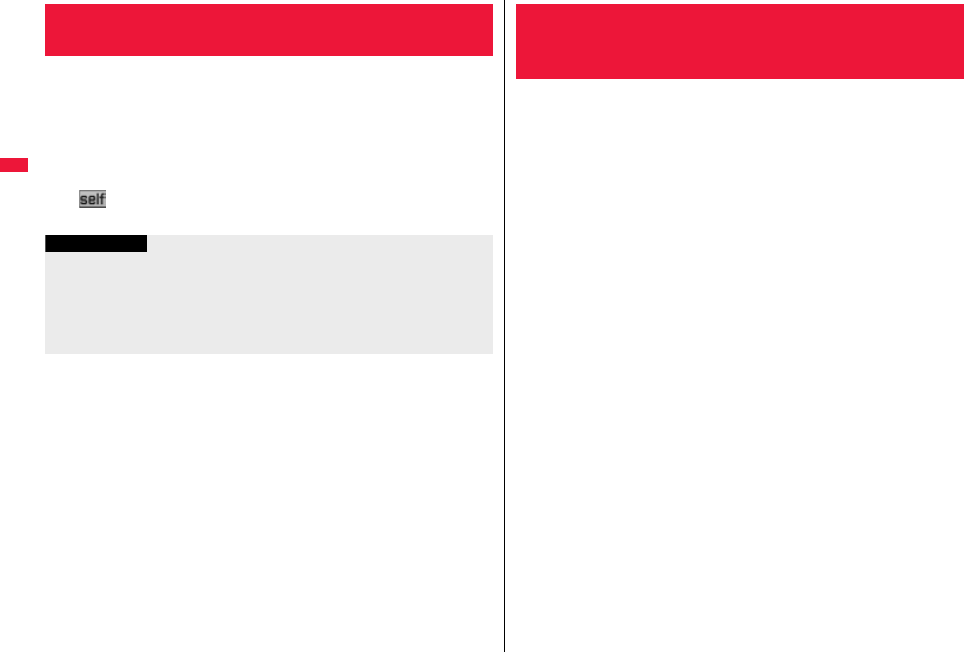
126
Security Settings
You can disable all phone calls and communication functions.
During Self Mode, the caller hears the guidance to the effect that radio
waves do not reach or the power is turned off. If you use DOCOMO Voice
Mail Service or Call Forwarding Service, you can use these services in
the same way as when the FOMA terminal is turned off.
1m1Set./Service1Lock/Security1Self mode1YES
1OK
“ ” appears and Self Mode is set.
≥To release Self Mode, perform the same operation.
<Self Mode>
Using Self Mode
Information
≥You can make emergency calls at 110/119/118 even during Self Mode. In this case,
Self Mode is released.
≥You cannot receive mail messages, Area Mail messages, or Messages R/F during
Self Mode.
≥Even if a call comes in during Self Mode, the icons notifying you of “Missed call” or
presence of Voice Mail messages do not appear after releasing Self Mode.
Including the functions which use personal information, you can set the
following functions not to be used.
<Personal Data Lock>
Hiding Phonebook Entries and Schedule
Events
・Desktop
・Record message
・Play/Erase msg.
・Select image
・Remote monitoring
・PushTalk phonebook
・Add to phonebook
・Group setting
・Search phonebook
・No. of phonebook
・Phonebook settings
・Voice dial
・Voice announce
・Kisekae Tool
・Machi-chara
・
Feel
*
Mail image playback
・Restrictions
・Reject unknown
・Reset settings
・Initialize
・Mail
・Mail group
・Chat group
・i-mode
・Bookmark
・i-Channel
・i-concier
・Full browser
・PC movie
・Camera
・Bar code reader
・1Seg
・Music&Video Channel
・MUSIC
・MUSIC player
・i-αppli
・i-Widget
・IC card content
・ToruCa
・GPS function
・Still image
・Movie
・Video
・Chara-den
・Melody
・microSD card
・Infrared communication
・iC communication
・Voice recorder
・PDF viewer
・Document viewer
・Alarm
・Schedule
・ToDo
・Alarm setting
・Own number
・Voice memo
・Movie memo
・Text memo
・UIM operation
・“Number setting” and “Set
as ring tone” for Multi
number
・Data transfer
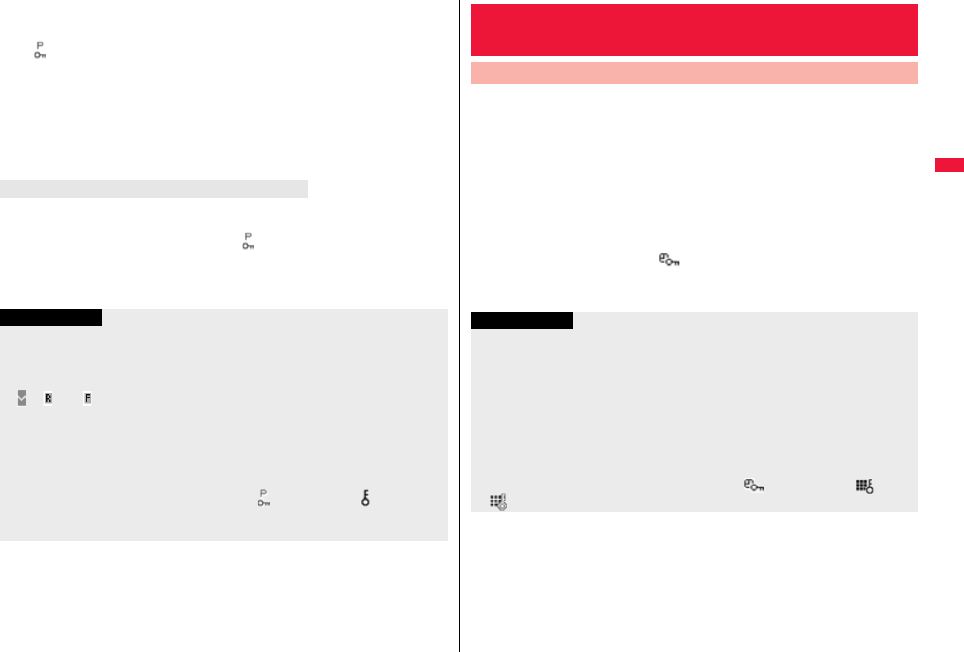
127
Security Settings
1m1Set./Service1Lock/Security1Personal data lock
1Enter your Terminal Security Code.
“ ” appears and Personal Data Lock is set.
≥To release Personal Data Lock, perform the same operation. When Timer Lock
ON At Close is set, the display for releasing Personal Data Lock appears also by
opening the FOMA terminal.
When you set “PIM/IC security mode” to “Face reader”, follow the operation of
“Use Face Reader to Release Lock” on page 130.
When you set to “Double security”, enter your Terminal Security Code after the
operation on the page 130.
When you select a function which cannot be used during Personal Data Lock, the
display for entering your Terminal Security Code appears depending on the function.
When you enter your Terminal Security Code, “ ” is cleared and you can temporarily
use the function.
≥When you show the Stand-by display while no menu function is activated, Personal
Data Lock is set again.
To temporally release Personal Data Lock
Information
≥You can automatically receive Messages R/F, i-mode mail messages, chat mail
messages, and SMS messages during Personal Data Lock; however, the Receiving
or Reception Result display does not appear. Further, the receiving operation such as
ringing/vibration does not work, so you are not notified of receiving. The icons such as
“ ”, “ ”, or “ ” appear after Personal Data Lock is released.
≥During Personal Data Lock, some notification icons and desktop icons such as “New
mail”, “Missed alarm”, “Phone number”, “URL” and “Mail address” do not appear,
however, they reappear when you release Personal Data Lock.
≥During Personal Data Lock, the “Pre-installed” substitute image is sent to the other
party if you send the substitute image during a videophone call.
≥If you set “Lock all” during Personal Data Lock, “ ” is cleared and “ ” appears
instead.
≥You cannot set Personal Data Lock while “Reject unknown” is set.
You can set “Timer lock ON at close” that automatically activates Key
Lock, Personal Data Lock, or IC Card Lock when the specified time has
elapsed after closing your FOMA terminal.
1m1Set./Service1Lock/Security1Lock setting
1Timer lock ON at close
1Enter your Terminal Security Code
1Key lock, Personal data lock, or IC card lock
1Select an elapse time.
If you set to other than “OFF”, “ ” appears and then Timer Lock ON At Close is
set. After Personal Data Lock or IC Card Lock is activated, the Lock Release
display appears when you open the FOMA terminal.
<Lock Setting>
Setting a Variety of Locks
Timer Lock ON At Close
Information
≥When the Stand-by display is not shown, or when another function is working with the
Stand-by display shown, Personal Data Lock or IC Card Lock is not activated even
after the specified time elapses. However, when another function ends after closing
the FOMA terminal, the lock is activated after the specified time elapses.
≥When a call or mail message comes in after closing the FOMA terminal, or when you
open it, the elapsed time counter returns to 0 seconds.
≥When this function is activated, the lock is temporarily released if you release each
lock. However, it is re-locked when the specified time elapses after closing the FOMA
terminal.
≥If Key Lock is set during Timer Lock ON At Close, “ ” is cleared and “ ” or
“ ” appears instead.
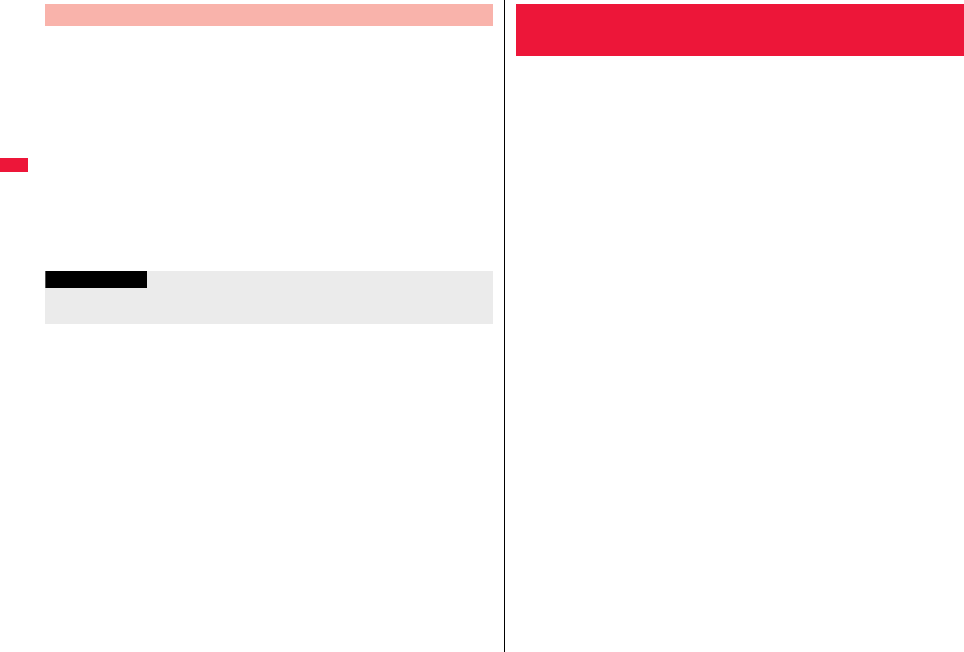
128
Security Settings
You can set the way to release Personal Data Lock and IC Card Lock.
1m1Set./Service1Lock/Security1Lock setting
1PIM/IC security mode
1Enter your Terminal Security Code
1Select a security mode.
Security code . . . . .Enter your Terminal Security Code to release the lock. The
setting is completed.
Face reader . . . . . . .Use Face Reader authentication to release the lock.
Double security. . . .Enter your Terminal Security Code to release the lock after
using Face Reader authentication. The setting is completed.
2YES
PIM/IC Security Mode
Information
≥You cannot change PIM/IC Security Mode when the face data files stored by Face
Reader Setting are fewer than three, or during Personal Data Lock or IC Card Lock.
You can store your face data files in Face Reader and use it for
authentication when releasing IC Card Lock or Personal Data Lock. To
use Face Reader, you need to store three or more face data files and set
“PIM/IC security mode” to either “Face reader” or “Double security”.
■Notes on using Face Reader
≥The dirty camera might result in erroneous operation. Use this function after wiping it
with a soft cloth to clean the dirt off.
≥In environment where the face is exposed to strong light and the brightness
significantly differs depending on the region of the face, the face will not be recognized
easily. In this case, storing might become difficult or the recognition rate (the rate of
correct identification) might be lowered. Adjust so that the face is exposed to even light.
≥The face might not be recognized normally when its entire part is exposed to the light
and becomes white.
≥Storing the face might become difficult or the recognition rate might be lowered when
the face conditions are as described below:
・When the features of the face (eyes, mouth, nose, and eyebrows, etc.) are hard to
see as they are covered by hair, glasses, or a mask
・When the brightness significantly differs depending on the region of the face such as
when you are under the light in a dark place
≥The recognition rate might rise by reacting in accordance with the face conditions such
as by raising the hair so that the eyes, nose, mouth, and eyebrows are clearly visible
(taking the glasses and mask off) or moving to a place where the face is exposed to
even light. The recognition rate rises also by storing the face data file additionally.
≥The face authentication technology does not completely guarantee that you are
recognized as yourself. Accordingly, we are not at all responsible for damages
resulting from the use of this product by a third party or when the damages are caused
by what you could not use the function because of wrong authentication by Face
Reader.
<Face Reader Setting>
Using Face Reader
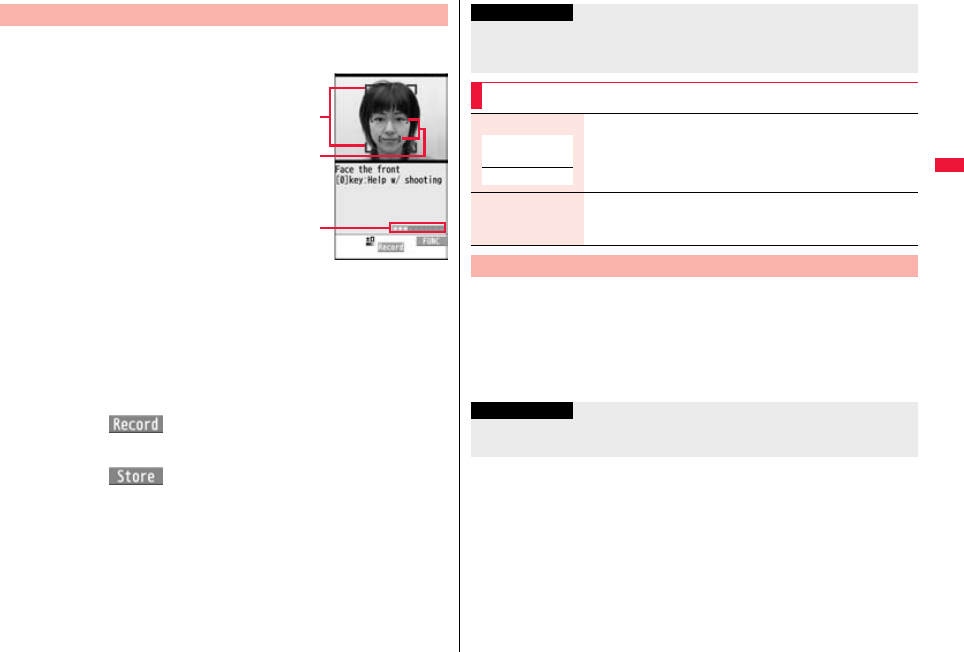
129
Security Settings
To use Face Reader, store 3 or more face data files. You can store up to
10 face data files.
1m1Set./Service
1Lock/Security
1Lock setting
1Face reader setting
1Enter your Terminal
Security Code1Store
1OK
Face to the front, and locate the face
within the guide frame. You can
prevent the failure in authenticating
the face data file, which results from
the difference in the position of the
face at storing and authenticating the data.
When your face is recognized, the recognition frame for the eyes and mouth is
displayed and the guide frame becomes green. When the recognition frame is not
displayed or it comes off your eyes and mouth, place your face off the frame; then
change the facing direction of your face to correctly display the recognition frame.
≥The number of face data files is displayed by the bar on the Face Data Reading
display.
2Press Oo().
The face data file is shot.
3Press Oo().
The face data file you have shot is stored. Repeat step 2 through step 3 to store
three or more face data files.
≥When the third face data file is stored, the message appears telling that Face
Reader can be more easily used by adding face data file.
≥When you press r, the confirmation display appears asking whether to delete
the face data file.
≥If you try to store the face data file in the same environment, you might not be
able to store it. Change the direction of the face or the place for shooting.
Store
Face Data Reading
display
Stored number bar
Guide frame
Recognition frame
You can reset all the face data files stored in Face Reader.
1m1Set./Service1Lock/Security1Lock setting
1Face reader setting
1Enter your Terminal Security Code
1Delete stored images1YES
Information
≥At shooting, the Call/Charging indicator flickers and the shutter tone sounds
regardless of the Manner Mode setting. The sound volume for shutter tone cannot be
changed.
Function Menu of the Face Data Reading Display
Brightness You can adjust to -3 (dark) through +3 (bright).
1Select a brightness level.
≥You can adjust brightness also by pressing 3 from the Face
Data Reading display.
Help You can check the cautions for shooting.
≥You can show Help also by pressing 0 from the Face Data
Reading display.
Delete Stored Images
At Face reader
start-up
±0
Information
≥You cannot reset the face data files during Personal Data Lock or IC Card Lock.
≥When you reset the face data files, “PIM/IC security mode” is set to “Security code”.
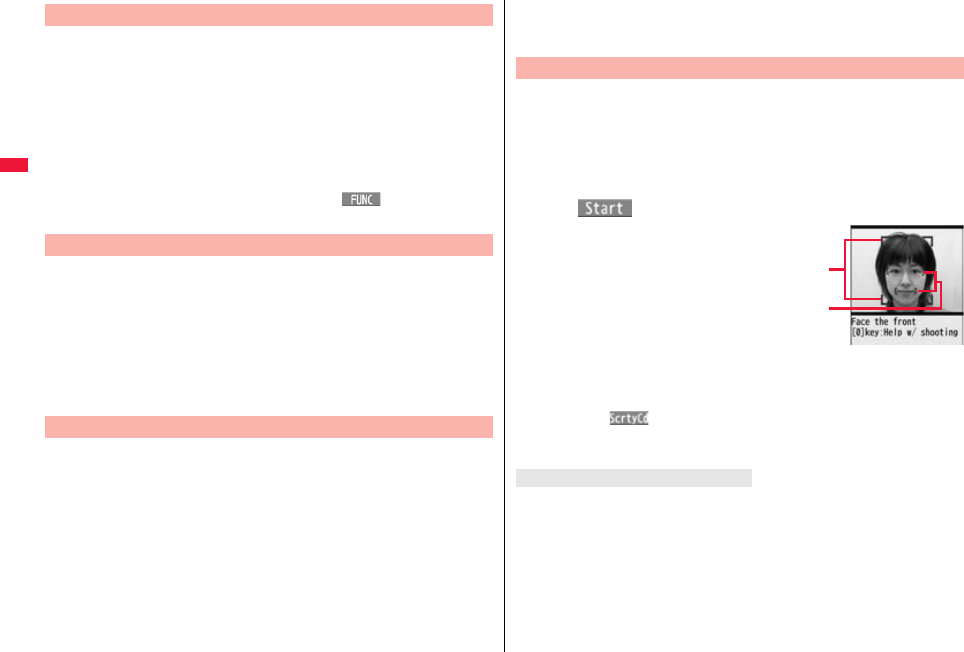
130
Security Settings
The images not judged as yourself by Face Reader recognition operation
are saved. You can use these images to specify who tried to illegally
access your data.
The image is overwritten every time recognition-failed image is made.
1m1Set./Service1Lock/Security1Lock setting
1Face reader setting
1Enter your Terminal Security Code
1Recog. failed image1Select an image.
≥To delete the recognition-failed images, press i( ), select “Delete this”,
and then select “YES”.
You can set Face Reader to additionally recognize blinking of the eyes.
1m1Set./Service1Lock/Security1Lock setting
1Face reader setting
1Enter your Terminal Security Code
1Face reader security1Normal or High
Normal . . . Does not recognize blinking of the eyes.
High. . . . . . Recognizes blinking of the eyes.
You can set a security code to be entered instead of the Face Reader
authentication for when “PIM/IC security mode” is set to “Face reader” or
“Double security”.
1m1Set./Service1Lock/Security1Lock setting
1Face reader setting
1Enter your Terminal Security Code
1Change security code
1Enter the current Face Reader Security Code.
≥If you enter the code for the first time, enter “0000”.
Recognition-failed Image
Face Reader Security
Change Security Code
2Enter a new Face Reader Security Code (four to eight
digits)1YES
When “PIM/IC security mode” is set to “Face reader”, use Face Reader to
release the lock instead of using your Terminal Security Code.
When it is set to “Double security”, use Face Reader for authentication
and then enter your Terminal Security Code to release the lock.
1
Display for releasing Personal Data Lock/IC Card Lock
1
Match the face to the guide frame and press
Oo
().
Face to the front, and locate the face
within the guide frame. The
recognition frame for the eyes and
mouth is displayed, and the guide
frame becomes green. When the
recognition frame is not displayed or
it comes off, place your face off the
frame; then change the facing
direction of your face to correctly
display the recognition frame.
≥Perform the operation for authentication with the same facial expression as when
you stored the face data file.
≥Press l( ) and enter your Face Reader Security Code; then you can
operate to authenticate instead of using Face Reader.
For the Face Reader Security Code, see page 130.
When additional storing of the face data file is possible, select “OK” to show the
confirmation display asking whether to store additional face data file. Select “YES”, enter
your Terminal Security Code; then you can store additional face data file. When you
cannot store any more face data files, select “OK” to show the Face Data Reading
display. If the shot face is judged as another person, a shutter tone sounds and the
recognition-failed image is saved. Select “OK” to show the Face Data Reading display.
Try authentication using Face Reader again.
≥When 10 face data files are stored and a new data file is added, the oldest data file is
overwritten.
Use Face Reader to Release Lock
Face Data Reading
display
Guide frame
Recognition frame
If you failed to be authenticated
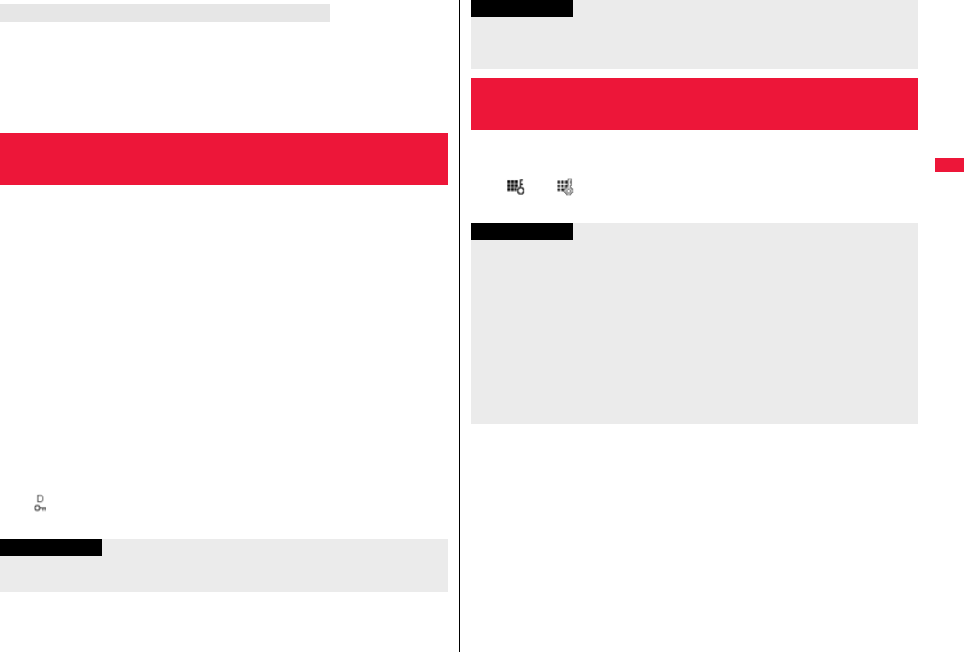
131
Security Settings
After you are successfully authenticated by Face Reader, your eye blinking is checked.
Repeat blinking your eyes slowly.
When the detection of eye blinking fails, the authentication also fails.
≥Even in the same environment as that for the authentication by Face Reader, the
detection of eye blinking may fail. Change the place or the direction of your face, and
then operate.
You can lock dialing from the numeric keys. When using the FOMA
terminal for business purposes, private use of the FOMA terminal can be
prevented.
■Unavailable operations
・Dialing from the numeric keys
・Initial setting
・Phonebook (storing, editing, deleting, copying from the microSD card,
backing up/restoring by the microSD card, sending/receiving using Infrared rays,
sending/receiving using iC communication, and sending/receiving using Bluetooth
communication)
・Phone To/AV Phone To function
・Mail To function
■Available operations
・Dialing from the Phonebook or Voice Dial
・Dialing from Redial, Dialed Calls, Received Calls, Sent Address, or Received Address
(Only phone numbers stored in the Phonebook)
1m1Set./Service1Lock/Security1Keypad dial lock
1Enter your Terminal Security Code.
“ ” is displayed and Keypad Dial Lock is set.
≥To release Keypad Dial Lock, perform the same operation.
When “Face reader security” is set to “High”
<Keypad Dial Lock>
Locking Keypad Dial
Information
≥You can make emergency calls at 110/119/118 using numeric keys even during
Keypad Dial Lock.
You can disable the keys except h.
1Press and hold Oo for at least one second.
“ ” or “ ” appears and Key Lock is set to “ON”.
≥To set to “OFF”, perform the same operation.
≥If you set Keypad Dial Lock, you can send mail only when the address is called up
from the Phonebook and when the address stored in the Phonebook is called up from
Sent Address or Received Address.
<Key Lock>
Restricting Key Operation
Information
Information
≥You cannot turn off the FOMA terminal during Key Lock.
≥When you close the FOMA terminal during Key Lock, the FOMA terminal switches to
Power Saver Mode regardless of the setting of “Backlight” on page 113. However, the
FOMA terminal might not switch to Power Saver Mode depending on the function in
use.
≥Even during Key Lock, you can answer an incoming call by pressing -d and an
incoming PushTalk call by pressing .p. You can get the talker’s right by pressing .p
during the PushTalk communication.
≥You can operate an earphone/microphone (option) and Bluetooth devices regardless
of the setting of this function.
≥GPS Location Provision is available even during Key Lock.
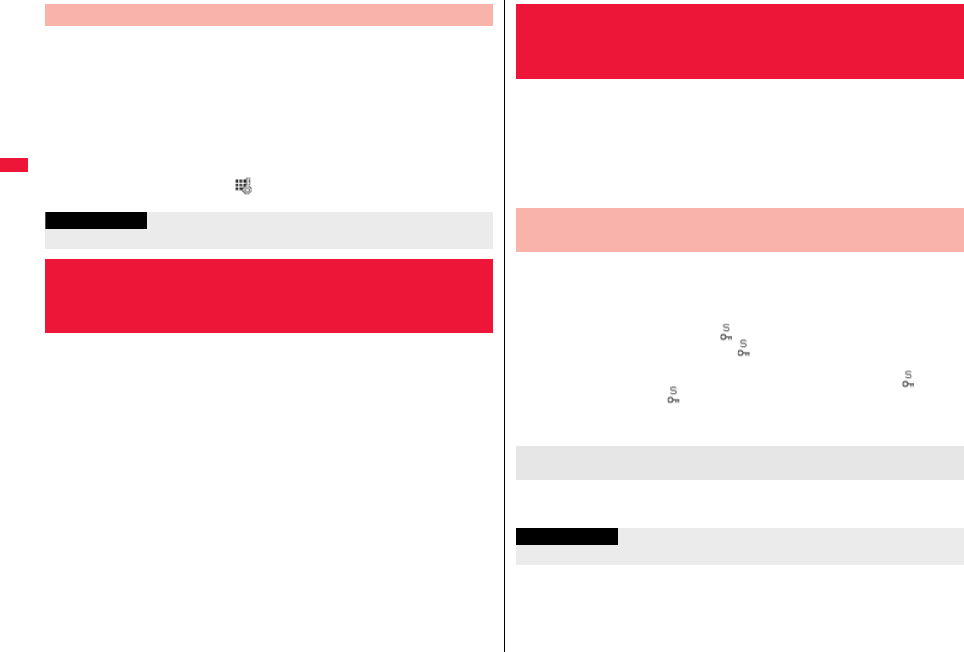
132
Security Settings
You can set whether to temporarily release Key Lock when you open the
FOMA terminal.
1m1Set./Service1Lock/Security1Lock setting
1Key lock setting1Select an item.
Lock even slide open . . . . . .Even when you open the FOMA terminal, Key Lock
is not temporarily released.
Unlock when slide open . . .When you open the FOMA terminal, Key Lock is
temporarily released. During temporary release,
“ ” is displayed.
1m1Set./Service1Incoming call1Record display set
1Enter your Terminal Security Code1Select an item.
Received calls . . . . . . . . . Sets whether to display Received Calls and Received
Address.
Redial/Dialed calls . . . . . Sets whether to display Redial, Dialed Calls and Sent
Address.
2ON or OFF
≥When you set “Received calls” to “OFF”, you cannot play back record messages
of voice calls, either.
Key Lock Setting
Information
≥If you close the FOMA terminal during temporary release, Key Lock is set again.
<Record Display Set>
Setting not to Display Redial/Received
Calls
In ordinary mode, you cannot access/refer to Phonebook entries or
schedule events stored as secret data. In Secret Mode, you can select
whether to store the stored/edited Phonebook entries/schedule events as
secret data or as ordinary data. The Phonebook entries/schedule events
you have stored/edited in Secret Data Only are stored as secret data.
You can access/refer to all the data files in Secret Mode but can access/
refer to only the secret data files in Secret Data Only.
1m1Set./Service1Lock/Security
1Secret mode or Secret data only
1Enter your Terminal Security Code.
When “Secret mode” is selected, “ ” appears and Secret Mode is activated.
When “Secret data only” is selected, “ ” blinks, the number of stored secret data
items is displayed, and then Secret Data Only is activated.
≥If you call up a Phonebook entry or schedule event in Secret Mode, “ ” stays lit
for ordinary data and “ ” blinks for secret data.
≥To deactivate Secret Mode or Secret Data Only, perform the same operation or
press h from the Stand-by display.
In Secret Mode or Secret Data Only, select “Release secret” from the Function menu of
the Phonebook entry or schedule event to be released.
<Secret Mode> <Secret Data Only>
Protecting Phonebook Entries and
Schedule Events from Prying Eyes
+m-4-0
Activate Secret Mode
+m-4-1
Activate Secret Data Only
To change secret data to an ordinary Phonebook entry or
schedule event
Information
≥Only the Phonebook entries in the FOMA terminal can be stored as secret data.
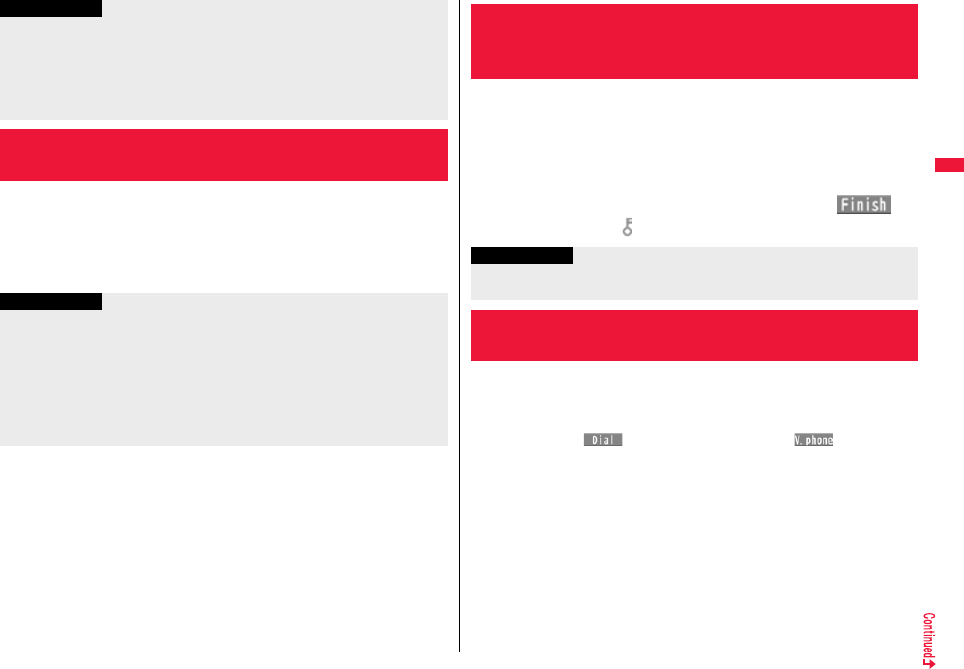
133
Security Settings
You can set whether to display the mail (secret mail) message from the
sender or to the destination address that matches secret data in the
Phonebook.
1l1Mail settings1Secret mail display
1Enter your Terminal Security Code1ON or OFF
≥When you make a call to the party stored as secret data, his/her name is not
displayed but the phone number is displayed on the Dialing/Talking display.
≥If you call up a secret entry to make a call or send mail, the record is not stored in
“Redial”, “Dialed calls” or “Sent address”.
≥If you simultaneously activate “Lock all” and “Secret mode” or “Secret data only”,
deactivating “Lock all” deactivates “Secret mode” or “Secret data only”.
<Secret Mail Display>
Applying Secret for Mail in Mailbox
Information
Information
≥Even when “Secret mail display” is set to “OFF”, you can check secret mail in Secret
Mode or in Secret Data Only.
≥When “Secret mail display” is set to “OFF”, and any secret address is included in
addresses of simultaneous mail, that mail message is not displayed.
≥When “Secret mail display” is set to “OFF”, and any secret member is included in chat
members, chat mail messages of all chat members are not displayed.
≥When “Secret mail display” is set to “OFF”, Area Mail messages are not displayed in
Secret Data Only.
You can set the security function for the Inbox, Outbox and Draft of the
Mail menu.
You need to enter your Terminal Security Code to display the mail
messages in security-activated boxes.
1l1Mail settings1Mail security
1Enter your Terminal Security Code
1Put a check mark for boxes to be set1l()
≥When security is set, “ ” is added to the icon of the set box in the Mail menu.
Restrict Dialing
You can disable making voice calls, videophone calls, and PushTalk calls to phone
numbers other than specified ones. When you use the FOMA terminal for business use,
this function is useful for preventing the private use. Call up the specified Phonebook entry
and press
d
or
Oo
( ) to make a voice call. (Press
l
( ) to make a
videophone call, press
p
and to make a PushTalk call.) You can specify up to 20 phone
numbers.
Call Rejection
You can reject voice calls, videophone calls, and PushTalk calls from specified phone
numbers. You can set only the calls you do not want to receive to be rejected. The caller
hears a busy tone. You can specify up to 20 phone numbers.
This function is valid only when the other party notifies his/her phone number. It is
advisable to activate “Caller ID request” and “Call setting w/o ID” simultaneously.
<Mail Security>
Setting not to Display Mail in Mailbox
without Permission
Information
≥If you set security for the Outbox and Inbox, mail addresses are not stored in Sent
Address and Received Address.
<Restrictions>
Setting Restrictions on Phonebook Entries
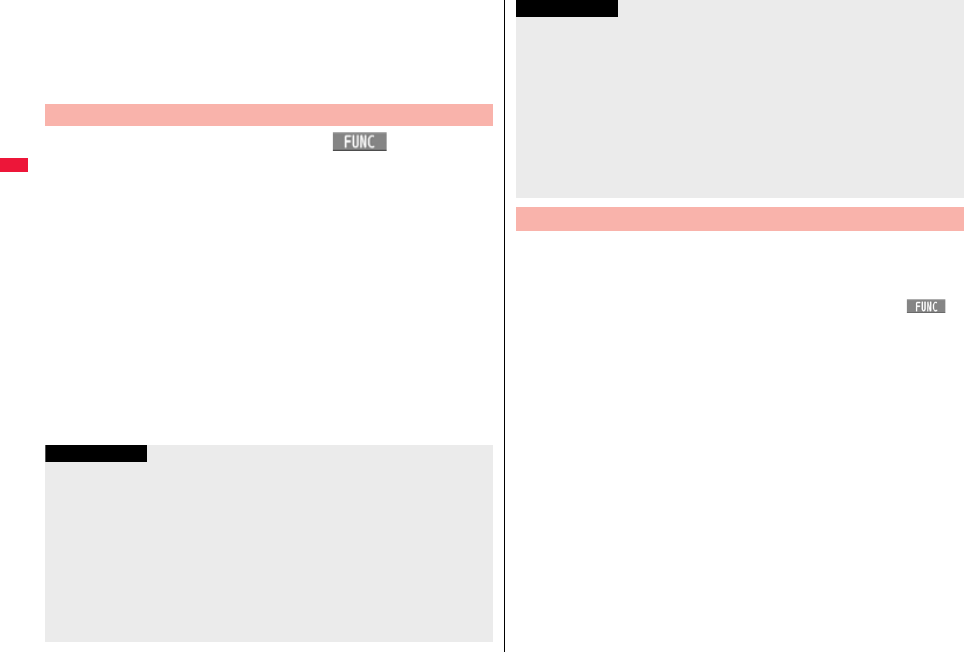
134
Security Settings
Call Acceptance
You can receive voice calls, videophone calls, and PushTalk calls only from specified
phone numbers. You can set only the calls you want to accept to be connected. You can
specify up to 20 phone numbers.
This function is valid only when the other party notifies his/her phone number. It is
advisable to activate “Caller ID request” simultaneously.
1Detailed Phonebook display1i()
1Restrictions
1Enter your Terminal Security Code1Select an item.
Restrict dialing . . . You can dial the specified phone numbers only.
Call rejection . . . . . You can reject calls from the specified phone numbers.
Call acceptance. . . You can accept calls from the specified phone numbers only.
Call forwarding . . . See page 445.
Voice mail . . . . . . . See page 442.
The set item is indicated by “★”.
≥When a Phonebook entry contains multiple phone numbers, press Mo on the
detailed display to highlight the phone number you will set Restrictions for.
≥To set Restrict Dialing for multiple phone numbers, first set Restrict Dialing and
press r to return to the detailed Phonebook display; Mo to highlight the phone
number to be set for Restrict Dialing and continue the operation.
If you press h to return to the Stand-by display, additional settings cannot be
done. To do additional settings, release Restrict Dialing for the set phone number
and activate Restrict Dialing again, including the released phone number.
≥To release Restrictions, perform the same operation.
Restrict Dialing/Call Rejection/Call Acceptance
Information
≥You cannot set this function for Phonebook entries stored as secret data, and in the
UIM Phonebook.
≥If you activate “Personal data lock” while “Call rejection” or “Call acceptance” is set,
you can accept all incoming calls.
≥You cannot operate the following while “Restrict dialing” is set:
・Calling up/Referring to phone numbers other than specified
・Keypad dial (except for the calls to the specified phone numbers)
・Dialing from Received Calls (except for the calls from the specified phone numbers)
・Storing/Editing/Deleting Phonebook entries, copying Phonebook entries from the
microSD card, backing up/restoring by the microSD card, and copying Phonebook
entries to the UIM
1m1Phonebook1Restrictions
1Enter your Terminal Security Code1Select an item.
≥The set item is indicated by “★”.
≥To release all the Phonebook entries set with Restrictions, press i(),
select “Release”, and then select “YES”.
2Select a Phonebook entry.
The phone number set with Restrictions is displayed.
≥To release “Restrictions” per phone number, select the phone number you want
to release by following the same steps above, and select “YES”.
≥You can make emergency calls at 110/119/118 even if you set “Restrict dialing”.
≥When a call comes in from the phone number set with “Call rejection”, or from other
than the phone number set with “Call acceptance”, the call is stored in “Received
calls” as a missed call record and the “Missed call” icon appears on the Stand-by
display. Also, the caller hears a busy tone even if you have set Voice Mail Service or
Call Forwarding Service to “Activate”. However, if you set the ring time for Voice Mail
Service or Call Forwarding Service to 0 seconds, when the FOMA terminal is out of
the service area, or when the power is turned off, the busy tone will not be played
back, activating Voice Mail Service or Call Forwarding Service.
≥You can receive SMS messages or i-mode mail messages regardless of the setting of
“Call rejection” or “Call acceptance”.
Check/Release Restrictions on Phonebook Entries
Information
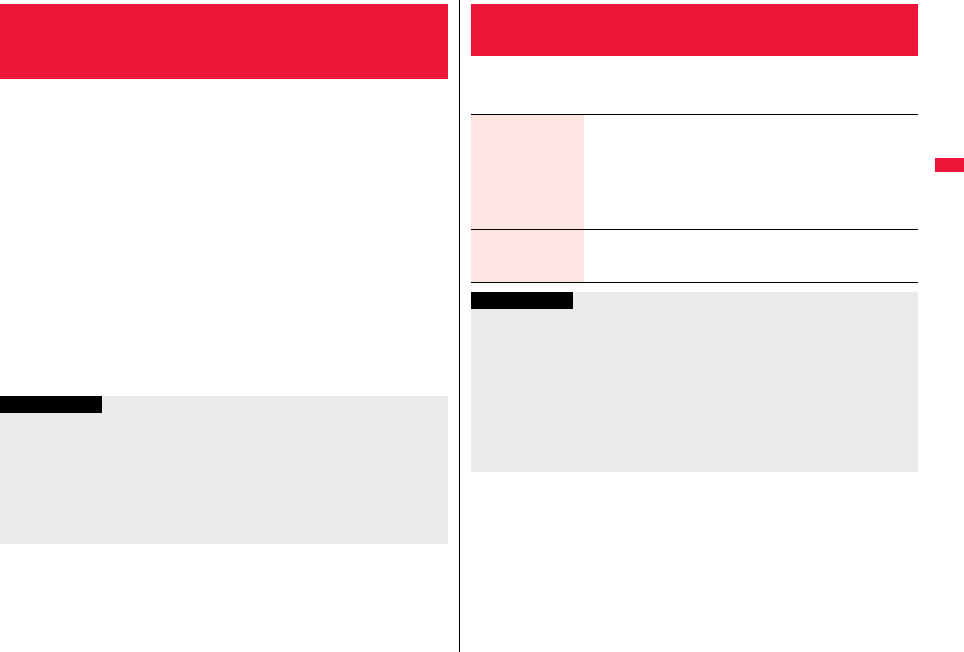
135
Security Settings
You can set whether to receive (accept) or not to receive (reject) a voice
call, videophone call, and PushTalk call depending on the reason for no
caller ID. There are three reasons; “Unavailable”, “PublicPhone”, and
“User unset”.
1m1Set./Service1Lock/Security1Call setting w/o ID
1Enter your Terminal Security Code1Select an item.
Unavailable. . . . . Calls from the other party who cannot notify his/her phone
number such as calls from overseas or from land-line phones
via call forwarding services.
(However, the caller ID might be notified depending on the
telephone companies the calls go through.)
PublicPhone. . . . Calls from public phones, etc.
User unset . . . . . When the caller has set the caller ID not to be notified.
2Accept or Reject
≥If you select “Accept”, go to step 2 on page 104 to select a ring tone.
If you select “Same as ring tone”, the ring tone will be the one selected in “Phone”
of “Select ring tone”.
+m-1-0
<Call Setting without ID>
Setting Response to Incoming Calls
without Caller ID
Information
≥If you select “Reject”, the ring tone does not sound even if a call comes in, the call is
stored in “Received calls” as a missed call record and the “Missed call” icon appears
on the Stand-by display. Also, the caller hears a busy tone even if you have set Voice
Mail Service or Call Forwarding Service to “Activate”. However, if you set the ring time
for Voice Mail Service or Call Forwarding Service to 0 seconds, when the FOMA
terminal is out of the service area, or when the power is turned off, the busy tone will
not be played back, activating Voice Mail Service or Call Forwarding Service.
≥You can receive SMS messages or i-mode mail messages regardless of this setting.
1m1Set./Service1Incoming call1Ring time
1Do the following operations.
+m-9-0
<Ring Time>
Delaying Start of Ringing Operation
Ring start time You can set the FOMA terminal not to start ringing operation
immediately for when a voice call, videophone call, or PushTalk
call comes in from the party whose phone number is not stored in
the Phonebook. This function is effective as a countermeasure for
blocking nuisance calls such as one ring phone scam (one-giri).
1ON or OFF1Enter a start time (seconds).
≥Enter from “01” through “99” in two digits.
Missed calls display You can set whether to display the call disconnected within the
time specified for “Ring start time” in Received Calls.
1Display or Not display
Information
≥When a call comes in from the party whose phone number is stored in the
Phonebook, the FOMA terminal starts ringing as soon as the call comes in even if
“186”/“184” is added to the phone number. However, during Personal Data Lock, or
for the call from the party whose phone number is stored as secret data, ringing starts
according to the setting for this function.
≥If the ring start time is longer than the ring time for Record Message Setting, the
ringing operations do not start, activating Record Message instead. To activate
Record Message after starting the ringing operations, set the longer ring time for
Record Message Setting than the ring start time. The same applies to the ring time for
Voice Mail Service, Call Forwarding Service, and Auto Answer Setting.
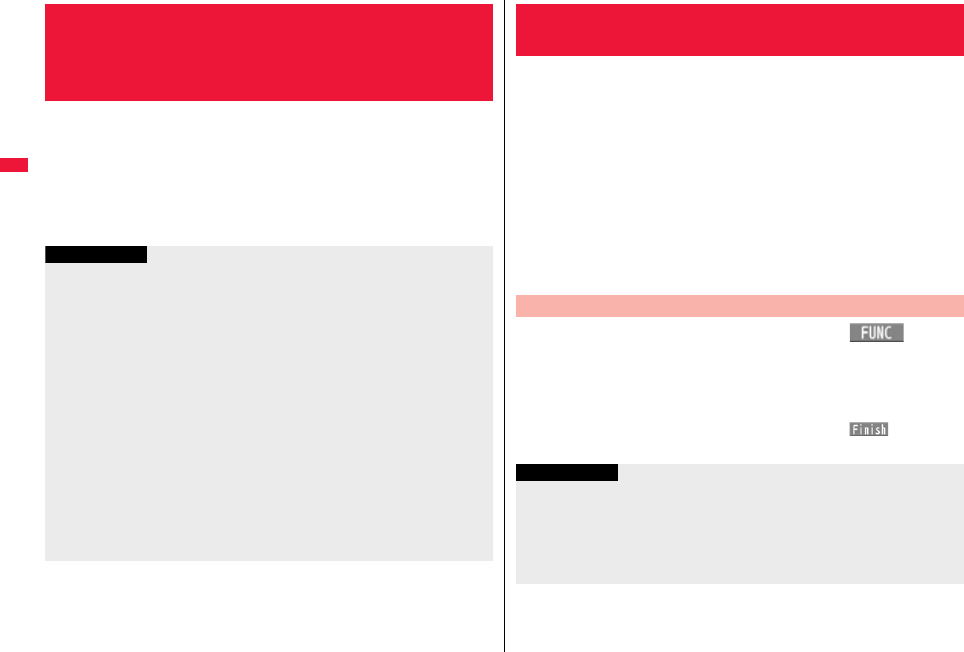
136
Security Settings
You can reject voice calls, videophone calls, and PushTalk calls from the
party whose phone number is not stored in the Phonebook.
This function is valid only when the other party notifies his/her phone
number. It is advisable to activate “Caller ID request” and “Call setting
w/o ID” simultaneously.
1m1Set./Service1Lock/Security1Reject unknown
1Enter your Terminal Security Code1Accept or Reject
<Reject Unknown>
Rejecting Incoming Calls from Phone
Numbers which are not Stored in
Phonebooks
Information
≥If a call comes in from the party whose phone number is stored as secret data, the call
is not rejected, regardless of this setting.
≥If you simultaneously activate “Reject unknown” and “Call acceptance” of
“Restrictions”, the latter has priority.
≥When a call comes in from anyone whose phone number is not stored in the
Phonebook while you set this function to “Reject”, the call is stored in “Received calls”
as a missed call record, and the “Missed call” icon appears on the Stand-by display.
Also, the caller hears a busy tone even if you have set Voice Mail Service or Call
Forwarding Service to “Activate”. However, if you set the ring time for Voice Mail
Service or Call Forwarding Service to 0 seconds, when the FOMA terminal is out of
the service area, or when the power is turned off, the busy tone will not be played
back, activating Voice Mail Service or Call Forwarding Service.
≥Even when this function is set to “Reject”, the FOMA terminal follows the setting of
“Call setting w/o ID” if each setting of “Call setting w/o ID” is set to “Accept”.
≥You can receive SMS and i-mode mail messages regardless of this setting.
≥You cannot set “Reject unknown” during Personal Data Lock.
≥You cannot set “Reject unknown” to “Reject” while “Ring start time” of “Ring time” is
set to “ON”.
This service enables you to save the Phonebook, images, mail
messages, ToruCa files※, and schedule events※ (hereafter, “saved data
files”) in your FOMA terminal to the DOCOMO’s Data Storage Center and
to restore them when you unexpectedly lose your handset or change
models. Further, you can notify the concerned parties of your mail
address change at a time. You are not charged a packet communication
fee for sending the multi-address notice mail. If you have a personal
computer (My docomo), you can use this service more conveniently.
※You need to subscribe to i-concier to save the ToruCa files and schedule events to the
Center. (As of December 2008)
≥For details on Data Security Service, refer to “Mobile Phone User’s Guide [i-mode]
FOMA version”.
≥Data Security Service is a pay service that is available on a subscription basis (You
need to subscribe to i-mode to apply for Data Security Service).
1Display of the data file to be saved1i()
1Move/copy1Connect to Center or Store in Center
1Enter your Terminal Security Code1YES
≥You do not need to select “Move/copy” depending on the function.
≥When you operate from the Inbox list, Outbox list, Draft list, or Still Image list, put
a check mark for the data files to be saved and press l().
You can select up to 10 data files.
<Data Security Service>
Using Data Security Service
Save to Data Storage Center
Information
≥You cannot save the data files stored on the UIM or microSD card.
≥You cannot save the files attached to mail.
≥You cannot save the following images:
・Images whose sizes exceed 100 Kbytes
・Images whose output from the FOMA terminal is prohibited
・Images other than in JPEG or GIF format
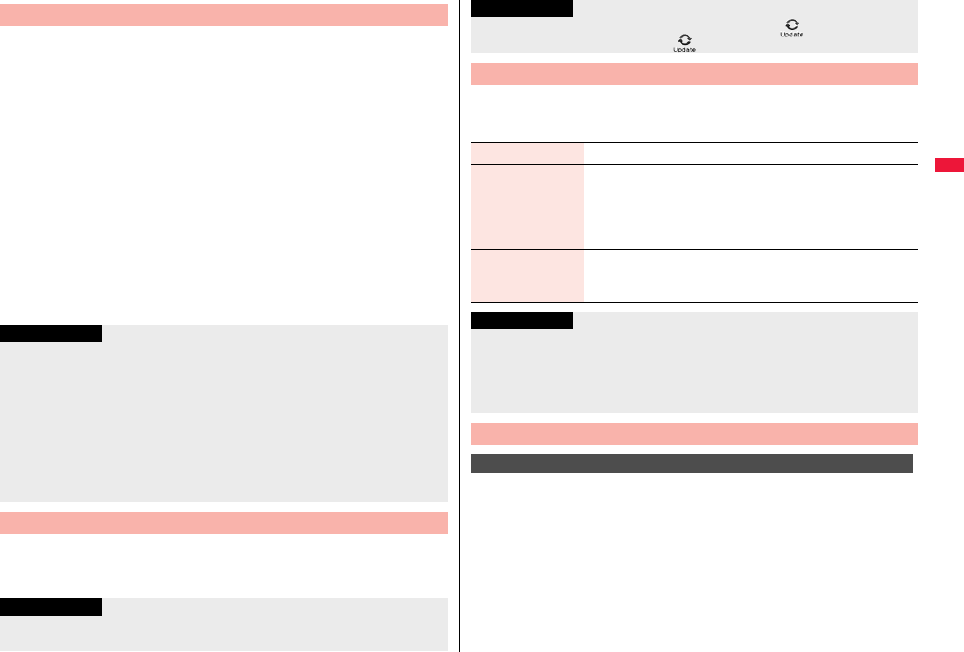
137
Security Settings
Note that if you delete Phonebook entries from your FOMA terminal and save
the Phonebook to the Data Storage Center, the Phonebook entries on the
Data Storage Center are also deleted. When you restore the Phonebook from
the Data Storage Center to your FOMA terminal, do the following operations.
1i1iMenu1English1My Menu
1電話帳お預かり (Data Security Service)
1お預かりセンター (Data Storage Center)
1Enter your i-mode password.
≥When you have subscribed to i-concier, operate i1iMenu1English
1My Menu1お預かり/iコンシェル (Data Storage/i-concier)
1お預かりデータ確認 (Check saved data)1Enter your i-mode password.
2
Select “
ケータイへダウンロード
(Download to mobile
phone)” from the Phonebook on the Data Storage Center
1
OK
≥Download starts in about 15 seconds. Wait for a while with the Stand-by display
shown.
On the site of the Data Storage Center, you can set so as to periodically
update and save the Phonebook entries in your FOMA terminal to the
Data Storage Center.
Restoring to your FOMA terminal
Information
≥When the Phonebook entries saved to the Data Storage Center exceeds the number
of Phonebook entries storable in the FOMA terminal’s Phonebook, the excess entries
cannot be updated.
≥
When you delete the data of the second phone number or after, second mail address or
after, and location information in a Phonebook entry, and phone numbers and group
names (numbers) in the PushTalk Phonebook, the deletion is not reflected at the Data
Storage Center. You can reflect the deletion of the second phone number or after and
second mail address or after in a Phonebook entry, by deleting them at the Data
Storage Center of the PC site (My docomo).
≥The deletion of a whole Phonebook entry is reflected at the Data Storage Center.
Auto-update of the Phonebook
Information
≥The data files are not automatically updated while another function is working at the
time of Auto-update.
1m1LifeKit1Data Security Service
1Do the following operations.
You can configure settings for Data Security Service.
1m1i-concier1l(MENU)1設定 (Settings)
1自動お預かり/更新設定 (Automatic saving/Update
settings)1Follow the instructions on the display.
≥If the data files cannot be updated, the notification icon of “ ” (Data Sec. Service
UD) appears on the desktop. Select “ ” to show the update display.
Setting Data Security Service
Information
Connect to Center See page 136.
Exchanging history You can display the records of communication with the Data
Storage Center.
1Select a record.
≥Select a communication completion time in the list to switch to
the detailed display.
PB image sending You can set whether to save images set for the Phonebook
entries to the Data Storage Center.
1ON or OFF
Information
<Exchanging history>
≥Up to 30 records are saved. When more than 30 records are saved, the older records
are overwritten.
<PB image sending>
≥You cannot save the images whose output from FOMA terminal is prohibited.
Using Data Security Service with i-concier
自動お預かり/更新設定
(Automatic saving/Update settings)
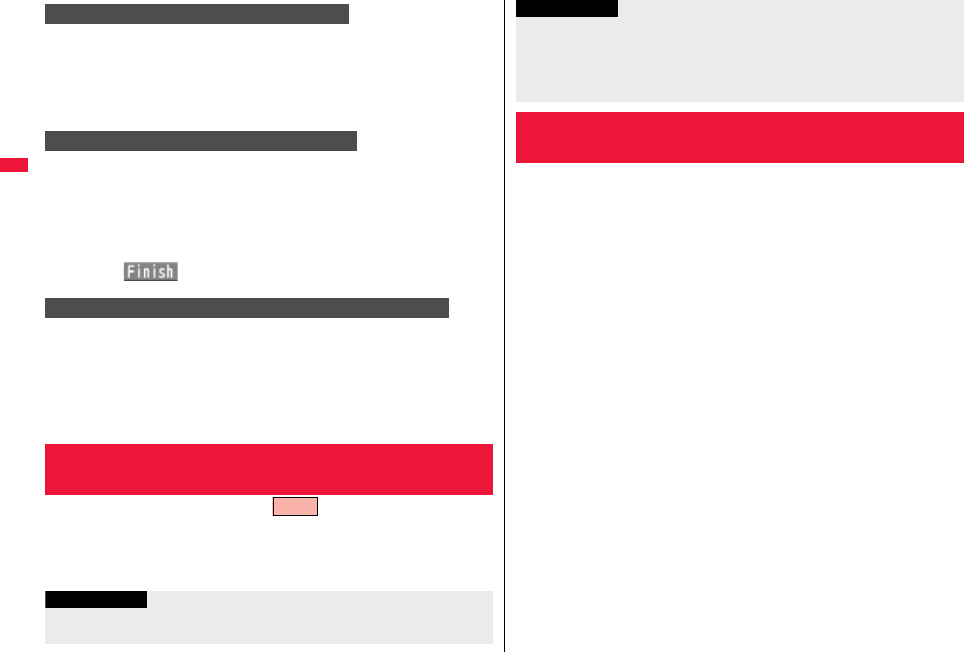
138
Security Settings
You can check the data files at the Data Storage Center.
1m1i-concier1l(MENU)1設定 (Settings)
1お預かりデータ確認 (Check saved data)
1Follow the instructions on the display.
You can update the data files at the Data Storage Center and in the FOMA
terminal.
1m1i-concier1l(MENU)1設定 (Settings)
1お預かりデータ更新 (Update stored data)
1Put a check mark for data files to be updated
1l()
You can show the records of communication with the Data Storage Center.
1m1i-concier1l(MENU)1設定 (Settings)
1お預かり通信履歴 (Communication records of saving)
1Select a record.
≥
Select a communication completion time from the list to show the detailed display.
You can reset the items indicated by of “Function List” to their
default. (See page 476)
1m1Set./Service1Other settings1Reset settings
1Enter your Terminal Security Code1YES
お預かりデータ確認 (Check saved data)
お預かりデータ更新 (Update stored data)
お預かり通信履歴 (Communication records of saving)
+m-2-3
<Reset Settings>
Resetting Function Settings
Information
≥You cannot execute “Reset settings” while a Bluetooth device is connected or on
standby for connection.
You can delete the saved data and reset the setting contents of each
function to the default.
See “Function List” for the setting at purchase. (See page 476)
≥The pre-installed data files are not deleted.
≥All the Osaifu-Keitai compatible i-αppli programs except “iD 設定アプリ (iD Setting
Application)” are deleted. However, they might not be deleted depending on your
usage state.
≥The data files stored in the pre-installed i-αppli programs are deleted. However, the
data files stored in Osaifu-Keitai compatible i-αppli programs that have not been
deleted are not deleted.
≥The protected data files are also deleted.
≥All the stored data files are deleted regardless of the mode of 2in1.
≥Even if you have deleted the pre-installed data files, they are restored when you
execute “Initialize”. However, if you delete the pre-installed i-αppli programs, they are
not restored.
≥Charge the battery full before initializing the FOMA terminal. When the battery level is
not enough, you may not be able to initialize the FOMA terminal.
≥During initialization, never turn off the power of the FOMA terminal.
≥You cannot use other functions during initialization. Also, you cannot receive calls or
mail messages.
1m1Set./Service1Other settings1Initialize
1Enter your Terminal Security Code1YES1YES
When initializing ends, the power automatically turns off and then turns on and the
“Initial setting” display appears.
≥You cannot execute “Reset settings” during IC Card Lock while “PIM/IC security
mode” is set to “Face reader” or “Double security”.
≥After you execute “Reset settings”, the i-Channel tickers are not displayed. Then,
when the information is automatically updated or you press *Zo to receive the latest
information, the tickers automatically flow.
<Initialize>
Deleting Saved Data All at Once
Information
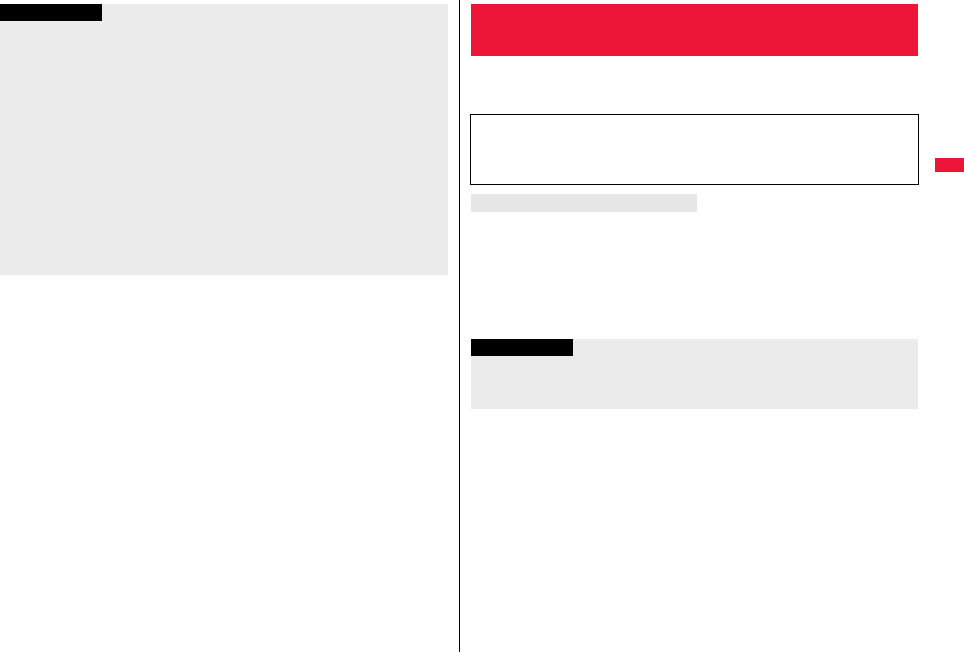
139
Security Settings
Information
≥You cannot execute “Initialize” while a Bluetooth device is connected or on standby for
connection.
≥You cannot execute “Initialize” during IC Card Lock while “PIM/IC security mode” is
set to “Face reader” or “Double security”.
≥You cannot delete the data saved to, stored in, or set for the UIM or the microSD card.
≥You cannot delete the setting of data communication set by a personal computer.
≥To restore the i-αppli programs, download them from the “P-SQUARE” site. For
downloading, you are charged an additional communication fee.
≥After you execute “Initialize”, the i-Channel tickers are not displayed. Then, when the
information is automatically updated or you press *Zo to receive the latest
information, the tickers automatically flow.
≥After you initialize the FOMA terminal, you cannot automatically obtain Music&Video
Channel programs. Access the Setting Confirmation display from the Music&Video
Channel menu to reflect the program setting.
≥Initialization may take a while if the data to be deleted is bulky.
If you contract with the service of this function, you can initialize the data
files (memory within the handset/microSD card/UIM) of the target FOMA
terminal by the offer from you (administrator).
The display appears telling that operation is disabled and the initialization starts.
≥When Remote Reset launches, all the key operations are locked and you cannot
operate the functions except for answering voice calls and answer-hold (On Hold).
When the initialization starts, you cannot use all the functions.
≥When Remote Reset launches while the phone is ringing or during a call, all the key
operations except for d and h are locked. When initialization starts, ringing or the
call automatically finishes.
<Remote Reset>
Resetting Data by Remote Control
■Inquiries
docomo Business Online
From personal computers http://www.docomo.biz (in Japanese only)
※You may not be able to access due to system maintenance, etc.
When Remote Reset launches
Information
≥“Set time” is not initialized.
≥The microSD card might not be initialized when the FOMA terminal is connected to a
personal computer.
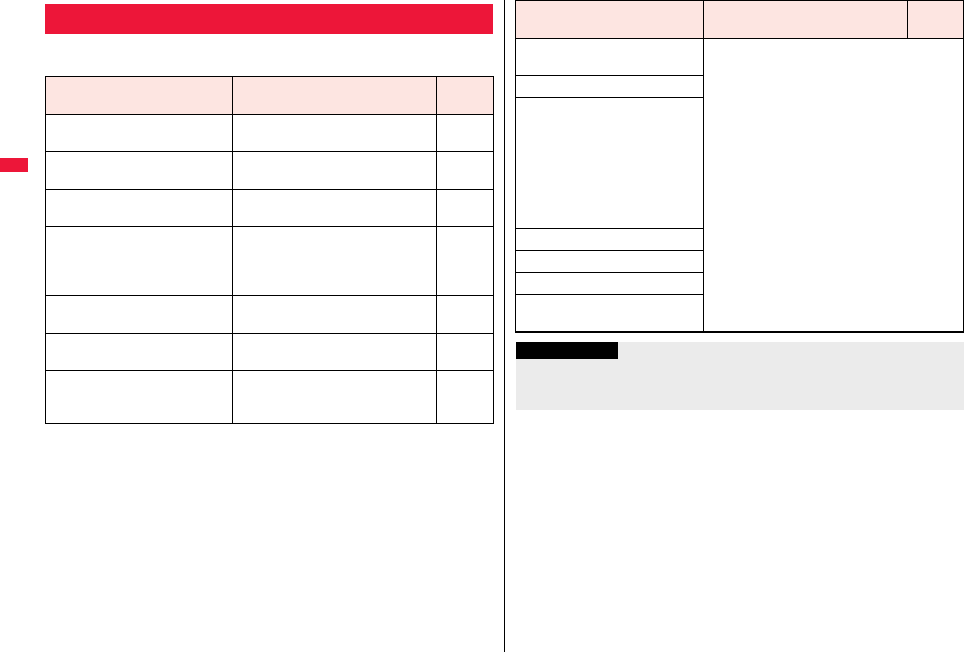
140
Security Settings
Besides introduced in this chapter, the following functions/services for
the Security Settings are available:
Other Security Settings
Functions/Service name If you want
Reference
page
IC Card Lock To protect the IC card function from
being used illegally 316
Nuisance Call Blocking Service To prevent crank calls or vicious sales
calls from incoming 445
Caller ID Request To prevent the incoming call that does
not notify a caller ID 446
FirstPass To ensure safe and reliable data
communication by using electronic
authentication services
※Limited to FirstPass sites
206
Software Update To update software programs in the
FOMA terminal when necessary 523
Scanning Function To protect the FOMA terminal from
data liable to cause trouble 529
Receive Option To receive necessary mail only from
among the large volume of incoming
mail
156
i-mode Disaster Message Board
Service
Refer to “Mobile Phone User’s Guide [i-mode]
FOMA version”
Change Mail Address
Spam Mail Prevention
(Reject Mail with URL)
(Reject/Receive Mail Settings)
(Easy Mail Setting)
(Reject Mass i-mode Mail Senders)
(SMS Rejection Settings)
(Reject Unsolicited Ad Mail※)
(Confirm Settings)
Suspend/reactivate Mail
Limit Mail Size
Keitai-Osagashi Service
イマドコかんたんサーチ
(imadoco kantan search)
Functions/Service name If you want
Reference
page
Information
≥The priority order of functions simultaneously set to prevent nuisance calls is as
follows: “Nuisance Call Blocking Service” → “Call rejection” → “Reject unknown/Call
setting w/o ID” → “Ring time”.

141
Mail
i-mode Mail . . . . . . . . . . . . . . . . . . . . . . . . . . . . . . . . . . . . . . . . . . 142
Composing i-mode Mail/Deco-mail
Composing and Sending i-mode Mail
. . . . . . . . . . . . . . . . . . . . . . . . . . . . . . . . . <Compose Message> 142
Creating and Sending Deco-mail . . . . . . . . . . . . . . . . . . . . . . . . 146
Creating and Sending Decome-Anime . . . . . . . . . . . . . . . . . . . . 149
Using a Template to Create Deco-mail/ Decome-Anime
. . . . . . . . . . . . . . . . . . . . . . . . . . . . . . . . . . . . . . . . . .<Template> 151
Attaching a File . . . . . . . . . . . . . . . . . . . . . . . . . .<Attachments> 153
Receiving and Operating i-mode Mail
Receiving i-mode Mail Automatically . . . .<Mail Auto-receive> 155
Receiving i-mode Mail Selectively . . . . . . . <Receive Option> 156
Checking New i-mode Mail . . . . . . . . <Check New Messages> 157
Replying to Received i-mode Mail
. . . . . . . . . . . . . . . . . . . . . . . . . . . <Reply> <Reply with Quote> 157
Forwarding Received i-mode Mail. . . . . . . . . . . . . . <Forward> 158
When i-mode Mail with Files Attached/Pasted is Received . . . 158
Operating Mailbox
Displaying Mail in Inbox/Outbox/Draft
. . . . . . . . . . . . . . . . . . . . . . . . . . . . . <Inbox> <Outbox> <Draft> 160
How to See Inbox/Outbox/Draft List and Detailed Display . . . . 162
Managing Mail Messages. . . . . . . . . . . . . . . . . . . . . . . . . . . . . . . 166
Using Mail History
Displaying Sent/Received Mail Record
. . . . . . . . . . . . . . . . . . . . <Sent Address> <Received Address> 171
Configuring Mail Settings
Sorting Mail Automatically to Each Folder . . . . . . <Auto-sort> 172
Creating Mail Group. . . . . . . . . . . . . . . . . . . . . . . .<Mail Group> 174
Setting Mail and Messages R/F . . . . . . . . . . . . <Mail Settings> 175
Using Message Services
Receiving Messages R/F Automatically
. . . . . . . . . . . . . . . . . . . . . . . . . . . . . . . .<Receive Message R/F> 177
Reading Received Messages R/F . . . . <Display Message R/F> 178
Using Early Warning “Area Mail”
Early Warning “Area Mail” . . . . . . . . . . . . . . . . . . . . . . . . . . . . . 180
Receiving Early Warning “Area Mail” . . . . . . . . . . . . . . . . . . . . 180
Setting Early Warning “Area Mail” . . . . . <Area Mail Settings> 181
Using Chat Mail
Using Chat Mail . . . . . . . . . . . . . . . . . . . . . . . . . . . . <Chat Mail> 181
Creating Chat Group . . . . . . . . . . . . . . . . . . . . . . <Chat Group> 185
Using SMS
Composing and Sending SMS . . . . . . . . . . . <Compose SMS> 186
Receiving SMS Automatically. . . . . . . . . . . . . . <Receive SMS> 187
Checking New SMS . . . . . . . . . . . . . . . . . . . <Check New SMS> 187
Setting SMS . . . . . . . . . . . . . . . . . . . . . . . . . . . <SMS Settings> 188
Using Web Mail
Using Web Mail . . . . . . . . . . . . . . . . . . . . . . . . . . . . <Web Mail> 188
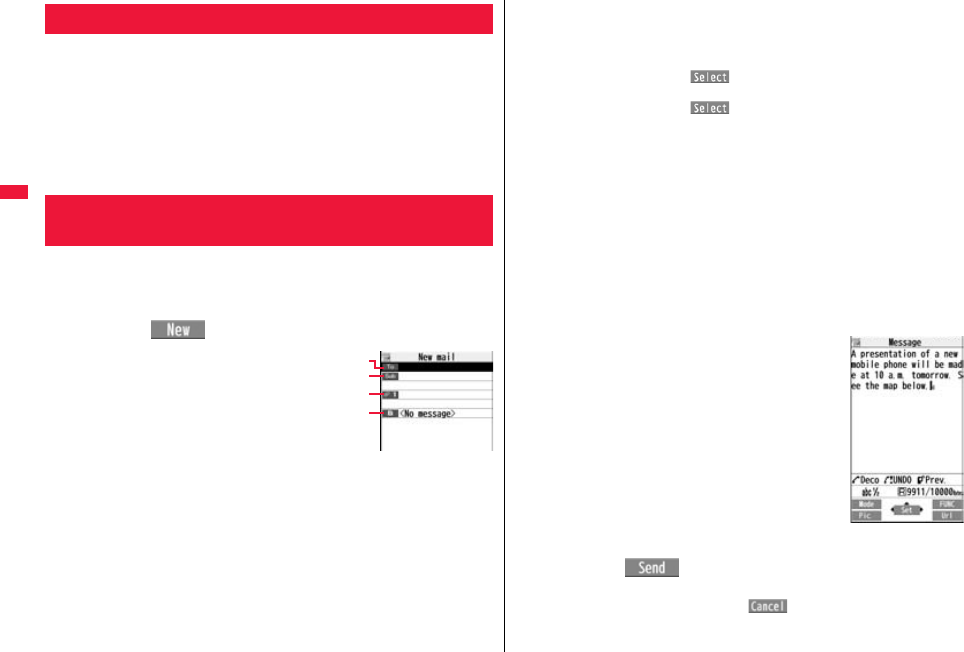
142
Mail
Once you subscribe to i-mode, you can exchange e-mails over the
Internet as well as among i-mode phones.
You can attach files (photos, movie files, etc.) within 2 Mbytes in total (up
to 10 files) besides mail text. The i-mode mail also supports Deco-mail, so
you can change the font color, font size, and background color of mail
text. Further, you can use the Deco-mail pictograms, so you can easily
send expressive messages.
≥For details on i-mode mail, refer to “Mobile Phone User’s Guide [i-mode] FOMA
version”.
You can compose and send i-mode mail messages.
You can save up to 1,000 sent i-mode mail messages including SMS
messages to the Outbox.
See page 146 for creating a Deco-mail message.
1l1l()
i-mode Mail
<Compose Message>
Composing and Sending i-mode Mail
Message
Composition display
Address field
Subject field
Text field
(When you enter text, the
number of bytes is displayed.)
Attachment field
2Select the address field1Select an item.
Phonebook. . . . . . . . . Call up a Phonebook entry and select a phone number or
mail address.
Sent address . . . . . . . Select a phone number or mail address and press
Oo().
Received address . . . Select a phone number or mail address and press
Oo().
Mail group . . . . . . . . . Select a mail group.
Enter address . . . . . . Enter a mail address or phone number.
≥You can enter up to 50 half-pitch characters.
≥If the destination is an i-mode phone, you can send mail also by entering only the
part preceding the “@” mark of a mail address.
≥See page 143 for sending to multiple destination addresses.
≥See page 144 for deleting an added address.
3Select the subject field1Enter a subject.
≥You can enter up to 100 full-pitch/200 half-pitch characters.
4Select the attachment field1Select an item.
≥See page 153 for how to select an attachment.
5Select the text field1Enter text.
≥You can enter up to 5,000 full-pitch/10,000 half-pitch
characters.
≥See page 144 for pasting a header or signature.
6Press l().
The animation display during transmission appears and the mail message is sent.
≥To cancel sending midway, press Oo( ) or press and hold r(for at least
one second). However, the mail message might be sent depending on the timing.
Message Entry
display
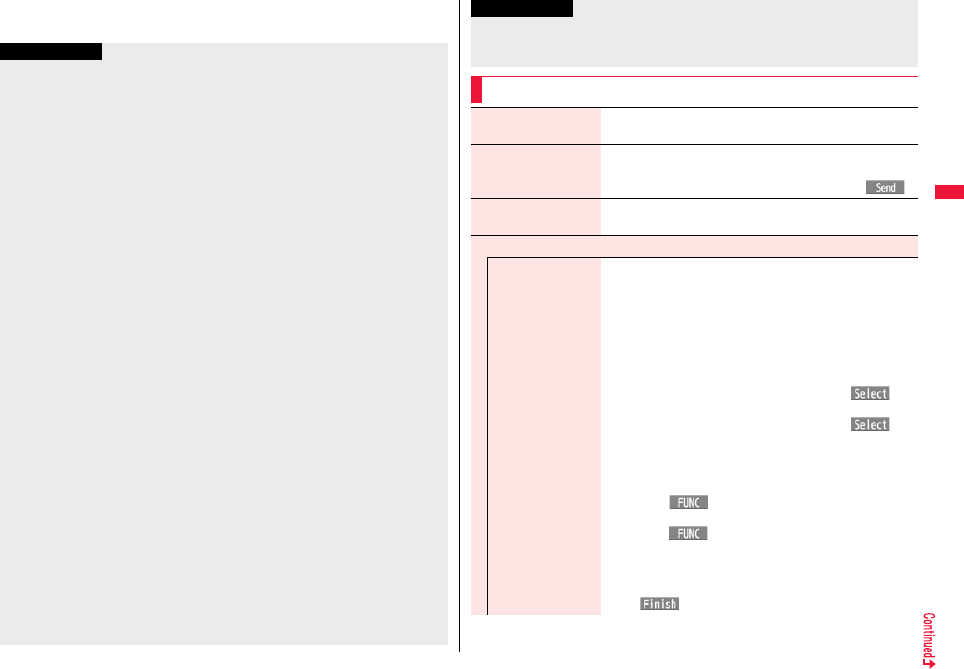
143
Mail
7OK
Information
≥Depending on the radio wave conditions, the characters might not be displayed
correctly at the destination.
≥If you send an i-mode mail message with a pictogram entered to another carrier’s
mobile phone, the pictogram is automatically converted into a similar pictogram at the
receiving end. Depending on the model or function of the receiving end’s mobile
phone, however, the pictogram might not be correctly displayed or be converted into a
character or “=” when no corresponding pictogram is found.
≥When the sent mail messages stored in the FOMA terminal exceed the maximum
number of storage, they are deleted from the oldest one. However, protected sent
mail messages are not deleted.
≥You cannot compose an i-mode mail message when sent mail messages in the
Outbox are saved to the maximum and all of them are protected, when 20 draft mail
messages are saved, or when the Draft is full.
Release the protection for sent mail messages, or send/delete draft mail messages,
and then operate again.
≥When you select “Compose message” from the Function menu such as when
entering a phone number, the mail address is entered as a destination address if the
phone number and mail address are stored in a Phonebook entry. When multiple mail
addresses are stored in the Phonebook entry, the first mail address is entered.
≥If you try to send the mail whose address is a phone number headed by “184”/“186”,
the confirmation display appears asking whether to delete prefix numbers and send
the mail.
≥When a destination phone number or mail address is stored in a Phonebook entry,
the name stored in the Phonebook entry is displayed in the address field.
≥You cannot send mail to the addresses that include a comma (,).
≥You can enter an address in the To, Cc and Bcc fields.
≥If a Phonebook entry with a secret code is set as a destination address, the secret
code will be automatically added at sending. Even if a secret code is set for the
Phonebook entry, however, it will not be added and the i-mode mail message will be
sent as ordinary one unless the destination address is a phone number or “phone
number@docomo.ne.jp”.
≥
If you store the secret code and send mail to a mail address other than that of DOCOMO
mobile phones, you might not receive the error message for unknown address.
≥The recipients might not be able to receive the full length of the subject depending on
their phones.
≥You can send up to 2,000 full-pitch characters in text to the i-mode phone of the mova
service.
≥Each line feed is counted as one full-pitch character, and a space is counted as one
full-pitch or half-pitch character.
≥The mail message you entered a Deco-mail pictogram becomes a Deco-mail
message.
≥In B Mode of 2in1, you cannot compose i-mode mail.
Function Menu of the Message Composition Display
Information
Send You can send the mail message.
Go to step 7 on page 143.
Preview Check the address, subject, text and attachments before
sending.
≥You can send the mail message by pressing l().
Save When composing or editing the mail, you can save it to the
Draft.
Operate receiver
Add receiver You can add multiple addresses in the address field to send
the same i-mode mail to multiple recipients simultaneously.
You can send the same mail to up to five addresses at the
same time.
1Select an item.
Phonebook . . . . . . . . . Call up a Phonebook entry and select
a phone number or mail address.
Sent address. . . . . . . . Select a phone number or mail
address and press Oo().
Received address . . . Select a phone number or mail
address and press Oo().
Enter address . . . . . . . Enter a mail address or phone
number.
≥To consecutively add addresses, select <Not entered> and
repeat the above operations.
≥Press i( ) and select “Delete receiver” to delete
the selected mail address. Select “YES”.
≥Press i( ) and select “Change rcv. type” to change
the type of mail. (See page 144)
≥Select an entered mail address on the Mail Composition
display to show the Address list.
1l()
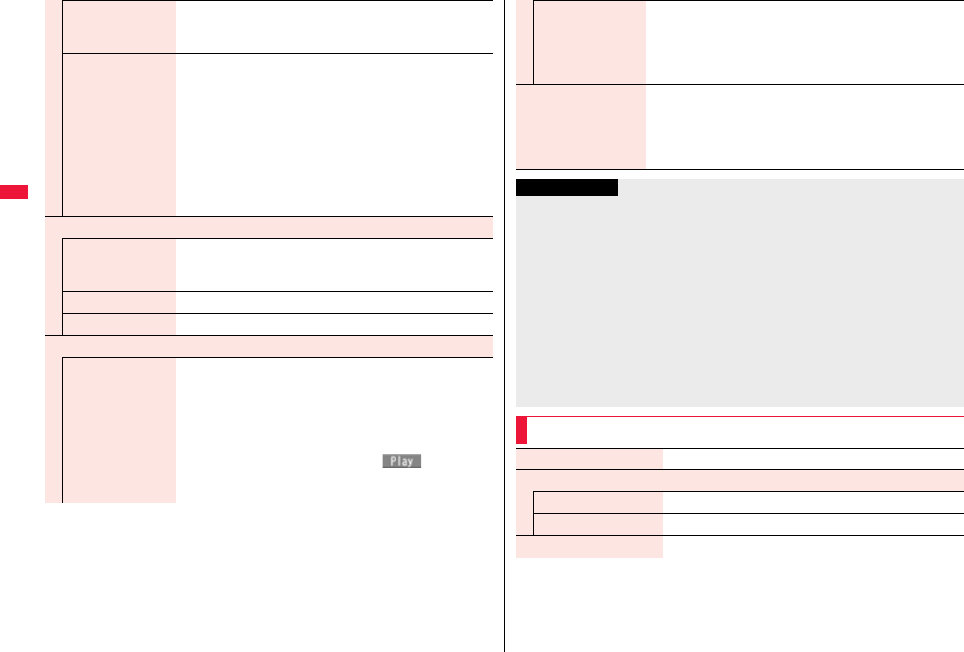
144
Mail
Delete receiver You can delete the selected address when there are multiple
addresses.
1YES
Change rcv. type 1Select a receiving type.
To . . . . . This is the direct destination address. “To” recipients
are displayed at the receiving ends.※
Cc . . . . . Specify to let parties know the mail contents in
addition to the direct recipients. “Cc” recipients are
displayed at the receiving ends.※
Bcc . . . . Specify to hide the recipients from others. “Bcc”
recipients are not displayed at the receiving ends.
※They might not be displayed depending on the mobile
phone, device, or mail software of the receiving end.
Operate att. file
Activate camera You can shoot and attach an image or i-motion movie.
1Select a shooting mode.
≥See page 233 and page 236 for how to shoot.
Attach file See page 153.
Delete att. file See page 155.
Template
Load template You can read in a Deco-mail template and create a Deco-mail
message.
≥When the text has already been entered, the confirmation
display appears asking whether to delete the text.
1Select a template.
The contents of the template are entered into the text.
≥While selecting a template, press l( ) to check the
contents of the template.
≥See page 146 for creating a Deco-mail message.
Save template You can save the Deco-mail message you are creating as a
template.
1YES
≥See page 201 when templates are stored to the maximum.
≥See page 151 for how to check the stored template.
Add header/sig. You can paste a header/signature at the beginning or ending
of the text of the i-mode mail message.
1Add header or Add signature
≥You need to store the header/signature beforehand. (See
page 176)
Information
<Operate receiver>
≥You cannot add any addresses if the address field for “To”, “Cc”, and “Bcc” already
contains five addresses in total or contains no addresses.
≥You cannot send i-mode mail if the “To” field is blank.
<Save template>
≥The subject of i-mode mail you are composing will be the title of the template. If no
subject is entered, the title takes the name of “YYYY/MM/DD hh:mm”.
(Y: year, M: month, D: date, h: hour, m: minute)
<Add header/sig.>
≥You cannot paste a header/signature if the text, including the header/signature, would
exceed 5,000 full-pitch or 10,000 half-pitch characters.
≥If the decoration such as font color or font size is set for the top or end of text, the
header or signature will be decorated as well.
Function Menu of the Message Entry Display
Decorate mail See page 147.
Template
Load template See page 144.
Save template See page 144.
Full pitch/Half pitch See page 432.
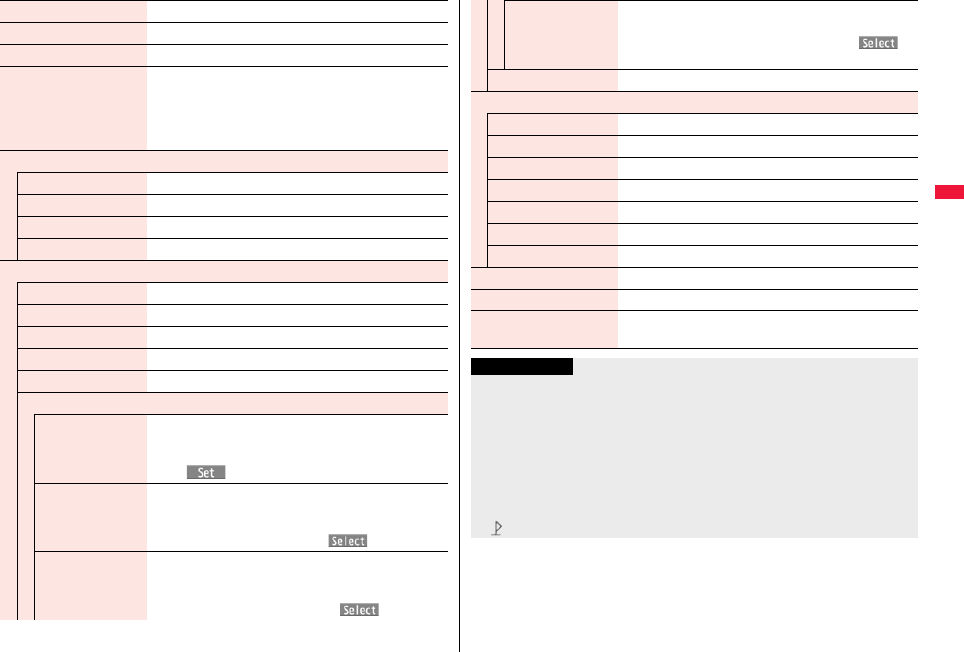
145
Mail
Copy See page 436.
Cut See page 436.
Paste See page 436.
Undo After entering or deleting characters, pasting data, or
operating on a decoration, you can undo your most recent
operation. You can do it up to twice.
≥You can undo the operation also by pressing and holding
d for at least one second.
Pictograms/symbols
Pictograms See page 433.
Symbols See page 433.
Smiley See page 433.
Space See page 433.
Phrase/quote
Common phrases See page 433.
Kuten code See page 433.
Input time See page 434.
Quote phonebook See page 434.
Quote own data See page 434.
Paste location
By position loc. You can obtain the location information by measuring the
current location (see page 326), convert that information
into the URL, and then paste it to the i-mode mail text.
1Oo()1YES
From loc. history You can convert the location information from Location
History (see page 335) into the URL, and paste it to the
i-mode mail text.
1Select a location record1Oo()1YES
From phonebook You can convert the location information stored in the
Phonebook into the URL, and paste it to the i-mode mail
text.
1Select a Phonebook entry1Oo()1YES
From own number You can convert the location information stored in “Own
number” into the URL, and paste it to the i-mode mail text.
1Enter your Terminal Security Code1Oo()
1YES
Bar code reader See page 244.
Character input
Own dictionary See page 436.
Learned words See page 437.
Change input mode See page 434.
Predict See page 432.
Candidate display See page 434.
Character set time See page 434.
2/NIKO-touch guide See page 434.
Help See page 434.
JUMP See page 434.
Preview You can check the contents of the text before sending.
≥You can preview also by pressing p.
Information
<Undo>
≥Once you use “Undo” to return to the previous status, you cannot cancel this by using
“Undo” again.
≥If you close the Message Entry display, you cannot return to the previous status by
using “Undo” when you re-open it. (However, after you have exited “Preview”, you can
return to the previous status by “Undo”.)
<Paste location>
≥You can paste up to 512 half-pitch characters, and the pasted URL is counted as the
number of characters in the mail text.
≥“ ” is inserted before the pasted URL. However, you can delete it while editing.
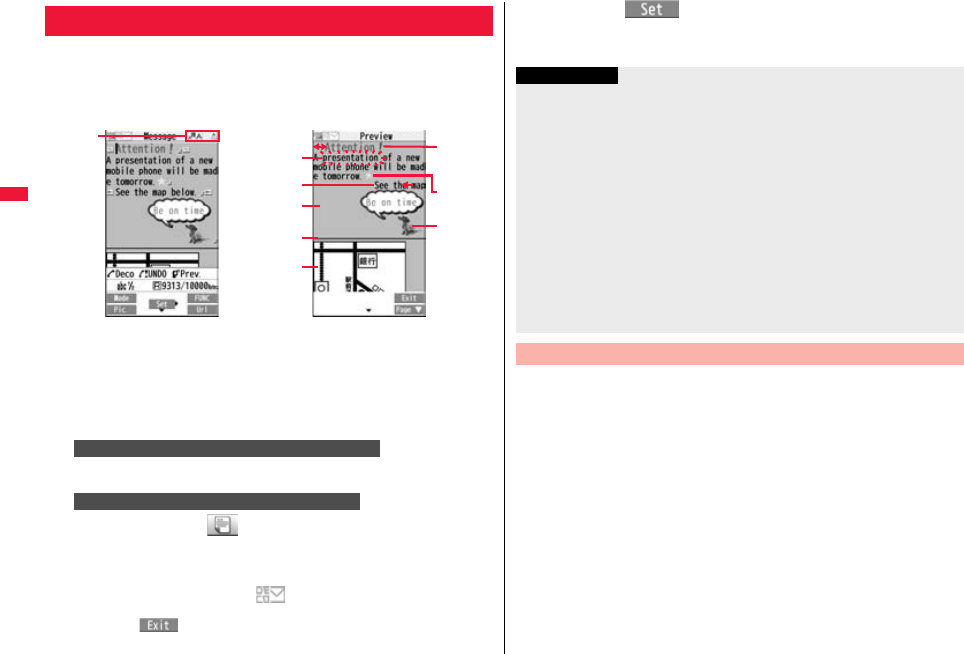
146
Mail
When editing an i-mode mail message, you can change the size of the
font and the color of the background as well as inserting images, thus
composing your own original mail.
You can create Deco-mail also using the templates (patterns).
(See page 151)
1Perform the operations in step 1 through step 4 on
page 142.
2Select the text field1Decorate the text using Palette.
≥See page 147 for how to use Palette.
d1Select one of decorations1Enter text.
Enter text1d1(Select area)
Go to “Select area” on page 148.
≥You can enter up to 5,000 full-pitch/10,000 half-pitch characters. (The number of
characters you can enter decreases depending on the decoration.)
≥Once you decorate the mail text, “ ” appears.
≥You can preview the contents of the text by pressing p.
Press i( ) to finish previewing and return to the former display.
Creating and Sending Deco-mail
Entering characters
Activated
decoration
Preview
Font color
Font size
Swing
Moving
font effect
Word
alignment
Deco-mail
pictogram
Ticker
Blink
Background
color
Insert line
Insert image
To enter text after selecting decorations
To set decorations after entering text
3Press Oo().
The Message Composition display is displayed.
Go to step 6 on page 142.
You can decorate the text of i-mode mail using Palette.
You can set multiple decorations for one point.
≥You cannot combine Word Alignment, Ticker, and Swing for one point.
≥Lines are inserted by Line Insert with the color specified by Font Color.
≥If Word Alignment, Ticker, or Swing is specified, the images and moving font effects
are inserted with the specified state.
≥You can enter Deco-mail pictograms using “Insert image”, and by “Pictograms” on the
Function menu as well.
Information
≥Even if you delete the decorated characters, only the decoration data remain and the
number of characters you can enter might decrease. Clear the decoration and then
delete the characters. If you delete the characters by pressing and holding
-r for at least one second, the characters as well as the decoration data are deleted.
≥When you reply with quote to a received Deco-mail message or you forward it, the
decorations and inserted images are entered in text as they are.
≥If you use a template containing an image unable to attach to mail for sending, the
image is deleted.
≥When you send a Deco-mail message in excess of 10,000 bytes, the mail message
with the URL for browsing is received at some destination i-mode phones. However,
only the mail text without the URL for browsing might be received at some models.
≥Decorations might not be correctly displayed if you send/receive Deco-mail messages
to/from the devices such as personal computers.
≥The movement of Ticker/Swing, blink and animation playback stop when a certain
period has passed.
Decorations
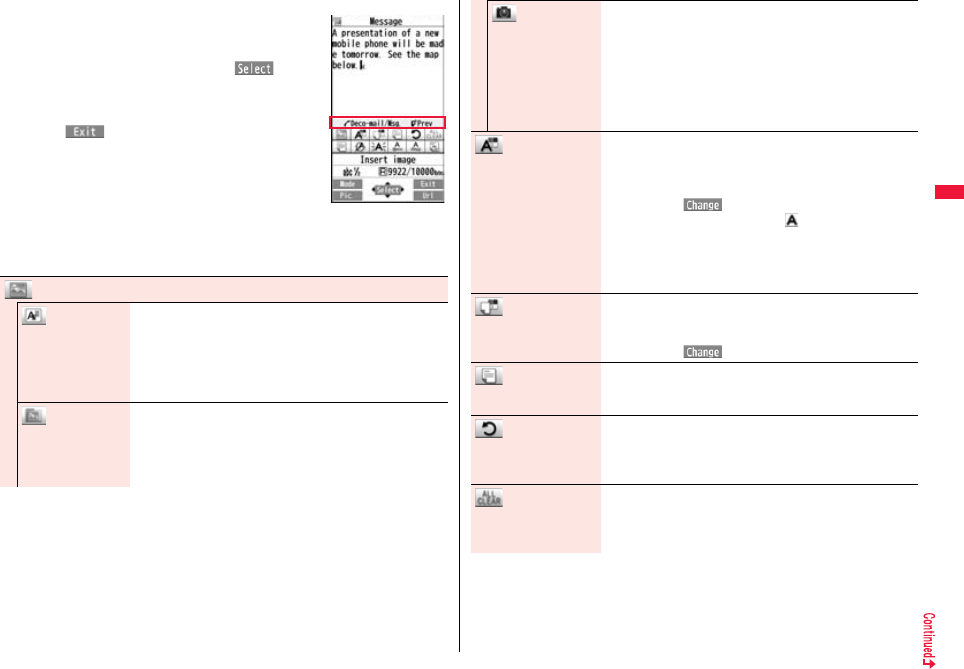
147
Mail
■How to use Palette
Press d from the Message Entry display to display Palette.
≥When the cursor is over the decorated character, the Palette
appears with the icon for the set decoration depressed.
Highlight the depressed icon and press Oo( ); then
you can change, complete or cancel the decoration. You can
release the area selection also by pressing r while the
area is selected.
≥Press i( ) to close Palette. You can close Palette
also by pressing r while you are operating on it.
Switch operations
You can switch between the operation of Palette and the
operation of entering text, each time you press d. You can
move the cursor and enter text with Palette displayed.
≥After you enter text, the text entry operation returns.
When you use Palette in succession, press d and operate it.
■How to operate Decoration
Palette operation
Insert image
Font effect You can convert characters to a mark and insert it into the
text. The mark animates in various ways and conveys your
feelings to the other party.
1Select a moving font effect1Enter text.
≥To delete the moving font effect, move the cursor to the
moving font effect and press r.
My picture You can insert the image stored in “My picture” into the text of
mail.
1Select a folder1Select an image.
≥To delete the image, move the cursor to the image and
press r.
Camera You can insert the image shot by the camera on the spot into
the text of mail.
1Shoot a still image.
≥The image size of the camera is Sub-QCIF (96 x 128), QCIF
(144 x 176) or QVGA (240 x 320).
≥To delete the image, move the cursor to the image and
press r.
≥See step 2 and step 3 on page 234 for how to shoot.
Font color You can change the color of characters and lines to be
entered.
1Select a color1Enter text.
≥You can switch between “20 Color” and “256 Color” by
pressing l().
≥In the font color changing mode, “ ” is displayed at the
upper right of the display.
≥You can set other decorations in succession.
≥When you have selected the area, you do not need to enter
text.
Background color
You can change the background color of the mail text.
1Select a color.
≥You can switch between “19 Color” and “256 Color” by
pressing l().
Insert line You can insert a horizontal line into the mail text.
The line feed is inserted automatically, and the line is inserted.
≥To delete the line, move the cursor to the line and press r.
Undo You can return to the previous status of the set decoration.
You can do it up to twice.
≥You can undo the operation also by pressing and holding
d for at least one second.
Decorate all reset You can release all the decorations.
1YES
≥If you have inserted an image, the message “In-line image is
deleted” is displayed.
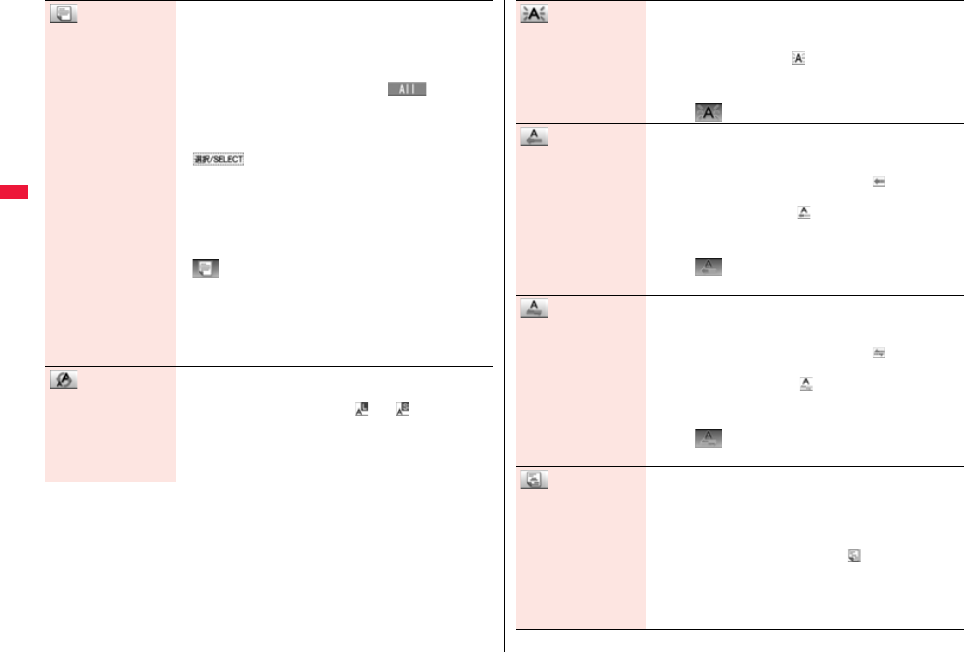
148
Mail
Select area You can set Font Color, Blink, Font Size, Word Alignment,
Ticker and Swing over the selected text you have entered.
You can also change the set decoration, add another
decoration, or cancel Blink, Ticker or Swing.
1Select a start point.
≥You can select all text by pressing i( ) and
selecting “YES”.
1Select an end point.
Set, change, add or cancel each decoration.
≥“ ” is displayed at the upper right of the display
during selecting decoration area.
<Set, change, or add decoration>
1Select an icon and set, change, or add decorations.
≥Select another icon in succession to change the multiple
decorations or add decorations.
1
≥When Blink, Ticker, or Swing has been set, reselect each
icon and complete decorations.
<Release Blink, Ticker, or Swing>
1Select the icon for Blink, Ticker, or Swing
1Select the same icon again.
Font size You can change the size of characters to be entered.
1Select a font size1Enter text.
≥In the font size changing mode, “ ” or “ ” is displayed at
the upper right of the display.
≥You can set other decorations in succession.
≥When you have selected the area, you do not need to enter
text.
Select blink You can make characters to be entered blink.
1Enter text.
The set characters are blinking.
≥In the blink setting mode, “ ” is displayed at the upper right
of the display.
≥You can set other decorations in succession.
1d1 (Reset blink)
Select ticker You can make characters to be entered and images to be
inserted flow (moving from right to left).
1Enter text.
The line feed is inserted automatically and “ ” is displayed
before and after the cursor.
≥In the ticker setting mode, “ ” is displayed at the upper
right of the display.
≥You can set other decorations in succession.
1d1 (Reset ticker)
The line feed is inserted automatically.
Select swing You can make characters to be entered and images to be
inserted swing (moving to left and right back).
1Enter text.
The line feed is inserted automatically and “ ” is displayed
before and after the cursor.
≥In the swing setting mode, “ ” is displayed at the upper
right of the display.
≥You can set other decorations in succession.
1d1 (Reset swing)
The line feed is inserted automatically.
Word alignment You can change the position of characters to be entered and
images to be inserted.
1Select a word alignment1Enter text.
The line feed is inserted automatically, and the alignment is
set.
≥In the word alignment setting mode, “ ” is displayed at the
upper right of the display.
≥You can set other decorations in succession.
≥When you have selected the area, you do not need to enter
text.
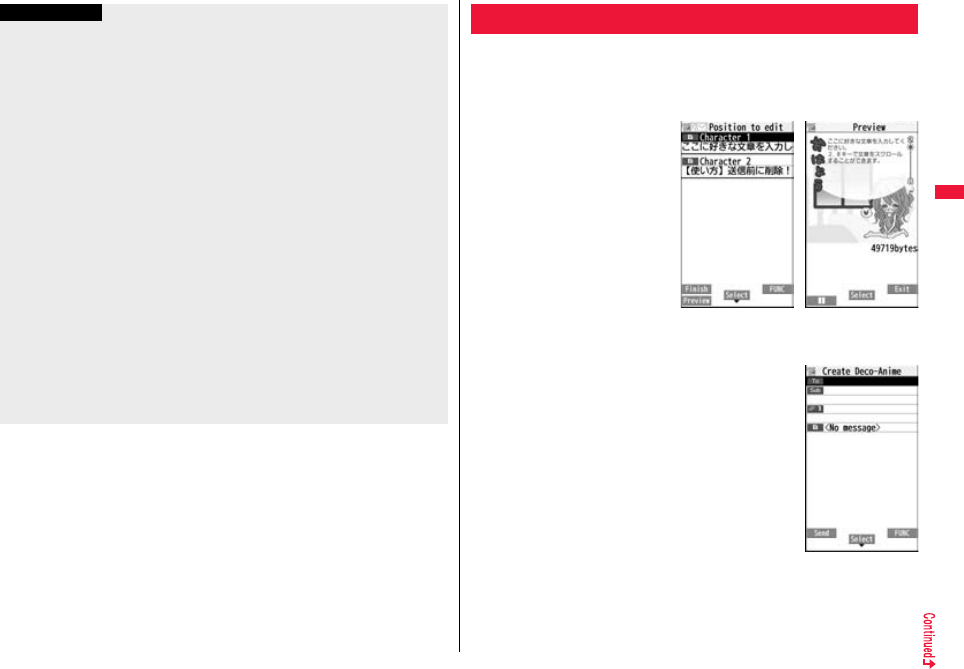
149
Mail
Information
<Insert image>
≥You can insert up to 20 types of images within 90 Kbytes in total. However, you can
insert up to 2 types of Flash movies. Even if the inserted images are 20 types or
fewer, the number of inserted images reaches maximum depending on the operation
and the confirmation display for re-editing appears.
≥If multiple same images are inserted, they are counted as a single type of file. If you
copy/paste the image already inserted, that image is regarded as the same image
and handled as a single type of file. However, if you insert the same Flash movie, it is
handled as the second type of files.
≥You can apply Blink, Ticker, Swing, and Word Alignment to the inserted images,
however, you cannot apply them to Flash movies.
<Font color>
≥If you move the cursor to the character for which another color is set, the setting
changes to that color.
≥The color for pictograms is also subjected to the specified font color. To restore the
color to ordinary one, select “指定なし/Default”.
≥You cannot change the color of Deco-mail pictograms.
<Background color>
≥You cannot change the background color when editing the header or signature.
<Font size>
≥If you move the cursor to the character for which a different font size is set, the font
size is changed to that size of the character.
≥You cannot change the size of the Deco-mail pictogram.
<Select blink>
≥You cannot make Deco-mail pictograms blink.
Decome-Anime is a mail service which enables you to create expressive
mail messages which have Flash movies with messages and images,
using Decome-Anime templates.
You can create them using templates pre-installed or purchased on the
IPs (Information Providers) site.
© SOCKETS
1l1Create new Decome-Anime
2Perform the operations in step 2 through step 4 on
page 142.
Creating and Sending Decome-Anime
Edit Decome-Anime
display
Preview
Create Decome-Anime
display
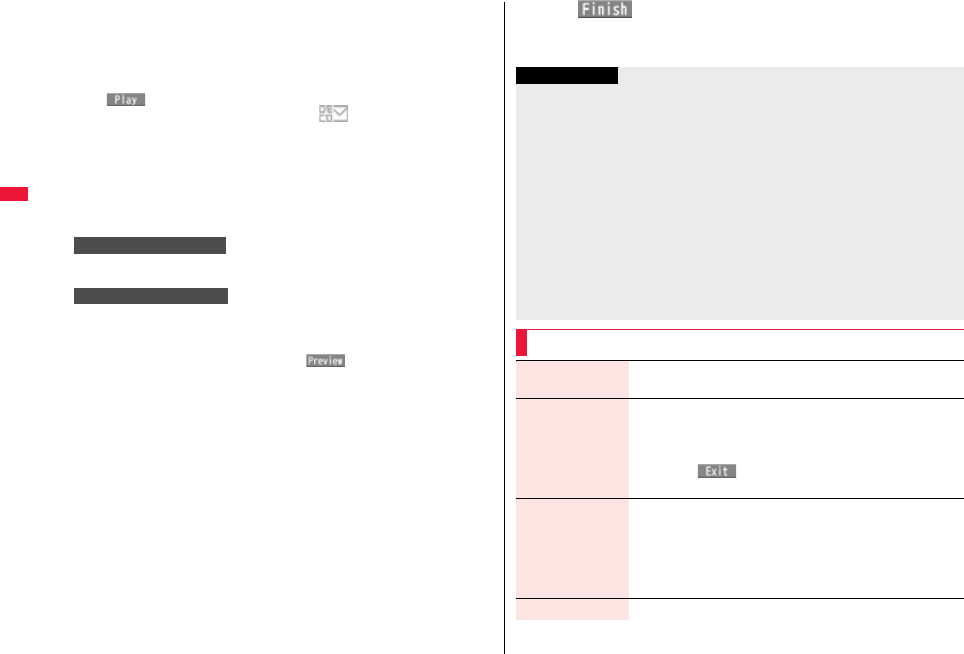
150
Mail
3Select the text field1Phone or microSD
1Select a Decome-Anime template.
≥When a Decome-Anime template is already selected, the Edit Decome-Anime
display appears. Go to step 4.
≥You can show the preview of the Decome-Anime template by pressing
l( ) from the Decome-Anime Template list.
≥When you select a Decome-Anime template, “ ” appears.
≥Depending on the Decome-Anime template, you cannot edit contents.
≥When you send the contents of the Decome-Anime template as they are, go to
step 5.
≥You cannot edit the Decome-Anime text when you re-edit it from the Draft or
Outbox or when you forward it from the Inbox.
4Select the contents field to be edited.
Select the character entry field1Edit characters.
Select the image entry field
1Select a folder, and select the image to be changed.
≥You can show the preview by pressing m( ) from the Edit
Decome-Anime display.
≥When you enter characters, you cannot set decoration for them and cannot enter
Deco-mail pictograms. In addition, you cannot paste header or signature.
≥When you insert a line feed in the middle of a line, the number of characters you
can enter decreases.
≥When the total size of Decome-Anime template, characters, and images exceeds
90 Kbytes, you can no longer enter characters and images.
≥Depending on the Decome-Anime template, you might not be able to insert
images even if the total size is 90 Kbytes or less.
≥As the fonts and display position of images and characters are fixed, you cannot
edit them.
≥Depending on the character entry field, 」 (red) which shows the line feed position
or 1 (orange) which shows the nonenterable area may appear on the Character
Entry (Edit) display.
To edit characters
To change images
5l()
The editing of the Decome-Anime message is completed.
Go to step 6 on page 142.
Information
≥You cannot create a Decome-Anime message when sent mail messages in the
Outbox are saved to the maximum and all of them are protected, when 20 draft mail
messages are saved, or when the Draft is full.
≥The images you can insert into Decome-Anime messages are GIF files (including
animation GIF), JPEG files, and SWF files.
≥When animation GIF files or SWF files are inserted, the volume overflow for sending
might occur.
≥Even when sending fails, you cannot re-edit it.
≥In the character entry field of some Decome-Anime templates, the text such as “使い
方 (how to use)” is pre-entered. Delete it before sending.
≥When you send a Decome-Anime message, the mail message with the URL for
browsing is received at some destination i-mode phones. However, only the
Decome-Anime text without the URL for browsing might be received at some models.
≥You cannot use the received Decome-Anime message as a template.
Function Menu of the Create Decome-Anime Display
Send You can send the Decome-Anime message.
Go to step 7 on page 143.
Preview You can check the playback of Decome-Anime message before
sending.
≥See page 153 for how the Decome-Anime messages are
played back.
≥Press i( ) to return to the Create Decome-Anime
display.
Save You can save the Decome-Anime message you are creating to
the Draft. After saving, you cannot re-edit the text of the
Decome-Anime message.
1YES
≥When you save it before selecting a Decome-Anime template, it
is saved as an i-mode mail message.
Operate receiver See page 143.
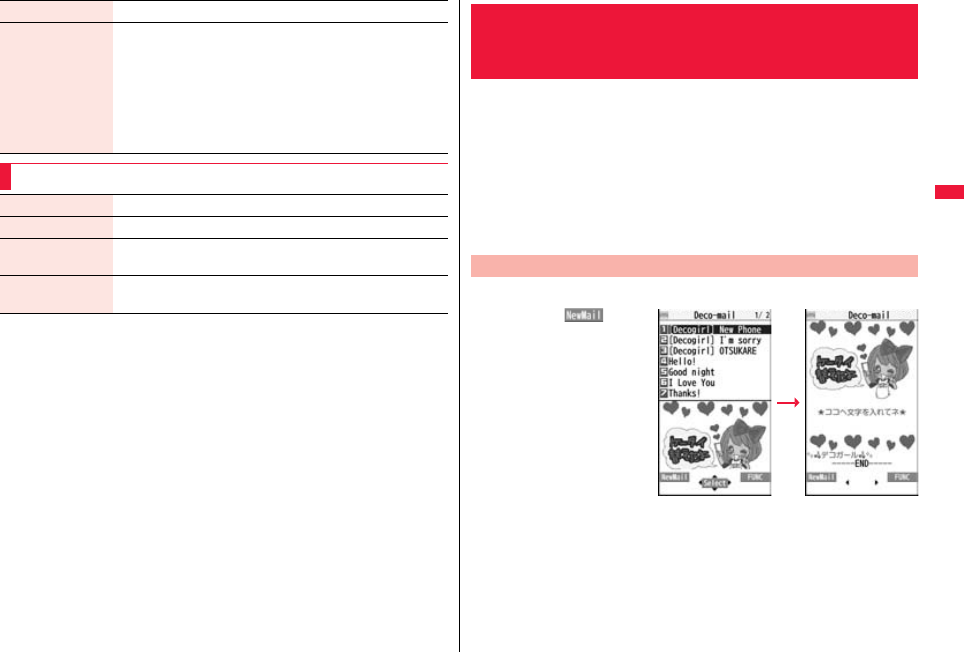
151
Mail
Operate att. file See page 144.
Template You can read in a Decome-Anime template to create a
Decome-Anime message.
1Phone or microSD
1Select a Decome-Anime template.
Go to step 4 on page 150.
≥If any Decome-Anime template is selected, the confirmation
display appears asking whether to discard the current contents
to read in the new one.
Function Menu of the Edit Decome-Anime Display
Template See page 151.
Preview See page 150.
Delete You can delete the entered image. The image entry field
becomes blank.
Quit editing You can end the editing of the Decome-Anime message.
Go to step 6 on page 142.
The template is the form data in which text and images are inserted.
Deco-mail templates and Decome-Anime templates are available.
Besides pre-installed templates, you can download templates from sites
(see page 200). You can save the sent/received/created Deco-mail
messages as the Deco-mail templates (see page 144 and page 170). You
can edit the saved Deco-mail templates using Palette. You cannot edit the
Decome-Anime templates.
≥You can delete the pre-installed templates. You can re-download them from the
“P-SQUARE” site (see page 202). When you use a UIM other than the one used for
downloading, the UIM security function (see page 37) is set for them.
1l1Template1Deco-mail1Select a template.
≥Press l( ) to
create a Deco-mail
message using the
contents of the template.
Go to step 2 on page 142.
≥Even if you set “Header/
signature” to automatically
paste the header or
signature, you cannot paste
it.
≥See page 201 when you
select “Search by i-mode”.
© SOCKETS
<Template>
Using a Template to Create Deco-mail/
Decome-Anime
Deco-mail Template
Deco-mail Template
list
Detailed Deco-mail
Template display
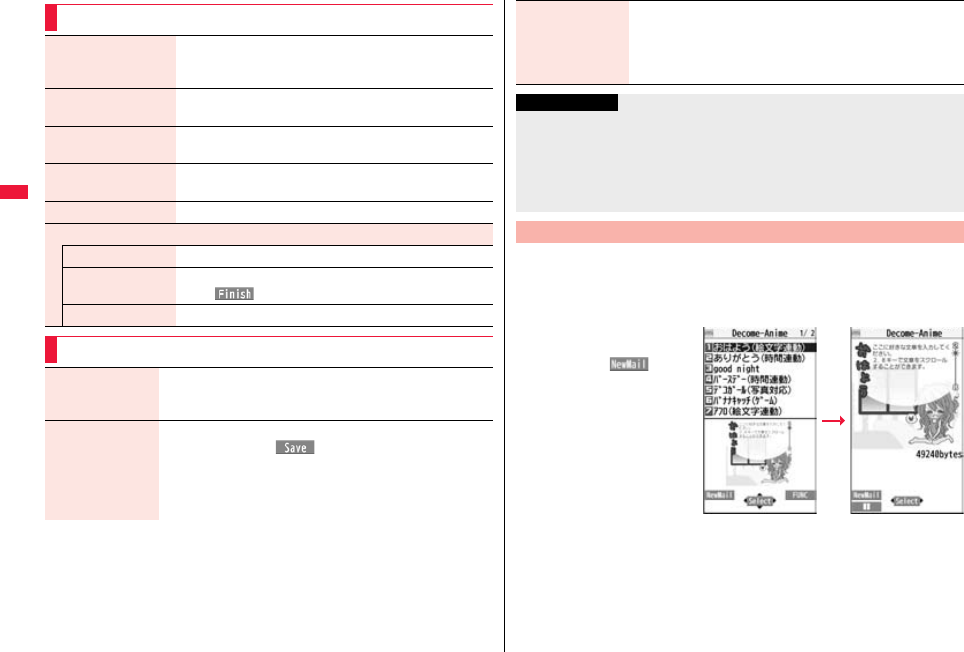
152
Mail
Function Menu of the Deco-mail Template List
Compose message You can create a Deco-mail message using the contents of
the template.
Go to step 2 on page 142.
Sort You can change the order of displayed templates.
1Select an order.
Edit title 1Enter a title.
≥You can enter up to 15 full-pitch/30 half-pitch characters.
Info You can display the file size, saved date and time of the
template, and whether it contains images.
No. of templates You can display the number of saved templates.
Delete
Delete this 1YES
Delete selected 1Put a check mark for templates to be deleted
1l()1YES
Delete all 1Enter your Terminal Security Code1YES
Function Menu of the Detailed Deco-mail Template Display
Compose message You can create a Deco-mail message using the contents of the
template.
Go to step 2 on page 142.
Edit You can edit the contents of the template and save it.
1Edit the text1Oo()1YES or NO
YES. . . . Overwrites and saves.
NO. . . . . Saves as a separate file.
≥See step 2 and step 3 on page 146 for how to edit the text.
≥See page 201 when the templates are stored to the maximum.
1l1Template1Decome-Anime1Phone or microSD
≥See page 201 when you select “Search by i-mode”.
2Select a template.
The preview of the template
is displayed.
≥Press l( ) to
create the Decome-Anime
message with the template
contents. Go to step 2 on
page 149.
© SOCKETS
Save insert image You can save images inserted into the template or Deco-mail
text, and set them as the Stand-by display and Wake-up display.
1Select an image1YES1Select a destination folder.
Go to step 3 on page 199.
≥See page 201 when images are stored to the maximum.
Information
<Edit>
≥The title name when saved as a separate file takes “YYYY/MM/DD hh:mm”
(Y: Year, M: Month, D: Date, h: hour, m: minute).
<Save insert image>
≥Deco-mail pictograms are saved to the “お気に入り (Favorite)” folder in the
“Deco-mail pictograms” folder.
Decome-Anime Template
Decome-Anime
Template list
Preview
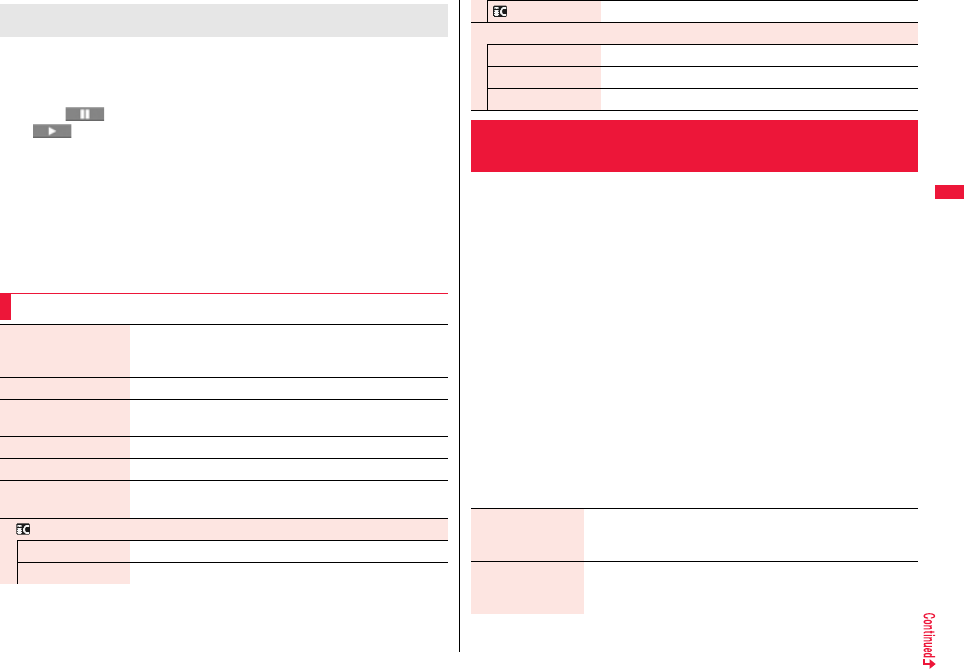
153
Mail
The animation is played back automatically. The effect tones may sound and the FOMA
terminal may vibrate for some Decome-Anime messages. Further, you can operate from
the playback display or preview of some Decome-Anime messages by using Bo, Oo,
0 through 9, s, or a.
≥Press m( ) to pause the animation and effect tone during playback. Press
m( ) again to resume the animation playback.
≥The effect tone sounds following the setting of “Auto melody play”. Each time you show
the preview from the Decome-Anime Template list, the effect tone sounds regardless
of the setting.
≥The effect tone does not sound during Play Background.
≥The FOMA terminal vibrates regardless of the setting of “Vibrator” or “Manner mode
set”.
≥Some Decome-Anime messages refer to the phone-information data in your FOMA
terminal. To permit the use of the information in your FOMA terminal, set “Use phone
information” of “i-mode settings” to “YES”. (“YES” is set at purchase.)
When you show the Decome-Anime Playback display or
preview
Function Menu of the Decome-Anime Template List
Create Deco-Anime You can create a Decome-Anime message using the contents
of the template.
Go to step 2 on page 149.
Preview You can display the preview of the Decome-Anime template.
Edit title 1Enter a title.
≥You can enter up to 10 full-pitch/20 half-pitch characters.
Copy to microSD See page 370.
Copy to phone See page 371.
Info You can display the title, file name, format, and whether it set
with file restriction.
Ir/ transmission
Send Ir data See page 384.
Send all Ir data See page 385.
You can send an i-mode mail message with files attached.
You can attach following files:
・Still image ・Melody ・Movie/i-motion movie
・ToruCa file ・PDF file ・Phonebook entry ・Schedule event
・ToDo item ・Bookmark (i-mode, Full Browser) ・Word
・Excel ・PowerPoint ・SD other files
You can attach up to 10 files within 2 Mbytes in total.
≥You cannot attach files prohibited from being attached to mail or being output from the
FOMA terminal.
≥
Regardless of the “File restriction” setting, you can attach the still image or movie/
i-motion movie shot with your FOMA terminal or the files received via infrared rays.
≥When you attach a file, another attachment field appears on the Message Composition
display.
≥Depending on the destination i-mode phone, only the compatible files are received
within the memory space of that phone.
≥It might take a time to send the i-mode mail depending on the size of attached files.
1Message Composition display
1Select the attachment field
1Do the following operations.
transmission See page 387.
Delete
Delete this See page 152.
Delete selected See page 152.
Delete all See page 152.
<Attachments>
Attaching a File
Picture 1Select a folder1Select an image.
≥Select an attached image to display it. Press r to return to the
former display.
Melody 1Select a folder1Select a melody.
≥Select an attached melody to play it back. Press any key to stop
the playback.
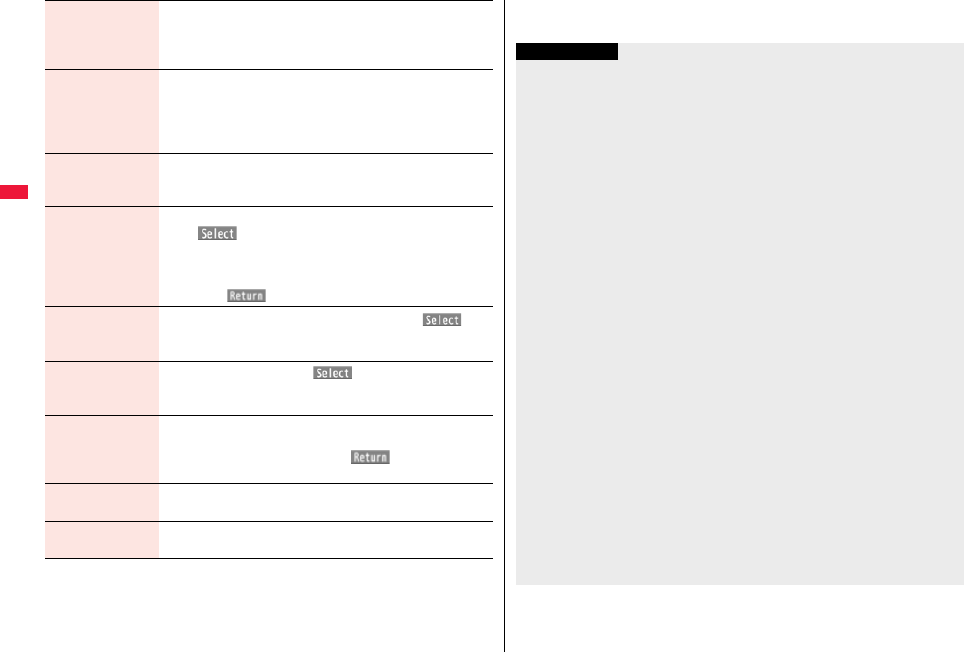
154
Mail
imotion 1Select a folder1Select an i-motion movie.
≥Select the attached i-motion movie to play it back. Press r
during playback or stop the playback to return to the former
display.
ToruCa When the ToruCa file is a ToruCa file (details), it is attached as a
ToruCa file (details).
1Select a folder1Select a ToruCa file.
≥Select the attached ToruCa file to preview it. Press r to return
to the former display.
PDF 1Select a folder1Select a PDF file.
≥Select an attached PDF file to display it. Press r to return to
the former display.
Phonebook 1Select a search method1Select a Phonebook entry
1Oo()
≥When you specified a search method last time, the Phonebook
entry is searched by that method.
≥Select the attached Phonebook entry to display the details.
Press i() or r to return to the former display.
Schedule 1Select a date1Select a schedule event1Oo()
≥Select the attached schedule event to display the details. Press
r to return to the former display.
ToDo 1Select a ToDo item1Oo()
≥Select the attached ToDo item to display the details. Press r
to return to the former display.
Bookmark 1i-mode or Full Browser1Select a bookmark.
≥Select the attached bookmark to display the title, address, and
others of the bookmark. Press i() or r to return to
the former display.
Document file You can attach a file of Word, Excel, and PowerPoint.
1Select a folder1Select a file.
Other You can attach a file stored in “SD other files”.
1Select a folder1Select a file.
2Go to step 2 on page 142.
Information
<Picture>
≥The images are not sent as the attachments to i-mode phones of the mova service;
they are in the form of URLs for browsing images and automatically attached with
expiry dates and can be obtained by selecting URLs. The mail text that can be sent to
an i-mode phone of the mova service is up to 184 full-pitch characters (369 bytes).
(When the acceptable number of characters of the mova phone is “250 full-pitch
characters”)
When multiple files are attached, the files are deleted and just the mail text is sent.
≥The i-mode phone of the mova service cannot receive GIF images.
≥You can attach a Flash movie as well.
≥The still image might not be received correctly or not be displayed or coarsely
displayed depending on the model at the receiving end.
<Melody>
≥Melodies stored on the microSD card cannot be attached. Copy the melodies to the
FOMA terminal. (See page 373)
≥If the receiving end is other than P-02A, the sent melody might not be played back
correctly or the attachment might be deleted.
≥You cannot receive the attached melody on the i-mode phone of the mova service.
<imotion>
≥Some i-motion movies cannot be attached to mail or their file sizes may become
larger or smaller.
≥Movies stored on the microSD card cannot be attached. Copy the movies to the
FOMA terminal. (See page 373)
≥Depending on the mobile phone of the receiving end, i-motion movies cannot be
correctly received/displayed, might become coarse, or might be converted into
consecutive still images.
When sending movies to other than the 2 Mbytes compatible model, it is advisable to
shoot them with the following settings:
File size setting: Mail restrict’n (S)
Image quality: Normal
<ToruCa>
≥ToruCa files stored on the microSD card cannot be attached. Copy the ToruCa files to
the FOMA terminal. (See page 319)
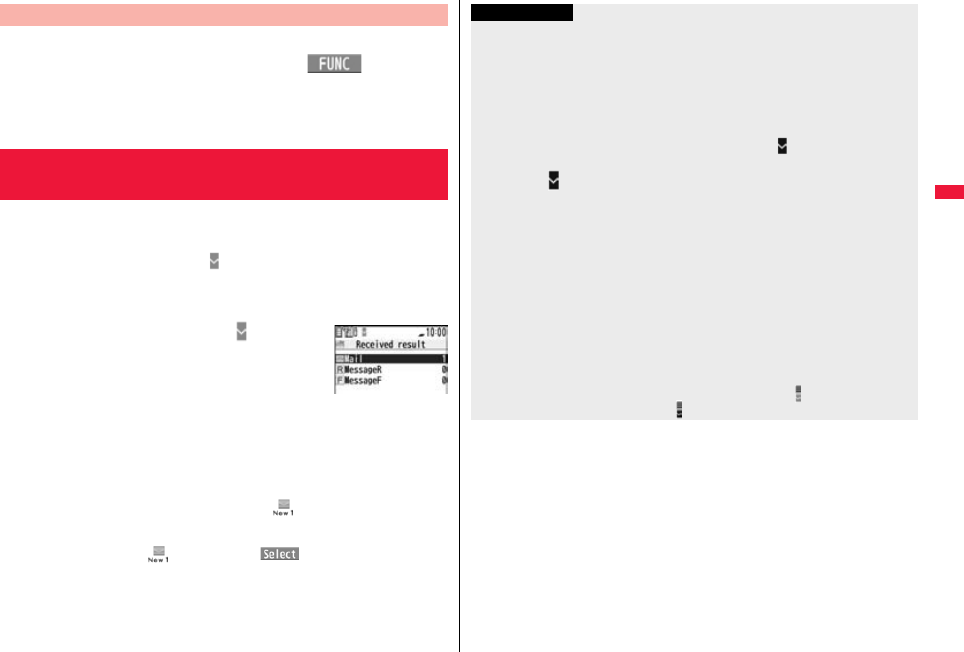
155
Mail
You can delete a selected attached file or all attached files.
1Message Composition display1 i()
1Operate att. file1Delete att. file
1Delete this or Delete all1YES
≥To delete a single file, highlight a file to be deleted.
When the FOMA terminal is in the service area, you can receive i-mode
mail, SMS messages and SMS reports automatically. (See page 156 for
receiving i-mode mail after selecting it.)
When a mail message comes in, “ (pink)” appears at the top of the
display.
You can save up to 2,500 received i-mode mail messages including SMS
messages.
1When i-mode mail arrives, “ (pink)”
blinks and the receiving message is
displayed.
When receiving is completed, the display shows the
number of received i-mode mail messages and
Messages R/F.
≥You can display the Inbox list by selecting “Mail”.
≥To cancel receiving midway, select “Cancel” or press and hold r for at least
one second while “Mail Receiving...” is displayed. However, the mail message
might be received depending on the timing.
≥If no keys are pressed for about 15 seconds, “ ” (see page 29) appears on
the desktop and the former display returns. (The transit time varies depending on
the setting for “Mail/Msg. ring time”.)
Press Oo, highlight “ ”, and press Oo( ) to display the Inbox list.
Delete Attached File
<Mail Auto-receive>
Receiving i-mode Mail Automatically
Reception Result
display
Information
≥You can automatically receive up to 100 Kbytes of an i-mode mail message including
attached files. You can manually obtain the attached files in excess of 100 Kbytes
from the i-mode Center. (See page 158)
≥When the received mail messages exceed the maximum number of or size of
storage, they are deleted in order of mail in the “Trash box” folder and older received
mail. However, unread or protected mail messages are not deleted.
≥When the total number of unread or protected mail messages in the Inbox has
reached the maximum, no new mail can be received and “ (dark blue)” is displayed.
To receive i-mode mail, delete received mail or read unread mail or release protection
of mail until “ (dark blue)” clears, and then perform “Check new messages”.
≥You can receive i-mode mail with melodies, still images, or other files attached. You
can receive incompatible attached files but you cannot display them.
≥When you receive mail from a device that can set To, Cc and Bcc, you can check
whether the message was sent to you as To, Cc or Bcc.
≥Mail Messages received in the following cases are held at the i-mode Center:
・When the power is off ・During a videophone call
・During Self Mode ・When you are out of the service area
・During infrared communication ・While connecting to the FirstPass center
・During PushTalk communication ・During Omakase Lock
・During iC communication ・While copying to the microSD card
・While connecting to the Data Storage Center
・When the space of the Inbox is full with protected or unread messages
≥When i-mode mail messages are held at the i-mode Center, “ (pink)” appears, and
when they are held to the maximum, “ (dark blue)”, appears.

156
Mail
1Reception Result display1Mail
1Select an i-mode mail message to be
displayed.
≥For a Decome-Anime message, the Decome-Anime
Playback display appears. Press i( ) to show
the detailed display.
≥Press and hold No for at least one second from the
detailed i-mode mail display to change the size of
characters. (See “Mail” on page 119.)
Display Newly Received i-mode Mail
Information
≥Undisplayable characters are replaced by spaces, etc.
≥When the number of characters in the text of received i-mode mail exceeds the
maximum, “/” or “//” is inserted at the end of the text and the excess part is deleted
automatically.
≥The still image automatically displayed at opening might not be correctly displayed.
When the image is larger than the screen size, it is displayed shrunk with a
proportional ratio retained.
≥Some decorations inserted into the decorated mail (HTML mail) sent from a personal
computer might not be displayed correctly.
You can check the titles of i-mode mail messages held at the i-mode
Center and select them to receive, or delete them at the Center before
receiving.
To use this function, set “Receive option setting” to “ON” beforehand.
When “Receive option setting” is set to “ON”, you cannot receive i-mode
mail messages automatically. When a mail message comes in the i-mode
Center, “ ” is displayed.
You can set whether to select and receive necessary i-mode mail only.
1l1Mail settings1Receive option setting1ON or OFF
1l1Receive option1Operate following the procedure
described in “Mobile Phone User’s Guide [i-mode]
FOMA version”.
≥When “Receive option setting” is set to “OFF”, the display to the effect that it will
be set to “ON” appears.
Press Oo( ) to set “Receive option setting”.
≥You can show the Receive Option display also by i1iMenu
1メニューリスト (Menu List)1メール選択受信 (Receive Option).
<Receive Option>
Receiving i-mode Mail Selectively
Receive Option Setting
Select and Receive Mail Messages
Information
≥Even when Receive Option Setting is set to “ON”, you will still receive all mail
messages if you execute “Check new messages”. If you do not want to receive all
mail messages, remove a check mark from “Mail”. (See page 175)
≥When you show the Receive Option display, the “ ” icon goes off. Also, the “ ” icon
goes off if you turn the power off or show the mail display.
≥You cannot select SMS messages for receiving.
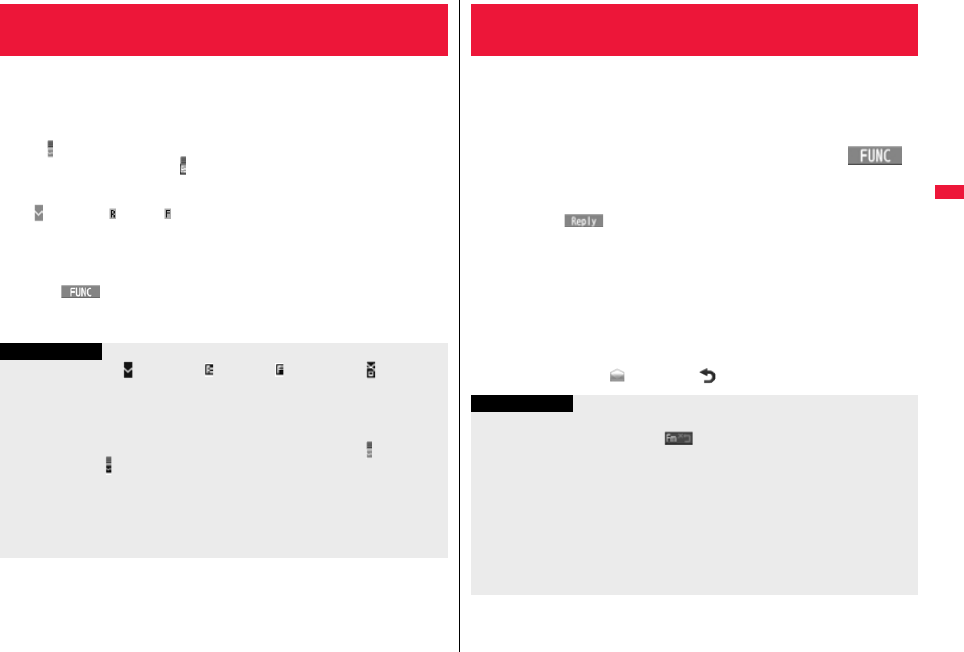
157
Mail
i-mode mail messages and Messages R/F arriving at the i-mode Center
are automatically sent to your FOMA terminal. However, the messages
will be held at the i-mode Center if your FOMA terminal cannot receive
mail because it is turned off or out of the service area, or when Receive
Option Setting is set to “ON”.
When “ (pink)” is displayed, receive mail by checking the i-mode Center.
See “Receive option” when “ ” is displayed.
1Press and hold l for at least one second.
“ (pink)” and “ (yellow)/ (yellow)” blink, the message “Checking...” is
displayed, and then you receive i-mode mail messages and Messages R/F.
As the checking results, the number of newly received i-mode mail messages and
Messages R/F is shown.
≥You can also execute “Check new msg.” during a voice call by pressing
i().
≥To cancel receiving midway, press and hold r for at least one second.
However, the mail message might be received depending on the timing.
<Check New Messages>
Checking New i-mode Mail
Information
≥When icons such as “ (dark blue)”, “ (dark blue)/ (dark blue)” or “ (dark blue)”
are displayed, the FOMA terminal cannot receive any more i-mode mail messages or
Messages R/F. Delete unnecessary mail and messages, read unread mail and
messages, or release protection. (Read and unprotected mail and messages are
automatically deleted from the oldest one.)
≥Even when i-mode mail messages are held at the i-mode Center, the “ (pink)” icon to
that effect, or the “ (dark blue)” icon telling that messages are held to the maximum
at the i-mode Center might not appear. (This happens if mail arrives at the Center
when, for instance, your FOMA terminal is off.)
≥You can select items to be checked by “Set check new messages”.
≥You cannot use this function to receive SMS messages. Use “Check new SMS” to
receive them.
By “Rep.w/ i-mode mail”, you can reply with a normal i-mode mail
message, and by “Rep. w/ Deco-Anime”, you can reply with a
Decome-Anime message. By “Reply with quote”, you can quote the text
of your received i-mode mail to reply. You cannot use “Reply with quote”
for Decome-Anime messages and SMS messages.
1Inbox list/Detailed Received Mail display1i()
1Reply/forward1Rep.w/ i-mode mail,
Rep. w/ Deco-Anime or Reply with quote
≥Press l( ) to reply by i-mode mail.
≥If other recipients of the simultaneous mail are found, you can choose whether to
reply to the sender only or to all addresses.
Select “To sender” or “To all”.
≥Just one quotation mark (see page 176) is added to the beginning of the text in
the i-mode mail to be replied with quote.
2Enter a subject and text, and then send.
When you have selected i-mode mail, go to step 3 on page 142.
When you have selected an SMS message, go to step 3 on page 186.
After you send mail, “ ” changes to “ ”.
<Reply> <Reply with Quote>
Replying to Received i-mode Mail
Information
≥For the sender’s address that cannot be replied to (such as when the mail address
exceeds 50 half-pitch characters), “ ” is displayed.
≥“Re:” is prefixed to the subject of the mail message to be replied or replied with a
quotation. When the subject exceeds 100 full-pitch characters, the excess is deleted.
(When “Re:” has already been prefixed, it changes to “Re2:” and will be counted up to
“Re99:”.)
≥Even if the i-mode mail text contains pasted data, you cannot quote it in your reply.
Also, you cannot quote it when using the DOCOMO keitai datalink or infrared
communication function. See page 163 for pasted data.
≥If the Deco-mail text contains images prohibited from being attached to mail or being
output from the FOMA terminal, such images will be deleted when you reply.
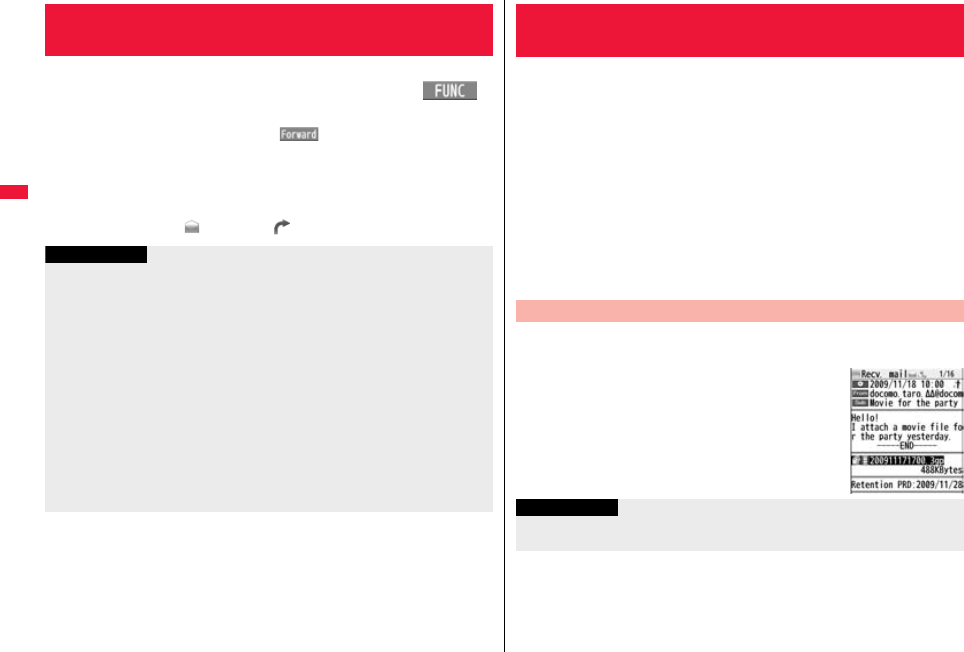
158
Mail
You can forward the i-mode mail or SMS messages to others.
1Inbox list/Detailed Received Mail display1i()
1Reply/forward1Forward
≥You can forward also by pressing m( ) from the Inbox list.
2Enter a subject and address, and send the mail.
When you have selected an i-mode mail message or a Decome-Anime message,
go to step 2 on page 142.
When you have selected an SMS message, go to step 2 on page 186.
After you send mail, “ ” changes to “ ”.
<Forward>
Forwarding Received i-mode Mail
Information
≥“Fw:” is prefixed to the subject of the mail message to be forwarded. When the subject
exceeds 100 full-pitch characters, the excess is deleted. (When “Fw:” has already
been prefixed, it changes to “Fw2:” and will be counted up to “Fw99:”.)
≥When you forward an i-mode mail message with a file you have not obtained yet, the
file information is deleted.
≥Even if the i-mode mail text contains pasted data, you cannot quote it in your
forwarding mail. Also, you cannot quote it when using the DOCOMO keitai datalink or
infrared communication function. See page 163 for pasted data.
≥When a mail message is forwarded and a ToruCa file (details) that contains data
whose output from the FOMA terminal is prohibited is attached to the mail message,
the attached file returns to a ToruCa file before receiving details.
≥When a mail message on the microSD card is forwarded, the attached file is deleted.
≥When you “Forward” a mail/SMS message received to Address B/Number B in Dual
Mode of 2in1, the sent mail message is retained in the Outbox or Draft, even if you
switch to A Mode.
You can receive up to 2 Mbytes of the attached files on your FOMA
terminal. However, if attached files exceed 100 Kbytes, only information
of all or part of attached files is received. You need to obtain attached
files again from the i-mode Center.
The FOMA terminal supports following files:
・Still image ・Melody ・Movie/i-motion movie
・PC movie ・ToruCa file ・PDF file ・Phonebook entry
・Schedule event ・ToDo item ・Bookmark (i-mode, Full Browser)
・Word ・Excel ・PowerPoint
You cannot play back or display the files other than above. You can save
them to any folder in “SD other files”, or use the i-mode mail to forward
them.
You can use “Attachment preference” to select the files to be received.
≥When multiple data items are pasted, they might not be displayed.
You can obtain the receive option attached files held at the i-mode
Center.
1Detailed Received Mail display
1Select an attached file which has not
been obtained.
After obtaining is completed, files are played back/
displayed.
When i-mode Mail with Files Attached/
Pasted is Received
Obtain Receive Option Attached Files
Information
≥You cannot obtain the attached files when the unused memory space in the Inbox is
smaller than the files.
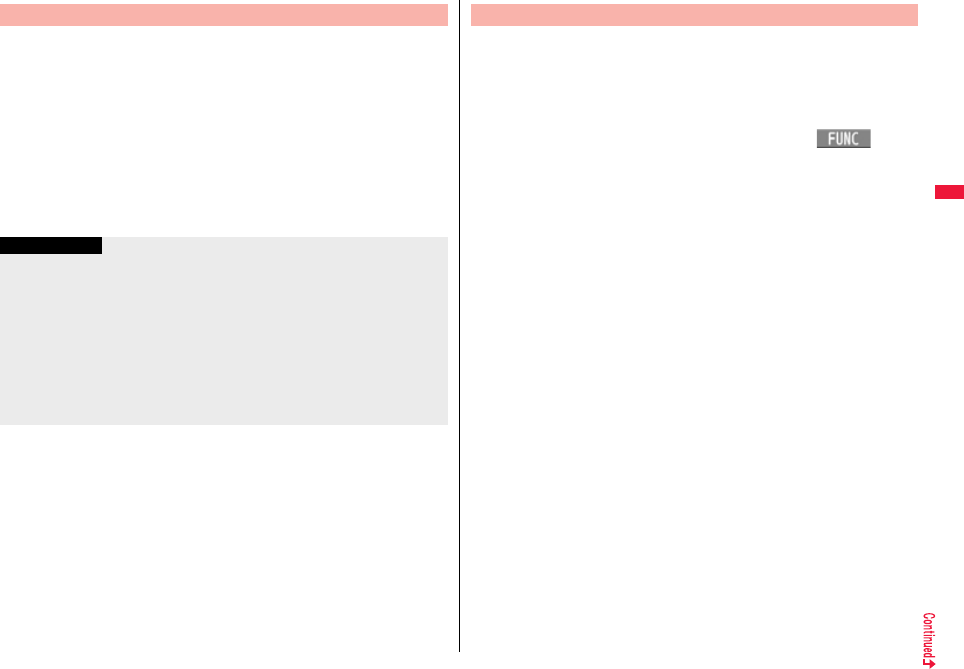
159
Mail
You can play back or display the attached/pasted files already obtained.
1Detailed Sent Mail display/Detailed Received Mail
display1Select an attached file.
The file is played back or displayed.
≥For a PC movie or document file, the confirmation display appears telling that you
cannot play it back/display it. Play it back/display it after saving it to the microSD
card.
≥For the files which are not supported by the FOMA terminal, the confirmation
display appears asking whether to save them.
≥You can display only the first item when a file of Phonebook entries, schedule
events, ToDo items or bookmarks is attached.
Play Back/Display Attached or Pasted Files
Information
≥When the sender’s device is other than P-02A, the received melodies might not be
played back correctly.
≥When the first attached file is an obtained still image, that still image only is
automatically displayed when the mail message is opened. The size of a still image
displayed automatically is up to 5M (1944 x 2592) size.
≥When the image size is larger than the screen, it is displayed shrunk.
≥You cannot play back a melody in excess of 100 Kbytes.
≥You cannot play back a Flash movie in excess of 100 Kbytes.
≥You cannot display a ToruCa file in excess of 1 Kbyte and ToruCa file (details) in
excess of 100 Kbytes.
You can save the attached or pasted files that you have obtained. You
can set some files for a ring tone, or an image on the Stand-by display,
Wake-up display, or other displays.
1Detailed Sent Mail display/Detailed Received Mail
display/Detailed Message R/F display
1Highlight an attached file and press i()
1Operate file1Save attached file1YES
≥PC movies are saved to the destination folder in “microSD” folder of “PC Movie”.
≥Document files are saved to the destination folder in “Document viewer”.
≥The files not supported by the FOMA terminal are saved to the destination folder
in “SD other files”.
≥Even if the files are supported by the FOMA terminal, some of them cannot be
saved to the FOMA terminal depending on the file such as an invalid data file or
whose size is too large. In that case, the confirmation display appears asking
whether to save it to the microSD card. When you save it, it is saved to a
destination folder in “SD other files”.
≥The confirmation display might appear telling that a part of the file cannot be
saved depending on the attached file.
2Select a destination or folder to save to.
For melodies, go to step 3 on page 201.
For still images, go to step 3 on page 199.
≥Bookmarks are saved according to each information of i-mode or Full Browser.
≥If the maximum number of files has already been saved to the microSD card or
there is no usable memory space when you save SD other files, PC movies, or
document files, the confirmation display appears asking whether to delete
unnecessary files to save new files. Select “YES”, and select unnecessary files
from the displayed list in Data Box to delete them. See page 201 when files other
than SD other files, PC movies, or document files are stored to the maximum.
Save Attached or Pasted Files
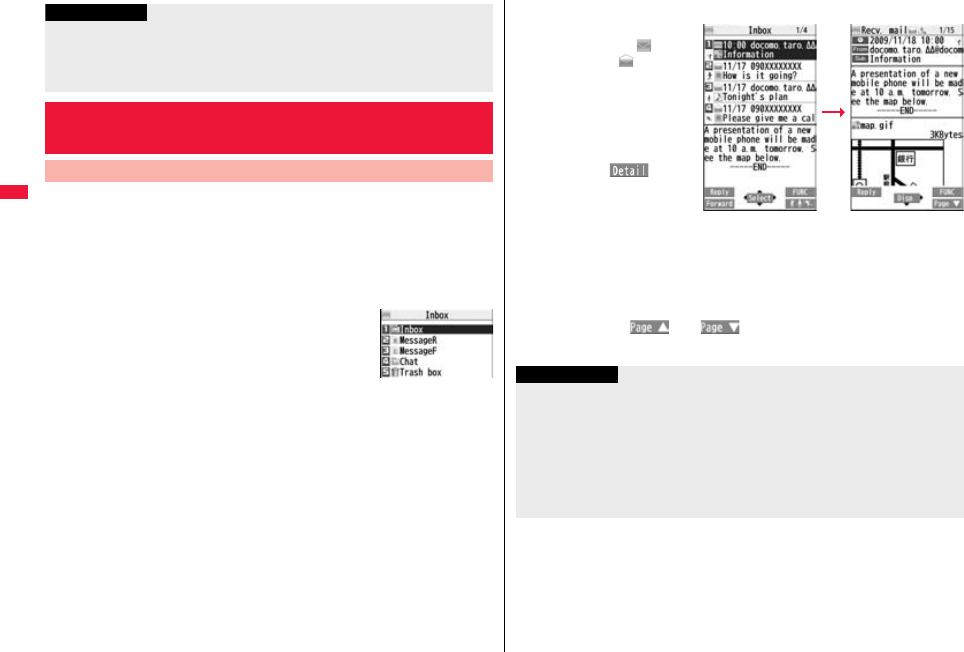
160
Mail
You can save up to 2,500 received i-mode mail messages including SMS
messages.
You can save up to 30 Area Mail messages separately from i-mode mail
messages and SMS messages.
You can check the received i-mode mail messages, SMS messages, and
Area Mail messages.
≥Welcome mail messages have been saved by default.
1l1Inbox1Select a folder.
≥See page 178 for displaying Messages R/F.
Information
≥You cannot save a melody in excess of 100 Kbytes to the FOMA terminal.
≥You cannot save a Flash movie in excess of 100 Kbytes to the FOMA terminal.
≥You cannot save a ToruCa file in excess of 1 Kbyte and ToruCa file (details) in excess
of 100 Kbytes to the FOMA terminal.
<Inbox> <Outbox> <Draft>
Displaying Mail in Inbox/Outbox/Draft
Display Mail from Inbox
Inbox Folder list
2Select a mail message.
≥When you select an unread
mail message, “ (pink)”
changes to “ ”.
≥For a Decome-Anime
message, the
Decome-Anime Playback
display appears. Some
Decome-Anime messages
are played back repeatedly.
Press i( ) to
show the detailed Received
Mail display. See page 153
for how the Decome-Anime
messages are played back.
≥Use No to check other
mail messages. When you press No to show the Decome-Anime message
from the detailed Received Mail display, the Decome-Anime Playback display
does not appear.
≥When the mail text is long, use Bo to scroll the display to check it. Further, you
can press m()/c() or >/< to scroll page by page. You
cannot scroll the Decome-Anime messages.
Inbox list Detailed Received
Mail display
Information
≥You are not charged a communication fee for welcome mail messages.
≥You cannot reply to welcome mail messages.
≥The attached melody, effect tone of the Flash movie in mail text, and effect tone of
Decome-Anime text sound following the setting of “Auto melody play”. However,
when a mail message with an attached melody includes the effect tone of the Flash
movie in mail text or effect tone of Decome-Anime text, the melody is preferentially
played back. The effect tone does not sound.
≥The melody and effect tone do not sound during Play Background.
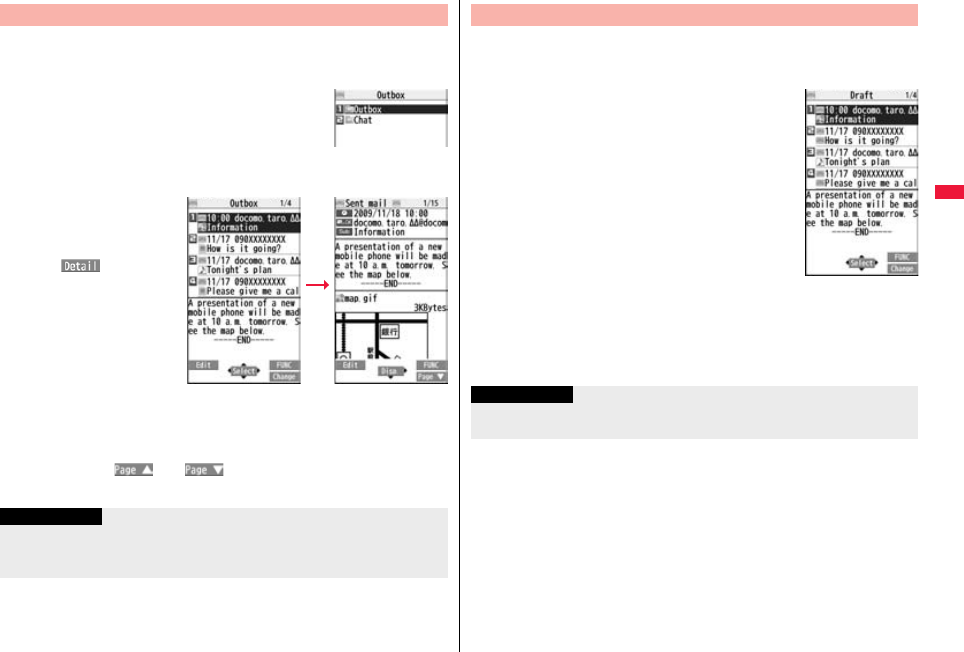
161
Mail
You can save up to 1,000 sent i-mode mail messages including SMS
messages.
You can check the sent i-mode mail messages and SMS messages.
1l1Outbox1Select a folder.
2Select a mail message.
≥For a Decome-Anime
message, the
Decome-Anime Playback
display appears. Press
i( ) to show the
detailed Sent Mail display.
See page 153 for how the
Decome-Anime messages
are played back.
≥Use No to check other
mail messages. When you
press No to show the
Decome-Anime message
from the detailed Sent
Mail display, the
Decome-Anime Playback display does not appear.
≥When the mail text is long, use Bo to scroll the display to check it. Further, you
can press m()/c() or >/< to scroll page by page. You
cannot scroll the Decome-Anime messages.
Display Mail from Outbox
Outbox Folder list
Outbox list Detailed Sent Mail
display
Information
≥The effect tone of the Decome-Anime text sounds following the setting of “Auto
melody play”.
≥The effect tone does not sound during Play Background.
You can edit and send i-mode mail messages and SMS messages in the
Draft. You can save up to 20 i-mode mail messages including SMS
messages.
1l1Draft
2Select a mail message.
When you have selected i-mode mail, go to step 2 on page 142. When you have
selected an Decome-Anime message, go to step 2 on page 149. When you have
selected an SMS message, go to step 2 on page 186.
Display Mail from Draft
Draft list
Information
≥When you select the i-αppli mail folder, the mail-linked i-αppli that supports the folder
starts.
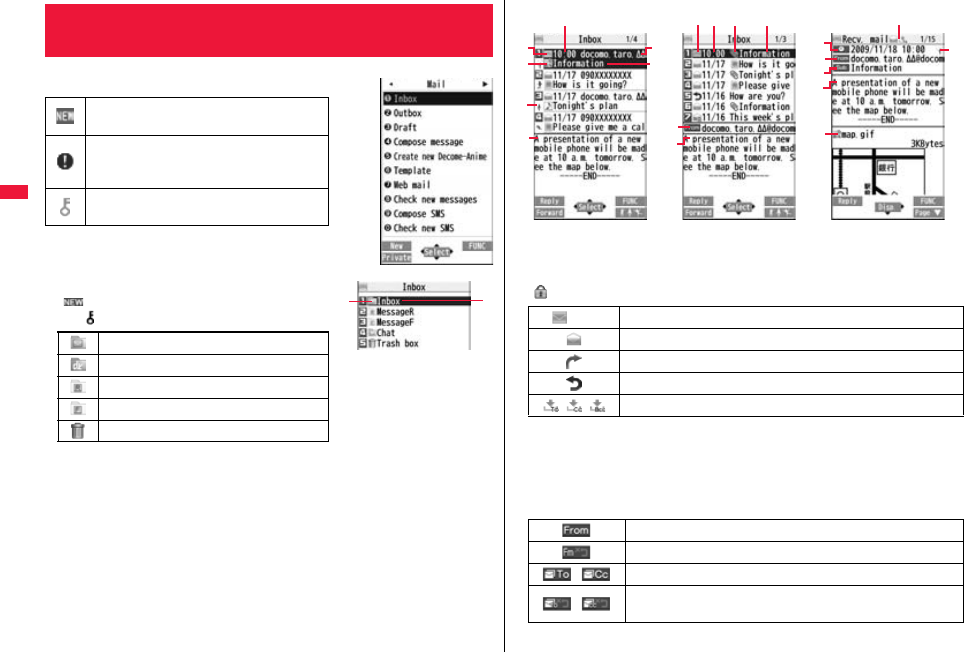
162
Mail
■Mail menu
Icons might have the following marks:
■Inbox Folder list
1Folder status
“ ” appears when unread messages are found,
and “ ” appears when Mail Security is activated.
2Folder name
How to See Inbox/Outbox/Draft List and
Detailed Display
Unread mail messages or messages are
stored in the Inbox.
Failed-to-send mail messages are stored in the
Outbox.
Draft mail messages are stored in the Draft.
“Mail security” is activated.
(displayed also for chat mail)
Ordinary folder
i-αppli mail folder
Message R folder
Message F folder
Trash box folder
12
■Inbox list and detailed Received Mail display
1Mail status and type
“ ” appears when protection is set.
2Received date and time
The Inbox list shows the time for the mail received today, and shows the date for the
mail received until yesterday. The detailed display shows the date and time the mail
was received. The Japanese date and time the mail was received from the Center is
displayed.
3
Phone number or mail address of the sender or of another recipient of simultaneous mail
(pink) Unread mail
Read mail
Forwarded mail
Replied mail
Type of the received mail (Detailed display only)
Sender’s mail address (Detailed display only)
Sender’s mail address that cannot be replied to (Detailed display only)
Recipient’s mail addresses of simultaneous mail (Detailed display only)
Recipient’s mail addresses of simultaneous mail that cannot be
replied to (Detailed display only)
7
6
4
3
2
5
1
Inbox list
For “Date+sender/
receiver subject”
21 5 4
3
7
Inbox list
For “Date+subject”
1
5
6
3
4
2
7
Detailed Received
Mail display
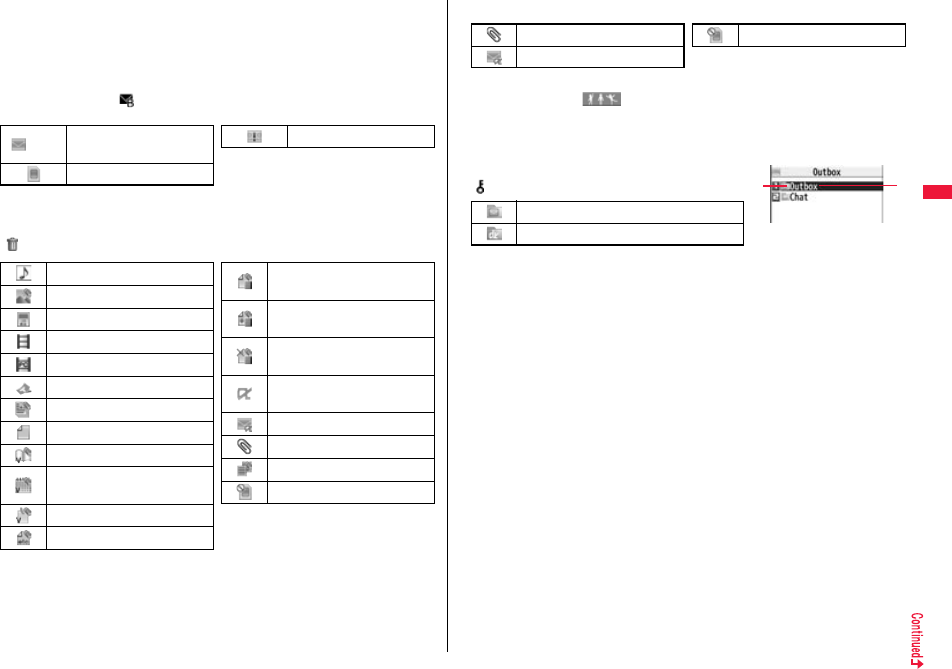
163
Mail
4Subject
The number of characters you can display on the list varies depending on the setting
of “Mail list display”, and “Mail” of “Font size”. When a file is attached, it is decreases
by 1 full-pitch/2 half-pitch character/s as the icon is added at the top.
For SMS messages or Area Mail messages, the beginning of the text is displayed.
(“SMS” or “Area Mail” is displayed on the detailed display.)
In Dual Mode of 2in1, “ ” is displayed at the end of the subject or sender’s address
of i-mode mail messages/SMS received to Address B/Number B.
5Attached or pasted data
The detailed display shows the data volume as well.
<For Inbox list (Date+sender/receiver subject) and detailed Received Mail display>
“ ” is added to each icon when you execute “Delete att. file” (Detailed display only).
(blue) SMS messages in the
FOMA terminal
SMS messages on the UIM
Area Mail
Melody file
Image file
Inserted image file (List only)
i-motion movie file
PC movie file
ToruCa file
PDF file
Document file
Phonebook entry file
Schedule event or ToDo item
file
Bookmark file
Other files
Attached file before obtaining
(Detailed display only)
Attached file suspended to be
obtained (Detailed display only)
Attached file failed to be
obtained (Detailed display only)
i-αppli start information
(List only)
i-αppli mail (List only)
Multiple files (List only)
Multiple pasted files
File with the UIM security
<For Inbox list (Date+subject) (Date+sender/receiver)>
6Feel*Mail icon
When you press c( ) from Inbox list, the Feel*Mail image is played back.
See page 177 for Feel*Mail.
7Text of mail
■Outbox Folder list
1Folder status
“ ” appears when Mail Security is activated.
2Folder name
Ordinary folder
i-αppli mail folder
Attached file
i-αppli mail
File with the UIM security
12
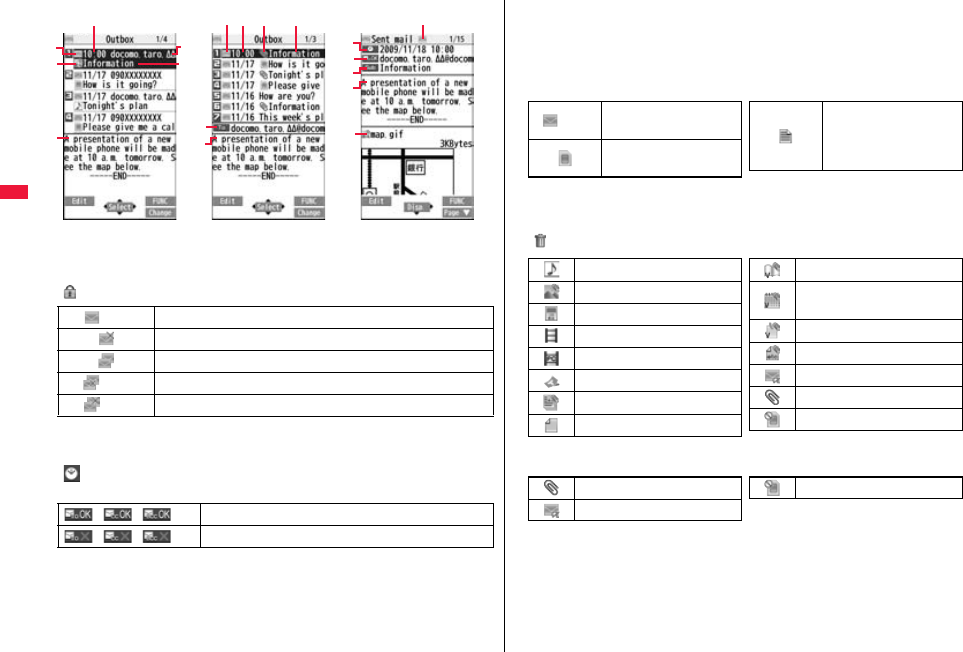
164
Mail
■Outbox list and detailed Sent Mail display
1Mail status
“ ” appears when protection is set.
2Sent date and time
The Outbox list shows the time for the mail sent today, and shows the date for the mail
sent until yesterday. The detailed display shows the date and time the mail was sent.
“ ” appears when the date/time is corrected.
3Recipient’s phone number or mail address
(pink) Mail successfully sent
Mail failed to be sent
Simultaneous mail successfully sent to all addresses
(gray) Simultaneous mail sent to some addresses
(pink) Simultaneous mail failed to be sent to all addresses
Mail address successfully sent (Detailed display only)
Mail address failed to be sent (Detailed display only)
6
4
3
2
5
1
Outbox list
For “Date+sender/
receiver subject”
21 5 4
3
6
Outbox list
For “Date+subject”
1
5
3
4
2
6
Detailed Sent Mail
display
4Subject
The number of characters you can display on the list varies depending on the setting
of “Mail list display”, and “Mail” of “Font size”. When a file is attached, it is decreases
by 1 full-pitch/2 half-pitch character/s as the icon is added at the top.
For SMS messages, the beginning of the text is displayed. (“SMS” is displayed on the
detailed display.)
5Attached data
The detailed display shows the data volume as well.
<For Outbox list (Date+sender/receiver subject) and detailed Sent Mail display>
“ ” is added to each icon when you execute “Delete att. file” (Detailed display only).
<For Outbox list (Date+subject) (Date+sender/receiver)>
6Text of mail
(blue) SMS messages in the
FOMA terminal
SMS messages on the
UIM
SMS report received [List
(Date+sender/receiver
subject) and detailed
display only]
Melody file
Image file
Inserted image file (List only)
i-motion movie file
PC movie file
ToruCa file
PDF file
Document file
Phonebook entry file
Schedule event or ToDo item
file
Bookmark file
Other files
i-αppli mail (List only)
Multiple files (List only)
File with the UIM security
Attached file
i-αppli mail
File with the UIM security
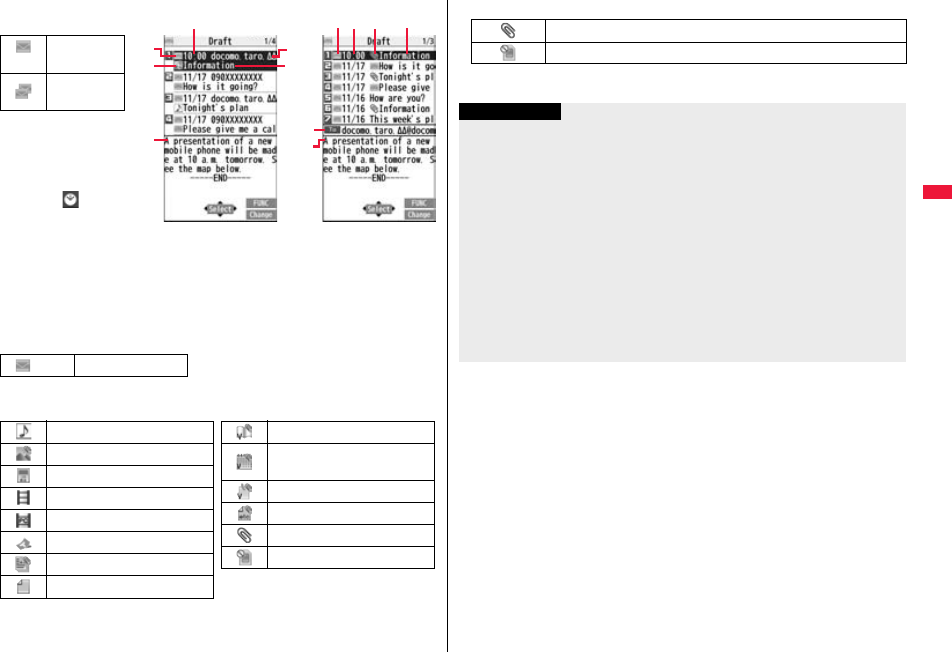
165
Mail
■Draft list
1Mail status
2Saved date and time
The Draft list shows the
time for the mail saved
today, and shows the date
for the mail saved until
yesterday. “ ” appears
when the date/time is
corrected.
3Recipient’s phone
number or mail address
4Subject
The number of characters you can display on the list varies depending on the setting
of “Mail list display”, and “Mail” of “Font size”. When a file is attached, it is decreases
by 1 full-pitch/2 half-pitch character/s as the icon is added at the top.
For SMS messages, the beginning of the text is displayed.
5Attached data
<For Date+sender/receiver subject>
(pink)
Ordinary mail
Simultaneous
mail
(blue) SMS messages
6
4
3
2
5
1
For “Date+sender/
receiver subject”
21 5 4
3
6
For “Date+subject”
Melody file
Image file
Inserted image file
i-motion movie file
PC movie file
ToruCa file
PDF file
Document file
Phonebook entry file
Schedule event or ToDo item
file
Bookmark file
Other files
Multiple files (List only)
File with the UIM security
<For (Date+subject) (Date+sender/receiver)>
6Text of mail
Attached file
File with the UIM security
Information
≥See “Mail list display” on page 175 to change a method to display the Inbox/Outbox/
Draft list.
≥When “Name in phonebook” of “Mail list display” is checked, the name stored in the
Phonebook is displayed as sender or recipient. However, when the sender’s mail
address is “phone number@docomo.ne.jp”, the name is not displayed even when
“phone number@docomo.ne.jp” is stored in the mail address field in a Phonebook
entry. Store the phone number part only to display the name. When a sender’s/
recipient’s phone number or mail address matches a Phonebook entry stored as
secret data, the name is not displayed. It is displayed in Secret Mode or Secret Data
Only.
Even when a sender’s/recipient’s phone number or mail address matches a
Phonebook entry not stored as secret data, the name is not displayed in Secret Data
Only. Switch to Secret Mode or release Secret Data Only to display the name.
≥When “Message” of “Mail list display” is not checked, the text does not appear on the
Inbox/Outbox/Draft list.
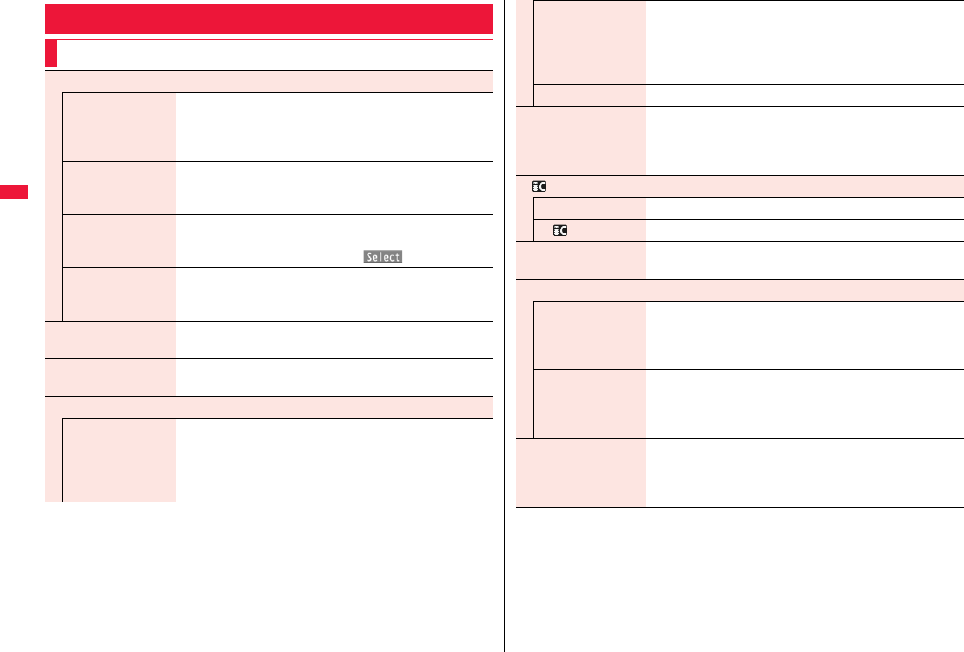
166
Mail
Managing Mail Messages
Function Menu of the Inbox Folder List/Outbox Folder List
Operate folder
Add folder You can add a new folder. You can add up to 22 folders to
each of “Inbox” and “Outbox”.
1Enter a folder name.
≥You can enter up to 10 full-pitch/20 half-pitch characters.
Edit folder name You can edit the names of the added folders only.
1Edit the folder name.
≥You can enter up to 10 full-pitch/20 half-pitch characters.
Sort folder You can sort folders. You can sort the added folders,
Message R/F folder, and the i-αppli mail folders.
1Use Bo to sort the order1Oo()
Delete folder All the mail messages including secret mail in the folder will be
deleted as well.
1Enter your Terminal Security Code1YES
Open folder You can display the mail messages in the i-αppli mail folder
without running mail-linked i-αppli.
Read all
[Inbox Folder only]
You can change unread mail in the folder to already-read mail.
1YES
Sort
Re-sort in this You can resort mail messages following the sorting conditions
specified by “Auto-sort”.
1YES
≥When the folder is applied with Mail security (see page 166),
you need to enter your Terminal Security Code.
Re-sort in all You can resort mail messages in all Inbox/Outbox folders
following the sorting conditions specified by “Auto-sort”.
1YES
≥When the folder applied with Mail security (see page 166) is
found, you need to enter your Terminal Security Code.
Auto-sort See page 172.
Mail security You can set the folder to open only when you enter your
Terminal Security Code.
1Enter your Terminal Security Code1YES
≥To release it, perform the same operation.
Ir/ transmission
Send all Ir data See page 385.
All transmission See page 387.
No. of messages You can display the number of stored received mail
messages, Messages R/F, and sent mail messages.
Delete
DEL all read mails
[Inbox Folder only]
You can delete all the read mail messages including secret
mail in all Inbox folders. All the read SMS messages on the
UIM are deleted as well.
1Enter your Terminal Security Code1YES
DEL all recv. mails
[Inbox Folder only]
You can delete all the mail messages including secret mail in
all Inbox folders. All the received SMS messages on the UIM
are deleted as well.
1Enter your Terminal Security Code1YES
DEL all sent mails
[Outbox Folder only]
You can delete all the mail messages including secret mail in
all Outbox folders. All sent SMS messages on the UIM are
deleted as well.
1Enter your Terminal Security Code1YES
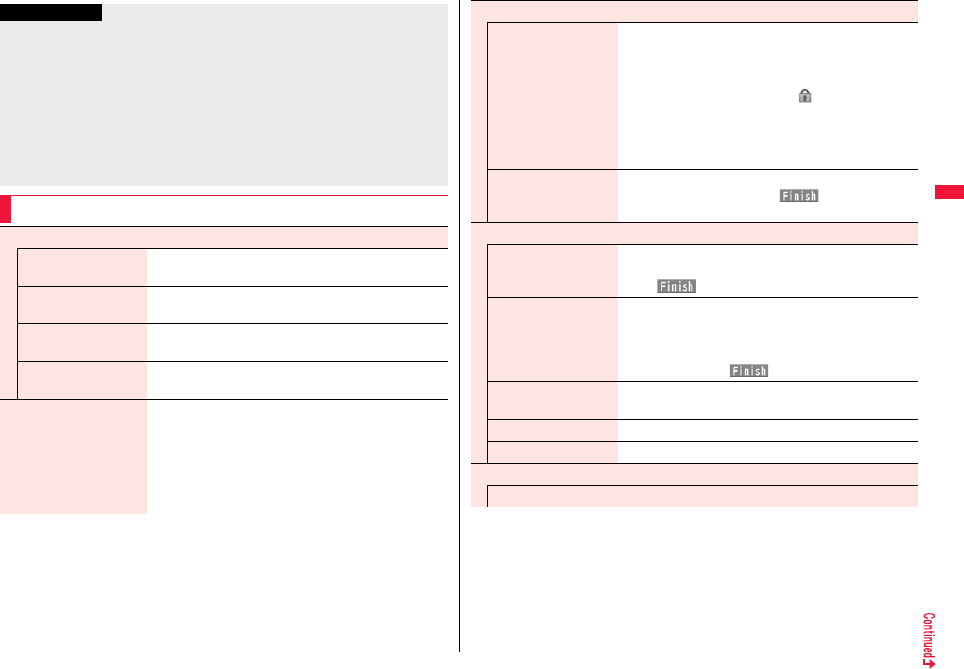
167
Mail
Information
<Delete folder>
≥You cannot delete an i-αppli mail folder if corresponding mail-linked i-αppli exists.
If the software program does not exist, you can delete the i-αppli mail folder, but this
will delete both folders created in the Outbox Folder list and Inbox Folder list.
<Re-sort in this> <Re-sort in all>
≥You cannot re-sort the mail messages in the “Chat” folder and “Trash box” folder.
≥Mail messages which are not applied to the sorting conditions are sorted into the
“Inbox” or “Outbox” folder.
<Mail security>
≥You can neither delete the Mail-Security-activated folder nor edit its name.
Function Menu of the Inbox List/Outbox List/Draft List
Reply/forward
Rep.w/ i-mode mail
[Inbox only]
See page 157.
Rep. w/ Deco-Anime
[Inbox only]
See page 157.
Reply with quote
[Inbox only]
See page 157.
Forward
[Inbox only]
See page 158.
Edit
[Outbox only]
You can re-edit the sent mail message and send it again.
When you have selected an i-mode mail message, go to
step 2 on page 142.
When you have selected a Decome-Anime message, go
to step 2 on page 149.
When you have selected an SMS message, go to step 2
on page 186.
Protect
Protect ON/OFF
[Inbox/Outbox]
You can protect the mail message so that it is not
overwritten and deleted. You can protect all the received
and sent messages. (2,500 received messages, 1,000
sent messages)
The protected one is indicated by “ ”.
≥To release protection, perform the same operation.
≥You can switch between protected and unprotected also
by pressing 1 from the detailed Received Mail display
or detailed Sent Mail display.
ProtectSLCT. ON/OFF
[Inbox/Outbox]
1Put/Remove a check mark for mail messages to be
protected/unprotected1l()
≥A check mark is placed to the mail already protected.
Move/copy
Move
[Inbox/Outbox]
1Select a destination folder
1Put a check mark for mail messages to be moved
1l()1YES
Move to trash
[Inbox only]
You can move mail messages to the “Trash box” folder.
The mail messages moved to the “Trash box” folder are
preferentially overwritten (deleted).
1Put a check mark for mail messages to be moved to
the trash box1l()1YES
UIM operation
[Inbox/Outbox]
You can copy or move the mail message to the UIM or
FOMA terminal. (See page 419)
Copy to microSD See page 370.
Store in Center See page 136.
Search/sort
Search mail
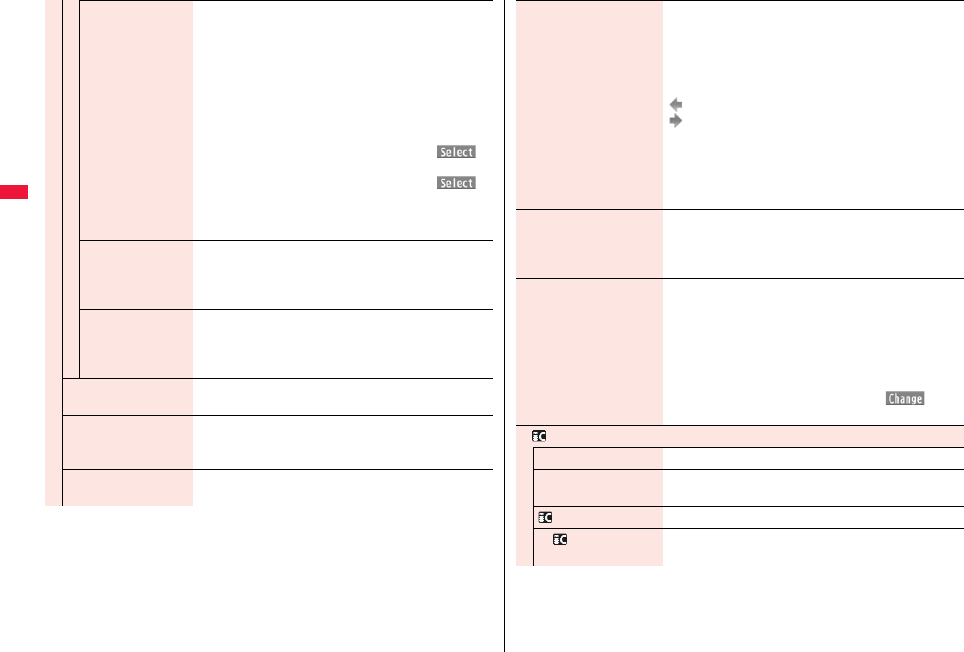
168
Mail
Search sender/
Search receiver
[Inbox/Outbox]
You can retrieve mail messages with a mail address or
phone number of a sender or recipient.
“Search sender” for received mail and “Search receiver” for
sent mail are displayed respectively.
1Select an item.
Phonebook . . . . . . . . .Call up a Phonebook entry and
select a phone number or mail
address.
Received address . . .Select a phone number or mail
address and press Oo().
Sent address . . . . . . .Select a phone number or mail
address and press Oo().
Enter address. . . . . . . Enter the mail address or phone
number.
≥You can enter up to 50 half-pitch characters.
Search subject
[Inbox/Outbox]
You can retrieve mail messages with a subject.
1Enter a subject.
≥You can enter up to 100 full-pitch/200 half-pitch
characters.
Search
subject+msg
[Inbox/Outbox]
You can retrieve mail messages with a subject or text.
1Enter a part of a subject or text.
≥You can enter up to 100 full-pitch/200 half-pitch
characters.
Sort
[Inbox/Outbox]
You can change the order of displayed mail messages.
1Select an order.
Filter
[Inbox/Outbox]
You can display the mail messages only that satisfy the
condition.
1Select a type.
Display all
[Inbox/Outbox]
You can re-display all mail messages in “By date↑” order
after using Search Mail, or the Sort or Filter function.
Mail history
[Inbox/Outbox]
You can display the history of sent/received mail from the
sender or to the recipient being selected or displayed. Up
to 1,000 histories are displayed in the chronological order
from the most recent one.
1Select a sender’s or destination address.
The target sent/received mail histories are displayed.
. . . . .Sent mail
. . . . .Received mail
≥Select a history to show the detailed Received Mail
display or detailed Sent Mail display. Press r to return
to the former display.
≥You can display also by pressing 7 on the detailed
Received Mail display or detailed Sent Mail display.
Color label
[Inbox/Outbox]
You can color the characters on the Inbox list and Outbox
list for classifying mail. Select “Default” to set ordinary font
color.
1Select a color.
List setting You can select the item to be displayed on the list. You can
also switch between the name stored in the Phonebook
and the mail address/phone number for the display in the
sender’s/destination address field.
You can set to list the mail messages by subject
depending on the setting of “Mail list display”.
1Select an item to be displayed.
≥You can switch each time you press c() from
the Outbox list and Draft list.
Ir/ transmission
Send Ir data See page 384.
Send all Ir data
[Draft only]
See page 385.
transmission See page 387.
All transmission
[Draft only]
See page 387.
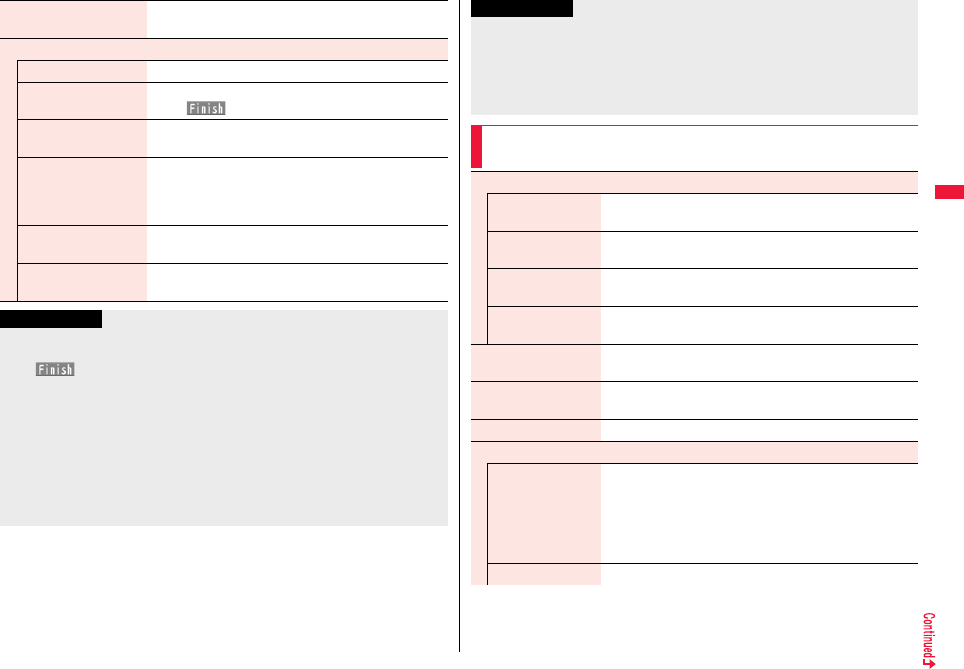
169
Mail
No. of messages You can display the number of stored received mail
messages, sent mail messages and draft mail messages.
Delete
Delete this 1YES
Delete selected 1Put a check mark for mail messages to be deleted
1l()1YES
Delete read mails
[Inbox only]
You can delete all the read mail messages in the folder.
1YES
Delete all SMS-R
[Inbox only]
You can delete all the SMS reports. While SMS reports are
displayed by the Search Mail function or Filter function,
only the displayed SMS reports are deleted.
1Enter your Terminal Security Code1YES
DEL all frm folder
[Inbox/Outbox]
You can delete all mail messages in the folder.
1Enter your Terminal Security Code1YES
Delete all
[Draft only]
You can delete all the draft mail messages.
1Enter your Terminal Security Code1YES
Information
<Edit>
≥To use “Mail group” for destination addresses, delete all the entered addresses, press
+l( ) to complete the deletion, and then re-select the address field.
<Protect>
≥You cannot protect mail messages in the “Trash box” folder.
≥If you protect all the sent messages which are stored to the maximum, you can no
longer compose i-mode mail messages.
<Move to trash>
≥If you move unread mail to the Trash box, it changes to read mail.
<Search subject> <Search subject+msg>
≥Even if you set “No title”, you cannot search for the i-mode mail whose subject is not
entered and displayed as “No title”.
<Color label>
≥Color Label applied to the mail messages is released when they are copied to the
microSD card, copied/moved to the UIM, copied/moved from the UIM or sent via
infrared rays or iC transmission.
≥Color Label applied to the SMS messages on the UIM is released when the UIM is
dismounted and then mounted.
Function Menu of the Detailed Received Mail Display/
Detailed Sent Mail Display
Information
Reply/forward
Rep.w/ i-mode mail
[Received Mail only]
See page 157.
Rep. w/ Deco-Anime
[Received Mail only]
See page 157.
Reply with quote
[Received Mail only]
See page 157.
Forward
[Received Mail only]
See page 158.
Edit
[Sent Mail only]
See page 167.
Resend
[Sent Mail only]
You can re-send the sent mail message.
1YES
Protect ON/OFF See page 167.
Move/copy
Copy 1Select an item to be copied.
≥See page 436 for how to copy.
≥When the addresses of the sender and another recipient of
simultaneous mail are found or the multiple destination
addresses are found, select a mail address or phone
number to be copied.
Move 1Select a destination folder.
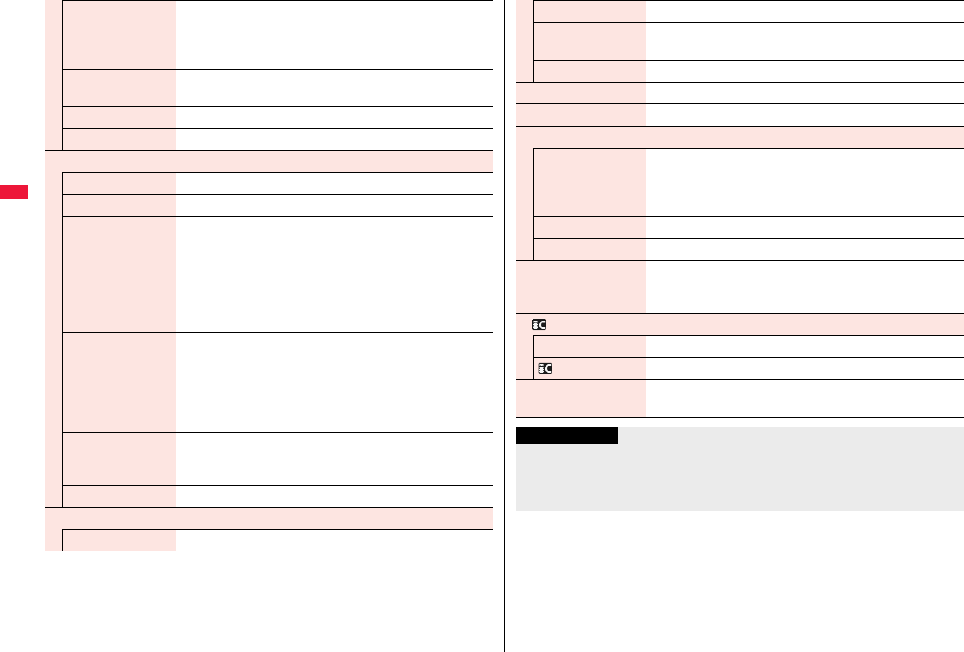
170
Mail
Move to trash
[Received Mail only]
You can move the mail to the “Trash box” folder. The mail
messages moved to the “Trash box” folder are preferentially
overwritten (deleted).
1YES
UIM operation You can copy or move the mail to the UIM or FOMA terminal.
(See page 419)
Copy to microSD See page 370.
Store in Center See page 136.
Operate file
Save attached file See page 159.
Save insert image See page 152.
Save D-pictograms
[Received Mail only]
You can save Deco-mail pictograms in the mail text at once.
You can save up to 20 of them.
1YES
≥See page 201 when the Deco-mail pictograms are stored to
the maximum.
≥See page 344 for how to check the stored Deco-mail
pictograms.
Save as template You can save the sent/received Deco-mail message as a
template.
1YES
≥See page 201 when the templates are stored to the
maximum.
≥See page 151 for how to check the stored template.
Property You can display the file name and file size of the image
inserted into the text.
1Select an image.
Delete att. file 1YES
Store
Store address See page 92.
Add to phonebook See page 92.
Auto-sort You can store a sender or subject as a sort condition.
(See page 172)
Add desktop icon See page 31.
Mail history See page 168.
Color label See page 168.
Display
Name/address You can display the sender’s/destination address by the name
stored in the Phonebook or by the mail address/phone
number.
≥You can switch also by pressing 5.
Scroll See page 175.
Font size See “Mail” on page 119.
Display SMS report
[Sent Mail only]
You can check the result of the SMS message you sent, or
the date and time it arrived at the destination. To receive the
SMS report, set “SMS report request” to “ON”.
Ir/ transmission
Send Ir data See page 384.
transmission See page 387.
Delete 1YES
≥You can delete the mail message also by pressing 0.
Information
<Resend>
≥If you re-send a failed-to-send mail message, it is saved as the sent mail message. If
you re-send the failed-to-send simultaneous message to all addresses, it is saved as
the sent mail message.
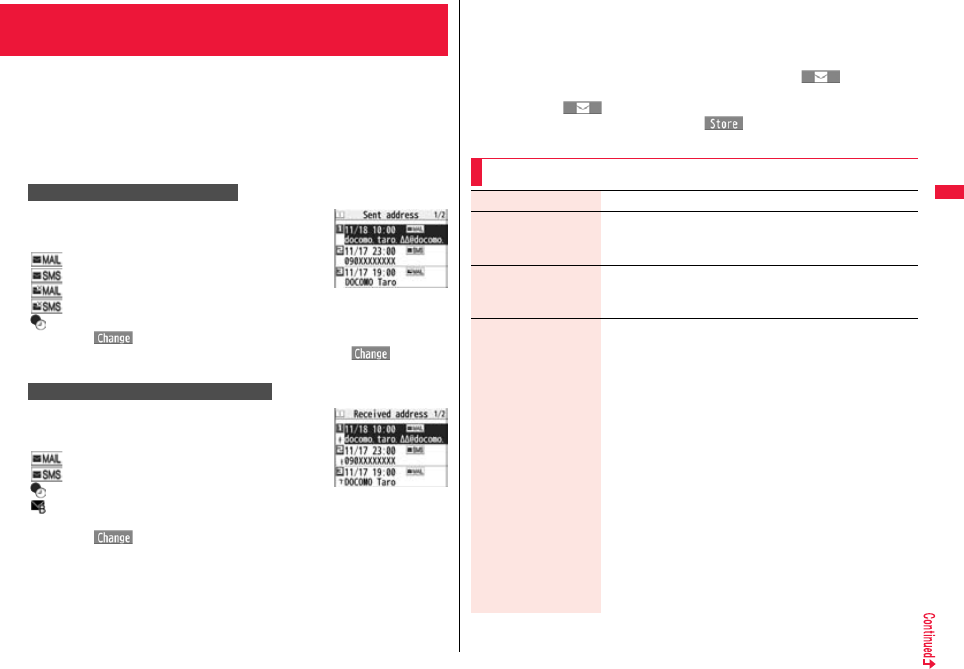
171
Mail
Sent and received i-mode mail messages and SMS messages are stored
in Sent Address and Received Address, up to 30 messages each. You
can check the list for the mail addresses and phone numbers. When you
exchange mail messages with the same mail address or phone number,
the older one is deleted.
≥In Dual Mode of 2in1, up to 60 records for Address A/Number A and Address B/
Number B are stored in Received Address in total.
1Press and hold Vo for at least one
second.
: i-mode mail successfully sent
: SMS message successfully sent
: i-mode mail failed to be sent
: SMS message failed to be sent
: Time-difference corrected time
≥Press m( ) from the Sent Address list to display Redial. When the Sent
Address list is displayed from Dialed Calls, you can press m( ) to display
Dialed Calls.
Press and hold Co for at least one
second.
: i-mode mail
: SMS message
: Time-difference corrected time
: i-mode mail message/SMS received to Address B/
Number B (only in Dual Mode of 2in1)
≥Press m( ) from the Received Address list to display Received Calls.
<Sent Address> <Received Address>
Displaying Sent/Received Mail Record
When Using Sent Address
When Using Received Address
Sent Address list
Received Address
list
2Select a record to be displayed.
The detailed display of the Address list is displayed.
≥With an SMS message for which the other party’s phone number is not notified,
the reason for no caller ID is displayed.
≥To send i-mode mail to the displayed address, press Oo( ) and go to
step 3 on page 142. To send an SMS message to the displayed phone number,
press Oo( ) and go to step 3 on page 186.
≥To store in the Phonebook, press m( ). Go to step 2 of “Storing
Displayed Phone Number/Mail Address in Phonebook” on page 93.
Function Menu while Sent/Received Address is Displayed
Add to phonebook See page 92.
Compose message You can compose an i-mode mail message. The mail address
is entered in the address field.
Go to step 3 on page 142.
Compose SMS You can compose an SMS message. The phone number is
entered into the address field.
Go to step 3 on page 186.
Dialing When the mail address is stored in a Phonebook entry, you
can make a voice call, videophone call or PushTalk call to the
phone number stored in the Phonebook.
1Select a dialing type.
≥When you select “Select image”, select an image to be sent
to the other party during a videophone call. To cancel the
setting, select “Release”.
≥When multiple phone numbers are stored in a Phonebook
entry, you can dial the first phone number.
1Dial
≥The set item is indicated by “★”.
≥To make an international call, select “Int’l dial assist”, select
an international call access code, and follow the procedure
above after selecting “Dialing” from the Function menu. (See
page 59)
≥To set Caller ID Notification, select “Notify caller ID”. (See
step 2 of “Set Caller ID Notification when Making a Call” on
page 56)
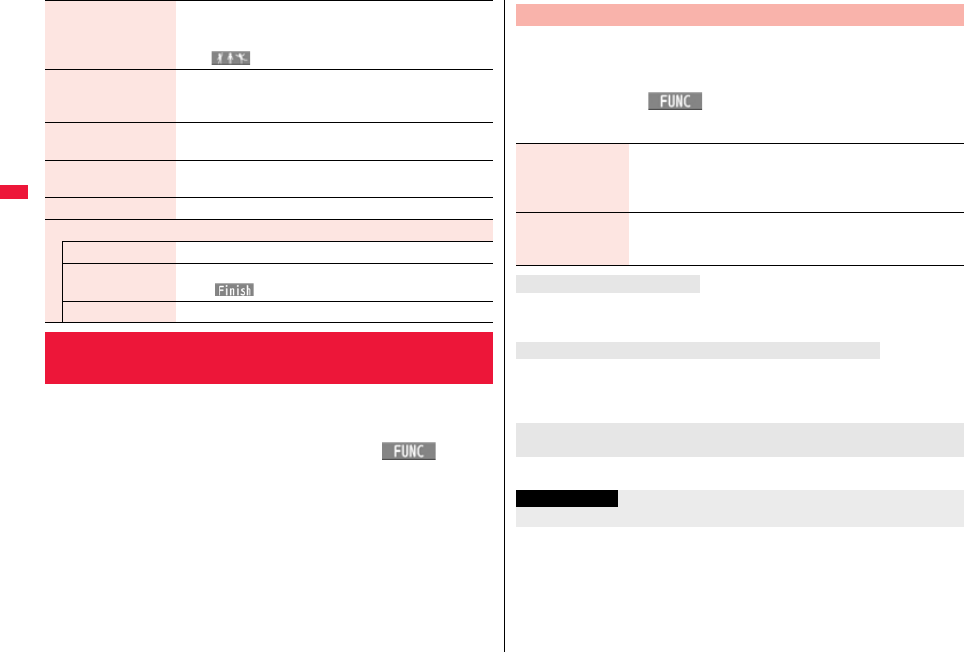
172
Mail
You can automatically save the mail messages that satisfy the set
conditions to the specified folder. This function applies to only the added
folders and i-αppli mail folders.
1Inbox Folder list/Outbox Folder list1i()1Sort
1Auto-sort
Follow the operation of the Function menu list on page 173 to set “Auto-sort”.
If you select a folder for which Auto-sort conditions have been set, the Auto-sort
Setting display appears.
Feel*Mail
[Received Address only]
The Feel*Mail image is played back. See page 177 for Feel
*Mail.
≥You can play back the Feel*mail image also by pressing
c().
Font size You can switch the font sizes for Redial, Dialed Calls,
Received Calls, Sent Address, and Received Address. (See
“Dialed/recv. calls” on page 120)
Redial/Dialed calls
[Sent Address only]
You can display the Redial list or the Dialed Call list.
Received calls
[Received Address only]
You can display the Received Call list. All received calls (all
calls) are displayed.
Add desktop icon See page 31.
Delete
Delete this 1YES
Delete selected 1Put a check mark for records to be deleted
1l()1YES
Delete all 1Enter your Terminal Security Code1YES
<Auto-sort>
Sorting Mail Automatically to Each Folder
You can specify a sort condition and folder from the detailed Sent/
Received Mail display.
1Detailed Sent Mail display/Detailed Received Mail
display1i()1Store1Auto-sort
1Do the following operations.
The confirmation display appears asking whether to change the condition or to overwrite
it. Select “YES” to release the set condition and set the new one.
The confirmation display appears asking whether to change the condition. Select “YES”
to release the condition set for another folder and to set it for the selected folder.
≥You cannot change the setting for a Mail-Security-activated folder.
The confirmation display appears asking whether to add the address.
Auto-sort Storing
Address sort You can set the displayed sender’s/recipient’s address for a
sorting condition.
1Select a folder.
≥When multiple addresses are found, select an address.
Subject sort You can edit the displayed subject and set it for a sorting
condition.
1Edit the subject1Select a folder.
To change the condition
When the same condition is set for another folder
When storing another address for the folder set for “Address
sort”
Information
≥You can store a total of 700 addresses in all folders.
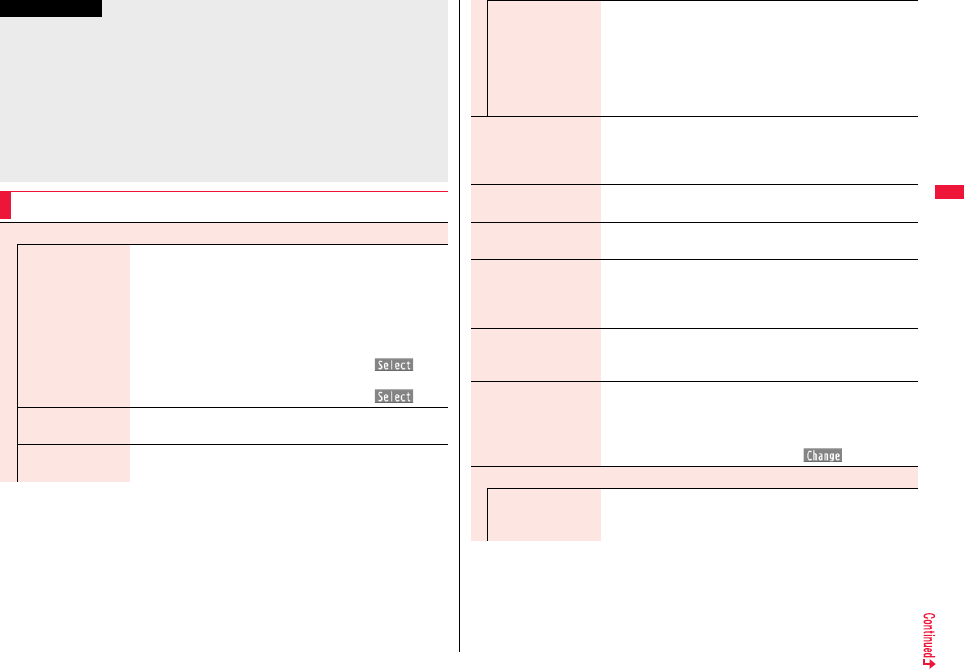
173
Mail
≥When multiple conditions match, sorting is done in the priority below.
1 Sort all
2 Subject sort
3 Reply impossible/Send impossible
4 Address sort (Look-up address/Enter address)
5 Address sort (Look-up mail group)
6 Address sort (Look-up group)
≥Mail messages sent simultaneously to multiple members cannot be sorted by
“Address sort” or “Send impossible”.
≥Area Mail messages are not sorted by “Address sort”.
Function Menu of the Auto-sort Setting Display
Information
Address sort
Look-up address You can look up a mail address or phone number in the
Phonebook or Received/Sent Address and set it to the folder
for sorting.
1Select an item.
Phonebook . . . . . . . . .Call up a Phonebook entry and select
a phone number or mail address.
Received address . . .Select a phone number or mail
address and press Oo().
Sent address . . . . . . .Select a phone number or mail
address and press Oo().
Look-up group You can set a group to be sorted into the folder.
1Select a group.
Look-up mail group You can set a mail group to be sorted into the folder.
1Select a mail group.
Enter address You can directly enter a mail address or phone number to be
sorted into the folder.
1Enter a mail address or phone number.
≥You can enter up to 50 half-pitch characters.
≥When the mail address is “phone number@docomo.ne.jp”,
enter the phone number only. You can sort SMS messages
as well if you enter the phone number only.
Subject sort You can enter the subject of i-mode mail messages to be
sorted into the folder. One subject can be set per folder.
1Enter a subject.
≥You can enter up to 100 full-pitch/200 half-pitch characters.
Reply impossible You can set reply-disabled mail messages to be sorted. You
can set for only one folder.
Send impossible You can set failed-to-send mail messages to be sorted. You
can set for only one folder.
Sort all You can sort all mail messages into the i-αppli mail folder. You
can set for only one i-αppli mail folder each in the Inbox and
Outbox. When “Sort all” is set, other sort settings are disabled.
1YES
Edit addr/subj You can edit and store the mail address, phone number, and
subject set for the folder.
1Edit the mail address, phone number or subject.
List setting You can switch whether to display the destinations by the
name stored in the Phonebook or by the mail address or
phone number.
1Name or Address
≥You can switch also by pressing c().
Release
Release this You can release the sort condition. (The item is deleted from
the Auto-sort Setting display.)
1YES
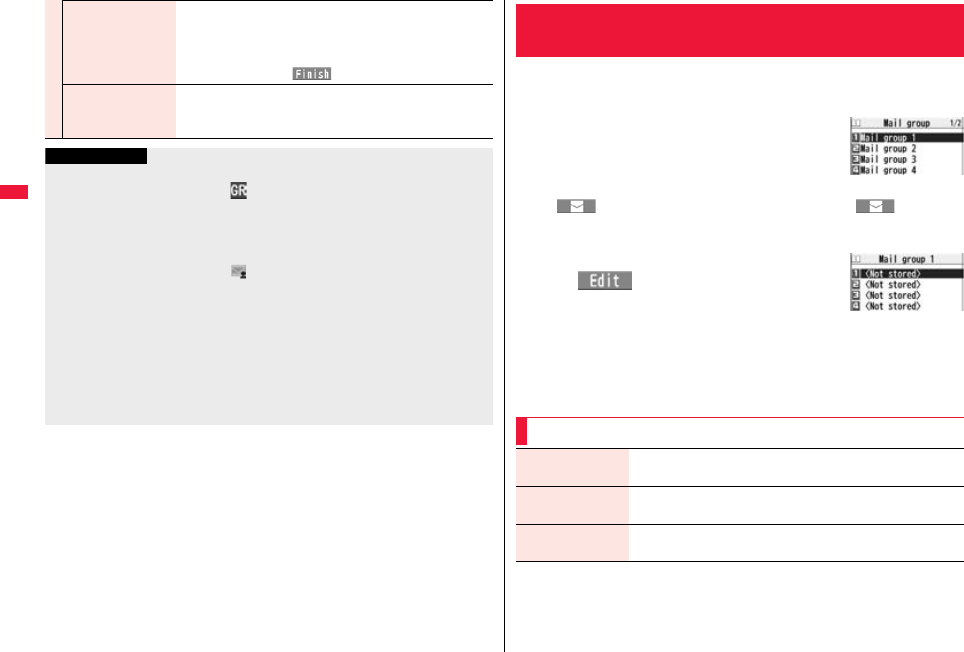
174
Mail
Release selected You can select mail addresses or phone numbers, and
release the sort condition for them. (The items are deleted
from the Auto-sort Setting display.)
1Put a check mark for mail addresses or phone numbers
to be released1l()1YES
Release all You can release all sort conditions. (The items are deleted
from the Auto-sort Setting display.)
1YES
Information
<Look-up group>
≥On the Auto-sort Setting display, “ ” is added to the top of the name.
≥You cannot set groups on the UIM.
≥The secret mail messages received in ordinary mode (not in “Secret mode” or “Secret
data only”) are not sorted into the folder.
<Look-up mail group>
≥On the Auto-sort Setting display, “ ” is added to the top of the mail group name.
<Subject sort>
≥When the subject matches sort conditions for multiple folders, it is sorted to the folder
nearest to the “Inbox” folder or “Outbox” folder.
≥Even if you set “No title”, the i-mode mail titled with “No title” because of no entry
cannot be sorted.
≥SMS messages cannot be sorted by subject.
<Sort all>
≥You cannot sort SMS reports or SMS messages that have been directly received on
the UIM.
You can store mail addresses by group. You can send mail to regular
destinations.
You can store up to five addresses per group, and up to 20 groups.
1m1Phonebook
1Phonebook settings1Mail group
1Select a Mail group to be stored.
≥When mail addresses are stored in a Mail group,
“ ” appears at the lower left of the display. Press l( ) to compose
i-mode mail to a selected Mail group set as the destination address.
Go to step 3 on page 142.
2Highlight <Not stored> and press
l().
≥If you select a stored mail address, the Mail Group
Address Confirmation display appears.
3Enter a mail address.
≥You can enter up to 50 half-pitch characters.
≥When you store multiple mail addresses, repeat step 2 and step 3.
+m-2-6
<Mail Group>
Creating Mail Group
Mail Group list
Detailed Mail Group
display
Function Menu of the Mail Group List
Compose message You can compose an i-mode mail message to the Mail group.
Go to step 3 on page 142.
Edit group name 1Enter a name of the Mail group.
≥You can enter up to 10 full-pitch/20 half-pitch characters.
Reset group name You can reset the name of Mail group to the default.
1YES
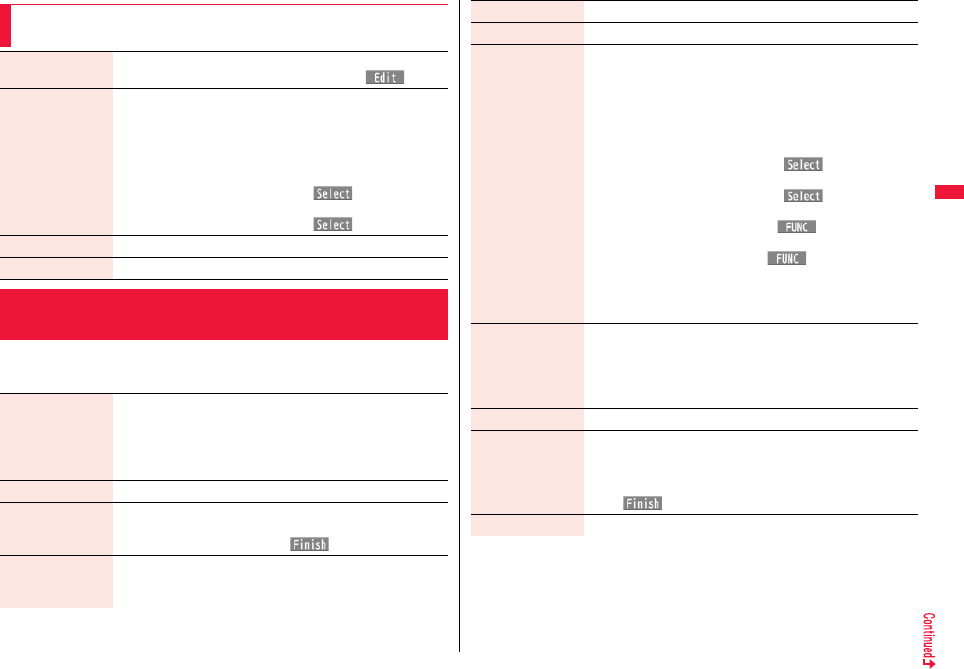
175
Mail
1l1Mail settings1Do the following operations.
Function Menu of the Detailed Mail Group Display/Mail
Group Address Confirmation Display
Edit address Go to step 3 on page 174.
≥You can edit the address also by pressing l().
Look-up address You can call up a phone number or mail address in the
Phonebook, Sent Address, or Received Address to enter it.
1Select an item.
Phonebook. . . . . . . . . Call up a Phonebook entry and select a
phone number or mail address.
Sent address . . . . . . . Select a phone number or mail address
and press Oo().
Received address . . . Select a phone number or mail address
and press Oo().
Delete this 1YES
Delete all 1Enter your Terminal Security Code1YES
<Mail Settings>
Setting Mail and Messages R/F
Scroll You can set the number of lines that are scrolled at a time for
when you press Bo from the detailed mail display, detailed
Message R/F display, Message Composition display and preview
display.
1Select the number of lines.
Font size See “Mail” on page 119.
Mail list display You can set items to be displayed on the Inbox/Outbox/Draft list
by using radio buttons or check boxes.
1Select a display format1l()
Message display You can set whether to display received mail in standard display
(from the top) or from the text.
1Standard or From message
Mail security See page 133.
Secret mail display See page 133.
Auto color label You can specify the text color of the sender, received date/time
and others on the Inbox list by mail address. You can store up to
10 items.
1<Not stored>1Select an item.
Phonebook . . . . . . . . .Call up a Phonebook entry and select a
phone number or mail address.
Sent address . . . . . . . Select a phone number or mail address
and press Oo().
Received address . . . Select a phone number or mail address
and press Oo().
Enter address. . . . . . . Enter a mail address or phone number.
≥To change the set color, press i( ) and select “Select
color”.
≥To delete the set item, press i( ) and select “Delete”
→ “Delete this” or “Delete all” and select “YES”. If you select
“Delete all”, you need to enter your Terminal Security Code.
1Select a color.
Pred. conv. at reply You can set whether to preferentially display the words contained
in the subject and text of the received mail message as
conversion candidates when you reply to, reply with quote to, or
forward it.
1ON or OFF
Header/signature See page 176.
Set check new
messages
You can select items to be checked from among i-mode mail,
Message R and Message F, for when you perform “Check new
messages”.
1Put a check mark for the items to be checked
1l()
Auto-display See page 178.
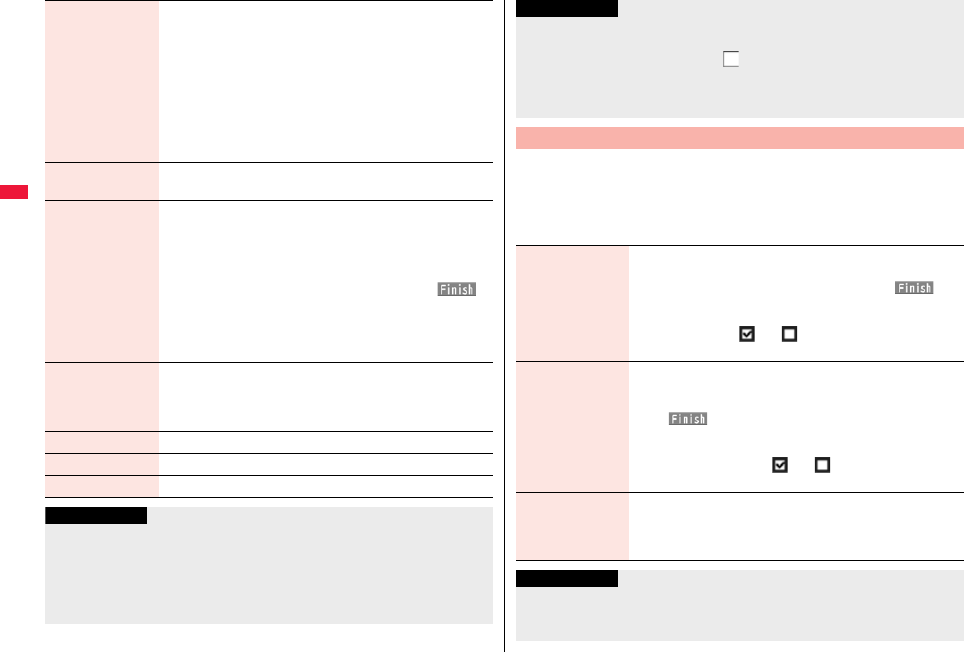
176
Mail
Receiving display You can set whether to display the Message Receiving and
Reception Result displays, even during operation of another
function.
1Alarm preferred or Operation preferred
Alarm preferred
. . .Prioritizes the Message Receiving and Reception Result
displays when you have new mail.
Operation preferred
. . . Prioritizes the display of the current operation when you have
new mail.
Receive option
setting
See page 156.
Attachment
preference
You can set whether to receive the attached file with an i-mode
mail message. The attached files for which you remove a check
mark are held at the i-mode Center. (Even when you put a check
mark, if attached files exceed 100 Kbytes, all or part of attached
files are held at the i-mode Center.)
1Put a check mark for items to be received1l()
≥Put a check mark for “Tool data” to receive Phonebook entries,
schedule events, ToDo items, and bookmarks.
≥Put a check mark for “Other” to receive PC movies, document
files, and files unsupported by the FOMA terminal.
Auto melody play You can set whether to play back the attached or pasted
melodies automatically for when you display the text of received
mail, or message R/F.
1ON or OFF
Feel*Mail See page 177.
Chat setting See page 184.
Check settings You can check each of “Mail settings”.
Information
<Message display>
≥Even if “From message” is set, the message might not be displayed from the text
depending on the number of characters in the text.
<Auto color label>
≥Even when you set this function, the text color of the mail message already received
does not change.
You can store a header, signature and quotation mark. Also, you can set
whether to automatically paste the header or signature.
1l1Mail settings1Header/signature
1Do the following operations.
<Set check new messages>
≥ If you do not want to receive Messages R and Messages F by “Check new
messages”, change these settings to “ ”.
<Auto melody play>
≥You cannot play back attached or pasted melodies during Play Background
regardless of the setting of “Auto melody play”.
Header/Signature
Information
Header The header is the sentence such as greeting at the beginning of
the text.
1Select the header field1Enter a header1l()
≥
You can enter up to 5,000 full-pitch/10,000 half-pitch characters.
≥If you do not want the header to be pasted automatically, select
“Insert” to change “ ” to “ ”. See page 144 for adding a
header by mail message.
Signature The signature is your name and other information, placed at the
end of the text.
1Select the signature field1Enter a signature
1l()
≥
You can enter up to 5,000 full-pitch/10,000 half-pitch characters.
≥If you do not want the signature to be pasted automatically,
select “Insert” to change “ ” to “ ”. See page 144 for
adding a signature by mail message.
Quotation marks The quotation mark is the symbol indicating a quotation from
received mail for when you reply to mail.
1Enter a quotation mark.
≥You can enter up to 10 full-pitch/20 half-pitch characters.
Information
≥You can set decorations in a header and signature.
≥Even if you have put a check mark for “Insert”, the header and signature cannot be
pasted when you compose i-mode mail from a template or i-αppli.
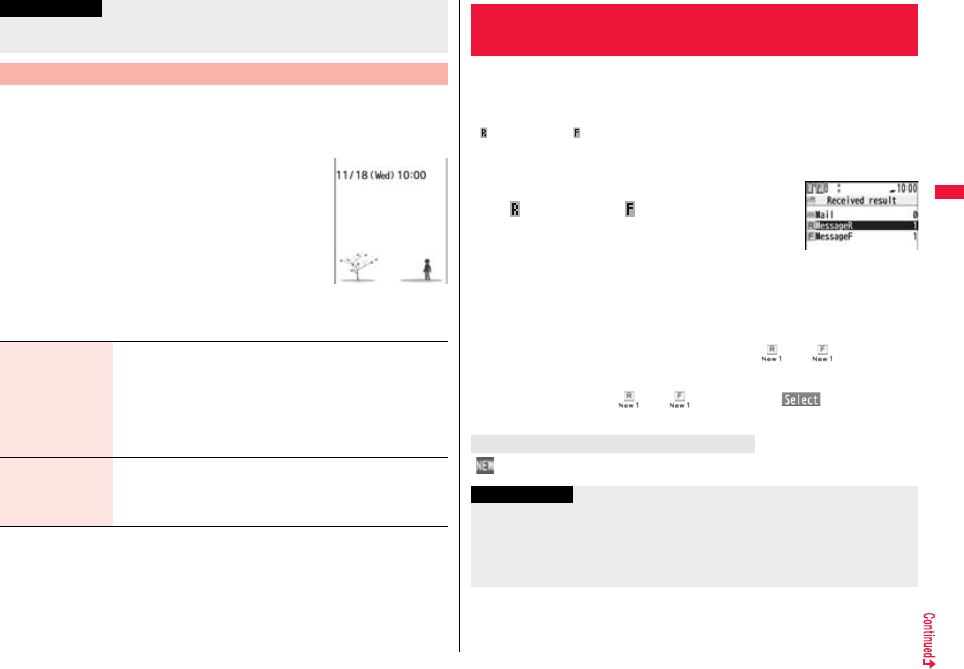
177
Mail
Feel*Mail reproduces the atmosphere of a mail message by actions of
45 types of animated characters. Once you activate Feel*Mail, a
Feel*Mail image is played back after you receive an i-mode mail/SMS
message.
≥To end the playback, press h or r.
1l1Mail settings1Feel*Mail
1Do the following operations.
≥You cannot paste the header, signature, and quotation marks to Decome-Anime
messages and SMS messages.
Feel*Mail
Information
Disp. /play new one A Feel*Mail image is played back after you receive an i-mode
mail/SMS message.
1ON or OFF
≥When this function is set to “OFF”, a Feel*Mail icon does not
appear on the Received Address list/Detailed Received
Address display, the Inbox list, and the detailed Received Mail
display even while “Disp. /play in history” is set to “ON”.
Disp. /play in
history
A Feel*Mail icon appears on the Received Address list/Detailed
Received Address display, the Inbox list, or the detailed Received
Mail display.
1ON or OFF
Message services automatically deliver information you want to your
FOMA terminal.
When your FOMA terminal is in the service area, it receives Messages R/
F automatically from the i-mode Center.
“ (yellow)” or “ (yellow)” appears at the top of the display when a
Message R/F is delivered.
You can save up to 100 each of received Messages R/F.
1When you receive a Message R/F, the
“ (yellow)” or “ (yellow)” blinks and
the message for receiving the Message
R/F appears.
After the message is received, the number of received mail messages and
Messages R/F is displayed.
≥You can display the Message R/F list by selecting “MessageR” or “MessageF”.
≥If “Auto-display” is set to other than “OFF”, the contents of received Message R/F
are automatically displayed. They are displayed for about 15 seconds.
≥If no keys are pressed for the specified duration, “ ” or “ ” (see page 29)
appears on the desktop and the former display returns. (The transit time varies
depending on the setting for “Mail/Msg. ring time”.)
Press Oo, highlight “ ” or “ ”, and press Oo( ) to display the
Message R/F list.
“ ” is added to “Message R/F” of i-mode menu.
<Receive Message R/F>
Receiving Messages R/F Automatically
When unread Messages R/F are found
Information
≥Received Messages R/F are not automatically displayed while a display other than
the Stand-by display is shown, while an i-αppli program is running, during Public
Mode (Drive Mode), during Lock All, or during Personal Data Lock.
≥When the Messages R/F exceed the maximum number of storage, they are deleted
from the oldest one. Unread or protected Messages R/F are not deleted.
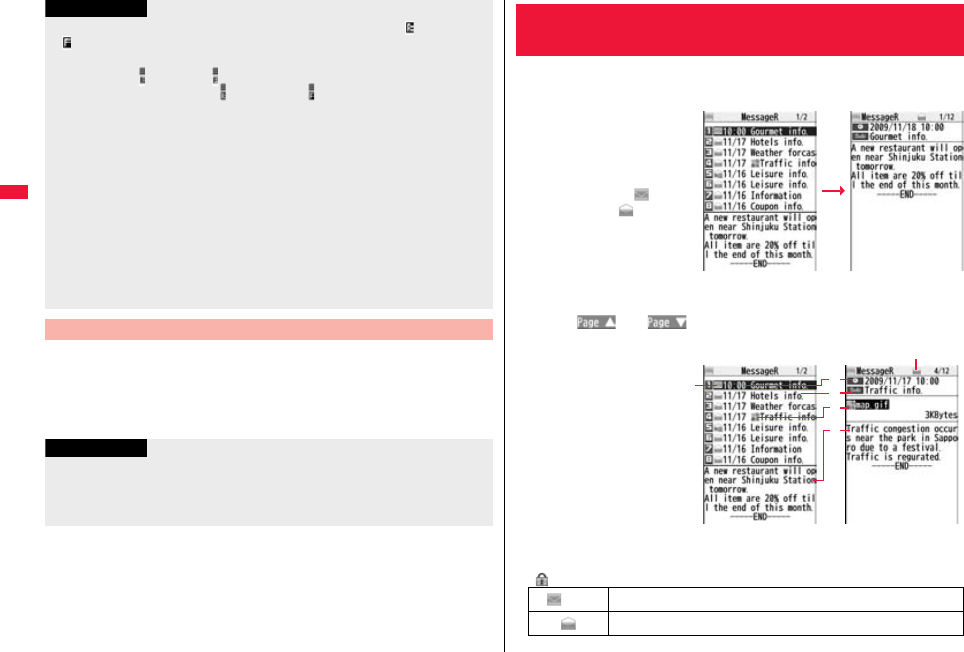
178
Mail
You can set how to automatically display Messages R/F received during
standby or a voice call.
1l1Mail settings1Auto-display
1Select an option for automatic display.
≥When the FOMA terminal cannot receive any more Messages R/F, “ (dark blue)” or
“ (dark blue)” is displayed. Delete unnecessary Messages R/F, read unread
Messages R/F or release protection.
≥When the icon “ (yellow)” or “ (yellow)” is displayed, the i-mode Center holds
Messages R/F. When the icon “ (dark blue)” or “ (dark blue)” is displayed, the
i-mode Center can hold no more Messages R/F. Perform “Check new messages” to
receive them.
≥Even after Messages R/F are displayed automatically, they are still displayed as
unread ones in the Message R/F list. However, if you scroll through the messages
during automatic display, they will be indicated as read ones.
≥Messages R/F received in the following cases are held at the i-mode Center:
・When the power is off ・During a videophone call
・During Self Mode ・When you are out of the service area
・During infrared communication ・While connecting to the FirstPass Center
・During PushTalk communication ・During Omakase Lock
・During iC communication ・During copy to microSD
・While connecting to the Data Storage Center
・When the space for Messages R/F is full with protected or unread messages
Auto-display
Information
Information
≥When you receive Messages R/F during a voice call, the message is displayed
automatically after the call ends.
≥The Messages R/F are not displayed automatically when “Mail security” is set for
“Inbox”, or when “Mail security” is set for “MessageR” folder or “MessageF” folder.
1l1Inbox1MessageR or MessageF
1Select a Message R/F to be displayed.
≥You can display Messages
R/F also by i1Message
R/F1MessageR or
MessageF.
≥When you select an unread
Message R/F, “ (pink)”
changes to “ ”.
≥Use No to check other
Messages R/F.
≥When the text of Message
R/F is long, use Bo to
scroll the display to check
it. Also, you can press
m()/c() or </> to scroll page by page.
■Message R/F list and detailed Message R/F display
1Status of Message R/F
“ ” appears when protection is set.
<Display Message R/F>
Reading Received Messages R/F
Detailed Message R/F
display
Message R/F list
(pink) Unread Message R/F
Read Message R/F
2
3
1
4
5
1
Detailed Message
R/F display
Message R/F list
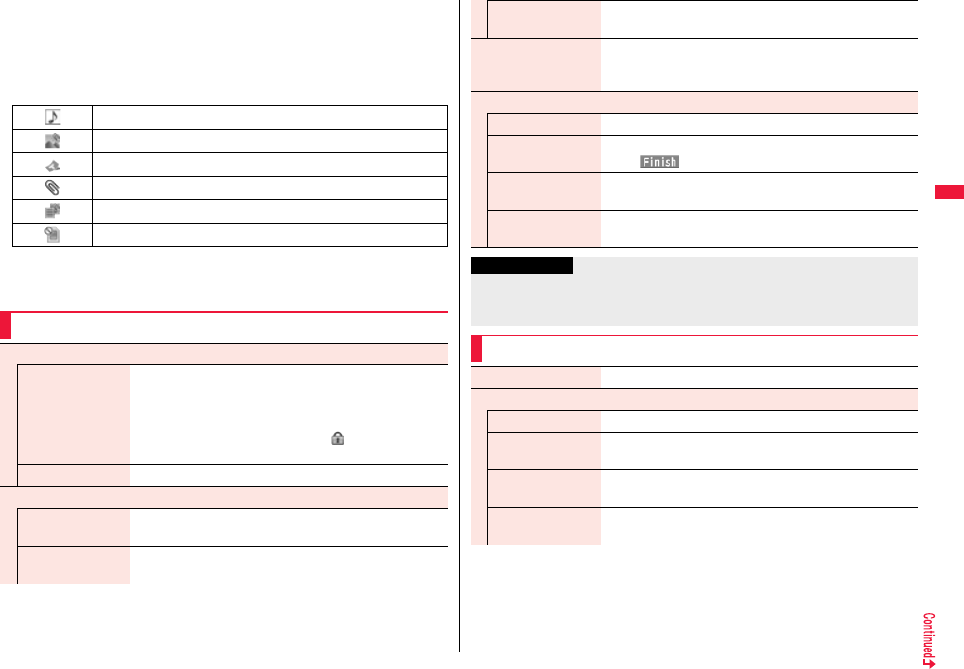
179
Mail
2Received date and time
The list shows the time for the Message R/F received today, and shows the date for
the Message R/F received until yesterday. The detailed display shows the date and
time the Message R/F was received.
3Subject
4The data attached or pasted
The detailed display shows the data volume.
5Text of message
The phone number stored in the Phonebook is displayed by the name stored in the
Phonebook.
Valid melody file
Valid image file
Valid ToruCa file
Multiple attached files
Multiple pasted files
File with the UIM security
Function Menu of the Message R/F List
Protect
Protect ON/OFF You can protect a Message R/F not to be overwritten or
deleted.
You can protect up to 50 messages (Message R and
Message F each).
Protected messages are indicated by “ ”.
≥To release protection, perform the same operation.
Unprotect all 1YES
Search/sort
Sort You can rearrange the displaying order.
1Select a displaying order.
Filter You can display only Messages R/F that satisfy the condition.
1Select a displaying type.
Display all After you execute “Sort” or “Filter”, you can reset it and list all
Messages R/F by “By date ↑”.
No. of messages You can display the total number of Messages R/F stored in
the FOMA terminal, as well as the number of unread
messages and protected messages.
Delete
Delete this 1YES
Delete selected 1Put a check mark for Messages R/F to be deleted
1l()1YES
Delete read mails You can delete all read Messages R/F.
1YES
DEL all frm folder You can delete all Messages R/F.
1Enter your Terminal Security Code1YES
Information
<Search/sort>
≥To return to the former status, execute “Display all”.
≥If you close the list and re-open it, you can return to the list of all items.
Function Menu of the Detailed Message R/F Display
Protect ON/OFF See page 179.
Operate file
Save attached file You can save attached or pasted files. (See page 159)
Save insert image You can save the attached image and set it as the Stand-by
display, Wake-up display, or another display. (See page 152)
Save BG image 1YES1Select a destination folder.
Go to step 3 on page 199.
Save D-pictograms You can save the all Deco-mail pictograms inserted into the
text. (See page 170)
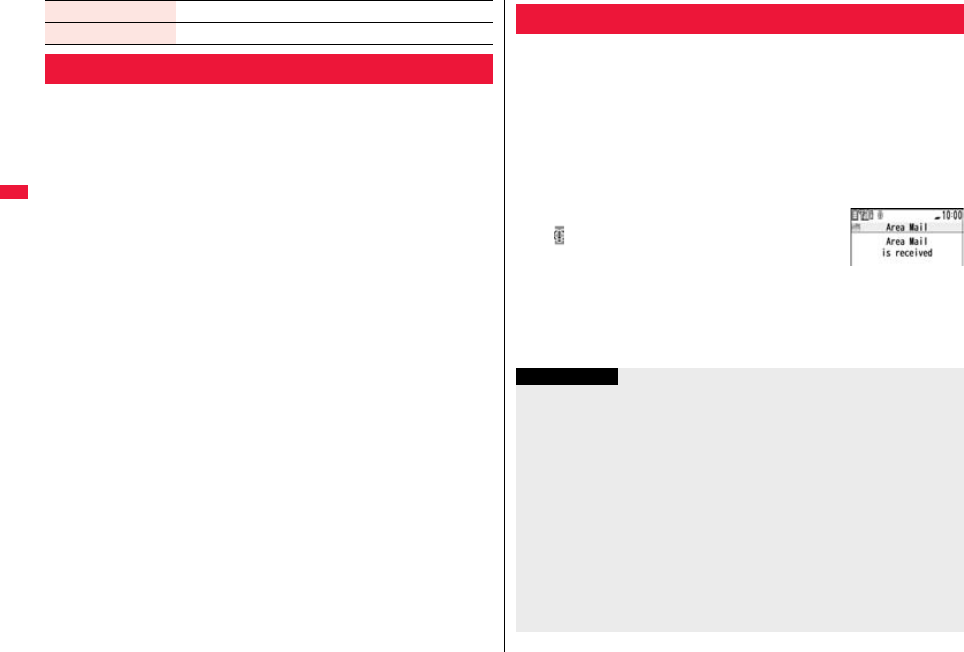
180
Mail
This service enables you to receive reports such as emergency
earthquake alerts distributed from the Japan Meteorological Agency.
≥You can receive Area Mail messages without i-mode contract.
≥You cannot receive Area Mail messages in the following cases※1:
・During Omakase Lock
・During Self Mode
・During international roaming
・During a voice call
・During a videophone call
・While copying data files between FOMA terminal and the microSD card
・During infrared communication
・During iC communication
・When you are out of the service area
・When the power is off
≥You might not be able to receive Area Mail messages in the following cases※1※2:
・During i-mode communication
・During data communication
・During PushTalk communication
・While accessing the Data Storage Center
・While updating software program
・While updating the pattern data
※1 You cannot receive the message once you failed to receive it.
※2 Even when you could receive it, the contents are not automatically displayed.
≥The contents are not automatically displayed when you receive them in the following
cases:
・While the camera is activated
・While an i-αppli program is running
・During Public Mode (Drive Mode)
・While operating the microSD card
・During streaming playback of PC movie or i-motion movie
Add to phonebook See page 92.
Delete 1YES
Early Warning “Area Mail”
When you receive an Area Mail message, the ring tone for Area Mail
sounds. “Ring volume”, “Ring time”, and “Vibrator” follows the settings
of “Mail”.
When you receive an emergency earthquake alert, a dedicated buzzer
(alert) sounds, and the vibrator works to notify you. Further, the contents
are automatically displayed. “Ring volume” is fixed to “Level 4”, and
“Vibrator” is fixed to “Melody linkage”, so you cannot change their
settings. You can use “Area mail settings” to set “Beep time”.
Up to 30 Area Mail messages are saved separately from i-mode mail
messages and SMS messages in the Inbox.
1When an Area Mail message arrives,
“ ” lights, the message telling its
arrival appears, and the Call/Charging
indicator flickers.
≥If you press any key, the former display returns.
≥The contents of some Area Mail messages might be automatically displayed
when you receive them. To clear it, press Oo, r, or h.
≥See page 160 for displaying Area Mail messages.
Receiving Early Warning “Area Mail”
Reception Result
display
Information
≥The buzzer does not sound when you receive an emergency earthquake alert with the
manner setting set by “Manner mode” or “Super silent”. However, the buzzer sounds
with “Original” set to sound any of the following tones. When every setting is set to
mute, the buzzer does not sound:
・Phone volume ・Mail volume ・Alarm volume
・Memo tone ・Keypad sound
≥Even when “Vibrator” of “Original” is set to “OFF”, the vibrator works if you receive an
emergency earthquake alert.
≥When a new Area Mail message comes in with 30 Area Mail messages saved, they
are deleted from the read oldest one. When all 30 messages are not read, they are
deleted from the oldest one.
≥Whether the details of a received Area Mail message are displayed or not depends on
the setting by the Area Mail message provider.
≥Depending on the radio wave conditions, you may not be able to receive Area Mail
messages.
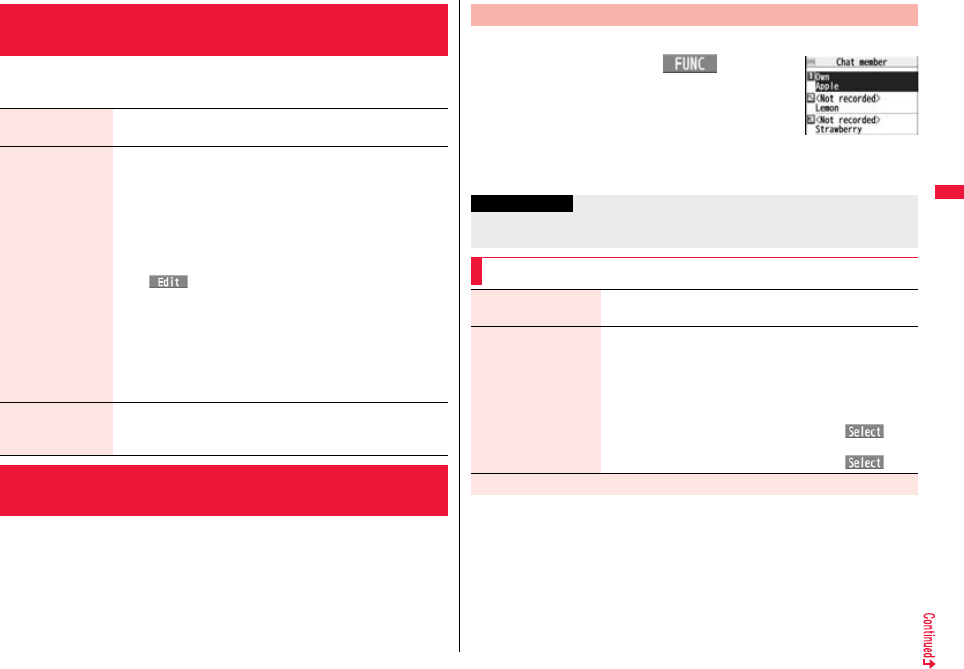
181
Mail
1l1Area mail settings1Do the following operations.
You can send or receive chat mail messages to and from multiple
persons on a single display. To use Chat Mail, you need to store chat
members. You can easily store them by creating chat groups.
<Area Mail Settings>
Setting Early Warning “Area Mail”
Receive setting You can set whether to use Area Mail.
1Read exemption clause thoroughly1Yes or No
Receive entry You can register Message IDs for the reports to be received other
than emergency information. You can register up to 20 IDs.
≥You do not need to operate “Receive entry” for receiving only
emergency earthquake alert and disaster/evacuation
information.
1<New>1Enter your Terminal Security Code
1Enter a registration name1Enter a Message ID.
≥To edit a registered Message ID, highlight it, press
l( ), and then enter your Terminal Security Code.
≥You can enter up to 15 full-pitch/30 half-pitch characters for an
arbitrary registration name. For a Message ID, enter 4 half-pitch
characters specified by the service provider.
≥You can edit it also by selecting “Edit” from the Function menu.
Select “Delete this” or “Delete all” and enter your Terminal
Security Code. Then you can delete one or all Message IDs.
≥You cannot edit/delete “Emergency information”.
Beep time You can set the duration the beep sounds.
1Enter a beep time (seconds).
≥Enter it in two digit, from “01” through “30”.
<Chat Mail>
Using Chat Mail
You can store up to six chat members including the user (yourself).
1l1Chat mail1i()
1Chat member1<Not recorded>
1Enter a mail address.
≥To edit a stored member, select the member.
≥When the mail address is “phone
number@docomo.ne.jp”, store the phone number only.
≥You can enter up to 50 half-pitch characters.
Store Chat Members
Chat Member list
Information
≥If you edit the mail address of the stored member, the member’s name and image are
changed.
Function Menu of the Chat Member List
Edit You can edit the mail address.
Go to step 1 of “Store Chat Members” on page 181.
Refer address You can look up a phone number or mail address in the
Phonebook, Received Address, or Sent Address to enter it.
1Select an item.
Phonebook . . . . . . . . Call up a Phonebook entry and select
a phone number or mail address.
Sent address. . . . . . . Select a phone number or mail
address and press Oo().
Received address . . Select a phone number or mail
address and press Oo().
Change member
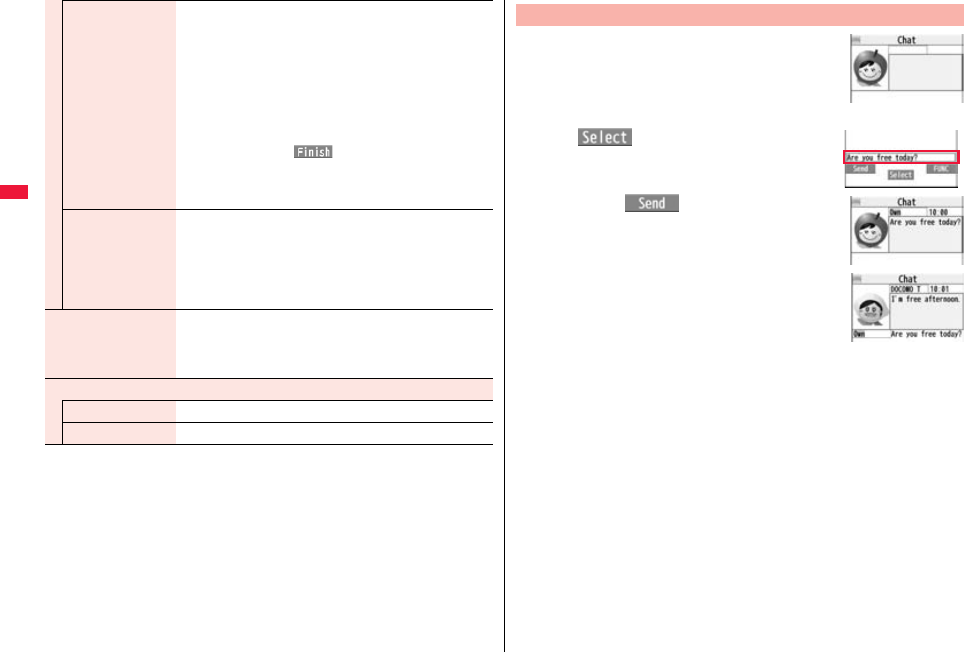
182
Mail
Chat group You can store the members stored in a chat group as chat
members.
1Group list or Member list
Group list . . . . . You can select members by chat group.
Member list . . . You can select members from all the
members stored in chat groups.
≥If you select “Group list”, select a chat group.
The members from the selected group are stored.
≥If you select “Member list”, check the members you want to
store and press l().
≥If you have already stored chat members, the confirmation
display appears asking whether to replace all the chat
members.
Mail group You can store the mail addresses stored in Mail group as chat
members.
1Select a Mail group.
≥If you have already stored chat members, the confirmation
display appears asking whether to replace all the chat
members.
Display setting You can check the chat member’s name, image, background
color, and mail address.
≥You can press No to switch members.
≥The mail address of the user (yourself) is not displayed.
Delete
Delete this 1YES
Delete all 1YES
1l1Chat mail
2Oo()1Enter characters.
≥You can enter up to 250 full-pitch/500 half-pitch
characters.
3Press l().
The chat mail message is sent.
The sent chat mail message is displayed at the top of the
Chat Mail display.
4The display for receiving chat mail
appears and a chat mail message is
received.
The received chat mail message is displayed at the top of
the Chat Mail display.
Repeat step 2 through step 4 to send and receive chat mail messages.
5r1YES or NO
YES . . . . You can delete read and sent chat mail message from the “Chat” folder.
NO . . . . . You do not delete read and sent chat mail message from the “Chat”
folder.
Chat Mail ends.
≥You can end Chat Mail also by pressing h.
≥When no sent and received chat mail messages are found, the confirmation
display does not appear.
Exchange Chat Mail Messages
Chat Mail display
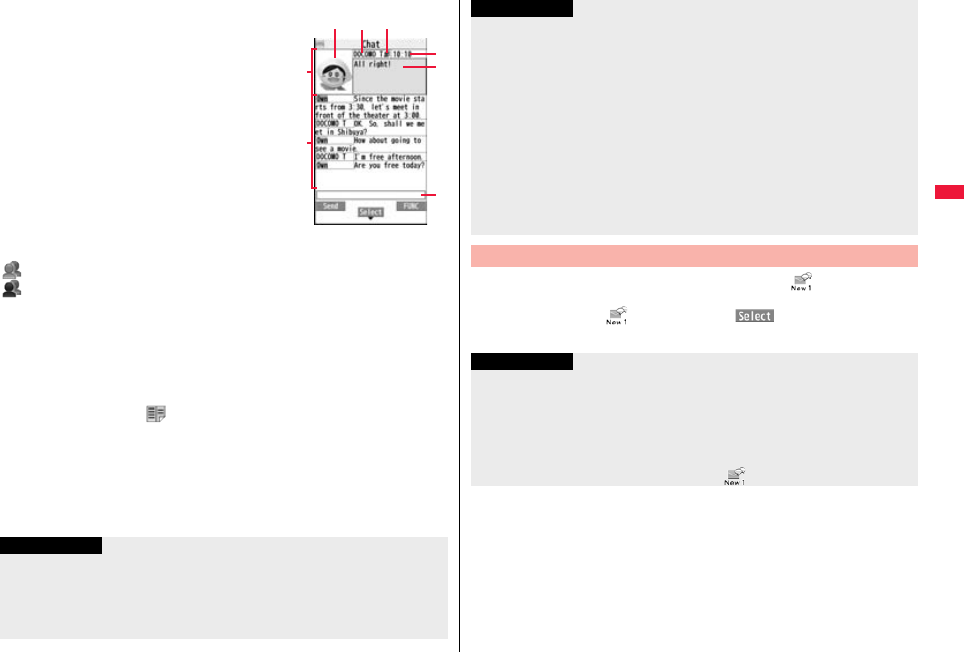
183
Mail
■Chat Mail display
1Image
The image you have stored in Chat Group is
displayed.
2Member name
The chat member’s name store in the chat
group is displayed. Also, the name is displayed
with a specified background color.
≥When the name is not stored in the chat
group, up to eight half-pitch characters from
the beginning of the mail address are
displayed. When the mail address is stored in
the Phonebook, up to four full-pitch/eight
half-pitch characters from the beginning of
the name are displayed.
3Broadcast mark
Displayed when the chat mail message set with multiple addresses is received.
(blue): All addresses are stored in Chat Member.
(dark blue): Addresses that are not stored in Chat Member are found.
4Sent/Received date and time
The date and time the chat mail message was sent/received are displayed. The time is
displayed for the chat mail messages sent/received today and the date for the chat mail
messages sent/received until yesterday.
5Text
The text of chat mail message is displayed. The number of characters of the text to be
displayed is up to 250 full-pitch/500 half-pitch characters.
If the text exceeds four lines, is displayed and you can switch the pages by pressing
No.
≥You cannot switch the page of the text on the Chat Mail history.
≥The text of the chat mail message successfully sent is displayed in black. The text of
the chat mail message failed to be sent is displayed in gray.
6Input box
Entered characters (characters to send) are displayed from the beginning by a factor of
one line.
Current
Chat mail
Chat Mail
history
123
6
4
5
Information
≥The communication fee for when you send chat mail messages to multiple chat
members is the same as for sending a chat mail message to one member. (However,
the information volume for the added address increases the communication fee.)
≥When “Receive option setting” is set to “ON”, you cannot exchange chat mail
messages.
If you receive a chat mail message during standby, “ ” appears on the
desktop.
Press Oo, highlight “ ”, and press Oo( ); then Chat Mail starts
up.
≥When the Inbox is full of unread or protected mail messages, you cannot exchange
chat mail messages. Delete unnecessary mail messages or read unread mail
messages, or release the protection and then operate.
≥Attached files or pasted data are not displayed.
≥Sent/Received chat mail messages are saved to the “Chat” folder.
≥The subject of a sent chat mail message is “チャットメール (chat mail)” (half-pitch
characters).
≥Even when the chat mail text on the Chat Mail display contains the phone number,
mail address, or URL, the Phone To/AV Phone To, Mail To, and Web To functions are
not available. However, those functions will be available when Chat Mail is finished
and chat mail message is brought up from the “Inbox” or “Outbox”.
≥During playing back a music file by MUSIC Player, a tone for the chat mail message
does not sound.
If You Receive Chat Mail during Standby
Information
Information
≥Messages are recognized as chat mail messages in the following cases:
・When the sender’s address or destination address is stored in Chat Member or in a
chat group
・When the subject contains “チャットメール (chat mail)” (all full-pitch or all half-pitch
characters)
≥Even when you receive a chat mail message from a member of a chat group other
than Chat Member while Chat Mail is running, “ ” appears.
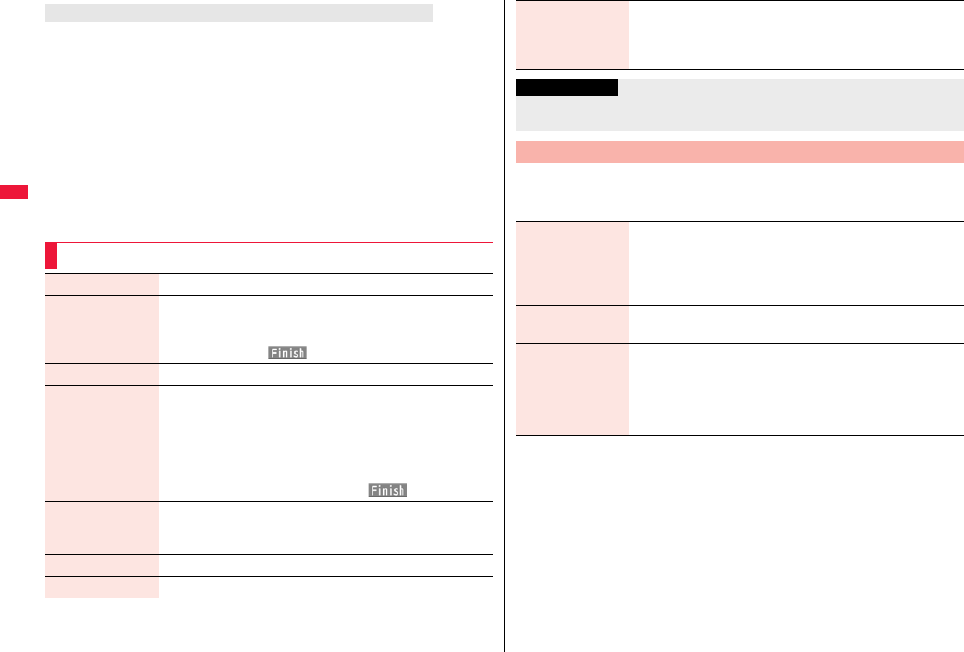
184
Mail
If you start Chat Mail from a mail address or from a chat group that is not stored in Chat
Member, the confirmation display appears asking whether to delete stored member and
start Chat Mail.
Select “YES”; then the current chat members are deleted and the sender’s mail address
or chat group members are stored in Chat Member.
If you start Chat Mail from the desktop
The sender’s mail address is stored in Chat Member. When the sender’s mail address
has been stored in a chat group, the members in that chat group are stored in Chat
Member. However, the mail address selected as the destination is only the mail address
of the sender.
If you start Chat Mail from Chat Group
The chat group members are stored in Chat Member. All members of the group are
selected as the destination.
If you start Chat Mail from the desktop or Chat Group
Function Menu of the Chat Mail Display
Send You can send the chat mail message.
Select receiver From among chat members, you can select destination
addresses to send the chat mail messages to.
1Put a check mark for destination addresses to send the
messages to1l()
Chat member You can store chat members. (See page 181)
Broadcast address You can check the destination addresses you have
simultaneously sent a chat mail message to.
≥When there are destination addresses that are not stored in
Chat Member, the confirmation display appears asking whether
to store them in Chat Member. If you store them in Chat
Member, select “YES” and put a check mark for the destination
addresses to be stored and press l().
Reload You can receive chat mail messages that you could not
automatically receive. If you receive a new chat mail message,
the Chat Mail display is updated.
View first line You can display the latest chat mail message.
View last line You can display the oldest chat mail message.
1l1Mail settings1Chat setting
1Do the following operations.
Delete read mails You can delete all the received read chat mail messages and
sent chat mail messages including secret mail and chat mail
messages failed to send.
1YES
Information
<Broadcast address>
≥You can store up to six members (including yourself) in Chat Member.
Chat Setting
Sound setting You can set a tone for when you send/receive a chat mail
message on the Chat Mail display.
1Select a folder1Select a tone.
≥The tone does not sound when a chat mail message comes in
from a member not stored in Chat Member.
Chat image You can set whether to display images on the Chat Mail display.
1ON or OFF
User setting You can set the name and image of the user (yourself).
1Select the name field1Enter a user name.
≥You can enter up to four full-pitch/eight half-pitch characters.
≥If you do not change the user name, go to the next step.
1Select the image field1Select a folder1Select an image.
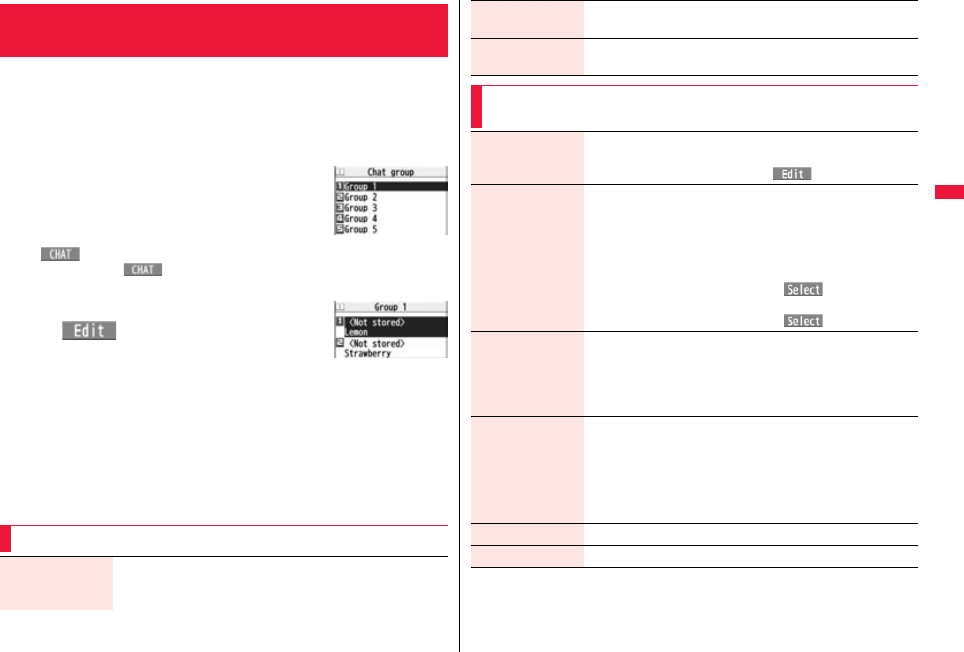
185
Mail
You can store the mail addresses you want to exchange chat mail per
group.
By storing multiple members in a group, you can set them as chat
members at a time.
You can store up to five mail addresses per group. You can create up to
five groups.
1m1Phonebook
1Phonebook settings1Chat group
1Select a chat group to be stored.
≥When the selected chat group has any member,
“ ” appears at the lower left of the display.
If you press l( ), Chat group members are stored in Chat Member and
Chat Mail starts. Go to step 2 on page 182.
2Highlight <Not stored> and press
l().
≥If you select a stored mail address, the Chat Group
Address Confirmation display appears.
3Enter a mail address.
≥You can enter up to 50 half-pitch characters.
≥When the entered mail address is stored in the Phonebook, and the image is
stored in the Phonebook, the image is also set.
≥When the mail address is “phone number@docomo.ne.jp”, store the phone
number only.
≥When you store multiple mail addresses, repeat step 2 and step 3.
+m-2-6
<Chat Group>
Creating Chat Group
Chat Group list
Detailed Chat Group
display
Function Menu of the Chat Group List
Activate chat The members in the chat group are stored as chat members and
Chat Mail starts.
Go to step 2 on page 182.
Edit group name 1Enter a chat group name.
≥You can enter up to 10 full-pitch/20 half-pitch characters.
Reset group name You can reset the name of the chat group to the default.
1YES
Function Menu of the Detailed Chat Group Display/Chat
Group Address Confirmation Display
Edit You can edit the mail address.
Go to step 3 on page 185.
≥You can edit also by pressing l().
Refer address You can look up a phone number or mail address in the
Phonebook, Sent Address, or Received Address to enter it.
1Select an item.
Phonebook . . . . . . . . .Call up a Phonebook entry and select a
phone number or mail address.
Sent address . . . . . . . Select a phone number or mail address
and press Oo().
Received address . . . Select a phone number or mail address
and press Oo().
Change member You can store members from a Mail group in the chat group.
1Mail group1Select a Mail group.
≥If you have already stored members in the chat group, the
confirmation display appears asking whether to replace all the
members.
Member setting You can set the member’s name and image. You can switch
members by pressing No.
1Select the member name field1Enter a member’s name.
≥You can enter up to four full-pitch/eight half-pitch characters.
≥Not to change the member’s name, go to the next step.
1Select the picture field1Select a folder1Select an image.
Delete 1YES
Delete all 1Enter your Terminal Security Code1YES
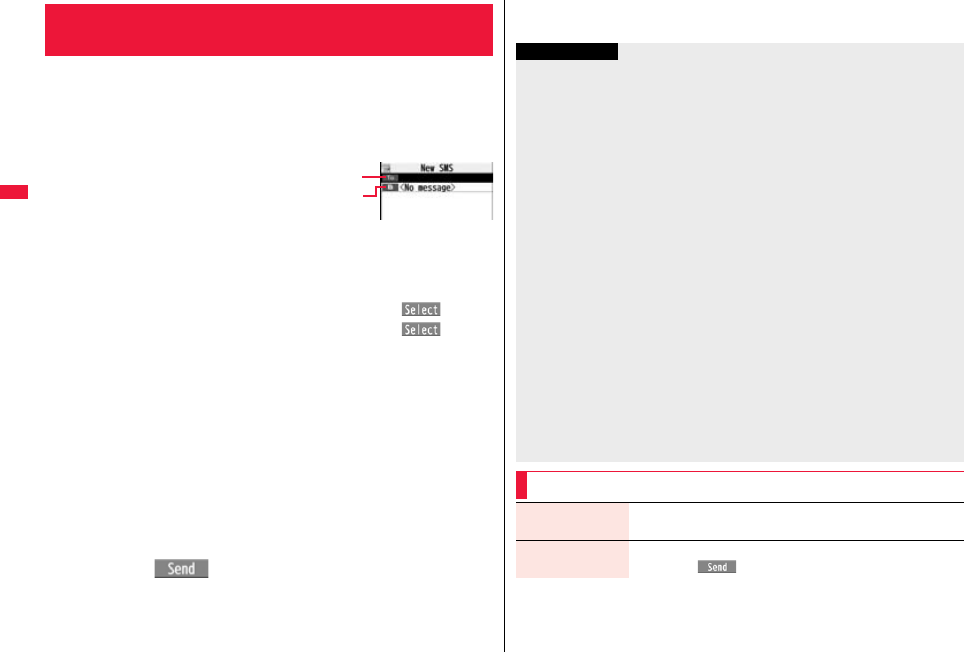
186
Mail
You can compose and send SMS messages. You can save up to 1,000
sent SMS messages including i-mode mail messages to the Outbox.
≥You can send and receive SMS messages to and from subscribers of overseas
carriers other than DOCOMO. For the countries and overseas carriers available for the
service, refer to the DOCOMO Global Service web page.
≥You can move/copy the sent SMS messages to the UIM. (See page 418)
1l1Compose SMS
2Select the address field1Select an item.
Phonebook . . . . . . . . . Call up a Phonebook entry and select a phone number.
Sent address . . . . . . . . Select a phone number and press Oo().
Received address. . . . Select a phone number and press Oo().
Enter address . . . . . . . Enter a phone number.
Only one address can be specified.
≥You can enter up to 21 digits (including “+”).
≥When the address is that of overseas carriers other than DOCOMO, enter “+”
(press and hold 0 for at least one second), “country/area code”, and
“destination mobile phone number” in that order. When the mobile phone number
begins with “0”, enter the phone number except for the “0”. Also, you can enter
“010”, “country/area code”, and “destination mobile phone number” in that order
to send SMS messages. (When you reply to SMS messages received from
overseas, enter “010”.)
3Select the text field1Enter text.
≥The number of characters you can enter differs depending on the “SMS input
character”.
4Press l().
The animation display during transmission appears and mail is sent.
<Compose SMS>
Composing and Sending SMS
SMS Composition
display
Address field
Text field
5OK
Information
≥Depending on the radio wave conditions, the characters might not be sent
successfully to the destination.
≥When the sent mail messages exceed the maximum number of storage, they are
deleted from the oldest one. However, protected sent mail messages are not deleted.
≥You cannot compose an SMS message when sent mail messages in the Outbox are
saved to the maximum and all of them are protected, when 20 draft mail messages
are saved, or when the Draft is full.
Release the protection for sent mail messages, or send/delete draft mail messages,
and then operate again.
≥Even if “Activate” of “Caller ID notification” is set to “OFF”, the caller ID is notified to the
other party you send an SMS message to. If you attempt to send an SMS message to
the phone number headed by “184”/“186”, the confirmation display appears asking
whether to delete prefix numbers and send the mail.
≥If you set “SMS report request” to “ON”, you cannot send SMS messages to the
i-mode phone of the mova service.
≥“+” is valid only at the beginning of the address.
≥You cannot send the message to addresses that include any characters other than
numbers, “#”, “:” and “+”.
≥You cannot start a new line while editing the text.
≥The special symbols (see page 500) are replaced by half-pitch spaces.
≥Each space is counted as a character.
≥You cannot reply to the SMS message whose sender is User unset/PublicPhone/
Unavailable.
≥In B Mode of 2in1, you cannot compose SMS messages.
Function Menu of the SMS Composition Display
Send You can send the SMS message.
Go to step 5 on page 186.
Preview Before sending, you can check the address and the text contents.
≥Press l( ) to send the SMS message.
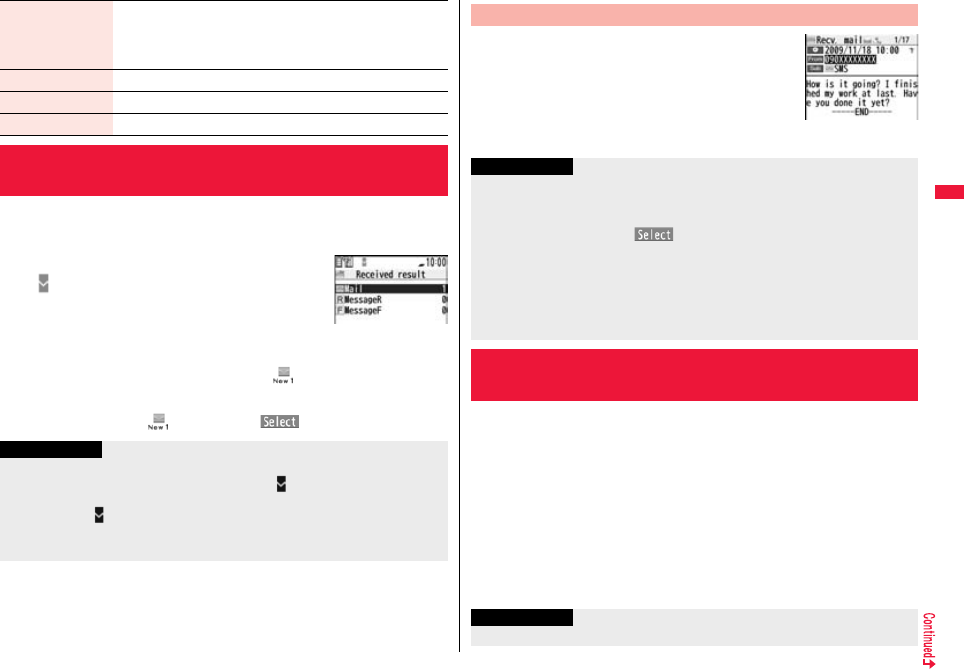
187
Mail
You can save up to 2,500 received SMS messages including i-mode mail
messages.
≥You can move/copy the received SMS messages to the UIM. (See page 418)
1When an SMS message arrives,
“ (pink)” lights and the receiving
message is displayed.
When receiving ends, the display shows the number of
received SMS messages.
≥You can display the Inbox list by selecting “Mail”.
≥If no keys are pressed for about 15 seconds, “ ” (see page 29) appears on
the desktop and the former display returns. (The transit time varies depending on
the setting for “Mail/Msg. ring time”.)
Press Oo, highlight “ ”, and press Oo( ) to display the Inbox list.
Save You can save the SMS message you are composing or editing to
the Draft.
≥You cannot save the message when the address field and text
field are blank.
SMS report req. See page 188.
SMS valid. per. See page 188.
SMS input char. See page 188.
<Receive SMS>
Receiving SMS Automatically
Reception Result
display
Information
≥When the number of unread or protected messages in the Inbox has reached the
maximum, no new messages can be received and “ (dark blue)” is displayed. To
receive SMS messages, delete mail in the Inbox or read unread mail or release
protection until “ (dark blue)” clears, and then perform “Check new SMS”.
≥When you receive concatenated SMS messages, they are displayed on the Inbox list
in order of arrival at the FOMA terminal.
1Reception Result display1Mail
1Select an SMS message to be
displayed.
≥Press and hold No for at least one second from the
detailed SMS display to change the size of characters.
(See “Mail” on page 119)
When SMS messages arrive at the SMS Center, they are automatically
sent to your FOMA terminal, but will be held at the SMS Center if your
FOMA terminal cannot receive messages such as when it is off or out of
the service area.
You can receive the messages by “Check new SMS”.
1l1Check new SMS
2Return
If the Center holds SMS messages, the FOMA terminal automatically receives
them.
Display Newly Received SMS Messages
Information
≥Depending on the characters entered in the received SMS message, spaces might be
displayed.
≥While the sender’s address (phone number) is highlighted in the displayed SMS
message, you can press *Oo( ) to make a voice call, videophone call, or
PushTalk call to the displayed number (the Phone To/AV Phone To function).
Further, if the sender’s phone number is stored in the Phonebook, the stored “name”
is highlighted. In this case, you can dial the phone number in the same way.
≥A Short Mail message is received as an SMS message on the FOMA terminal. When
the sender does not notify you of the phone number, the reason is displayed in the
sender’s field.
<Check New SMS>
Checking New SMS
Information
≥Some SMS messages are not delivered immediately after checking.
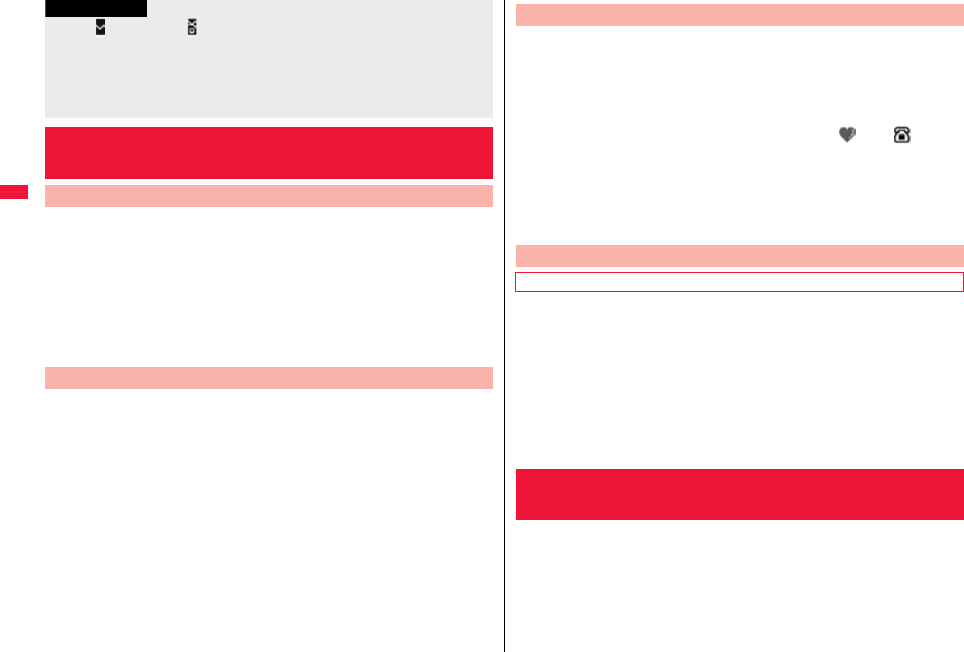
188
Mail
You can set whether to request an SMS report for when sending an SMS
message.
The SMS report lets you know that your SMS message was delivered to
the destination.
You can check received SMS reports in the “Inbox” folder.
1l1SMS settings1SMS report request1ON or OFF
≥When you operate from the Function menu of the SMS Composition display, the
setting is effective only for the SMS message you are composing.
You can set the period that the SMS Center holds an SMS message sent
but unsuccessfully delivered due to the out-of-service area, etc.
1l1SMS settings1SMS validity period
1Select a holding period.
≥If you select “None”, the stored SMS message is re-sent after a certain period of
time and deleted from the SMS Center.
≥When you operate from the Function menu of the SMS Composition display, the
setting is effective only for the SMS message you are composing.
≥When “ (dark blue)” or “ (dark blue)”, etc. are displayed, you cannot receive any
more SMS messages. Delete unnecessary mail, read unread mail, or release
protection. (Read and unprotected messages are automatically deleted from the
oldest one.)
≥You cannot use this function to receive i-mode mail or Messages R/F. Use “Check
new messages” to receive i-mode mail or Messages R/F.
<SMS Settings>
Setting SMS
SMS Report Request
Information
SMS Validity Period
You can set the characters you can enter into the text of SMS messages.
You can set to enter only half-pitch alphanumeric characters and
half-pitch symbols.
1l1
SMS settings
1
SMS input character
1
Select an item.
Japanese (70char.) . . . You can enter full-pitch and half-pitch characters. You
cannot enter pictograms except “ ” and “ ” (see
page 496). You can enter up to 70 characters for the text.
English (160char.). . . . You can enter only half-pitch alphanumeric characters
and half-pitch symbols. You can enter up to 160
characters for the text.
≥When you operate from the Function menu of the SMS Composition display, the
setting is effective only for the SMS message you are composing.
You can set the address and “Type of number” for the SMS Center. This
setting is for getting any service other than SMS Service you currently use.
1l1SMS settings1SMS center selection
1User setting1Enter an address
1International or Unknown
≥You can enter up to 20 half-pitch characters for the address. However, if “#” or
“:” is included, you cannot set it for “International”.
≥You can reset User Setting to “DOCOMO” by Reset1Enter your Terminal
Security Code1YES.
You can send mail messages or browse received mail messages on the
i-mode site.
≥You can use only in B Mode or Dual Mode of 2in1.
≥For details on Web mail, refer to “Mobile Phone User’s Guide [2in1]”.
1l1Web mail
1Operate following the instructions on the display.
SMS Input Character
SMS Center Selection
※Normally, you do not need to change this setting.
<Web Mail>
Using Web Mail

189
i-mode/i-motion/i-Channel/i-concier
i-mode . . . . . . . . . . . . . . . . . . . . . . . . . . . . . . . . . . . . . . . . . . . . . . 190
Displaying a Site
Accessing Sites . . . . . . . . . . . . . . . . . . . . . . . . . . . . . <iMenu> 190
Viewing and Operating Sites . . . . . . . . . . . . . . . . . . . . . . . . . . . . 191
Displaying Most Recently Accessed Site. . . . . . . .<Last URL> 194
Using My Menu . . . . . . . . . . . . . . . . . . . . . . . . . . . . . <My Menu> 194
Changing i-mode Password . . . .<Change i-mode Password> 195
Displaying Internet Web Pages . . . . . . . . . . . . . . . <Enter URL> 195
Saving Web Pages or Sites for Quick Access
. . . . . . . . . . . . . . . . . . . . . . . . . . . . . . . . . . . . . . . . . <Bookmark> 196
Saving Site Contents . . . . . . . . . . . . . . . . . . . . <Screen Memo> 197
Downloading Images, Melodies, etc. from Sites
Saving Images from Sites . . . . . . . . . . . . . . . . . .<Save Image> 199
Downloading Data from Sites . . . . . . . . . . . . . . . . <Download> 200
Uploading Images, Movies, etc. to Sites
Uploading Files to Sites . . . . . . . . . . . . . . . . . . . . . . . . . . . . . . . . 202
Useful Functions of i-mode
Operations from Highlighted Information . . . . . . . . . . . . . . . . . 202
Setting i-mode
Setting i-mode . . . . . . . . . . . . . . . . . . . . . . . <i-mode Settings> 204
Setting Connection Timeout . . . . . <Set Connection Timeout> 204
Changing a Host from i-mode (ISP Connection Communication)
. . . . . . . . . . . . . . . . . . . . . . . . . . . . . . . . . . . . . <Host Selection> 205
Using Certificates
Operating SSL Certificates . . . . . . . . . . . . . . <SSL Certificate> 205
Setting FirstPass . . . . . . . . . . . . . . . . . . . . . .<User Certificate> 206
Changing Hosts for Certificate Issue. . . . . .<Certificate Host> 207
Using i-motion
i-motion. . . . . . . . . . . . . . . . . . . . . . . . . . . . . . . . . . . . . . . . . . . . . 208
Downloading i-motion from Sites. . . . . . <Download i-motion> 209
Setting Automatic Replay of i-motion
. . . . . . . . . . . . . . . . . . . . . . . . . . . . <Automatic Replay Setting> 210
Using i-Channel
i-Channel. . . . . . . . . . . . . . . . . . . . . . . . . . . . . . . . . . . . . . . . . . . . 210
Using i-Channel . . . . . . . . . . . . . . . . . . . . . . . . . . . . . . . . . . . . . . 210
Setting How Ticker is Displayed. . . . . . . . . . . . . . . . . . . . . . . . . 211
Using i-concier
i-concier . . . . . . . . . . . . . . . . . . . . . . . . . . . . . . . . . . . . . . . . . . . . 211
Displaying i-concier Screen . . . . . . . . . . . . . . . . . . . . . . . . . . . . 212
Configuring i-concier Settings . . . . . . . . . . . . . . . . . . . . . . . . . . 213
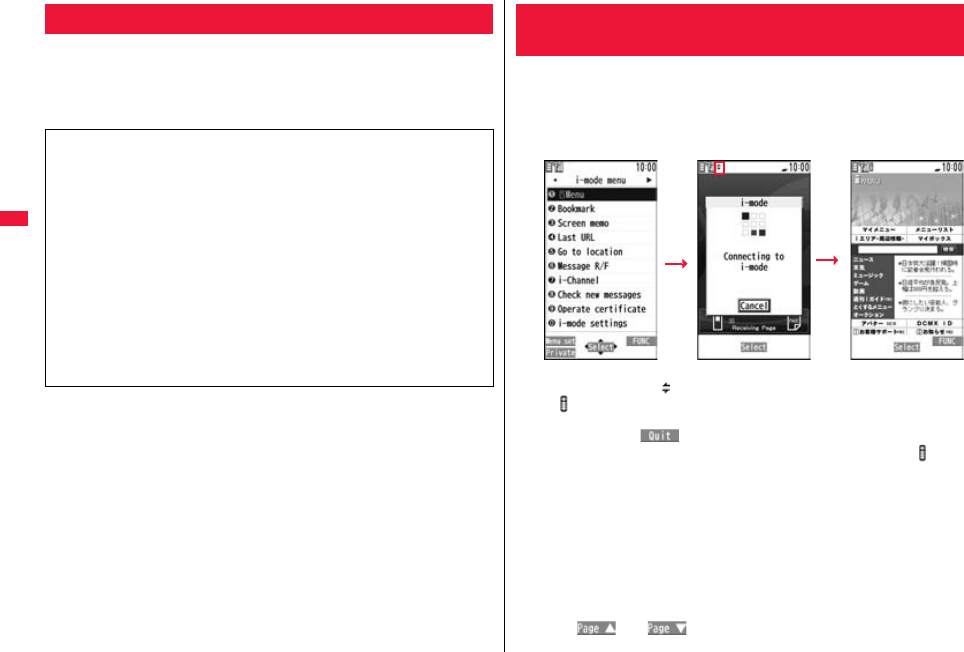
190
i-mode/i-motion/i-Channel/i-concier
i-mode is the service that makes use of the display of the FOMA terminal
supporting i-mode (i-mode phone) to enable you to use online services
such as site (program) access, Internet access, and i-mode mail.
≥i-mode is a pay service that is available on a subscription basis.
≥For details on i-mode, refer to “Mobile Phone User’s Guide [i-mode] FOMA version”.
i-mode
■Before Using i-mode
≥Contents of sites (programs) and web pages (Internet web pages) are generally
protected by copyrights law. Data such as text and images that you obtained to the
i-mode phone from sites (programs) and Internet web pages can be used for
personal entertainment but cannot be used in whole or in part, as it is or after
modification, for commercial purposes or sent as e-mail attachments or output from
your i-mode phone to other devices, unless you have permission from the copyright
holders.
≥If you replace the UIM with another one or turn on the power with the UIM not
inserted, you cannot display/play back files depending on the model, such as still
images/movies/melodies obtained from sites, attached files (still images/movies/
melodies and other files) sent/received by mail, screen memos, or Messages R/F.
≥When the file whose display and/or playback is restricted by the UIM is set for the
Stand-by display or specified ring tone, the FOMA terminal works with the default
contents when you replace the existing UIM with new one or turn on the power with
the UIM not inserted.
You can use a variety of services offered by IPs (Information Providers).
From the display of the FOMA terminal, you can check your bank
balance, reserve tickets, and do similar tasks. (IPs offer different types of
services. Some of them need to be applied for separately.)
1i1iMenu
While you are online, “ ” blinks.
≥“ ” blinks while you are using the i-mode service (during i-mode standby).
≥To cancel during the connection, select “Cancel”. To cancel while obtaining a
page, press l().
≥To end i-mode, press h and select “YES” while the site is displayed. “ ” goes
off and i-mode ends. It may take longer to end i-mode.
2Select an item (link).
Repeat selecting items (links) to display the desired site.
≥You can select underscored items on the displayed site. When you select an
item, it is highlighted.
≥If there is a number at the head of the item showing the link, you can connect to
that link directly by pressing the numeric key corresponding to that number.
(Some sites cannot be connected.)
≥While the site is displayed, press Bo to scroll through line by line. Press
m()/c() or </> to scroll through page by page.
<iMenu>
Accessing Sites
i-mode menu
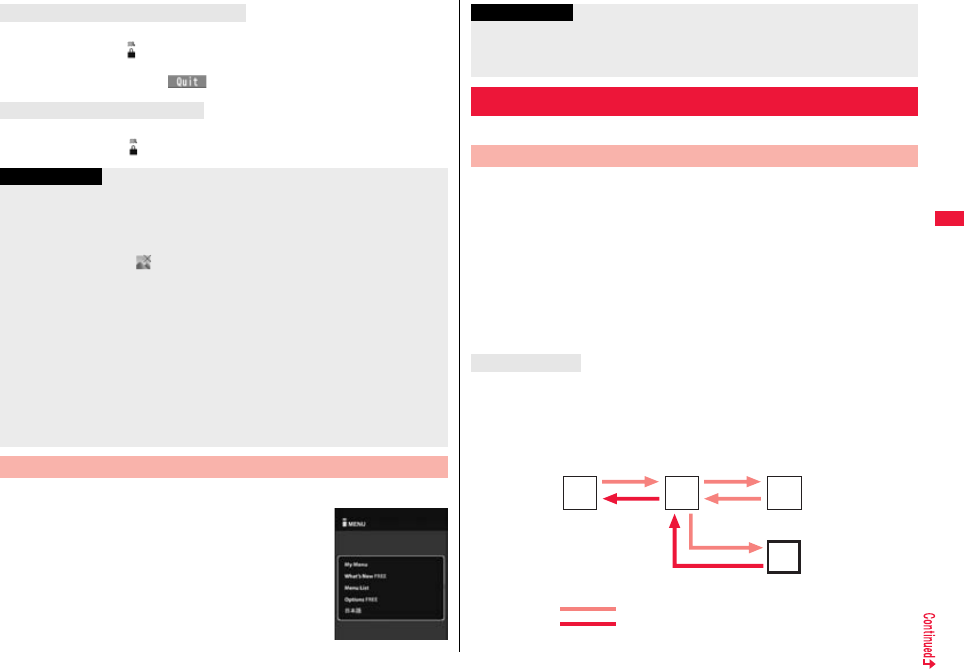
191
i-mode/i-motion/i-Channel/i-concier
The display for establishing authentication appears. When obtaining is completed, the
SSL page appears and “ ” lights.
≥To cancel during authentication, select “Cancel”. To cancel obtaining the SSL page
after authentication, press l().
The confirmation display appears asking whether to close the SSL page. Select “YES” to
display an ordinary site; “ ” goes off.
The iMenu can be displayed in English.
1i1iMenu1English
iMenu in English will be displayed.
≥To change back to the Japanese display, select “日本
語 (Japanese)”.
To obtain an SSL site (SSL page)
To return to a non-SSL site
Information
≥Depending on the site, you may need to apply for the service in writing separately, or
to pay information fees to use it.
≥The maximum display size of the images on the site is 480 x 1400 dots. If an image is
larger than 480 x 1400 dots, it is displayed shrunk with a proportional ratio retained.
≥Depending on the site, “ ” might be displayed when the image is not correctly
displayed.
≥Depending on the site or data, you might not be able to download or save melodies,
PDF files, software programs, and others.
≥With some Internet web pages (sites) supporting i-mode, the color setting might make
the text difficult or impossible to see.
≥When you are asked from the site to send information about music you have played
back on the FOMA terminal, the confirmation display appears for about sending your
music information. Select “YES” to send the information (title names, artist names,
and played dates) of the music played back on the FOMA terminal. The sent music
information is used for the IP (information provider) to provide customized information
to you.
Change to iMenu in English
Basic operating methods while a site is displayed are explained.
The FOMA terminal saves the files such as the displayed Internet web
pages to a temporal storage area called a cache. By pressing No, you
can show the page stored in the cache without communicating.
≥When you show a page that exceeds the cache size of the FOMA terminal or a page
configured (created) to always read its latest information, the FOMA terminal starts
communication.
≥When i-mode ends, the cache is cleared.
1Press Co to return to the previous page.
Press Vo to go to the next page.
You can move back up through the pages that you have displayed so far by pressing
Co repeatedly. However, if you display a different page (“D”) from the previous page
(“B”), you cannot return to “C” from “D” even when you press Co twice. Instead, the
pages are displayed in the order of “D” → “B” → “A”.
Information
≥The iMenu in English differs slightly from the iMenu in Japanese.
≥Items such as Tokusuru Menu and News are not shown on the iMenu in English.
≥Generally, “What’s New” site will be updated every other Monday.
Viewing and Operating Sites
Return to Obtained Previous Page/Go to Obtained Next Page
To turn pages
<When pages have been displayed in the order of
“A”→“B”→“C”→“B”→“D”>
…Sequence of page display
…Sequence when previous page from
the display “D” has been displayed
A B C
D
CoCo
Co
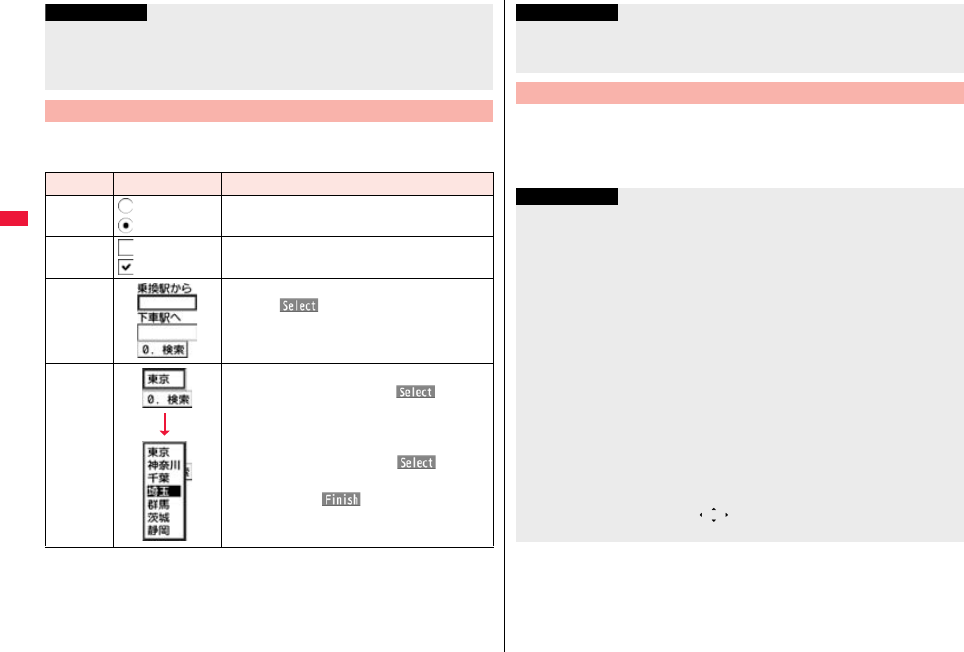
192
i-mode/i-motion/i-Channel/i-concier
In sites, you may use the displayed radio buttons, check boxes, text
boxes, and pull down menus.
Information
≥When you display a page stored in cache, you cannot display text or settings you
entered when connected before.
≥When Flash movies are displayed, the site behavior might differ from the one for
ordinary sites.
Select/Enter Information on Sites
Name Display example Operation/Explanation
Radio
button
: Not selected
: Selected
Radio buttons are for selecting one from multiple
choices.
Check box : Not selected
: Selected
Check boxes are for selecting one or more items
from multiple choices.
Text box You can enter characters. Highlight a text box and
press Oo( ) to show the Character Entry
display.
Pull down
menu
You can select an item from the option list. Highlight
a pull-down menu and press Oo( ) to show
the option list.
≥You might be able to select multiple items from
pull-down menus. Each time you use Bo to
highlight an item and press Oo( ), you can
select/release items repeatedly. After selecting
items, press l().
Flash is an animation technology using pictures and sound. Flash
movies make the sites more attractive. You can download Flash movies
to your FOMA terminal and play them back or set them for the Stand-by
display.
Information
≥Depending on the site, the display authenticating your user ID or password might
appear.
Enter your user ID and password, and then select “OK”.
Flash Function
Information
≥The maximum display size of the Flash movies on the site is 480 x 700 dots. If a Flash
movie is larger than 480 x 700 dots, it is displayed shrunk with a proportional ratio
retained.
≥Some Flash movies refer to the phone-information data in your FOMA terminal. To
permit the use of the information in your FOMA terminal, set “Use phone information”
to “YES”. (“YES” is set at purchase.)
≥Effect tones sound for some Flash movies. To mute them, set “Sound effect setting”
(or “Sound effect”) to “OFF”.
≥The effect tone and vibrator for the Flash movie set for the Stand-by display do not
work.
≥The effect tone for Flash movies does not sound during Play Background.
≥Some Flash movies may vibrate the FOMA terminal while they are being played back.
The FOMA terminal vibrates regardless of the setting of “Vibrator”.
≥When you play back a Flash movie after saving to Data Box, microSD card, or Screen
Memo, it might look different depending on the saving location.
≥Some Flash movies might not work correctly.
≥You cannot save the Flash movies if an error occurs while they are being played back.
≥You can operate some Flash movies by using *Mo or *Oo. Flash movies can be
operated sometimes even when “ ” is not displayed.
≥When Flash movies are displayed, the behavior might differ from ordinary sites.
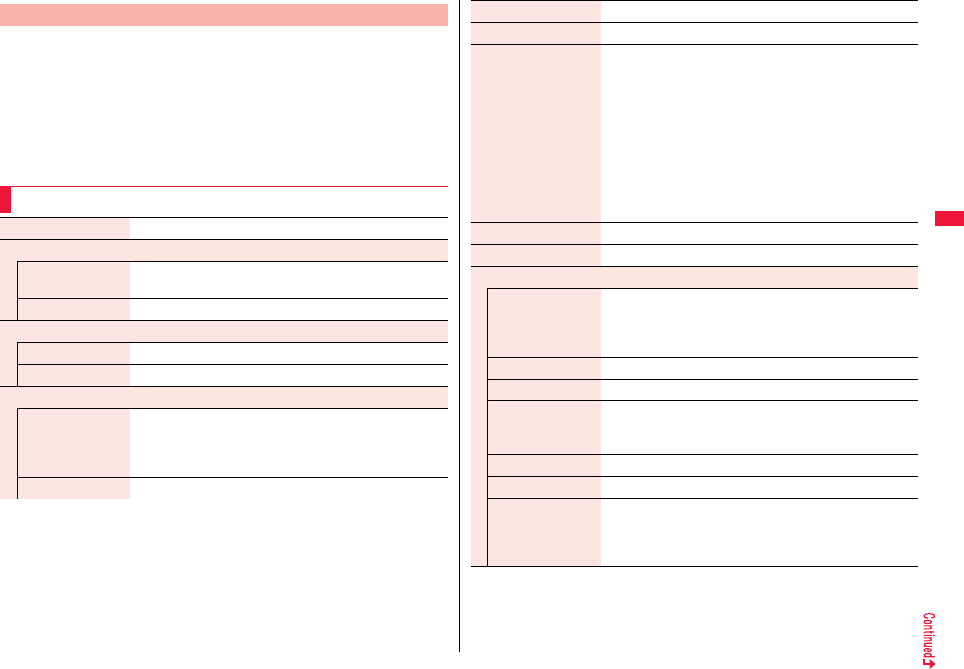
193
i-mode/i-motion/i-Channel/i-concier
When you select an item, the confirmation display might appear asking
whether to send the Phone/Terminal and UIM ID.
≥The “Phone/Terminal and UIM ID” to be sent is used by the IP (Information Providers)
for identifying the user, providing customized information, and judging if the contents
the IP (Information Provider) offers are available on the user’s mobile phone.
≥The “Phone/Terminal and UIM ID” is sent to the IP (Information Provider) over the
Internet, so could be deciphered by third parties. However, your phone number,
address, age, and gender are not notified to the IPs (Information Providers) or others,
by this operation.
Phone/Terminal and UIM ID
Function Menu while Site is Displayed
iMenu You can return to “iMenu”.
Bookmark
Bookmark Go to step 1 of “Display Web Pages or Sites from a
Bookmark” on page 196.
Add bookmark See page 196.
Screen memo
Screen memo list Go to step 2 on page 198.
Add screen memo See page 197.
Go to location
Enter URL You can enter a URL to display an Internet web page.
1Select the text box.
Go to step 2 of “Displaying Internet Web Pages” on page 195.
≥The URL of the displayed site is input beforehand.
Switch to FB See page 218.
Reload The site contents will be updated with the latest information.
Save image See page 199.
Compose message You can compose an i-mode mail message with the URL/
image of a displayed site/screen memo pasted or attached.
1Select an item.
Attach URL . . . . . . . .Pastes a URL to the text of an i-mode
mail message.
Attach image. . . . . . .Select an image to attach it to an
i-mode mail message.
Insert dec. mail. . . . .Select an image to paste it to a
Deco-mail message.
Go to step 2 on page 142.
≥See page 146 for Deco-mail.
Add to phonebook See page 92.
Add desktop icon See page 31.
Others
Change CHR code When characters are not correctly displayed, you can convert
them to the correct ones.
≥This setting is valid only for the site and Internet web page
being displayed.
Title You can display the title of the displayed site.
URL You can display the URL of the displayed site.
Certificate You can check the subject name, author, validity period and
serial number of the certificate used in SSL communication.
Up to five certificates are displayed.
Set image display See page 204.
Sound effect See page 204.
Retry You can play back the animation or Flash movie from the
beginning.
≥When a part of the Flash movie is outside the display area,
the Flash movie might not be played back.
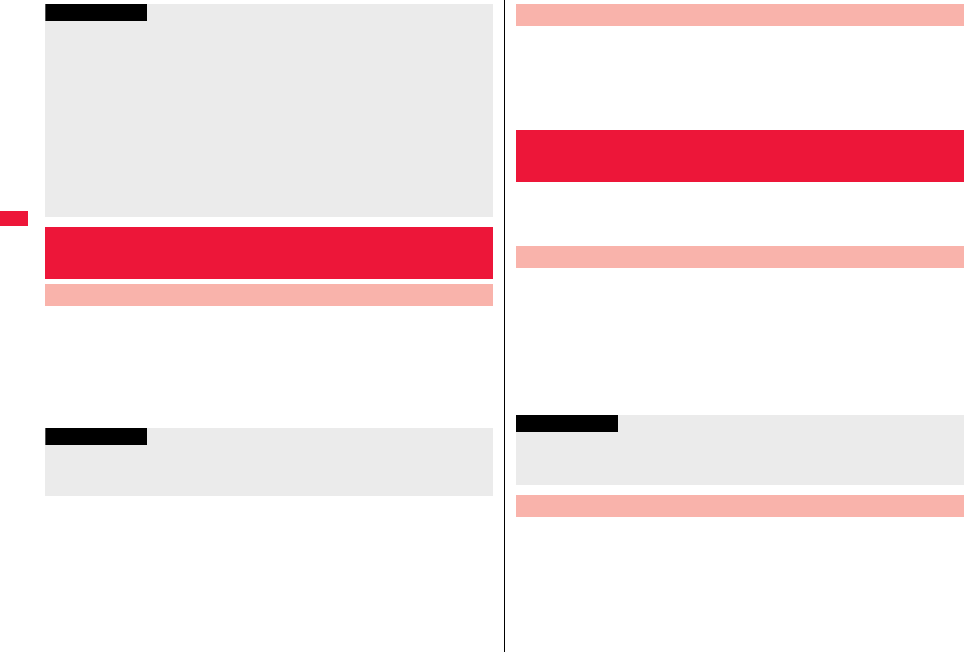
194
i-mode/i-motion/i-Channel/i-concier
When you end i-mode, the URL of the page displayed last is stored as
“Last URL”.
You can display the page you viewed last time by selecting “Last URL”
from the i-mode menu.
1i1Last URL
Information
<Compose message>
≥The number of characters of the URL you can paste to the text is up to 256 half-pitch
characters. If the URL contains 256 half-pitch characters or more, you cannot paste it.
≥You may not be able to attach or paste some images to i-mode mail.
<Change CHR code>
≥When characters are not correctly displayed, repeat the operation. However, the
previous character is displayed if you repeat the operation four times.
≥Even when you repeat this operation, the correct character might not appear.
≥If you change the character code when the correct characters are displayed, wrong
characters might appear instead.
<Title>
≥Up to 128 half-pitch/64 full-pitch characters can be displayed for a title.
<Last URL>
Displaying Most Recently Accessed Site
Display Last URL
Information
≥Some pages cannot be stored as “Last URL”, such as pages whose URLs contain
more than 2,048 half-pitch characters, the data acquisition completion display for
melodies or i-motion movies, etc. and FirstPass Center pages.
You can initialize the URL of the page you viewed last time to the iMenu
URL.
1i1i-mode settings1Reset last URL1YES
If you register frequently used sites in My Menu, you will be able to
access them easily.
You can register up to 45 sites.
1Call up a page to be registered1Register My Menu
≥The page configuration differs depending on the site.
2Select the i-mode password text box
1Enter the i-mode password1決定 (OK)
≥The entered i-mode password is displayed as “*”.
≥See page 122 for the i-mode password.
1i1iMenu1English1My Menu
1Select a site to be accessed.
Reset Last URL
<My Menu>
Using My Menu
Register Sites in My Menu
Information
≥Some sites cannot be registered in My Menu.
≥When you subscribe to a pay site in Menu list, it will be registered in My Menu
automatically.
Access Sites from My Menu
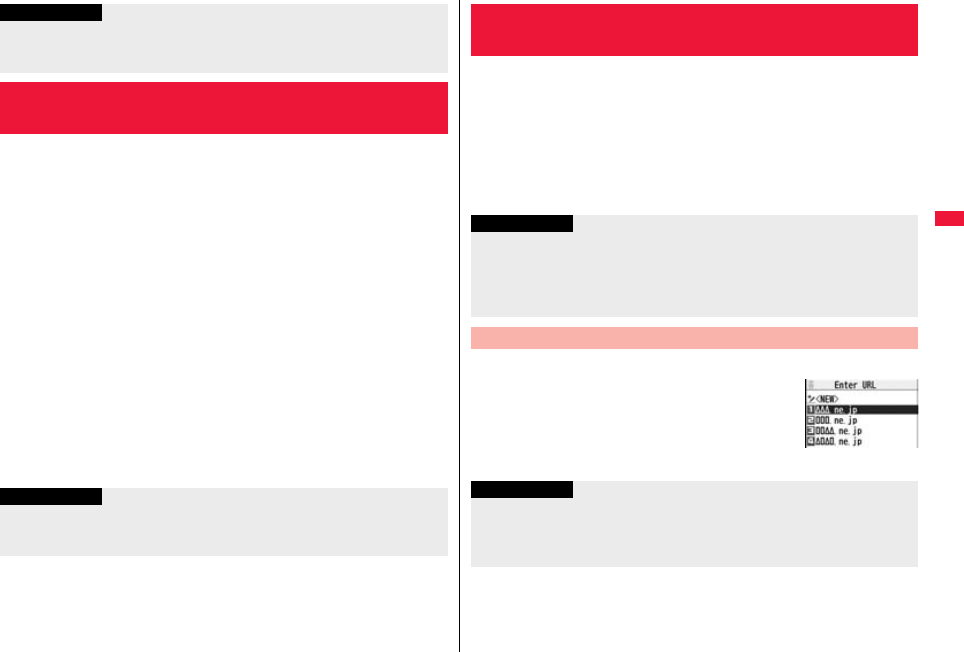
195
i-mode/i-motion/i-Channel/i-concier
The i-mode password (four digits) is required to subscribe to and
unsubscribe from message services and i-mode pay sites, and to do
i-mode mail settings.
Be sure not to let others know your i-mode password.
1i1iMenu1English1Options
1Change i-mode Password
1Select the “Current Password” text box
1Enter the i-mode password (four digits).
≥If you enter the i-mode password for the first time, enter “0000” (four zeros) which
is set at a time of your contract.
≥The entered numeral is displayed as “*”.
2Select the “New Password” text box
1Enter a new i-mode password (four digits).
≥Enter your own i-mode password.
3Select the “New Password (Confirmation)” text box
1Enter the new i-mode password (four digits)1Select
≥Enter the same number that you entered in step 2.
Information
≥If you are using Dual Network Service, you might not be able to use My Menu
registered by the mova phone using the FOMA terminal, or My Menu registered by
the FOMA terminal using the mova phone.
<Change i-mode Password>
Changing i-mode Password
Information
≥Note that if you do not remember the i-mode password, you need to bring an
identification card such as your driver’s license to the handling counter of a docomo
shop.
1i1Go to location1<NEW>
2Enter a URL1OK
≥You can enter up to 256 half-pitch alphanumeric characters and symbols (up to
512 half-pitch characters for Full Browser).
≥For Full Browser, the confirmation display appears telling that the web page might
not be displayed.
Up to 10 entered URLs can be stored in URL History.
1i1Go to location
1Select a URL to be displayed1OK
≥Excluding “http://” and “https://”, up to 22 half-pitch
characters can be displayed.
≥You can edit the URL by selecting the URL’s text box.
<Enter URL>
Displaying Internet Web Pages
Information
≥For i-mode, Internet web pages not supporting i-mode or some type of internet web
pages to be connected might not be displayed correctly.
≥When the file size of the page you have received exceeds the maximum obtainable
size of a page, receiving is suspended. The data obtained so far might be displayable
by selecting “OK”.
Displaying Web Pages from URL History
URL History list
Information
≥When the entered URLs exceed 10 items, the URL histories are overwritten
automatically, starting from the oldest one.
≥When you newly enter a URL to access a site, that URL is saved as a different record
even if you access the same URL.
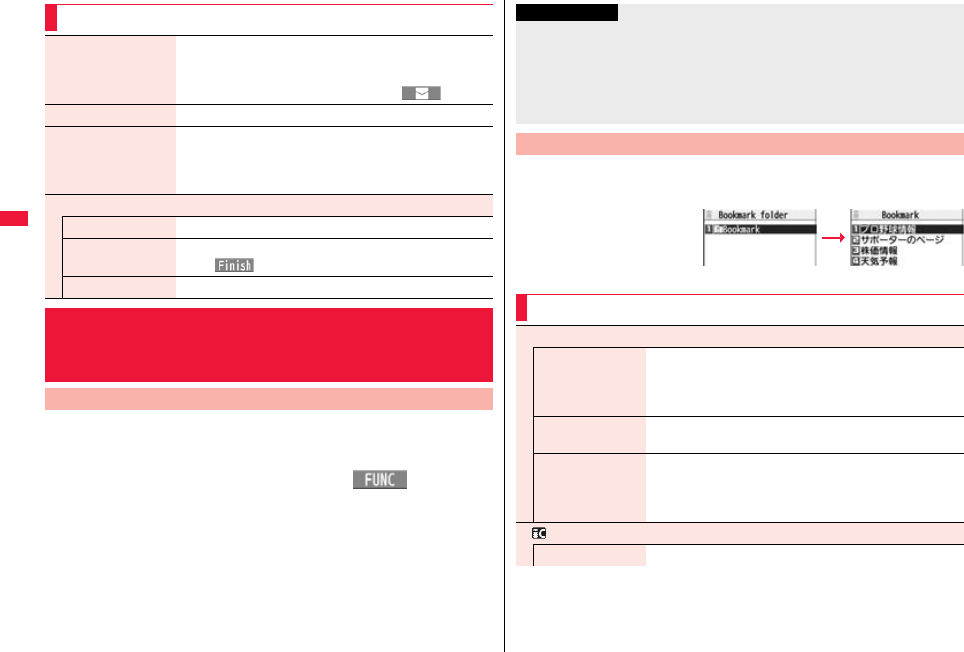
196
i-mode/i-motion/i-Channel/i-concier
Once you bookmark a frequently accessed site, you can display the page
directly. You can register 300 bookmarks each for i-mode and Full
Browser.
1From the page to be registered1i()
1Bookmark1Add bookmark1YES
1Select a destination folder.
Function Menu of the URL History List
Compose message You can compose an i-mode mail message with the
highlighted URL pasted to the text.
Go to step 2 on page 142.
≥You can compose it also by pressing l().
Add desktop icon See page 31.
Set as home URL You can store the site as Home URL of Full Browser.
1YES
≥You can operate this only from the URL History list of Full
Browser.
Delete
Delete (Delete this) 1YES
Delete selected 1Put a check mark for URL histories to be deleted
1l()1YES
Delete all 1Enter your Terminal Security Code1YES
<Bookmark>
Saving Web Pages or Sites for Quick
Access
Add Bookmark
1i1Bookmark1Select a folder
1Select a bookmark to be displayed.
Information
≥When the number of characters used for a URL exceeds 256 half-pitch characters
(512 half-pitch characters for Full Browser), you cannot store it.
≥Up to 12 full-pitch/24 half-pitch characters are stored for a title. For longer titles, the
excess characters are deleted. If no title is entered, the URL without “http://” or
“https://” is registered.
≥Some pages cannot be bookmarked.
Display Web Pages or Sites from a Bookmark
Bookmark Folder list Bookmark list
Function Menu of the Bookmark Folder List
Operate folder
Add folder You can add a new folder. You can add up to nine folders in
addition to each “Bookmark” folder/“Screen memo” folder.
1Enter a folder name.
≥You can enter up to 10 full-pitch/20 half-pitch characters.
Edit folder name 1Edit the folder name.
≥You can enter up to 10 full-pitch/20 half-pitch characters.
Delete folder You can delete the folder and all bookmarks and screen
memos in the folder. You cannot delete the “Bookmark” folder/
“Screen memo” folder.
1Enter your Terminal Security Code1YES
Ir/ transmission
Send all Ir data See page 385.
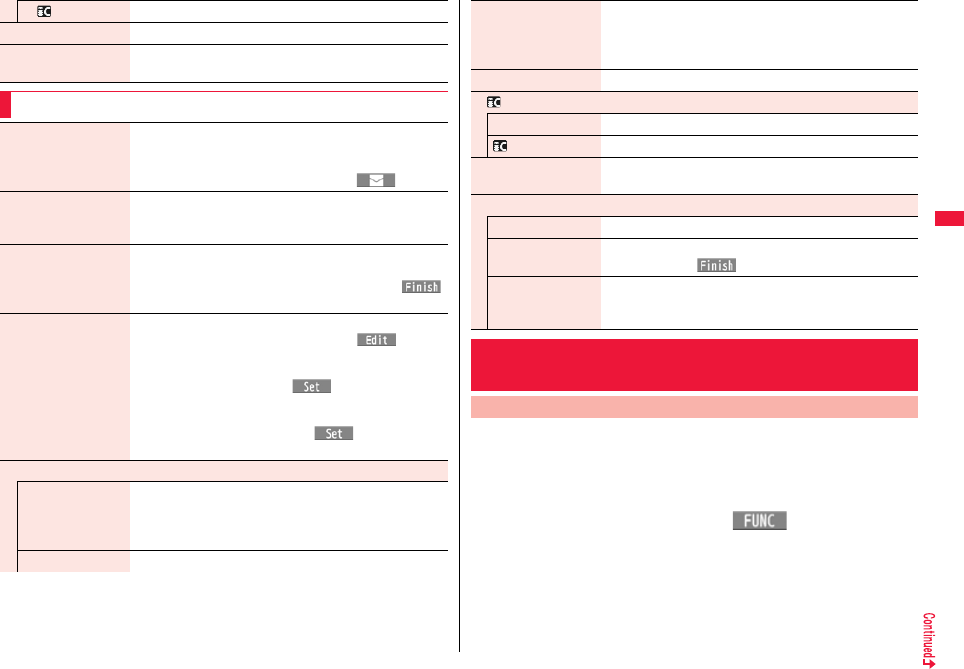
197
i-mode/i-motion/i-Channel/i-concier
All transmission See page 387.
No. of bookmarks You can check the number of bookmarks stored in all folders.
Delete all The folders are not deleted.
1Enter your Terminal Security Code1YES
Function Menu of the Bookmark List
Compose message You can compose an i-mode mail message with the
highlighted URL pasted to the text.
Go to step 2 on page 142.
≥You can compose it also by pressing l().
Attach to mail You can send an i-mode mail message with the bookmark
attached.
Go to step 2 on page 142.
Move You can move bookmarks or screen memos to another folder.
1Select a destination folder1Put a check mark for
bookmarks or screen memos to be moved1l()
1YES
Edit title 1Edit the title.
≥You can edit the title also by pressing m( ) from the
list.
≥You can enter up to 12 full-pitch/24 half-pitch characters for
a bookmark. If you press Oo( ) with a blank, the URL
without “http://” or “https://” is registered.
≥You can enter up to 11 full-pitch/22 half-pitch characters for
a screen memo. If you press Oo( ) with a blank, the
screen memo is registered as “No title”.
Copy
Copy URL You can copy the URL of the bookmark.
1Select a start point for copying
1Select an end point for copying.
≥See page 436 for how to paste copied characters.
Copy to microSD See page 370.
You can save a displayed page as a screen memo to the FOMA terminal.
You can display the page saved as a screen memo without connecting to
i-mode.
You can save up to 300 screen memos, however, the number of screen
memos you can save decreases depending on the data volume.
1From a page to be saved1i()1Screen memo
1Add screen memo1YES1Select a destination folder.
≥See page 201 when screen memos are stored to the maximum.
Set as home URL You can store the site as Home URL of Full Browser.
1YES
≥You can operate this only from the Bookmark list of Full
Browser.
Add desktop icon See page 31.
Ir/ transmission
Send Ir data See page 384.
transmission See page 387.
No. of bookmarks You can display the number of bookmarks stored in the
displayed folder.
Delete
Delete (Delete this) 1YES
Delete selected 1Put a check mark for bookmarks or screen memos to
be deleted1l()1YES
Delete all You can delete all bookmarks or screen memos stored in the
folder.
1Enter your Terminal Security Code1YES
<Screen Memo>
Saving Site Contents
Save as a Screen Memo
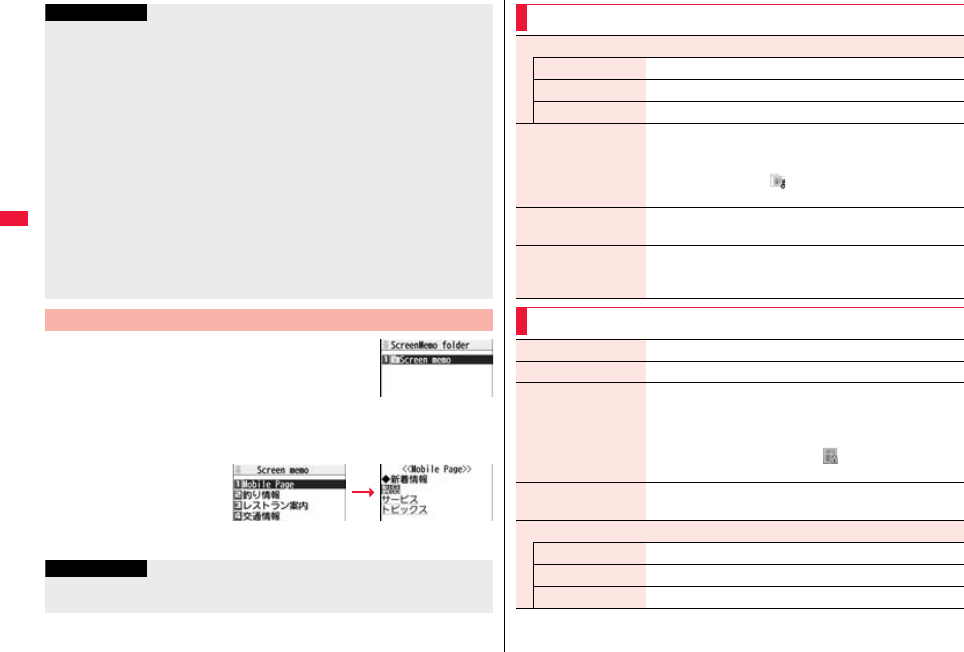
198
i-mode/i-motion/i-Channel/i-concier
1i1Screen memo
2Select a folder1Select a screen memo.
≥Use No to check other
screen memos.
Information
≥Up to 11 full-pitch/22 half-pitch characters are stored for a title. For longer titles, the
excess characters are deleted.
≥If you save the data acquisition completion display, its data file is saved as well. (You
cannot save the data acquisition completion display for Chaku-uta Full® music files,
for i-motion movies with playable deadline, or for the ToruCa files whose output from
the FOMA terminal is prohibited.) Some data acquisition completion displays cannot
be saved as screen memos. The display except the data acquisition completion
display is saved with a URL of that page of up to 256 half-pitch characters.
≥When you save SSL pages, their SSL certificates are saved as well.
≥The contents entered in the text box, or selected with the pull-down menu, check box,
or radio button are not saved to screen memos.
≥You can save up to 100 Kbytes per page. However, you can save up to 1,024 Kbytes
for the schedule acquisition completion display, up to 500 Kbytes for the i-motion
acquisition completion display, up to 200 Kbytes for the Deco-mail Template
acquisition completion display, up to 20 Kbytes for the Download Dictionary
acquisition completion display, and up to 1 Kbyte for the ToruCa acquisition
completion display.
Display a Screen Memo
Screen Memo
Folder list
Screen Memo list Detailed Screen
Memo display
Information
≥The page saved as a screen memo has the information at the time it was saved. This
might differ from the latest information on the site.
Function Menu of the Screen Memo Folder List
Operate folder
Add folder See page 196.
Edit folder name See page 196.
Delete folder See page 196.
Security ON/OFF You can set the folder to open only when you enter your
Terminal Security Code.
1Enter your Terminal Security Code1YES
The folder changes to “ ”.
≥To release it, perform the same operation.
No. of memos You can display the number of stored screen memos and
protected screen memos in all folders.
Delete all You can delete all screen memos. The folders will not be
deleted.
1Enter your Terminal Security Code1YES
Function Menu of the Screen Memo List
Move See page 197.
Edit title See page 197.
Protect ON/OFF You can protect screen memos not to be deleted. You can
protect up to 150 screen memos, however, the number of
screen memos you can protect decreases depending on the
data volume.
Protected items are indicated by “ ”.
≥To release protection, perform the same operation.
No. of memos You can display the number of stored screen memos and
protected screen memos in the displayed folder.
Delete
Delete See page 197.
Delete selected See page 197.
Delete all See page 197.
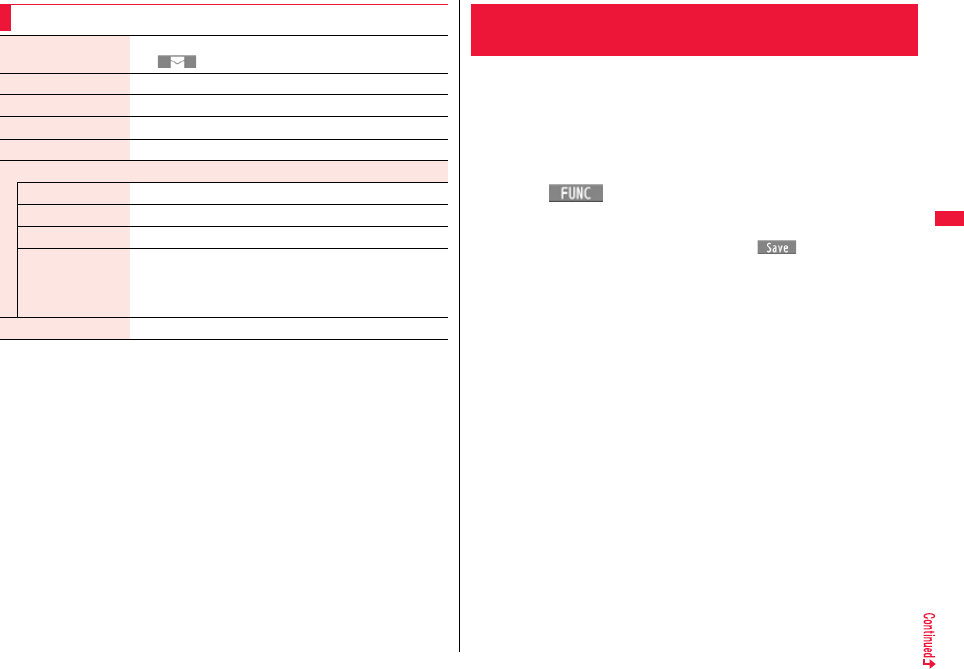
199
i-mode/i-motion/i-Channel/i-concier
Function Menu of the Detailed Screen Memo Display
Compose message You can compose an i-mode mail message also by pressing
l( ). (See page 193)
Edit title See page 197.
Protect ON/OFF See page 198.
Save image See page 199.
Add to phonebook See page 92.
Others
URL You can display the URL of the screen memo.
Certificate See page 193.
Sound effect See page 204.
Retry You can play back the animation or Flash movie from the
beginning.
≥When a part of the Flash movie is outside the display area,
the Flash movie might not be played back.
Delete 1YES
You can save the image displayed on a site or screen memo, and then set
it for the Stand-by display, Wake-up display, or another display.
You can save images, frames and marks for Deco-mail as well. You can
save up to 3,500 files in total sharing the memory space with other data
files, however, the number of files you can save decreases depending on
the data volume. (See page 535)
1From a site display/Detailed Screen Memo display
1i()1Save image1Select an item.
Save one image . . . . . . You can save an image. Select an image to be saved.
Save some images . . . You can save multiple images. Select multiple images to
be saved and press l().
Save all images . . . . . . You can save storable images at a time from among the
ones displayed on a site.
Save BG image. . . . . . . You can save the image displayed as a background.
2YES1Select a destination folder.
≥For “Save some images” and “Save all images”, select “Phone” or “microSD”.
When you select “Phone”, Deco-mail pictograms are saved to the “Deco-mail
pictograms” folder, frames are saved to the “Frame” folder, marks are saved to
the “Stamp” folder, and others are save to the “i-mode” folder. See page 372 for
the storage location for when you select “microSD”.
≥See page 201 when images are stored to the maximum.
3When the confirmation display appears asking whether
to set it as a display, select “YES”.
Go to “Set display” on page 345.
<Save Image>
Saving Images from Sites
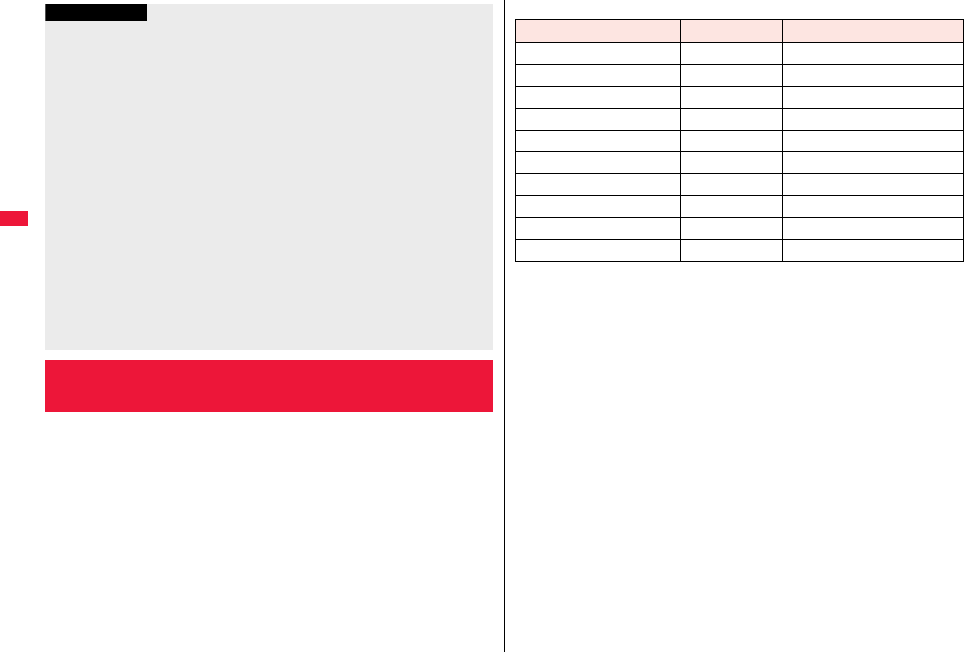
200
i-mode/i-motion/i-Channel/i-concier
You can download data files from sites and save them to the FOMA
terminal. You can save some files directly to the microSD card.
You can save melodies, PDF files, Chara-den images, Machi-chara
images, Kisekae Tool files, ToruCa files, templates, dictionaries,
schedule events and others.
Information
≥Up to 36 half-pitch characters are saved for a file name. When the file name is not
specified, a part of the downloaded URL or “imageXXX” (XXX denotes numerals) is
saved as the file name.
≥Even when an image is displayed on the site, it might not be displayed on the Picture
viewer after saving it to the FOMA terminal.
≥The image satisfying the following conditions is saved as a Deco-mail pictogram:
・GIF or JPEG image ・Image of 20 x 20 dots
・Image without file restrictions ・Image of 6 Kbytes or less
≥The image satisfying the following conditions is saved as a frame or stamp:
・Transparent GIF (except animation GIF) ・The extension is “ifm”.
・Image of Stand-by (480 x 854) or smaller
Images of Stand-by (480 x 854), VGA (480 x 640), CIF (288 x 352),
QVGA (240 x 320), QCIF (144 x 176), and Sub-QCIF (96 x 128) are saved as
frames, and other images are saved as stamps.
≥You can save up to 100 Kbytes per image via i-mode, or 500 Kbytes per image via
Full Browser.
≥When you save multiple images or all images at one time, the background image
cannot be saved.
≥For Full Browser, you cannot save some images. You can save images in BMP
format and PNG format only to the microSD card.
<Download>
Downloading Data from Sites
■The maximum downloadable size
※1 The memory space is shared with other data files, and the number of files you can
save decreases depending on the data volume. (See page 535)
※2 The number of files you can save decreases depending on the data volume.
1Call up a data downloadable site1Select a data file.
Downloading of the data file starts. When downloading is completed, the data
acquisition completion display appears.
≥For a PDF file, the PDF file is displayed when downloading is completed.
≥For the PDF file that cannot be displayed unless you download all pages, the
confirmation display appears asking whether to download all pages. Select “YES”
to select the destination folder.
≥For the PDF file of which you have not downloaded all the pages, you can
additionally download the remaining pages by “Download remain”.
≥See page 392 for how to save the displayed PDF file to the FOMA terminal. You
can save the PDF file containing pages that have not been downloaded or the
PDF file of which download was suspended midway as well.
≥The password entry display might be displayed depending on the PDF file. Enter
the password, and then select “OK”.
≥See page 389 for operations while PDF file is displayed.
Categories Maximum size Maximum number of storable
Melody 100 Kbytes 3,500 max.※1
PDF file 2 Mbytes 3,500 max.※1
Chara-den image 100 Kbytes 3
Machi-chara image 2 Mbytes 3,500 max.※1
Kisekae Tool file 2,078 Kbytes 3,500 max.※1
ToruCa file 100 Kbytes 495 max.※1
Template (Deco-mail) 100 Kbytes 100 max.※2
Template (Decome-Anime) 100 Kbytes 100 max.※2
Dictionary 20 Kbytes 10
Schedule event 1 Mbyte 2,500
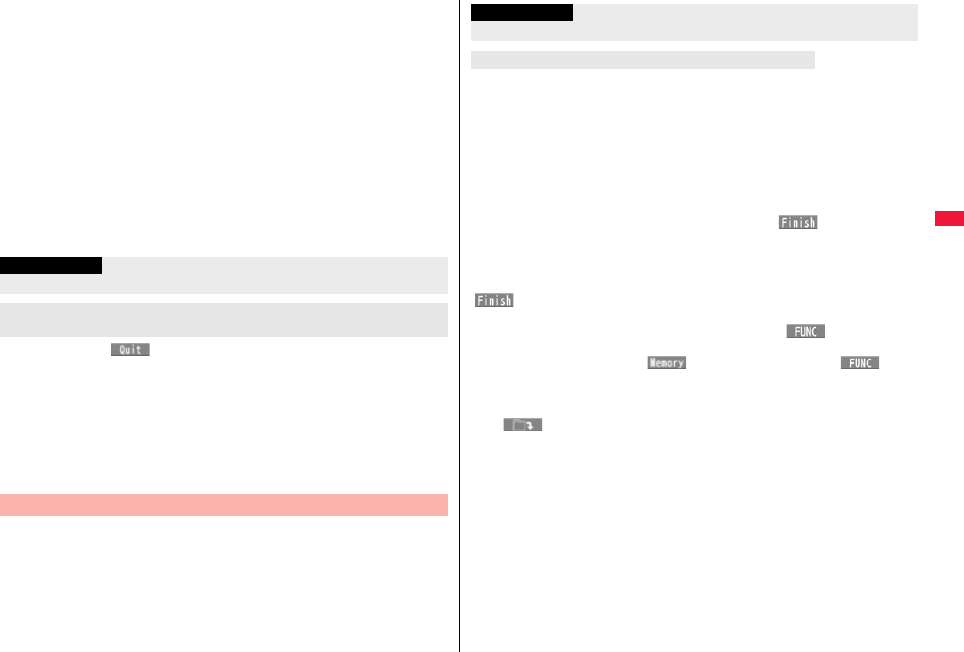
201
i-mode/i-motion/i-Channel/i-concier
2Save1YES1Select a destination folder.
Chara-den images, templates (Deco-mail), and schedule events are saved to the
FOMA terminal.
Select “Phone” or “microSD” for Machi-chara images, Kisekae Tool files, and
templates (Decome-Anime).
For dictionaries, select “<Not stored>”.
≥Select “Property” to display the information.
≥See page 201 when data files are stored to the maximum.
≥See page 197 to save a screen memo.
3Select “YES” to set the downloaded data file to each
function.
≥Select an incoming type when you set a melody as a ring tone.
≥See page 146 or page 149 for using a template to create Deco-mail or
Decome-Anime messages.
When you press l( ) to suspend downloading or when downloading is
suspended by an incoming call, the confirmation display appears asking whether to
resume downloading.
Select “YES” to resume downloading the remaining part. Select “NO” to show the data
acquisition completion display. You can save the downloaded part by selecting “Save
pt.” from the data acquisition completion display. When you select “Save pt.”, you can
save it only to “Phone”.
You can re-download the rest of the partially saved file from “Kisekae Tool” or
“Machi-chara” in “Data box”.
You can look for your favorite files on the site and download them. The
number of files you can save differs depending on the file you download.
You cannot change the site.
1Each selection display1Search by i-mode1YES
1Select a file.
≥The way of downloading differs depending on the file.
≥Select “To i-schedule list” on the i-schedule list.
Information
≥Some downloaded melodies might not be played back successfully.
When downloading a Kisekae Tool file or Machi-chara image
is suspended
Search by i-mode
If the maximum number of data files is stored or there is not enough memory when you
try to save the data files, the confirmation display appears asking whether to delete the
unnecessary file and save new one.
≥Perform this operation to save the following data:
・Images ・i-motion movies ・Melodies
・Chara-den images ・Machi-chara images ・Programs
・Chaku-uta Full® music files ・PDF files ・i-αppli programs
・ToruCa files ・Templates ・Screen memos
・Kisekae Tool files ・Schedule events
1. YES1Put a check mark for data files to be deleted1l()1YES
As the data files except Chara-den images, templates, screen memos, and schedule
events are stored in the same storage area, you can select other files when deleting files.
Select a folder and put a check mark for the files to be deleted. “*” appears on the folder
which contains the checked files.
“ ” appears when you put it for the files whose amount of data is equal to memory
shortage.
≥You can put or clear check marks at a time by pressing i( ) and selecting
“Select all in page/Release in page”.
≥Each time you press d or i( ), or each time you press i( ) and
select “Change disp. mode”, you can switch display/nondisplay of the folder volume
and data volume.
≥When selecting a file in “MUSIC”, you can show the lower level folders by pressing
l().
≥Each time you press r, the upper level folder returns.
≥For programs, you need to delete many files when deleting other files because the data
volume per program is large.
≥If the maximum number of programs are stored when you execute “Move program” or
try to save an i-αppli program or ToruCa file, you need to delete at least one file which
belongs to the same type.
≥If there is a security-applied folder for screen memos, the confirmation display appears
asking whether to enable you to select screen memos in that security-applied folder.
When you select “YES”, you need to enter your Terminal Security Code.
≥The file set for another function is indicated by “★”.
≥See page 294 for deleting mail-linked i-αppli.
≥If you operate this when moving an i-αppli program from the microSD card to the
FOMA terminal, you cannot delete the i-αppli program with its data file on the IC card.
Information
≥You are separately charged a packet communication fee.
When the data files are stored to the maximum
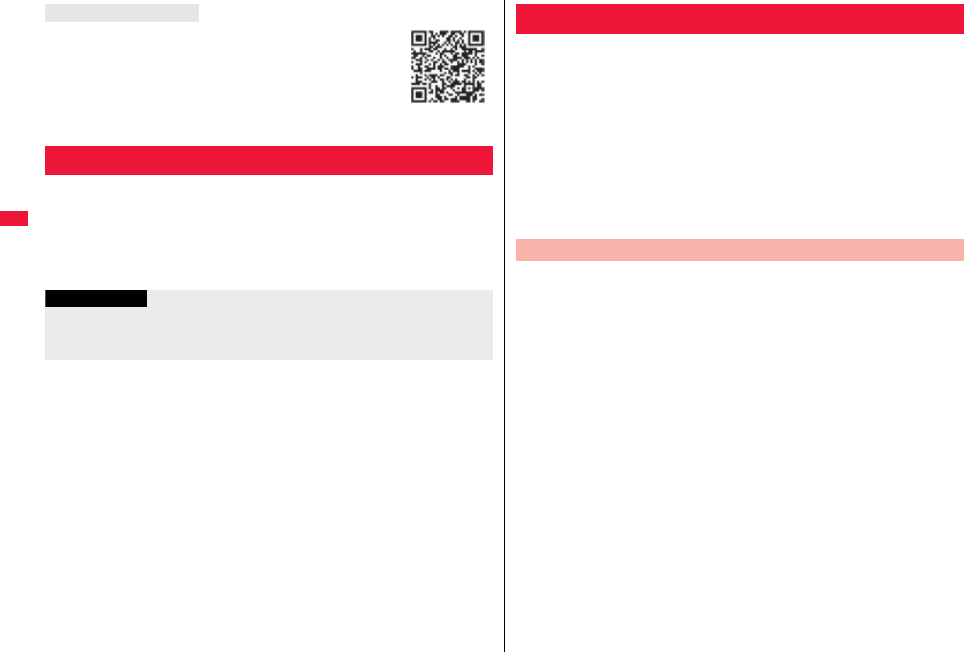
202
i-mode/i-motion/i-Channel/i-concier
You can download the pre-installed Chara-den images, Machi-chara
images, Kisekae Tool files, templates, dictionaries, and Deco-mail
pictograms from the “P-SQUARE” site (in Japanese only).
iMenu → メニューリスト (Menu List) → ケータイ電話メーカー
(Mobile Phone Maker) → P-SQUARE
You can upload JPEG or GIF images and i-motion movies stored in the
FOMA terminal to a site.
1Call up a file uploadable site1参照 (Reference)
1Picture or imotion1Select a file to be uploaded.
≥Procedure for uploading files differs depending on the site.
About “P-SQUARE”
Uploading Files to Sites
QR code for
accessing the site
Information
≥You can upload up to 2 Mbytes in total.
≥You cannot upload files that are prohibited from output from the FOMA terminal to
other devices.
You can easily make a call, send mail, display Internet web pages, start
1Seg, set TV Timer/Timer Recording using highlighted information
(phone numbers, mail addresses, URLs, melodies, images, and so on)
displayed on sites and in mail.
≥The Web To, Phone To/AV Phone To, Mail To, i-αppli To, Media To and Address Link
functions might not be available depending on the mail sent from a personal computer
or the site.
≥You might be able to use the Web To, Phone To/AV Phone To, Mail To, or i-αppli To
function using highlighted information other than a phone number, mail address or
URL.
≥In B Mode of 2in1, the Mail To function is not available.
≥The information is not highlighted in the Decome-Anime.
You can make voice calls, videophone calls or PushTalk calls by using
phone numbers or similar information displayed on sites and in mail.
≥The Phone To function to make a videophone call is called the AV Phone To function.
1Select a phone number or similar information
1Select a dialing type.
≥When you select “Select image”, select an image to be sent to other party during
a videophone call.
≥Select “SMS” to compose an SMS message to send to the phone number set as
the destination address. Go to step 3 on page 186.
≥The choices for dialing types may not be displayed when the phone number is
prefixed by “tel:” or “tel-av:”. Go to step 2.
2Dial
≥To make an international call, select “Int’l dial assist”. (See page 59)
≥To set Caller ID Notification, select “Notify caller ID”. (See step 2 of “Set Caller ID
Notification when Making a Call” on page 56)
Operations from Highlighted Information
Phone To/AV Phone To Function
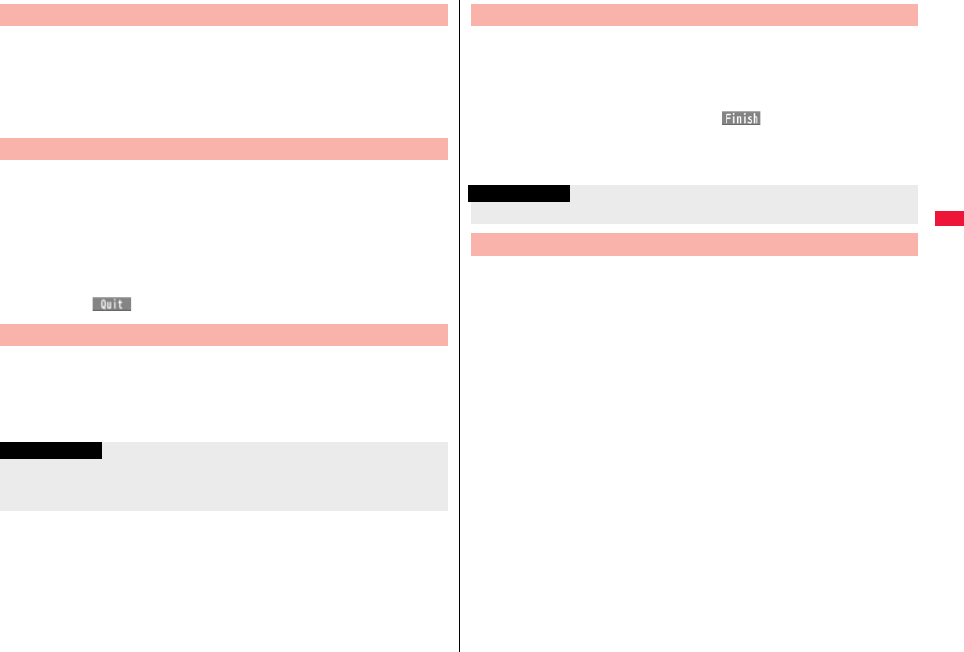
203
i-mode/i-motion/i-Channel/i-concier
You can send mail by using mail addresses or similar information
displayed on sites and in mail.
1Select a mail address or similar information.
The destination mail address is already entered in the address field.
Go to step 3 on page 142.
You can access Internet web pages, via i-mode or Full Browser, from
URL or similar information displayed on sites or in mail.
1Select a URL or similar information
1i-mode or Full Browser1YES
≥When the URL or similar one contains the information of i-mode or Full Browser,
you are connected via the function which corresponds to the information.
≥To cancel during connection, select “Cancel”. To cancel while obtaining a page,
press l().
You can start i-αppli programs from URLs (links) displayed on sites and
in mail.
1Select i-αppli information1YES
i-αppli starts.
Mail To Function
Web To Function
i-αppli To Function
Information
≥Even if i-mode mail text contains a link to start an i-αppli program, you cannot quote
the link when forwarding or replying to. Also, you cannot quote it when using
DOCOMO keitai datalink or infrared communication function.
You can start 1Seg or set TV Timer/Timer Recording from the information
(links) displayed on sites and in mail.
1Select 1Seg information1YES
1Seg or TV Timer/Timer Recording starts.
≥When the timer function starts, press l( ) to set TV Timer/Timer
Recording.
To change contents you want to set, go to step 1 of “TV Timer List” on page 261
or step 1 on page 262.
You can display a map from the postal address shown on a site or others
or can use the location information on the GPS compatible i-αppli
program. You can send the location information by i-mode mail as well.
1Select the location information such as postal address
1Select an item.
Read map . . . . . . . Starts a GPS compatible i-αppli program set by “Select map”
of “GPS settings”. Select “YES” to send the location
information.
Map/GPS αppli . . . Selects and starts a GPS compatible i-αppli program.
Paste to mail. . . . . Converts the location information into a URL and composes an
i-mode mail message with the URL pasted to the text.
Check loc. info . . . Displays the details of the selected location information.
Media To Function
Information
≥You may not be able to use the Media To function even if information is highlighted.
Address Link Function
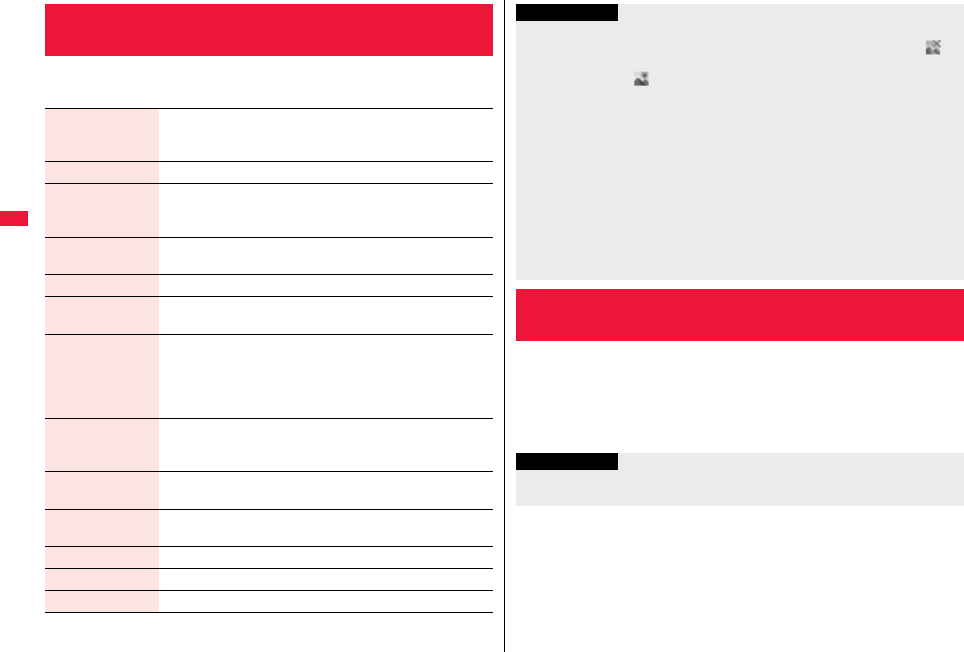
204
i-mode/i-motion/i-Channel/i-concier
1i1i-mode settings1Do the following operations.
<i-mode Settings>
Setting i-mode
Scroll You can set the number of lines that are scrolled for when you
use Bo while displaying a site or screen memo.
1Select the number of lines.
Font size See “i-mode” on page 119.
Set image display You can set whether to display images or Flash movies included
on sites or in screen memos.
1ON or OFF
Set connection
timeout
See page 204.
Host selection See page 205.
Automatic replay
set.
See page 210.
Use phone
information
To display a Flash movie while a site or screen memo is
displayed, the information in the FOMA terminal may be used.
You can select whether to permit the information to be used for
that case.
1YES or NO
Sound effect setting You can set whether to make an effect tone sound for when you
display a Flash movie while a site or screen memo is displayed.
1ON or OFF
Information disp.
set.
See page 213.
Doc. display
settings
See page 392.
i-mode arrival act See page 86.
Reset last URL See page 194.
Check settings You can check each of “i-mode settings”.
It may take long to obtain some sites. You can set the time to wait before
canceling obtaining. Obtaining is not canceled automatically when
“Unlimited” is set.
1i1i-mode settings1Set connection timeout
1Select a timeout value.
Information
<Set image display>
≥Even when “ON” is set, images might not be displayed correctly. In this case, “ ” is
displayed.
≥When “OFF” is set, “ ” is displayed and the data file is not received.
≥If you change this setting, “Set image display” of “User settings” of “1Seg” is also
changed.
<Use phone information>
≥The available information is as follows:
・Date and time set by “Set time”
・Reception level of radio waves
・Battery level
・Sound volume set by “Phone” of “Ring volume”
・Language selected by “Select language”
・Model name and serial number of FOMA terminal
<Sound effect setting>
≥Even when “ON” is set, the effect tones may not sound depending on Flash movies.
<Set Connection Timeout>
Setting Connection Timeout
Information
≥Even when you have set “Unlimited”, you may be disconnected owing to radio wave
conditions.
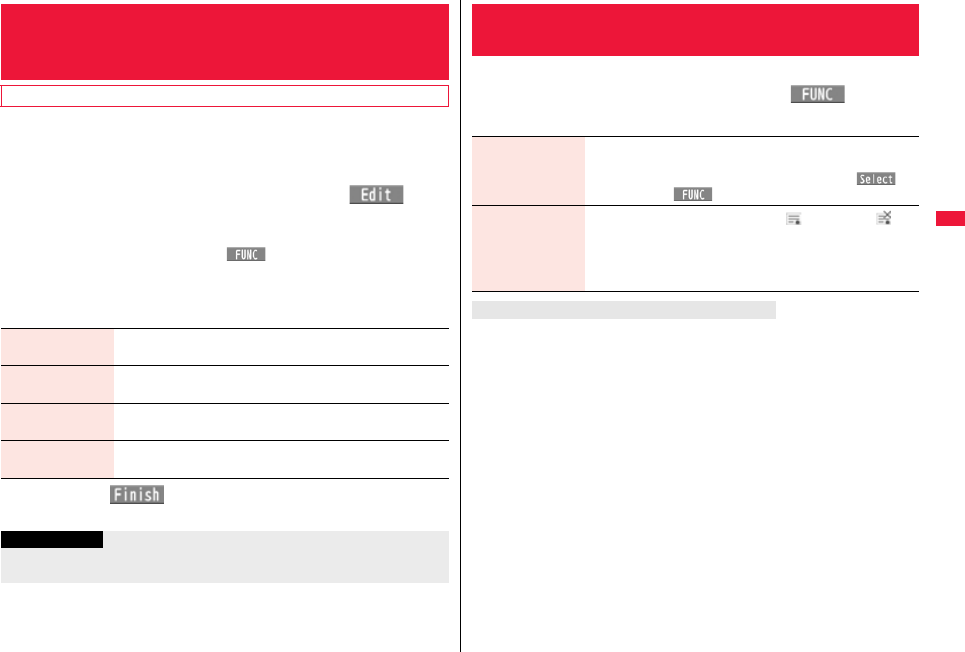
205
i-mode/i-motion/i-Channel/i-concier
You can set the host (APN) to use for receiving services other than
i-mode (DOCOMO).
If you change this setting, you will not be able to use i-mode.
1i1i-mode settings1Host selection
1Highlight <Not recorded> and press l()
1Enter your Terminal Security Code.
≥If you select a stored host, the setting is changed to the selected one.
≥To delete the stored host, press i( ), select “Delete”, enter your
Terminal Security Code, and then select “YES”.
2Do the following operations.
3Press l().
+m-8-1
<Host Selection>
Changing a Host from i-mode
(ISP Connection Communication)
※Normally, you do not need to change this setting.
Host name 1Enter a host name.
≥You can enter up to 9 full-pitch/18 half-pitch characters.
Host number 1Enter a host number.
≥You can enter up to 99 half-pitch alphanumeric characters.
Host address 1Enter a host address.
≥You can enter up to 30 half-pitch alphanumeric characters.
Host address 2 1Enter a host address 2.
≥You can enter up to 30 half-pitch alphanumeric characters.
Information
≥Pake-hodai, Pake-hodai full and Pake-hodai double are not applied when you set the
host to other than i-mode.
1i1Operate certificate1Certificate
1Highlight a certificate and press i()
1Do the following operations.
Certificate . . . . . . . . . . . . Certificates issued by the authenticating company and stored
in the FOMA terminal at purchase.
DOCOMO Certificate . . . Certificates required for connecting to the FirstPass Center or
FirstPass sites; they are stored on the UIM (green/white).
User Certificate . . . . . . . . Certificates downloaded from the FirstPass Center by
selecting “User certificate” from the i-mode menu; they are
stored on the UIM (green/white).
<SSL Certificate>
Operating SSL Certificates
Certificate info The subject name, author, validity period, and serial number of
the certificate are displayed.
≥You can check the certificate also by pressing Oo()
instead of i().
Valid/Invalid The selected item is invalidated; then “ ” changes to “ ”.
≥When you select an invalid certificate, it will be validated.
≥If you set a certificate to invalid, you cannot display the sites with
that SSL certificate.
≥You cannot set “DOCOMO Cert 2” to “Invalid”.
Certificates used for SSL communication
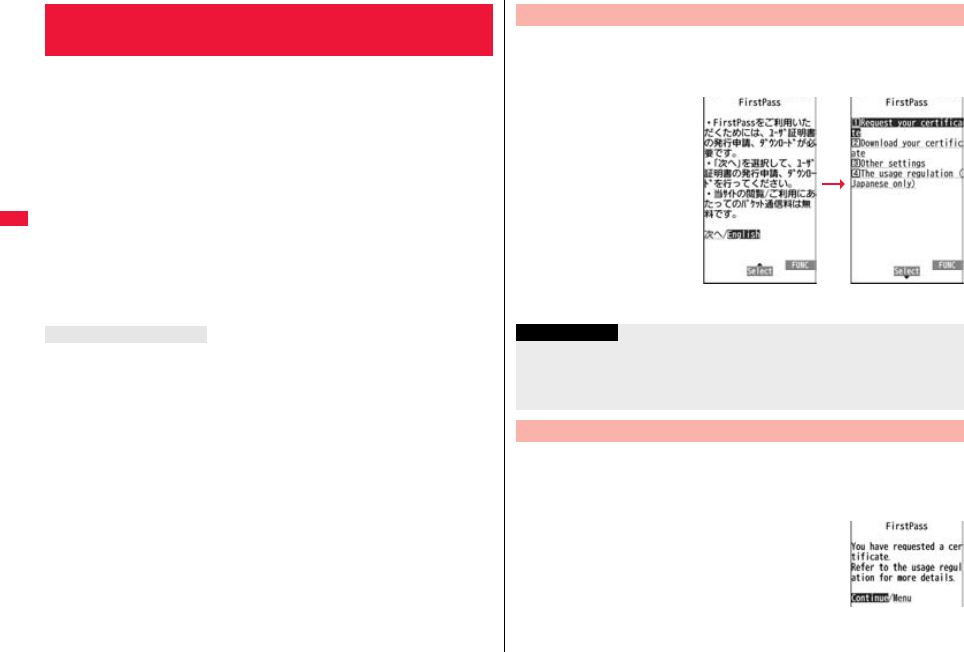
206
i-mode/i-motion/i-Channel/i-concier
User certificates verify that you have subscribed to the FOMA service.
Downloaded user certificates are stored on the UIM for the use on
FirstPass sites.
When you cannot display a FirstPass site because the user certificate on
the UIM has expired or the required user certificate is not stored on the
UIM, you can request the issue and download the user certificate from
the FirstPass Center.
≥You can request and download user certificates from the FirstPass Center.
≥This function is not available with the blue UIM.
≥The display and operating method displayed in the FirstPass Center site are subject to
change.
≥To show FirstPass sites, you can use Full Browser as well.
≥You cannot send/receive mail or receive Messages R/F while connected to the
FirstPass Center.
≥Set the date and time using “Set time” beforehand to connect to the FirstPass Center.
≥This function is not available overseas.
≥With the FOMA terminal, server authentication and client authentication are performed
for safer data exchange. The site and your FOMA terminal exchange certificates,
check the other party’s certificate and verify each other for safer communication
service. By getting client authentication, you can enjoy more secure communication
services.
≥Client authentication is available via the Internet communication from the FOMA
terminal or via the Internet communication with the FOMA terminal connected to a
personal computer. To use the personal computer for the client authentication, you
need to install the FirstPass PC software from the provided CD-ROM.
For details, refer to “FirstPassManual” (PDF format) in the “FirstPassPCsoft” folder on
the CD-ROM. Adobe® Reader® (version 6.0 or higher is recommended) is required to
see “FirstPassManual” (PDF format). If it is not installed in your personal computer,
install Adobe® Reader® from the provided CD-ROM to see it.
For details such as how to use it, refer to “Adobe Reader Help”.
<User Certificate>
Setting FirstPass
Client Authentication
You can perform user certificate operations on the site of the FirstPass
Center site.
1i1Operate certificate1User certificate1English
You need to request the issue of the user certificate before you download
it. When requesting the issue of your user certificate is completed,
download the user certificate. After the downloading is completed, it is
saved on the UIM and the FirstPass sites will be displayable.
1Site display for the FirstPass Center
1Request your certificate1Continue
≥For an update, the message “Updating user certificate”
is displayed.
≥When you have already requested the issue of the user
certificate, select “Download your certificate” from the site display for the
FirstPass Center, go to step 3.
Access FirstPass Center
Site display for
the FirstPass Center
Information
≥Before using the FirstPass Center, select “The usage regulation (Japanese only)” and
carefully read the regulation.
≥You are not charged a packet communication fee for connecting to the FirstPass
Center.
Request Issue of User Certificate for Download
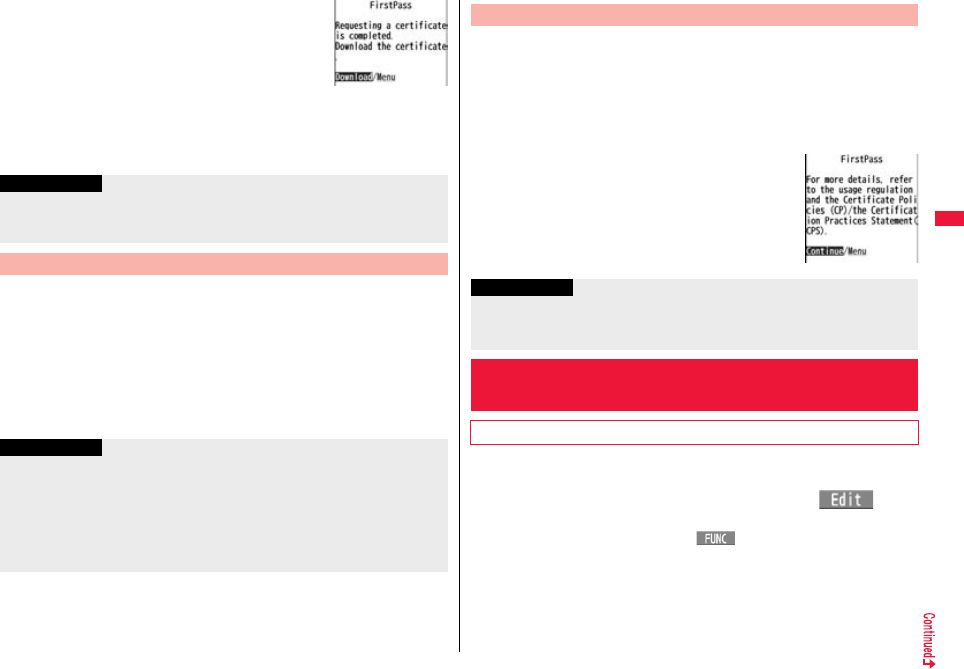
207
i-mode/i-motion/i-Channel/i-concier
2Enter your PIN2 code.
≥Enter your PIN2 code within 60 seconds. When the
code is not entered within 60 seconds, the connection is
cut off as an error entry.
≥See page 122 for PIN2 code.
3Download1Continue
≥If you do not download the user certificate immediately, select “Menu”. From the
confirmation display asking whether to close the SSL page, select “YES” to
return to the site display for the FirstPass Center.
You can connect to FirstPass sites with your user certificate.
1Call up a FirstPass site1Select an item1YES
2Enter your PIN2 code.
≥Enter your PIN2 code within 60 seconds. When the code is not entered within 60
seconds, the connection is cut off as an error entry.
≥See page 122 for PIN2 code.
Information
≥Before downloading a new or an updated certificate, be sure to request the user
certificate to be issued. User certificates cannot be downloaded until the request for
issue has been made.
Access Sites with User Certificate
Information
≥If you try to connect to the FirstPass site without the user certificate or when its
available period is expired, the confirmation display appears asking whether to
continue connecting to the site. Select “NO” to return to the previous page. Download
or update the user certificate from the FirstPass Center site and then access the site
again.
≥The packet communication fee for accessing the FirstPass site is included in
Pake-hodai, Pake-hodai full or Pake-hodai double.
You can revoke the downloaded user certificate.
1Site display of the FirstPass Center1Other settings
1Revoke your certificate1YES1Enter your PIN2 code.
≥Enter your PIN2 code within 60 seconds. When the code is not entered within 60
seconds, the connection is cut off as an error entry.
≥See page 122 for PIN2 code.
2Continue1Continue1Continue
You can set the host for downloading the user certificate.
1i1Operate certificate1Certificate host
1Highlight <Not recorded> and press l().
≥If you select a stored host, the setting is changed to that host.
≥To delete the stored host, press i( ), select “Delete”, enter your
Terminal Security Code, and then select “YES”.
Request Revocation of User Certificate
Information
≥To use FirstPass after revoking a certificate, you need to apply again for your user
certificate to be issued and then download it.
≥See page 205 for how to view the download user certificate.
<Certificate Host>
Changing Hosts for Certificate Issue
※Normally, you do not need to change this setting.
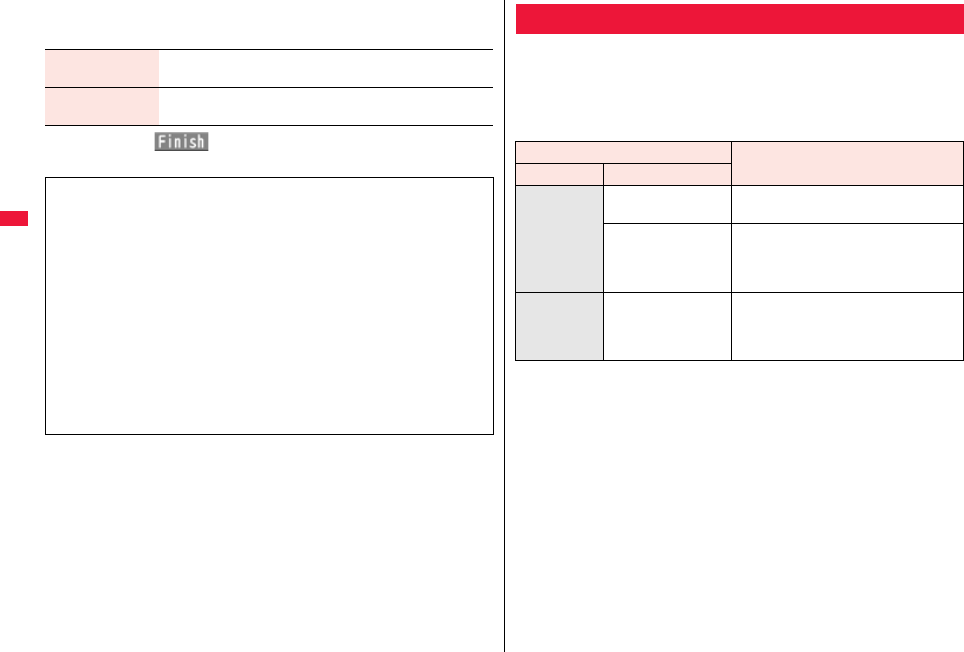
208
i-mode/i-motion/i-Channel/i-concier
2Enter your Terminal Security Code
1Do the following operations.
3Press l().
Default URL 1Enter a default URL.
≥You can enter up to 100 half-pitch alphanumeric characters.
Host address 1Enter a host address.
≥You can enter up to 99 half-pitch alphanumeric characters.
■Before Using FirstPass
≥FirstPass is DOCOMO’s electronic authentication service. By using FirstPass, client
authentication is enabled, whereby the site and your FOMA terminal exchange
certificates, check the other party’s certificate and perform mutual authentication.
≥When requesting issue of a user certificate, carefully read “The usage regulation
(Japanese only)” on the display, agree to this, and then make the request.
≥You need to enter the PIN2 code to use the user certificate. Once you have entered
your PIN2 code, all subsequent operations will be deemed to be done by you, so be
careful not to let anyone else use your UIM or PIN2 code.
≥If your UIM is lost or stolen, “docomo Information Center” on the back page of this
manual can revoke your user certificate.
≥DOCOMO bears no obligation or responsibility with regard to the sites and
information provided by FirstPass sites. Please solve the problem between you and
FirstPass sites.
≥DOCOMO and the CA do not guarantee security when you use FirstPass and SSL,
so you should use them on your own judgment and responsibility.
i-motion movies are composed of video, sound and music, and you can
play them back obtaining from i-motion compatible sites into your FOMA
terminal. You can set the i-motion movie for a ring tone.
Two types of i-motion movies are available as shown below. The type of
the obtained i-motion movie differs depending on the site or file.
You can save up to 10 Mbytes per i-motion movie.
i-motion
Categories Description
Type Playback type
Standard
(normal) type
(can be saved)
Plays back after
obtaining
Plays back after obtaining all the data of an
i-motion movie.
Plays back while
obtaining
Plays back while obtaining an i-motion
movie. After obtaining, you can play it back
in the same way as “Plays back after
obtaining”.
Streaming
type
(cannot be
saved)
Plays back while
obtaining
Plays back while obtaining an i-motion
movie. The data is deleted after playback, so
you cannot play it back again or save it to the
FOMA terminal.
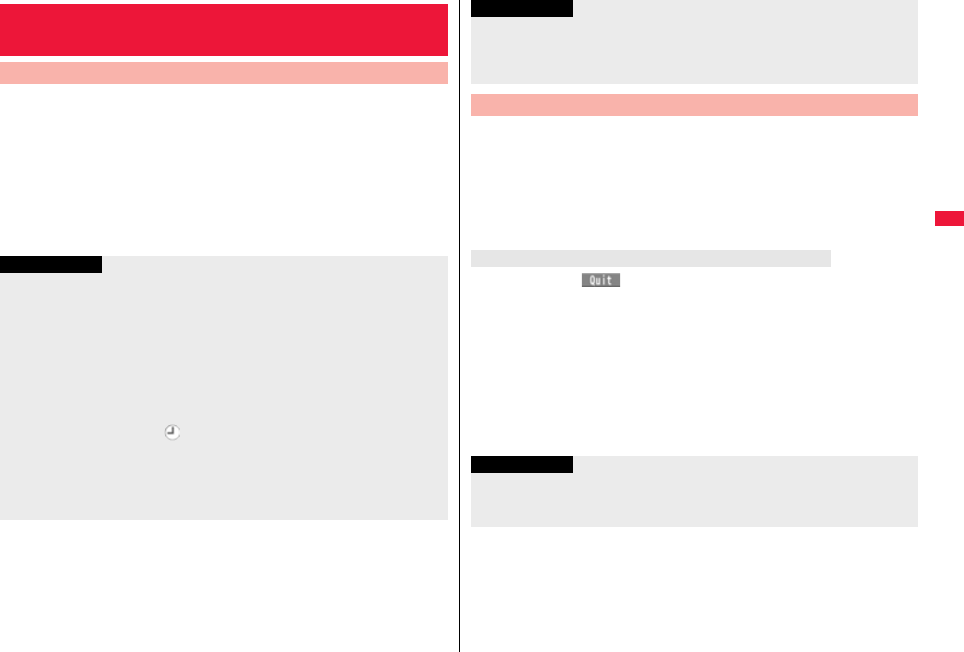
209
i-mode/i-motion/i-Channel/i-concier
1
Select an i-motion movie from an i-motion obtainable site
1
Play
See page 352 for the operation during playback.
≥If an i-motion movie is playable while being obtained, it will be played back while
being obtained.
≥If “Automatic replay set.” is set to “ON”, the i-motion movie will be played back
automatically after it is obtained.
≥Select “Property” to display the i-motion information. (See page 353)
≥See page 197 to save a screen memo.
<Download i-motion>
Downloading i-motion from Sites
Play Back i-motion Obtained from a Site
Information
≥Depending on the accessed site or an i-motion movie, you might not be able to obtain
the data or play it back during obtaining, or play it back after obtaining. Also, you
cannot obtain an i-motion movie in ASF format.
≥See page 352 for the file formats of playable i-motion movies.
≥Even when you stop playing back the data of standard (normal) type while obtaining,
obtaining still continues.
≥Even if “Automatic replay set.” is set to “ON”, the data is not automatically played back
after obtaining when it is played back while obtaining.
≥For an i-motion movie that has restrictions on the number of playbacks, playable
period, or playable deadline, “ ” is displayed at the head of the title. An i-motion
movie with the playable period restricted cannot be played back before or after the
restriction period. If you remove the battery and keep it aside for a long time, the date/
time information in your FOMA terminal might be reset. In that case, you cannot play
back the i-motion movie that has restrictions on the playable period and playable
deadline. See “imotion info” for checking the playback restrictions.
You can save the obtained i-motion movies to your FOMA terminal. You
can save up to 250 Mbytes of files in total sharing the memory space with
other data files. (See page 531)
1A data acquisition completion display1Save1YES
1Select a destination folder.
≥See page 201 when i-motion movies are stored to the maximum.
When you press l( ) to suspend downloading or when downloading is
suspended by an incoming call, the confirmation display appears asking whether to
resume downloading.
Select “YES” to resume downloading the remaining part. Select “NO” to show the data
acquisition completion display for a partially savable i-motion file. Select “Save pt.” to
save that file to any folder in “imotion” in “Data box”.
You can re-download the rest of the partially saved file from “Data box”.
≥The file name of the partially saved i-motion movie is “movie”.
≥When the playable period or playable deadline of the partially saved i-motion movie
has expired, you cannot download the remaining segments of the file. You can delete
the partially saved file when you try to download the file.
≥Depending on the line speed, line state, or radio wave conditions, the playback during
obtaining might be suspended or the images might be distorted. You can repeatedly
play back the standard (normal) type of i-motion movies after obtaining, but cannot
play back the streaming type of i-motion movies.
Save i-motion
Information
When downloading i-motion movie is suspended
Information
≥Depending on the i-motion movie, you might not be able to save the obtained data to
the FOMA terminal.
≥Partially saved i-motion movies cannot be played back from Data Box.
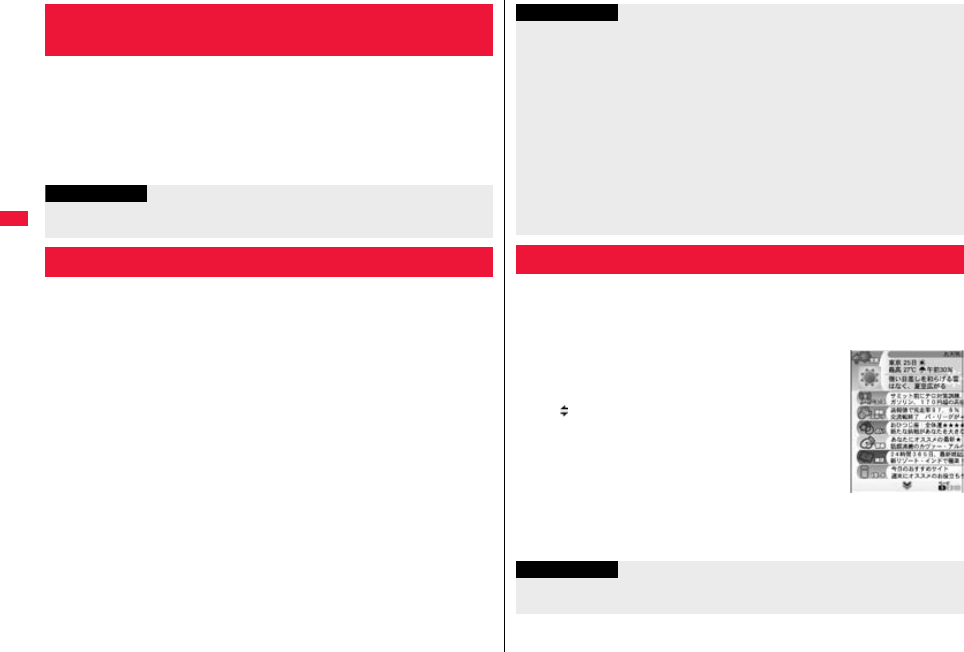
210
i-mode/i-motion/i-Channel/i-concier
You can set whether to play back an i-motion movie automatically, for
when you have obtained a standard (normal) type of i-motion movie from
a site or have selected a screen memo which contains a standard
(normal) type of i-motion movie.
1i1i-mode settings1Automatic replay set.
1ON or OFF
This service distributes information such as news and weather forecast
to i-Channel mobile phones. The automatically received latest
information flows on the Stand-by display by tickers. You can read it on
the i-Channel list by pressing the i-Channel key. (See page 210)
Further, two types of channels, “Basic channel” provided by DOCOMO
and “Favorite channel” provided by IPs (Information Providers) are
available. You are not charged a packet communication fee for
auto-updates of “Basic channel” information.
You are charged a packet communication fee for auto-updates of
“Favorite channel” information which is enabled by registering your
favorite channels. For both of “Basic channel” and “Favorite channel”,
note that you are separately charged a packet communication fee for
browsing detailed information.
When you use the international roaming service, you are charged a
packet communication fee for both auto-update and browsing detailed
information.
≥i-Channel is a pay service which is available on a subscription basis (You need to
subscribe to i-mode to apply for i-Channel).
≥For details on i-Channel, refer to “Mobile Phone User’s Guide [i-mode] FOMA version”.
≥The i-Channel service is provided in Japanese only.
<Automatic Replay Setting>
Setting Automatic Replay of i-motion
Information
≥Note that a streaming type of i-motion movie is played back automatically even if this
function is set to “OFF”.
i-Channel
When “Ticker ON/OFF” is set to “ON”, up to 10 ticker files for the latest
information flow repeatedly on the Stand-by display. If you want to know
more about the information, you can obtain the details from the Channel
list.
1Press Zo.
The Channel list appears regardless of the “Ticker ON/
OFF” setting.
≥“ ” blinks during receiving information.
2Select an item (link).
Information
≥When the FOMA terminal is turned off or if radio wave conditions are bad such as
when it is out of the service area, you may not be able to receive information even if
you have contracted to the i-Channel service. In that case, select the channel for
unsigned subscribers that appears by pressing *Zo; then you can now receive
information, and tickers flow on the Stand-by display. If your FOMA terminal remains
in the default state, you may not be able to receive information. Press *Zo, and then
information is received and tickers flow on the Stand-by display.
≥To receive i-Channel information overseas, you are charged a communication fee by
channel (domestic talk-free service does not apply).
≥After you cancel the contract for the i-Channel service, the ticker setting is
automatically set to off.
≥If you cancel the contract for the i-mode service before you cancel the contract for the
i-Channel service, the ticker setting remains on.
Using i-Channel
Channel list
Information
≥The ring tone does not sound and the vibrator does not work even when information
comes in. In addition, the Call/Charging indicator does not light or flicker.